
Title: Home Fun
Author: Cecil Henry Bullivant
Release date: March 27, 2020 [eBook #61685]
Language: English
Credits: Produced by Chris Curnow, Harry Lamé, Linda Cantoni and
the Online Distributed Proofreading Team at
https://www.pgdp.net (This file was produced from images
generously made available by The Internet Archive)
Please see the Trancriber’s Notes at the end of this text.
The cover image has been created for this text and is in the public domain.

HOME FUN
BY
CECIL H. BULLIVANT
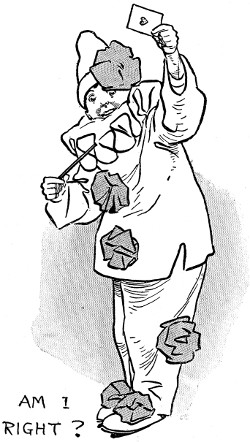
NEW YORK
DODGE PUBLISHING COMPANY
214-220 East 23rd St.
COPYRIGHT, 1910, BY
DODGE PUBLISHING COMPANY
[5]
Not to produce workers of wonders or exponents of marvelous mysteries; not to launch on an already over-crowded market a host of professional or semi-professional entertainers—but rather to give to those who can find real pleasure in amusing others, such knowledge as shall enable them to transform the lagging winter hours into periods of sheer delight, has this book been written.
While in no sense does it claim to be an exhaustive guide to home amusements, it represents a serious effort to bring within the scope of one volume almost every form of popular home diversion.
The subjects have been dealt with from a simple but perfectly practical point of view. In addition to the different accomplishments being so explained as to be easily comprehended and acquired, the successful presentment of them is made possible at a minimum of expense. The greatest difficulty which formerly faced the amateur entertainer was the heavy cost of production, but even the most expensive form of amusement explained in the following chapters comes well within the modest “pocket-money bounds” of the average boy.
It is hoped that in “Home Fun” will be found much that is entirely new concerning subjects about which little or nothing has hitherto been written. Whereas the paths so well trodden by authorities on entertaining are here more or less passed over, excursions are made into equally fascinating by-ways, an acquaintance with the delights of which cannot fail to win success and widespread approval for the promoter of entertainments at home.
That those who follow the many chapters on subjects so amusing and diverse may obtain from them as great pleasure as he who has compiled them is the sincere wish of the author.
Cecil Henry Bullivant.
| CHAPTER | PAGE | |
|---|---|---|
| I. | AMATEUR THEATRICALS | 11 |
| II. | MYSTERIES OF MAKE-UP | 26 |
| III. | THE QUICK-CHANGE ARTIST | 34 |
| IV. | CHARACTER IMPERSONATIONS | 41 |
| V. | THE UNIVERSAL HAT | 50 |
| VI. | NIGGER MINSTRELSY | 56 |
| VII. | SOME SUGGESTIONS IN BLACK | 62 |
| VIII. | TABLEAUX VIVANTS | 68 |
| IX. | CHARADES | 76 |
| X. | THE POSSIBILITIES OF THE MUSICAL SKETCH | 86 |
| XI. | VAMPING SIMPLIFIED | 92 |
| XII. | AN EVENING AT THE PHONOGRAPH | 97 |
| XIII. | MUSICAL GLASSES | 101 |
| XIV. | HAND-BELL RINGING | 105 |
| XV. | THE ART OF DRAWING-ROOM SINGING | 111 |
| XVI. | DRAWING-ROOM RECITALS | 116 |
| XVII. | THE ART OF WHISTLING | 123 |
| XVIII. | BUNKUM ENTERTAINMENTS | 127 |
| XIX. | VENTRILOQUISM IN A MONTH | 140 |
| XX. | CONJURING FOR ALL | 158 |
| XXI. | SOME KNOTTY POINTS | 169 |
| XXII. | BLACK STAGE MYSTERIES | 174 |
| XXIII. | CONCERNING GHOSTS[8] | 183 |
| XXIV. | SOME STAGE ILLUSIONS | 189 |
| XXV. | THE ROOM OF MYSTERY | 201 |
| XXVI. | MECHANICAL SECOND-SIGHT | 211 |
| XXVII. | PAPERGRAPHY | 220 |
| XXVIII. | JUGGLING | 225 |
| XXIX. | PLATE-SPINNING AND WALTZING | 233 |
| XXX. | THE TIGHT-ROPE | 240 |
| XXXI. | CLOG DANCING | 244 |
| XXXII. | SHADOW SHOWS | 250 |
| XXXIII. | LIGHTNING CARTOONS AND “FAKE” SKETCHING | 263 |
| XXXIV. | FRICTIONAL FUN | 272 |
| XXXV. | SOME ELECTRICAL EFFECTS | 285 |
| XXXVI. | SAFE SCIENTIFIC EXPERIMENTS | 297 |
| XXXVII. | SAFE CHEMICAL EXPERIMENTS | 312 |
| XXXVIII. | ODD EXPERIMENTS | 320 |
| XXXIX. | MORE EXPERIMENTS | 329 |
| XL. | PHOTO PASTIMES | 341 |
| XLI. | HOW TO MAKE AND WORK MARIONETTES | 354 |
| XLII. | LIVING MARIONETTES | 363 |
| XLIII. | THE HOME CIRCUS | 367 |
| XLIV. | HOW TO MAKE AND WORK A PEEP-SHOW | 378 |
| XLV. | THE “MECHANICAL” PEEP-SHOW | 383 |
| XLVI. | HOW TO MAKE AND WORK A PUNCH AND JUDY SHOW | 387 |
| XLVII. | DISSOLVING VIEWS | 396 |
| XLVIII. | INDOOR FIREWORKS | 400 |
| XLIX. | HOW TO MAKE A TELEPHONE[9] | 405 |
| L. | TELEGRAPHY AT HOME | 410 |
| LI. | ELEMENTARY HYPNOTISM | 416 |
| LII. | THE POWERS AND MYSTERIES OF CLAIRVOYANCE | 426 |
| LIII. | TABLE-TURNING | 434 |
| LIV. | PALMISTRY | 437 |
| LV. | PHRENOLOGY | 445 |
| LVI. | TELLING FORTUNES BY CARDS, DICE, DOMINOES, ETC. | 452 |
| LVII. | GRAPHOLOGY | 465 |
| LVIII. | A SUCCESSFUL CHILDREN’S PARTY | 472 |
| LIX. | PARLOR GAMES | 475 |
| LX. | PARLOR TRICKS AND PUZZLES | 490 |
| LXI. | “HOW WOULD YOU——?” (PUZZLES) | 510 |
| LXII. | SOME OPTICAL ILLUSIONS | 519 |
| LXIII. | CIPHERS AND CRYPTOGRAMS | 527 |
| LXIV. | SECRET SIGNS | 533 |
| LXV. | GAMES AND AMUSEMENTS FOR THE BLIND | 538 |
| INDEX | 545 | |
HOME FUN
A great many people are deterred from embarking on the sea of amateur theatricals for the reason that the expense and trouble incurred in providing an adequate stage, and in finding plays suitable for amateurs, seem to outweigh other considerations.
The following hints and suggestions, then, are not intended for the lordly Thespians who would aspire to flaunt their histrionic powers in public assembly-room or civic town-hall. For them there are those who make it their business to erect stages, provide “swell” scenery, and all the paraphernalia required.
It is, of course, possible to act without a stage proper at all, especially if you happen to live in a house that boasts a double drawing-room with folding doors, in which case a curtain would also be a superfluity, for the doors could be closed and thrown open when the audience are in their places, though if a curtain should be deemed necessary it would be an easy matter to fix a rod from door to door.
But before going on to the description of how to erect a stage of a more pretentious character, it might be as well to offer a word or two of warning. Remember that private theatricals are rather apt to turn a house upside-down, so that before the performance is given it is of importance to see that all breakables are stowed away, and that superfluous furniture is disposed of.
If you are going to turn your drawing-room into a theater, take care that your guests can enter without having to pick their way in and out of needless chairs and tables. Details such as these may seem trivial. They are, nevertheless, just the things that may make or mar an entertainment.
Above all, let there be harmony. Once having chosen your stage-manager, see to it that his word is law. Nothing is more galling or[12] disastrous than for every one to try and “boss the show.” And if expense has to be considered, do not try to be too elaborate with your accessories.
It is, nevertheless, possible for any one to erect in any drawing-room of average dimensions a stage that will be found perfectly adaptable to plays made adequate for it, and that without calling in the aid of any professional carpenter or stage furnisher.
The stage can be constructed in the following simple manner:—Hire a number of ordinary benches or stout boxes of equal dimensions, and on these superimpose lengths of scaffold-boarding or planks. These latter should be of equal thickness throughout, in order that a perfectly level staging may be obtained. The whole may be made quite secure by the judicious use of nails, although care should be taken that no damage is done to the benches, or this will have to be paid for when they are returned. A floor covering of felt or linoleum will also prove serviceable.
An essential piece of stage furniture for amateur theatricals is the drop curtain. It can be made from two equal widths of some serviceable material such as dark cretonne, supported by brass rings on a stout bamboo rod, to either end of which are attached large steel eyes (A, A, Fig. 1).
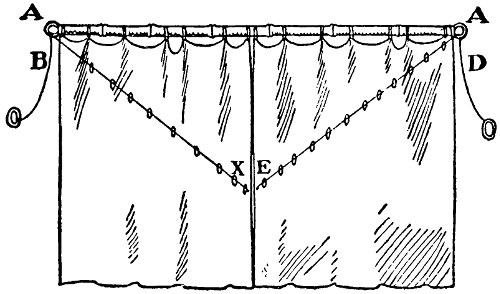
Fig. 1.—Back view of drop curtain.
The bamboo rod should be cut to such a length that when the eyes have been added, the whole can be fixed to steel hooks screwed into the picture-molding on either side of the room. Should any difficulty be experienced in procuring a rod of sufficient length, the difficulty may be overcome by the use of two shorter pieces joined at the middle by iron sockets.
In the case where it is intended to give the performance in either a schoolroom or a small hall, a curtain of much greater size and of stouter material would be required, and this latter can be supported[13] on a length of strong gas pipe held in position by brackets nailed to the wall at each end.
The arrangement for raising or lowering the curtain is shown in the diagram, in which A A is the rod. A number of small brass rings are then sewn to the back of the curtain, as at A X and A E. Top rings, much larger, are also attached to the curtain and passed along the rod. Cord is next run from X and E respectively through the rings at A, and allowed to hang loose as at D. The bottom of the curtain should be weighted with shot.
Four screens, two on each side, can also be requisitioned for the wings, and a small steady table placed in each recess (Fig. 1a) for moderator lamps—preferably of the self-extinguishing pattern, in case they should be upset by an untoward accident—to make up for the deficiency of footlights, though these can be provided by the aid of a little ingenuity, e.g. candle reading-lamps with shades and reflectors begged or borrowed from accommodating neighbors. Tin cans cut in half, and night-lights will serve the purpose equally well. Here, again, the inventive genius of the promoters of the enterprise will have to be called into play.
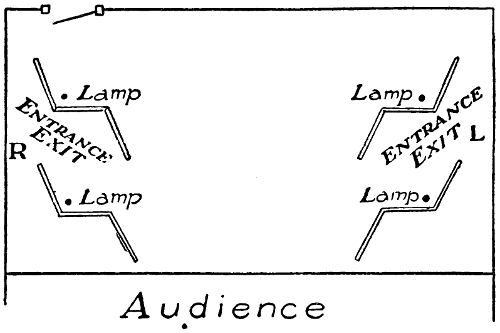
Fig. 1a.—Showing arrangement of screens for exits and entrances.
All risk of fire should be obviated as much as possible, and appliances for the swift extinction of a blaze near at hand.
By the judicious arrangement of the screens it will be possible to provide for exits and entrances on both sides of the stage.
Scenery, as a rule, proves a great barrier to the would-be promoters of amateur theatrical enterprises. The purchase of suitable surroundings for the presentation of various scenes is a luxury only to be indulged in by the well-to-do. In fact, to carry out an ordinary play on these lines involves the expenditure of many dollars. It is hoped that the practical instructions given here will not only[14] avoid such unnecessary and perhaps unwarrantable expense, but will also tend greatly to increase the interest of those taking part in the work.
Where scenery is required, it is as well to confine oneself to a play that takes place indoors, though, of course, it is possible even without a back-drop to give a praiseworthy presentment of an open-air scene by means of a plain background, against which are fastened boughs of trees, while the judicious grouping of greenhouse plants can be used at the sides, plus a plain green felt underfoot to add to the effect. However, even these small items run away with money. Cut boughs fade and need replacing, and this mode of constructing scenery will often be found by the would-be economist to cost more than he can reasonably afford.
Of course, for those who care to do so, proper mounted scenery all ready for use may be purchased, but undoubtedly the better plan is for the stage-manager to endeavor to find from amongst the members of his company one or two who are expert in the use of tools. Generally there are many such available, and by the aid of the following diagrams and explanatory notes a most useful interior box scene (comprising five “flats” which fit together and form the whole) can be constructed at a cost certainly not exceeding $5.00.
By repapering and making other obvious alterations, such scenery can be transformed as necessity demands to suit any particular play—that is to say, the addition of a few hangings and pictures, and the substitution of other appropriate furniture will speedily change a poor man’s kitchen or parlor into quite a presentable stage drawing-room.
To deal first with the “flats” or separate parts of the scenery. The primary essentials for these are a number of lengths of 21⁄2-inch battening; other requisites being a plenitude of nails of all sizes, glue, brown paper or canvas, powdered color, and size. The purpose of this latter commodity is for painting the wood-work or any other desired article, such as a sideboard, dresser, or fireplace.
Cut the battening to lengths appropriate to the dimensions of the stage, or, in other words, with due regard to the height of the room and the width and depth of the platform.
Fig. 2 shows the general arrangement of the five “flats,” placed in the order shown, with the largest one, consisting of the double doors, in the center.
Now, as the width of these “flats” depends entirely upon the space they occupy when put into the position indicated by the diagram, the[15] stage carpenter must commence his plan of construction with this fact clearly in mind. Should a particularly large stage be available, then it may be desirable to extend the scenery, in which case one or more straight “flats,” similar to that numbered 4 in Fig. 2, can be added at each end or where desired.
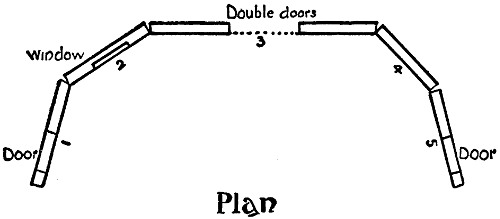
Fig. 2.—Showing usual arrangement of flats.
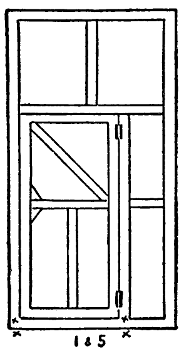
Fig. 3.—Construction of “flat” containing door.
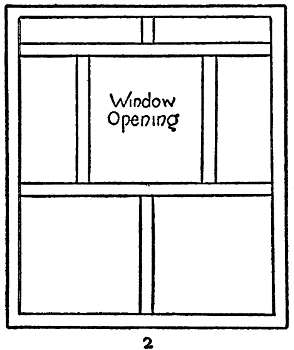
Fig. 4.—Flat for window opening.
The frame-work for the respective “flats” appears in Figs. 3, 4, 5, and 6, the method of joining corners being indicated by the elevation and sectional drawing depicted in the corner of Fig. 5. The vertical and horizontal supports are merely fitted in flush and glued. For doors and window openings a slightly stouter battening will be found necessary.
Fig. 3 gives a clear idea of the main lines of construction of a practical door, which is to be fixed to the “flat” by means of hinges.[16] When hingeing doors, take particular care so to place the hinges that the doors swing outwards—that is, from the point of view of the audience. This precaution obviates the necessity of painting both sides of the doors.
A reference to Fig. 4 shows a window opening which can be used either as a lattice, working on the same principle as the door, or as an ordinary window, which can be suggested by gluing a strip of wood horizontally across the center.

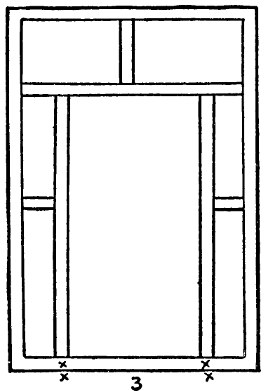
Fig. 5.—Flat for double doors.
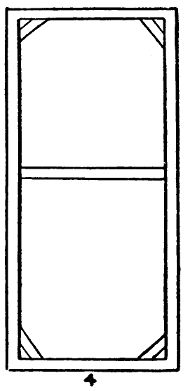
Fig. 6.—Plain flat.
In Fig. 5 the central opening (the double doors of the plan) serves for curtains fixed to rods by means of sliding rings, or merely as French windows. Of all the “flats,” this is the most valuable, because it is capable of utilization in a multitude of ways. For instance, should the scene be an elaborate drawing-room, the opening will lend itself to French windows, through which can be seen park-land or gardens in the distance. Again, for the presentment of a humble apartment, it has only to be covered with a dresser or any other commonplace article of furniture. Should an opening be required to another room, curtains of course can be hung.
Fig. 6 depicts a plain “flat.”
The next operation is the covering of the frames, accomplished by the use of brown paper, or, should expenses permit, of canvas. The brown paper is first cut to the size required, and then glued to the frames, only the openings for windows and doors being left. If canvas is chosen for the covering, nailing will be found necessary. To prevent sagging, and to preserve the flat appearance of the material, coat thinly and evenly with a solution of size and water.
[17]
The next item for consideration is papering. A visit to almost any paperhanger’s will reveal the fact, that the shopman possesses quantities of certain designs, perhaps not quite large enough to be of practical service to him for papering a room. In this circumstance the stage carpenter should be able, by the expenditure of a few cents, or a quarter at the outside, to obtain quite enough for his purpose. Next, he can procure from any builder’s yard a few lengths of architrave or beaded edging for doorways and windows. This will have to be mitered and fixed to the frames. A few slips of board, with beading along one edge, should also be purchased at the same time for fixing to the bottom of the frames to form the skirting. Now paste the wall-paper to the frames.
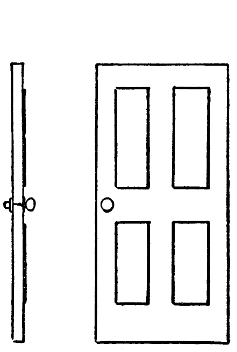
Fig. 7.—Complete door with section.

Fig. 8.—Flat 1 or 5 converted into exterior cottage door.
Having satisfactorily constructed all the “flats,” fix them together in the order shown in the plan—i.e. each to each—by means of pieces of bent zinc and screws. Additional supports are often required, such as iron brackets screwed to the bottom of the “flat” and the floor, as indicated by the crosses in Figs. 3 and 5.
To give a finished effect, paste brown paper over the whole of the door frames, and produce the appearance of panels by the addition of mitered thin beading or slips of wood (Fig. 7). The door panels may[18] then be painted according to taste with a mixture of any powdered color and dissolved size. The fixing of a knob or handle with a long screw renders the thing complete.
Reference to the plan marked Fig. 2 reveals the fact, that the two end “flats” (1 and 5 respectively) are alike. Now, while one of these “flats” may be utilized for an interior door (Fig. 3), it may be found extremely useful so to prepare its fellow that it represents an exterior cottage door, and to use it as a wing at one side of the stage in another scene. It should then appear as in Fig. 8. To obtain this result, a section of scenery has to be covered with brown paper or canvas, as already described for the interior door. Should canvas be decided upon, first prepare it by adding a coating of mixed size and whiting, to form a background for the painted design. In this case the door itself is covered on the outside with paper, and lines are drawn down to give an idea of planks nailed vertically together. A latch-handle can either be purchased and fixed for a few cents, or an imitation one painted in.
The lintel and doorposts are constructed by gluing or nailing battening of a sufficiently stout nature, that it projects to the degree indicated by the section in Fig. 8. The purpose of this latter projection is to allow for the addition of a latticed porch, which will give that picturesqueness so essential to stage scenery.
A glance at Fig. 9 will put the amateur stage carpenter in full possession of all details relating to the construction of this latticed porch. Of course, it will be found necessary to make two pieces of the part numbered 1—i.e. the batten frame and cross-pieces—as one will be fixed on either side of the door to support the roof. The lattice-work may be purchased in a length, or made from laths, and nailed to the frame. Fix the sides of the porch close up to the doorposts by means of zinc brackets and pins, as indicated by the two crosses. Next pin on the roof, as at 4, Fig. 9. Paint the finished porch bright green and the roof red.
A second reference to Fig. 8 shows that it suggests a design of bricks, covered with creeper or a tree. If necessary, treat the other side of the window “flat,” by painting it in similar fashion, and fix it alongside the door to form an additional wing.
[19]
A very useful adjunct to the plain “flat” (Fig. 6) is a portable fireplace, which is depicted in detail in Fig. 10. To make this, buy a length or so of 3⁄4-inch planking, one length of which should be cut for the mantelpiece, according to the size required. Next cut two supports of equal dimensions to form the sides (A, A, in elevation). These are nailed to the “flat,” and the mantelpiece is kept in position by two solid wooden brackets (D, D). Two slips are also added to the base of the supports at E, E. The piece C is let in flush with A, A.
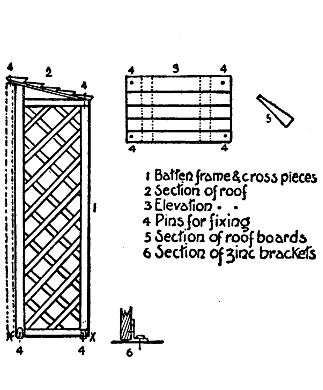
Fig. 9.—Construction of portable porch.
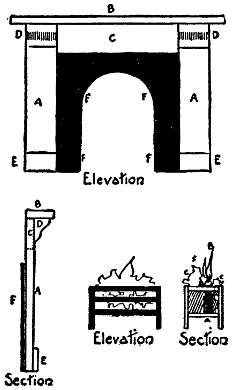
Fig. 10.—Portable fireplace and grate.
Below this, to the back of the rectangular opening, attach a piece of very stout blackened cardboard, of the shape shown, leaving an opening for a real or a painted grate (F). Should the former be preferred, it may be produced from pieces of thin battening, as shown in the elevation and section.
To obtain a realistic effect, fill the grate with non-inflammable metal tinsel (C, C), and further to enhance the realism, support a small galley-pot on a blackened bracket or block of wood (A), the galley-pot being filled with cotton-wool soaked in methylated spirit. The application of a match produces a flame at B (see section of grate, Fig. 10).
[20]
Fig. 11 gives the front and back view of this very useful piece of stage furniture, which may be utilized either as a counter, sideboard, or bottom of a dresser; or, appropriately draped and surmounted by a looking-glass, it may serve as a dressing-table.
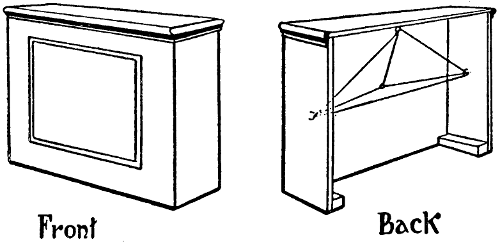
Fig. 11.—Portable counter or sideboard.
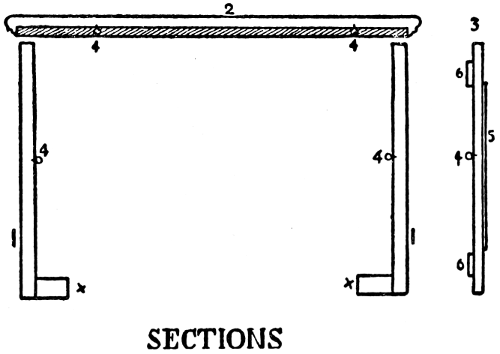
Fig. 12.—Detached parts of counter or sideboard.
The sections are illustrated in Fig. 12, the pieces marked 1 forming the sides, 2 the top, and 3 the front. Steel eyes are numbered 4, and their purpose is to hold the sides, front, and top together by strong cord, attached as in the back view of Fig. 11. 5 in Fig. 12 is a projecting panel, also seen in the front view of Fig. 11. 6 (Fig. 12) indicates the back supports to which the front joined boards are nailed. The beading which is fixed along three sides of the top is seen at 7 (Fig. 13).
Having thoroughly grasped the details outlined above, commence to make the sideboard from 3⁄4-inch boarding.
To each of the side-pieces add a bottom support of stouter material, marked with a cross in Fig. 12. The front is next placed across the supports in such a position that the top fits down on them and holds all three pieces in place. (See dotted line at 7, Fig. 13; this diagram also depicts the separate pieces in elevation.)
It is not worth while “spoiling the ship for a ha’p’orth o’ tar,” or, in this instance, the sideboard for a coat of paint. Before applying this latter, paste the structure over with brown paper, and then give it a coating of yellow ochre and size. A grained appearance may be produced by utilizing an old coarse comb, the fine grain being attained[21] with the thin teeth and the coarse grain with the stout. To obtain the graining, proceed as follows: on the dry coating of yellow ochre put a second coating of dark brown ochre, mixed with size as before, and whilst wet comb in zigzag lines.

Fig. 13.—The separate pieces in elevation.
The great advantage attaching to all the scenery and artificial furniture described is that it can be easily fitted together, taken to pieces, and packed flat, thus occupying a minimum of space. For practical purposes it will be found quite equal both in appearance and for durability to that for which many dollars are charged at a theatrical supply dealer’s.
The construction of home-made theatrical effects may be closed with brief hints regarding the much-needed and ever-useful back-cloth, which plays a part in most exterior scenes, such as park lands, gardens, &c. It consists of several lengths of calico joined together to form a square of the size required. This is then fixed on a large wooden roller with a similar roller at the bottom to weight it, and prepared with a coating of size and whiting.
A friend of unquestionable artistic ability should be asked to paint in a view or other scenery.
In scene-painting bear in mind that only the brightest and most vivid colors are to be used. The colors are made from powder mixed with size, and must be applied with broad touches for distant effects. The back-cloth can be fixed according to the means available.
For the proscenium, three pieces of wood to suit breadth and size of stage must be requisitioned, the portion destined for the top being gently sloped from an arch or apex in direct line with the center of[22] the curtain, and covered with some tastefully-colored paper which gives the appearance of heavy satin panels.
A sewing bee should be formed among the ladies interested in the company, and she who has sufficient prowess with her scissors should be chosen to cut the garments and superintend the needlework of her friends. This will prove a profitable way of spending the long winter afternoons.
Imitation hair wigs, beards, &c., may be procured at various prices.
The best plan to adopt in finding a play suited to the limitations of material of an embryo company is to spend a small sum on some “Guide to Selecting Plays.” In these pages will be found abundant suggestions and explanations of specimens, dealing from the simplest one-act, thirty minutes’ production to the five-act, three hours’ drama. The outline of each plot is given, and a summary of the dramatis personæ required.
Miss Keating’s “Plot of Potzentausend,” for example, is an excellent one-act play, in which only male characters are required. Interest in the fair sex is, however, cleverly maintained, for the four swains have each a lass to occupy their affections.
The costumes, a description of which is given on the front page, are of the time of Louis XIV., and the scene is a small frontier village in Germany. This is an admirable, amusing, and not too ambitious performance for boys home for the holidays.
Grindstone is a miller of a sour and unfriendly disposition. He is secretly involved in small political intrigues, and, in order to meet the Chevalier d’Espion without the knowledge of the villagers, refuses to allow the lads and lasses their usual yearly privilege of dancing in his barn, to which they naturally take exception. Grindstone’s personality and physical appearance are as gray, grim, and cold as the substance after which he is named. He is tight of lip, thin of figure, and possessed of a countenance which expresses a miserly cunning, dislike of frivolities, and hypocritical semblance of virtue. Although vastly respected, he is not overwhelmed with the affections of his fellow-men, and is termed, even by his servant Sacks, to be something of a rogue.
Sacks, his man, is a thick-set hunchback, with a round, jolly face and optimistic temperament, which presents a strong contrast to his master’s saturnine character.
Max, a young sergeant, of smart demeanor, is weighted by a sense of his own importance, insipid of face, and overbearingly superior in manners.
Louis, a lawyer’s clerk, pale and meek, rat-faced and rather wily, grasping in disposition, and something of a flirt.
[23]
Fritz, a young peasant, whose sentences generally terminate with “as a body may say,” shows a priggish and cautious attitude to preserve his own skin at any cost. His expression is a delightful mixture of rustic placidity and guileless cunning.
The Chevalier d’Espion, a smart, condescending person of uncertain age and carefully preserved complexion; his gold lace and feathers lend him as irreproachable an aloofness and pride as the peacock demonstrates towards the jackdaw.
Plan of Room in Grindstone’s House
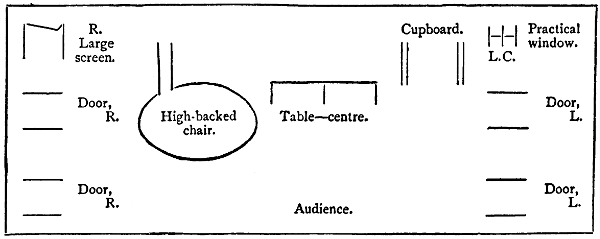
The table should be covered with a cloth sufficiently long to touch the ground on all sides. The rear of the high-backed chair and window-curtain are to be used as hiding-places, and must be practicable for the purpose. Small chairs and an old stool are also required. Except for a small lighted lamp which Sacks, the first to enter, places on the table, the stage is in darkness.
This play takes thirty-five minutes. The plot is built on the misunderstanding that arises between the four swains—who have unconsciously chosen the same place and hour to meet their ladies—and the Chevalier d’Espion, who, expecting to find a quartette of fellow-conspirators, mistakes them for such in disguise. Soldiers appear to arrest the Chevalier, who manages to escape. Sacks proves the identity of the rest, and so all ends happily.
The dialogue must be brisk and the action kept interesting. Acted in the right spirit, it cannot fail to produce roars of merriment. It has a further advantage of not being too great a strain on the memorizing powers of those who have never previously essayed to learn prose by heart.
A reliable prompter, concealed from the audience, should be close at hand. His business is to follow the dialogue intently, giving aid when necessary in a clear, low voice. Words should never be[24] whispered, nor too loudly spoken. A happy medium is acquired by experience.
The make-up required by the characters is as follows:—
Sacks (florid flesh tint), grease paint (red) No. 21⁄2; a slight cobweb of good-natured wrinkles and crowsfeet, such as would be caused by laughter. Red, black, or gray wig, according to taste.
Grindstone (sallow flesh tint), chrome grease paint; peevish and discontented lines about the mouth, furrowed forehead, peruke slightly gray, nose paste to enlarge nose, sparse ruffled eyebrows.
Louis (sallow flesh tint), chrome grease paint; peruke any color fancied, premature wrinkles, small white. A few front teeth in upper gum stopped out with small noir.
Max sunburnt. Fritz ruddy. The Chevalier d’Espion bronzed. Officer and guard, 21⁄2 medium flesh.
Another fascinating play for boys is “The Poor Relation,” also written by Miss Keating, and included with “The Plot of Potzentausend” in “A Series of Original Comedies.”
Grease paints should be composed of pure chemical fat and colors free from lead, otherwise they will make havoc with sensitive skins.
Artificial complexions should never be scrubbed from the face by means of soap and water.
Cocoa butter gently applied on the corner of a soft dry towel will rapidly erase every mark, and is an excellent tonic for the skin.
Grease paints, rouge powder, cocoa butter, spirit gum, sponge-towel, puff, crêpe hair, hare’s foot, patches, tongs, hairpins, joining paste, brush and comb, lip salve, liquid blanc de perle, scissors, mirror, mustache, vanquisher, needles, cotton, soap, sponge, &c., can be purchased in compact make-up cases at prices from $15.00 down to $2.50.
Amateurs are sometimes prone to stiffness and artificiality of gesture and exaggeration of expression, also to too much or too little movement. A perfectly natural manner can only be gained by throwing oneself whole-heartedly into the play, and uniting oneself with the other dramatis personæ. Acting editions of both playlets mentioned above may be obtained of Messrs. Samuel French, of 28 West 38th St., New York.
Each actor has, as it were, his little orbit of movement, but this should not be circumscribed in a conventional, studied manner. Ease and self-control should cover all mastered technique in voice, attitude, and gesture. Words should be clearly delivered, and pronounced without any pedantic phrasing or forced utterance; and this will only be achieved by constant and careful rehearsing. The personality of each character must be distinct and individual.
[25]
When an amateur company is formed, each member should pay a fee in proportion to the strength of the casts and the drama they hope to produce. The stage-manager’s choice of characters should stand inviolable, providing, of course, he presents sufficient discretion and insight to distinguish between the different trends of talent possessed by his players.
In almost every company there are a few players who are inclined to fancy that they can do justice to a rôle given to some one else, rather than to the one they are studying. This is a form of very human discontent which Quince, the stage-manager of the players in “A Midsummer Night’s Dream,” had to battle against.
Flute bemoaned his fate, and excused himself from playing the woman’s part, on the plea, “I have a beard coming.”
Bottom was torn between a desire to undertake Thisby and the lion. “I will roar that I will make the duke say, ‘Let him roar again, let him roar again.’ ... I will roar you as gently as any sucking dove.”
As adamantine as the sagacious Quince against these eloquent appeals must be the modern stage-manager when the would-be tragedian importunes him to play the heavy rôle, or the individual who believes himself endowed with hidden genius, to portray the part of light comedian.
Thus only is success achieved.
[26]
It is necessary that the amateur who wishes to make his efforts at private theatricals a success should have a fair knowledge of the art of “make-up.”
While no great amount of money need be expended, at the same time the best results can be obtained only from the use of good cosmetics. Grease paints, obtainable from any purveyors of theatrical appliances, are excellent and not very expensive.
There is no doubt that many people consider it quite sufficient to dab a little paint on the face, smear it over carelessly with the addition of some powder, and imagine, quite erroneously, that they are well made-up.
The outward signs of character are to be represented by “make-up,” and it is quite essential that this effect should be produced; therefore, with a slight knowledge of what is to be avoided, and what effected, the home-actor should attain to some degree of success.
“Wig-paste,” No. 21⁄2, is usually considered the best foundation for pink complexions, and according to shade required, deeper colors can be used, such as 3, 4, &c. Thus, if being made up for the part of a pretty young girl, the first number is best; if for a middle-aged woman, No. 3; while for elderly men of choleric temperament No. 4 would be more suitable.
It must be borne in mind that the foundation of wig-paste should be carefully put on, and well smoothed before the structure or blending of colors to produce a natural appearance is commenced. Whether this is done well or badly will make all the difference to the final results.
Lining is an important part of “make-up,” by its aid the lines of the face being diminished or deepened, shadows created for sunken effects, and “high lights” produced—i.e. touching up the cheek-bones to give them prominence. By careful use of this latter branch of “make-up” the whole character of the face can be changed. High[27] lights are produced by a lighter shade of grease paint than that used for the rest of the complexion, being placed upon the feature to be emphasized; for instance, if the actor wishes his nose to appear thinner, he will draw a straight white line from the top to the tip, enhancing the effect with a careful application of the gray paint (Fig. 1a). The cheek-bone, nose, chin, and brow are parts of the face which are made up for high lights, though if wrinkles are to be accentuated this is usually done by the addition of a “high light” effect on each side of the existing dark line (Figs. 1b and 1c).
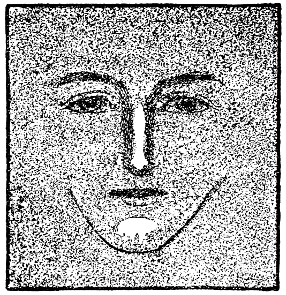
Fig. 1a.—High lights.
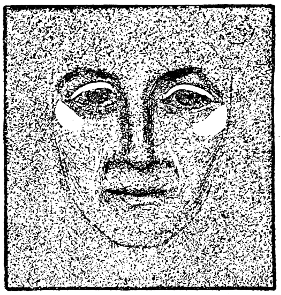
Fig. 1b.—High lights.
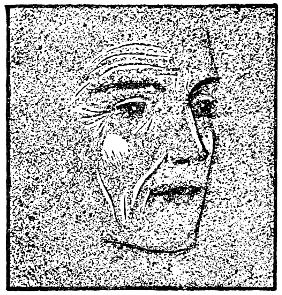
Fig. 1c.—High lights.
To make cheeks appear hollow, gray-lining paint is used, the effect of emaciation being produced by the careful blending of the last-named paint with the grease paint previously put on.
[28]
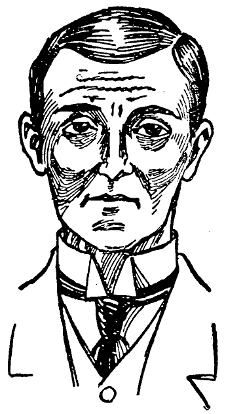
Fig. 2.—Low lights.
Shadows, or low lights, give the effect of hollowed cheeks and sunken eyes, and instead of making features more pronounced, as is the case with a careful “high light” make-up, decrease the prominence which certain parts usually possess (Fig. 2). When making-up for a beldame, or some other character which should appear more than usually haggard, a striking effect is obtained by adding a spot of either dark-gray or brown, and blending it outwards.

Fig. 3.—Before lining.
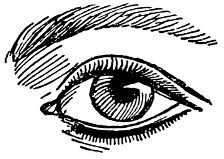
Fig. 4.—After lining.
The lining of the eyes requires special attention, more particularly as their appearance depends so much upon the change of the eyelids (Figs. 3 and 4); eyelashes too, when properly treated, make a vast difference to the usual expression.
When it is necessary that the eyelashes should be more pronounced, black grease paint is put on to the end of an artist’s stump, melted very slowly by being held over a candle or other flame, and so applied. Care should be taken, however, that no grease paint goes into the eye, so when melting it must not be allowed to become too soft. Black-lining grease paint is the best for eyelashes, and the amount applied depends entirely upon their natural thickness and darkness.
For darkening or lightening the eyebrows, grease paint “liners” are indispensable, and much preferable to India ink. Sometimes it is necessary to obliterate part of the eyebrow before the rest is “drawn-in,” in which case it is first of all coated with soap and then covered with the same grease paint as used for the groundwork of “make-up.” This done carefully, and toned to the same shade as the rest of face, leaves the actor free to “draw-in” any shaped eyebrow he desires. For a very thin eyebrow a toothpick can be utilized to advantage, a little melted grease paint being rubbed upon it, and the line drawn with it (Figs. 5 and 6).
For Oriental effects the obliteration of the eyebrows is essential,[29] and fresh ones with an upward tendency can be drawn-in at will, when once the natural ones have been made to disappear.
More often than not it is necessary to increase the eyebrows, making them look thick and heavy, and if Nature has endowed the player with massive ones, it is an easy matter to comb them up the wrong way and apply a small quantity of grease-paint; but if they are naturally thin the aid of false ones must be sought. Crêpe hair, which is an indispensable accessory to the “make-up” art, can here be brought into use, the ever-helpful “adhesia” being required as well.
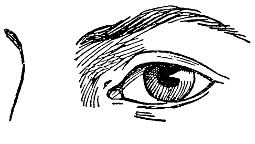
Fig. 5.—Eyebrow before lining.

Fig. 6.—Eyebrow after lining.
The best plan is to model on a comb the eyebrow according to the shape desired; then, placing the latter in position, make it fast with the use of the adhesia, taking care that the gum is only on the edges and not on the hair of the real eyebrow.
To obtain a sinister expression, eliminate the outer edges of the eyebrows and paste a piece of crêpe hair over the eyebrows near the nose, the Mephistophelian effect being gained in the same way, except that the outer corners should curl upwards (Figs. 7 and 8). By fixing on pieces of crêpe hair so that they meet over the nose, a stern and even fierce expression is produced.

Fig. 7.—Natural eyebrow.

Fig. 8.—Mephistophelian effect produced with crêpe hair.
In making-up for the character of a juvenile, the strength of light on the platform or stage is to be taken into consideration. If a fairly strong light, the make-up must not be too deep, but the player will soon become experienced in this matter by taking the trouble to consider the effect of different lights.
Before commencing with the grease paints the face is well rubbed[30] with cold cream or cocoa butter, and wiped with a towel, so that none of the former remains visible.

Fig. 9.—Preliminary lining.
The flesh-colored paint may now be drawn across the face several times, the method of procedure being: two lines across forehead, two on each cheek, one down the nose, and several on the neck (Fig. 9). With the palms of the hands this is smoothed over carefully, and finally rubbed quite lightly with a dry towel. The foundation is thus formed, and is really the most important part of the make-up, for if not carefully done the rest will be unsatisfactory. One of the chief facts to be borne in mind is that very little paint should be used, so little as to be scarcely seen.
Rouge is next applied, red-lining paint or paste lip-rouge being used upon the cheek-bones, and carefully smoothed until it tones with the flesh on the cheeks. After an application of powder, when the face feels perfectly smooth, comes the task of lining-in, which has already been described.

Fig. 10.—Natural lips.
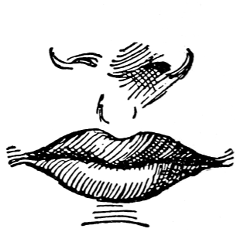
Fig. 11.—Lips accentuated by rouge.
The lip-rouge accentuates the lips (Figs. 10 and 11), and should it be necessary to make them of a more symmetrical appearance, this may be accomplished by extending the rouge a trifle beyond the natural outlines, though women need this little extra touch more often than men. When it is required to make the chin more prominent, a touch of dry rouge beneath the lower lip will accomplish the effect, still more being added to the cheeks if they are not quite colored enough (Fig. 12).
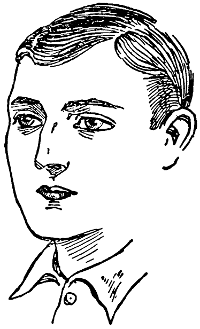
Fig. 12.—“Juvenile” make-up.
For juvenile darky parts, burnt cork will do instead of the grease paints.
[31]
This is perhaps the most difficult make-up, for it is much easier to go to one extreme from another, than to make a fairly young person look like a middle-aged one (Fig. 13).
In the case of a man it is advisable to depend on the addition of whiskers and mustache, and even glasses or spectacles lend age.
A sallow paint is usually required for middle-age make-up, and it can be blended with a lighter paint for pale effects; but to produce a hearty bloom or florid complexion, the application of a little red or brown is recommended.
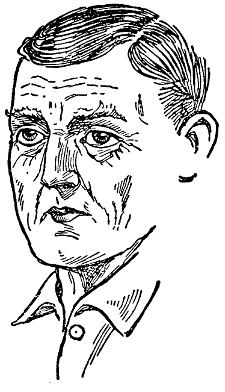
Fig. 13.—“Middle-age” make-up.
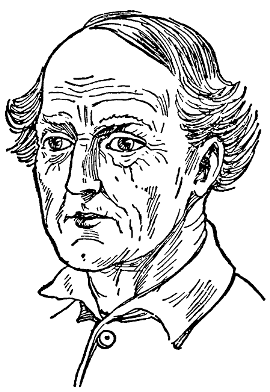
Fig. 14.—“Old-age” make-up.
The mid-gray wig is also an immense aid, but failing this, a small amount of powder sifted over the hair will give a similar effect.
If the character desired to be represented is carefully studied, notice being taken of where there is a high light and where the shadows of the face lie, there should be little or no difficulty in producing a lifelike representation.
Particular notice should be taken of wrinkles and lines, and these must be carefully blended as in Fig. 14.
The next essential is the wig, either gray or white being the most[32] useful. For the old age complexion it is better to get the grease paint for that purpose; but when the necessity for it is but seldom, an application of the sallow paint, or in the case of great emaciation, the addition of a little blue, well blended, will create quite a good effect.
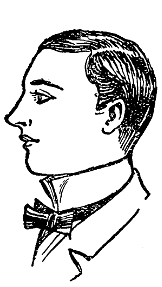
Fig. 15a.—Natural features.
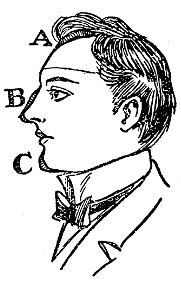
Fig. 15b.—Putty applications.
| A. | Putty | addition to | forehead. |
| B. | „ | „ | nose. |
| C. | „ | „ | chin. |
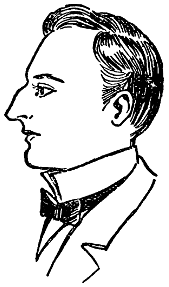
Fig. 15c.—Finished features.
Sometimes it is required that the nose shall be made larger; then the “nose putty” is called into play, carefully modeled on to the nose, and with the aid of the same grease paint as is utilized for complexion, made to correspond with the rest of the face (Figs. 15a, 15b, and 15c).
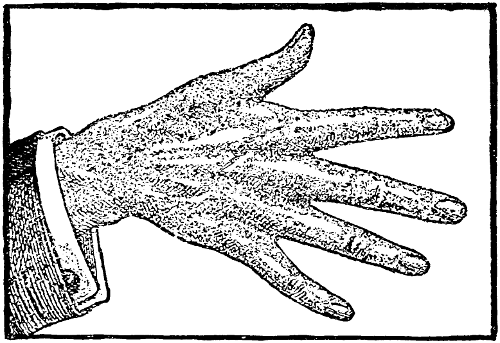
Fig. 16.—Hand made-up for “old age.”
Dark shadows under the eyes can be produced by gray grease paint, but for the formation of crow’s-feet, the brown will be found the best.
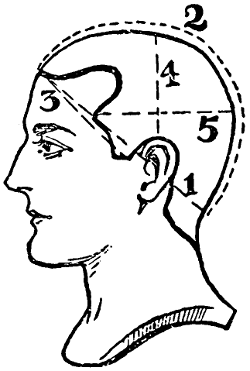
Fig. 17.—How to measure for a wig.
The hands must receive careful attention when the face and neck[33] are finished, and “made-up” according to character. If juvenile, they require coloring; if middle-age, a little of the sallow paint: the veins accentuated, and the flesh made to look pale for old age parts (Fig. 16).
When measuring for a wig, take the various lengths and widths as indicated by the numerals in Fig. 17.
The most inexpensive of these necessary adjuncts to the home entertainer’s make-up are undoubtedly those he models for himself from crêpe hair, which can be bought in a plait and untwined as it is wanted, a coarse-toothed comb being passed through it. With a few twirls it can be made the desired shape and cut, and when wanted for a beard, opened out until it has a hollow cone-shape appearance, and placed on the chin after a thin coating of adhesia has been applied.
The same method applies to eyebrow and mustache making. When it is desired to create an unshaven, unkempt effect, pieces of crêpe hair are cut up exceedingly fine on to a newspaper, the chin covered with adhesia and the finely-cut hair sifted evenly over the skin. These little pieces are also useful for sprinkling where the false beard meets the face, in order to take away the “abrupt” appearance that is often produced.
Having told how to put on make-up, a few instructions for its easy removal may not be out of place. Whilst soap and water will take off the grease paint, the simpler method is to remove it with one of the following: Cold cream, cocoa butter, or olive oil. Vaseline is to be avoided, as it will often cause a growth of hair; and for this reason when purchasing cold cream it is advisable to procure the best, for in the cheaper makes vaseline is largely employed. Pieces of cloth kept specially for the removal of “make-up” are to be recommended, one for taking the chief layer off and another of soft texture for final rubbing before the much-needed wash is resorted to.
For dispelling traces of the prepared burnt cork used for minstrels and negro burlesques, a pure vegetable soap is all that is required.
[34]
The machinations of the full-fledged quick-change artist afford the mind of his amazed spectator much speculation and curiosity as to how his marvels of dexterity and transformation are achieved. His velocity would put summer lightning to the blush. His mind and body are as pliable and elastic as his face; his very nature appears to undergo a swift metamorphosis of changes in the adoption of the various manners, idiosyncrasies, attitude, and gait of the character he portrays. Although agile and unerring, he possesses something of the stoic calm of the hedgehog, and is as natural in his art as when partaking of a beefsteak in privacy.
He flashes before the vision on stage or drawing-room platform in dress so immaculate that it would seem to the uninitiated that his toilet is the result of hours of care and deliberation. In the costume of an old-world dandy he struts about, swaying his long-laced sleeves with exquisite grace over his snuff-box, the while he patters his part. A moment after, like a shooting star, he has swung himself through a door, reappearing almost instantaneously by means of another entrance, transformed in wig and attire to a totally different individual in age and character.
Thus he continues playing his many parts so nimbly that one can scarcely believe he has not a bevy of actors hidden in the wings ready to fly through doors and windows as quickly as a cork pops from a bottle.
That his agility is grounded on a studied method, and his versatile acting the result of wheels within wheels, well-oiled, and precise as the mechanism of a clock, is difficult to believe until his secrets of manipulation are revealed.
“How is it done?” whispers the youth, palpitating with aspirations to do likewise. Well, in only one way—that way simplicity itself, when once practice has made it perfect.
I am dealing now with the man who produces a play in which each rôle is played by himself, and will proceed to explain his[35] proceedings from the start, so that the ambitious amateur may, at the next Christmas party or home gathering, try a humble imitation, and gradually achieve glory and greatness in the eyes of his family.
Let us study the tools and qualities essential to the quick-change artist. His stock and properties are all inexpensive, save the wigs. It is not advisable to purchase cheap ones, as they soon show the signs of wear; while hair in good condition, and carefully kept, lasts for years.
His wardrobe contains garments of the cheapest material, and here the old clothes-bag of the house, in which articles doomed for a jumble sale are placed, is invaluable. A clever needle and a little ingenious manipulation result in splendid effects.
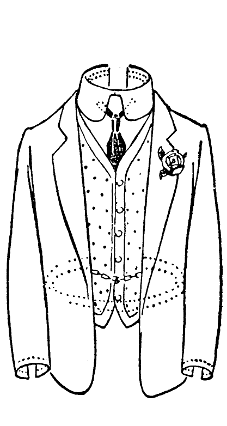
Fig. 1.—Front view of “one-piece” garment; dotted lines denote springs.
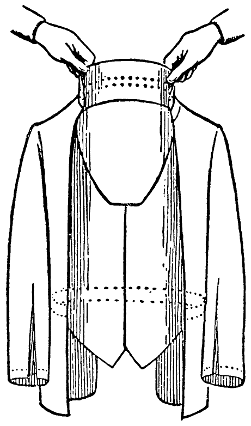
Fig. 1a.—Back view of “one-piece” garment.
Every garment is made in one piece, and fastens at the back of the performer by means of clock springs, which may be purchased from any clockmaker (Figs. 1 and 1a). The springs are pliable bands of steel, cut and rounded, according to the size required, and punched with small holes, by means of which they are fixed with stitches to neck, waist, legs and wrists. These springs should be carefully[36] concealed in the hem, with sufficient material over to hide the opening at the back.
There is no time for fastening of buttons, tying of strings, adjusting of pins, or plastering of gum. Even the mustaches used are fixed by means of small silver springs, which adhere to the interior of the nostrils as firmly as the springs of eyeglasses pinch the top of the nose (Fig. 2).

Fig. 2.—Back and front view of mustache fixed by spring.
The scenery required is also easily manufactured at home by the amateur carpenter. Thick brown paper, light wooden frames, or, better still, samples of wallpaper, fixed with small brass hinges, will serve excellently as an interior.
Until the student is far advanced in dexterity, it is wisest to limit his production to one environment.
The first thing, of course, is to choose a suitable piece. If you are clever with your pen, you may compose a sketch to please yourself. This is a good plan, for you will be governed in your production by what is most suitable and easy to your limitations. If, however, no suitable idea presents itself to you, go to any good dramatic firm, and spend a morning in looking through plays until you alight on something answering to your purpose.
In choosing a play, avoid an elaborate cast, complicated plot, or speeches. Long monologues are wearisome and monotonous; while, on the other hand, conversations of too rapid a character will be impossible to manage satisfactorily, however skillful your manipulation.
The novice should begin with a curtain raiser, containing two or three persons, and the movement should be brisk and interesting. Having fixed on his play, he studies his scenery.
He must have sufficient entrances and exits. To use only one, so that the audience always knows through which door he is about to appear, spoils the effect of his cunning. It is far more dramatic to burst upon them from a direction least expected, and, to do this successfully, as many doors or windows are necessary, as in a production played by several persons; but these should not be so placed as to be aggressively prominent,—curtains, palms, screens, a sham[37] cupboard or fireplace, by means of which sudden comings and goings lend a thrilling reality to every movement. Fig. 3 depicts a suggested plan.
The different costumes to be used should be numbered in the order required, and this is where a cool-headed and reliable dresser is absolutely essential.

Fig. 3.—Suggested plan of scenery arrangement for the quick-change artist.
To robe oneself by means of picking up garments and wigs from chair or different pegs is slow work, and leaves the stage empty for too long a time to keep the spectators interested in one’s movements. The swiftest manipulation will be too slow to those awaiting the re-appearance, and, unless the movement is kept jogging, there will be no semblance of reality in the performance.
The dresser plays a part no less important than the artist. Upon leaving the stage the latter immediately wrenches from his person the garment in which he has just appeared. The dresser is close to the exit with costume No. 2 held out widely. The performer walks straight into the clothes, of which the clock springs are widely expanded. In a flash they close round his person. Another dresser adjusts wig, beard, &c., as he passes to his next entrance (Fig. 4), with the result that he[38] appears to answer the remark made by himself in the character No. 1 without any break being perceptible to the audience. Whilst speaking the words in the rôle of No. 2, the dresser is awaiting him at the next exit with No. 3 or No. 1 clothes, (if No. 1 and 2 are having a conversation), which he has swiftly picked up from the floor when discarded.
It is obvious that in order to be of real service the dresser must be as familiar with the words of the play as the performer. It is not enough only to know the cues. He must, by his knowledge, calculate to a hairbreadth how long No. 2 takes to reply, and be prepared upon the instant of exit with the apparel of No. 1.
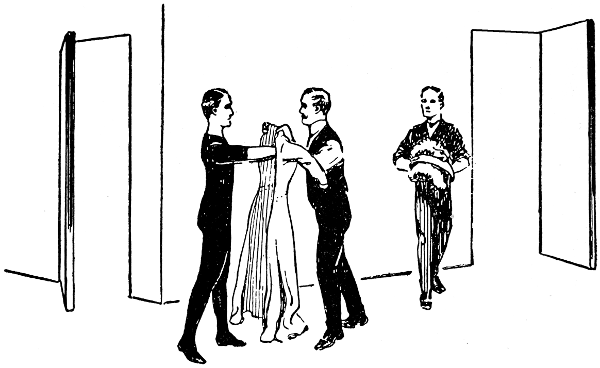
Fig. 4.—System of “changing” behind the scenes.
A plan of modes of entrances and exits should be arranged beforehand between actor and dresser, and never altered. Each sketch must be founded on a different plan, and in each the movements should be so carefully practiced that they become almost a habit. Any chance alteration or mistake leads to bungling and loss of time, for, if No. 1 disappears through the exit fixed upon for No. 2, naturally the dresser will not be there awaiting him, and this mischance will probably throw all the succeeding movements into confusion.
The quick-change artist is employed in a race with time, and, time being swift and fleet of foot, the human competitor cannot possibly afford to loiter or blunder.
In a play or sketch in which several characters are to be impersonated[39] it does not make for speed to have installed as many dressers behind the scenes. One, or at the most, two reliable and experienced assistants are ample. A larger number will only hinder the artist’s and their own movements.
That there is a certain amount of nervous strain about this mode of performance cannot be denied, but, by constant practice and coolness, the artist greatly facilitates the mental effort that accompanies his portrayals.
A sketch should at most be of a half-hour’s duration. The actor needs some knowledge of acting, and must be able to change his voice to the different pitches required. It should range from the high-pitched falsetto of the aggressive female type of uncertain years to the gruff bass of the dogmatic father, while the cooing notes of the immaculate heroine should be carefully cultivated.

Fig. 5.—Showing wig, eyebrow, nose, and mustache combined.

Fig. 6.—Another example, showing bonnet, wig, nose, spectacles, and veil combined.
The artist must of necessity be clean-shaven, so that he can adapt beard, “mutton chops,” or mustache as required.
Figs. 5 and 6 show completed examples of one-piece transformations. Fig. 7 depicts coat and breeches combined.
Most important of all the quick-change artist must be self-reliant, self-confident, and absolute master of emotions engendered by nervousness, for these lead to loss of memory where words and modes of entrance and exit are concerned. While on the stage his mind must be concentrated on the part he is playing to the exclusion of everything else,[40] his attention as completely focused upon the impersonation as though the other characters were being undertaken by different individuals.
For many of these practical suggestions the writer is indebted to a versatile quick-change artist, who willingly revealed some of the secrets connected with his favorite form of entertainment. He emphasized the fact that success is not achieved by means of numerous wigs and costumes—a performer may possess the most elaborate wardrobe, repertoire, and paraphernalia, and yet sadly fail to move the interest and sympathy of his spectators.
As this artist remarked, the true art lies in facial expression, gesture, attitude, and change of voice. These must be cultivated assiduously before any one-man play is produced, for it is only when the features are plastic as rubber, gesture and attitude the perfection of mimicry, the voice containing every note in the range in which language is expressed, that the steep ladder of success is scaled, and the timid novice becomes transformed into the popular resourceful artist.
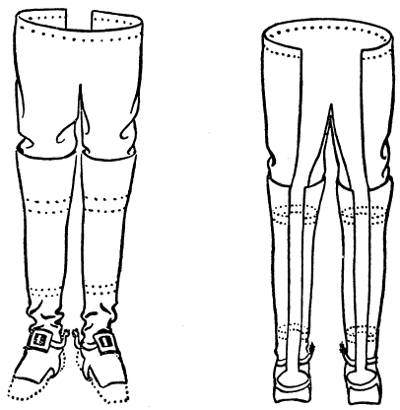
Fig. 7.—Breeches and boots, showing front and back views; dotted lines indicate springs.
[41]
A very popular means of amusing a house-party is the impersonation of various characters. It is an entertainment more suitable to the limits of a drawing-room than tableaux or amateur theatricals, which of necessity entail a certain amount of expense, scenery, lighting, and much labor and anxiety in securing and drilling an efficient cast.
Although it is doubtless true that this art needs some natural talent, skill, and mastery of detail, much can be done by practice and self-reliance.
A clever man in the street amuses a long line of patient theater-goers, his only paraphernalia being a soft, pliable disc of black felt.
The metamorphosis that article undergoes in his hands is a marvel. Dexterously he wields it—a mere twist, and it is the three-cornered biretta of a cardinal. Another, and it shades the villainous glare of a brigand, who appears quite capable of cutting the throats of his audience. A deft touch and a strut, and it tops the head of a swaggering dandy. Next it shades the solemn, ascetic features of the priest. Tipped to a different angle, and the cockney grins with happy-go-lucky impertinence. Thus it is used to represent every grade of society from the highest to the lowest of humanity.
But miraculous as that piece of felt seems, it is really the eyes and gestures of the artist plying it that lend it personality, power, and magic of transformation. In the hands of one ignorant of the tricks, it is a futile and clumsy piece of mechanism.
A man may put a tea-cosy on his head and look absurd; another does the same, and behold!—a living Napoleon stands before us. The greater the artist, the simpler the preparations used, for the skilled representative trusts to eyes, gesture, and figure rather than to the material used.
Elasticity of feature is essential. Without this it is impossible to produce a living likeness. One may possess wigs, beards, eyebrows, sham noses, and skulls of every imaginable shape and size, and yet fail through inability to assume the expression peculiar to the study undertaken.
[42]
In rehearsing impersonations a mirror is as good and true a friend as in reciting. Observe how faithfully it reflects every change in the human countenance.
Supposing the character studied to be that of King Lear. First read your Shakespeare and memorize the lines which reach the very crisis of the agony and woe of love of that unfortunate monarch, as when, turning to his ungrateful, malignant daughters, Regan and Goneril, he cries—
Understand the breaking, raging, heart-throbbing beneath them. Repeat them aloud before the glass, with wild, burning eyes and quivering lips, with shaking hands upthrown and tensely up-drawn figure, and by-and-by, if not at once, you will see King Lear peering at you distraught.
When you have thoroughly gripped that image you may crown it with snowy hair, pent brows, and ragged beard—but not till then.
And now, supposing, for a change—for there is nothing like variety—you undertake so utterly different a character as that of his faithful fool. Here no jingling bells and jester’s folly are needed to aid you, for these may be, and frequently are, but the danger signals to discerning eyes of incompetent treatment; you want his shrewd, loyal heart in your breast, his pulse beating in your brain, your finger-tips. His cunning grin must be a wavering crack in a wizened face as you memorize such caustic saws as—
“Thou hast pared thy wit o’ both sides, and left nothing i’ the middle; here comes one o’ the parings.”
This method of memorizing and voicing some sentiment characteristic of the figure presented, is only for private use during rehearsals.
Costume performances are dumb, and, this being the case, it is easy to realize how eloquent and exact the physical contour must be for faithful similitude.
Regard the idea as an object being photographed. When you have gripped it, and, as it were, posed it before the camera of your brain, focus, produce, and develop it on your features, which may well be likened to a film.
[43]
In order to master the idiosyncrasies, mannerisms, eccentricities, and habits of characters, study is essential, and for this reason it is probably best to acquire knowledge, not from imaginary heroes of fiction or drama, but from the fount of Nature.
Popular statesmen, musicians, admirals, soldiers, prelates, scientists, novelists, and famous actors walk our streets to-day, and each possesses some anomaly of expression, feature, speech, gesture, or mannerism which is distinctly his own, and distinguishes him from his kind. Just as no two leaves of a tree or petals of a flower are exact duplicates, so in mankind—no matter how subtle the anomaly—it exists, and must be fathomed and included in the portrait; delicately if it is delicate, proportionately broadly and ostentatiously as it is broad and ostentatious.
For example, there are some persons whose peculiarities are as evasive and subtle as the bouquet of a wine, the bloom of a grape. We feel their influence, we realize them to be the essence of their individuality, and yet we fail to catch and master them; while there are other persons we meet whose eccentricities flare out at us in a moment, and illuminate a character more fully and faithfully than any words.
The pouting lip, the flickering eyelid, the shrug, the drumming on the table with the fingers, the stroking of nose or chin, the revolving of thumbs, the pushing or patting of the hair, are eloquent signs that he who runs may read, and make his own. These may be called ostentatious mannerisms.
The subtle peculiarities are far more difficult to catch and convey faithfully. One man suddenly narrows his eyes and looks introspectively at you, or the mouth clinches unexpectedly over the teeth without any apparent reason. A pulse suddenly quivers into sight at the temples, and is gone again. The expression falls into repose, but that very stillness indicates a perplexing and evasive expression of temperament and individuality that you cannot catch to your own satisfaction. You may note coloring of hair, beard, mustache, &c. You may purchase their exact match, and find the likeness only a shell, because the essence that lends delicate fragrance and character has escaped you, and without it your representation, however flawless in coloring and texture, is as unsatisfactory and unreal as the marble statue to the human face and form.
Fundamental to the successful rendition of character impersonation is the cultivation of dexterity and quickness. The dumb representative[44] must have all his regalia of wigs, beards, eyebrows, hats, helmets, cloaks, &c., well arranged, and within easy reach.
In a sense he is a conjuror—a magician. His movements must be swift as lightning. Indecision creates a jar; a pause or bungling spells failure. A small velvet-draped stand or table placed behind him, and within easy reach, with each article ready in the order wished, is essential. In the center of this should be a mirror, with a good electric light over it, but shaded as much as possible from the audience (Fig. 1).
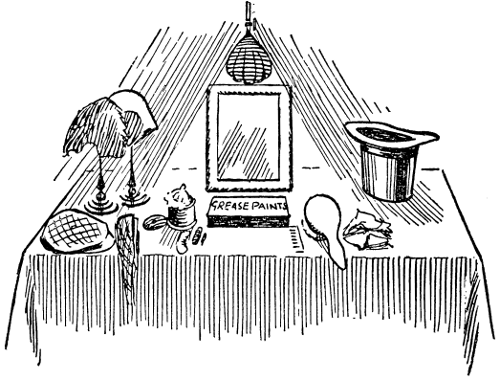
Fig. 1.—Character impersonator’s stage table.
The stand must be draped in dark colors, so as to obtrude as little as possible on the audience. While in preparation, all other lights near you should be turned off, and only switched on for a moment or two the instant you are ready. The attitude should be struck in the dark, and this must be sure and swiftly taken, and absolutely in keeping with the character assumed. Avoid grease paints as far as possible.
A pianoforte or small orchestra playing some melody suitable to the impersonation will prove a most valuable adjunct to the imagination of artist and audience.
Avoid such hackneyed characters as Napoleon, the late Sir Henry Irving, the German Emperor, and similar portrayals that may be witnessed any evening at almost any vaudeville hall. An audience is[45] frequently more amused by the imitation of types than of individuals.
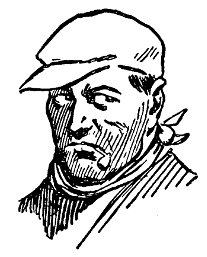
Fig. 2.—The costermonger.
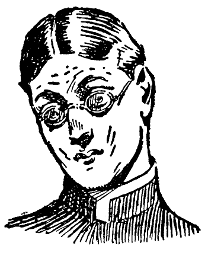
Fig. 3.—The lady-killing curate.
The fat saloonkeeper, the costermonger (Fig. 2), the blasé gentleman of fashion, the racetrack bookmaker, the ruddy countryman, the lady-killing curate (Fig. 3), and the typical Soap King (Fig. 4), the country rustic (Fig. 5), and many other such types are excellent studies for representation.
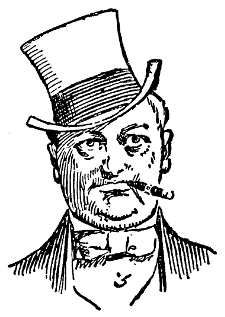
Fig. 4.—The soap king.
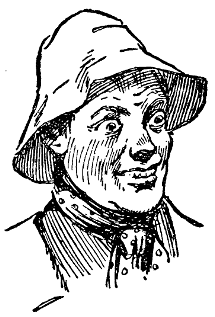
Fig. 5.—The country bumpkin.
Although the character portrayals of the costumed and wigged impersonator depend on wordless demonstrations between the items and in ordinary evening dress, the artist may announce the name of the personality to be represented, or have it worked in almanac fashion and shown to the audience as it appears.
The former method, however, is quite usual, and perhaps more suitable to drawing-room entertainments.
[46]
It may be kept in mind that this style of performance should not be unduly long, and should never exceed twelve or fifteen minutes.
Speaking impersonations are more difficult to achieve successfully, for in them, as a rule, the artist has no regalia to depend upon. His hair, his face, his voice, his limbs, his fingers are his only aids, but these are more than sufficient for the talented and skilled performer. His voice is as elastic as his features in power of mimicry.
He should be clean-shaven, but with a plentiful crop of hair, which he can arrange and manipulate as he wishes with a mere twirl or pat of the hand, and these must be sympathetic and convincing expressions of his every movement. “There is no more expression in the back of the hand than in the back of the head,” yet of what subtle demonstrations is it not capable?
A whole epitome of human emotions may be demonstrated by the gradual unfolding of the flexible, sensitive fingers. The first finger raised, and intelligence and meaning begin to develop. The palms upturned, the shoulders uplifted, and the head slightly bent, and you see the suave helplessness typical of the Frenchman.
The arms flung outward, with the palms parallel, and the fingers falling naturally, indicate sentiments of affection, welcome, and cordial invitation. Stretched farther away, with fingers distended, and you have entreaty, desire, passionate pleading, and supplication. The wrists upturned, the fingers crooked, and grasping, and we see the personification of rage and avarice, while the raising of the open hand, what horror it indicates!
Yet the hand is only a part of the mechanism. Its soul is in the eye, which combines in partnership and signifies calm, candor, liberality, love, gentleness, meditation, resentment, boldness, defiance, wrath, and fear, in complete accord with its dumb component.
The nostrils inflate in scorn, the head is proudly raised in dignity or joy, and meekly bowed in humility; bent forward in shame, squarely upright, with firm compressed features, for determination and will power.
The artist must never be tempted to sacrifice his cultured discretion in a portrayal. For instance, to give the cockney the musician’s hand, or the priest the bookmaker’s wink, the sly housebreaker anxious to escape notice the loud, boisterous guffaw of the countryman, is to be guilty of the most insensate blunders.
Action and gesture should be skilled and practiced handmaidens[47] to the brain that molds the idea, and their service must be winged to respond.
The psychological treatment of characters depends and is influenced in no slight degree by temperament. The character the student is about to study has its peculiar atmosphere of mind and body, which unconsciously dictates and regulates its actions from head to foot. The most important temperaments are:—
1. The optimistic temperament, embracing impulsive, warm-hearted, sanguine, easily-pleased, tender, ambitious dispositions.
2. The pessimistic temperament, embracing nervous, timid, sensitive, overwrought, peevish, unstable, irritable, depressed, neurotic, restless, dissatisfied, cynical, morbid, self-conscious dispositions.
3. The artistic temperament, embracing extravagant, sympathetic, imaginative, languid, reckless, turbulent, excitable, hot-tempered, brooding dispositions.
4. The commercial temperament, which embraces the phlegmatic, lymphatic, enigmatic dispositions.
Now, the first way of approaching a new study is to consider what characteristics it possesses, and to what class of temperament it belongs, and, when this is decided, the student asks himself, what gesture will be the most symbolic and eloquent of that temperament?
This method, conscientiously adhered to, will provide a safe and firm groundwork for the beginner.
With judgment and sense, he will soon be able to place his character in its right niche, and to plan his actions in accordance, even if he has never seriously studied gesture. The movements of an open-hearted, liberal man are usually large, free, and liberal. He opens his arms widely for an embrace. He gives you his hand in greeting warmly, and with frank, cordial pressure. His eyes shine clear and steady below a benevolent forehead. His walk, with its free, steady swing, is the index of his generous and kindly disposition.
Now contrast him with the mean man, the usual type of which is pinched in physical delineation, action, expression, and thought. His hair grows sparsely on a skull, screwed as grimly to his face as the upper section of a bicycle bell to the lower. His eye is squeezed in a narrow slit of socket, roves backwards and forwards like a marble[48] in a puzzle-box. His mouth is withered in bitter antagonism for his fellow-men. To catch a generous smile upon his colorless lips is to surprise a sunbeam at midnight.
Of course, there are many shades in the scale between these extremes of the very liberal man and the very mean one, and the artist who is imitating the thrifty soul must remember the infinitesimal points of difference which distinguish him alike from the benevolent and avaricious.
And, in the wide margin of temperaments, an artist must be careful not to label and pigeon-hole his characters as if they were bottles of physic, for in the complex nature of one man there may be vast contradictions, just as in many good medicines there is a minute quantity of poison, so a disposition may be tinted with qualities not at all worthy of admiration.
There are occasions when the most impulsive becomes cold and hesitating, the most affectionate cruel, the most benevolent calculating, and the most patient, hot-tempered and passionate.
The artist must never forget the important crucible of circumstances which molds and forms each character, and sometimes is potent to change the most optimistic temperament to one of pessimism and cynical bitterness. Yet, while remembering this, one must probe beneath the stamped envelope of environment to decipher the hieroglyphics of the fettered soul inclosed.
One does not find the wild, untutored gestures of the stump orator in the refined politician, nor the turbulent raving of the fanatic in the sermon of the cultured ecclesiastic, while the expression natural to the plebeian is such as the aristocrat never indulges.
There are many natures so complex as to defy all classification, and to portray them successfully is an almost impossible matter unless one masters the delicate mechanism of their nature. A grandfather’s clock to outward appearance is a figured circle in a narrow wooden case, with softly regularly-moving pendulum, but get behind that exterior to the revolving wheels, and see what an amount of intricacies are involved. So the man who presents a calm, self-possessed exterior to the world, may in reality seethe with qualities not at all phlegmatic or level-headed.
In conquering the technicalities of character, one must, as far as possible, grip the crisis the personality has reached in his lifetime, and this is one reason why a historic character is easier to grasp than one contemporaneous. For example, he who portrays Napoleon in the flush[49] of success and victory, does not represent him as he who images him at the end of his career—broken-hearted, alone, and in despair, suffering the calumny and scorn of those who exhibited most faith and admiration of his sanguinary achievements.
Correct attitude and pose are extremely important, and should be carefully studied. The old man has tottering bowed knees, but the youth stands firmly.
The reverberation of the interior gestures rules and gives to the torso or trunk the inspiring grace of truth and beauty. It is only when a soldier or sailor on duty is being represented that the artist may stand bolt upright and move automatically. At all other times the torso should be held with flexible ease, ready to combine with eye, face and gesture, in the emotion and force of the impersonation. To portray the child with mature and abandoned gesture is to present a caricature of nature, and, in like manner, to represent the adult with the careless gestures of the child, is to convey the impression of one inane and undeveloped.
In attitude, remember the maxim of Cresollius: “Without the hand, no eloquence.”
To imagine a boy stealing jam with the wild eye and hand-clawing attitude of the miser snatching at gold is to exaggerate grossly and confuse the human emotions, and to paint comedy as the burlesque of tragedy. The hands are capable of such a vast amount of expression that they have been considered “numerous and copious as words themselves.”
While imitating characters, never be bound by the representations of other artists you have seen. See with your own eyes, study with your own brain, avoid that conventionality of fashion and ideas that cripples progress. Let your maxims be your own, and, when they are mastered, be not ashamed to demonstrate them with grand and self-reliant originality.
[50]
Every entertainer must have felt at some time or other the need of a short “gag” to fill up that awkward gap which so frequently occurs between the conclusion of one long piece and the commencement of another.
The mind of an audience is of a flighty nature and requires to be kept continually amused, or it will wander into paths of boredom; and many a good entertainment has failed for the simple reason that the ball has not been kept rolling.
It is during one of these uncomfortable pauses that the Universal Hat may be appropriately introduced, and, if worked well, it cannot fail to gain approval.
You can either buy or make a Universal Hat, and as to do the former will cost a dollar or more, whilst the latter can be done for less than half that sum, it is well to be your own hat-maker.
Obtain a piece of fairly strong black felt, measuring 24 inches square, and cut it into a ring, the diameter of the whole circle being 24 inches, with a hole in the center 7 inches across. That is all that is required as far as the hat is concerned, and the success of your piece will now rest entirely with yourself.
Arrange a screen behind which to retire, and have a good-sized mirror, so placed that you will be able to see in a moment how your head-dress suits. Keep a little rouge ready, as well as a burnt cork for blacking eyebrows, making mustaches, &c. Remember that quickness is a necessity, for the smarter you are in changing your hats the more the audience will appreciate the effect.
Now to give a few examples of what can be done with the universal hat, so arranged as to give scope for any amount of ingenuity in inventing new ideas.
Before beginning your show step from behind the screen, raise the ring of felt in your hand, and exhibit it to the audience. Then step back under cover, put the hat on your head, giving it a tilt in[51] front and a rakish tip to one side, assume a stern expression, and, if you have a dog-whip amongst the stage properties, grasp it firmly in your hand, and make an appearance before the spectators in the character of Buffalo Bill. Take care always to face the audience as in Fig. 1, otherwise the top of your head will be seen through the hole in the hat.
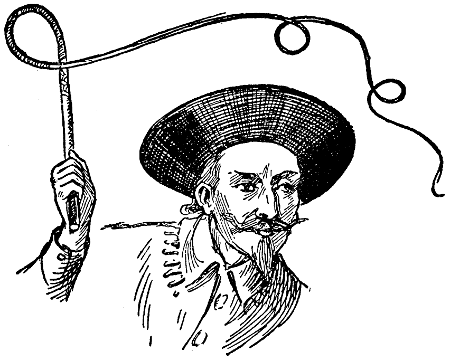
Fig. 1.—Buffalo Bill.
Remember that in this, as in all the other characters, a lot—indeed, almost everything—depends upon your expression, which should be entirely in keeping with the person you represent. Buffalo Bill must not wear a grin, but must appear as grimly in earnest as though he were hastening to the relief of the Deadwood stage.
Another point to bear in mind, is that you must not make a long appearance. A minute for each character is ample, and, as you appear before your audience, announce who you are in a tone suggestive of the person you are representing. A few remarks in keeping with the character will greatly add to the realism of your make-up, but let your words be like your appearances—brief and effective.
Napoleon makes a good character to represent, and his hat is very easily made. Draw two sides of the felt through the hole in the center, and pull the hat firmly down about your ears, as in[52] Fig. 2. Assume a stern expression, suggestive of Waterloo, thrust your left hand into your breast, hump your shoulders, and look fiercely at the audience as though you could see Wellington at the farther end of the room.
Later on in the performance you can represent Bonaparte’s great antagonist by making the hat in the same way, but wearing it with the peak forward as in Fig. 3.
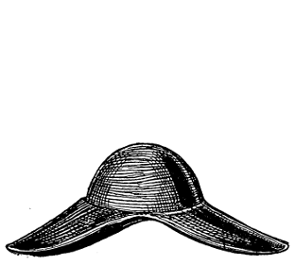
Fig. 2.—A hat suggesting Napoleon.
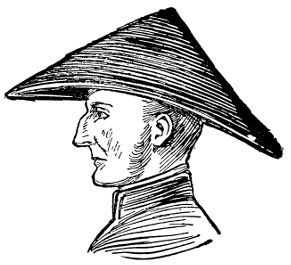
Fig. 3.—The Iron Duke.
General Wolfe is another easy character to assume. His hat is made in this way. Lay the felt ring flat on the table, lift up one side, draw it towards you and then pass it downwards through the hole. Pull back the piece that you have passed through the hole, in the direction from which you took it in the first place, and you will find it has made a hat of the shape shown in Fig. 4. When you fit it on your head pull it firmly down towards your ears, but not too tightly, and the effect will be complete. A little practice will serve to perfect you in making the twists necessary for this and other hats, and patience will soon reward you. To heighten the resemblance to General Wolfe, whiten your cheeks with a little chalk and draw them slightly in, to give the appearance of being haggard and wan. If you can get a sword, point to the ceiling with it enthusiastically, as one can imagine the General did when he encouraged his men to climb the Heights of Abraham.
As a contrast to these more exalted personages, you can now appear as the coal driver; although if you wish to increase the realism by smearing your face into a state of suitable dirtiness with burnt cork, it would be advisable to leave this character to the last. To make the hat, lay your felt flat as before and draw up a piece from the rim as was done in the case of General Wolfe. Now, instead of passing it completely through the hole, push it only halfway through, giving[53] it what may be called a half twist. It will then appear as in Fig. 5, ready for wear. Draw it tightly over your head, and slouch upon the scene, putting your hand to your mouth and shrieking “Coal O!” in a cracked voice.
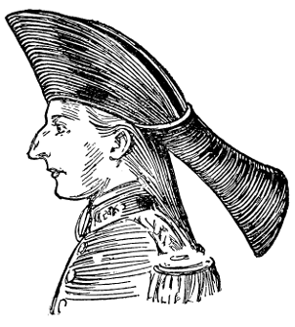
Fig. 4.—General Wolfe.
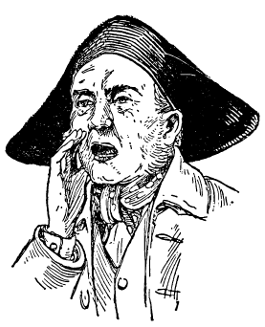
Fig. 5.—The Coal Driver.
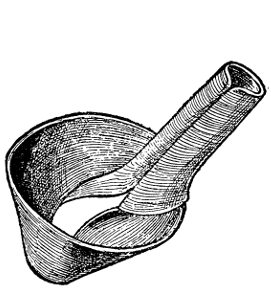
Fig. 6.—A Priest’s Biretta.
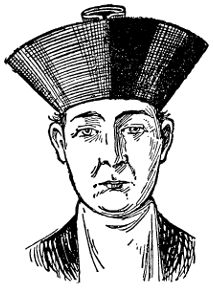
Fig. 6a.—A Priest.
You may now appear as a priest in a biretta. Place the felt upon the table and then draw a side from below, up through the hole, exactly[54] the reverse way from that in which Wolfe’s hat was made. When you have drawn it right through, bend it down and pass it up through the hole once more, thus making two twists. It then resembles Fig. 6, and if you draw it upon your head with the broad brim flush against the forehead, the impersonation will be striking. Tuck a little lapel of white into the collar, raise your right hand with two fingers extended, and face the company with as pious an expression as you can assume.
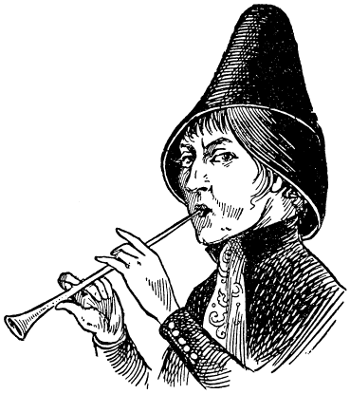
Fig. 7.—The Pied Piper.
As a last example, an effective appearance may be made as the famous Pied Piper of Hamelin. Having laid the felt flat, make a twist from below upwards, as you did in the former hat—the priest’s biretta. But for this hat only one twist is required, so when you have done this, the hat will appear as in Fig. 7. You must now put your hands in the opening and stretch it as wide as possible, thus making the rolls very taut and firm. Turn the felt over and fit it on the head as shown in the picture. Draw your collar up, take a tin whistle in your hand, and pipe a few notes before making your appearance. Then slink into view with a cunning smile upon your lips, reciting these lines from the poem:—
[55]
Of course these are but hints. An ingenious person will soon discover endless other ways of adapting the Universal Hat in such a manner as to keep the audience amused for some considerable time. Always remember, however, these two axioms—
[56]
Some people imagine that a black face, a pair of large check trousers and a rather dilapidated hat, are all that’s necessary to make a nigger minstrel. This is, however, a great mistake, and whosoever feels the stirring of an ambition to amuse his friends with a nigger entertainment, must not be discouraged if he finds the road harder than he expected. Its difficulties, however, are far from insurmountable.
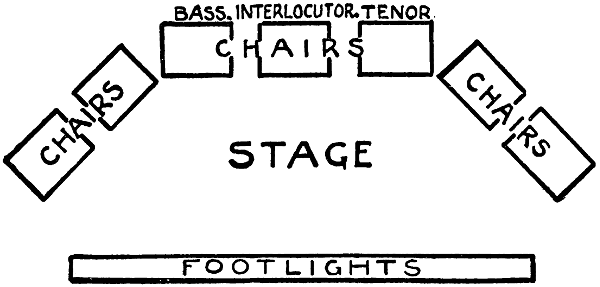
Fig. 1.—Seating arrangements of nigger minstrel troupe.
For a really successful nigger entertainment seven persons are necessary; the interlocutor—usually known as Mr. Johnson—one bass and one tenor singer and four “end-men.” The troupe should be arranged as shown in Fig. 1. Now, before describing what to do, a few words as to how you should arrange yourselves will not be out of place. The stage should be raised, if possible, to enable any member of the audience to see the performers. Unless you are performing[57] a farce or drama, such as will be described later, a curtain is not absolutely necessary, provided the troupe can get to the stage without having to pass right through the assembled company.
As far as “make-up” is concerned, this should present no difficulty whatever. Many barbers, and some music shops, can supply “nigger black,” which must be rubbed into the face and hands, after the skin has been well washed and dried. When the performance is over the black can easily be removed by means of soap and hot water. To redden the lips and enlarge the mouth, use carmine or rouge; cover the lips and paint them to appear as though stretching almost from ear to ear (Fig. 2). Cheap wigs can be obtained for but a small sum from any hairdresser. Those of Mr. Johnson and the sentimentalists should be as shown in Fig. 3, while each of the “end-men” should provide himself with one similar to that depicted in Fig. 4. The “interlocutor” and sentimentalists usually wear ordinary evening dress, the “end-men,” however, wearing frilled collars, cuffs and fronts, as shown in Fig. 5. A complete outfit comprising stockinette face, head, eyes, teeth, and hat can be purchased for about $2.50.

Fig. 2.—Showing how the lips are painted.
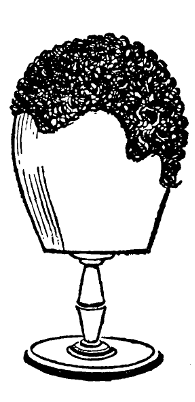
Fig. 3.—Interlocutor and sentimentalist’s wig.
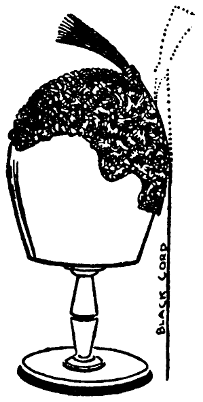
Fig. 4.—End-man’s wig, showing workable tuft.
[58]
Music is a necessity with a troupe, and you will accordingly require another person to play the piano as an accompaniment to the songs and choruses, as well as for the overture and instrumental pieces. It is also presumed that the members of the troupe have fairly good voices and are able to sing, not only in tune but in time with one another.
In serious or sentimental songs, such as “Swanee River” and other favorites, the “end-men” must forego their love of mirth and take part in all solemnity, reserving their facetious behavior for a more timely moment. After these remarks the principal characters in the troupe may be discussed.
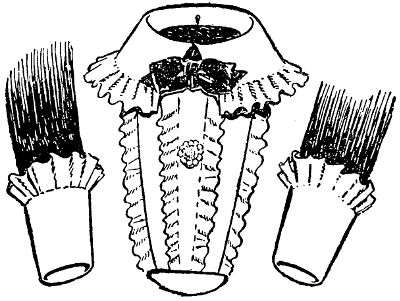
Fig. 5.—Frilled collar, shirt front, and cuffs used by end-man.
The interlocutor is one of the most important persons upon the stage. It is his duty to introduce each number of the programme to the audience; to be the butt of the “end-men’s” jokes; and to assume upon every occasion an air of the utmost ignorance and simplicity, that shall prove an admirable foil to the exuberant humor of his companions. He must appear absolutely innocent of any idea of the answers to the riddles and conundrums asked, and must reply to the occasionally personal remarks of his friends with the utmost suavity and good humor. In short, what with helping the others to sing and keeping the ball rolling generally, Mr. Johnson is responsible, to a large extent, for the success or failure of the entertainment.
The “end-men,” with whom lies the task of producing most of the fun of the nigger entertainment, must be possessed of a ready wit—able to tide over awkward pauses, prepared with some “gag” when the fun is beginning to flag, and capable of turning disaster into a mighty success. From Mr. Johnson’s placid obtuseness they will be able to draw much sport, and bandying jokes at each other’s and the interlocutor’s expense, should keep the audience shaking with laughter.
Whilst on the subject of jokes a note of warning may be struck. The moment humor changes to vulgarity, it produces disgust in any respectable audience. It is therefore well worth while to think over the regular jokes you intend introducing into the performance, and if[59] there be any that are in the remotest way likely to offend the feelings of any person in the company, cut them out.
There is another point worth remembering in the matter of jokes. It may seem a truism to remark that a joke should be funny, yet the very funniest of jokes will fall flat if it is not led up to suitably. Don’t ask Mr. Johnson a conundrum in a meek tone as though you were requesting him to tell you the time. His immovably suave ignorance will extract the answer from you, it is true, but the chances are ten to one that the audience have either missed the question or will fail to see the point of the answer.
Jokes should be introduced by a certain amount of patter which serves to engage the attention of the hearers in such a way that when the inevitable fun really comes they are perfectly prepared to appreciate it. Books can be bought containing numbers of these jokes with the suitable patter, and these will prove very useful to the amateur, who must nevertheless remember that success really depends upon the way in which he springs the joke upon the audience.
And now a word about the singing. It goes without saying that the larger the troupe and the better trained the voices, so much the more enjoyable will be the choruses. The number of songs from which to select is legion; the best plan is to write to some leading musical publisher, telling him what you want. He will be only too pleased to send his catalogue with some advice as to what will prove suitable. Avoid any comic songs with a double or doubtful meaning, and keep to strictly characteristic songs as far as possible. Old favorites never fail to win applause, and are always safe to fall back upon; but do not be too conservative—try some novelties.
Nigger entertainments are usually divided into two parts, the first consisting of songs and “gags,” as the short dialogues and impromptu jokes are called, whilst the second is devoted to stump speeches and one-act dramas or farces. So far as stump speeches are concerned, excellent collections are published by the leading publishers of that class of entertainment. Your bookseller will obtain a catalogue for you, and a choice can then be made. The speeches should be very carefully learnt by heart, together with the appropriate gestures (for which full instructions are always given), and unceasingly practiced until you are able to make your stump oratory bring down the house with delight.[60] Stump speeches are the province of the “end-men,” and properly delivered, can be relied upon to prove one of the successes of the evening.
With regard to one-act dramas and farces, a very exhaustive catalogue can be furnished by publishers, with full instructions as to how they should be performed. A word of advice, however, to the intending actors. Too much care cannot be expended upon preparation and rehearsals. Nothing will go of itself in this world, and least of all plays and sketches; it is a fatal mistake to imagine that the smallest drama or even “gag” will succeed by its own merits and with only a little help from yourself. Endless trouble and care must be taken in preparing the simplest joke, and boisterous as the fun may prove upon the stage, it cannot be spontaneous, but must be diligently rehearsed again and again before it can be presented to your audience.
Your great object is, not to enjoy the fun yourself but to make the others enjoy it, and if this is borne in mind, you will not only amuse them but have a delightful time yourself. Again, never forget that in a play one actor relies upon another to repeat the actual words of the “book,” as cues and stage directions depend upon verbal accuracy. Do not, therefore, introduce any novelties of your own—learn the words and keep to them, for any original introductions on your part may throw the whole play into disorder, exasperate the other actors and disgust the audience.
To keep to the “book” is easy enough, and if you act in earnest—and this is essential for the most comic pieces—you will find no difficulty in sustaining your part correctly and intelligently. Do not laugh at your own jokes, unless you are instructed to do so, but keep a grave face and appear as though to find yourself in the most farcical situations were a matter of everyday life.
To give an idea of a reasonably simple programme which shall include a farce, the following is suggested:—
PART I
Overture on the piano. A march.
Chorus. Some song in which all voices can join.
Solo. Preferably a sentimental song.
Jokes. Properly led up to by an end-man.
Comic Song. Also by an end-man.
[61]
Solo. Another sentimental song. And so on for ten or eleven turns, after which comes the
Interval. During this the pianist can entertain the audience with some operatic piece.
PART II
Chorus. As above.
Piano Solo. Whilst this is being played the stage should be prepared for the
Stump Speech.
Curtain and Piano Solo. During which the stage is arranged for the
Farce.
Solo. Sentimental song.
Finale.
This programme must, of course, be adapted to any exigencies of time, space or other circumstances, but will serve as an example of what can be done.
To conclude with a few hints as to the actual entertainment. If possible, have a sufficient number of programmes printed, or carefully and legibly written by hand, as the most tolerant audience grows restive if it does not know “what comes next.” Distribute these, and let one of your party make it his business to see that the company are properly and comfortably seated. Begin punctually; if your audience have to wait they become impatient, and as there are few people more incapable of seeing a joke than impatient folk, it will be to your own advantage to begin at the proper time. Be as silent as possible behind the scenes; it is very tantalizing for the spectators to hear a wild rushing hither and thither, hoarse whispering, and the various signs of excitement in which they are not allowed to participate.
Of course a certain amount of bustle is unavoidable, but reduce it to a silent minimum. Do not be shy; remember in the first place that the black hides all your blushes, and in the second place that nobody is there to see you, but to see a “nigger” who is going to make them laugh. Half of your audience have probably done the same in their time, whilst the other half would have done so if they could; so take heart, and show them all how really well it can be done. However well-disposed your company may be, do not let that be any excuse for slovenliness on your part, but let it rather incite you to work all the harder, so that when everything is finished and the black is off your faces, the universal opinion will be—“We would never have imagined that it could be carried out so well!”
[62]
In the previous chapter hints have been given to enable a party of five or more performers to give a Nigger Minstrel Entertainment. The object of the following is to show how one or two people can contrive to amuse their friends with a few negro performances.
The pieces are suitable either as items in a variety entertainment, or as convenient “gags” to be introduced between longer entertainments when the interest of the audience is to be sustained by some timely diversion.
It might be remarked, by the way, that it is surprising how much the effect of a joke depends upon the humor of the audience. If they are feeling in a happy and pleasant frame of mind, the mere sight of a comic man is sufficient to bring forth roars and shrieks of laughter. But if a gloom or lack of interest has settled over the company, even the comic genius of the late Dan Leno would most probably have failed to raise a smile.
There are two things almost invariably associated with nigger songs—a banjo and bones. Proficiency with both these is necessary before attempting to give an entertainment.
Practice and a quick ear are indispensable for playing or even strumming a banjo. A very little practice will enable you to strike chords with ease, whilst a quick ear will show when they should be played.
To make a successful “hit” with the “bones” is a question, more or less, of knack.
A set of four bones costs about $1.00. When buying take care they are sound, i.e. with no crack or flaw, and that they contain no core of pith, as this is liable to dull the sound, rendering it quite impossible to obtain the sharp clean click so necessary for successful rendition.
Having obtained your bones—a pair for each hand—you must know how they should be held. Notice they are slightly curved, as in Fig. 1. With a pair in each hand place the ends between the first and second and second and third fingers, the convex sides towards[63] each other (Fig. 2). Hold No. 1 (the bone between the first and second fingers) fairly firmly, although not so stiffly as to rob it of a distinct spring. No. 2 (the bone between the second and third fingers) must be rapped up against its companion by the action of the third and fourth fingers.

Fig. 1.—Curved bone used in nigger minstrelsy.
A sharp shake of the hand will make the bones clap together, while if you keep the hand quivering and also work bone No. 2 vigorously a continuous rattle is produced.
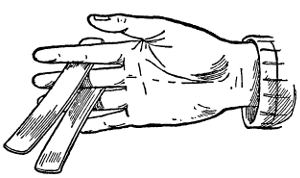
Fig. 2.—How to hold the bones.
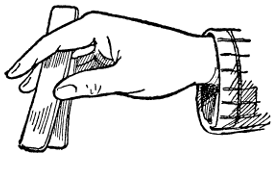
Fig. 3.—Correct position for playing the bones.
A good plan, when once you are accustomed to having the bones between the fingers, is to hold the hand with the knuckles upwards, the bones pointing to the ground, as in Fig. 3. By this means the fingers are allowed freer play. At the same time a better appearance is given to the exhibition.
At first you will find your rattles jerky and spasmodic, but do not be content until you have the bones so entirely under command that you can make a long rattle as easily as a solitary tap, remembering that the less exertion you betray the better will be the effect.
Your own ear will show you how to introduce them into the music. Do not drown the air—the bones are only intended to give a point, to accentuate certain parts and not to render them inaudible. A smart rattle may be given at the commencement of the music and at the conclusion of the song.
All jokes should be introduced by a certain amount of conversational patter between the Interlocutor and “Bones.”
Mr. Johnson, the interlocutor, is always a very simple-minded[64] person, unable to see any joke until it has been fairly thrown at him, and perfectly innocent in the presence of the most obnoxious puns. He has a certain patronizing air with his companion which only serves to make his innate simplicity more delightful. Mr. Johnson maintains an impassive face in the most ludicrous and trying situations by his very matter-of-fact behavior, extracting all kinds of smart things from the funny man.
“Bones” is the very reverse of Mr. Johnson. He is up to all the latest catches, full of quips and puns, is possessed of a never-failing store of quaint experiences and remarkable stories, the most improbable of which are gravely swallowed by Johnson. Yet the big red lips on his broad black face must be immovable and never show the least symptom of a smile as he recounts with stolid solemnity his marvelous doings to his credulous friend.
The following dialogue is arranged for these two characters. Mr. Johnson asks Bones all kinds of simple and apparently harmless questions; but Mr. Bones replies with a constant succession of puns and jokes:—
Johnson. So you’ve been enjoying yourself, William, lately, I understand. Dining out a good deal?
Bones. Oh yes, that’s right. I’d dine with anybody.
Johnson. Yes, but I’m told you dined with the Mayor last week. Is that right?
Bones. Oh yes, that’s right.
Johnson. Then I suppose you had an excellent dinner—plenty to eat and drink. What was the menu?
Bones. Well, to tell you the truth, there was a lot of ’em there, but I don’t recollect him.
Johnson. Ah, you don’t understand me. I mean what was the bill of fare?
Bones. Oh, well, it was a pretty fair bill. I believe it cost him about $300.
Johnson. No, you don’t understand me. I mean what dishes did you have to eat?
Bones. Well, we didn’t eat any dishes.
Johnson. No, no, of course not; but what did you have to eat and drink?
Bones. Well, I believe the first thing we had to eat was something to drink.
Johnson. And what did you have to drink, then?
Bones. Well, it was a new soup.
Johnson. A new soup! Well, I should like to know what that was. What was it called?
[65]
Bones. Oh, I don’t remember exactly what it was, but you might mention the names of a few to help me.
Johnson. Well, was it Mullagatawny?
Bones. No, it wasn’t Multigatony.
Johnson. Was it Mock Turtle?
Bones. No, it wasn’t him.
Johnson. Was it gravy?
Bones. No.
Johnson. Was it spring?
Bones. No, it wasn’t spring, it was summer.
Johnson. Well, I must give it up, William. What was it?
Bones. Oh, I know, it was what they call—er—er—shadow soup.
Johnson. Oh, then, it must be a new soup. I’ve never heard of shadow soup.
Bones. Never heard of shadow soup?
Johnson. No, I haven’t. I should like to taste that. How is it made?
Bones. I’ll tell you. You go down to the market, buy a nice chicken, take it home, stretch a line across the yard, hang the chicken in the middle of the line, put a nice clean pail of water under the chicken, and when the sun comes out it casts its beautiful rays on the chicken, reflects the shadow in the pail of water, and that’s what they call shadow soup.
Johnson. Oh, you go down to the market, buy a nice chicken, take it home, stretch a line across the yard, hang the chicken in the middle of the line, put a nice clean pail of water under the chicken, and when the sun comes out it casts its beautiful rays on the chicken and reflects the shadow in the water, and that’s what they call shadow soup.
Bones. Yes.
Johnson. But, my dear sir, you’ve forgotten one of the principal things.
Bones. Oh, have I? What’s that?
Johnson. What’s that? Why, supposing you have no sun?
Bones. Well, then—you have no soup.
A little extra effort in the matter of make-up might be attempted for stump speeches, for the orator should be as “seedy” as possible in the way of costume. A tattered coat and battered hat are usually considered essential to the character, whilst an old dilapidated umbrella, of bulky form and shapeless proportions, is useful for brandishing at the emotional parts or thumping as the impressive points in the speech are reached.
[66]
The stump orator should deliver his speech mounted upon a rickety chair or table, for his exaggerated endeavors to maintain his balance will be certain to cause fun amongst the audience.
Having taken his position with much danger, and with a familiar look at the spectators, the speaker may embark upon the lecture. He should speak distinctly and slowly, pausing every now and again to illustrate his remarks with some quip or to steady himself upon the very rocky pulpit.
As an example he may take the following, which will serve for the opening sentences of a stump speech on “Sound”:—
Ladies and Gentlemen, and others. I have much, I have much (puts hand in pocket as if to feel how much money he has), I say I have much—much feeling of proudness in assembling here in large numbers before you—me—you here dis even. The subject of my investigation has been for many long years, that is to say early years, short years, new years, old years, pig’s and donkey’s ears, and the rest of the human race. I say the subject of my intellectual and not at all less pig’s-head-a-frying lecture on the various means of communicating our thoughts, words, title-deeds, and other chattels, such as sauce-pans, frying-pans, umbrellas, knobbed sticks, brick-bats and bricks without bats, I say the subject of this important question, whether it be the pop-shopular question or whether it be unwise to mention, or otherwise in dimension, let it be understood that previous to preparing myself to begin—to commence, I must ask a few questions about the temperaments, detriments out-o-debtriments, cape-abilities, cloak-abilities, hats, caps, boots, shoes, underlinen, socks, and other kind of earthenware. I say before I, as I said before I said “I say before”—this subject can be clothes-properly dissolved, we will, although I say it myself, ladies and gentlemen, I say we shall, ladies, we shall all be dead men. (Takes pinch of snuff, wipes nose with wet part of handkerchief, wiping off some black. Resumes dialogue.)
Taking it for granted that the would-be minstrels have reasonably good voices, the only difficulty will be “selection.” Of course a great deal of tact is required to know what class of music is best suited to the audience.
Have as much variety as possible. Do not confine yourself exclusively to comic songs or to sentimental ditties alone. At all costs keep your audience cheerful and amused. Too much humor is apt to nauseate, but too much melancholy will certainly spell failure. Try to gauge the temper of your company, and if they seem to prefer the[67] serious to the comic parts on your programme, or vice versâ, make as quick and effective an alteration as you can. They must be made to appreciate you—not simply to tolerate you.
To have a piano accompaniment is a distinct acquisition if the voices be of doubtful merit. For accomplished singers a banjo is quite sufficient, but the amateur will certainly find that a friend at the piano is very handy and reliable. This is, of course, entirely a matter of individual taste and circumstances.
A very good selection of nigger dialogues, speeches, &c., can be obtained from any theatrical publisher. The entertainer will be furnished with useful ideas for a programme, including some of the most successful minstrels’ songs and drolleries.
As the Stump Orator would say, “We must now draw a delusion to our not over long lecture,” feeling confident that the amateur nigger will find his entertainment as great a source of pleasure to himself as of amusement to the audience.
[68]
Tableaux may be divided into two important classes—the portrayal of abstract qualities, which usually includes motionless figures posed in sustained attitudes, and historic and romantic groups, in which the actor is allowed some occupation.
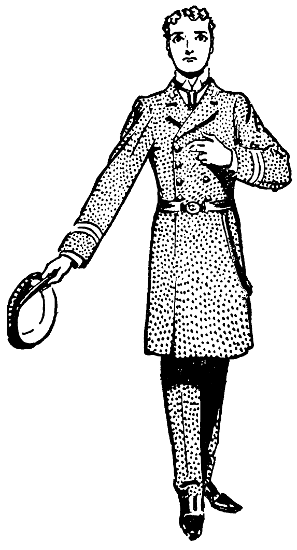
The Hero.

The Martyr.
[69]
The first class is most difficult of successful achievement. In it, the whole gamut of emotions common to mankind may be symbolized, and in these attitude and gesture are governed by the mind, which should be revealed in every muscle, curve, and limb of the human frame.

The Ascetic.
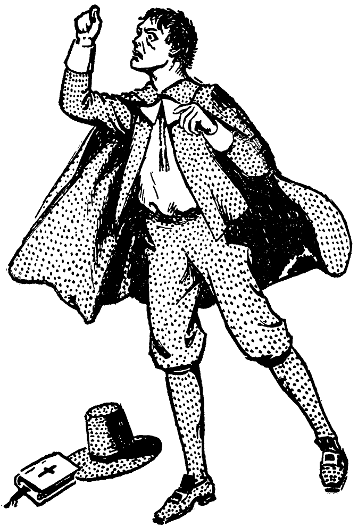
The Fanatic.
Strength, courage, fidelity, chivalry, purity, and honesty should be posed in such a manner that the simple grandeur and dignity of these attributes cannot be mistaken. The hero, the martyr, the ascetic, the fanatic have each a commonly recognized type and pose.
The shrinking form of the coward—he who fears all things greater than himself—must bear the stamp of the puny soul unveiled. The eye of the hypocrite, the cunning, the evil and degraded, is as different from the gaze of the pure of heart as the muddy, stagnant pool is different from the wide, blue expanse of salt sea—the air of a foul room from the breath inhaled beneath the open sky.
[70]
And in the same way that grand music is expressive of all human emotions, and as welcome to the ear as the song of birds, so form and color, attitude and character, in living pictures are potent emblems of the strength and weakness of complex humanity.
The figure that is to symbolize Hope must possess that wondrous attribute in herself, otherwise no trickery of dress or limelight can make her anything but a caricature of the spirit of optimism.
So that, in order to portray virtues and vices as they are, the stage manager’s craft reaches beyond superficial knowledge. Psychology and intuition are even more important to him than experience regarding blending of colors, arrangement of lights and grouping of forms, for the human mind is the keynote in which his music is revealed, the touchstone of his secret, the mystic spirit dominating the symmetry of gesture.
In the choice of individuals, personal character is weighty—pink and white flesh tints, however perfectly blended in a face, do not stand for Patience, Charity, or Sympathy unless the heart behind is pulsed on the pivot-springs of these virtues, for the experienced eye of the spectator probes beyond paint and attitude, and knows perfectly well whether these virtues are rightly embodied or merely distorted mimicry.
Therefore the stage manager of tableaux vivants, before all else, needs penetration in recognizing and choosing exponents suitable to interpret the abstract conditions he is anxious to depict, and it is only when his choice is made that the training, grouping, and scenic effects need be considered.
Tableaux vivants are in character not unlike a symphony. The theme in both is important. In the latter, the interweaving of other parts enhances the beauty of the dominating strain, as in the former, where harmonizing colors and stage effects, important as they are, remain ever subordinate to the principal conception aspired.
Of course, in the training of subjects, it is very necessary that one attitude should be maintained by each figure and remain unbroken from the lift to the fall of the curtain, and this without rigidity of body, unless the characteristic is typified in rigid lines; but even more important is the necessity that the mind should not waver nor the features change to an expression not in harmony with the attribute typified.
Hope does not frown or smile, and all nervous twitching is absent from the tranquil face and figure of Serenity. Courage shows a lofty brow and steady eye—the shoulders are squared resolutely, but not aggressively.
Mercy, Pity, Love, Gentleness, Sweetness, and Charity are most[71] perfectly imaged by women, who naturally possess these virtues; Dignity, Determination, Steadfastness, and Chivalry by men. But the stage manager need not limit himself by any conventions in this particular, for it sometimes happens that a woman’s face and form breathe characteristics usually found in certain types of manhood, while a man’s countenance may be eloquent of the gentle virtues typical of womanhood.
The thoughts of each character must be concentrated on the part undertaken, and the onlookers absolutely forgotten. As far as possible the actors should forget that there is a certain amount of strain in the immovable pose, otherwise limbs will twitch and the balance and pose be in peril. With sufficient practice it will not be difficult to remain in the attitude fixed upon for the few minutes after the curtain is lifted. It is only at first that the limbs, either through inexperience or nervousness, prove rebellious. The impersonators should not be afraid to breathe regularly, for this prevents artificial rigidity.
Figures should not be crowded together. A small stage, such as would be used in a drawing-room, requires a picture in proportion. The dresses and lights should blend harmoniously with the background and frame.
Fig. 1 depicts the lighting arrangement at back of frame. The guard-wires, running from side to side, are to prevent the possibility of dresses catching fire. The footlights usually consist of ordinary night-lights with illumination glass covers. Behind these are tin shades for reflectors. Electric light, if available, can be substituted for oil lamps as shown. In the same sketch a curtain-raising apparatus also appears. Two persons should be chosen for its manipulation, and be always stationed in such a position that they can draw and divide the curtain at the given signal.
Every separate production is timed by the stage manager or some other reliable person, and the duration of each should be exact. Three, or at the most four, minutes are ample time for the audience to take in the details of the picture, and the instant the curtain is drawn another group is arranged, the actors being perfectly familiar with the position and pose they are to take, going to their places without confusion or disorder.
In a succession of group-pictures different groups of actors are necessary, for it is impossible for the same persons to change their costumes in the minute or so that intervenes before the succeeding spectacle.
[72]
Where the number of players amounts to fifteen, twenty, or twenty-five, the number of tableaux arranged upon can be divided between them, and the productions, consisting of from two to five figures, arranged in such a way that during group A’s tableaux group B is ready in the wings and takes the stage the instant group A disappears through a different exit to the dressing-room. Next, group C takes group B’s place in the wings, and so on with all the groups. In this way each has a few minutes in which to change.

Fig. 1.—Lighting arrangement for back of frame.
Confusion and fussing will be prevented by each group knowing exactly their manner and mode of entrance. Some plan, which renders it impossible for group A leaving the stage to collide with group B in the wings, must be fixed upon. Because the tableaux take[73] place in a strange drawing-room, where there is not much accommodation possible behind the platform, and few entrances and exits, is no adequate excuse for any bungling or confusion.
However limited the space, the stage manager and his company should hit upon some plan that makes for order and precision. To do this, the performers should come early to rehearse entrances and exits, and then memorize them, for any mistake behind the scene, even if of so slight a character that it does not retard the productions, is apt to disturb the nerves of the players, and rob them of their necessary calm.
There should be no laughing or talking, for sounds easily penetrate through a drawing-room, and not only disturb the audience, but draw from their task the attention of the group occupying the stage.
The stage manager, who feels unable to represent abstract qualities perfectly, would do well to avoid them altogether.
It may happen that his actors include a few who are absolutely raw material where tableaux are concerned, and upon such occasions he should always have a few studies in his repertoire in which motionless poses are not necessary.
For example, a pretty novice, sitting at a spinning-wheel, weaving imaginary threads from a spindle of flax, will do very well as Penelope, spinning her endless garment during the absence of Ulysses. In a simple white or colored gown, with her hair falling over her shoulders, and her head bent slightly over the wheel, she makes a pleasing picture.
Cinderella, seated on the floor, gazing into the cinders, with her hands clasped round her knees, is another quite easily adopted attitude.
Another pretty scene, acted over the spinning-wheel, is the Lady of Shalott, weaving “a magic web with colors gay,” and peering from time to time at the mirror above her, which reflects “the highway near, winding down to Camelot.”
In this tableau the facial expression is wholly different from that which dominates Penelope’s features. Penelope’s labor is inspired by stratagem, to keep her unwelcome suitors at bay. Her soul is steeped in a patience so melancholy that it verges on despair, whereas the Lady of Shalott “weaves by night and day,” because she believes she is chained to her task by an awful power. If she pauses a moment, a curse will fall upon her. Her eyes, therefore, are wild with fear, her face contorted, her fingers pluck the threads feverishly, and there is none of Penelope’s listlessness in her wild agonized concentration.
[74]
History and fiction teem with incidents that can be easily translated into groups, wherein an absolutely motionless attitude is not required.
The three witches in “Macbeth,” in their cone-shaped hats, tattered rags, and disheveled hair, their wild, evil prophecy, seared in the deep lines of their withered faces, haunched on the ground conspiring together.
Guinevere, prone on the convent floor of “the holy house at Almesbury”; King Arthur, fully armed, and stained with battle, bending over her in agonized tenderness, pity, and shame; and many other examples, which will easily be found by the stage manager, ambitious to exhibit pictures more unique than those usually adopted.
The materials used for characters need not be expensive or difficult to procure. Cheap sateens, muslins, velveteens, gold paper pasted over cardboard and large buttons, glass diamonds and emeralds, tinsel and silver braid, bright-colored ribbons from the remnant basket, discarded shoes and stockings, transformed by cheap dyes, vari-colored beads, imitation ermines, tin swords and armor—all these are useful and effective beneath the lime-light.
Backgrounds may be arranged by means of curtains draped over the walls in colors that blend or contrast harmoniously as desired with the tableau produced. Properties, such as old wine flagons, lamps, &c., may be fashioned by means of cardboard, cut in the necessary shape, gummed together, and covered with gold or silver paper.
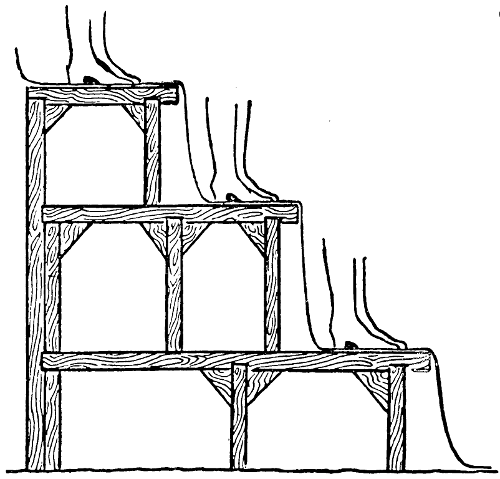
Fig. 2.—Tiers for back-stage grouping.
Fancy dress magazines and illustrated histories will reveal many secrets to the stage manager. Better still, a visit to a museum, when he is in doubt about the shape and period of some article he requires, and observation of the properties utilized in historic or Shakespearean[75] plays will well repay time and trouble spent. Duplicates in lead, wood, or tin of almost any old article can be fashioned well enough to answer his purpose.
When a large group of figures is to be arranged, light wooden ladders, placed in a semicircle, and covered with some appropriate color, make easy and adaptable tiers, on each step of which a figure is posed, or an arrangement of tiers for back-stage grouping can be made as shown in Fig. 2.
The most expensive aids in the stage manager’s paraphernalia—and these, alas, there is no overcoming—are the supply of the lime-light and the loan of the wigs. But in this direction he should not be too ambitious, contenting himself at the start with a moderate outfit in accordance with his means and inexperience.
[76]
One of the most popular indoor entertainments for winter evenings, or indoor parties, both with children and “grown-ups,” is charades. Not only do they afford amusement to the audience, but the players themselves obtain a good deal of fun from their efforts to baffle those who are listening to them.
Suppose, for instance, that a “party” is composed of some twenty people. About five or six of them are selected to go outside, choose a word, which can easily be split into syllables, each making a word in itself.
The players must not waste too much time in planning how best to act the words, or the audience will show signs of impatience. This can also be averted by the hostess arranging for a musical, or other little “stop-gap” to fill up the time which must necessarily elapse between the moment when the players retire and their subsequent appearance.
Having thought of a little sketch which will take in all the several parts of the word chosen, the players arrange impromptu scenery and start the first act, taking care to bring in the first syllable, and yet not giving it undue prominence. This care must be observed all the way through the charade, as the fun is much greater when the listeners cannot guess the word too easily.
If the word chosen is “Indignation,” it is split into three syllables—In, dig, nation.
These words having been acted, in the last scene the complete word is brought in, and as it is through this act the audience will listen most carefully for a clew, the players, if they wish to baffle them, should do their best to bring in a variety of words in order to mislead the listeners.
In many cases a little scenery adds considerably to the successful presentation of charades. A “window” frequently proves of service. But it may happen that the end of the room where the actual window is situated does not lend itself conveniently to the performance of the[77] charade, and in this circumstance the best plan is to improvise an “artificial window,” which, being portable, can be used in any required position.
A start can be made in construction by procuring a sheet of strong white paper of the requisite size. With India ink or chalk the thick black lines, as shown in Fig. 1, are painted in. The dotted lines represent the sheet of paper, the four holes the positions at which the nails fasten it to the wall, and the finished effect of an interior window is obtained by the draping of art muslin or curtains, as suggested by the diagram.
Oftentimes a little exterior scene is wanted. A simple way of improvising a cottage is that of using two screens placed as shown (A, A, Fig. 2). A plank or the shelf of a cupboard is placed across the top (D, Fig. 2), and kept in position either by nails or gimlets screwed into the top of the screens.
A tablecloth of any bright color, preferably red, is stretched from points (B, B, Fig. 3), slanting downwards and slightly over the edge of the screens.

Fig. 1.—Interior artificial window for charades.
Two “artificial windows” (C, C, Fig. 3) should be then pinned to[78] the screens, and the exterior of cottage is complete, an additional artistic effect being produced by fixing flower-stands with ferns in positions as shown (E, E, Fig. 2).
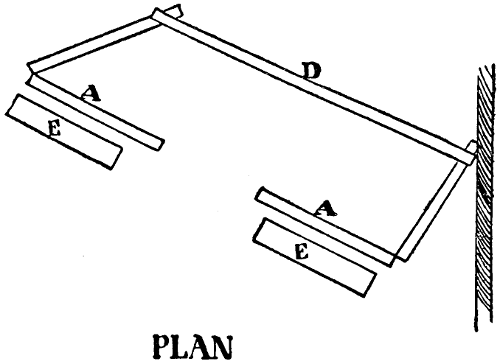
Fig. 2.—Plan for improvised cottage.

Fig. 3.—Exterior view of improvised cottage.
At first sight it might seem out of the question to produce a really passable scene representing “the rolling deep.” This may be easily carried out, however, by a careful study of Fig. 4, and the requisitioning of such commonplace articles as a large white sheet, which is stretched and nailed to the wall, a few rolls of stout white-backed wall-paper, hassocks, boxes, and old brown or gray cloths.
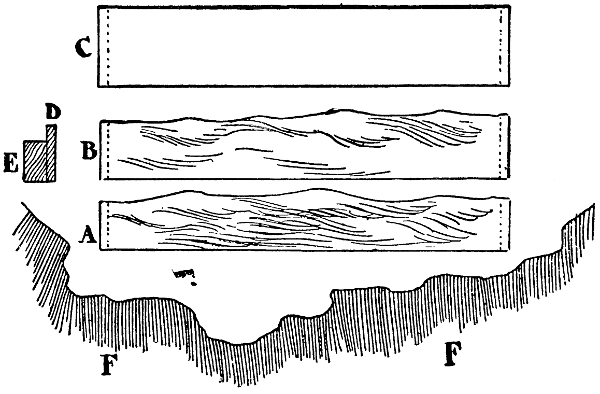
Fig. 4.—A sea scene.
The wall-paper is cut into three lengths corresponding with the width of the sheet, one about 18 inches in depth (A, Fig. 4), the next 28 inches (B, Fig. 4), and the third 34 inches (C, Fig. 4).
[79]
At each end a piece of wood is fastened (D, Fig. 4), behind which is glued a block of wood or small weighted box (E, Fig. 4).
The lengths of paper, marked A and B, are cut in zig-zag fashion at the top in order to produce the appearance of waves, the effect being enhanced by an application of blue paint used as shown in the diagram. The strip of paper marked C forms the horizon, therefore the top of this should be left straight and painted blue to a depth of about 10 inches.
To complete the effect, boxes, hassocks, and stools of different heights are grouped round and covered with the gray cloths to represent rocks (F, F, Fig. 4).
An empty barrel and a few coils of rope flung carelessly about help to make a more realistic scene, and well guarded lamps placed between the slips representing waves throw them up into necessary prominence.
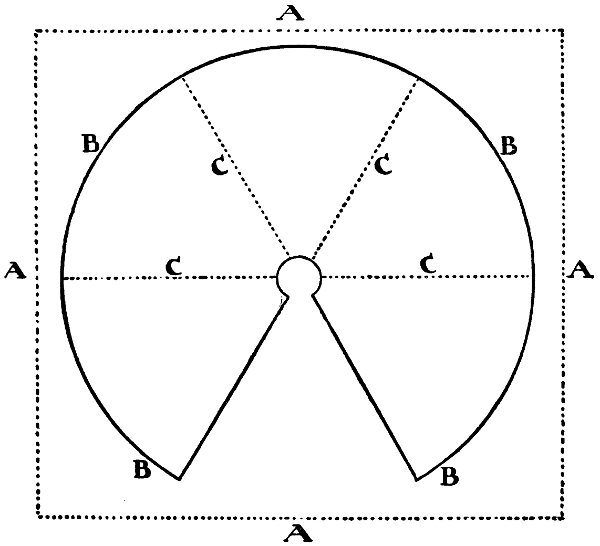
Fig. 5.—A portable tent.
A portable tent is made from a few sheets of brown paper glued together to form a huge square (A, A, A, A, Fig. 5), the paper cut out[80] to the shape described (B, B, B, B, Fig. 5), and folded at the dotted lines, C, C, C, C.
The whole is then arranged over three poles, crossed and tied together at the top, an opening or entrance being formed by the segment cut away.
A highwayman’s mask will prove easy of construction, and a thing of delight to the average boy. Moreover, it will often find a place in charades.
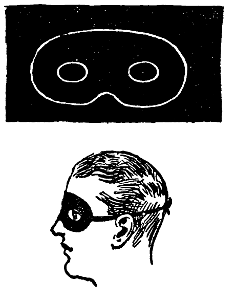
Fig. 6.—A highwayman’s mask.
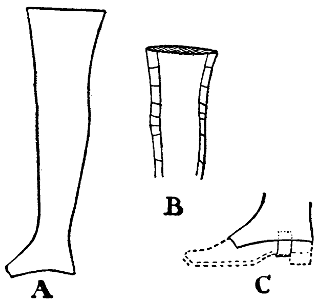
Fig. 7.—Highwayman’s leggings.
On a width of black sateen or any other suitable material a design is drawn as shown in Fig. 6, marked with chalk and cut away to fit the face. A piece of thin black tape is fixed to either side, so that the mask may be tied round the head just above the ears.
Amongst the highwayman’s outfit there must certainly be a pair of high boots, but as these are not found in every household, it may be as well to give a few simple directions for the making of them.
From several sheets of stout brown paper four pieces of the shape indicated at (A, Fig. 7), are cut. So that the tops of the boot shall not crack when the leg is bent, small pieces of paper are gummed at either side, as shown (B, Fig. 7).
Only the fixing of a piece of tape, or double fold of the paper for the instep, remains to be done (C, Fig. 7), and an excellent pair of highwayman’s boots is to hand.

Fig. 8.—Highwayman’s hat.
[81]
An ordinary pliable felt or straw hat can be easily and quickly transformed into a three-cornered highwayman’s hat. A study of Fig. 8 will explain where the stitches are to be taken from the brim to the crown.
Two hard felt derby hats properly treated make an excellent representation of a policeman’s helmet, which will very often be found useful for charade acting.
It is first of all necessary to cut off the brim of one of the hats at the point where the band comes. The crown of the second one is also cut off, but some three inches above the band.
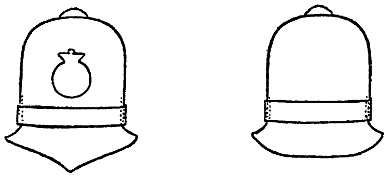
Fig. 9.—Front and back view of a policeman’s helmet.
The first crown is next carefully fitted over the brim portion of the other one, and tacked round firmly so that the two pieces do not slip.
The headgear now presents the appearance of an abnormally high derby hat.
The curved part of the brim is cut away, and the front shaped to a point, as shown in Fig. 9, and the brim at the back is nicely rounded.
The usual ornamentation may be suggested by the application of chalk, the addition of a large-sized wooden button mold glued to the top of the crown, a chin-strap of shiny black leather completing the article.
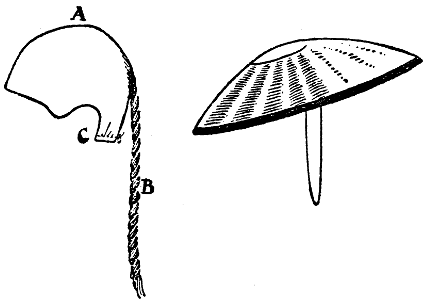
Fig. 10.—Skull cap, pigtail, and hat for Chinaman.
A Chinaman is a character quite easily portrayed, and one which can be simply represented by pressing into service articles of everyday use.
[82]
From a piece of pale pink sateen the head covering (A, Fig. 10) is fashioned, a string run through at C to be drawn out or in at will; and a piece of rope or twist of darning cotton, B, sewn on at the back for a pigtail.
Then if the would-be Chinaman wishes to cover his head still further, the lid of the linen basket provides him with a hat, when a piece of braid or black paper has been fixed to the rim, and a string sewn on for the chin-strap.
A highly-colored dressing jacket and a pair of rather loose white trousers complete the Chinaman’s outfit.
Whilst some people consider the ordinary charades the best fun, there are others equally ready to admit that they prefer the “dumb” representation of words chosen, one of the most popular of these being the “advertisement” charade, wherein some well-known poster is chosen and acted in silence.
A well-known soap advertisement which has been so popular for years serves as an excellent illustration. There are few, if any, who could not recall the picture.
A man, dirty of face and hands, with torn clothing, sits at a table writing a letter.
A faithful representation of this can be easily produced by the aid of soot smeared carefully over the face and hands, and a wig of tousled hair.
Perhaps a dozen advertisements can be “played,” a few moments elapsing between each for the audience to write down their “guesses” on slips of paper, which are afterwards collected, and a prize awarded to the competitor who has the largest number of answers correct.
The two following examples of charades are given so that the players may fit in their own words. If the charades need to be written in dialogue form and committed to memory days before they are played, much more trouble is given, and the game becomes a somewhat irksome one.
Enter two boys dressed as highwaymen. For this purpose art muslin scarves tied round the waist, hats and masks as already[83] described, and toy pistols are enough, with a scenery of trees painted on some stout paper.
First boy addresses his comrade in tones of mystery, glancing to right and left as though he is expecting somebody. At length he holds up a warning finger: “Hist! The Baron comes this way!”
They secrete themselves and wait until the Baron approaches. He looks round, whereupon the two highwaymen jump out, secure him, and make off.
The Baron’s servants arrive on the scene too late, but vow they will track the robbers, and start off in hot pursuit.
End of First Act.
Baron asleep in one corner of a tent (made as previously described).
The robbers are eating their dinner, and talking in low tones of the ransom they expect to get for their prisoner. Whilst they are talking the Baron awakes. They are so intent upon their conversation that they do not observe him arise, creep up, and steal their food. He eats it, and returns to his corner again.
The ruffians discover their food is gone and are furious, but do not suspect their prisoner, who they suppose is still slumbering.
The Baron is so amused at their efforts to find the thief that he begins to laugh, rocking himself to and fro, and at last shouts, “I ate it, I ate it.”
Just as they are about to flog him a noise of tramping feet is heard, and they hasten to see who is coming.
End of Second Act.
Baron and his faithful retainers are sitting by the seashore, and he is telling them how he made his escape from the robbers.
As they are talking an old beggar comes along. The Baron at once recognizes him as one of the robbers, and gives orders that he is to be seized and bound. Presently the other one arrives, and he is treated in the same way.
[84]
Finally the Baron promises to forgive them if they will give up highway robbery and go to sea.
End of Third Act.
Enter several boys in ragged clothes as newsboys. They are shouting papers for sale, and the chief thing that can be heard is “Extry—Capture of a Baron at Sea.”
The boys discuss the news, and at last one of them bursts into a fit of laughter after having opened the paper. The others crowd round to see what is causing the merriment.
Laughingly he explains that it is not an account of an exciting piratical affair, but merely the report of the capture of a Baronetcy in England by a fair cousin from the United States.
Scene.—Widow Frankey’s kitchen. Representation of this made by use of window described above, kitchen table and chairs, plates, pastry board, &c.
Widow Frankey, in apron and cap, is busy making pastry, and talking to herself about her son Jack, and wondering when he will return from the errand on which she has sent him.
Jack appears. Tells his mother where he has been, and she scolds him for being so slow.
He goes out in a temper, and Widow Frankey leaves her work, sits down and cries, finally falling asleep.
Jack returns, finds his mother asleep, and determines to make up for his ill-temper by finishing the pudding she has already begun.
(An amusing scene can be shown here by the funny mistakes he makes, putting into the pudding all kinds of odd ingredients, amongst them a bean.)
His mother awakes, to find dinner set, and ready.
There is great fun over the pudding when the widow finds the bean.
End of First Act.
[85]
Scene.—Corner of market-place, where a flower-seller has her stall. For this purpose a table, draped with art muslin, with a few pots of ferns on it, and some flowers made from tissue paper, will be all that is required.
Girl sits on a stool doing up bunches of flowers.
Jack comes along running, and in his hurry knocks the table over.
Flower-seller pretends to be very angry, and insists upon Jack’s paying for the damage.
He does so, and the girl laughingly gives him the stalk of a flower for fun. He puts it in his button-hole and walks off, leaving the girl laughing.
End of Second Act.
Scene.—Widow Frankey’s kitchen.
Jack returns to his home, and tells his mother of his escapade, showing her the stalk which the flower-girl had given him.
Just then the door opens, and the flower-girl enters, throws Jack’s money on the table, telling him she took it only for a joke. He returns the stalk to the girl, who laughingly tells him that it is a beanstalk.
Widow Frankey retires, and Jack tells the pretty flower-girl that he loves her.
End of Last Act.
[86]
The musical sketch occupies a high and prominent position in the scale of entertainments given by the individual. With many it is more popular than ventriloquism, impersonations, reciting, or conjuring, and needs as much skill and study as any of these other accomplishments. For its successful rendition the artist must be equipped with
1. Subtle humor and pathos.
2. Impromptu patter.
3. A good memory.
4. A clear pronunciation.
5. Mimicry.
6. Self-accompaniment from memory.
7. Individuality and mastery of the audience.
He must also be well versed in the popular topics of the day, and be able to dish them up in an attractive manner to suit the humor of his various hearers; and, of course, a certain amount of natural talent is indispensable.
In this mode of entertainment there should be no pause. The whole time the artist should either be engaged in patter or playing, and he must go from anecdote to anecdote smoothly and without jerkiness, always relating his stories as if they were his own experiences.
He should begin an after-dinner story in some such way as—
“The other night, when dining with my friend, Mr. A., I had the misfortune to be stuck down beside his elderly maiden aunt, Miss Dimbledock, who my host had previously informed me was a stanch adherent to the Blue Ribbon Army. Now, as Mr. A. is her only living relative, he naturally expected to inherit her wealth, and consequently had given instructions to Coggledab, the butler (who on ordinary occasions served as coachman), that especial attention and care were to be lavished upon her severe and abstemious person; but, alas, he had forgotten to instill him with her principles, and the result was that the poor old lady was mortally offended, for, ere[87] we had reached the second course, Coggledab leaned over her chair in a fatherly and solicitous manner that well became his white hairs and portly person, and whispered in a voice that penetrated every corner of the room:
“‘Gin, whisky, or brandy, Mum? You can’t be enjyin’ of yourself! You’re not drinkin’!’
“And it is to this apparently trivial incident that a year ago a flourishing dogs’ home was opened in New York, and that my poor friend Mr. A. can be seen any day selling matches at his post in Times Square! And talking of the importance of trivialities, reminds me of an adventure that befell me the other day. I had hired a taxi-cab, and was just stepping into it——,” &c., &c., thus introducing quite a different anecdote.
Now, the outlines of the incident of Mr. A.’s dinner-party are taken from a comic paper, but twisted and colored to suit the requirements of the artist; and there are many stories that may be dished up in similar manner, while frequently personal experiences are extremely humorous when rightly treated.
The artist should study and cultivate the correct and various methods of telling a story, remembering Pope’s adage—
If the style of writing is important, how much more is the manner of verbal narration. The wittiest story may fall to pieces in the hand of the inartistic, while the most trivial incident humorously handled may be greeted with shrieks of merriment.
The raconteur must give his audience the impression of frank geniality and friendliness without familiarity, his attitude cunningly eloquent of the man who is about to open his heart to a confidante.
Orchestra chairs and gallery are his bosom friends. He twinkles and patters at them right merrily. If he paints their peculiarities or laughs at their social ways he must flavor his babbling with the tender fun of that greatest of humorists, Charles Lamb, who never aped or scoffed at physical deformity, and was never cynical at another’s expense.
The caricatures depicted by mimicry must be cleansed of that sour Voltaire bitterness and cruelty, the artist always remembering[88] that he is performing in order to beguile, and he must cultivate that delicate tact which prevents him from imitating the withered idiosyncrasies supposed to be typical of the old maid in the drawing-room, when he knows that some spinster relative or friend is present.
The public possesses a vast fund of humor, and there is nothing it loves so much as a hearty laugh, but its risibilities should be handled as delicately as a trout is tickled, and if they are only provoked at the dear expense of some unfortunate individual, they are coarse and vulgar, and the artist himself is culpable. The broad double meanings of apparently innocent witticisms one might have heard at some vaudeville halls should be rigorously avoided. There are gentlemen, fine-souled and clean of mind, in your gallery as in your orchestra chairs. Treat them as such. Appeal to the best, to the refined sense of the ludicrous that lurks in every mind, and you will be as welcome in the most select drawing-room as in the theater.
Humor and fun are as bracing and purifying a tonic as a breath of sea air. They should be steeped in the salt ozone of wit, but never in the withering blight of vulgarity.
The artist should be large-souled and natural in attitude and gesture—a gentleman from head to heel in the best sense of the word—and the result will brace up and encourage him, for he will observe the faded city merchant laughing with the heart-whole abandon of the child.
It is not necessary, and it may become even monotonous, to pose forever as the comedian who sees fun in every incident around him. A great and versatile artist, now deceased, in the middle of his recital would sit down at the zither when the room was still ringing with laughter, provoked by his keen shafts of humor, and win tears by the exquisite pathos of the refrain: “The mill will never grind with the water that is past.”
Maudlin melodrama is not pathos any more than vulgar mockery is humor. A thin veil lies between tears and laughter, and both are nearer the surface than some artists realize. Both are noble and wholesome, and so should never be made puny by too little giving or rendered grotesque by too much.
A most effective means of self-accompaniment is the harp, and one moreover which adapts itself exquisitely to the subtle charm and changing qualities of the human voice, but only in the performer’s more serious moments. To twang at this instrument and pose above[89] it in the attitude of the comedian, to pluck it banjo fashion, is to displease and jar the sensibilities of the most uninitiated of the audience.
The dual art is a stumbling-block to many a versatile artist, and its perfection needs a tremendous amount of persevering and diligent practice. There are some gifted performers to whom the art of pattering or reciting to music is inborn, and so extremely facile, but to the less fortunate it presents discouraging obstacles, and the power of improvising an accompaniment suitable to the anecdote or poem related is not given to the majority.
However, the student should remember and be encouraged by the fact that “steady effort attracts unknown powers to our aid,” and work on determinedly until the difficulty is mastered.
In studying the dual art, the beginner is apt to hammer the words to the accompaniment, or the accompaniment to the words, and it seems at first impossible to arrive at that perfect blending of voice and music which is essential to this kind of performance. Another extremely common fault is to emphasize the wrong word or the wrong note, with the result that the achievement becomes meaningless.
The ear should be trained to the rôle of an exacting critic, and when this power is developed it will demonstrate faithfully wherein the failure of co-operation lies.
Music should never be suffered to overburden the words of the poem or anecdote related. It is usually but a ground-work upon which the artist builds, “at most, an undercurrent of answering emotion.” The instant it flows through the floodgates of restraint it obliterates the meaning and the sense of the words as the waters of a burst dam obliterate the natural features of dry land.
Another serious fault to be found in the rendition of the inexperienced student is permitting the time of his accompaniment to swing into his voice. Against this he must be severely on his guard, or he will develop a wearisome habit of chanting in monotone.
While taking pains to blend his voice with his accompaniment, he must take equal care to keep both distinct and apart. This sounds paradoxical, but practice and self-criticism will prove that both are true and possible.
The speaker should learn to harmonize his music so exquisitely with his words that to the uninitiated the accompaniment seems rather extempore improvising than the result of toil and diligence. As a matter of fact, it is extremely rare that even the greatest artists dare[90] trust to the inspiration of the moment to provide them with adequate accompaniment.
An artist may have a theme or motif borrowed from some composer, and he may be sufficiently gifted to plan it out and develop it for himself, but always with careful thought and deliberation before he gives it public expression.
The dual art is as full of vagaries and traps as the French language, and at first the student who finds himself handicapped by inability to conquer it, cannot do better than study some poems written to music, and at these he must work steadily before he attempts to patter to accompaniment.
A few musical poems mastered will go far to secure him an air of ease and self-possession.
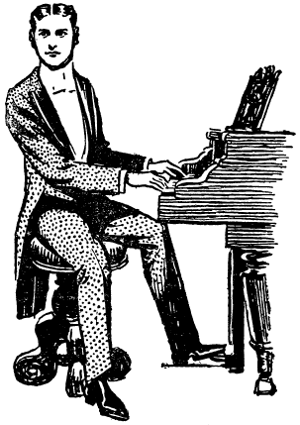
Correct attitude at piano.
For instance, undertake some such study as Racine’s tragedy of “Athalie,” which has been so exquisitely set to music by Mendelssohn. In the opening bar of “Allegro Moderato,” a few notes are played to introduce the passage, “Where do those women and their children go?” Then there are a few more notes, followed by the words, “The Lord hath laid the queen of cities low.”
The four succeeding bars are treated in the same way. The music ceases while “Her priests are captives” is recited. Then a chord is struck, and the voice goes on unaccompanied, “Her monarchs are rejected.” Another chord, “Her godly rites forsaken, unprotected.” The sixth bar opens with a chord, and is followed by the words, “Down, temple! Cedars, down!” and terminates with four semi-quavers.
This is an intensely dramatic poem, written in rhymed Alexandrines, and the student must take great care not to rend the words from the accompaniment, or the accompaniment from the words. The short phrases and detached chords must punctuate and emphasize the sentences, and lend weight and finish to the whole. This is not a difficult task when compared with such a study as “The Dream of Jubal,” in which the music accompanies the words in strict time, the combination of voice and pianoforte flowing smoothly, the components dependent and yet never waiting for each other.
The only way to reach perfection is to study the poem and music separately at first, until the student is fairly familiar with both. Then continue them with the aid of a metronome until the technicalities of the mechanism, which include correct emphasis, pauses, and rhythm, and the proper flow of the phrases, are mastered.
When this has been frequently rehearsed, the student may try his powers without the metronome, and gradually, but surely, he will master the antagonistic forces arrayed against him.
[91]
The artist who possesses a natural gift of composition will find it extremely useful, for there are many exquisite poems which, although seeming to clamor for a musical accompaniment, have not yet been touched; but this combination is fraught with perils, and those who approach it must be for ever wary of the grotesque and unfit.
In burlesque, of course, the artist has great license in the matter of accompaniment. He may exaggerate and slash his pianoforte (taking care never to drown his voice), and achieve the absolutely absurd and ludicrous, but, in the poems or patter that need delicacy, lightness of touch, melancholy cadences or bubbling, merry notes, he cannot be too careful in the theme he chooses to aid and color his portrayal. In such pieces, the right attitude, the right gesture, the right expression must be studied and gripped, so as to add their subtle beauty to the whole. The accompanying sketch shows the correct attitude at the piano, or rather, the attitude generally adopted by the professional musical-sketch artist. The body is turned “three-quarters” to the audience, the head full-faced, the left foot working the pedals, while the right usually follows the direction in which the performer is looking.
[92]
Whilst “vamping,” or the improvising of a musical accompaniment, is considered by many anything but a classical accomplishment, yet those who can accompany in this way are a decided help to a general or children’s party.
In either case among the guests will be found some who possess the gift of song, either comic or sentimental, but who lack the power or the ability to play their own accompaniments.
Moreover, it may happen that the services of a skilled pianist are not available, and in these circumstances any one who can vamp will be deemed a useful acquisition.
The object of this chapter is not to give either intricate or comprehensive instruction, but rather to suggest, even to those who have had no musical training, a few rules whereby they will be enabled to step into the breach occasioned by the absence of an accomplished player.
An ordinary piano has fifty notes, comprising A, B, C, D, E, F, G, in succeeding order.
The whole keyboard is divided into two portions—treble and bass, the former starting from the fourth C up from the left; the notes below the fourth or middle C comprise the bass. (See Fig. 1. Arrow denotes middle C.)
Each black note above a white is its sharp, and each below its flat. For example, taking the treble note G, the black note above it is G sharp, the one below it G flat.
[93]
Before starting to vamp to a song, the singer must hum over a line or so of the song in order that the “vampist” may keep both the time and tone in his mind for transference to the piano.
His ear will tell him when he has struck a few chords whether they are in the key in which the song is written. If he finds that when a few bars of the song completing a distinct or rhythmical period have been hummed the note finished on is C, then he will know that the key is C, and find his chords as suggested by the diagrams given.
There are three principal chords in a key which are sufficient to cover the range of melody. Starting in C, the first chord for the right hand from the little finger to the thumb is made up of the notes middle C, bass G, and bass E. The left hand strikes the octave C immediately below the right hand thumb on E. (Fig. 1.)
The second chord starts from little finger of right hand on F, first finger on C, and thumb on A in bass, the octave F, below the right hand A, being struck in the bass. (Fig. 2.)
The third chord starts with little finger of right hand on G, third finger on F, and thumb on B in bass, the left hand striking the octave G below the B on which thumb of right hand is placed. (Fig. 3.)
[94]
To complete the melody it is necessary to go back to the chord started with, taking it up an octave or eight notes higher in both hands.
The relative changes are brought about by the use of the following chords. Striking the F sharp with the little finger of right hand, the first finger is placed on the D, and the thumb upon middle C, the left hand taking the octave F sharp immediately below middle C. (Fig. 4.)
The second change starts with little finger of right hand on G, first finger on D, and thumb on B below middle C, the octave G in left hand completing the chord. (Fig. 5.)
Another change is produced by the use of the next two chords.
[95]
Striking G sharp with the little finger of the right hand, the first finger strikes E, and the thumb D; the octave G sharp being struck in the bass by the left hand. (Fig. 6.)
The twin chord to the one just described is made by placing the right hand little finger on A, the first finger on E, and the thumb on middle C; the octave A, immediately below middle C, being struck by the left hand. (Fig. 7.)
The final change necessary is produced by the two following chords.
The little finger of the right hand is placed on C sharp, first finger on A, and the thumb on G, both the latter notes being bass—that is, below middle C. The left hand strikes the octave C sharp in the bass. (Fig. 8.)
The last chord is made by striking D above middle C with the little[96] finger of the right hand, A below middle C with the first finger, and F also below middle C with the right hand thumb; the left hand takes the octave D in the bass. (Fig. 9.)
By a study of the chords set forth above it is seen that the octave struck by the left hand in every case is a lower tone of the note played by the little finger of the right hand—viz., if the little finger of the right hand strikes G in the treble, the octave G is played by the left hand in the bass.
An effective ending to a vamping accompaniment is brought about by the use of a “run.” Starting from the C in the bass below the middle C (indicated by arrow on diagram), and playing the E and G with first and second fingers, the thumb is taken under, on to the middle C and the action repeated twice, the run finishing on the fourth C in the treble. (Fig. 10.)
It is useful and interesting to bear in mind that any chord can be made by placing the little finger on a note desired, missing the next two covered by the second and third fingers, striking the note covered by first finger, missing the next, and striking the one covered by the thumb.
Having committed the above chords and “run” to memory, the performer can play them to suit the time in which the accompanied song is written.
[97]
To possess a gramophone or phonograph is to be already furnished with the means of giving a very successful and pleasurable entertainment. There are so many “entertainments” that do not entertain, and so many “amusements” that do not amuse, that it is a distinct relief to know where to turn when a mixed party of guests have honored you with their presence.
With the number of gramophones, phonographs, talking-machines and zonophones now on the market, it is not the object of this chapter to specialize any particular make or type of article. As in most things, quality means expense, and there is little use in hoping for fine results from a cheap machine. Any respectable dealer will give useful advice as to the type of gramophone worth buying, and it must be left with you to make your own choice.
Presuming you have obtained your machine and accustomed yourself to the manipulation of its various parts, the next point to be considered is how a successful programme may be carried out for an entertainment.
In nothing, perhaps, is that old adage that “tastes differ” so true as in music. One person may shiver with disgust at everything but Bach, whilst her neighbor probably can appreciate nothing but old ballads; or whereas paterfamilias beats time ecstatically to the familiar old pieces of Verdi and Rossini which he remembers from his boyhood, his cultivated son is impatient for something out of “Elektra.”
Now it is the business of the entertainer to satisfy and please all these people—to send none away empty, but to make each person feel what a pleasant evening he or she has had. Whilst fully recognizing the difficulty of producing this result, it is hoped that the following hints may serve to render the construction of a catholic programme a little easier than would at first appear.
Records are of two kinds—instrumental and vocal. By blending these successfully a very charming variety can be obtained which will materially assist in keeping the programme from lapsing into sameness.
[98]
Commence with a stirring overture or a rousing march that will set the feet of your audience itching to mark time. Avoid anything dreamy or languorous; let their attention be attracted by a bold stroke, by the rattle of drums and the blaring of cornets and trombones. Sousa’s marches, the “Stars and Stripes” for instance, are admirable pieces to start the evening with, arousing the attention and stirring the blood of every healthy person in the room.
Having now excited the interest of your audience, give them some vocal music. Choose a good quartette of well-known singers in a selection or song from some up-to-date opera, or even from one of the old Italian favorites. “The Barber of Seville,” “La Bohême,” or “La Tosca,” all provide very fine quartettes.
The next piece might be a good instrumental solo, on violin, ’cello, piccolo or clarionet. Let it be short and characteristic; preferably a piece fairly well known to the majority of your audience.
At this point it may be remarked that people invariably like hearing what they already know. The gramophone is more generally appreciated when it reproduces a song or piece of music that the audience has heard before; whilst the machine is scarcely suitable for the introduction of wholly new music. Of course it is impossible to form an entire programme on these lines, but when making the selection of records, if you bear this fact in mind it will save you from obtaining a number of outlandish pieces, if one may so style them, which the majority of your company has never heard before and will be little likely to wish to hear again.
After the instrumental solo, it will be suitable to have a vocal solo—say a soprano. Again, select a good artist and a good song, for it is at this point that your fiercest critics will be upon the lookout. Do your best to disappoint them of their prey by having none but the best singers; and only then at their very best!
With a mixed company humorous songs are usually appreciated, and one may be very well introduced at this point. The greatest care must be exercised in avoiding anything that the most squeamish person might think objectionable. The number of perfectly harmless and refined comic songs is great, but unfortunately the number of vulgar songs is greater. Accept nothing, therefore, that you have not heard yourself and know to be perfectly suitable.
A good piano solo may now be very serviceable, or even a piano and violin duet. A piece of Chopin or Schumann, a short piece of Godard, or the like, is sure to be appreciated. The most carping of[99] critics will be unable to find fault with the execution of Paderewski, Hoffman, or other great pianists, all of whose records are easily obtainable.
A popular item from one of the current operas or musical comedies will then be acceptable. If the works of Sullivan are too antiquated, records of the more recent pieces recently running at the theaters can easily be had. “Our Miss Gibbs,” “The Dollar Princess,” or the “Arcadians”—all will help to furnish you with some variety in the programme. Choose a favorite that will bring up pleasant recollections to all who have seen the original play.
A tenor and bass duet may follow the above admirably, something rather pathetic—a love song or the like. The task of making a choice amongst so many songs of this class would be invidious, and it is left to the taste and opportunities of the entertainer to select what seems best for the occasion.
It is now time for another piece of orchestral music, and a good waltz is suggested—“The Merry Widow,” or something of that kind, played by a good band, and of a rather catchy nature.
If you divide the entertainment into two parts, the familiar intermezzo of the “Cavalleria Rusticana” makes a very suitable overture for the second part. Obtain it on a good orchestra, and not as a piano or violin solo. Failing this any of Puccini’s overtures are good for such an occasion.
The second part of the programme should be constructed on very much the same principles as the first. A few classical pieces can be introduced—Wagner and Grieg, Schubert and Elgar, and similar contrasts.
Tenor, bass, soprano and contralto solos should be fitted in between the heavier items, whilst instrumental solos are generally highly appreciated amongst really musical audiences. Do not let the selections be too long, however.
Before closing the entertainment with “The Star Spangled Banner,” have a good orchestral waltz to put every one in good humor.
And now for a few hints as to the actual performance. Do not be too ready to give encores. Many people really dislike to hear a thing twice, and unless you see there is a very general desire amongst your audience for a repetition, pass on to the next item immediately.
Have the seats comfortably arranged, and see that every one is seated before beginning your programme. Copies of the programme should be handed to each person present, and the name and number[100] announced before starting the machine. Be careful that no hitch occurs in the arrangements.
Remember that the greatest of artists can be called to your assistance—Caruso, Melba, Patti, Albani, Tamagno (who though dead yet sings), Constantino, Tetrazzini, and numberless other great singers and musicians are at your beck and call, ready to sing to your friends or to exert their greatest talents on your behalf. Avail yourselves of them unsparingly, and you cannot miss success.
A Sunday programme is no more difficult to arrange. Magnificent records of the “Messiah,” “Elijah,” and many other great oratorios can be obtained, whilst numberless hymns and anthems are possible to the gramophone, sung by some of the finest choirs.
With these hints there should be no great difficulty in making a programme that will prove enjoyable to a mixed audience. They are, however, but hints; to give exact instructions would be impossible. The selection, even upon the lines sketched out in this chapter, must be individual and adapted to the more immediate requirements of your company, and in consequence no fixed rule for choice can be given.
[101]
A hundred and fifty years ago the fashionable society of London went mad over musical glasses. When the cloth had been removed and the company were seated at the polished table, discussing the dessert and enjoying the rare old port, it was considered a great attainment, after having partially filled the finger-bowls, to be able to extract music by casually rubbing a finger around their rims.
Strange as it may seem, even the great composer Gluck did not consider this musical trick beneath his genius, and used to pride himself upon the skill he had acquired in this kind of performance.
Mozart composed a song to be played in this manner, and many famous musicians devoted their energies to perfecting a branch of the science which they considered to be full of promise.
Even Benjamin Franklin turned his genius to the subject, and after many experiments succeeded in inventing an apparatus called a Harmonica, which he hoped would take its place amongst the recognized musical instruments of his day. From various causes, which shall be explained later, this invention was never attended with the success its author anticipated.
Considerable knack is required to obtain a clear note from a glass. A fine finger-bowl, preferably uncut, or a champagne glass, must be partly filled with water, and the performer should then damp his forefinger and also wet the rim of the glass. If the finger now be passed lightly but firmly round a portion of the rim, after a few touches a clear ringing sound will be produced. If at first this is difficult to obtain, pass the finger several times in one direction—e.g. from right to left, and then reverse from left to right. Having done this for a few seconds, the glass will, in all probability, begin to sound.
As has been said, quite a knack is requisite to perform this with any success, but the beginner should not be discouraged if failure attends the first few attempts, as, after a little practice, which seems[102] to produce nothing but a sad groaning noise, the glass will suddenly begin to ring. Having devoted a little patience to learning the exact touch, the performer will find that the slightest movement of his finger produces the desired note.
The note given out depends entirely upon the amount of liquid in the glass. The less water the lower will be the note; the more water the higher it will be. Therefore taking eight glasses, or fine finger-bowls, and filling each one to a different level with water, a complete octave can be obtained.
The amount of water to be placed in each depends entirely upon the size of the bowl and the texture of the glass, and must therefore be determined by the performer himself. A keen ear will soon enable him to get the glasses thoroughly in tune, and they can then be arranged before him in the order of the notes in the scale.
For those who desire to attain proficiency in this art, it would be well to color the water distinctively in each glass, in a manner similar to the following:
| 1. | C | clear |
| 2. | D | red |
| 3. | E | blue |
| 4. | F | yellow |
| 5. | G | green |
| 6. | A | purple |
| 7. | B | orange |
| 8. | C | black |
| (See Fig. 1.) | ||
By this arrangement the performer can tell at a glance which glass he must touch to obtain the note required. This is more especially applicable to beginners, for, after some practice, the relative positions of the glasses become fixed in the mind, and he knows instinctively where to turn for whichever note is wanted.
Half-notes can be made by adjusting the amount of water, which can be colored accordingly; but for an ordinary entertainment the octave will be found quite sufficient, and at any rate to begin with, will require all the musician’s attention. When he can play quickly and correctly with his first eight glasses, he can introduce half-notes, but it is very unwise to start with too many vessels, for it will give both him and his audience far greater satisfaction to hear eight glasses played well than to hear a larger number played indifferently.
An important point to remember is to keep the finger and the rim[103] thoroughly wet. If this be borne in mind, the notes will come much more easily and clearly, whilst the disagreeable droning sound will entirely disappear. Care must also be taken to see that the glasses are steady on their bases, as, in the case of champagne glasses, especially, they are liable to tip up under the pressure of the finger.
With regard to the music suitable to musical glasses, it has already been mentioned that Gluck and Mozart composed songs for this class of performance, but the beginner is not recommended to attempt these until he is very skillful. As some time will elapse before he can play even the scale with ease, perfectly simple music should be all that he tries to learn at first. When such easy, although somewhat hackneyed, pieces as “The Blue Bells of Scotland” and “Annie Laurie” have been mastered, he can try more advanced works.
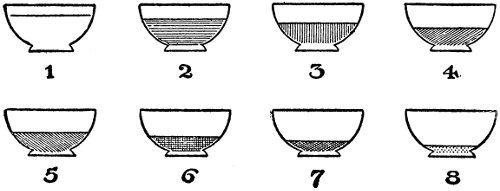
Fig. 1.—Showing finger-bowls containing various colored waters at different levels, each level indicating a different note.
Many attempts have been made to discover some means of producing the sound other than by rubbing the finger over the rim of the glass. Violin bows and other similar contrivances have all proved ineffectual.
It would seem that the texture and surface of the human skin are alone suitable for this purpose, and nothing else has proved successful. This is the reason why musical glasses have not become more common, for the continual rubbing of the wet finger over the surface of the glass becomes after a time somewhat unpleasant. However, this hardly applies to the short period that an ordinary performer would devote to an entertainment. Yet such was the reason that caused the failure of Franklin’s instrument.
The following few bars of music, being the opening phrases of a[104] well-known song, will prove very suitable for glass music, especially when played at the dinner-table after the dessert has been discussed. To simplify the matter for those who are not familiar with the usual notation of music, the notes are given by name, thus enabling any one to pick them out with ease:
E, E, E, F, F, G, F, E, D, E, F, G, C, F, E, D, C.
[105]
There is something vital in the ordinary bell that dominates all of us. It is an important factor in our lives. The railway bell’s clamor reminds us that haste is needed to catch the departing train. The dinner bell tells that the meal is ready for our consumption. The church bell, the wedding chime, the fire bell, the tolling funeral bell, are all our faithful monitors and guardians, but the exquisite voice of the hand-bell is the sweet-lipped friend that wooes us in our hour of ease.
Hand-bell ringing is full of charm and interest, and it is astonishing of what changing harmonies these instruments are capable when manipulated by dexterous hands. Undertaken with perseverance and patience to overcome its rudimentary difficulties, this form of campanology may be achieved with great success.
The first thing to do is to go to a well-known firm to secure the necessary bells, which must be perfectly in tune. The beginner needs only a few, as for some time he must essay only the simplest tunes. The best hand-bells are somewhat expensive, but to buy cheap inferior instruments is false economy and most unsatisfactory, for sonorousness and sweetness of tone depend upon purity of metal and perfect balance.
Those known as the “four-in-hand” consist of four hand-bells attached by means of a leather handle to one base. This enables the player to manipulate eight bells at once. Of course, by making careful inquiries, or by advertising, good second-hand sets of bells can be bought quite cheaply.
It is advisable that the bells be tuned to old Philharmonic pitch, C—540, and they should be fitted with improved pegged clappers.
The first step undertaken by the novice at bell-ringing is to consider and study the construction of the bell. It is surmounted by a loop of leather, and the hinge of the clapper is so made that it can sound only when swayed towards the flat part of the handle. The part of the clapper that touches the bell is composed of felt and not of metal,[106] but this alone is too light a material for the springs, which, it has been discovered, resist it.
To overcome this difficulty it is necessary that the felt should be weighted. This achievement needs skill and experience, for the springs and weight naturally vary according to the size of the bell, and are in exact proportion, small springs being necessary for the small bells and large springs for the large ones.
Bell-ringing companies consist of five players, and these are generally composed of two ladies and three gentlemen; all should be physically strong and possessed of the sense of strict notation and music-reading ability. The ladies generally undertake the alto and tenor parts. The strongest player manages the bass bells, and the most reliable and cool-headed of the party the treble, which is divided into first and second, and is extremely important, needing no small amount of agility and nerve, especially in difficult and intricate passages.
There are many reasons why five players are advisable. Four could not manage the full harmonies of treble, alto, tenor, and bass, while more than five are apt to get in each other’s way, besides taking up too much space on a small platform in a drawing-room.
A long table, covered with some heavy material, such as thick baize or half-a-dozen pairs of good blankets, is essential. Blankets are the best. They should not be spread out or divided, but folded upon the surface, and then concealed by a cloth. This keeps the sound from vibrating through the wood of the table, as the bells are placed upon it, at the termination of each note.
The bells must be in easy reach of the ringer, and the company just formed will do well to chalk lines upon the cloth to divide their positions from that occupied by the neighbor’s bells.
Tenor and alto players should occupy the center of the table. Their work, compared with that of bass and treble, is light and subordinate, and this is why those parts may be undertaken by ladies. The second treble stands at the right end, next to the alto, and the first treble and bass occupy the head and bottom of the table, as shown in Fig. 1.
Immediately after the bell is used the player must be careful to replace it in its former position in the chalked space, or confusion and discord will be the result, as it is almost impossible to remember the[107] position of the bells unless this plan is strictly adhered to. To pick up the wrong bell will lead to disaster.
| Audience. | |||||
| Player ○ |
Bass bells. |
The Table. Bells not in use. |
First treble bells. |
Player ○ |
|
| Tenor bells. | Alto bells. | Second treble bells. |
|||
| Player ○ | Player ○ | Player ○ | |||
Fig. 1.
Many plans have been tried in which to place the bells so that each player may identify the different bells to be used. Perhaps the simplest and most usually adopted is to arrange them in rows upon the table. Supposing the number of bells required to be fifteen, place them in three lines of five. For the first row employ the letters of the alphabet; for the second, even rows of figures; for the last, single odd figures, thus:—
| A | B | C | D | E |
| ○ | ○ | ○ | ○ | ○ |
| 2 | 4 | 6 | 8 | 10 |
| ○ | ○ | ○ | ○ | ○ |
| 1 | 3 | 5 | 7 | 9 |
| ○ | ○ | ○ | ○ | ○ |
Fig. 2.
This plan should be learnt, and the position of the bells be as fixed and relative to each other as the notes of the keyboard of the pianoforte. At first the players stand with the left side turned slightly to the table, but frequently they will be obliged to change their positions, sometimes turning to the right and sometimes facing the table. The bell should never be placed with the flat side of its handle towards the manipulator, for in this position it cannot be struck, however much waved.
[108]
In holding the bell, the thumb must be pressed on the rivet, the fingers gripping the flat side of the handle. When lifting the bell, the handle should slope towards the body, thus forcing the weight of the clapper to swing to the side opposite to that upon which the strike sounds. The bell, being lifted in this position, is not struck, the hand changing its inclination from left to right. In so doing, the bell is turned to an opposite angle, the clapper falls, and the strike is achieved by a slight impetus of the arm or wrist.
The student should practice lifting and striking the bell with alternate hands, until it is as easy to manage it with the left hand as the right. When he has mastered this difficulty he may try the working of two bells—one in each hand, lifting one bell while the other is struck, taking care, however, always to place them in such a position that no turning or twisting of the handle is necessary before action, as this involves loss of time, and makes him liable to constant blunders when he takes part in a tune.
The length of the table varies according to the number of bells required and the style of music undertaken. Forty-four bells are sufficient for most simple melodies and exercises, and for them the space required is about 11 feet by 5 feet.
“Flourishing” the bells is impossible in quick music, and is only undertaken in slow passages, when the notes are to be sustained. In working the bells alternately, the dying vibration of one bell must never be allowed to mingle with the next, for this is even more discordant than when, in pianoforte playing, a pedal is kept down too long, and makes the vibration of one chord jar into the next.
To prevent this, the vibrating bell should be placed on the table immediately before the other is about to be struck, but not in such a manner as to rob the note of its proper value. In a staccato passage, on the contrary, the bells should be set quickly on the table as soon as they have sounded.
In practicing the ringing of alternate bells, make each vibration the value of a semibreve, then a minim, and lastly a crotchet, until perfect dexterity is achieved, thus:—
[109]
When the trebles are divided, the first treble plays the notes turned upwards, and the second treble the downward tailed—thus, in the scale of C:—

Play music
The notes should follow without any break as continuously and smoothly as though one player were ringing the scale.
Ringing two bells in each hand is difficult of accomplishment. In order to do this successfully, one bell is lifted and gripped in the right hand by the first and second fingers and struck downward. Then another bell is inserted between the thumb and first finger, the flat part of the handles at right angles. The first bell is again struck down, when it will be discovered that the second bell remains silent until it is slightly turned from left to right by a quick wrist movement, while in its turn the first bell gives no sound, simply because it needs a downward stroke, and the side stroke, which gives voice to the second bell, is in a contrary direction.
Extreme care and perseverance are necessary before these two bells can be properly manipulated, and a great number of exercises which the student can construct for himself should be practiced.
Chromatic notes present great difficulty, especially in more advanced music, and can only be mastered gradually. In simpler passages, when they occur, the student should place the chromatic bells in the back row in the order in which they are to be used. If his chromatics are arranged (1), (2), (3), (4), (5), and he has memorized their position beforehand, he will have no difficulty in finding them as they are required.
A company of bell-ringers should have a large répertoire of music of as much variety as possible. Many of the pieces which are most suitable are somewhat hackneyed, and yet are cordially welcomed when musically treated, and other works can always be arranged for playing.
Tone, expression, and phrasing are all-important. The rhythm of sounds must not alter with the changing of the bells. It must continue in a sweet flow of music, just as if one hand were manipulating every bell. The jerk, the overlong pause, or the lack of tone in one player’s work, has power to mar the whole performance.
[110]
In large orchestras constant playing together is necessary for proper union and harmonizing of sounds, and this is equally essential in bell-ringing. It must ever be remembered that “practice makes perfect,” and the blending of the bells needs unending patience and persistence.
For beginners such pieces as “The Minstrel Boy,” “She Wore a Wreath of Roses,” “Home, Sweet Home,” “The Last Rose of Summer,” and the National Anthem prove stepping-stones to enterprises of a more complicated nature, and should be carefully studied, for “vaulting ambition” is quite out of the question in the art of hand-bell ringing.
[111]

Fig. 1.
| A. | Hard | palate. |
| B. | Soft | „ |
| D. | Uvula. | |
| E. | Tongue. | |
One of the most delightful sounds in the drawing-room is the music of the human voice, uplifted in song to a soft pianoforte accompaniment, if, of course, the voice be tuneful, easily produced, and sympathetic, and the breathing taken without effort.
The first steps to be considered in singing are (1) correct breathing, (2) voice production, (3) clear pronunciation. The tongue should be hollowed behind the teeth, not rolled up in a ball, thus closing the vocalist’s throat. The uvula, so called because of its supposed likeness to a grape, should be lifted to the roof of the soft palate, the mouth presenting a hollow open chamber, through which the notes issue in clear, bell-like tones (Fig. 1).
The beginner will find this a difficult matter, and effort and will are needed to keep the tongue down and the uvula up. The position of the former may be demonstrated by means of the handle of a teaspoon pressed against it. The tongue will prove rebellious until practice makes it perfectly easy and natural to subdue it in the necessary manner.
In breathing, inhale a long slow breath through the nose only, keeping the mouth closed. The air should originate in the upper part of the diaphragm, and be held until the ribs are slowly inflated, balloon fashion, when it should be exhaled through the open mouth, gently and without effort until the ribs contract. Never push the ribs to lengthen the expiration of breath.
A good plan to insure easy and quiet breathing is to count slowly to ten while the chest box is being inflated, and also when the air is being exhaled. In this manner the breath will be prevented from coming and going in spasmodic gasps and jerks. The number ten may be increased gradually to twenty or thirty, until the student is able to produce breath sufficient for the phrase vocalized. Regular[112] breathing exercises should be taken every day before singing, the hands being placed upon the ribs, in order to feel and insure their gradual rise and fall.
An anatomical study of the throat, windpipe, and lungs should be made (Fig. 2), and this will considerably help the student to understand the difficult mechanism of voice production.
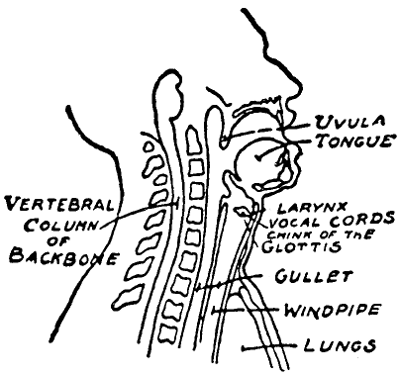
Fig. 2.—Throat, windpipe, and lungs.
Practice gradually adds new notes to the voice, but the young singer must be careful not to strain the vocal organs by endeavoring to sing high and low notes before they are naturally developed.
Concones and every variety of singing exercises should be practiced before a song is undertaken. Over-practice is harmful. Vocal organs should never be fatigued or unduly taxed, and half-an-hour’s practice is ample—indeed, more valuable than an hour at a stretch.
Singing directly after meals should be avoided, and the throat must not be coddled in furs or compressed by high collars.
In drawing-room singing, four or five-versed lyrics are not nearly so charming as the dainty modern songs of two or three verses, and these must never be undertaken until the student has reached a proper understanding of phrasing, breathing, and expression.
Many singers prefer to accompany themselves, but this has its disadvantages, as the voice is far better produced when the vocalist is standing. The position should be easy and natural, the head erect, but not lifted back, as this contracts and narrows the larynx.
While the singer should enter into the idea of the composer, she should have her own conception of the song, and endeavor to give it, as far as possible, her own individual expression, her voice being colored by the cultivation of her soul; otherwise the most perfect vocalization will fail to move the audience.
These elementary rules hold good for the male as well as the female singer, and cannot be too carefully considered.
A further important factor in the art of singing is the hygiene of the human body. The singer must cherish physical health. Plenty of outdoor exercise should be taken. Indulgence in drinking and over-eating is injurious. To practice when fatigued, or indisposed,[113] is to risk permanent harm to the voice; and to sing when suffering from a cold is extremely foolish. At such times, breathing exercises may be taken with advantage, as they clear the lungs and help towards recovery.
Lady singers are sometimes inclined to wear gowns which do not allow them sufficient room for breathing purposes, and they will often willfully sacrifice the well-being of their voices to be fashionably attired. In order to perform their functions properly, the lungs and ribs must have space and freedom from pressure. Too narrow bodices are almost as pernicious to the voice as tight lacing, for these seriously retard the breathing, and what in loose garments is natural and easy of accomplishment, becomes an obvious struggle, which fatigues the singer and renders her voice thin and poor in quality. This is often the reason why a vocalist is seen to lift her shoulders and pant audibly during her song, thus marring her conception, which may be, in every other particular, delightful and artistic.
Many singers with weak lungs find voice production extremely beneficial, for proper breathing and careful practice do more to strengthen a delicate chest than any bottled remedies.
The vocalist should never stoop (for this narrows and compresses the vocal organs), and in singing the first care should be to see that the shoulders are well thrown back, although not strained to an unnatural position.
In practicing, it is beneficial to keep the arms folded behind the back, placing the hands over the elbows, and taking care not to thrust the head forward. This will keep the chest expanded, and the body easily upright.
When performing, it is necessary to be equipped with a good accompanist—one who understands the art thoroughly, and refrains from banging out the notes as if the voice of the singer were merely the background to his own performance. The three qualities essential in an accompanist are sympathy, artistic sensibility, and discernment to understand the temperament and conception of the vocalist.
An inefficient accompanist has power to transform an artist’s highest and most conscientious endeavor into irritability and inability to render individual expression. Pianists frequently are highly recommended to singers because of their gift of sight reading. Now this is a very valuable and important accessory, but there are many excellent sight readers who have no idea of that delicate and tactful manipulation of accompaniment found in the true artist, and who,[114] even though they play correctly the most difficult music placed before them, sadly fail because of inadequate comprehension of the needs vital to the singer.
To hustle the singer is almost as heinous a fault as to lag behind. Some accompanists convey the fatiguing impression of a brake applied to a carriage wheel, and the artist feels as if she were pulling the pianist through the song, while others play as if they were racing to catch a train, and there is not a moment to lose. Both these defects are equally fatal. The pianist on these occasions should neither be independent nor dependent. She or he must realize that, although the pianoforte is subordinate, it is extremely important because of its power to influence the mind and conception of the singer, who should feel an electric tide of sympathy and support flowing from the pianoforte and carrying the voice on a wave of sound.
An accompanist should be chosen with care, rehearsed with frequently, and must possess individual qualities in common with the temperament of the singer. A sense of reliability and strength conveyed will do much to put the most nervous vocalist at ease, and give that tranquility and self-possession without which no singing is successful.
Rehearsing before a mirror is of great assistance, for it is only in studying the reflection of one’s features when singing that one is able to check nervous mannerisms and facial contortions. Pains must be taken to open the lips adequately wide, for the mouth is the mold; the voice, the molten gold; and, if the mold is twisted or narrowed, the gold will be warped and flawed in quality.
The simpler the manner of the singer the sweeter the song, for the affectation sometimes indulged in, the airs and grimaces commonly known as “side,” which some singers see fit to employ, are as unsightly as a mud-splashed window-pane. They are often also the insignia of the incompetent and the ignorant, for it is never the true artist who thus obtrudes herself on her hearers.
Of course, in some cases apparent affectation really originates in extreme nervousness and hyper self-consciousness. In such cases the singer must battle patiently with this embarrassing trait until it is overcome, for unless this is accomplished one’s singing can never be a joy and delight.
In order to be successful, a song must be delivered harmoniously; to voice sweet exquisite words accompanied by facial contortions is to make a pitiful caricature of your performance.
Take care, therefore, that your attitude, features, and expression combine to carry the emotion conveyed in your voice. Study unity and repose. Endeavor to forget your own identity for the time being, considering yourself only as the cage that holds the nightingale.
[115]
Although the singer should be perfect mistress of the songs forming her repertoire, she should always deliver them freshly and spontaneously.
There is an old saying, “Familiarity breeds contempt,” and, notwithstanding the fact that this is usually said of individuals, it may be applied very truly to the relationship that exists between singer and song.
It is very usual for an ambitious student to be consumed with conscientious determination. She makes up her mind to learn a difficult song, and she works assiduously at it day after day, week after week, until she knows every word and every note.
By-and-by she performs it proudly to a select circle of friends, and she is surprised and discouraged to find that all her keen enthusiasm for the song has gone. It does not seem to suit her voice; the words have lost meaning. The emotion she at first poured into it has disappeared, and she is thoroughly disheartened, and is quite unable to find reason or remedy for her indifference.
An experienced artist would be able to show that student in a moment wherein her failure lay.
She had allowed herself to become too familiar, and familiarity had bred contempt. The song doubtless needed practice, but not incessant grinding and toiling. One cannot hammer the arts into one’s head as if they were nails being driven into wood. The subtle essence, the ephemeral spirit of the song will still evade the singer. To catch that, and to reveal it to others, the work must be as pure as the widespread petals of a flower.
So, when listlessness replaces your high enthusiasm for a song with which you have become too familiar, do not be disheartened, but put it away, and determine not to touch it or hear it sung until your first eagerness to master it is reborn. Then, and then only, take it out and sing it, and you will be astonished at the result; for having mastered the technicalities you are able to pour your heart into your words, and the result amazes you and delights your hearers, who think you have never sung anything better or more suitable to the pitch and timbre of your voice.
[116]

Fig. 1.—Correct position for reciter.

Fig. 1a.—The stiff, unnatural position.
It is frequently and quite erroneously supposed by the uninitiated that, given a good memory and a pleasing voice, the young would-be elocutionist may become highly successful in the art of reciting. It is only the painstaking, experienced artist who realizes that these attributes are but as the husk to the nut, the calyx to the bud.
Cased in its shell is the kernel, and folded in its green sheath are the petals of the flower. So, likewise, the voice and power of memorizing must be but the covering of numerous other qualities, attained only by perseverance, judicious practice, and that artistic sense of fitness without which all attempts to excel are in vain.
It is impossible to play a symphony on the pianoforte before grinding away at the rudiments of music, and no one may build a house without mastering the elements of architecture. Yet the difficult art of reciting is often approached by a novice, who, having pounded some poem or prose into his or her memory (reciting is usually a feminine qualification) plunges into it with all the self-satisfaction of ignorance, and pains or fatigues her listeners by her flagrant and unsympathetic rendering of a masterpiece, which, in experienced hands, would be an exquisite piece of work, something to be remembered and dwelt upon with considerable pleasure.
[117]
The speaking voice, properly treated, is an instrument of exquisite music, capable of as many shades of feeling and power as the pipe organ. Before all else the voice must possess sympathy, sweetness, power of expression, and naturalness; and, unless these qualities are governed by a high sensibility, keen intuition, and common sense, they are futile.
The wing of the voice is the breath. Unless this is elastic, easily and naturally produced, the voice is like a crippled bird, or similar to a musical instrument with broken strings. Thus the cultivation of voice and breath is the most powerful adjunct to good reciting, and this only comes by constant practice.
In practicing, the reciter should stand in an easy attitude (Fig. 1)—erect, but not stiffly upright, and with muscles neither tense nor unduly lax, as in Fig. 1a. “There are no straight lines in Nature.” This is an invaluable motto for the student. The best method of gaining a clear and flexible voice is to read aloud some paragraph or verse softly at first, studying the meaning and sound of every word spoken, and endeavoring to express its phonetic quality, not only with the lip, but with the eyes. A mirror is an excellent help (Fig. 2). It will show the beginner the difference between facial expression and facial contortion (Fig. 2a).
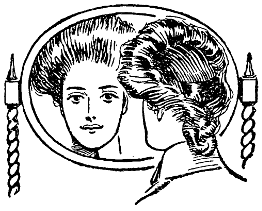
Fig. 2.—Facial expression.
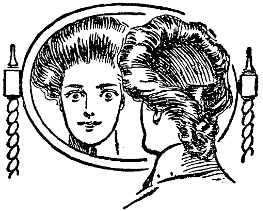
Fig. 2a.—Facial contortion.
The paragraph may be repeated in a gradual crescendo until the full power of the voice is used, always taking care to avoid harsh and stridulous tones, and not strain or fatigue the throat. When the student has accomplished this to her satisfaction, she should allow her voice to die gradually away, until it is almost a whisper, but her tone must always be clear and round in quality. This method[118] will bring many different shades of inflection and feeling into the voice, and she will be astonished at the notes she will add to her speaking register.
A good exercise is to make out a list of abstract words, and, concentrating attention upon them, endeavor to convey their full meaning with the aid of the mirror. Such sentences as: “I love you dearly,” “My hate is too deep for words,” “My scorn is intense,” “My tender concern,” “My pity,” “My contempt,” “My indifference,” “My desire,” “My despair,” and other impromptu phrases may be spoken in different tones, united, with eye and features, to express the qualities voiced.
The student need not despair because she has a bad or untrained memory. The power of memorizing verse or prose only requires diligence and concentration to become facile and natural. Exaggeration, affectation, melodrama, and meaningless gesture should be avoided, for there is nothing so appealing as simplicity.
Before reading a poem aloud, the reciter should master the meaning of the story it sets forward. She must remember that she is about to paint a picture in words. To do this effectively, she must avoid daubing in lurid colors. She will find it helpful to regard her mind as her palette, her voice as her brush, and her color tones as sympathy, tranquillity, gentleness, optimism, faithfulness, and clearness of expression. She should take as much pains when practicing as when performing before others, endeavoring to criticise her mode of speech and expression just as though she were listening to some one else’s recital.
The following simple rules will prove of great assistance:—
Here is an example from “David Copperfield”:
“Here is our pew in the church. What a high-backed pew! With a window near it, out of which our house can be seen, and is seen many times during the morning’s service by Peggotty, who likes to[119] make herself as sure as she can that it’s not being robbed, or is not in flames. But, though Peggotty’s eye wanders, she is much offended if mine does, and frowns to me, as I stand upon the seat, that I am to look at the clergyman.”
In this passage the reciter is for the time being a little boy endeavoring to sit quietly in church and fix his eyes on the clergyman. She must be simplicity itself in order to depict the David and his surroundings, lending a sympathetic eye that probes the brain and heart of the child squeezed between his mother and nurse, and she must see every detail as he describes it.
In order to do this successfully, intuition is essential. It will inspire the voice to a like comprehension, with the result that her listeners will be able to see that little weary figure quite plainly. Thus, in everything undertaken, the student must learn to merge her personality into that of the man, woman, or child of whom she is speaking, so that the words spoken seem indeed to fall from the lips of the characters portrayed.
Appropriate gesture presents difficulties, and, although occasionally a powerful aid, it is more often a stumbling-block to the inexperienced reciter. Many otherwise excellent recitals have been marred by superfluous demonstrations, which remind one forcibly of the action songs and recitations performed in a kindergarten, whilst not a few reciters hedge themselves in with boundaries. They will mention the sea, and point to a horizon, indicate distant hills, wood and lake, frequently forgetting their respective situations. I have seen upon more than one occasion a reciter engaged in a ludicrous juggling of her scenery, pushing the sea aside to make room for the hills, and merging her forests in the lake. This forgetfulness, usually engendered by extreme nervousness, renders an artist ridiculous. How much better, then, to refrain from gesticulation, unless she has mastered its intricacies.
In drawing-room reciting the voice must expand according to the acoustic properties of the apartment. A good way of making the voice carry is to imagine it an india-rubber ball, which is being thrown against the opposite wall. This thought will gradually insure its elastic properties.
When reciting, the eyes should be kept from roving among the audience, nor should they be fixed in a strained, glassy stare on the ceiling, for they are too useful to the performer, and will be needed to express different shades of thought.
If the reciter is nervous, she should endeavor not to show it[120] by twisting her fingers or moving her feet. The best cure for this harassing affliction is to glance quietly at the audience before beginning to recite. Taken individually, they will be found far from alarming. After this, a determined endeavor should be made to concentrate the mind on the artistic rendering of the recital.
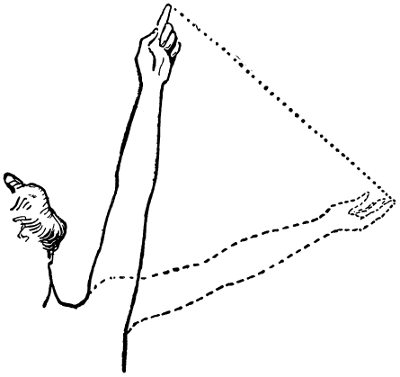
Fig. 3.—The epic radius, or mental zone.
To many elocutionists, costumes are a help, enabling them to grip more powerfully the character portrayed. In this case a certain amount of gesture is advisable, but there are no hard and fast rules. Actions must be governed by discretion and common sense.
The hand may properly be called a second tongue. As such it should be treated, and, to continue the simile, should not be allowed to stammer behind or chatter meaninglessly before the reciter.
The hands and arms are capable of a vast amount of expression when properly used.
Gesture may be divided into three classes:—
1. The epic radius, or mental zone, is the movement above the head and horizontal with the shoulder (Fig. 3). These are sweeping and graceful, not jerky movements, indicating such sentiments as honor, conscience, awe, veneration, &c., and may be used with advantage in such lines as—
[121]
In Shakespearean recitals and other blank verse, this epic zone may be used, as, for instance, in such pieces as the choruses of Henry V.
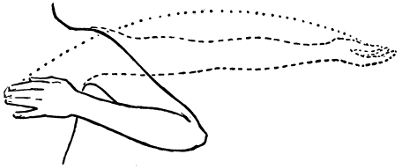
Fig. 4.—Rhetorical radius or moral zone.
2. The rhetorical radius, or moral zone, includes the movements of the arm from breast to shoulder and from the region of the heart (Fig. 4), and may be used to appeal, implore, beseech, express love, hate, fear, contempt, &c., as in Queen Katherine’s speech in Shakespeare’s “King Henry VIII.,” Act ii. Scene 4:—
3. The colloquial radius, or vital zone, from below the waist (Fig. 5), is used to express ordinary sentiments that do not emanate in the heart or higher intellect, and may be used to give point to a simple, everyday occurrence, or narration, as in—
During the long winter evenings, when amusements and entertainments are cordially welcomed in home circles and at friends’ firesides,[122] the youth or maiden who is unable to play or sing, may, with a little care and practice, provide a delightful item in the programme, which will add considerably to the evening’s enjoyment.
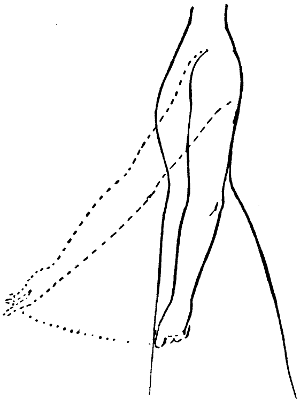
Fig. 5.—Colloquial radius or vital zone.
An hour’s regular practice a day will work wonders with the voice of these aspirants, and there are many simple and exquisite poems that are easily committed to memory, for the student is far more likely to succeed and give pleasure to others in memorizing at first only the simplest and shortest poems, remembering always Shakespeare’s invaluable counsel to players:—
“Speak the speech, I pray you, as I pronounced it to you, trippingly on the tongue; but, if you mouth it, as many of your players do, I had as lief the town-crier spoke my lines. Nor do not saw the air too much with your hand—thus; but use all gently; for in the very torrent, tempest, and (as I may say) the whirlwind of passion, you must acquire and beget a temperance that may give it smoothness ... Be not too tame, neither, but let your discretion be your tutor; suit the action to the word, the word to the action, with this special observance, that you o’erstep not the modesty of Nature.”
[123]
There is no form of drawing-room entertainment which, when well done, is more interesting than whistling, with pianoforte accompaniment.
Below are embodied the views and methods of Mr. Charles Capper, the famous English siffleur, regarding this unique and attractive means of entertainment.
The great part of humanity knows nothing of that ability of piping and whistling so natural and melodious in the blackbird and thrush. Most of us have at some time or other put by a little of our bread-and-butter earnings in order to take a few lessons in learning to sing or to play the pianoforte or some stringed instrument. But there are comparatively few who turn to whistling as a means of livelihood or as an accomplishment. It is fortunate that this is the case, for, unless one possesses considerable natural talent, it is mere waste of money, time, and endeavor.
Whistling cannot be hammered into being. It is only where real ability is possessed that the student may set himself to work and overcome its many difficulties, and hope to achieve his best.
Another gift equally essential is that of a good natural ear—an ear that instantly distinguishes and corrects the note which is a shade flatter or sharper than it should be.
It is a fact worthy of note that, while an unusually high roof to the mouth is a disadvantage to the singer, it is—so some medical specialists assert—a great gain to the whistler, and perhaps this is the reason why it is so rare to meet skilled exponents of the art.
However, it is common enough to hear in almost every grade of life the whistling that has never been cultivated. For example, in the early morning, a few shrill tuneless notes float up to one’s bedchamber from the area steps, as a dairyman hands in the allowance of milk; but this annoys rather than delights, although it speaks eloquently of the human soul of the whistler.
[124]
When the boy whistles, his mother knows he is well—in a good temper, and contented with the whole universe. The merchant, stepping into his office, may trill a few bars of “Tommy, make room for your uncle,” and the sound conveys volumes to the sharp-eared clerks, who foresee a day of unusual calm and peace; because a man suffering from spleen, liver, gout, or toothache never so far forgets his agony as to whistle.
Whistling invariably shows a light heart, and perhaps the reason why the birds indulge in this pastime so freely is because they know nothing of the burdens that beset mankind.
The most important qualities to be observed in whistling are production and control of breathing, modulation, purity and roundness of tone.
The method of breathing in whistling is exactly similar to that used in vocalization, and can be taught by any good teacher of singing. Scales and exercises should be daily practiced with infinite care,—to keep the notes clear and of even pitch.
Slurring or stumbling in a quick passage can be easily perceived—perhaps more so in the whistler than in the singer. Scales and runs should be undertaken, slowly at first, gradually increasing speed and tone until perfect flexibility is attained.
Many a whistler capable of faultless execution fails to charm, through monotony of tone. This is a fault as common as it is serious. Whistling, with practice and thought, can be modulated in a far greater degree than either the flute or the piccolo, and with much greater effect.
It is not enough to whistle a song correctly. The student should first study and memorize the words, so that he may express the tender pathos expressed in the song.
The whistler should pay as much attention to artistic rendition as the vocalist—if possible, even more—because he cannot voice the words with which to appeal to the hearts of his hearers. He is obliged to convey the sorrow, or humor, as the case may be, without the utterances we recognize as the insignia of distress, joy, or love; and his heart must be behind his notes, and enter into them, to win the spirits of the audience to comprehension and sympathy.
[125]
Whistling may be divided into two classes:—
(1) The florid.—necessary in such solos as Arditi’s “Il Bacio,” which seems at first to the beginner to teem with insurmountable difficulties, but which a little earnest practice will soon overcome.
(2) The sentimental.—In this category are Bishop’s early English songs, such as “Bid me discourse,” “Tell me, my heart,” “Should he upbraid,” “Lo, hear the gentle lark,” “Love has eyes,” Clay’s “I’ll sing thee songs of Araby,” &c. All these songs make excellent whistling solos, and are delightful when rendered with artistic sympathy and meaning.
All songs must be memorized. The whistler cannot give necessary control to his breathing and production if he holds the music in his hand. In practicing, it should be placed on a music-stand, and, in performing, must be note perfect. His whistling must be so faultless in its conception that the audience must almost hear the words coming from his lips.
Most of the solos forming the whistler’s repertoire are well known and popular, and the verses of such songs as “My mother bids me bind my hair” are familiar wherever the English language is spoken, so that all audiences are capable of interpreting the meaning of the sweet lilting notes. When we listen to “The Lost Chord,” played on the organ, we seem to hear the throbbing rhythm of the words just as if some spirit were singing them, and so it should be in the whistling of Spohr’s “Rose softly blooming,” and many another song which will doubtless occur to the student.
Care should be taken not to whistle in too high a key, as this spoils the quality of the tone, rendering it thin and shrill. The middle register contains better notes than the higher.
The piccolo is pitched one octave higher than the flute, whilst the whistler’s notes are said to be two octaves above the flute. Although the notes whistled are apparently very high, when judged by the ear, or compared with the pianoforte accompaniment, they are not so, in reality.
It is rare to find the extremely high or the extremely low whistler. Except in a very few cases, all whistle in about the same pitch. The most usual key is F or G.
In spite of the old dogmatic assertion about the “whistling woman and the crowing hen,” there are more young lady performers in this profession than young men, and very charming whistlers some of them are.
[126]
It is a remarkable fact that not infrequently an individual, whose tonation is faultless in singing, cannot whistle such a simple melody as the national anthem without coming to grief.
Here are two useful points always observed by Mr. Capper.
The first is never to laugh when performing. The veriest novice knows that his risibilities must be well under control before he can whistle a single note, so that it is essential for him—no matter what funny incident is noticed and appeals to him—to hold tight to his gravity.
The second is that lip-salves should be strictly avoided, as they render the lips susceptible to cracks and cold; besides, they make a film which sticks and prevents clear whistling.
[127]
It has been asserted that the noun “bunkum” is first cousin to the verb “to bunk.” If so, the dealer in bunkumisms disdains the connection until matters grow too hot for him at the end of a performance, when, as a last resource, he hugs his relative gladly. Cupboard affection this, and in order to shelter himself from the righteous wrath of the audience, achieves a flying bunk from the platform.
The word “bunkum” is interesting. It is defined in the dictionary as “speech spoken merely to please one’s supporters or constituents and secure their votes—mere talk.” It originates from “Buncombe, a district in North Carolina, with a constituency, to please whom a member of theirs once boasted he made a speech in Congress.”
Bunkum covers a wider field than science, woman’s suffrage, or politics. It is an autocrat that stands aloof, and demands the gentle hearts of greenhorn and sage alike for its sacrificial fires. It endeavors to prove that the age of miracles has not been choked out of existence beneath the widespread fingers of civilization, or how could an orange be transformed before our eyes into a cauliflower, an egg into a peeled potato ?
The bunkum entertainer molds the brains of the most iron-headed cynic into putty, and transforms the scoffing jeers of the know-all schoolboy into humble admiration. He is a quack sorcerer, and, even while we designate him as such, we are obliged to own that his art is steeped in deepest mystery.
The bunkum entertainer is a parasite, a cartoonist, and mimic, a smooth-tongued, unscrupulous rascal, who deserves—the conscientious entertainer (who never tries bunkum because he is too stupid and wool-headed) so has it—to be banished to a desert island and served to cannibals as minced donkey flesh “à la bunkum.” He is the sort of man who borrows five pound notes, gold watches, and diamond rings from his audience, and forgets to return them. He cheats, deludes, patters, lies by the yard, swallows enough solid materials to furnish a warehouse, and give an ostrich indigestion.
[128]
He is tough and brazen, and cheaply cynical at the expense of the authentic conjurer, juggler, phrenologist, ventriloquist, seer, and spiritualist. He is the cuckoo of society. He concocts a potpourri of brains and wit, and offers it as his own; and yet, in spite of it all, how fascinating and overwhelming is his personality. He is the fool of the world—the jester who prances about in cap and bells, who causes our sides to ache in our futile effort to keep our risibilities decorously pitched. Never did a folly play pitch and toss with the pedantic phrases of solemn courtiers, kings and prelates, as ably and irreverently as this monster incarnate with the five senses of mankind.
He is wrapped in mystery. We regard him with awe and wonder: the curtains, the table, the walls, the footlights are his faithful agents. We gaze at the rabbit popping up from his hat, the watch flicked through a pistol barrel to the wall, the inane jack of diamonds darting from his mouth to the back of his coat, in trembling amazement of his cunning. We whisper to our beating hearts, “Can such things be?” At that instant he throws aside the cloak of secrecy, and shows us his glaring infidelity. He has not, as we supposed, ruptured and mastered every law of gravitation and nature. He has simply been dealing in the art of “bunkum,” and, when he reveals his methods to us, as he never fails to do in a continuous prattle of artless confidence, we see—or we think we see—that it is all child’s play and foolish absurdity.
The rabbit has not been suddenly created, full-grown, in the crown of his immaculate silk hat. It owes its mild behavior to constant discipline, its sleek coat to cabbage leaves. Like Topsy—like all other bipeds, quadrupeds and aquatic creatures—it has simply “growed.” Its cage is behind the stage, to which it will presently be spirited away, to rest in peace after its labors.
When we discover this we become very wide-awake, very “cute.” We will see through the next trick or perish in the attempt. Alas! alas! for our righteous determination; once again we are deluded and snared. The table performs a giddy reel, the watch of the confiding benign bald-headed gentleman in the corner is shattered before our eyes, and with a thrill of horror we strain our necks to gaze in his direction in order to witness the anticipated apoplectic seizure.
The gentleman, however, remains stolidly non-committal. My young schoolboy eyes observe a whitening of the gills, a compression of the lower jaw that bodes ill for the entertainer if he does not make good the loss; and a few minutes after he is bidden of the smiling performer to look in his pocket, and, lo and behold! the monogrammed watch, which we are ready to swear we saw him pass to the platform, dangles safely from the end of the chain spanning his stomach. The[129] shattered timepiece, we are told glibly, was only a base imitation in tin and glass.
But how, where, in what manner? queries my boyish soul, steeped in perplexity; and, by-and-by, the monster answers all these questions as if he read that inner inquisitive voice so satisfactorily that I go home and try the trick before an admiring circle of friends, borrowing my maiden aunt’s watch for the purpose, she being quite unaware that I have its threepenny duplicate in my pocket.
I am sure of success. I imitate the performer’s patronizing complacency perfectly. I smile and sneer politely with all his evil suavity, and then I fire my pistol, shatter the glass of the threepenny, and my aunt rises from her chair with a piercing shriek.
“Tom, you little wretch, what have you done?”
With an airy smile I bid her be calm, and from the rear part of my person produce with a deft movement her precious belonging.
“Your watch, madam,” I say, with all the superior pleasantry of the “bunkum” performer.
Then the smile freezes on my face, the timepiece feels strangely light in my clammy hand. I gaze at it in horror. My eyeballs distend, my heart swings backwards and forwards between my ribs. I have bungled! The good watch is shattered beyond hope of redemption. The disc of paper and glass cowers up at me, its hands stretched confusedly across its impudent face.
Disgrace and ignominy descend swiftly upon me. My maiden aunt prepares to leave the house, declaring she will never enter it again. My parents, who expect great things at her demise, beseech her forgiveness in vain. I am banished from the firelit circle to my own room, up to which a step presently approaches, striding away from the disorder and hysterics downstairs. My father enters with a long slender implement behind his back—an implement which, from former experience, I know portends woe terrific.
I draw the curtain—I am chastised and broken in body and spirit. For a whole week I keep severely aloof from the awful bunkum tyrant, and then, alas! I am drawn again to the hall, where he is performing as remorselessly as the silly fly is drawn to enmesh himself in the spider’s web.
The next time I played a trick on my family I took good care it should be of a kind that would do no one—not even the most hypersensitive individual—any harm. Needless to say, my aunt was not of the circle.
[130]
I told them briefly and airily that I was now about to exhibit my wonderful skill in thought-reading. Perhaps I should add that my sister Jane, who adores me, was chosen as my confederate. Bidding them fix on a number, which I would at once discover by the simple means of placing my fingers on their temples, I withdrew with a bland smile into the passage.
When I returned they giggled a little, and one twelve-year-old cynic of the opposite sex piped out scornfully—
“You’ll never guess it, Tom. You can’t possibly—so there.”
This maiden, often a thorn in my flesh, I silenced with a severe frown.
“If you please, I must request the audience to be perfectly silent, to concentrate their minds—those of you who possess them——” I paused to scowl at my pink-and-white torment—“concentrate them absolutely on the chosen number. I am not going to guess it. I am going to discover it by means of thought transference, and, as the strain is very great, I must ask you to be perfectly silent.”
“It’s like having our photo taken,” whispered the torment, but some one bumped her ribs, and she was reluctantly silent.
Solemnly, slowly, I moved round the circle. With drawn brows and narrowed eyes I placed my fingers lightly on the temples of my father, mother, uncle, and friends in succession, and then I reached Jane. She set her teeth just as I had shown her, and I felt the muscles at her temples work steadily. Having counted ten vibrations, I went on stolidly to the other heads until the circle was completed. Then, standing before them, I wiped the imaginary sweat of fatigue from my brow. The torment looked radiant.
“You don’t know it? There—I said so, Tom, you goose.”
“Madam,” I returned with a bow, “the digit fixed upon was ten!”
Tableau vivant! The complete confusion of the torment, the most guileless “bravo” from Jane, and my uncle’s audible whisper to my proud parents.
“The boy’s a positive genius!”
“And he looks quite white and tired,” quoth mamma.
Result—the promise of a ripping new bicycle from grandpa as a reward for my merit.
I owed a lot to Jane, who remained my faithful unsuspected confederate in many other tricks, which gained me a reputation of being something of an extraordinary phenomenon and possessed of embryo[131] genius. It was delightful to enjoy the giddy pinnacle of fame to which my female relations raised me.
Another trick that caused much sensation was the following, and, for any youth who wishes to follow in the footsteps of the great (which I think some old poet chap—who had never studied the art of bunkum—remarked are written “on the sands of Time,”) I will state clearly the manner in which it was done.
Place three corks on the table, and tell your wondering home circle that, while you withdraw, they may touch one of them, and you will tell them which cork they touched. Your confederate must classify them as top, middle, and bottom.
When you return, do not look at her fixedly, but just once through the tail of your eye. If you observe her brush her hair carelessly from her forehead, you may safely conclude that the top cork is the one that has been touched. If she picks an imaginary speck from her nose or blows it, it is the middle cork. If she scratches her chin pensively, it is the bottom cork. She must take care not to prolong the process, and you must see at once (without appearing to do so) the hint conveyed.
By-and-by, delighted with my many successes, I studied and exhibited the difficult art of ventriloquism. Jane and I, after long saving of pocket-money and hoarding of occasional tips—bestowed by kindly relatives, susceptible to hints—succeeded in purchasing a dilapidated doll from a second-hand dealer, and, mastering the anatomy of its joints, produced it, seated in the place of honor in front of a curtained receptacle in which Hyde, our servant, was cramped with a mouth organ, glass of water, straw and other apparatus, carefully schooled beforehand as to cues and the order of utensils to be used. Or in place of a lay figure, another boy seated in the chair, and appropriately dressed, can act as dummy (Fig. 1).
The bunkum ventriloquist must insert his hand in the hole at the back of the dummy, so that he can move his head and limbs as desired. He must also convey the appearance of throwing his voice outward from his chest, boots or stomach, without opening his lips except when addressing the dummy.
“Ladies and gentlemen,” said I very grandly, “I am about to exhibit to you some marvelous feats to illustrate faithfully the psychological force which mind exerts over matter. This gentleman has spent thousands of years in an African tomb. He was buried on his face, and that accounts for his battered nose, while it typifies the greatness of the position he occupied in 15 B.C., when it was the[132] custom to put corpses of royal blood with their features compressed against the bottom of their coffins. You would much prefer to hear his story from his own lips, and this he will now relate at my persuasion:—
“Androde!”
Hyde (in a far away husky voice): “Noble lord.”
“The audience here wish to know something of your experiences previous to your long confinement in the willy waily tomb on the Timbuctoo plains.”
(Hyde bubbles the water through the straw.)
“He’s overcome with emotion. These are tears trickling through the floodgates.” (Produce handkerchief and wipe them away.)
“There, there, old chappie, don’t cry.”
Hyde (huskily): “When I think of the sand and the worms, I can’t help it.”
“Don’t think about them. Tell us about the Palace Mahomé in which you lived.”
Hyde: “It was very beautiful—flowers, fountains, fruit, and baccy as much as I could consoom.”
Hyde’s pronunciation is somewhat faulty, but I excuse this by saying that poor Androde has not sufficient air in his sand-choked lungs to pronounce clearly.

Fig. 1.—Fake ventriloquism.
“And there were birds, were there not?”
Hyde (sadly): “The air was thick with them, noble lord.”
“Can you recall the note of the Timbuctoo owl?”
(Figure lost in pondering. Head bent, hand raised to temple in Shakespearean attitude; lifts his face, mouth opened in a wide grin.)
Hyde: “It all comes back.”
“Give us a specimen of the owl.”
[133]
(Pause. Dummy thinks hard, and Hyde blows mouthpiece. I then call upon him to imitate the Timbuctoo lion, and Hyde growls through a glass chimney, swayed backwards and forwards, and renders excellent imitation.)
I need not narrate our further conversation. The young bunkum entertainer can concoct something probably far more idiotic himself. He may dish up puns, tell funny tales, ask riddles, &c., and, so long as his patter is bright, amusing, and illustrated by as many funny jerks and head-turnings of his dummy as he can squeeze into the entertainment, he will keep a house party amused for a considerable time.
My figure is not always posed as an unearthed royal mummy from the plains of Timbuctoo. Sometimes I dress him as a coster-boy, chimney-sweep, or gentleman in evening dress. Not infrequently he appears as a clown in tight linen skull-cap and red stockings; and a quick change into my mother’s old dress, renovated by Jane, transforms him from an awkward-limbed hoyden to a demure old lady.
This dressing need not cost the performer anything. He has only to unearth a linen bag, containing remnants and articles of outgrown clothing, to work the miracle. A dummy should have as many different costumes as Queen Elizabeth. They will all come in handy, and add novelty to the entertainment.
If the cost of procuring a dummy is beyond the performer’s purse—as it was beyond mine for quite a considerable time—he may engage a confederate to walk, behave, and talk automatically, conceal his face in mask and wig, and render a clever and ludicrous performance. This, however, needs considerable rehearsing and care.
An item that makes for novelty and change in an evening’s performance is the following:—
Secure three young girls—I don’t mean kidnap them, but use your masculine powers of persuasion. (I find the majority of women folk need little when it’s a matter of dressing up and showing off to hilarious friends.) This is a digression.
Each damsel must have an old woman’s mask, the uglier the better, secured at the back of her head by means of elastics, which are easily hidden by her hair. She must wear a long skirt that conceals her feet, the back part of it covered by a small apron.
Her hands, in mittens, should be clasped behind her over a stick. To hide the edge of the mask, some fluffy headgear is essential, such[134] as a lace fascinator with a rose or two fixed at the side, which is folded crosswise over the back of her shoulders and frames the mask.
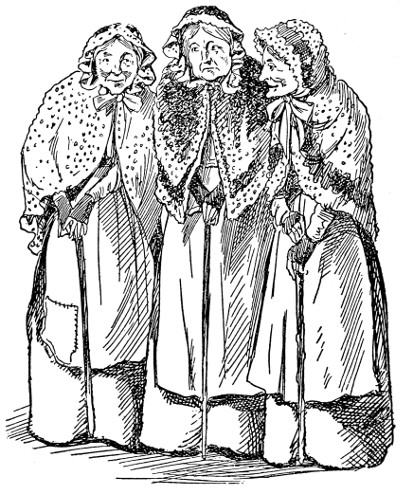
Fig. 2.—The Three Old Maids of Lee.
Place the three behind a curtain. When all is ready—and the performers should take care to stand perfectly still, for fear of disclosing the masked profiles at the back of their heads—the curtain is drawn, and they sing to a pianoforte accompaniment a verse of “We are three young maids of Lee.”
The onlookers will probably designate this “pretty, but rather tame.” This is where the fun comes in, for no one is prepared for the grand finale. At the end of the verse the maidens step backwards in a row and retire behind the curtain, or turn round with their masks to the audience, their heads thrown well over the hands holding the sticks (Fig. 2). When they are ready the curtain is again drawn, and,[135] amid shrieks of merriment, the last verse is sung by voices as cracked, discordant, and out of tune as possible—“We are three old maids of Lee.” The hands and heads should quiver with old age, the figures be bowed over the sticks. The result is ludicrous to a degree, and never fails to delight the unprepared audience.
I once saw an old dowager duchess, severe in full consciousness of war-paint and feathers, nearly burst the diamond snap of her necklace with laughing at the absurdity of the spectacle presented. Its great advantage is that it is cheap and easy, and can be performed without any rehearsing, by inviting three girls from the audience and spending a few minutes in instructions behind the scenes.
If you do not know them well enough to presume so far upon their good-nature, call up three chums of your own sex, array them in feminine apparel, and the result is even more ludicrous, if more expensive, for in this case you will require wigs to hide their cropped heads for the first verse, and dressing them will need more time.
I have frequently amused my long-suffering friends and relatives by Bunkum Lectures. For example, one on Toe and Cornology, quite an original science, gives scope for the most idiotic remarks on the characteristic traits portrayed by toes.
For my lecture I have an easel, covered with a block of thin paper perforated at the top, so that the sheets are easily torn off. On these I rapidly sketch in turn different types of toes in chalk.
If the entertainer is unable to draw, he can probably persuade an artist friend to sketch the members required beforehand. In this case the sheets need not be perforated, but simply thrown over the top of the easel as he exhibits the different drawings. An easel is soon constructed, and can be made at home out of soap boxes by the amateur carpenter; or the block of paper may be placed on a music-stand.
I begin my lecture by a short treatise on toes. I show diagrams of (1) the President’s toe, (2) the prelate’s toe, (3) the courtier’s toe, (4) the tyrant’s toe, (5) the toady’s toe, (6) the artisan’s toe, (7) the neurotic toe, (8) the spiteful toe, (9) the cringing toe, (10) the poetic toe, (11) the melancholy toe, (12) the absurd toe, (13) the philanthropic toe, (14) the corn-riddled toe. Here I try to be witty, and remark that some people of an original turn of mind wear their corns on their noses instead of inside their boots.
“The corn is precious—we all need corn; we make a great to-do when our corn is oppressed by taxes, for we cherish it. There is nothing—not even his wife or twin babes—so dear to the heart and[136] necessary to the well-being of man as corn. Corn means bread. Bread is the staff of life. The man with corn (a corn) is grateful for the prop of the staff, so that to have a corn sprouting on your big toe should be no hardship.
“It is a convenience. It is tinned for consumption in your boot, out of reach of Tariff Reformers and Free Traders. It is your own private property. Sometimes it is trodden on maliciously, but it does not vanish on that account. There is something obstinate and bull-necked about the corn—the more it is trodden on the more it asserts itself. It is a hot-house plant. It needs a cover of wool, a roof of boot leather. Under these conditions it thrives like the baby fed on Mellin’s food.
“I can’t understand the fuss the unemployed make. Why should they, when they have such a treasure hidden in their boots? So long as a citizen possesses this luxury he is an independent man. What does he want with foreign corn? Ah, my friends, we have not yet reached the full realization of the tremendous privileges we inherit. The corn may not yet be ripe for cutting, but every day, every hour, sees it nearer that perfection which rejoices the heart of humanity.
“See how beneficent nature has become during the last centuries. The bootless, prehistoric savage had to plant and reap his corn in the barren fields, while we are provided gratis with an abundant supply that is likely to last some of us a lifetime.
“There are, of course, some individuals who have barren, cornless toes, although I am glad to say they are in a very small minority. I have taken pains to secure a correct census of the corn-sprouts that have appeared during the last year, and I find on an average that only 5 per cent. are ignorant of this blessing.
“The uses of a corn crop are too numerous to mention. Its chief function is its use as a barometer. The man setting out with his wife and children to spend a day at the seaside should, before starting on the excursion, consult his booted friend. If it admonishes him severely he should not ignore its voice. Woe betide him if he does! It is less disastrous for him to drown his conscience than shut his heart against the promptings of his corn.
“Should he do so, and act upon his determination to spend a long day on the sands, anticipating a pleasurable bask in the sunshine, dire catastrophe will befall him. Rain descends in bucketfuls upon him, his patient wife, and wailing progeny. They return to town drenched to the skin, and are all laid up with chills, which means a week’s absence from the office—perhaps dismissal by his employer, if he is a clerk, and a long doctor’s bill at the end of the month; and who is to blame?[137] Had the man obeyed the mandates of the faithful vegetable protuberance on his big toe all would have been well.
“The only individual I am inclined to respect and admire is the man who cultivates and is led by his corn in all the important affairs of life. To be without the ripening corn is to miss the greater part of the meaning and poignancy of existence. The possession of this treasure causes a man to thread his way gingerly and tactfully through the city streets. He never blunders or bungles; he is a sensitive, considerate person, who unconsciously avoids treading upon or coveting the abundant crops of others. His corn’s influence is more beneficial than freemasonry or foreign missions.
“To gain the sympathies and interest of a fellow-being when you are in trouble and want his financial aid, don’t plunge into your story at once, but approach him gently with the kindly query, ‘Have you a corn?’ If he replies in the affirmative, you may safely intrust him with your difficulties. If, on the contrary, he negatives your question, recognize at once that he is a man of dormant sympathies, and don’t waste further time upon him. It will be useless. He is a cornless individual, therefore heartless.”
I wind up my discourse with some such remark as this—
“Ladies and gentlemen, turn away from the pernicious tyrants who seek to rob you of your birthright in advertising corn salves and plasters. They are wolves in sheep’s clothing. They are jealous and embittered by the barrenness of their toe pastures which, do what they will, yield no corn.”
After this, in order to secure the forgiveness of my hearers for my opinions and oratory, both pure bunkum, I bring a trick to their notice, which I work with Hyde, and of which I am rather proud, because it is quite original and works awfully well, in spite of the fact that it’s as simple as the alphabet. For those who would like to try it, here it is:—
Hyde, hidden behind me, is armed with a paper bag inflated with air. Beforehand I place a used bullet on the floor at the spot at which I intend aiming my pistol.
I employ some patter to remove the growing alarm of my family, and the anxiety expressed for themselves, the furniture, and lastly—my own person.
“Ladies and gentlemen,” I say with self-complacency extreme, “I am about to perform a feat with my hands”—(joke—pause—a flutter of laughter). “Thank you,” I say with a polite bow—“the like of[138] which has never been seen—since the making of the world. I will load and fire this revolver, and the bullet will not only make no mark, but there will not even be a flash or smoke. You will hear the sound of the explosion, and I will show you the bullet discharged.
“So that you may see that there is no bunkum in this marvelous achievement, I will hand you the bullet before I place it in the barrel and immediately after I have fired it.” (Here I pass round unused bullet. I then place it in full view of the audience in the barrel.)
I retire to the curtain immediately in front of Hyde, and take aim above the spot where the spent bullet lies. Count aloud “One, two, three!” At three I pretend to pull the trigger, and Hyde brings his hand forcibly on the paper bag, which causes my audience to bounce in their chairs.
Then I cross the platform, stoop, pick up the used bullet, hand it round for inspection, and retire modestly, overcome with glory.
Occasionally I work a ghost in the following way. After some patter, in which I inform the onlookers that I am about to conjure up the shade of some famous character, I extinguish the lights, and withdrawing to a corner of the room, enfold myself in a long black mackintosh or coat that shrouds my head and figure completely.
I strike a match behind the curtain, and, when I have a good spark that will last a few seconds, blow out the flame, and hold the end of the match between my teeth, so that my mouth is lit up (Fig. 3). My lips are drawn in a fiendish grin, and I strike an attitude, accompanied by inhuman moans and drum-beating from Hyde.

Fig. 3.—The Ghost.
When the spark dies, I hide the black garment behind the curtain, and assume the position I occupied before the appearance of the ghost.
[139]
Hyde switches on the light, and my shivering onlookers have no key to the riddle.
The apparatus employed by the bunkum entertainer and the cost it entails depend largely upon his own ingenuity. Most of the articles I employ are of my own manufacture. My wigs do not hail from a wig-maker’s, but from the lumber room at the top of our house, where Jane and I shred disused rope, fix it by means of gum or stitches on to pieces of stiff book-muslin, shaped so as to fit the head. If other colors, such as black and red, are required, we resort to aniline dyes, and the result is much satisfaction to ourselves.
[140]
There is one form of entertainment which perhaps makes a stronger appeal to the average boy and young man than almost any other. It would not, in a sense, be wrong to say that ventriloquism is, and has been for a great number of years, the most envied of all accomplishments incidental to the art of the amateur and semi-professional entertainer.
True, ventriloquism for many centuries was regarded as an adjunct to wizardry, and the exponents of black magic, but the great success achieved by the writer of “Valentine Vox,” the central character in which was endowed with the most wonderful and extraordinary powers of voice throwing, brought the subject of ventriloquism at once under general notice, and ever since it has steadily won its way into universal favor, with the result that, at the present time, it easily eclipses in popularity most other forms of amusement.
Despite this, however, the misconceptions existing regarding this branch of vocal phonetics are extraordinarily numerous and widespread, due, perhaps, in a measure to the fact that the amount of valuable written instruction on ventriloquism is so small, while the number of people who have swallowed the fascinating and improbable adventures dealt with in the book just referred to are correspondingly large.
To a very considerable extent, then, it is the object of this chapter primarily to dispose of the many existing fallacies concerning ventriloquism, because by so doing alone is it possible to commence a study of the subject with the hope of attaining proficiency and success.
The first idea which the would-be ventriloquist has to dismiss from his mind is that, by following out a stated course of exercises, he will be able to “throw” his voice or, in other words, to upset the equanimity of peaceable old gentlemen snoring quietly in the furthest corner of the railway carriage—or ruffle the temper of some aged lady by producing facetious remarks concerning her appearance—from a long distance away; not that those who approach this subject have any particular[141] desire to be a disturbing influence to other people, but it is safe to say that more take up ventriloquism with the idea of practical joking than for any other purpose.
In point of truth, the real art of Valentine Vox does not lend itself very easily to the production of such illusions; even when the performer is capable of producing ventriloquial sound, he will discover that the “distant” effect depends almost entirely upon his situation at the moment of utterance, and whether or not those around him are prepared to give the credence he desires to his efforts. In other words, a ventriloquist cannot throw his voice wheresoever he will as if it were sound bottled up only to come out and be heard when it is some distance away; the best he can hope for is to make that sound so deceptive to the ears of his audience that, to them, it seems to come from some one other than the actual speaker.
It cannot, however, be denied that the stock-in-trade of the clever ventriloquist is so unusual and superior to that of his fellow-worker in any other branch of entertainment, that he is capable of producing the most humorous and arresting situations. Moreover, it is a power which once gained can never be lost, and although a ventriloquist may, from various causes, give up the pursuit of his favorite subject for a period of many years, yet he can pick it up again at the point where he left it and find himself still possessed of the same wonderful and extraordinary skill.
Unhappily there are other very prevalent misconceptions to be removed before instruction can be either given or undertaken. The marvelous and almost incomprehensible powers attributed by the late Mr. Henry Cockton to his popular character, doubtless gave rise to the idea that ventriloquism was a gift natural only to those possessing unusual formation of the throat and vocal organs. Modern research and investigation, however, have proved that every one is a born ventriloquist, that the power to make sounds appear to emanate at a point remote from the speaker is universal—and that all those who study the subject from a proper and sensible standpoint can easily acquire the art.
Then, again, it has long been supposed by the uninitiated that ventriloquial practice is injurious to the throat, and capable of harming the lungs. Exactly the opposite is the case; the exercises necessitated by the proper study of the art are such as will serve not only to train the vocal organs, but also to induce proper breathing—a practice neglected by many—and to strengthen and invigorate the lungs.
From many years’ personal experience the author can testify to[142] the truth of this fact; he has known a number of young men who, possessing lung and throat troubles, and acting on the foregoing advice, have followed out a practical course of ventriloquial training, and have obtained much material benefit thereby.
Of course it cannot be denied that some possess a natural aptitude for the correct expression of ventriloquial sound, and it is they who make the cleverest exponents. Therefore, from the start it should be assumed that a ventriloquist has only to cultivate the vocal qualifications with which he has been endowed in order to shine as a popular entertainer.
Careful and systematic attention to the instructions subjoined will not only strengthen the throat and respiratory organs, but will also endow any one young man, or young woman, with the power of giving a highly amusing entertainment. Probably many who give this chapter attention will do so with the idea of taking up the subject for the purpose of making a living, and in that respect it may truthfully be said that ventriloquism is one of the most paying forms of entertainment. While the number of conjurors, comic singers, &c., is legion, those capable of giving a really good ventriloquial entertainment are comparatively few, with the result that a clever ventriloquist is always certain of obtaining engagements at fees which he, himself, can fix and command. The popularity of the subject is so widespread that the chances of exhibiting it are increasing every year.
Just as the successful illusionist is called upon to devote many many hours of his time to the speedy and finished manipulation of cards, coins, and billiard balls, so the young ventriloquist has an equally uninteresting course to traverse. It is, however, possible for the initial stages of the work to be accomplished in less time than is the case with conjuring, and while the work has to be done all the same, dry and tiresome though it may be, after it is once accomplished the performer can put it behind him for ever.
The primary difficulty to be overcome is incorrect breathing. Possibly nine out of ten, when they come to read this chapter, will discover that their method of breathing is faulty. Most people, from lack of proper instruction and through carelessness, breathe through the mouth—and this fault must be remedied at once.
For ventriloquism, as with singing, breathing must take place through the nostrils. The necessity for this—apart from hygienic reasons—is that because the ventriloquist, particularly when he is performing with a “lay” figure, is called upon to conduct a dual[143] conversation, and the supposed interchange of remarks between him and the automaton is so rapid that mouth breathing would interfere with the continuous flow of words. Only by taking in deep inhalations through the nostrils and filling the lungs to their utmost capacity is it possible to carry on one part of the conversation with moving lips, and the other with the face immutably set.
These should be undertaken regularly every day, preferably early in the morning and in the open air. Stand erect, shoulders drawn well back, arms hanging loosely at the sides, and then, closing the mouth tightly, draw in a deep breath, retaining it for some seconds in the lungs. Not infrequently it happens, that the ventriloquist when performing is called upon to keep a conversation going for quite a minute and a half without the opportunity of recharging the lung cells with a fresh supply of oxygen; from this it will easily be understood how important deep and sustained breathing is.
At first difficulty will be experienced in holding the breath for more than five or six seconds; by the end of a week, after ten minutes’ practice every morning, the chest will be so expanded and strengthened that “half minute breaths” may be taken with ease. Continue the practice of this exercise until only one inhalation and exhalation takes place every forty or fifty seconds. Somewhat dry, indeed, sounds this part of the ventriloquial study; nevertheless it is of the utmost importance, and will well repay the time, trouble, and perseverance devoted to it.
As a number of minor acquirements must be gained before ventriloquial effects can be produced, the breathing exercises may be alternated with the most necessary adjunct of learning to speak without moving the lips.
It has previously been said that ventriloquism largely partakes of the nature of an illusion, and this effect is produced by the performer uttering sounds without giving visible indications of the fact. Consequently, when the audience have before them two figures, a live and a dummy one, and the mouth of the “dummy” opens and shuts to correspond with the words used, whilst the face of the ventriloquist remains mask-like and passive—the illusion that it is the “automaton,” and not the man who is speaking, is complete.
So important indeed is the ability to do this properly, that speaking without facial movement ranks of equal importance with the placing[144] of the vocal chords in such a position that “distant” effect is given to sound. In fact, one might almost say that a most amusing entertainment can be given without this latter power at all.
Many ventriloquists or polyphonists, as they more correctly designate themselves, rely solely for their entertainment on a “knee” figure and speech without facial expression.
Those who do not aspire to become really first-class and proficient ventriloquists may conclude their instruction at this point, and rest quite assured that they have learned sufficient, at any rate, to give a creditable drawing-room performance.
Naturally the beginner would like to have some idea of the time it would take to gain a practical working knowledge of ventriloquism. Well, the student who would take the trouble and devote sufficient time to the initial and most difficult stages of the work would be in a position to give a very creditable performance long before his painstaking brother who, as fast as he seems to be getting on, will find he has to go back again and again over the early ground.
However, after devoting say a week to the elementary stages, a “knee” figure might be purchased, and within a very few days a private entertainment might safely be entered upon. As, however, the course herewith outlined will take in several different kinds of “voices” for automata, together with the various modifications of the “distant” voice, the student should not expect to gain proficiency under a month. Of course, to give a really finished entertainment consisting of an exhibition of the “near” and “distant” voices, together with instrumental and vocal mimicry equal in skill to the average product of the professional entertainer, many months’ practice are required.
A study of the alphabet reveals that difficulties lie in the path of pronouncing certain letters—a, e, i, o, u, c, d, g, h, j, k, l, n, q, r, s, t, x, and z—issue from the mouth quite easily; but b, f, m, p, v, w, y all make a demand upon the muscles of the lips and cheeks. Unfortunately these letters often recur in ordinary speech, and as it is almost impossible to speak them distinctly without facial movement, appropriate vocal substitutes have to be made.
On the border line is “b,” which is generally pronounced by bringing the upper row of teeth down to the under lip and forcing the breath out between the lip and teeth; by giving greater force to the exhalation, and, opening the mouth, it will be found that almost identically the same sound can be gained, and it is this one which has to be used for all words commencing with “v” and “b.” Thus the word[145] “brother” is really pronounced ventriloquially as “vruther”; in the hurry of conversation the substitution passes notice, and the audience hear only the correct word.
For “f” an accentuated aspirate makes a very passable substitution—i.e. “fool” becomes “hool,” “feel” becomes “heel,” and so on.
“m” will be found rather more difficult, but if the lips are formed into an orifice, and the breath drawn sharply in, the sound of the “m” can be made inside the mouth instead of by the lips.
As it is almost an impossibility to sound the initial “p” unless the lips come together, words commencing with it should be studiously avoided. Another plan is to drop the first letter altogether; but the former is the better.
“w” is amenable to a little tongue-twisting, and is accomplished by moving the tongue twice in quick succession to the roof of the mouth making the sound at the back of the throat. This is as regards the letter itself, but words commencing with “w” are quite easy. Practice on “which,” “when,” “what.”
“y,” however, is a fairly certain test, and if you can comfortably manage this without betraying the fact to the looking-glass (before which you should carry out your practice) then you have mastered a great difficulty. A quick exhalation should take place while words commencing with it are being uttered.
Ventriloquism may be divided into two classes—the first and more easy of acquirement known as “near,” i.e. including all those vocal illusions produced with the aid of automata; and “distant,” which takes in the various illusions achieved by what is known as “throwing the voice.”
The most finished exponent of both these branches, of this or any other age, was the great Lieutenant Walter Cole, and he introduced into his entertainment such an exquisite blending of the two styles that his example might well be imitated by other followers of the art.
When carrying on an animated conversation with the “lay” figures placed at near quarters the proceedings would suddenly be interrupted by the low sound of voices coming from afar, and this would gradually increase in volume as the speakers were supposed to draw near, until at last they would be heard outside the very room in which the entertainment was taking place.
This is alluded to now, as showing the latitude which ventriloquism allows its exponents.
Of the two branches, “near” ventriloquism is much the simpler[146] to acquire, although some might hold that, in order to justify the title, “distant” sounds should first be mastered.
For the purpose of adding interest to the work, students are recommended to give precedence to the “near” effects. Briefly, the “near” voices come from the mouth, the “distant” from the throat.
For the former five modified voices are generally used. These are: “The old man,” “the old woman,” “the little boy,” “the little girl,” and “the darky” or “the longshoreman.”
The first is a foundation for the last two. It has been spoken of as the “grunt,” because, being the vocal production of an aged and uneducated man, in its initial stages it much resembles the familiar grunting of a pig.
And here it should be noted that the speech of ventriloquial figures is always harsh and toneless because the efforts to produce the sound in the mouth without moving the lips rob them of that music and modulation invariably associated with the speech of educated persons.
Do not attempt to speak ventriloquially, as you would naturally but slur the endings of your words. Grunt and drag them out slowly, just as do many countrymen and those unacquainted with the rules of proper speech.
To give the sound the necessary depth and loudness, keep the lips slightly apart, the tongue lying loosely in the mouth; then make the grunt, using some vowel sound like “ah!” fairly far back.
To a certain extent the vocal chords will have to be contracted and the chin drawn slightly down into the chest.
At first only a spasmodic jerkiness of the breath will come, but after a little practice “ah!” can be said quite easily, and then other and longer words follow as a matter of course.
Known as the “theek” or “rush” voice, it partakes of the nature of the squeaky, shrill sound produced by a reed instrument. Most people are gifted with the power of singing “falsetto,” and the “theek” voice simply consists of falsetto tones somewhat exaggerated. Either the words “queek” or “theek” may be used for the preliminary practice, the latter perhaps being preferable.
As it is not intended in these chapters to enter into a practical discourse on the anatomy of the throat and vocal chords, technical terms relating to such will be avoided as far as possible. However, the larynx must now be mentioned—this is the part of the throat often spoken of as Adam’s apple, and is the convex portion of the first cartilage of the larynx. It is, then, this part of the larynx that has to[147] be compressed by muscular contraction in order to give the “theek” voice its proper quality; by a slight pressure with the hand on the “apple” you will realize the position which this part of the throat should occupy when muscular contraction takes place.
Now, taking in a deep breath and contracting the larynx, it will naturally curl up the tongue, until the tip presses tightly against the roof of the mouth. Open the lips fairly wide and say the word “theek” in a high-pitched falsetto tone, sustaining the vowel sound as long as you can.
Your first efforts will probably end in dismal failure, but after a few attempts the full sound settles down to the long drawn-out sound of full roundness and tone.
Now you have acquired the “theek” voice, which is also the basis of the voices used with the figures of little boys and little girls.
Very possibly your practice in the elementary stages of ventriloquism will result in a slight soreness of the throat. To alleviate this, and, at the same time, to strengthen the vocal chords, gargle with a weak solution of salt and water, or better still, get a druggist to make up a gargle for you.
Curiously enough, the mere effort of gargling is in itself a valuable aid to the production of ventriloquism, inasmuch as the subject is forced to emit sounds while the water is in the throat, and these will be found to possess quite a “distant” effect.
Having mastered the “grunt” and “theek” voices, use words consisting of vowels, changing the words into sentences as progress is made.
At this point the young ventriloquist is sufficiently well equipped to undertake a public exhibition of his powers, and this being so, it is perhaps better to make mention of ventriloquial figures before the remaining “near” voices are dealt with.
As a matter of fact, the practice of ventriloquism in its earlier stages is not the most interesting of occupations, and not until the beginner awakens to the full realization of his powers—as he does only when he is working with automata—is the real fascination of the art felt.
Perhaps it is hardly right to assume that every one has seen a ventriloquial figure; certainly many will be unacquainted with its peculiarities and modes of working.
The dummy is usually a humorous representation of some grotesque character—an old man, with strongly accentuated peculiarities, such as a red nose, wrinkled skin, and big jaws; an old woman, with[148] thin, pointed nose, sharp eyes, and scanty locks; a little boy grinning saucily, and having the appearance of possessing the wisdom of all the ages; the little “miss,” of perky manner; the good-natured, rollicking black man; and the longshoreman, square jowled and cheeky.

Fig. 1.—Ventriloquist with knee figure.
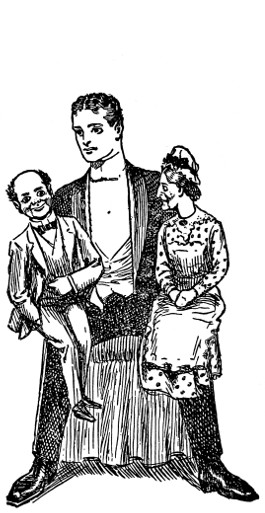
Fig. 2.—Working with two figures.
The one essential about the ventriloquial figure is that it shall have a moving mouth. In reality the chin is cut away from the face, and the movable portion working on a pivot or string, gives the same effect as when a person is speaking.
There are many different forms of ventriloquial figures, some of which are shown on this page (Figs. 1 and 2), but for the amateur the kind which possesses only a moving mouth is quite suitable.
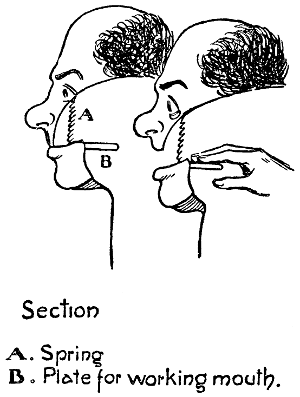
Fig. 3.—Showing construction of ventriloquial head.
By means of a little ingenuity and the expenditure of a few cents a movable tuft of hair may be added to the wig, but as the working of this is liable at first somewhat to hamper the manipulation of the automaton, it should perhaps be left until proficiency is more assured.[149] The hole in the back of the head or body permits of the hand of the performer pressing either upon a plate or upon a circle of wire, which in turn moves down the movable mouth, closing automatically by means of a spring. Figs. 3, 4 and 5 respectively show the construction of ventriloquial figure heads and another principle of ventriloquial figure manipulation.
The number of mouth movements made by the figure should, of course, coincide as nearly as possible with the number made by the mouth in ordinary speech; thus a natural effect will be gained.
Placing a “dummy” on each knee, the ventriloquist opens up an amusing conversation. The aim of the figures is to destroy the effect of the performer’s remarks by the interpolation of absurd interruptions. The whole matter resolves itself into a witty dialogue between three or four people, of whom the entertainer is the central character. Such a dialogue should be brisk and sparkling with humor, all vulgarity being carefully eliminated. It is as well to write the dialogue out and learn it by heart.
Always adhere to a prearranged order of ventriloquial figures. If you commence your entertaining career with the old man on the right knee and the old woman on the left, keep to that arrangement all along. A change will inevitably result in putting the wrong voice into the wrong mouth, and the result will be disastrous.
Bear in mind that all the while the endeavors of the figures are to make you appear ridiculous in the eyes of the audience, and they should turn all your sensible remarks into nonsensical ones, so that the laugh is always against yourself. Of course the audience will join in the laugh against you, and it is the taking of this in the proper spirit that will signalize your success as a ventriloquist.
When putting words into the mouth of an automaton, its face should be turned towards you; inversely, whilst you yourself are talking the automaton should be engaged in looking curiously about[150] him at the audience, as if taking not the slightest interest in your remarks. Suddenly, however, he will snatch the opportunity of scoring off you, to the great enjoyment of his partner, the old woman.

| A. | Pull | Fig. 4.—Construction of laughing darky’s head. |
| B. | Spring | |
| C. | Pin |
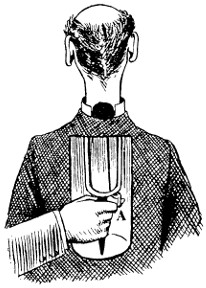
Fig. 5.—Principle of ventriloquial figure manipulation.
Immediately you have finished speaking in your natural voice, keep your lips absolutely fixed during the time the figure is supposed to be talking.
It is not proposed here to give specimens of ventriloquial dialogue, because the humor of these depends so much upon the natural ability of the performer in presenting the joke or funny story.
Undoubtedly the best plan is to form a cutting-book out of the tit-bits extracted from the humorous periodicals of the day, and to paste them in. In this way a voluminous collection of anecdotes, tales, and riddles will be made, and by a judicious combination and selection of these, enough material can be speedily gained to last months without fear of repetition.
The most entertaining form of presenting riddles is for the “old man” or “little boy,” whichever is being used, to propound them, and the entertainer to give some practical answer to them. The real point of the joke should be brought out by the “lay” figure, to the accompaniment of considerable mirth.
Home-made automata are not recommended, because the cost of purchasing really serviceable “dummies” is so small as not to make it worth while spending a deal of time and trouble, to say nothing of money, on their construction. Moreover, the great point about the “lay figure” is that it should possess a funny face, and such expressions are rather difficult for an amateur to obtain.
[151]
Many entertainment emporiums deal largely in ventriloquian outfits, and reliable “dolls” ought to be procured fully dressed for about $5 each.
When a child speaks he almost invariably does so in a high-pitched tone, more or less directing the sound through his nose. This being so, the “theek” voice is the one most suitable for him. The similarity between it and the speech used for the “old woman” may be avoided by speaking in a somewhat lower tone, and in a simpler and more disjointed fashion.
Suppose, for instance, that you ask the little boy a question? Get him to repeat that question after you, and give the answer in short, jerky, broken sentences.
For the “little girl” use a slightly higher tone, without directing the sound through the nose. In her case also the mode of expression must be childish, but with slightly more refinement.
The voice for the “longshoreman” and the “darky” are both of the “grunt” order. For the former, the “old man” voice is used, with the addition of the peculiar “tough” twang; whilst for the latter, employ speech of a much lower and more resonant tone.
Place the chords as when using the “grunt” voice, breathing rather heavily, and force the sound as far back in the throat as possible, at the same time contracting the muscles of the stomach while the breath is being expelled.
The word “yah! yah!” is a very good one upon which to practice, and the vowel sound should be sustained to some length.
By this time the young ventriloquist should have attained sufficient proficiency in the art of manipulating “knee” figures to feel confident of venturing on the far more difficult and relatively more important “distant” voices.
The real test of ventriloquial power is when the performer is capable of making sounds appear to come from a distance, i.e. so modify his utterances that they appear to the audience to proceed from some point remote both from the entertainer and from themselves.
The basis of real ventriloquism, as apart from polyphony, i.e. “near” effects, is known as the “bee drone,” because the first sound of which the vocal chords are capable when placed in the required position much resembles the droning of a bee in full flight.
The “bee drone” should be practiced in loosely fitting clothing,[152] so that neither the muscles of the throat nor of the chest are unduly hampered.
From a natural, upright position, inhale in a short, jerky manner, making what is best described as a retching noise at the back of the throat. Unpleasant as the practice of this undoubtedly is for the first few minutes, after a short while the noise emitted will settle down to a softly sustained hum. The tongue should lie flat, so that the sound waves produced partly in the larynx and partly in the back of the throat are forced upwards by the action of the abdominal muscles and directed towards the roof of the mouth, the latter acting somewhat as a sounding board—modifying the sound and conveying to the ears of a listener some distance away a “distant” effect.
The continuous practice of the word “ah,” with the vocal chords in the position just described, will speedily produce the necessary droning quality.
It remains now only by a contraction of the throat to regulate the quality of the tone and the distance from which you wish it to appear to come.
From this point progress will be found rapid and satisfactory. The various modifications of the bee drone produce respectively,
1. The “roof” voice.
2. The “level” voice.
3. The “floor” voice.
The “roof” voice is extremely useful for illusions of all kinds, and perhaps is the easiest of the three to acquire. Its purpose is to make sound appear to come from any point above the audience, and the entertainer practices it at first by standing erect, taking in a deep breath, and then drawing backwards and downwards the lower jaw, holding it by muscular contraction in that position. With the lips about an inch apart say your words, whatever they may be, just as you would the “ah!” of the bee drone, concentrating your mind on the effort of directing the sound waves towards the roof of the mouth. In this case, however, exhalation should take place very slowly, while the speech is uttered with unusual clearness.
The effect of the illusion, however, is destroyed if whilst using the “roof” voice you look either straight before you or down to the ground.
The ventriloquist must bear in mind that it is important to deceive the audience, just as a conjurer does, but the former has this advantage over his magic brother, that the deception is both optical and oral.
Let him, therefore, when “throwing his voice” to the roof, glance[153] sharply upwards as soon as the words are uttered, and turn his head in a listening attitude; his example will be followed immediately by the audience, who naturally fall into the trap prepared for them, and, for the time being, are quite satisfied that the sounds do really come from the roof.
This is an advantage on which the ventriloquist can trade to an enormous extent, because the ear is so easily deceived. How difficult it is, when listening from within a closed room to a street organ playing outside, to tell whether the music comes from up or down the road. So with ventriloquism—the performer has but to modify the position of the vocal chords as indicated, and to fix his eyes upon the roof, when lo and behold! everybody is perfectly satisfied that the speech does come from above.
Of the three “distant” voices, the “level” is, perhaps, the most useful and the most generally successful, because the mere fact of the entertainer being on the same plane as the door and the windows, from behind which people are supposed to converse with him, provides him with opportunities for using the facial muscles and for distorting sounds, and so heightening the illusion.
For instance, whereas he must turn full or three-quarter face when using the “roof” voice, he can carry on a dialogue on the “level,” sideways to the audience; or in the case where the stage possesses a door at the rear, he may often be permitted for a moment to turn his back.
Practice as before in the “bee drone” voice, without endeavoring to any great extent to shut off the sound in the throat. This may be done by curling up the tongue so that its tip presses against the back of the upper teeth.
If you are practicing by the side of the door, as you open it towards you the ventriloquially uttered sounds must be raised in tone and made more distinct by lifting the shutter from the throat, or, in other words, by allowing the tongue to resume its normal position, and the sounds to issue forth on the principle of the “bee drone.”
This voice is extremely useful for such illusions as “the man in the cellar attending to the gas meter,” &c. It calls particularly for a display of histrionic powers, and the mere fact of bending down, as the sounds appear to come from below, helps to give it the necessary subdued and “distant” effect. Whilst speaking very slowly in the “bee drone”[154] thrust the chin forward, contracting the larynx as much as you possibly can; roll back the tongue to stifle the sound in the throat, and the illusion will be complete. Immediately you change from the “floor” to the natural voice, resume the standing position and speak with unusual distinctness. The contrast cannot fail to escape the notice of the audience, who will be quite convinced that you have indeed carried on a conversation with some one below.
Although imitations can hardly be classed under the heading of pure ventriloquism, yet they may be pressed into the service of the entertainer to promote variety in his performance. They serve, too, another very useful purpose, inasmuch as they provide a relief from what must inevitably prove a strain on the vocal chords. As has already been said, ventriloquism necessitates the placing of the vocal chords in a somewhat unnatural position, and the result is that the exponent, particularly in the early stages of the work, is apt speedily to become tired.
As a break between an exhibition of “near” ventriloquism—that is, with the automata—and an exposition of distant effects, one or two vocal or instrumental imitations will prove welcome both to the entertainer and the entertained.
A witty person once remarked that the secret of success lies not so much in what you can do, as in what you can induce other people to think you can do. In other words, a little knowledge in the hands of a ready-witted and competent ventriloquist can be turned to great advantage and become a valuable asset in his undertakings. For successful imitations, self-confidence is perhaps of even greater importance than the possession of real ventriloquial powers. Self-confidence is a trump card that the ventriloquist should always hold in his hand, because it will take all the tricks. Success is impossible without it, and easy with it!
Perhaps there are few branches of entertaining in which self-assurance is so necessary as in ventriloquial mimicry. The border-line between a successful imitation and a ludicrous failure is oft-times so narrow, that a sensitive soul would soon be disheartened.
The only difference between the efforts of the ordinary and the ventriloquial mimic is that the latter, when giving expression to sounds vocally produced, should place the chords in the same position as for the “bee drone” and the “distant” voice.
A very good study is that of a hen as she cackles immediately before laying an egg, and again after having done so. You will notice[155] that the first sounds are mostly of a guttural nature, and they should come from well back in the throat, starting moderately high and descending four or five notes. Of course the lips will have to be kept slightly opened, and for the final jubilant crow considerably extended. To avoid the necessary facial movement, it is as well when uttering the “crow” to turn sideways to the audience. Again, while the first note of the cackling should be loud, the successive notes grow quieter.
An imitation of a dog fight will form a spirited item in your programme. By your actions you may suggest, for instance, a small cur yapping vigorously until a larger and more ferocious animal endeavors to quiet him.
To produce the higher notes of the dog-bark, the falsetto or “thick” voice must be used, while the deeper guttural tones already explained for use with the “darky” serve for the larger dog.
It is a little difficult to intersperse the two sets of sounds without expressing facial contortion, but you may obtain for yourself a certain amount of license by pretending that the dog fight is taking place beneath a covered table, behind which you may stoop in your supposed endeavors to stop the tumult.
It is but natural to turn from dogs to cats. Whereas you have just given an imitation, perhaps, of a fierce duel, your next effort should endeavor to portray a feline courtship. This should be made as funny as possible. The lady’s “marr-rr-ows” and “mia-a-a-ows” are easily copied after you have been kept awake a night or two listening to the genuine article, whilst the deeper tones of Mr. Tom are included in the repertory of every well-educated schoolboy.
The mouth should be kept fairly wide open and a kind of sideways motion given to it, whilst the cry should be drawled until the lips form for the final “ow.” The spittings and growlings necessitate the bringing together of the lips and teeth, a freedom which your audience on this occasion must permit you. The doleful moans with which our feline friends endeavor to solace one another can be produced by making the mouth very hollow, the lips into the form of a large O, slowly contracted to a very small one.
For the die-away, distant effect, moaning more or less in the throat must be resorted to. The finale can consist of a number of fierce spittings and growlings, suddenly interrupted by an unmistakably human voice (your own) “shoo-ing” the night visitants away.
A variation can be made by giving an imitation of pouring out a glass of wine. To produce the illusion of drawing the cork from the[156] bottle, turn slightly round, thrust the forefinger into the mouth against the cheek, close the lips around the finger, slowly bring the end of the finger round inside the cheek, and force it smartly out through the lips. The result will be a loud pop. By moving the tongue from the back of the mouth quickly backwards and forwards, making it strike against the inside of the gums, the “glug, glug” of the wine being poured out will be plainly heard.
Under the cover of a screen, the roaring of a lion is simple of accomplishment. Use an ordinary lamp chimney, and give vent to a series of deep-throated roars from this. The effect will both be natural and startling. With the same instrument the deep lowing of a cow can be perfectly imitated, the lips producing the familiar “moo,” the sound being gradually drawled through the glass chimney.
To copy a saw at work is quite easy. Get a ruler, or some similar article, to represent the saw, and draw it backwards and forwards as though cutting a piece of wood. The sound is best made by clenching the teeth, placing the tongue a little forward between the upper and lower teeth, quickly inhaling and exhaling the air. The resultant noise will be an exact imitation of the saw cutting its way through the wood.
Quite an effective item is the ascent of a rocket. By blowing hard through pursed lips, and striking the mouth rapidly with sharp little blows with closed fingers, the curious sound of an ascending rocket may be reproduced with perfect fidelity. This slowly fades away, there is a moment’s pause, and then the final pop as the stars burst. Naturally such an imitation should be performed in the shelter of the screen. As a last example, an imitation of the itinerant knife-grinder may be attempted. Keep the lips and the teeth closed to produce the rasping up and down of the steel upon the grindstone, the while working an imaginary treadle with the right foot.
By this time the young ventriloquist should have at his command both “near” and “distant” voices and imitations. It only remains to say a few words regarding the manner of giving an entertainment.
Although smart dialogue is very entertaining, it is apt, after a little while, to pall; and to obviate this it will be found well to introduce an occasional song or comic recitation. In both cases these may take the form of parodies, but in the former a serious song really well sung by the ventriloquial figure will evoke both admiration and applause.
[157]
Those not possessed of particularly good vocal qualifications may feel that the singing of a song successfully is beyond their capabilities. They should, however, bear in mind that nothing like “finish” or cleverness in execution is expected from a wooden figure. One or two verses and the chorus are quite enough to venture upon, as singing ventriloquially is extremely tiring.
The best time to introduce a song is when dialogue between yourself and the automata has been in progress for seven or eight minutes. Either the little boy or the old man or the old woman can essay to try his or her skill as a vocalist, or the affair may be competitive. Much amusement may be caused by the little boy extolling his own skill as a vocalist, and the darky challenging him. To settle the matter, let one sing the first verse of a song and the other the second, the little boy making a terrible hash of his part of the performance. If his mistakes are greeted with groans of derision from the old man, or cries of horror from the old woman, the audience will be immensely pleased.
While the song is in progress, the ventriloquist should look about him unconcernedly, feigning total disinterestedness in the affair. Towards the end of the song he may glance sharply once or twice at the singer and applaud him for his effort, which applause it is to be hoped the audience will generously supplement.
It is not intended that these few observations on the art of ventriloquism should be taken as covering all the ground over which this fascinating subject spreads. Enough has been said, however, to show any one who is sufficiently interested how to give a really pleasing drawing-room performance which shall earn for him the reputation of being quite a creditable exponent of the wondrous and mystifying art of Valentine Vox.
[158]
It is said that at some period of his life every boy becomes stage-struck, and it may be averred with equal truth that sooner or later every boy is seized with a desire to become a conjurer.
Considering the fascination to old and young alike of a conjuring entertainment, this is not to be wondered at. But when the would-be conjurer begins to realize the years and years of practice necessary before he can accomplish his desire, he soon despairs; and instead of proudly mounting the platform as an entertainer, he finally satisfies himself by humbly occupying a chair as one of the entertained.
It is the purpose of this chapter, however, to set forth a complete conjuring entertainment in such a manner that anybody can easily learn and perform it, in precisely the same manner as they would memorize and deliver a recitation.
Before proceeding with the tricks themselves, it will perhaps be advisable, for the sake of the uninitiated, briefly to describe how to fit up a handy conjuring table.
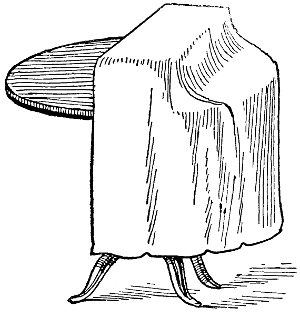
Fig. 1.—A handy conjuring table.
Procure a small wooden box about six inches deep and one foot in length and width, and stand it in the center of a small gypsy-table. Then artistically drape one or two flags, or a brightly-colored cloth over it (Fig. 1).
It will be noticed that a portion of the table at the back of the box is left vacant. This, in the dialect of the profession, is known as the servante. It is used for secretly disposing of objects during the performance.
[159]
The magic wand simply consists of a decorated circular stick about ten inches long.
Each trick will be dealt with in three separate parts. The first will describe the illusion from the point of view of the audience; the second will explain the apparatus required; and the third the “patter” accompanying each trick.
Presentation.—As seen by the audience, the first trick is as follows:
Two ping-pong balls are lying upon the table, and the conjurer requests a member of the audience to choose one. This having been done, the performer picks up the selected ball and commences gently rubbing it in the palms of his hands, when to the amazement of the audience, the ball is seen to change into a couple of handkerchiefs!
The conjurer places one of these upon the table, and proceeds to wrap up the other in a piece of pink paper. Blowing out a candle which has been standing in a candlestick upon the table, the performer wraps that also into a similar parcel, using white paper instead of pink.
He next places the two parcels at opposite ends of the table, in full view of the audience. After making one or two passes with the magic wand, the conjurer picks up the parcel containing the candle. He then tears it open, when it is found to contain the handkerchief. Upon the remaining parcel being examined the candle is discovered within it.
Apparatus required.—(1) Two ping-pong balls. A large hole must be bored in one by means of a penknife.
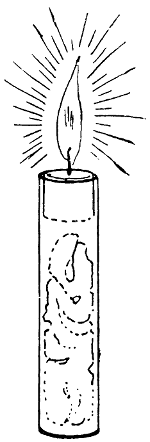
Fig. 2.—False candle containing handkerchief.
(2) Three small silk handkerchiefs. Two of these should be stuffed into the prepared ball through the hole. Both balls must then be placed upon the conjuring table—the hole in the prepared one being turned away from the audience.
(3) An ordinary candle wrapped in a piece of pink paper, and concealed in readiness on the servante. Another piece of pink paper and a piece of white should also be ready at hand.
(4) A “false” candle. This is made by gumming a piece of white paper into the form of a cylinder, and sticking a slice from a real candle in one end. The third handkerchief must be stuffed into the “false” candle (Fig. 2), which should then be placed in a candlestick. From a short distance it will be impossible to distinguish this candle from the genuine article, and the effect will be considerably heightened by the candle-end being lit.
Patter.—The conjurer comes forward to the front of the platform and delivers himself somewhat after the following:—
“Ladies and gentlemen—you will observe upon my table two[160] ping-pong or table-tennis balls. They are quite innocent-looking, and although in appearance they somewhat resemble eggs, will not be found half so deceptive. Will some lady or gentleman kindly select one?”
If the ball containing the handkerchief is selected the conjurer picks it up and proceeds with the trick. Should the other be chosen, however, it makes no difference. The entertainer simply hands it to the person who has made the selection, and remarks: “Very well. Would you mind taking the ball you have chosen and examining it?” Upon the person complying with his request, the conjurer picks up the remaining ball—the prepared one—and continues with the trick.
“Ladies and gentlemen,” he says, slowly rubbing the ball between the palms of his hands, and carefully extracting the first handkerchief from its interior (a simple effort in sleight-of-hand, quickly acquired), “we will now see what effect a little friction has. Ah! Something is happening already!”
The performer allows the second handkerchief to stream forth, and then gradually opens his hands, taking care that one of the handkerchiefs completely covers the ball and hides it from view. He then lays the handkerchief sheltering the ball carelessly upon the table. If this is done in a natural manner, the audience will not have the slightest suspicion that it covers anything at all. Holding the remaining handkerchief up to view, he continues:
“We will now see whether this inherits any of the marvelous properties of the ball from which it was produced. I have here a piece of paper.” (Holds up the red paper.) “It contains neither trap-doors, hidden mirrors, nor other mechanical contrivances. The reason for my using pink paper is that it insures the trick being performed to the pink of perfection. I will now proceed to roll up the handkerchief in the paper.”
This is done, the performer taking care to make the parcel exactly similar in shape to that of the candle on the servante. During the wrapping-up process, however, he carelessly drops the parcel on the servante. With a muttered excuse for his clumsiness, the conjurer again resorts to quickness of the hand, and picks up the parcel containing the candle. The very audacity of this movement will effectually keep the audience from suspecting that a substitution has been effected.
“I will now take this candle and wrap it in the piece of white[161] paper I have here. By the way, can any one tell me what nobleman could very well be represented by a burnt-out candle? No one? Why, the Earl of Wicklow!” (He blows out the “false” candle and wraps it in the white paper.)
“You see I have now two parcels—the pink one containing the handkerchief, the white one containing the candle. I will place them at opposite ends of the table, and make a few passes with my magic wand.”
The performer waves the wand a few times. Then, seizing the packet containing the “false” candle, he rips it open, thus tearing the paper cylinder, and revealing the handkerchief. The small wax candle-end will escape observation amongst the torn paper, and the audience will be under the impression that the candle has changed to a handkerchief.
“Will a gentleman kindly step forward and examine the remaining parcel?” (Upon the examination being made it is found, of course, to contain the candle.) “What! The handkerchief and candle appear to have disagreed with the quarters I originally allotted them, and have changed places! I think you will agree with me that this little experiment has terminated in a very interesting manner. I think you will also agree that I have not once attempted to deceive you, as the whole of the experiment was conducted before your very eyes.”
The second trick might very aptly be entitled
Presentation.—The conjurer hands round for inspection a small sheet of white paper. Upon its being returned, he rolls it into a cylinder. Taking a couple of red silk handkerchiefs from the table, he proceeds to poke them into the tube by means of the magic wand. He continues to force them down until they at length make their appearance at the other end. During this short passage through the tube, however, an astonishing transformation has ensued. Instead of the handkerchiefs being red, one emerges a deep blue and the other yellow! Yet upon the roll of paper being passed round for inspection it is found to be perfectly empty.

Fig. 3.—Cardboard tube with silk bag and handkerchief attached.
Apparatus required.—(1) Two red, one blue, and a yellow silk handkerchief.
(2) A sheet of stout white paper about six inches long by five wide.
(3) A small cardboard tube about three inches long and an inch and a half in diameter. A section cut from an ordinary postal tube will do admirably.
[162]
A small bag of yellow silk must be sewn by its edges to the interior of this tube (Fig. 3). The yellow handkerchief should next be stitched by its center to the bag, as is shown in the same diagram. This done, both the yellow and blue handkerchiefs must be forced into the cardboard tube until they are completely hidden. There will be no difficulty in doing this, as silk can be made to occupy a very small space. The bag, of course, will prevent the handkerchiefs coming out at the other end.
The cardboard tube and its contents should then be placed upon the table, and the two red handkerchiefs laid carelessly over it in order to obscure it from the view of the audience.
Patter.—“I have here an ordinary sheet of white paper. I intend, however, to turn it to a rather extraordinary purpose; in fact, to manufacture with it a dye-works!
“I first roll the paper into a cylinder—so. Please notice that I do not attempt to insert anything as I do so.”
The performer rolls up the paper, taking care to make it sufficiently large to admit the little cardboard tube.
“I have also two red silk handkerchiefs. Every lady present to-night will know how very difficult it is to dye anything that is red. Nevertheless, I am going to put these handkerchiefs down my dye-works’ chimney.”
He picks up the handkerchiefs—with the tube still hidden in them—and apparently attempts to poke them into the cylinder. In reality, however, he only inserts the cardboard tube, and then pauses, as though in doubt.
“Well, ladies and gentlemen, it appears as if I haven’t built my dye-works large enough to receive both handkerchiefs together. I think it will be advisable, therefore, to insert them singly.”
The conjurer proceeds to place first one and then the other handkerchief in the tube. Then, taking up his magic wand he rams them well down. This has the effect of forcing them both into the small cardboard tube, thus liberating the blue and yellow handkerchiefs.
“Ah! I see that one of the handkerchiefs is issuing from the basement of our dye-works. And the color has been altered during its journey! Here comes the other straight from the mangle, and, as you will observe, it is now dyed yellow. The dye-works[163] has proved most successful. In fact, I believe that if I’d inserted a third handkerchief it would have come out folded and ironed!”
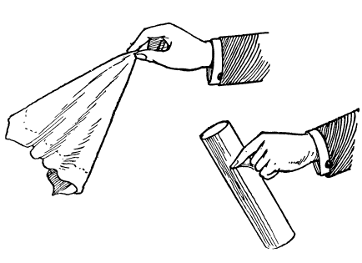
Fig. 4.—Handkerchief covering small cardboard tube drawn from cylinder.
So saying, the conjurer takes the yellow handkerchief by its middle and draws it from the paper cylinder. The cardboard tube, with the red handkerchiefs safely in it, will, of course, be drawn out at the same time. The folds of the yellow handkerchief, however, will completely hide it (Fig. 4). The conjurer then throws the paper cylinder amongst the audience, with the remark—
“There you are, ladies and gentlemen. As I am of a philanthropic nature, I will let you have my dye-works free of charge, with full permission to make whatever use you like of them.”
The third trick may be called
Presentation.—The conjurer, standing a glass of water upon his table, borrows a quarter, and places it in the center of a loaned handkerchief. He then requests a member of the audience to hold it over the glass so that the folds of the handkerchief hang around it and completely hide it from view (Fig. 5).
The performer next asks the person holding the coin to let it drop into the water. He does so, and the audience hear it tinkle as it strikes the bottom of the glass. But when the handkerchief is removed, the quarter has disappeared!
[164]
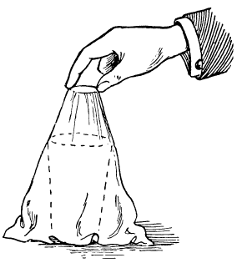
Fig. 5.—The dissolving coin.
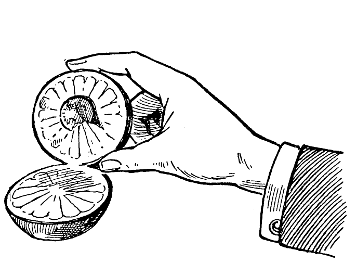
Fig. 6.—Quarter found inside the orange.
A dish containing a number of oranges is standing upon the table. The conjurer picks up a knife and plunges it into one. Passing it to a member of the audience, he requests him to cut it open. Upon this being done the quarter is discovered embedded in the center of the fruit (Fig. 6).
Apparatus required.—(1) A glass of water. (2) A silver quarter. (3) A watch-glass the size of a quarter. One can be purchased for five cents from any watch repairer’s. (4) A dish of oranges. A small cut must be made in one of them, and the quarter forced into the incision. The prepared orange should then be replaced upon the dish, care being taken that its position is remembered.
Patter.—“It is always a conjurer’s duty, during some part of his entertainment, to borrow. The time is now ripe for me to perform that pleasant duty. Will some one kindly supply me with a quarter and a handkerchief?”
As the performer walks amongst the audience to obtain the handkerchief, he secretly takes the watch-glass from his waistcoat pocket—where it has been placed in readiness. As he returns to his table with the handkerchief and the coin, and whilst his back is to the audience, he must again resort to sleight-of-hand and substitute his watch-glass for the coin, which can either be slipped into his waistcoat pocket, or dropped surreptitiously on to the servante. The performer then faces the audience, holding up the watch-glass instead of the coin in the center of the handkerchief.
“I have placed the quarter in the handkerchief, and should now like the assistance of a young gentleman.
“Thank you, sir. Would you mind holding this coin over the glass and let it fall into the water when I count three? Thank you! One—two—three! You’re sure you dropped it? Well, will you please remove the handkerchief, thus taking the quarter from the water.” (The watch-glass, being transparent, will be invisible at the bottom of the glass, and the assistant will immediately declare that the coin has vanished.)
“It’s gone, you say? That’s rather awkward for the gentleman from whom I borrowed it. But perhaps you’d like to pay him back yourself? You strongly object? Well, I must see what I can do!”
[165]
The conjurer walks over to the dish of oranges.
“In order to see how this trick is done, ladies and gentlemen, you must keep one eye upon me, one eye upon that dish of oranges, and the other upon the gentleman who is assisting me. What’s that? You haven’t three eyes? I think you are mistaken. First there’s your right eye; then there’s your left eye; and your nect(eye)ie makes the third.”
The performer then plunges a knife into the prepared orange and hands it to his assistant.
“Would you mind cutting that in half?” (Upon doing so the young gentleman will, of course, find the coin embedded in the fruit.) “You have found the missing coin in its center? I consider it rather clever of me to purchase for a few cents oranges that grow quarters. Would you mind returning the coin to its owner; and I must thank you for the very able assistance you have afforded me.”
The next trick may be called
Presentation.—The conjurer borrows a watch from a member of the audience and wraps it in a piece of paper. He next places it in the muzzle of a pistol, and then stands a target upon the table. Handing the pistol to a gentleman in the audience, the performer requests him to fire at the target. There is a loud report, and—hey, presto!—the watch is found swinging in the center of the target! And upon the paper parcel which contained the watch being removed from the pistol’s muzzle it is found to be perfectly empty.
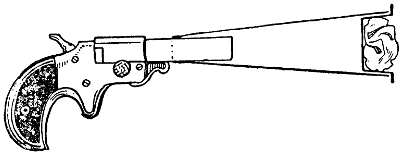
Fig. 7.—Conjuring pistol, showing flanged cap.
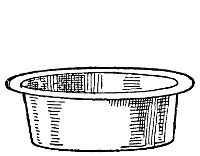
Fig. 8.—Cup or pan to fit into muzzle of pistol.
Apparatus required.—(1) A piece of paper in which to wrap the borrowed watch; and a second piece of the same size and color. This must be folded to create the impression that it contains a watch.
(2) An ordinary toy pistol. This must be taken to a tinsmith, in order to have a tin muzzle of the shape shown in Fig. 7 soldered to the barrel. It will also be necessary for the tinsmith to make another[166] very important addition to the pistol. It consists of the little pan illustrated in Fig. 8. This pan fits into the muzzle. But in order that it may not sink down too far, and can be removed easily, a flange must be made round the edge, as shown in Figs. 7 and 8. Before commencing the trick, the piece of paper folded into the shape of a watch must be placed inside the muzzle, and the tin pan fitted into position on top of it.
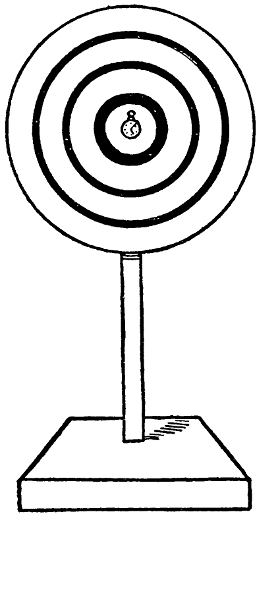
Fig. 9.—Showing front of target.
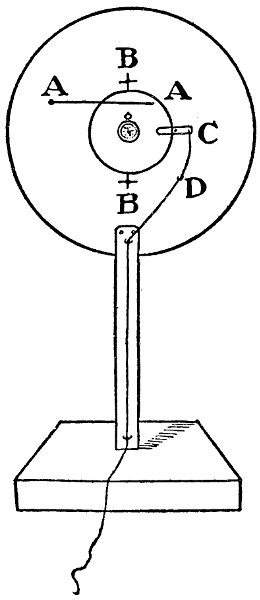
Fig. 10.—Back of target with revolving center.
(3) A target (Fig. 9). This target, as might be anticipated, is not so simple as it looks. The “bull’s-eye” at the center must be cut completely out with a fretsaw, and then replaced again on the two pivots (B B, Fig. 10). A small wooden clip should next be fixed in the position illustrated by C, and a piece of elastic fastened to the “bull’s-eye” at A, and stretched to the other side of the target.
It will now be observed that the tendency of the elastic is to make the “bull’s-eye” revolve upon its pivots. The wooden catch C, however, prevents this happening.
The catch is secured to the target by a single nail or screw, in precisely the same manner as the “button” is fixed to an ordinary cupboard door. A piece of black thread must be fastened to one end of the catch, and carried down behind the target through a series of hooks made from bent pins (D, Fig. 10).
A pull at the thread thus causes the wooden catch to release the “bull’s-eye,” which will instantly be forced round upon its pivots by the elastic, and show the other side:—which must be similarly painted with rings—to the audience. To complete the target, drive a small hook into the center of the “bull’s-eye.” The finished article must then be placed behind a screen in readiness for the performance.
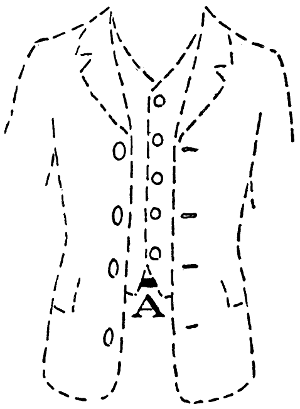
Fig. 11.—The elastic at A will be found invaluable to the young conjurer.
(4) Lastly, a small piece of black elastic should be sewn across the V-shaped opening at the bottom of the conjurer’s waistcoat, as shown in Fig. 11. This keeps the bottom of the waistcoat perfectly[167] tight, thus making a handy receptacle for any article the performer may poke up it out of sight.
Patter.—“Ladies and gentlemen—I was so successful in borrowing for my last trick, that I am encouraged to be a little less timid in my requests. Will some gentleman kindly lend me his watch? Thank you, sir! I may muddle up the wheels a bit during my experiment; but I suppose you don’t mind that, provided the watch looks all right when I return it? Now, sir, would you mind wrapping your watch up in this piece of paper?”
Whilst the lender of the watch is engaged in wrapping up his property, the conjurer walks to the table and returns with the pistol in his hand. He then takes the parcel from the gentleman, and apparently places it in the muzzle. In reality, however, it is put only into the small pan.
The performer turns round, and walks towards his table. Holding the pistol well into the body so that it is completely screened from the audience, he quickly places his right hand over the muzzle, and grips the flange with his thumb and little finger. It is then only the work of a moment to lift the pan and its contents from the pistol, and poke it under his waistcoat. As the performer’s back is to the audience, these rapid movements escape observation.
Upon reaching the table the conjurer lays down the pistol, faces the audience, and says:
“Well, now that I’ve got my ammunition, I suppose I’d better get a target.”
He retires behind the screen sheltering the target. Hastily taking the pan from his waistcoat, he tears the watch from the paper, and hangs it upon the hook on the reverse side of the “bull’s-eye.” Then, returning to the platform, he places the target upon the table, and taking up the pistol, says:
“Will the gentleman who lent me the watch kindly take this pistol and fire at the target when I count three?” (Upon taking the pistol the gentleman will see the second piece of paper in the muzzle, and imagine that it contains the watch.) “Are you ready? One!—I hope[168] you are a good shot. Two!—Mind you don’t hit me instead of the target. THREE!”
As he utters the last word the conjurer pulls the thread, and simultaneous with the report of the pistol, the “bull’s-eye” flashes round and reveals the watch hanging to its center.
Of course the thread must be sufficiently long to permit the performer to stand a short distance from the target. Against a dark background the thread will be quite invisible to the audience.
Upon the second parcel being examined it will, of course, be found quite empty.
[169]

Fig. 1.—Handkerchief twisted for the performance.
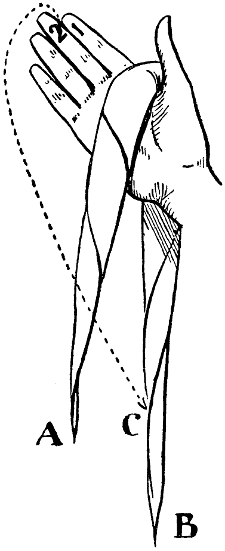
Fig. 2.—The one hand knot.
The following explanations are intended to provide the beginner with the knowledge necessary to perform a few of the simple but neat tricks which can be done with no other apparatus than a handkerchief. For a short turn or “gag” these tricks are effective and useful, whilst their very simplicity renders a quick return for the little trouble required to learn them.
A good-sized silk handkerchief must be procured. Before making any of the knots it should be twisted like a rope (Fig. 1). Being of silk, the handkerchief will not untwine easily.
This knot is very simple to make. Hold the handkerchief, bent double, across the right hand (Fig. 2). Now, suddenly drop the hand, letting the fingers pass over the end, A, and catch the end, B, at the point, C, between the first and second fingers. Let the remainder of the handkerchief slip off the hand, giving it a sharp flick, which will tighten the knot already loosely formed.
Practice constantly until the whole movement can be done very rapidly. To the spectators it will appear as if you have suddenly flicked the handkerchief into a knot, and the effect will be striking.
Stretch the handkerchief between the finger and thumb in both hands, as in Fig. 3. Cast a loop towards the left hand, taking care[170] that it is thrown outwards. As the loop is made, the left hand, still with the end of the handkerchief between finger and thumb, is passed smartly through the loop from the outside—shown by the dotted lines in the illustration.
This loop is now loosely round the left wrist, and the knot can be made taut by pulling the ends with both hands. The instant it is drawn tight let go of the ends of the handkerchief, and the result will be that a simple twitch of the right hand has seemed to tie a knot firmly round your left wrist.
This very pretty trick can be accomplished by making a double bow with a rapid turn of the hands.
Hold the twisted handkerchief in both hands, as shown by Fig. 4. The two hands are marked L and R—i.e., left and right respectively. Now bring the right hand round and past the left, as indicated by the dotted lines, and nip the handkerchief at the point A with the first and second fingers of the right hand.
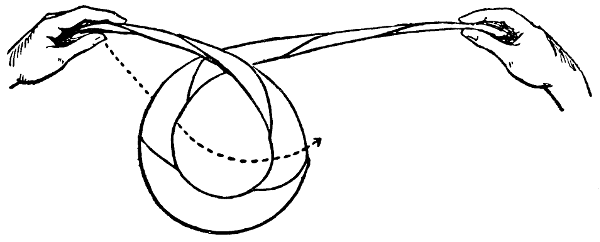
Fig. 3.—The wrist knot.

Fig. 4.—The double bow.
[171]
By doing this you have naturally brought the point B opposite the first and second fingers of the left hand, between which it should be similarly nipped. During all these movements the remaining fingers and thumbs of each hand should retain their original hold on the handkerchief.
Having now taken hold of both the points A and B, straighten your hands and pull apart, still retaining the hold of the first and second fingers. As a result you will find the handkerchief tied in a double bow, which, if the movements have been done quickly and well, will seem to have been accomplished by some strange effect of magic.
These knots can be made at each end of the handkerchief by the following method. Hold the handkerchief in the position shown in Fig. 5, where it appears lying over the third and fourth fingers with the two ends, A and B, hanging beyond the thumbs. The movements are done in the same way and simultaneously with both hands, and it will therefore suffice to describe the action of your right hand.
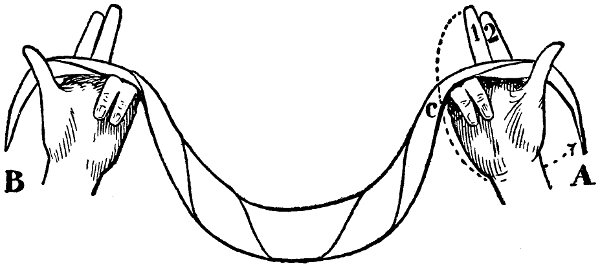
Fig. 5.—Instantaneous knots.
Bring the first and second fingers (1 and 2, Fig. 5) over C, catching hold of the end, A, behind the wrist. This will be easy after a few attempts, but you must be careful to see that the end A is of fair length, otherwise the trick will be impossible.
Now bring the end A up through the resulting loop by means of the two fingers. The consequence will be a knot in the end of the handkerchief. Your left hand has, meanwhile, been doing the same thing and with equal rapidity, so that it will appear to the spectators that, by a sudden flash of the hands, you have formed two tight knots, one at each end of the silk.
[172]
Hold the handkerchief stretched between your two hands in the manner shown in Fig. 6—that is, inside the first and second, and outside the third and fourth fingers of each hand.

Fig. 6.—A flick knot.
Give the left hand a half turn, as in Fig. 7, thus enabling the first and second fingers of the right hand to grip the end A, whilst at the same moment the thumb and third finger of your left hand catch hold of the end B.
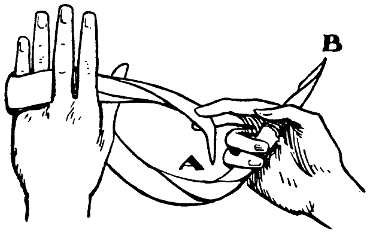
Fig. 7.—Second stage of the flick knot.
Slip free the fingers of the left hand, excepting those holding the handkerchief, and you will find a loosely made knot. A smart flick of the right hand will now complete the trick, and if you have done all this very rapidly none of the movements will have been noticed by the audience.
The foregoing remarks have dealt entirely with making knots in the handkerchief. By following the instructions now given you will be able to make a knot disappear entirely.
[173]
Take two differently colored handkerchiefs—red and white, for instance, and cross them, as in Fig. 8. Now make a simple knot similar to that shown in Fig. 9. By laying D over C and making another simple knot, as in Fig. 10, the red end will appear on the left, whilst the white end will be on the right. This is called a Grannie’s knot.
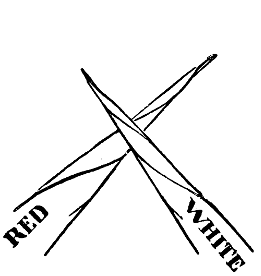
Fig. 8.—Colored silks for disappearing knot.
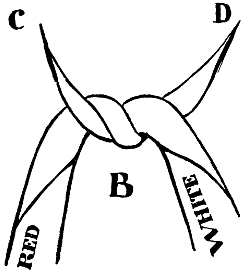
Fig. 9.—Simple knot for disappearance.
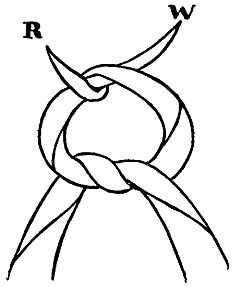
Fig. 10.—Grannie’s knot.
It is now plain that if you take hold of each end of the red handkerchief it can be pulled quite straight and entirely free of the turns so closely resembling a genuine knot. Heighten the deception, however, by seizing the end D and the bulk of the red handkerchief and pulling them with all your strength. The knot will now appear to have been tied most securely.
Take several handkerchiefs and tie them in the same way, making apparently a well-fastened rope to be exhibited to the spectators. Bunch them all together on a table, and under cover of the folds pull all the ends free, exhibiting as a result a number of separate handkerchiefs, not one of which has a knot of any description.
[174]
The best method by which to advocate the “black stage” as a means of entertainment, will perhaps be to describe one of the many illusions that can be produced with its aid.
The audience first witnesses the performer—who is generally made up as a Chinaman—and a young lady dressed in white, standing in the center of a small “black stage,” as shown in Fig. 1.
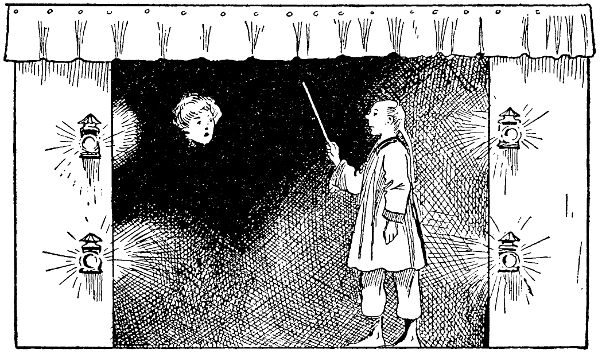
Fig. 1.—The floating head.
The performer then throws a white cloth over the lady’s head. Without a moment’s pause he draws it away again, and—hey, presto!—the lady is headless! The Chinaman next takes a larger cloth, and holds it before the lady in such a manner that she is entirely hidden from the spectators. A second later, however, he drops the cloth to the ground. This time the audience is treated to the spectacle of the head of the lady floating in the air. More wonderful still, the head can speak, sing, and answer any questions that may be put to it.
[175]
After a while the illusionist picks up the cloth, and holding it before the head, once more cuts off the view of the spectators. Upon its being drawn away for the third time, nothing whatever is visible—even the mysterious head has vanished. But when the cloth is held up again and withdrawn, the young lady—in her entirety—appears, and after bowing to the audience, walks unconcernedly off the stage.
Almost every well-known conjurer has stated at one time or another that the secret of his success may be summed up in the one word—practice. But there are very few young ladies who would have either the courage or the ability to practice being decapitated. The ordeal might prove a trifle too exciting. However, they may pass through it without fear if the following method, given in explanation of the illusion, be adopted.
The interior of the stage must be fitted throughout with black cloth. The lights in the room are lowered, the only illumination of any brilliance being a row of candles or lamps, at the side of the stage. These are equipped with tin reflectors, so that the light, instead of shining on the stage, is projected into the eyes of the audience. The effect of this is that, whilst any white object can be seen quite plainly by the spectators, everything black remains invisible.
When the performer envelops the young lady’s head in the white cloth, he at the same moment throws over her a piece of black material of similar size and shape, attached to it by one corner. When he removes the white cloth, however, he allows the black cloth to remain, thus veiling the head and apparently causing it to disappear.
Another and larger piece of black material is similarly hidden in the folds of the second white cloth. Directly the performer spreads this before the lady assistant, so that she is hidden from the audience, she rapidly pulls off her head-veil, and taking the large black sheet, muffles herself in it up to the neck. Consequently only her head remains visible. In order to disappear entirely, it is only necessary for her to replace the head-veil or to pull the larger black cloth up over her face.
It is usual when working illusions of this description to have the assistance of a third person. This assistant must be dressed completely in black, with black gloves and a black mask. The latter can very easily be made from a piece of silk, or any other material that is slightly elastic. It should be stitched into the form of a cylinder sufficiently large to pull over the head. Two eyeholes are then cut in the desired position, and the mask is complete (Fig. 5).
[176]
Garbed in this somber attire, the assistant is able to move about the stage quite freely without being seen by the audience, and to lend powerful but invisible aid in accomplishing many first-class deceptions. However, this point will be referred to later, and attention should now be turned to the construction of the “black stage” itself.
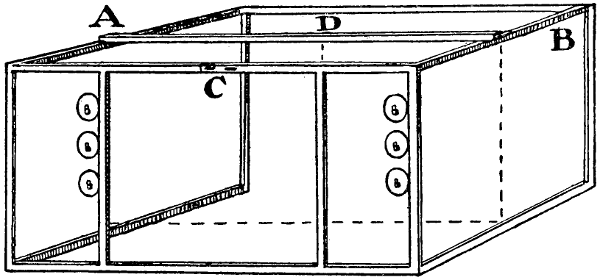
Fig. 2.—The finished frame.
Fig. 1 illustrates the appearance of the finished stage, and Fig. 2 shows the framework of which it is constructed. This framework is comprised of a number of laths fastened together by the method shown in Fig. 3. A small metal rod—a long nail with the head filed off will suffice—is driven into each upright lath. This must be done carefully or the wood will split. Next a hole is bored by means of a drill or red-hot poker in each of the laths fitting upon these uprights. By placing the hole in each cross lath over the nail in the upright lath, as shown in Fig. 3, the framework can easily be put together or taken to pieces, when it is necessary to convey the stage from one point to another.
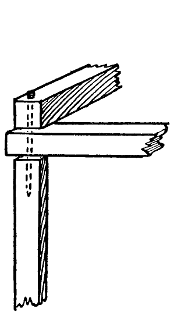
Fig. 3.—Laths fastened together.

Fig. 4.—Method of joining laths of frame.
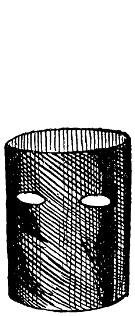
Fig. 5.—Cloth or silk mask.
Fig. 4 depicts the mode of fixing two laths together lengthwise.[177] Instead of having one long lath, it considerably facilitates conveyance if two smaller laths are joined by two thumbscrews as shown in Fig. 4. A joint of this description is also shown at C, Fig. 2.
As can be seen by the diagram, the framework is simply a skeleton box; but a little way beyond the center another lath should be carried across at the top (A B, Fig. 2). Two curtains of black cloth must be obtained and fastened to this lath so that they overlap at the center (D, Fig. 2).
It will now be noticed that this curtain divides the stage into two separate compartments. The first of these is the stage proper, upon which the illusionist performs his various mysteries. The second compartment is reserved to provide an exit for the performer and his assistants, the flap in the curtains acting as a doorway. Some of the apparatus required for the various illusions may also be kept here during the performance.
The dimensions of the stage depend entirely, of course, upon the size of the room in which the entertainment is to be given. The minimum width, or “length of frontage,” should not be less than ten feet, and the distance from the front of the stage to the beginning of the partition curtain not less than six feet. The distance from the partition curtain to the back of the stage is not of great importance. Provided there is room for the assistant to move about, this is all that is required. Two and a half feet is ample.
The following dimensions will be found about as convenient as any; but if the reader is in a position to construct a larger stage, so much the better.
Frontage, 12 ft.; height, 7 ft. 6 in.; distance from front to partition curtain, 7 ft. 6 in.; from partition curtain to back of stage, 3 ft.
Having decided upon the measurements of the stage, a further supply of black cloth must be procured and fitted completely over the framework. It is preferable to have this cloth already stitched into shape (Fig. 6), so that it can be simply drawn on over the box-like structure of laths.
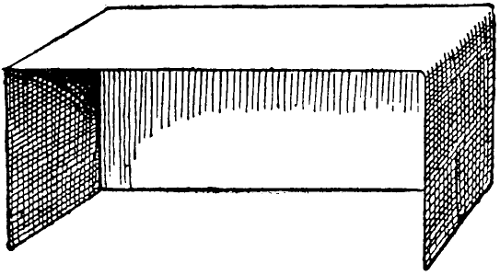
Fig. 6.—Cloth covering for frame.
It is also necessary to spread another piece of black cloth upon the floor.
Lastly, the stage front must be decorated. These decorations consist merely of two curtains hooked at each side of the opening, and a frieze draped along the top lath, as shown in Fig. 1.
[178]
The lighting arrangements must be left largely to the discretion of the reader. If he be a “handyman,” he can fit four incandescent gas burners to the front of the show. A very effective, although primitive, method of lighting is illustrated by Fig. 7. Two pieces of wire are hooked to the top lath, a pair at each side, and three small bull’s-eye lanterns fastened at intervals to them (see diagram).

Fig. 7.—Method of lighting.
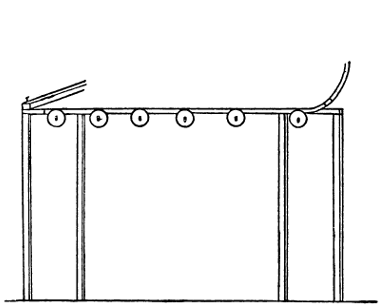
Fig. 8.—Another method of lighting.
Yet another method is depicted in Fig. 8. About half-a-dozen holes are bored in a piece of gas-piping, which is stopped at one end. Ordinary burners are screwed into these holes and tin reflectors attached. The whole arrangement is then bound securely to the top lath after the framework has been fitted together. It is then necessary only to fix a length of gas-tubing from the open end of the pipe to the nearest gas-fitting. If the reader decides upon the latter method of illumination, his best course will be to go to a plumber and place the job entirely in his hands.
The chief thing to bear in mind is, that no light must shine into the stage, the only illumination being projected into the eyes of the spectators, thus dazzling their vision as much as possible.
The stage described can, of course, be greatly improved upon. The above description is intended simply as a rough guide for the boy whose skill in carpentry does not extend much beyond knocking a nail or tin-tack properly into a piece of wood, which, by the way, is not such an easy task as most people imagine.
[179]
Having constructed a stage suitable for working purposes, we may proceed with another illusion.
The performer, who, as previously stated, should be dressed as a Chinaman, or in a white costume of some description, stands alone in full view of his audience. Presently he makes a beckoning motion, and a large white barrel floats slowly into view. To the amazement of the spectators, it drops gently to the ground at the magician’s feet.
He then turns to the other side of the stage and repeats the beckoning motion. Immediately a second barrel makes its appearance, and deposits itself on the ground a short distance from the first.
Turning to the audience the performer borrows a dozen or so rings, chains, and other trinkets. Walking back to the stage, he holds the borrowed trinkets above the mouth of one barrel, and clearly drops the mass of jewelry into it. The next moment, without a second’s pause, the illusionist seizes the barrel and turns it upside down.
Nothing falls out. It is perfectly empty!
Thereupon he darts to the other barrel, turns it over, and out shower the trinkets.
The performer replaces them, and immediately overturns that barrel as he did the first. But once again the jewelry is found to have disappeared. Nor can it be discovered in the other barrel.
Retreating to one side of the stage, however, the illusionist waves his hands. There is a slight flash, and a small Japanese table is seen standing in the center of the stage, with the trinkets heaped upon it.
This is a very effective illusion, but it can be even improved upon, as the reader will see when he has read the following simple explanation of the trick.
Its success lies almost entirely with the “black” assistant previously referred to. The “floating” barrels are simply carried in by this assistant, who must take care to hold them in such a manner that his black-gloved hands do not show up against the white wood.
Whilst the performer is collecting the articles of jewelry the assistant holds a small bag or sack in the mouth of the barrel. Consequently, when the performer drops the trinkets into the barrel, they in reality enter the sack, when it is a simple thing for the assistant to transfer them to the second barrel—the black bag rendering them invisible during transit.
Immediately the performer appears to deposit the trinkets in the barrel for the second time, the assistant again secures them in his small sack. This time, however, he carries them to the side of the stage,[180] where a Japanese table has been placed in readiness out of sight of the audience. This table is draped with black cloth, which, as already explained, makes it invisible. The assistant merely lifts up this cloth and empties the trinkets from the sack on to the table. Then, replacing the cloth, he carries the table and its contents to the middle of the stage.
Next he simply whisks away the black cloth when the performer gives the signal, and the table, with its small heap of jewelry, stands revealed.
As previously stated, this illusion can easily be improved upon. For instance, the “black” assistant can place a live rabbit in one of the barrels, giving the audience the impression that the jewelry has undergone a somewhat extraordinary, though unprofitable, transformation.
The performer should attempt to vary the nature of his entertainment as much as possible, and the following illusion could very well occupy the next place upon the programme.
In obedience to the performer’s command, a large white box or wicker-basket floats on to the stage. This, as the reader will have been able to gather from the explanation of the previous illusion, is simply carried on by the “black” assistant.
After having shown that the box or basket—as the case may be—is perfectly empty, the illusionist raises it from the stage by placing four blocks, one under each corner. This is to prove the impossibility of a “false bottom” or trap-door being used.
A man now walks on to the stage, with a white sheet wrapped round him, and looking like a Dervish or bernoused Arab. Stepping into the basket, he coils himself up until he is concealed at the bottom.
There is a pause of a few seconds, after which a low groan issues from the interior of the basket. A moment later the sheet is seen to shoot up into the air, and collapse in a heap upon the stage. Both sheet and basket are examined; but their human occupant has disappeared—has vanished, as it were, into thin air!
The illusionist next throws the sheet back into the basket. No sooner has he done this than it is seen mysteriously to raise itself on end. Then for a second time it collapses. A moment later, however, a second disturbance is seen to be in progress inside the basket, and this time the white-robed man rises from it, and steps out upon the stage.
The secret of this illusion lies in the fact that the “black” assistant and white-robed man are one and the same person.
Directly the assistant has carried the wicker basket in, and whilst the illusionist is showing the audience that it is perfectly empty, he slips[181] “behind the scenes,” and, taking off his black mask and gloves, hastily arrays himself in the sheet.
In this guise he again makes his appearance, and steps into the basket. No sooner has he snuggled down at the bottom, however, than he quickly throws off the sheet and replaces the gloves and mask. Giving vent to a hollow groan, he flings the sheet into the air. This for a moment diverts the attention of the spectators, and gives the assistant time to step from the basket, behind which he remains in readiness to continue with the second part of the illusion. In his black clothes he will, of course, be quite unseen.
When the performer puts the sheet back into the basket, the assistant merely stoops and slowly lifts it up, until he can step back into the basket under cover of it.
As he allows the sheet to collapse for the second time, he sinks down with it out of sight. He then again removes his black mask and gloves, and envelops his body in the sheet.
This done, the hard-worked “black” assistant in his Dervish disguise has simply to step from his place of concealment into full view of the audience, and the illusion is complete.
Another good effect, which would act as an excellent climax to the entertainment, can be brought about as follows:
The performer makes his appearance carrying a large white shawl. This he spreads upon the ground. Taking the shawl by its two top corners, he holds it before him so that he is completely hidden.
Next he commences slowly to wave the shawl to and fro, to advance to the front, and then to retreat to the back of the stage. As he is advancing for the second time, however, the shawl is suddenly dropped, and—hey, presto!—there is nothing behind it; the illusionist has gone!
But at the very moment the shawl collapses, a loud shout is heard, and the illusionist is seen standing to the rear of the audience!
In this illusion, as in the others, the “black” assistant plays an important part. His task is not nearly so difficult, however, as those he has already been called upon to undertake. In fact, the whole illusion, although it can be made one of the most effective on the programme, is the easiest to accomplish.
Directly the illusionist picks up the shawl and holds it before him, the “black” assistant steps up and takes it. Still under cover of the shawl, the two slowly retreat to the back of the stage until they come to the opening in the partition-curtain (D, Fig. 2). It is then an easy matter for the illusionist to slip through the opening and get clear[182] away. The assistant continues to wave the shawl slowly backwards and forwards, giving the audience the impression that the original performer is still behind it.
In the meantime the illusionist has made his way out of the room by a door in the vicinity of the stage. Thence he hurries to a door leading to that portion of the room containing the audience. Pushing this slightly open so that he may obtain a view of the stage, he waits until he sees the shawl drop, when he unexpectedly and dramatically makes his presence known.
The assistant being arrayed in black apparel will, of course, remain invisible.
The only drawback to this illusion is, that it necessitates there being two doors to the room in which the “black stage” is erected. Then again, although a room may possess the requisite doors, one of them may be so placed that it is impossible for the performer to reach it without being first seen by the audience. In such a case, however, the difficulty may be overcome by an ordinary screen placed from the door to the back entrance of the stage.
As already observed, these illusions can be easily added to and improved upon. In fact the “black stage” and its “black” assistant offer tremendous scope for a really first-class entertainment, teeming with bewildering and mystifying illusions.
If the stage is large enough, two assistants may be employed, and still more complex effects attempted. But having described several illusions of an entirely different nature, and having explained the principle upon which all such illusions are worked, it must be left to the reader to invent other “black stage” mysteries with which to entertain and bewilder his friends.
[183]
If the Honorable Society of Stage Ghosts were to choose a motto, they would find few more suitable than the old adage, that “People who live in glass houses should not throw stones.” As the following remarks will serve to show, their very existence depends upon a sheet of glass, and if this be cracked or broken, farewell to the apparition and all its attendant mystery.
If you look out of the window of a lighted room upon a dark night, you will notice that the pane, instead of being transparent, acts as a mirror and reflects the room behind you. It is on this principle, applied to a stage, that the greater number of ghost effects are produced. Owing to the fact that apparitions are usually seen at night, a good excuse is found for having the stage darkened, whilst the gloom serves to conceal several things highly undesirable the audience should observe.
The ghost effect, as seen by the spectators, is somewhat of the following description. Any person from the audience is requested to come upon the stage and seat himself in a chair already provided. He has scarcely taken his seat when a white figure approaches him, passes in front, in doing so showing that it is transparent. Kneeling by his side, it lays a hand—a ghostly white hand—upon his arm, and appears to plead with him in a most touching manner. But the gentleman from the audience is implacable; he takes no notice whatever of his ghostly supplicant, appearing utterly unconscious of its presence.
Suddenly the object of the ghost’s entreaties becomes clear. Fumbling amongst its white robes it produces a ghostly cigar, again begs our friend with most urgent entreaties for a match, and finally, disgusted at his callous indifference, shakes a sepulchral fist at him, throws aside the cumbersome white shrouds, and appears to the spectators as a very well-dressed young man in immaculate attire. He is still a ghost, however, and calmly walks right through the gentleman from the audience, lights his ghostly cigar with an equally ghostly match, pats his friend condescendingly upon the head, and vanishes.
[184]
“Ghost? What ghost? I saw no ghost, but I got very tired sitting up there all that time without anything happening.” So says the gentleman from the audience when he returns to his seat, and it is not until he has seen it all happen to some one else that he will believe anything really did occur.
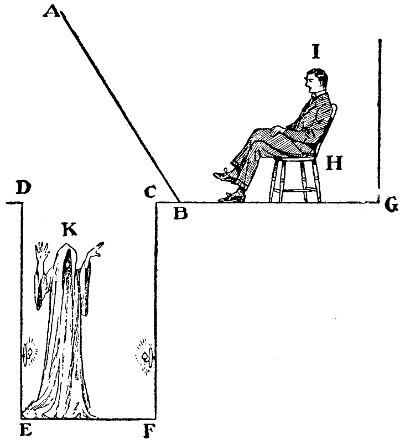
Fig. 1.—Arrangement of stage for ghost-producing.
He is probably provoked when he finds that the next apparition takes the form of a fascinating young lady who vainly endeavors to make the young man who has taken his place kiss her. Indeed, such indifference is astounding, and all her pretty wiles and enticements are as wasted upon him as though he did not see her. As a matter of fact he does not know what pleasant temptations surround him.
In Fig. 1 the stage is shown in section, and the phenomenon is explained. C, G is the stage, upon which is a chair, H, occupied by the gentleman from the audience, I. A sheet of plate glass, A, B, rises from the floor of the stage to the flies, and extends from one wing to the other. This sheet of glass is tilted forward at an angle to be determined by circumstances. Between the footlights, D, and the end of the stage, C, is a space or well, to be occupied by the original of the ghost, K.
When the curtain is raised, the glass, A, B, is quite invisible to the spectators owing to its transparency, and the extinguishing of the footlights at D renders the whole of the stage more or less dark. The space, D, G, is also invisible to the spectators, to whom the stage appears to present nothing more exceptional than an ordinary chair.
Mr. I, as he may be called, is brought up from the auditorium, round by the wings and taken to his chair, whence, looking into the theater before him, he sees nothing of the plate of glass intervening.
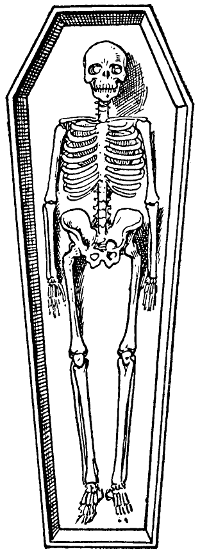
Fig. 2.—The coffin trick.
Being already dressed in the conventional garb of a ghost, the[185] actor, K, places himself in the space between D and C, whereupon strong lights on the walls, D, E, and C, F, are switched on, throwing their glare upon the actor.
Owing to the principle of reflection mentioned above, the glass, A, B, having a fairly dark background, becomes a mirror upon which is cast the reflection of the actor K. Of course, Mr. I in his chair is visible the whole time, but the spectators see in addition to him the reflection of K, which naturally appears transparent, and moves about the stage exactly as K moves in the space D, C.
The position of the chair, H, is already known to K, who is accordingly able to kneel in his space in such a position that his reflection appears kneeling to I, to go through the rest of the performance with perfect ease, and to leave our friend I perfectly ignorant of what has occurred. Returning for a moment to the example of a pane of glass in a lighted room, it must be remembered that the spectators are in the position of the persons within the room and see a reflection of what is their own side of the glass, whilst I is like a person outdoors who looks into the room unhindered. To him the stage and the audience remain the same throughout the whole performance.
An interesting variation of this scene is produced in Paris at an old café, known as the “Cabaret du Néant,” in the Montmartre quarter. The whole interior of this restaurant is fitted up to appear as funereal as possible. Guests are served with refreshments upon coffins by waiters dressed as mourners, whilst the walls are covered with notices and advertisements of a similarly doleful character.
Upon payment of a small fee the guests are taken into a cellar, completely dark except for a small glimmer at the farther end. Having seated themselves they observe this light slowly increase until it is sufficient to disclose an open coffin standing upright.
Some person from the audience is then requested to accompany one of the attendants upon the stage, where he is asked to stand upright in the coffin. His friends and the remainder of the spectators are then informed in sepulchral tones that they are about to witness a change which it will some day be the lot of every one to undergo, being at the same time reassured that the subject of the experiment will suffer no harm from what is taking place.
A white cloth, stretching from the chin to the heels, is then tucked round the figure in the coffin, and after a few moments the living face gradually fades away and a skull is seen in its place, whilst a skeleton now fills the coffin (Fig. 2). This in its turn fades away, giving place[186] once more to the original living occupant, who soon descends from the stage and expresses himself much surprised at what his friends describe, as he himself has seen nothing of the ghastly change.
As in the former experiment, a large sheet of plate-glass is interposed between the audience and the rear of the stage where stands the coffin. This plate of glass is placed diagonally, as can be seen in the plan, Fig. 3. The coffin, C, is lighted by several electric lamps when the man takes his place in full view of the audience. At D is another coffin in the wings, invisible to the man at C, as also to the spectators. When the white cloth has been wrapped around the living person, the lights are slowly switched off at C and on at D, with the result that the skeleton in the latter coffin is reflected in the glass, A, B, in such a manner that it appears to be actually within the coffin, C. To bring the man back to life the operation is reversed.

Fig. 3.—Plan explaining coffin trick.
The object of wrapping the white cloth about the living person is simply to hide any difference in size between him and the skeleton in D. Both coffins have, of course, been properly arranged to suit the reflections before the commencement of the experiment.
The Sea Nymph, shown in Fig. 4, is really a beautiful illusion. The scenery represents a rolling sea beneath an azure sky, flecked here and there with skimming clouds. Suddenly from out the waves a graceful form is seen to appear, and, rising steadily, gambol in the billows. Circling in the air, she plunges down into the waves, only to reappear once more, and repeat her charming sport.
The sheet of glass is arranged for this performance as in the case of the ghost, Fig. 1. The scenery, A, B, Fig. 5, is painted as described, to represent the sea, and at L and M are placed additional waves, close[187] to the footlights. The glass, H, K, descends diagonally. D, E is a large circular disc revolving upon an axle, F, which is connected by a rope or wire to a barrel and handle, G. At C and M strong lights are thrown upon this disc.
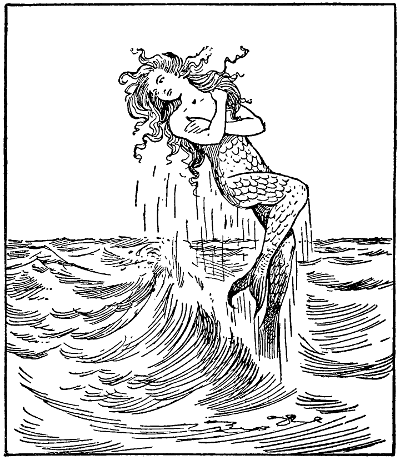
Fig. 4.—The sea nymph.
The young lady who performs the part of the nymph is suitably attired, and takes her place, lying upon the disc, D, E. At the proper time the lights are thrown upon the disc, with the result that the spectators see her reflection in the glass, H, K, as though she were really standing upright amongst the scenery on A, B. By turning the handle at G, the disc is made to revolve, carrying with it the recumbent nymph, who now appears to be turning elegant somersaults amongst the waves.
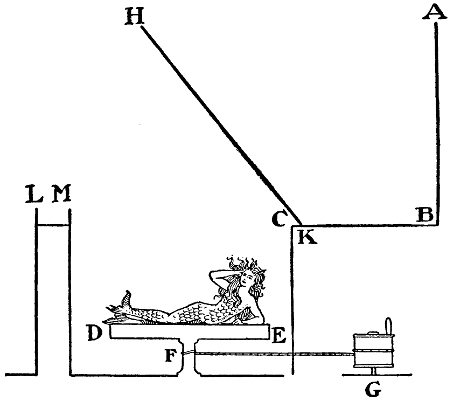
Fig. 5.—Plan explaining sea-nymph illusion.
The only difficulty about presenting any of these effects at home is the inconvenience of obtaining and handling so large a sheet of plate glass as is necessary. A good ghost effect can be easily produced, however, in a room with a large French window.
[188]
The window must be fastened open at an angle that will have to be ascertained by experiment. The room should then be thrown into complete darkness. The ghost takes his place outside the window and against the wall, D, F (Fig. 6), with two lamps, B, so arranged as to cast their light upon him. These lamps should be shaded in such a way that they cast no glare except upon the figure of the ghost.
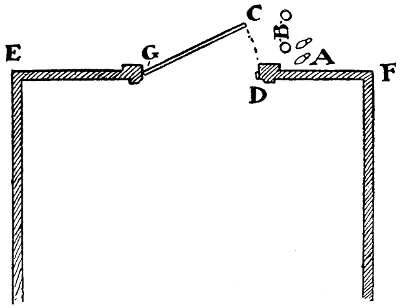
Fig. 6.—Plan of room for ghost illusions.
What happens is very plain. The open window, G, C, reflects the shrouded figure of the ghost at A, making it appear to stand in the doorway, pointing ominously at some startled person sitting in the dark room. It may be added that it is but fair to inform the spectators of what is about to take place, as many people are alarmed at apparitions, and have nerves too weak to stand the sudden appearance of a ghost.
[189]
Although from earliest times wizards and conjurers have attempted to create illusions to impose upon the more credulous of their dupes, it was not until the great Robert Houdin devoted his attention to the matter that any real progress was made in the art. Yet such was the genius of Houdin that his inventions have hardly been superseded in the many years which have elapsed since his death, whilst in the greater number of cases his original plans have barely been improved upon.
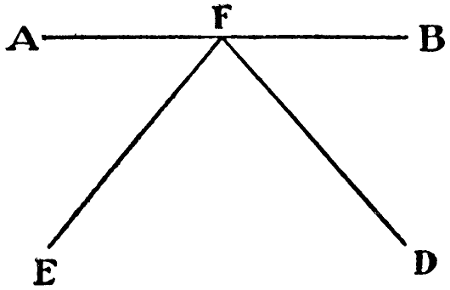
Fig. 1.—The principle of reflection.
Having dealt with the subject of stage apparitions in the previous chapter, it is the intention here to describe and explain the best illusions in so simple a manner that, with the minimum of trouble, any amateur can construct the apparatus necessary for their production. The successful working of the performance depends entirely upon the skill of the exhibitors.
A great number of stage illusions are based upon the principle that a person looking into a mirror from any angle sees the reflection of objects at a similar angle from the opposite direction. This is borne out by Fig. 1. Supposing A, B to be the mirror, with the spectator standing at D, he will see the reflection of an object at E, the angle D, F, B being equal to the angle E, F, A.
A simple adaptation of this principle is seen in
This is a large cupboard, of sufficient height to hold a man comfortably, and about 4 feet wide by 21⁄2 feet deep (Fig. 2). The doors should be double, and meet at the center post H. The cupboard[190] can be lined with some simple paper of an unobtrusive pattern, and the doors should close easily and securely.
Now to describe the performance as it appears to the audience.
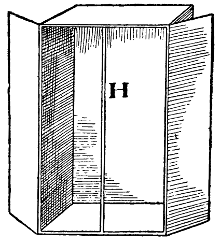
Fig. 2.—The magic cupboard.
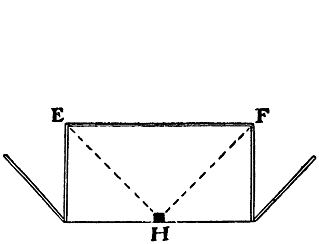
Fig. 3.—Plan of magic cupboard.
The cupboard is opened, and anybody allowed to mount the stage and see for himself that there is no false bottom or trap in the floor. When he is perfectly satisfied and has returned to his seat, the magician introduces his assistant. At a nod from him she enters the cupboard, which is then closed. The wizard makes a few mystic passes with his wand, utters the words “Imshi! Imshi!” meaning in Arabic, “Depart! Depart!” The cupboard is then opened and—found to be empty!
Once more the doors are closed. The magician reverses his passes, claps his hands, looks upward, and again opens the doors. The pretty young lady stands inside, smiling radiantly!
The mystery is understandable by a glance at Fig. 3. At E and F are hinged two mirrors, identical in size with the walls of the cupboard. When opened inwards these mirrors meet at the post, H, which serves to conceal the line of their meeting.
Now the whole deception lies in the walls of the cupboard. When inspected by the audience the two mirrors were flush against their respective sides, and, having their backs covered with the same paper used to line the whole interior of the cupboard, they were mistaken for the real walls against which they were pressed. But when the mirrors are opened inwards the spectator can see only the reflection of the actual walls cast upon the mirrors in such a way that he imagines he sees the back of the cupboard. Of course this is really hidden from him by the opened mirrors, but they reflect the paper-lined walls so accurately that a discovery of the deception is impossible.
[191]
When the lady is introduced into the cupboard the mirrors stand flat against the sides of the box, which is really empty, but as soon as the magician closes the outer doors upon his assistant, she pulls out the sides, shuts herself into the triangle E, H, F, and awaits the opening of the cupboard. When this takes place the mirrors are, of course, in the position indicated by Fig. 3. The spectators, seeing in them the reflection of the walls, think they see the back E, F, and thereby conclude that the box is empty. This process is reversed when the lady makes her reappearance.
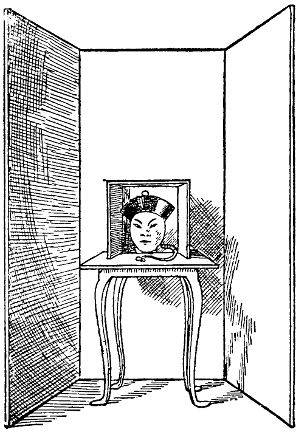
Fig. 4.—The Mandarin’s head.
It need scarcely be said that the object of the wizard’s passes and incantations is to give the assistant time to open and close the mirrors, as the case may be.
Care must be taken when making such a cupboard that the mirrors shall be flush with the sides at every point, and that when drawn out they meet at an angle of 45° from the walls. This is imperative in order that they shall reflect the actual walls of the cupboard exactly.
The illusion known as
is arranged upon a principle somewhat similar to the foregoing.
To the spectators the effect is this. A box, standing upon a simple card-table, is opened and seen to contain a human skull. Remarking that he will call up the original owner of the skull, the wizard closes the box, mutters a few incantations, reopens it, and displays a living human head as shown in Fig. 4.
This head laughs, speaks, and nods, and in numberless other ways shows itself to be no mere imitation. The box having been closed again, the incantations are reversed, and on the casket being opened once more the skull is found inside as at first.
The secret of this remarkable illusion requires but little explanation. In the first place, the table has a hole in its top sufficiently large to allow of the passage of a human head. The hole is closed by a trap from below, after the manner shown in Fig. 5, which may be described in detail thus: A, B, C, D is the table, and E the lid filling[192] the circular hole. This lid is hinged by G to the table, whilst a bolt, F, running through the loops I, I in the table and H, H in the lid, secures the latter in its place. Upon drawing this bolt the lid opens downwards.
As a matter of fact, the simple card-table is not so innocent as it looks. Indeed, the spectators do not really see under the table at all. The surrounding screen is reflected in a couple of mirrors shown in Fig. 6. Let A, B, C, D be the four legs of the table, and A, E, D, E two mirrors placed in the form of a V between them, and reaching from the table top to the floor.
The result of this arrangement is that the two front legs, B, C, are reflected in the mirrors in such a way as to appear to the spectators to be the back legs, A, D, whilst, as in the former experiment, the reflections of the walls G, H, F, K, appear to be the actual back F, G, of the screen.

Fig. 5.—Base of table.
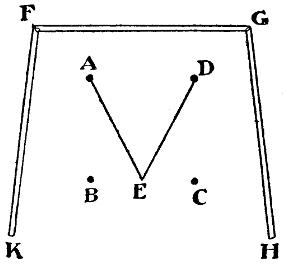
Fig. 6.—Plan of screen and table.
When the magician first opens the box the lid of the table is closed, and a skull, imitation or otherwise, rests upon it. But no sooner does he close the box than the lid is let down by a confederate, concealed in the space A, E, D, and the skull removed by him.
This confederate, who has already been properly prepared, protrudes his face through the hole, and, when the box is opened, acts his part to life. When the box is closed he removes his head from the hole in the table, replaces the skull on the lid, and the trick is done!
The arrangement of mirrors has all along concealed his body, whilst, as already explained, the audience has been deceived into thinking they can see beneath the table.
The wizard must take great care to make all his approaches to[193] the table directly from the front, as, should the reflection of his legs appear in the mirrors, the “game would be all up.”
An illusion known as
is worked almost in the same manner.
The effect of the trick is shown in Fig. 7, where the head of the unfortunate Queen is seen resting upon the hafts of two axes laid over the arms of a chair.
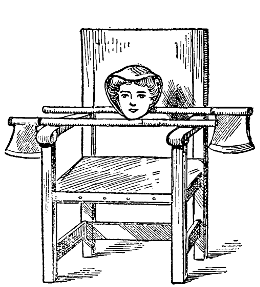
Fig. 7.—The Queen Mary illusion.
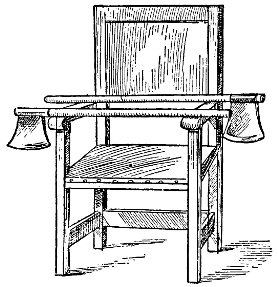
Fig. 8.—The Queen Mary illusion.
It need scarcely be said that the whole trick lies in the construction of the chair, illustrated by Figs. 7 and 8. The peculiarity about the chair is that the back only reaches down to the spot where the arms join it, thus leaving a space behind the seat. This space is concealed from view by a slanting mirror, the bottom of which rests on the seat, whilst the top comes between the arms of the chair. This mirror must incline at an angle of 45° from the seat.
The haft of one of the axes laid across the chair arms serves to conceal the upper edge of the mirror, so that when a head is thrust upwards, it has the appearance of resting upon the ax handle.
In the curtain against which the chair is placed there must be a hole exactly corresponding to the empty space in the back of the chair.
Now, through this hole a girl, whose face and hair have already been made up to look like that of the murdered Queen of Scots, thrusts her body just far enough to allow the head to appear above the edge[194] of the mirror. Owing to the angle at which it is placed the mirror reflects the seat of the chair in such a way that it appears to be the missing portion of the back. The spectators see nothing of the girl’s body; all that is presented to their horrified gaze is the trunkless head of the beautiful but unfortunate Queen.
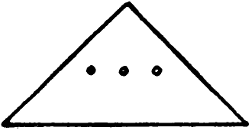
Fig. 9.—When three are a crowd.
Most people know the old saying, “Two are company, three are a crowd,” and a glance at the illustration shows this may really be true.
If three persons stand in a prism-shaped arrangement of mirrors, as indicated in plan in Fig. 9, an innumerable series of reflections would appear and the three would in reality become a crowd.
A most interesting illusion is that of The Floating Lady, which, perhaps, should first be described from the point of view of the audience.

Fig. 10.—The floating lady.
The magician appears upon the stage leading by the hand a fairy-like lady. Introducing her to the spectators as Mademoiselle Volatile, he describes her susceptibility to his powers of mesmerism, in proof of which he offers to keep her suspended in the air for any length of time.
Mlle. Volatile accordingly lies upon a board supported by two trestles or chairs of the same height. Next the wizard walks round her, carefully disposing of her drapery and tucking it neatly about her feet. He makes a few mesmeric passes, examines her pulse carefully, and removes the trestles. The lady is seen suspended in the air as in Fig. 10. After a short time the magician reverses his passes, and smilingly helps Mademoiselle to the ground.
[195]
All this is very mysterious until Fig. 11 “gives the show away.”
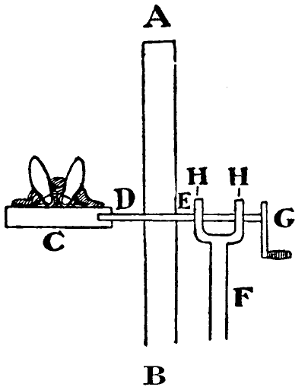
Fig. 11.—Key to floating lady illusion.
A, B represents the back of the scenery through which a hole, E, is bored. This hole is concealed by a little drapery on the face of the curtain. Behind the scenes is a simple contrivance, the principle of which can be seen from the cut. It consists of a strong upright F, which branches into two arms, each of which terminates in a journal, H, H. Through these journals runs an iron bar, D, which, terminating at one end in the handle, G, has the other end protruding through the hole in the scenery.
In the board, C, upon which the lady lies, is a socket to receive the end of the handle.
Now, whilst the lady is putting herself in position on the board, the magician can walk right round her, for the bar has not yet been protruded through the scenery. But, at a signal from him, an assistant behind the curtain seizes the handle, G, thrusts the bar through the hole as far as it will go, and holds the handle firmly.
Whilst adjusting the lady’s robe the magician fits his end of the bar into the socket in the board, and, still arranging the folds of her drapery, carefully conceals any sign of what he has done. Having ascertained that everything is safe, he removes the trestles, and the board, with its living burden, is maintained in the air by the iron bar.
After replacing the supports the bolt is withdrawn by the assistant behind the scenes, and no one suspects the existence of the very material support which has kept the lady in the air.
Robert Houdin used to exhibit to large audiences with startling success the following example of his mesmeric powers. For the sake of clearness, let it be supposed that the magician and Mademoiselle Volatile are performing the trick.
After the usual remarks as to his powers of mesmerism, and how they set at nought the laws of gravitation, the magician introduces the fair lady, who wears a short skirt for the occasion.
Taking two sticks, each about five feet long, the wizard requests Mademoiselle to step upon a stool. Placing one of the sticks beneath each arm-pit, he then begins the incantation.
[196]
When the mystic words have been pronounced and the correct passes made, the magician removes the stool, and Mlle. Volatile appears suspended between the two sticks. One or two more passes are made and then the wizard removes the stick from beneath her left arm, Fig. 12, slowly raising her body to a horizontal position, as in Fig. 13, and passing a hoop around her to show there is no hidden support from behind.
Having left the lady thus suspended for some time, he lowers her to the perpendicular once more, replacing the stick under her left arm and putting the stool beneath her feet. She is then awakened from the trance.
The stick beneath Mademoiselle’s right arm is of special construction, having a core of iron extending its entire length. The lower end fits firmly into a socket in the floor, whilst the upper end itself contains a socket the use of which is explained later.
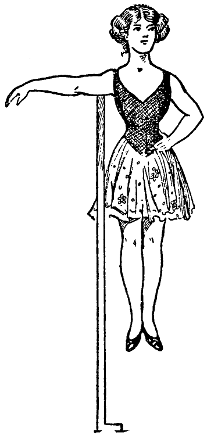
Fig. 12.—Houdin’s mesmerism.
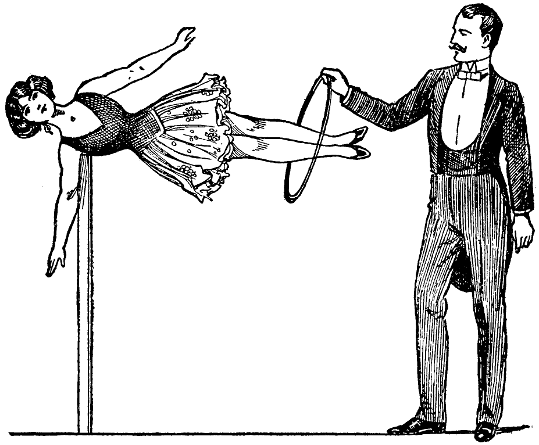
Fig. 13.—Houdin’s mesmerism.
Beneath the lady’s clothing, in fact next her skin, is a well-padded iron cage, shown in Fig. 14. This cage consists of an iron band,[197] H, G, F, which passes round the body beneath the arm-pits of the wearer. It is straight behind and somewhat V-shaped in front. A strong leather strap, E, is fastened to the band at I, passing between the legs and up the back, where it is fastened to the band again at G. Another piece of iron stretches from H by the side of the body to a point above the right knee, where it terminates in a loop of sufficient size to encircle the leg. Every part of this cage must be well covered to avoid any discomfort to the wearer.

Fig. 14.—Cage for suspended-lady illusion.
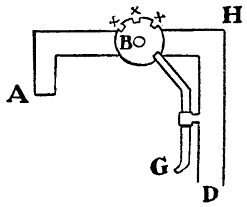
Fig. 15.—The hinge.
At H (Fig. 15) is a small bar hinging at B to a piece of iron, A, which, in its turn, fits into the socket already mentioned in the prepared stick. This hinge, B, contains several notches, X, X, X, the use of which is now explained. The bolt G, is fastened to the leg-piece D, and catches the notches X, X, X at the other end.
It will be obvious that when Mlle. is in her cage with the bolt C in the lowest notch X, she will be maintained perfectly securely in a perpendicular position. When the wizard lifts her horizontally, he releases the bolt and moves the cage with its occupant upon the hinge B. Having placed her in position, he shoots the bolt into the top notch, where it holds the cage firmly.
The whole cage, being beneath her costume, is quite invisible to the audience, and as soon as the experiment is completed Mlle. runs off the stage and divests herself of this somewhat uncomfortable arrangement.
This familiar deception is yet sufficiently thrilling to prove fascinating to the most blasé of spectators. With a little practice it can easily be worked at home, and the following hints will explain the performance.
The magician, dressed as Bluebeard, leads Fatima on the stage, and, during the course of a short conversation, discovers that she has been prying into matters which had better have been left alone. In a[198] fit of passion he draws his sword and rushes upon her, whereupon Fatima falls to her knees, crying for mercy. Bluebeard is obdurate, but after many tears from his wife he consents that she shall be blindfolded, to prevent her being a witness of her own fate. He binds a black scarf across her eyes, but has barely finished, when she breaks away, and rushes from the stage.
Bluebeard pursues hotly, and in another moment returns dragging the blindfolded girl after him. He puts her into a wicker basket, fastens the lid, and with a savage grin, thrusts his sword through and through the basket, his victim shrieking at every stroke.
Having worked the spectators to a pitch of agonized excitement, the murderer throws down his sword, unfastens the lid of the basket, and stoops to gaze on his sanguinary work.
The basket is empty!
Staggering back with a look of horror, he suddenly perceives the “slaughtered” Fatima herself appearing from amongst the spectators, pointing at him accusingly!
The deception in the trick is twofold. Firstly, the basket is of special construction, and secondly, there are two Fatimas.
With regard to the basket the solution is shown in Figs. 16 and 17. The first illustrates the appearance of the basket when Fatima is thrust inside.
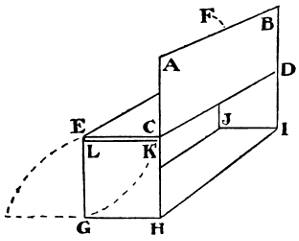
Fig. 16.—The Indian basket trick.
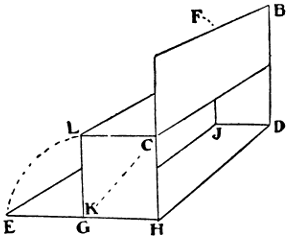
Fig. 17.—The Indian basket trick explained.
The lid, A, B, is plain, and hinged to the top at C, D. The back, E, G, F, J, is similarly hinged at G, J. The top, E, C, F, D, is double, having a duplicate, L, K, hinged at E, F.
Having placed Fatima in the basket, Bluebeard thrusts his sword through and through the wicker-work, carefully avoiding the spot[199] where, as he knows, the girl is lying. At each stroke she screams lustily, as though the blade were piercing her body.
Then, deftly pushing down the back of the basket, E, G, F, J (Fig. 17), she rolls herself out upon it, drawing after her the false top, E, K, by doing which the original back is entirely replaced. She is now lying outside the basket, which is, of course, empty when opened by Bluebeard.
Now comes the question of the two Fatimas. The girl who is put into the basket is not the one who was blindfolded by Bluebeard. When Fatima rushed away pursued by her murderer her place was taken by another girl waiting behind the scenes similarly dressed and of the same height and figure. The bandage upon her eyes hid from the spectators any difference in features.
The substitute having been apparently slain by Bluebeard, the original Fatima slipped in at the back of the auditorium, slowly walked down amongst the spectators (who recognized her face) and confronted the assassin. In the confusion that naturally followed, the substitute managed to leave her place behind the basket and vanish from the stage.
This is an illusion originally produced at one of the French ballets.
A train of slaves appears, bearing a palanquin, in which reclines a dazzlingly beautiful Princess. The slaves march slowly round the stage, allowing the spectators ample opportunity to inspect the palanquin from all sides.
Suddenly a band of brigands rushes upon the scene, with the obvious intention of seizing the lovely Princess. Flourishing their glittering swords and brandishing all manner of fearsome weapons, they surround the palanquin and its terrified bearers.
The robber chieftain advances with uncouth flattery, assuring the lady that not a hair of her head shall be touched. But the only answer she makes is to lower in his face the curtain of the litter.
Furious at such an insult, the robber stretches out his hand, and with a single touch causes the curtains to fly open.
The Princess has disappeared!
Gazing at one another in astonishment, the villains search for the vanished lady, but their endeavors proving fruitless, they eventually decide to butcher the slaves and carry off the palanquin as booty.
At this moment a handsome young Prince springs into view; the robbers, startled at his sudden appearance, take to flight, and abandon all thought of their prey.
In his turn the Prince approaches the palanquin, sees it empty, and[200] questions the slaves, who can only say that their mistress was there, but has disappeared. Pulling the curtains aside to see if they offer a solution to the mystery, he releases them almost instantly, and the lovely Princess is found reclining upon the litter, smiling so charmingly that the Prince then and there loses his heart.
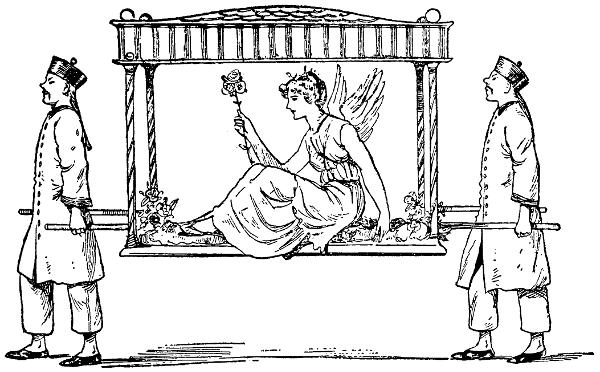
Fig. 18.—The disappearing Princess.
The explanation of all this is very simple. In Fig. 18 the lady is sitting upon what appears to be the bottom of the palanquin. In reality it is a false floor placed upon the real one. At each corner are attached cords that run up the four columns and are counterpoised by heavy weights.
When drawing the curtains, the Princess releases a catch, whereupon the counterpoise and cords immediately draw her, together with the false floor upon which she rests, to the roof of the palanquin, which has been so painted as to make it appear shallower than it really is. By pressing another spring she is enabled to lower herself once more, in time to appear before the fortunate and admiring Prince.
[201]
One winter evening three boys—Jim Thompson, his cousin Will White, and a friend named Handley—approached the door of Bobbie Cargill’s house. Bobbie was a genius for inventions, and they all felt a desire to see his home.
As they reached the door, White, who was a cynic in his own way, raised his hand to the knocker and was about to give a thundering “rat-tat,” when the door silently opened, revealing an empty hall in which the light flickered dimly.
After a glance of surprise at one another the guests entered.
“Close the door! Wipe your boots, and come upstairs!”
The visitors started violently as these words were uttered by a hollow voice, coming from nowhere in particular, and yet quite close to where they were standing.
After a moment Handley said in a whisper, “I don’t much like this. It seems——”
“Hang up your hats, and be quick about it,” the ghostly voice interrupted sharply. “Are you going to stand chattering there the whole night? Hang up your hats, I say!”
This was not a pleasant beginning, yet none of the guests cared to show the white feather.
“Come on!” said White. “Let’s see it through”; and setting an example he placed his hat upon the nearest peg.
Crash! Amidst a clatter as of broken glass the hat and peg fell to the ground. The three boys looked at one another in consternation!
But before they had time to remark on this misfortune, a shriek of weird laughter rang in their ears. “Ha! Ha! Ha!” The invisible person seemed in paroxysms of mirth at their disaster.
“I don’t care for this a bit,” muttered Handley; “let’s clear out.” They were all about to beat a hasty retreat when Bobbie Cargill appeared, apparently much surprised at finding his visitors making an awkward group in the hall.
[202]
“How did you fellows get in,” he said, “and what have you been doing? Has there been an accident? Never mind, come along upstairs and have a ‘feed’; perhaps you will feel better then!”
Nothing loth, the three guests followed their host to his own room, which usually went by the name of “The Den.” The upper part of the house was totally dark, and it was with a feeling of relief that they saw a glimmer of light beneath the door of “The Den.”
“Step inside and make yourselves at home,” said Cargill. “I will just run and say that you have arrived,” and he disappeared into the darkness.
Followed by the others, White turned the handle and threw the door open, glad to find a light once more. But the pleasure was short-lived, for the door had scarcely opened half-way when the light went out.
White, however, strode into the room, and his friends were about to follow, when there was a heavy stumble, a crash, and a smothered shout that was instantly drowned in the violent clatter and ringing of bells about their very ears.
“What has happened?” gasped Handley, scarcely able to hear his own voice in the deafening clamor. Advancing into the darkness, a violent report beneath his feet caused him to leap into the air with alarm, whilst in the gloom White was trying to make himself heard above the pandemonium.
“Here, Cargill, get a light for goodness’ sake!” howled Handley, as their host appeared. “I don’t know what on earth has happened; it seemed like a pistol going off.”
“You fellows are making a fine noise between you,” shouted Cargill. “Get inside, Jim, and turn on the light; it’s just to the left.” Jim had no sooner stepped across the threshold and begun searching for the switch, than BANG! BANG!—the very floor seemed thundering beneath him, whilst a rattle as of a thousand pots falling to the ground made the confusion worse. Leaping back hastily, he collided with Handley, and the couple sat down with a ponderous thud.
“That’s right; make yourselves comfortable!” laughed Bobbie Cargill. As he spoke the light was turned on, the jangling bells ceased, and the three guests were discovered gazing ruefully at one another, whilst their host, calm and collected, smiled down on them from the doorway.
It was some time before Bobbie could pacify his guests. Indeed, the situation might have become painfully awkward had they not happened to glance at the table, which certainly looked inviting. Knives and forks glistened cheerfully on a spotless white cloth, whilst dainty mats and sparkling cruets promised a really substantial “feed.”[203] A large center-piece full of flowers added to the appearance of the table, and showed that Bobbie Cargill knew how to do things “in style.”
Following their host’s example, the three chums took their seats at the table and glanced round the room. It was a cozy “Den,” and looked cheerful, with a sparkling fire on the hearth. A thick curtain was drawn across the window at Cargill’s back, lending an air of comfort to the place.
Before each guest was a napkin, neatly mitered, with a piece of bread reposing between the horns, and scarcely noticing what he was doing, White drew this piece of bread from its resting-place.
A sharp exclamation drew attention to him. There he sat, a mass of bread-crumbs before him, and a look of surprise on his face!
“Have you had an accident?” grinned Cargill. “Never mind the crumbs, they can soon be scooped up; wait a minute until I fetch the tray.”
He had scarcely risen when a roar of laughter burst from Jim and Handley. By some strange means the entire mass of crumbs had been swept off the cloth and scattered all over the place.
“You might have waited for me to clear them away,” grumbled Bobbie, and this was the beginning of a heated discussion, which would probably have ended violently had not the host turned the conversation by asking Jim if he would take a piece of tongue.
“Yes, please,” answered Jim.
Sharpening his knife in a business-like manner, Cargill made ready to cut a slice.
But at this point a strange thing happened. As soon as the knife and fork got near the tongue, it leaped from the dish and clung tenderly to the knife. For a moment or two it hung suspended, and then flopped back into the dish.
“Let’s have another try,” said Cargill in a puzzled way. Up it jumped once more, apparently too anxious to be carved to remain still on the plate.
A murmur of surprise escaped the guests as all eyes were fixed upon this strange behavior. Once more the carver thrust his knife near the tongue, caught it neatly as it ascended, and carried it away to a side table, where he was obliged to bury his face in a handkerchief, presumably overcome with grief.
Having recovered somewhat, the host resumed his seat, remarking, “I think that tongue is best out of the way. I am afraid I have nothing better to offer you than some potatoes. You might help them round, Handley.”
Before his friend had time to reply, the lid of the tureen arose[204] slowly and deliberately—ascended and then remained stationary in the air. Only for a moment, however. Suddenly rising yet higher it was followed by each individual potato, as one by one they rose sedately to the ceiling, leaving but one of their number in the tureen.
Their eyes fairly bulging with surprise, the boys looked at one another, at their host, and then at the tureen with its solitary occupant. But this last potato had suddenly awakened to a sense of its loneliness, and sprang into the air to join its companions. Next the whole party of vegetables slowly crossed the ceiling and disappeared behind the curtain, to be seen no more.
Jim wanted to jump up and see where they had gone, but his host dissuaded him, and, anxious to change the subject, asked what he would have to drink.
“I don’t quite know. What is there?”
A wine bottle that had been quietly standing in front of White lurched suddenly forward, as though in answer to the question. At the same moment the table began to heave, the glasses to rattle, and a little stool, covered with books, toppled over with a prodigious crash.
“Haven’t you some other room we can go to?” stammered Jim.
“Nonsense, it is only some silly trick of Cargill,” said White. Nevertheless all three guests wished themselves well out of it, especially when the dim light suddenly grew dimmer, and the shadows in the room increased. In a few seconds the boys were barely able to see one another.
At this point a mournful moan rang through the room, the curtains were seen to open, and a white figure glided from between them and passed out through the door.
“Let’s get out of here, the place is haunted!” cried White, rising from his chair.
“Ha! Ha! Ha!” a ghostly laugh issued from the flowers in the center of the table, and was echoed by the clock on the mantelpiece.
“Ha! Ha! Ha!”—but the guests could stand it no more, and, scrambling and struggling, they rushed downstairs, with White at their head. Panting and scared they did not stop until the hall was reached, when they stood still, staring at one another in dismay.
“What is the matter?” a sweet voice greeted them. The whole party turned to find Cargill’s sister standing at the dining-room door, looking from one to the other in frank amazement. None of them cared to reply. It is no pleasant thing to tell a pretty girl that you have been afraid.
“The ghost, Dolly,” gasped her brother after a moment, and in a shaky voice he recounted their mysterious adventures.
“So the silly old ghost would not let you have any tea! You[205] must all come in here and enjoy yourselves. I believe there is plenty to eat,” and leading the way Miss Dolly ushered them into the dining-room, where the table was laid with enough good things to cheer a king.
But when she had shown each of the four friends his seat there still remained a vacant place at the head of the table.
“Now, gentlemen,” she said with a naughty smile, “as you are all feeling much braver now, I am sure you will not mind if the Ghost sits down and has something to eat, too.”
The boys looked at one another and then at her, but Miss Dolly, taking no notice of their surprise, quietly seated herself in the vacant chair, passed a plate to White, and said—
“Now, Mr. White, please give the Ghost something to eat.”
·········
After they had all had a good tea, of course Bobbie Cargill and his sister, the Ghost, had to tell the others how it was done. This is the gist of what they said:—
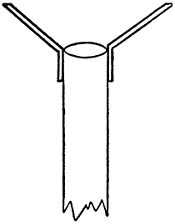
Fig. 1.—Apparatus for producing ghostly sounds.
The opening of the door was a very simple matter. A loop was tied in one end of a long piece of strong cord or string, which was carried across to the wall by means of staples, to a concealed corner. The loop was slipped over the door-catch, so that when the other end was pulled this catch was drawn back, whilst the continued pull on the string made the door open. This loop was made of such a size, that as soon as the door had opened to its full extent the string slipped automatically from the catch, and could then be pulled away and out of sight.
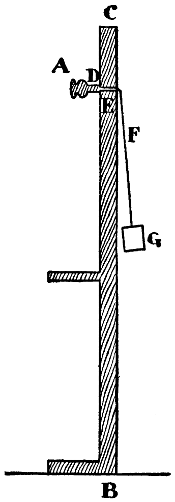
Fig. 2.—Mysterious hat-stand.
In the angle formed by the wainscoting and the floor a piece of simple tubing was placed, one end reaching a room on the ground floor, whilst the other was carried up behind the hat-stand to the height of about five feet. To this end a cardboard funnel was fixed, as in Fig. 1, which, sticking out from the wall, was concealed by a hat or scarf upon the rack. A similar funnel was placed upon the other end, so that the voice of any person speaking through the tube from the room was carried with undiminished force to the hall, thus transmitting the ghostly messages and weird laughter to the guests.
In most hat-stands the pegs are screwed to the back, and taking advantage of this, Bobbie Cargill had unscrewed those pegs most likely[206] to be used by his visitors, putting “fakes” in their place. To all appearances there was no difference between the “fakes” and the proper pegs, but in reality the former were simply gummed against the rack, just strong enough to bear their own weight, but too weak to support a hat.
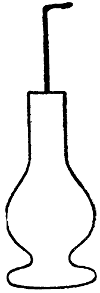
Fig. 3.—Prepared hat-stand peg.
By the contrivance of a piece of string the fall of the hat-peg was made to work a kind of booby trap, explained by Fig. 2, which shows the hat-stand in section. The false peg, A, is lightly gummed to the stand, B, C, against the hole D, where the real peg is screwed. A bent pin or nail is driven into this end of the peg, as seen in Fig. 3, the end bending downwards. A thin piece of string, F in Fig. 2, is fastened round this pin with a loop, passed through the hole D, and supports at the other end a tin, G, filled with bits of broken glass, marbles, and such like.
Naturally, when White hung his hat on the peg the strain brought the peg away from the stand, in its fall releasing the string and causing the tin to clatter to the floor. So simply was the whole thing arranged, however, that Bobbie Cargill had fixed it up in less time than it has taken to describe.
The absence of lights in the house served a twofold purpose. In the first place, it made the mystery and eeriness more marked, whilst at the same time it concealed several little matters which had to be hidden in order to insure success.
It will now be necessary to glance at the arrangement of the “Den,” shown by Fig. 4. The room was entered by the door A, whilst in[207] the opposite wall is the fireplace B. The window C is hidden by the two heavy curtains at D and E. In the center of the room stood the table F, around which were placed the chairs G, G, G, G. Between the curtains and the window stood the ghost, who after all turned out to be none other than Dolly.
Over the center of the table hung the gas, which, being incandescent, naturally had a burner with a by-pass, and was easily manipulated by means of a piece of string running up the chandelier, carried across the ceiling where it was painted white, and down to Miss Dolly behind the curtains. A weight should be fastened to the switch to make it fall when not pulled by the string, as in Fig. 5.
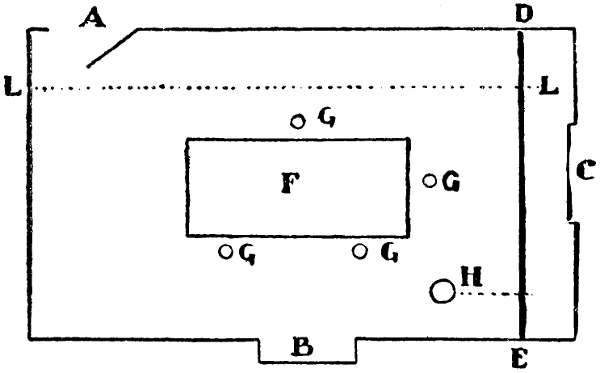
Fig. 4.—Plan of the room of mystery.
When White opened the door the young lady lowered the gas by means of her string, and as it was a by-pass the light did not actually go out, although it went sufficiently low to plunge the room in darkness.

Fig. 5.—The weighted by-pass.
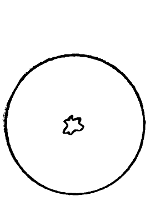
Fig. 6.—An exploding cap.
It was an easy matter to cause a collision between the visitors. A piece of cord stretched across the room, at L, L, quickly did its work, and was then pulled away behind the curtain.
The “Den” had not been fitted up so neatly for beauty alone, and if they had looked, the guests might have found a couple of strong electric bells concealed beneath the dainty hangings of a picture by the door. Dolly had but to push a button and these two bells were set ringing like an alarm clock, and with a persistence calculated to arouse the Seven Sleepers.
Handley’s experience required even less preparation. Several good percussion caps were placed beneath the carpet and covered with a piece of tin as shown in Fig. 6. In the center of this piece of tin, a hole was pierced with a nail, making ragged edges on the further side. These ragged edges were placed over the powder in the cap, with the result that so soon as Handley trod upon the carpet over the plate the cap was exploded with a loud report.
Meanwhile Bobbie Cargill, arriving under cover of the darkness,[208] added to the uproar by banging a tin can with a heavy stick, and performed this office so lustily that nothing else could be heard.
It is scarcely necessary to remark that sending Jim into the room to turn on the switch was merely a feint to get him out of the way, and to plunge him into the fracas.
A signal from Bobbie was enough to make his sister turn on the light and release the bell pushes, so that when silence was restored, and the darkness dispelled, there was nothing to show how all the commotion had occurred.
By adjusting a screw in the gas-burner Bobbie had previously arranged matters so that even when the gas was turned full on the light was not very strong. Although sufficient to illumine the room, it was feeble enough to hide several tell-tale features.
Besides being an ornament to the table, the large center-piece of flowers served to conceal the end of a piece of tubing which passed beneath Bobbie’s chair to the far side of the curtain. Amongst the frilled mats, too, there were one or two other contrivances to be explained in their turn.
It had been Miss Dolly’s business to make the fake pieces of bread. Taking a piece of bread and breaking it up into very small crumbs, she had then added just enough milk to enable her to mold the crumbs into the shape of a piece of bread again, and had then let the concoction dry, when it had become sufficiently brittle to suit her purpose.
Concealed by the mat in the center was a small indiarubber tube, one end pointed directly to the spot where White had dropped his mass of crumbs, whilst the other ended in a bulb conveniently placed to Bobbie’s hand. He had nothing to do, therefore, but to press the bulb suddenly, and laugh as the wind thus caused sent the crumbs flying.
The tongue is proverbially a deceitful member, and the one lying before Bobbie Cargill was no exception to the rule. Indeed, except for its appearance there was really very little tongue about it. It consisted of a round tin, in which had been placed a small bar of highly magnetized iron. By fixing a slice of real tongue to the top of the tin, and disguising the sides in a similar manner, Bobbie had made such a good resemblance to the real thing, that it would have been hard to discover the deception in the subdued light of the “Den.”
It is very easy to see what happened. So soon as the steel knife approached the dish, the magnet within the faked tongue made the latter leap up to meet the knife and cling to it. Of course, when the[209] fork was plunged through the thin outer coating of meat it struck the tin, making it crack in a strange manner. In Fig. 7 is shown the method of fixing the magnet, the whole faked tongue being shown in section. A number of experiments had to be undertaken before the trick could be made to work satisfactorily, but in the end Bobbie was quite pleased with the result of his labors.
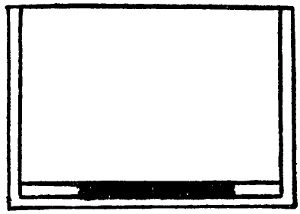
Fig. 7.—The mysterious tongue.
The whole success of the potato trick depended upon Dolly, who worked the simple apparatus to perfection. Attached to the handle of the lid was a strong piece of wire, which the half-light rendered invisible. This passed through a loop in the ceiling and over to the curtain, to enable that young lady to pull. A second wire was attached to it that pulled the cover and the potatoes out of sight. Fig. 8 will show how this was arranged. A ring C is put in the ceiling A B over the tureen. From the lid E a wire D passes up through this ring and along the ceiling to the back of the curtain G. Upon the wire D a ring H is threaded, whilst attached to this ring is another length of wire F, that also passes behind the curtain.
By pulling the wire D the lid of the tureen is naturally raised to the ceiling at C. When it has reached the top, it is only necessary to pull the wire F, and pay out the wire D, to make the whole lid travel towards G. Each of the potatoes had been previously attached to the lid by a wire about ten inches long, with the exception of the small one that remained in the dish, which had a separate arrangement of thread, similar to that of the lid, all to itself.
The movement of the bottle upon the table was caused by the inflation of a little india-rubber bulb beneath the cloth, and worked by the host as he sat at the table.
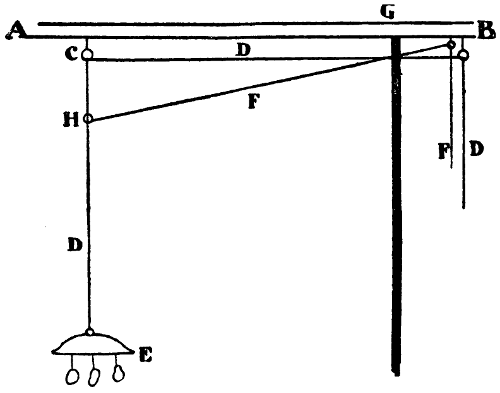
Fig. 8.—The disappearing potatoes.
The excitement of his guests having been thus aroused it was a[210] very simple matter for Bobby Cargill to move the table with his knees, whilst by dexterously pulling a string Dolly was able to overturn the little table laden with books (Fig. 4, H). To add to all this confusion Dolly then began slowly to lower the light, tap the wall by her side, and utter dismal groans. She then clothed herself in a white sheet, opened the curtains, and made her way out of the room with all haste. Little wonder that general consternation ensued!
It only remains to be mentioned that the speaking tube concealed amongst the flowers in the center-piece was sufficient to carry the laughter from one of the servants, who, acting under instructions, stood without the room. It proved the climax, and peace was scarcely restored until they were all sitting below with the Ghost herself, and partaking of a real supper without any faked tongue.
As they all agreed, it was not a bad scare for the money, as a very small sum represented the entire outlay for working The Mysterious Room.
[211]
An exhibition of so-called hypnotism and second-sight is a favorite item in the programmes of many professional entertainers. If well managed, the performance appears miraculous, and is sure to impress the majority of the audience as savoring strongly of the supernatural. The exhibition is usually somewhat of the following nature.
A young lady is presented to the audience as being possessed of the marvelous faculty of second-sight, so keenly developed that she is able to see and describe whatever falls under the observation of her double. Needless to say, this individual is the performer who introduces her. Having given this explanation, Prof. B, as he may be called, bandages the eyes of the gifted young lady, Mlle. C, and seats her on the stage in full view of the spectators.
The Professor now walks amongst his audience and asks some person to whisper a number. This having been done, he calls out to Mlle. C, desiring her to state this whispered number, which she cannot possibly have heard. Without the least hesitation Mlle. answers correctly.
The Professor will perhaps now ask for a coin, and at his request she will describe it accurately, give its date and value, and any other particulars desired. In the same way she will give the number of a bank-note, describe any article the Professor may happen to be holding in his hand, or even tell to what he is pointing.
With many other tricks as wonderful and mysterious does the Professor attempt to beguile the audience into a belief in his occult powers. It may be very uncharitable to give the Professor’s deceptions away, but that is what this chapter will do for the benefit of its readers.
The whole secret lies in a private code understandable only by the two performers. By using this Prof. B tells his accomplice exactly what she has to answer, gives her the numbers and describes the objects, quite unknown to his listeners. All that is necessary is a[212] good memory and quick hearing. Given these essentials, the rest is simple.
Let us begin by describing the code with which the Professor apprises Mlle. C of the various numbers chosen by the audience.
The units are expressed by letters from which Prof. B forms sentences when addressing Mlle. C. A very commonly used code is this:—
| 1 | is represented by | t | |
| 2 | „ | „ | n |
| 3 | „ | „ | m |
| 4 | „ | „ | r |
| 5 | „ | „ | l |
| 6 | „ | „ | h |
| 7 | „ | „ | k, g, or c |
| 8 | „ | „ | f, v, or w |
| 9 | „ | „ | p or b |
| 0 | „ | „ | s or z |
To use this code properly two things are necessary. Mlle. C must know how many figures the number consists of, and she must also know when the code is finished.
The latter point is easily settled. When she hears the words, “if you please,” she knows that whatever follows has no code meaning whatever, whilst everything that precedes these words carries a hidden meaning.
By the use of the following words the number of figures is conveyed in a perfectly unmistakable manner.
| For | one | figure | use the word | figure. | |
| „ | two | figures | „ | „ | number. |
| „ | three | „ | „ | „ | very well. |
| „ | four | „ | „ | „ | very well, sir (Mlle. or madam). |
| „ | five | „ | „ | „ | very good. |
| „ | six | „ | „ | „ | very good, sir (or madam). |
The following explanation shows how to put this into practice. Taking all the numbers successively from one to ten (a thing that would never be done in an ordinary way), Prof. B conveys to his fair friend the desired information by means of the sentences subjoined.
| Prof. | — | Tell this figure. (t = 1; “figure” = one number.) |
| „ | Now, what is this figure? (n = 2.) | |
| „ | Might I ask this figure? (m = 3.) | |
| „ | Repeat this figure. (r = 4.) | |
| „ | Let me know this figure. (l = 5.) | |
| „ | Have you understood? (h = 6.) | |
| „ | Give me this figure. (g = 7.) | |
| „ | Will you repeat this? (w = 8.) | |
| „ | Please tell me this figure. (p = 9.) |
[213]
Prof.—This seems an easy number. (t = 1, s = 0; “number” means two figures. Ans. 10.)
Prof.—Now, please, tell this number. (n = 2, p = 9; word “number” means two figures. Ans. 29.)
Prof.—Very well, let me know this. (“Very well” means three figures; l = 5, m = 3, k = 7. Ans. 537.)
Prof.—Very good, Mlle. Now repeat clearly what this is, if you please. (“Very good, Mlle.,” means six figures; n = 2, r = 4, c = 7, w = 8, t = 1, s = 0. Ans. 247810.)
Sometimes the Professor asks some person present to come upon the stage, and write certain figures upon a blackboard provided for the purpose. The method of communicating the numbers is the same, but the Professor in this instance points to each figure in turn, tells it to the lady, and awaits her reply before proceeding. For example, suppose the number 638219 to have been written by a gentleman.
Prof.—Very good, sir (turning to Mlle. C). How many figures have been written upon the board?
Mlle.—Six.
Prof. (pointing to first figure)—How about this? (h = 6.)
Mlle.—Six.
Prof.—May I ask this? (m = 3.)
Mlle.—Three.
Prof.—Well! (w = 8.)
Mlle.—Eight.
Prof.—Now, if you please. (n = 2.)
Mlle.—Two.
Prof.—This? (t = 1.)
Mlle.—One.
Prof.—Please. (p = 9.)
Mlle.—Nine.
Prof.—That is all right. (This is invariably understood to mean that the experiment is completed.)
Should any smart person write a number like 99999, and smile expectantly, awaiting the Professor’s confusion, he will be doomed to disappointment, for Prof. B merely says to him “Very good”: and turning to Mlle. C, says “Please,” and she answers immediately, “There are five nines.” Of course the Professor’s “very good” has told her that there are five figures, and the “please” has told her that they begin with nine. Finding that the Professor does not say anything more, she presumes they are all the same, and replies accordingly.
This system of coding is applied in a similar manner to the letters of the alphabet, and by this means any word can be easily spelled. But to avoid detection, the letters have to be transposed somewhat[214] after the following fashion, which must only be considered as an example, being too easy of detection for practical use.
| A | becomes | B |
| B | „ | C |
| C | „ | D |
| D | „ | E |
| E | „ | F |
| F | „ | G |
| G | „ | H |
| H | „ | I |
| I | „ | J |
| J | „ | K |
| K | „ | L |
| L | „ | M |
| M | „ | N |
| N | „ | O |
| O | „ | P |
| p | „ | Q |
| Q | „ | R |
| R | „ | S |
| S | „ | T |
| T | „ | U |
| U | „ | V |
| V | „ | W |
| W | „ | A |
| X | „ | “now” |
| Y | „ | “easy” |
| Z | „ | “plain” |
To show how this is used, it may be supposed that the Professor has in his hand a brown cap, which some little boy in the audience has given him.
“Do be quick, if you please, and tell me what I have in my hand?” (d = c, b = a, q = p.)
“A cap,” answers Mlle. C.
“Come, say precisely, if you please, what color?” (c = b, s = r, p = o.)
“It is a brown cap,” answers she.
This system can be simplified yet further by coding the various objects most likely to be required, in a way similar to the following:—
Touch = part of clothing.
Look at = part of the room.
Point = part of figure.
Oh yes! = letter or piece of paper.
Most certainly = coin, other than money.
Yes, if you like = a watch.
This is harder = some trinket.
I am afraid this is harder = a ring.
An excellent idea = a playing card.
As an example of how this code can be employed, it may be imagined that the Professor lays his hand casually upon a gentleman’s coat-sleeve.
Prof.—What am I touching?
Mlle.—A part of some one’s clothing.
Prof.—Tell me fully what, if you please? (t = s, m = l, f = e, w = v; which reads “sleeve.”)
Mlle.—I can dimly see a sleeve.
Prof.—Have you found only a sleeve? (h = g, f = e, o = n; reading “gent.”)
[215]
Mlle.—Yes, I see a gentleman’s sleeve.
Or as another example, imagine that some one produces a seal.
Prof. (loud enough for Mlle. C to hear)—This is harder. This fairly bothers me (looking at it closely).
Mlle. (who has understood “This is harder” to mean a trinket, and “this fairly bothers me” to read Seal)—I can see quite plainly that it is a seal.
Prof.—Both initials, if you please.
Mlle.—A, and then H.
Prof.—Hurry up, if you please. What metal is it made of?
Mlle.—It is made of gold.
This last answer is based upon another code for the various metals, which may be something like this:—
| Brass | is represented by | T | |
| Copper | „ | „ | C |
| Silver | „ | „ | D |
| Gold | „ | „ | H |
| Iron | „ | „ | J |
| Tin | „ | „ | M |
Some person in the audience hands the Professor a silver cigarette case, and, looking up to the stage, he remarks—
“This is harder. Come, perfectly, now!” (c = b, p = o, now = x.)
“I see a box,” murmurs Mlle. C dreamily.
“Describe it.” (d = silver.)
“It is made of silver.”
“Do just have something further, if you please.” (d = c, j = i, h = g, s = r, f = e—making “cigre.”)
“It looks like a cigarette box—a cigarette case.”
“Let us know the number of cigarettes in it?” (l = 5.)
“There are five cigarettes.”
“Well, just say, if you please, what kind?” (w = v, j = i, s = r.)
“They are cigarettes of Virginia tobacco.”
Money should be designated by N, which, as you remember, is the code letter for M. The following will then come in handy:—
Gold is coded as 1, silver as 2, copper as 3, and paper as 4.
“Now, if you please, tell me what I have in my hand?”
“I see money.”
“Nature?” (n = 2 = silver.)
“Silver.”
“Let’s see, if you please, how you would describe this coin?” (l = 5, s = 0.)
“I see a fifty-cent piece.”
“The piece seems new?” (t = 1, p = 9, s = 0, n = 2.)
“The date is 1902.”
[216]
Holding out a handful of money, containing say, a five-dollar gold piece, two fifty-cent pieces, four quarters, and five cents in copper,
The Professor says, “Tell this, if you please, the number of coins in my hand?” (t = 1, t = 1.)
“Eleven,” answers Mlle. C.
“True. Now, Mademoiselle, if you please, tell me the nature of it?” (t = 1 = gold, n = 2 = silver, m = 3 = copper.)
“Gold, silver, and copper.”
“Leaving, if you please, the others, let us start with the gold.”
“A five-dollar gold piece.”
“Now, if you please, silver.”
“I see two dollars in silver.”
“Likewise, if you please, the copper?”
“Five cents.”
“All right.”
The code for playing cards should be formed in much the same way. The following is a suggestion of what might be arranged:—
The cards, commencing with the ace and finishing with the king, should be numbered one to thirteen inclusive. The suits can then be distinguished thus:—
Good = hearts; very good = diamonds; well = clubs; very well = spades.
Supposing that the Professor has handed a pack of cards to some person among the spectators, who has drawn the knave of clubs.
“Very well, sir,” says the Professor. “There tell, if you please, what card this is?” (Very well = clubs, there tell = eleven, i.e. the knave.)
“You are holding the knave of clubs in your hand,” replies Mlle. C.
“Good. Look, if you please, and tell what this is?”
“The five of hearts.”
“Very good, Mademoiselle. Tell me, if you please, what this card is?”
“The king of diamonds.”
“Well, this?”
“The ace of spades.”
At this point it is not an uncommon thing for some skeptical person present to take a card and demand to know its value without having shown it to the Professor. The latter rises to the occasion immediately. He explains that Mademoiselle can only see what he actually sees himself, her sight being second to his own. Casually drawing a card, and not showing it to anybody, he remarks, “Very well, Mademoiselle, tell me, if you please, what this is?”
[217]
“The three of clubs,” she answers; and the Professor then shows the card to all, demonstrating the skill of the gifted lady.
For an extensive programme a greater number of codes is necessary. We give an idea for some of these which may prove of use. An unfailing memory is essential to second-sight, and the greater the number of codes that can be learned, the more sure of success can both performers feel.
| Coat | C |
| Overcoat | OC |
| Dress Coat | DC |
| Waistcoat | G |
| Trousers | T |
| Boots | B |
| Shoes | S |
| Handkerchief | N |
| Bodice | E |
| Skirt | F |
| Shawl | H |
| Wrapper | A |
| Silk | Q |
| Cloth | P |
| Serge | O |
| Cotton | M |
Touching a lady’s wrapper, the Professor says: “What do I touch? Answer quickly, if you please.” (Touch = part of clothing, A = wrapper, Q = silk.)
“You are now touching a silk wrapper,” replies Mlle.
Again there may be a separate code for flowers, to be introduced by “What is this before me?” to show Mlle. C that the Flower Code will follow.
| Rose | S |
| Violet | W |
| Snowdrop | T |
| Pansy | Q |
| Carnation | D |
| Orchid | P |
| Narcissus | E |
| Pink | R |
| White | A |
| Red | B |
“What is this before me? Be descriptive.”
“A red carnation,” replies the lady unhesitatingly.
“Well, if you please, what is this flower?”
“It is a violet.”
The Professor and Mlle. C have nearly finished their entertainment. But before bowing farewell to the company, he approaches a little girl, let us say in the audience, and in a whisper asks her age. With the utmost secrecy she informs him that she is just nine.
“Pray, how old is my little friend here?” he demands of Mlle.
“Nine years old,” she replies at once.
“What is your name?” whispers the Professor to the little girl.
“Margery,” she whispers back.
[218]
“Now! Be sure! Having found so easily, if you please, her age, what is the young lady’s name?” (N = m, b = a, s = r, h = g, f = e, s = r, easily = y.)
“Her name is Margery,” is the reply; and with this pretty example of his power, the Professor will close the evening.
I have dealt at such length with the Professor and his codes, because it is the easiest and most general system of mechanical second-sight. But Professor B and Mlle. C have yet another system of second-sight, more puzzling still to the spectators, as not a word is exchanged between either of the confederates during the whole performance.
Seating the lady upon the stage, facing the audience, and omitting to bandage her eyes, Professor B goes down amongst the spectators as before, examines various articles, is told different numbers and touches sundry objects exactly as in the former entertainment. Without speaking a single word he merely glances at Mlle. C, who after a few seconds mentions the number or describes the article as the case may be.
All this is highly mysterious, and is the result of a very ingenious mode of signaling which may be thus explained.
As soon as Professor B raises his eyes to Mlle. C they both start counting to themselves, and the instant he drops his eyes they cease. This has been practiced over and over again until they have learned to count exactly at the same speed. The result is that when the Professor has counted five, let us say, Mlle. C has counted five also, and so with any number.
The alphabet is then coded with numbers according to the following system.
| 1 | 2 | 3 | 4 | 5 | 6 | |
|---|---|---|---|---|---|---|
| 1 | F | E | D | C | B | A |
| 2 | G | H | I | J | K | L |
| 3 | R | Q | P | O | N | M |
| 4 | S | T | U | V | W | X |
| 5 | — | — | — | — | Z | Y |
The letters are represented by the vertical figures on the left and the horizontal figures on the top, and by this ingenious means are communicated.
To signal the letter A the Professor would glance up at Mlle. C,[219] count one, and then glance down again; he would then look up and count six and lower his eyes once more.
Supposing that some lady had lent a diamond ring, the process would be the following:—
(The letter U shows when the Professor raised his eyes, and the letter D when he lowered them. The dots designate the numbers he would count in the interval.)
Prof.—(without speaking). U . . . D, U . D = R, U . . D, U . . . D = I, U . . . D, U . . . . . D = N, U . . D, U . D = G.
Mlle.—You have a ring in your hand.
Prof.—U . D, U . . . D = D, U . . . D, U . . . . . . D = M, U . . . D, U . . . . . D = N.
Mlle.—It is a diamond ring.
Prof.—U . D, U . . . . D = C = 3.
Mlle.—It has three stones.
With reference to this last answer it must be explained that the numerals are represented by the letters of the alphabet, A = 1, B = 2, C = 3, &c.
Or again some person holds a bank-note numbered 15498. The Professor communicates this number thus:—
U . D, U . . . . . . D = 1, U . D, U . . D = 5, U . D, U . . . D = 4, U . . D, U . . . D = 9, U . . D, U . . D = 8.
Mlle. C then remarks, “The number is 15498.”
Cumbersome as this may seem at first, a little practice enables the signaling and translating to be done with great rapidity. All the codes previously described can be introduced, numbers being substituted for letters, or letters for numbers, as may seem expedient.
Mechanical second-sight has an extraordinary effect in an entertainment if well done. Both the Professor and his accomplice must be sharp and sure, the least mistake being not only disconcerting, but likely to arouse the suspicions of the spectators. If a mistake be made, the only thing to be done is for the Professor to pretend that he has himself mistaken the number or not noticed the object properly, and if this fail he must have recourse to pure “bluff.”
All things considered, the number of out-of-the-way objects likely to be produced is really very few, and there is no reason why an intelligent couple of amateurs with retentive memories should not provide a successful exhibition of second-sight wherewith to amuse their credulous friends.
[220]
The greatest attraction wielded by Papergraphy is, perhaps, the extreme simplicity of the apparatus required.
At first sight it seems utterly impracticable that a first-class entertainment, of almost a quarter of an hour’s duration, can be given with a sheet of paper. Moreover, very little practice is necessary.
Cartridge paper is the kind usually employed by professional entertainers, and a suitable size is 54 inches by 36. A sheet of these dimensions may be purchased from any stationer’s or dealer in artists’ requisites.
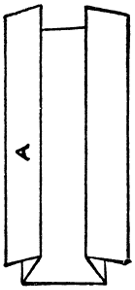
Fig. 1.—Paper folded.
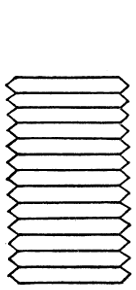
Fig. 2.—Paper pleated.
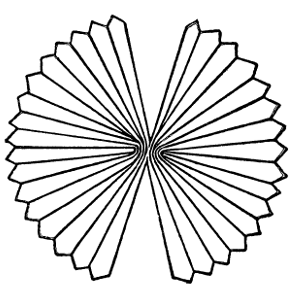
Fig. 3.—Rosette.
The paper must be marked out lengthwise into five parts; the central section being 12 inches wide and the two on each side 6 inches in width. The paper should next be folded along these lines (Fig. 1), and once again folded into a series of pleats, as depicted in Fig. 2. A convenient width for these pleats is 1 inch.
All being now ready for the first demonstration in Papergraphy, commence by forming a Rosette (Fig. 3).
[221]
Close up the pleated paper, and pull round the corners of each until they meet.
Table Mat (Fig. 4). Keeping hold of the ends of the rosette, stretch out the pleats as far as possible.
A Primitive Boat (Fig. 5). With the pleats still fully extended, turn each end up, almost at right angles.
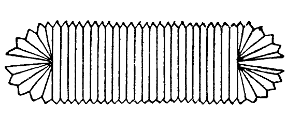
Fig. 4.—Table mat.
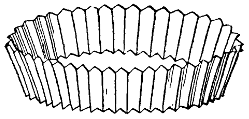
Fig. 5.—Primitive boat.
Church Window (Fig. 6). This is formed very similarly to the table mat, the difference being that one end is allowed to hang straight down.
Fan (Fig. 7). Close up the pleats and spread out one end in the form of a semicircle.
For the next series of transformations, the first fold (A, Fig. 1) must be opened.
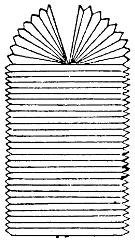
Fig. 6.—Church window.
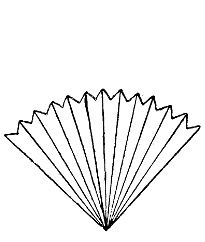
Fig. 7.—Fan.
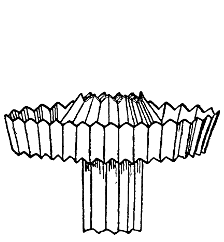
Fig. 8.—Mushroom.
Mushroom (Fig. 8). Pull both ends round to form a cylinder, with the open fold at the top.
Candlestick (Fig. 9). This is made by simply turning the mushroom upside down.
Clown’s Hat (Fig. 10). Press the top of the candlestick together, making it as pointed as possible, and place upon the head, with the folded bottom acting as a brim.
The second fold—on the same side as the fold already employed—must now be opened.
[222]
Flower Vase (Fig. 11). Keeping the two folds well open, pull the ends round, into the form of a cylinder.
Eastern Water-Jug (Fig. 12). Bend the paper round in the reverse direction to that forming the flower vase. Then close the bottom end, and place on the shoulder, as though carrying a pitcher.
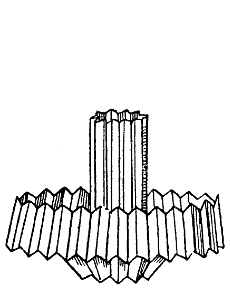
Fig. 9.—Candlestick.
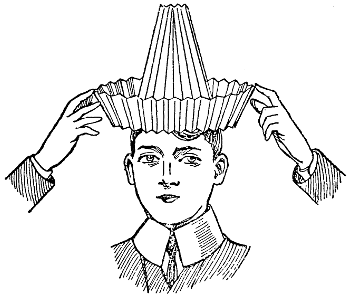
Fig. 10.—Welsh hat.
Chinese Mandarin (Fig. 13). Turn the Eastern Water-Jug upside down, and place it upon your head. Slight facial contortions can always be made with good effect whenever the three hats included in this list are formed.
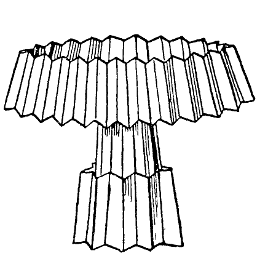
Fig. 11.—Flower vase.

Fig. 12.—Eastern water-jug.
The first fold (A, Fig. 1) must next be opened on both sides.
Sentry Box (Fig. 14). Pull round the two corners of one end until they meet, allowing the other end to hang down to its fullest extent.
Wash Bowl (Fig. 15). Pull round the corners of both ends until they meet, and press the pleats together.
[223]
Foot-Bath (Fig. 16). Still grasping the ends of the wash bowl, draw the pleats out as far as possible.
Fatigue Cap (Fig. 17). Turn the foot-bath upside down and place upon the head.
For the remaining papergraphs, all the folds must be opened.
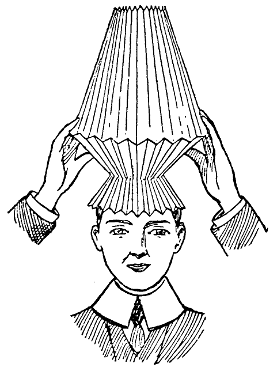
Fig. 13.—Chinese Mandarin.
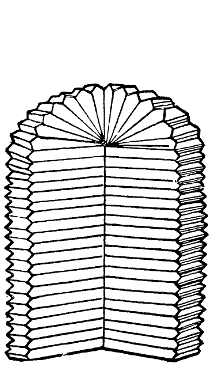
Fig. 14.—Sentry box.
Dumb-Bell (Fig. 18). With the folds open on both sides, pull the pleats round into a cylinder. Then grasp the dumb-bell by the center with your right hand, and bending your forearm, flex the biceps as though exercising.
Bon-bon (Fig. 19). Bend the paper round the reverse way to that forming the dumb-bell.
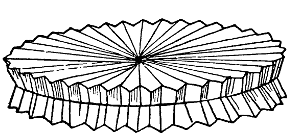
Fig. 15.—Wash bowl.
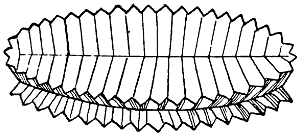
Fig. 16.—Foot-bath.
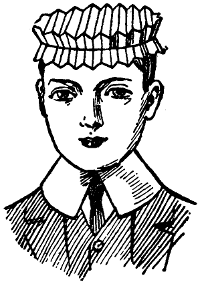
Fig. 17.—Fatigue cap.
Granny’s Cap (Fig. 20). Open out the pleats, and place the paper upon the head, pulling the sides down over the ears, to the chin.
After a little practice, all that it is necessary to do in order to give a successful entertainment is to learn the correct order in which the transformations take place.
[224]
For the first two or three performances it is a good plan to write out a list of the various “folds” upon a small slip of paper, which should be placed in such a position that a hasty glance can be thrown at it in case of the memory failing.
As will doubtless have been noticed, the different folds have been so arranged in the article that each transformation leads up to the next. It is therefore of great importance that the performer should remember their correct order. Otherwise he may suddenly find himself attempting to make a fold with only one pleat opened, when really three are required.
It is at such moments as these that the young entertainer wishes the ground would open beneath him, that a cyclone would whisk him away, or that any other phenomenon might occur which would carry him beyond the gaze of his inquisitive audience.
When making a fresh transformation, the performer should move his arms gently from side to side, and sway slightly from the hips—very much as though he were holding a concertina. This will lead the audience into the belief that he is engaged upon some extremely difficult fold, and will completely hide the simple movement he is really making.
If the performer is a good elocutionist, and possesses plenty of self-confidence, he might prepare some “patter” to go with the performance. An excellent alternative, however, is to ask somebody to play a dreamy waltz from the piano throughout the performance.
It will then only be necessary for the entertainer to make a few introductory remarks before commencing his “show”; to announce the name of each transformation as he makes it, and finally to thank the audience for the attention with which they have followed his few experiments in Papergraphy.
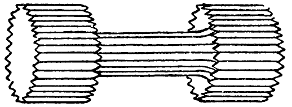
Fig. 18.—Dumb-bell.
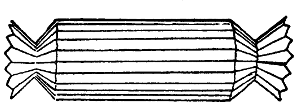
Fig. 19.—Bon-bon.
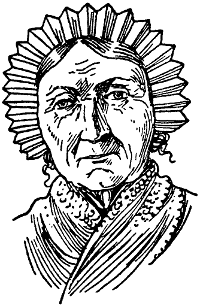
Fig. 20.—Granny’s cap.
[225]

Fig. 1.—The vertical fall.
There is no reason why any boy possessed of an average amount of dexterity should not be able to perform many juggling tricks after a certain amount of careful and patient practice. By a close study of the following instructions, a clear idea of the principles of the art can be obtained; and when these principles have been mastered, the beginner should have no difficulty in elaborating the tricks to suit his own fancy.
As the system of juggling with knives, plates, or clubs is founded entirely upon the methods employed in manipulating balls, the simplest plan is to learn the tricks with these last before adapting them to larger objects.
Any kind of ball may be employed for juggling, but the specially-prepared balls, made of heavy metal, are the best, and can be purchased for a small sum in a set of four from any dealer in games.
A ball should be thrown into the air in such a manner that it will descend to the exact point from which it was projected, as in Fig. 1. It is quite unnecessary to throw the ball higher than four feet. By an observation of the usual method of catching a ball, it will be noticed that the hand usually follows the course of the ball; but the great object of the juggler is to learn to catch without moving the hand from the position it occupied when throwing the ball into the air.
The great point of the vertical fall is to teach the beginner to move his hands as little as possible, and for this reason the exercise should be practiced with both right and left until such precision is acquired that the movement can be accomplished with the eyes closed.
[226]
The inside fall is done by throwing the ball with the right hand, in such a way that it describes a curve and drops towards the left, as in Fig. 2. But instead of catching it with the left hand, catch it with the right by a rapid movement of the hand across the body. The ball being held in the right hand, it should be thrown back from left to right in a similar way, as in Fig. 3. The latter is called the outside fall.
This exercise is intended to teach the beginner to throw the ball several times in succession from side to side without its deviating from its course. The principle involved is very important for jugglery, and must be thoroughly acquired before proceeding with other tricks.
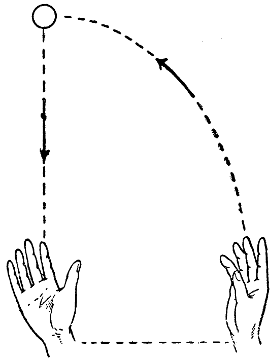
Fig. 2.—The inside fall.

Fig. 3.—The outside fall.
This fall presents greater difficulties. The ball should be thrown with the right hand, as in the vertical fall, although the hand must be kept in a line with the shoulder. As soon as the ball has been caught, the hand must be rapidly brought into line with the left shoulder, the ball thrown from that position, and caught (Fig. 4).
Having learned the trick with the right hand, it is essential to become accustomed to perform it equally well with the left hand, moving it to the right shoulder.
[227]
Both hands are required for these falls, which are simply an adaptation of what has just been described. The ball should be thrown exactly as described in No. 2, but instead of moving the right hand across the body to catch the ball when it falls on the left side, the left hand should catch it, as in Fig. 5, and should immediately return it by means of the outside fall to the right hand. But little practice is required to learn this perfectly, and when smartly performed it makes a pretty display.
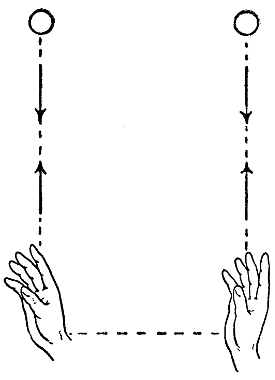
Fig. 4.—The parallel fall.
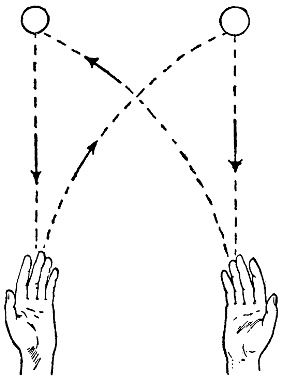
Fig. 5.—Falls from right to left.
In this exercise the ball should be thrown from hand to hand in as straight a line as possible (Fig. 6), whilst the beginner must endeavor, by continually increasing the distance between his hands, to maintain a rapid volley.

Fig. 6.—The horizontal pass.
[228]
This is the first trick requiring two balls, and will need some attention. A ball should be taken in each hand, and the simple vertical fall performed with the right. Before this ball has descended, however, the ball in the left hand must be thrown in the air, as in Fig. 7, so that the two balls are continually in motion. It is at this point that the juggler will find the advantage of being proficient in the use of both hands for the single vertical fall.
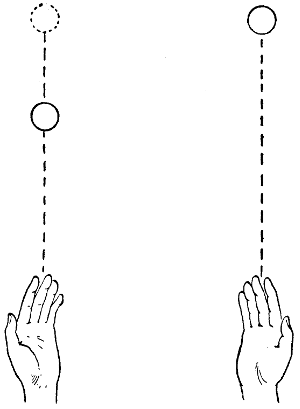
Fig. 7.—The double vertical fall.
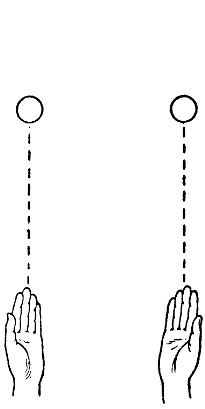
Fig. 8.—Variation of double fall.
A variation of this double fall can be acquired in the following manner:—
Both balls should be thrown up at the same time, as in Fig. 8, the hands being kept about two feet apart, care being taken that neither of the balls is thrown higher than the other.
The beginner must practice these thoroughly until perfectly accustomed to having the two balls in motion simultaneously.
This is a repetition of the outside and inside falls, but performed with two balls at once, and with both hands. The utmost care must[229] be exercised to avoid a collision as they pass one another, and for this reason one ball must be thrown higher than the other, as in Fig. 9. Until proficiency is attained the balls should be thrown at various heights, and the hands well apart.
Having acquired the last trick perfectly, the beginner should now bring into use a third ball. A glance at Fig. 10 will show that the triple pass is nothing but the double inside fall performed with an additional ball.
Two balls are held in the left hand, and one in the right, the former being numbered 1 and 3, and the latter 2. Ball No. 1 is thrown from the left hand, and as soon as it is in the air, No. 2 is sent off from the right, after which No. 3 is thrown from the left hand. It will be noticed from Fig. 10 that No. 1 is sent the highest and No. 3 the lowest, and by this means a collision can best be avoided. The greatest care must be taken to throw the balls regularly, otherwise confusion will ensue.
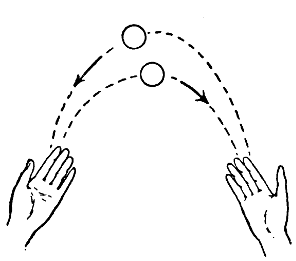
Fig. 9.—The double inside fall.
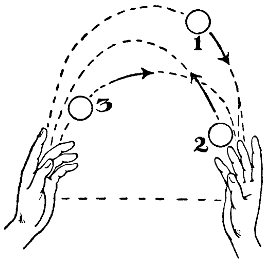
Fig. 10.—The triple pass.
To keep up the volley, each ball must be sent off again as soon as it has been caught, so that after the first throw neither hand holds more than one ball at a time.
The only difference between this and the Triple Pass is that each ball, as thrown, passes over instead of under the ball that precedes.[230] This is shown in Fig. 11, where No. 2 passes over No. 1, whilst No. 3 is thrown the highest of all. This trick is usually combined with the ordinary Triple Pass, and from the spectator’s point of view presents no difference.
This is one of the prettiest of all the tricks of Juggling, and should be learned with two balls. Take a ball in each hand and throw the right one in the air towards the left, whilst as soon as it is in the air pass the left hand ball to the right hand, as in Fig. 12. The moment this latter ball has been caught it must be thrown up in the wake of the first ball, and the whole trick continued as quickly as possible, so that one ball is always in the air.
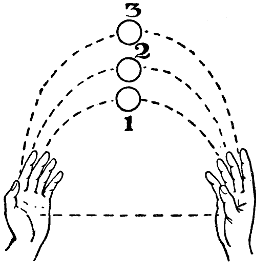
Fig. 11.—The triple over pass.
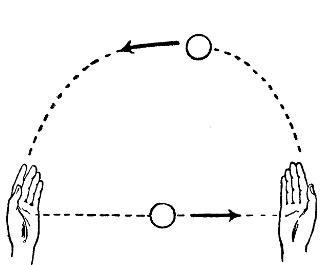
Fig. 12.—The shower.
This should be practiced continually until perfection is attained, as it forms an introduction to—
Two balls must be taken in the right hand, and one in the left. The first two should be thrown in rapid succession from the right to the left, the ball in the latter hand being passed to the right, as in the Simple Shower. As each ball reaches the left hand pass it rapidly across, as in Fig. 13, and start it off in the air once more.
The trick has the effect of making the spectators imagine that you have a large number of balls in your hands, and the more quickly the trick is done the greater the deception. By starting with three balls in the right hand and one in the left a still prettier display can be provided[231] with little extra trouble. In this case, however, the balls will have to be thrown rather higher to give the left hand more time to catch the balls and pass them successfully.
As a final exercise the beginner should learn—
Four balls are required for this, a couple being taken in each hand, Nos. 1 and 3 being in the left and Nos. 2 and 4 in the right hand.
Nos. 1 and 2 are thrown up simultaneously in the simple Vertical Fall, as in A, Fig. 14. The hands are then rapidly moved apart and balls Nos. 3 and 4 are thrown over the first two balls in such a manner that they cross each other and are caught in the opposite hands (Fig. 14). The volley with those two balls is immediately returned and the hands are brought nearer together to catch and throw Nos. 1 and 2 again. Thus the fountain is kept up indefinitely. It will be observed that the two hands constantly approach and separate, as the two sets of balls are caught in turn, and such action must be very smartly performed.

Fig. 13.—The triple shower.
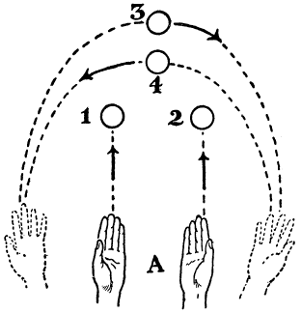
Fig. 14.—The double over fountain.
The substitution of clubs or knives for balls can be easily effected, although the performance is none the better for the change. In using knives, the juggler should see that the handles are well weighted to insure that part of the object falling into his hand.[232] The substitution of knives is not sufficiently interesting to compensate for the additional risk, and the amateur may very well dispense with them.
Plates and clubs are equally unwieldy, and the juggler can scarcely do better than content himself with the plain balls, the manipulation of which is certain to provide a pretty and interesting entertainment at all times.
[233]
Few things are productive of such literally breathless interest as plate-spinning. In what a state of agonized anxiety your audience will be as they watch you imperturbably spinning a soup-plate on the end of a rod. How they will catch their breaths as they expect it to fall, and how surprised they will be when it keeps its position! Yet if you inform them that it is not so difficult as it looks, you will be stating a fact, although the art is acquired only after considerable practice and at the cost of several plates.
To minimize the breakage of crockery it will be as well to begin your experiments with a mattress laid upon the floor, or failing this, with a good substantial down comforter. The first attempts will not then be accompanied by such mortality amongst the plates.
Procure a rod or wand upon which the plates are to be spun. A round stick, about 2 feet long, is the most suitable for the purpose. Care should be taken to see that it is straight, and it must be well sand-papered in order to remove any roughness (Fig. 1).
Fig. 1.—Spinning wand.
Now reduce one end of the stick to a dull point, which must further be prepared by a rather strange process. Place this pointed end in your mouth and moisten it until it is quite soft and all the hardness of the wood has been removed. When properly softened the fiber of the wood will remain whilst all the “starch”—if one may so call it—has disappeared. This preparation gives the stick a certain grip on the plate which is indispensable for successful spinning.
Next take a soup-plate, as in Fig. 2, and make it revolve rapidly upon the dull end of the rod. To do this the following instructions and hints should be noted.
The rod should have a rapid circular motion imparted to it by the wrist, so that it cuts a circle of about the same circumference as the soup-plate. The arm should be motionless, the whole movement[234] being confined to the wrist. The beginner must not expect immediate success, but after considerable practice the knack of describing the circle with the end of the rod will be acquired.
Now, by making these circles with the plate upon the end of the wand you will find that the plate itself begins to spin rapidly, and at length, when it has attained a certain velocity, it finds its center upon the point of the rod and revolves so steadily as to appear motionless (Fig. 3).
Practice spinning with the left hand as well as with the right, for in many cases it is necessary to transfer the wand from one hand to the other. Probably you will find greater difficulty with the left hand, but perseverance is all that is required—perseverance and the mattress!
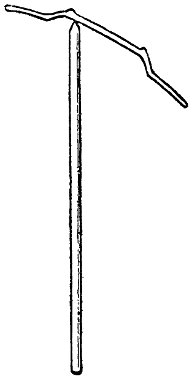
Fig. 2.—The first stage.
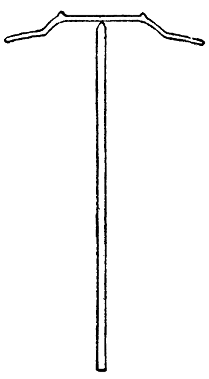
Fig. 3.—The plate finding its center—second stage.
It is a great mistake to choose a light plate for spinning. The heavier it is the easier it will be to spin, and you will find that dishes (not necessarily round) will be the best spinners of all. Do not forget that very heavy dishes soon tire the wrist and make it too unsteady for successfully exhibiting other tricks.
So far the modus operandi with unprepared and ordinary plates has been described. It is quite as well that the learner should begin with these, as the greater difficulty in balancing and spinning will have taught a lesson that will render him more at ease with the prepared plates.
Procure another wand, which need not be “softened.” Sharpen one end into a point, not so dull as in the former case, but with a clearly defined apex.
[235]
As to the prepared plates. Take for example a thick soup-plate. From the center of the bottom of this plate a small, shallow piece must be drilled away, as in Fig. 4, which represents a section of the article. Any china riveter will do this for you, and will, at your request, polish the cavity after it has been drilled. Explain the purpose for which you want it done, as that will insure his making the hole in the dead center.

Fig. 4.—Plate with drilled cavity for spinning.
You will now find that this plate not only spins much more easily, but will continue revolving upon the rod for a great while, even after you have ceased working the latter with your wrist. This is an important consideration in view of the balancing feats to be accomplished.
The next thing to practice is catching the plates in mid-air upon the tip of your wand. This is not so difficult as it sounds, and should be easily learned. Toss the plate upwards, as you do so giving it a smart turn or twist to the right, so that it revolves rapidly upon its own center while ascending.
Now bring the point of the rod under it, and as the plate reaches its highest point in the air it will turn over and you will have an opportunity to get the stick into the hole in the center. The plate will then spin upon the point of the rod, and a few turns with the wrist will increase its speed and keep it going steadily for a time.
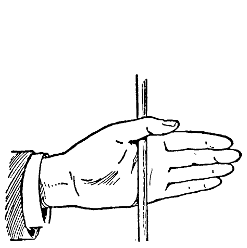
Fig. 5.—Holding rod for catching.
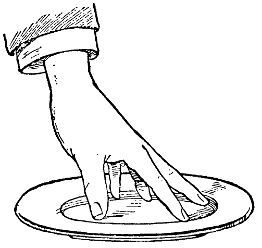
Fig. 6.—Plate ready for tossing.
Having mastered the principle of catching the plates in the manner[236] described, practice holding the rod and tossing the plate with the same hand.
Hold the stick near to the point and between the fingers and the thumb (Fig. 5), whilst the outspread fingers are in the bowl of the plate, as in Fig. 6. These are shown separately to give a clearer idea of the meaning. Now, toss the plate into the air, as has been explained, again giving the wrist a smart turn to the right. Bring the rod sharply into position and catch the plate in the usual fashion.
Take a couple of rods, one in each hand, and send a plate spinning on the point of the right-hand rod. By giving a sharp upward jerk you will send the plate high into the air, and upon its descent you can catch it upon the end of the other rod. If the plate has been tossed very high, and is therefore likely to descend with some force, care must be taken when catching it not to shatter it into pieces. As soon as the plate touches the point of the wand, lower the latter some distance with the plate, and thus break the force of the impact—instead of breaking the plate.
This performance will prepare you for successfully achieving the following very effective show. Two persons are required for it, however, and both must be good spinners.

Fig. 7.—Plate spinning and balancing.
Let each performer take a plate and a rod. Then both should spin their plates, and throw them to each other, catching the plates upon their respective wands. The volley may then be returned in the same manner, increasing the speed each time until the plates fly from one to the other like tennis balls.
The first attempts will probably result in a shower of broken crockery, but practice will obviate such a palpable disadvantage, and after a time you will be able to complicate the exhibition by taking a rod and plate in each hand, thus having four plates flashing to and fro at the same time.
Having graduated as a master of spinning and catching plates, the opportunity has arrived for attempting to balance the spinning dishes. This is largely a matter of knack, although a sure eye and a steady hand are indispensable.
Start a plate spinning on a rod, and pass it to the left hand. Do the same with a second plate, holding the rod likewise in the left hand, taking great care, of course, that the plates do not collide.
Now with the right hand start off a third plate, and balance the[237] rod upon your forehead or chin, having done which pass one of the rods back from the left to the right hand. This makes quite a pleasing exhibition, as can be seen by Fig. 7, and is well worth learning.
Presuming you are now facing the spectators, with the three plates spinning as in Fig. 7, the question naturally arises, how to stop the plates in a graceful manner? There are several ways of doing this, but the following will be found the simplest.
Lower the rods in the two hands simultaneously until the plates can be grasped in the fingers. Then, with the plate and rod still balanced upon your face, lay the two plates upon a convenient table, and taking one of the rods transfer the rod upon your chin to its point, and thus balancing one upon the other bring the plate to rest.
Supposing you have a plate spinning upon a wand, balanced upon another as in Fig. 8, practice the following method of dispensing with one of these rods.
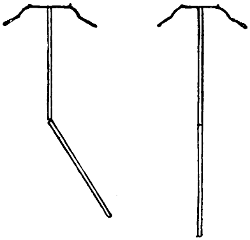
Fig. 8.—Plate being spun upon two rods.
By a sharp upward movement jerk the plate into the air from the point of rod No. 1. This will, of course, by relieving the stick of its burden, make it fall. You then catch the falling rod smartly with the other hand. But you must not forget during this time the plate which you have sent, still spinning, towards the ceiling. Upon its descent catch it neatly upon the tip of wand No. 2, and the trick is completed.
Such are the rudiments of the arts of spinning and balancing. Having acquired a thorough knowledge of the various exercises and feats described, the amateur spinner will have no difficulty in inventing new things for himself, and will be able to emulate the feats of professional jugglers. Much patience and long-suffering are necessary, but with a quick eye and a sure hand there is no reason why any person should not be able to provide a good plate-spinning entertainment.
[238]
There is a kindred branch of the art which may be described here, and that is plate waltzing. It is really nothing but an extension of the trick of spinning a coin upon the table, which every one has done at some time or other.
A perfectly level table is essential. To insure this it is a good plan to have a smooth, unpolished board that can be laid upon a table and made perfectly level by adjusting small pieces of cardboard at the corners. Around the edge a slight border should be made, rounded to the surface of the board, as shown in Fig. 9. This will prevent the plates from dancing off the table and on to the floor.
Fig. 9.—Showing section of table prepared for plate waltzing.
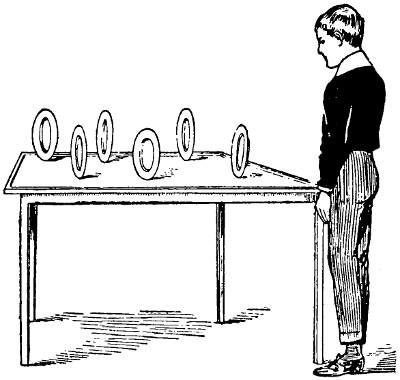
Fig. 10.—The plate waltz.

Fig. 11.—How to set the plate in motion.
Plates of any description and size, from the delicate tea-plate to the burly wash-basin are eligible for the dance (Fig. 10).
The following is the easiest way to start twirling a plate. Take a dinner-plate and stand it upon its edge on the table with the bottom of its upper edge resting against the extended forefinger, as in Fig. 11. Describe a small circle with this finger rather quickly, and the plate will follow its motion. Continue passing the finger round and round, accelerating the motion with each revolution. The plate will then begin to revolve very quickly. Take your finger away when it has acquired sufficient impetus, and leave the plate to dance by itself.
Begin learning with one plate. You will find that as it loses its impetus it begins to go slower and slower, tending to settle bottom upwards upon the table. But this is where your skill must be proved in preventing the fall from lack of momentum.
[239]
Whilst the plate is revolving and before the first signs of falling are apparent, touch the bottom of the plate fairly near the center with the tip of your finger, moving this latter round in the direction followed by the plate. This will have the effect of preventing the fall, and will send the plate dancing on with renewed vigor.
Considerable experience will be required to perform this successfully, as the exact spot to be touched with the finger can only be ascertained after much practice.
Large and heavy plates make the best dancers, and it will be necessary sometimes to use two fingers when preventing the fall, for the pressure must in all cases be firm and steady. An ordinary plate is better than a soup-plate, for not only is it more elegant, but its even poise renders the revolutions steadier.
Practice the use of both hands, remembering, however, that the plates will revolve in different directions according to which hand you use. The right hand will send a plate twirling from left to right, whilst the left hand causes an opposite motion.
The plates will keep admirable time to regular waltz music, and produce a pleasing effect. Keep your eye upon all of them, being ready to render assistance to any of your dancers that show signs of subsiding upon the table.
[240]
There are probably few actions more graceful than those of a skillful equilibrist. The necessity of maintaining a symmetrical posture and disposing the body in a well-balanced manner can produce nothing but a pleasing effect. To a lithe and healthy boy there are endless opportunities for creating new figures, whilst many will find an attraction in performing feats rarely attempted by any but professionals.
The whole strain of tight-rope walking is centered in the back. The rigidity of the legs is also an important factor in maintaining the balance. For this reason no child under ten years of age should ever be allowed to attempt anything of this sort, for his bones and muscles will not be sufficiently developed until then.
All the arrangements for a tight-rope exhibition can be made in an ordinary drawing-room. Very few fixtures are required, and the following instructions will give an idea of what must be done.
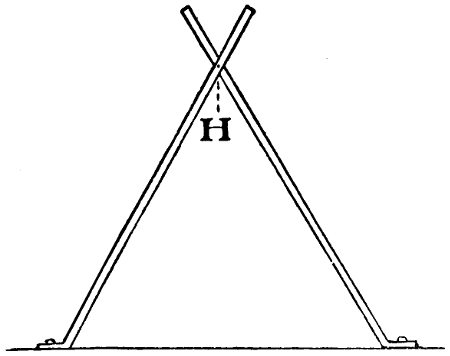
Fig. 1.—Method of fixing bars of wood.
The rope should be about four feet from the ground, although if the room is lofty the rope may be even higher. A length of good strong sash-cord should be used, and thoroughly tested before every performance.
Assuming that the rope is to be stretched at a height of 4 feet, the supports should be made in the following manner:—
Two stout bars of wood, not less than 1 inch in diameter and 6 feet long, should be fastened together in the form of an irregular St. Andrew’s Cross, as in Fig. 1. They must be fastened by running a bolt through them at a distance of 1 foot from the top. The lower ends should then be beveled off at such an angle that the bars will rest evenly upon the floor. To these beveled ends a metal plate[241] should be fastened, projecting outwards, with a hole through which a thumb-screw can be passed, as shown in Fig. 2. These plates, together with the metal screw-plate, which should be fastened over the holes in the floor, can be bought for a few cents from any hardware store. The cross-pieces can then be erected and screwed into position, as shown in Fig. 1.
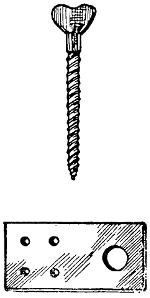
Fig. 2.—Metal plate and screw.
Strong hooks should now be driven into the floor just below the wainscoting and in a line with the screw plates. Lengths of very strong wire are to connect these hooks with the cross at H (Fig. 1). When it is remembered that these pieces of wire bear the whole strain of the rope, it will be evident that too much care cannot be exercised in making them secure and trustworthy.
A similar cross with its attachment must then be erected at the other side of the room where the tight-rope is to terminate. At the spot H of this latter cross a piece of bright-colored cloth should be fastened, for a purpose which will appear later.
The rope can now be stretched between the crosses, every care being taken to see that it is securely fastened and is not in the least slack.
To simplify explanation, the two ends of the rope, with their respective supports, will be called A and B, the latter having the piece of colored rag. In Fig. 3 will be seen the arrangements so far completed.
For the purpose of mounting the rope and resting between the turns, a pair of steps should be placed between A and the wall, and so adjusted that the top step is on a level with the rope, or even slightly higher, say at 41⁄2 feet.
There is much difference of opinion amongst acrobats regarding the balancing pole. Some prefer it long and heavy, whilst others dispense with it altogether. Amateurs can scarcely hope to do the latter, however, and 4 ft. 6 in. may be considered a suitable length. The pole should be smooth, round, and even, rather heavier than an ordinary broom-handle. It will probably prove useful to mark its exact center by a notch.
A mattress must be laid beneath the rope to break any falls. Thin-soled dancing pumps should be worn, the soles being well chalked before use.
Such is the apparatus connected with the public performance of[242] tight-rope walking. The first attempts should be, however, on a rope suspended much lower, not more than 1 foot from the ground, as it is useless to try a high rope until the knack of balancing has been acquired.
The assistance of two friends will be necessary for the first few trials. Each must hold a strap fastened around the performer’s waist to support him until he has learned to find the center of gravity. As he grows accustomed to the work their help will become less necessary, and he will soon be able to dispense with their services.
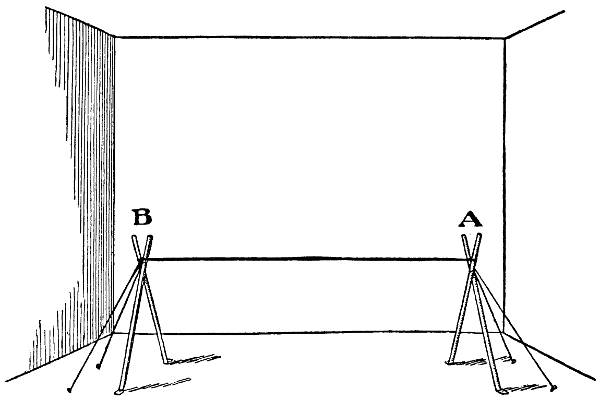
Fig. 3.—Tight-rope ready for walking.
With the pole balanced in his hands, his eyes fixed steadily upon the colored rag at B, known as the “point of sight,” and, supported by his two friends, the first essay is made upon the rope. The feet should be turned out as much as possible, and at each step the heel first and then the great toe placed upon the rope.
According to the recognized canons of the art, the first thing to be learnt is the “Forward Walk.” The gaze must never leave the “point of sight.” Each step must be made with the utmost care, and perfect confidence gained before any attempt is made at more difficult tasks. As soon as the feet begin to feel sore or tired, practice should be abandoned for that day.
[243]
The next thing to be learned is walking backwards. This is really no harder than the “Forward Walk” and can be as easily acquired. The eye should be steadfastly fixed on the rag as in the former case. With the amateur there is always a tendency to run. This must be checked, and a stately gait acquired from the beginning.
After the “Forward” and the “Backward” walks comes the “Forward Spring.” Both this and the “Backward Spring” are difficult, and can only be learned by constant practice and patience. There will doubtless be a price to pay in the way of harmless falls and stumblings, but everything can be learned in time. Indeed, few instructions can be given that would prove of any real assistance to the beginner. When once a person has learned to ride a bicycle, the matter of balancing comes naturally; so with rope walking. As soon as the tyro has gained confidence and experience on the rope, the difficulties of the “jumps” will gradually disappear.
Having learned the walks and leaps on the tight-rope, it only remains for the performer to adapt them according to his own ideas. The aim and object of every professional is to produce some novelty in his branch of the art, and the amateur must imitate him in thinking out some effective show to be produced “up aloft.” The great Blondin used to wheel out a barrow and cook his pancakes upon a rope suspended at an incredible height, and it is in ideas such as these that the art of successful tight-rope walking consists.
[244]
When the old Morris Dances decayed in the country districts of England, many of the local customs and manners died with them, and are now entirely lost; but what is considered a survival can yet be found, and is familiar to many of us under the name of Clog Dancing.
The old Morris Dancers had attached to their ankles bands of bells, which sounded with the jerking and kicking of the dancers’ feet as they kept time with the measure and music of the accompaniment.
The use of these bells has now, however, almost entirely ceased, and the heavy wooden clog alone remains. In place of the ringing and jingling, with which the Morris man accompanied his dance, the clog makes only a tapping against the floor, sharper in its precision, if less musical than the old bells.
The clogs suitable for drawing-room dancing have wooden soles and leather “uppers.” These can be obtained in endless variety, from the plain black or red morocco, to the stylish patent leather shoes.
But whatever the style or make of the clogs, one thing is essential—they must fit perfectly. The appearance matters little, so long as the clogs are an exact fit. Nobody present cares to see your feet, but everybody desires to see a skillful dance, and that cannot be performed with a loose shoe.
Having obtained the shoes, the next thing to arrange is the floor. A smooth wood floor, or a slate slab, provide excellent surfaces for practicing and learning upon, while for the actual drawing-room performance, a thick, smooth piece of wood, about two and a half feet square, and neatly polished, is very suitable. This can be moved at pleasure, and taken away after the performance is concluded, without any awkward rolling back of carpets or moving of furniture.
It is necessary now to devote a little attention to the more important steps to be learned. In the diagrams illustrating this subject[245] the letter R denotes the right, and L the left foot, and this must be constantly borne in mind to make the illustrations intelligible.
The first and most important thing to remember, is to keep the toes well turned outwards wherever the nature of the figure does not render this impossible. A glance at Fig. 1 will illustrate this. In all the steps practice with the left foot is needed more than with the right, as the latter can generally be trusted to take care of itself.
The first step to learn is the shuffle, which should be attempted with one foot first, preferably the left.
Stand firmly upon the right foot, and strike the left toe forward (as in Fig. 2) towards A, at the same time making a tap upon the floor. Draw it back from A towards B, making another tap. This should be done repeatedly until it is possible to make the taps in quick succession and in even time.

Fig. 1.—Correct standing position.
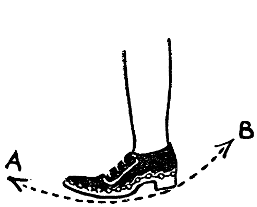
Fig. 2.—The single shuffle.
Having mastered this with the left foot, acquire the same proficiency with the right. The ankle must be kept loose and mobile. Any stiffness or inflexibility will utterly spoil all efforts.
Having become familiar with the two taps with both feet, attempts to use right and left alternately should be made, the while standing upon the toes. Thus: left forward and back, two taps; right forward and back, two taps, making in all four taps in rapid and even succession.
This is known as the single shuffle, and it is surprising how many music hall artists and public performers know no more than this rudimentary movement. Yet it shows how necessary it is to be perfectly[246] easy and familiar with the action, which may be considered, together with the double shuffle, as the ground-work of the art.
The double shuffle is simply a duplication of the single shuffle. Each foot goes forward and backwards twice, making four taps for the right and four for the left, or eight taps in all. This is really no harder than the single shuffle, and must be learned as thoroughly. Indeed, it is wise to practice no more steps until these two shuffles have been perfectly mastered.
Having grown familiar with the steps already described, it is time to learn some of the variations of the two shuffles. Begin with the single shuffle and
—Stand upon the toes of both feet, give one tap with the left toe, and a single shuffle with the right foot. Then one tap with the right, and a single shuffle with the left. Keep this up continuously, and as clearly and rapidly as possible, taking care that the beats are all equal, and that no one tap is louder than any of the others.
The result will be a continuous roll, like that of a drum, and is very effective.
—Give one tap with the left foot, and a shuffle with the right, as in the preceding step, then hop on the left, tap with the right, shuffle with the left, and hop on the right. This makes eight taps in all, and produces another continuous roll. By pausing on the hop each time, another step is apparently introduced, and the smooth action is varied pleasantly.
The hopping mentioned above does not mean a skip into the air. It is simply employed to give a tap, and is more for the sake of appearance than for actual sound. It can therefore be replaced by making a tap with the heel, which is in itself a prominent feature in the Clog Dance. Indeed the tap from the heel is often preferable as being more characteristic and elegant than the hop, which has to be done most gracefully to look at all well.
—Make one tap with the left toe, shuffle with the right foot, tap with the left heel, and bring the right toe behind the left foot, as in Fig. 3, A and B.
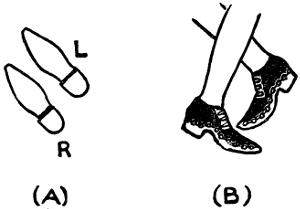
Fig. 3.—The third variation.
This must be learned carefully, and repeated in the opposite way—that[247] is, tap on right toe, shuffle with left foot, tap with right heel, and finish up by bringing the left toe behind the right foot.
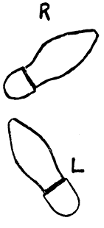
Fig. 4.—The fourth variation.
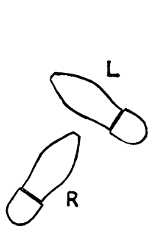
Fig. 5.—The fifth variation.
Practice both of these steps, and introduce them, one after the other, in the actual performance.
—Make one tap with the left toe, shuffle with right foot, tap the right toe, shuffle left foot, tap with right heel, and finish with the left toe behind the right foot, as in Variation No. 3. This should be learned and repeated in the reverse way to the former step, and the two should be similarly combined to make one continuous action, which is really elegant to watch.
—Make one tap with the left toe, a shuffle with the right foot, another tap with the right toe, then a shuffle with the left foot, a hop on the right toe, finishing with a tap with the left toe either behind the right foot, as in Fig. 4, or in front of it, as in Fig. 5. Learn to do this with the feet reversed as before.
If this step be done properly, the result will be a continuous rattle, which can be kept up indefinitely, the repetitions and reversals following one another without break or pause of any kind.
These variations require no detailed description. Wherever in the above-mentioned changes the single shuffle is mentioned, a double shuffle may be introduced. For example, in Variation No. 1, for the double shuffle the instructions should read: Stand upon the toes of both feet; give one tap with the left toe, and a double shuffle with the[248] right foot; then one tap with the right, and a double shuffle with the left.
By treating the other variations in a similar manner, it will be seen that ten variations of the single and double shuffles can be obtained. They should all be learned and practiced until there is not the least difficulty in performing any one or all of them.
There now remains but the Slide to be learned, and as this is one of the prettiest of all the clog steps, it is well worth taking pains properly to acquire.
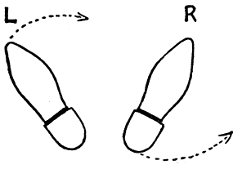
Fig. 6.—The slide (first position).
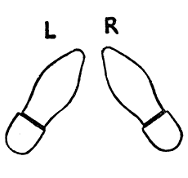
Fig. 7.—The slide (second position).
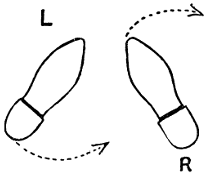
Fig. 8.—The slide (third position).
Stand as in Fig. 6, throwing your weight on the left heel and right toe, which are to be kept stationary. Now move the left toe and the right heel in the directions shown by the dotted lines. Your feet will then be in the position shown in Fig. 7. Keep the left toe and the right heel stationary, and move the left heel and right toe in the direction indicated by the dotted lines in Fig. 8.
By continuing this movement you have a steady gliding action from left to right, and, reversing the steps, you can, of course, move back from right to left.
This is really a hornpipe movement, but for clog dancing it is very suitable for the introduction of taps with heels and toes at every change of position. It is also possible to introduce shuffles during the movement, but the plain taps are probably more effective and quite difficult enough to learn without the introduction of more complicated movements.
[249]
It is possible to dance in clogs to any time, or even against time. Acquire the steps accurately and readily, and the measure will take care of itself. To practice the shuffles and their variations, the easiest plan is to have sixteen bars of music of two-four time, or even a verse of any song set to that time. As the feet become nimble and the actions familiar, you will be adept at dancing to any time or measure, whilst with shuffle and tap your feet will twinkle in the most orthodox and poetic manner.
Practice in the steps described will also enable you to invent movements for yourself, such as jumping in the air, striking the clogs together once or twice, rattling the clogs together on the ground, and numberless other side tricks and fancies. The regular steps are generally considered the best, however, and should always be executed when possible, as they form the essence and genius of the whole art.
Clog dancing is tiring, and it is advisable not to make the dance the central piece of an evening’s entertainment. It makes a good accompaniment or “gag,” but is not suitable for a pièce de résistance. Adroitly performed it will win approval; and what more can the home entertainer desire?
[250]
Few of us have not lain in bed by candle-light and with more or less success cast shadows upon the wall. Some may have seen public entertainments in which shadow pictures formed an important part of the programme, and have wondered in a dim kind of way how they were done. From what follows it will be seen how very simple are the arrangements, and how admirably adapted for a drawing-room entertainment a shadow theater can prove.
Shadow shows may be divided into three kinds. They are:—
1. Hand Shadows—in which the performer stands in view of his audience.
2. Figure Shadows—in which he stands behind a screen.
3. Puppet Shadow Shows—in which the shadows of lay figures are exhibited.
Of these three branches of the art, Hand Shadows are distinctly the easiest to do, but they do not give scope for great variety, and although very good in their way, like most good things, are apt to pall upon an audience, who, it must ever be remembered, have an insatiable taste for novelty and change.
A screen of white cloth about three feet square should be fastened to the wall and drawn taut, so as to have no fold or crease. A large sheet of perfectly smooth white paper will make an equally satisfactory background.
The best light for casting shadows is given by a candle, which should not be lighted until a minute or so after the lights have been turned out. This will have the effect of making its light appear all the more brilliant.
Before attempting to give an exhibition of the various shadows, exercise the fingers to make them pliable. Clench the fist and try to raise one finger without moving the others. Raise each finger in turn and they will soon become supple; then you may commence learning to make the pictures.
[251]
The candle should be on a level with the hand, and you must stand rather to one side of the screen, in order that your body may not interfere with the view of the audience.
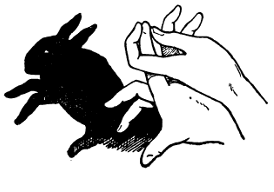
Fig. 1.—A rabbit.
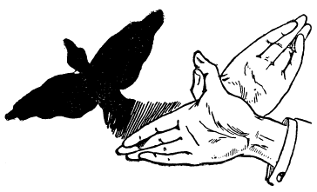
Fig. 2.—A butterfly.
In Fig. 1 you see the well-known rabbit, usually the first shadow made by the amateur performer. Stretch the right thumb down and the forefinger up as far as it will go, whilst the second and third fingers should be thrust out, slightly bent, as shown in the figure. With the left hand crook the forefinger against the upright forefinger of the right hand, bring the thumb to touch the last-mentioned finger, making a little loop as depicted. Stick the second and third fingers of the left hand upright, although slightly bent. Your two hands should now appear as in Fig. 1, and the shadow they cast will be that of a rabbit.
The butterfly in Fig. 2 is very easily made, and needs little explanation. Extend the thumbs of both hands, keeping the four fingers of each bunched together.
Then cross your hands with the thumbs crooked in one another, and the butterfly will be ready to flit on to the screen.
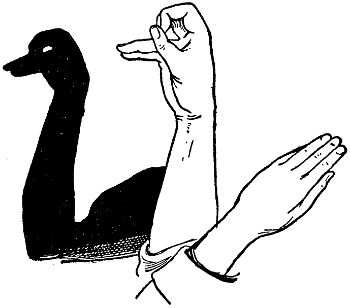
Fig. 3.—A swan.
To make the swan shown in Fig. 3, both arms must be partly[252] bared and the right one bent upwards from the elbow. Extend the third and fourth fingers horizontally, bend the first and second loosely upon themselves and bring the thumb to rest naturally upon their tips. Hold the left hand easily at the crook of the elbow, as shown in the figure, and the swan is complete.
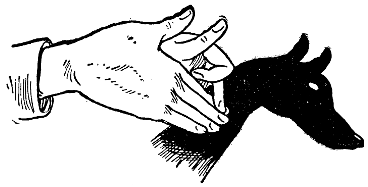
Fig. 4.—The greyhound.
Fig. 4 depicts a greyhound ready to sprint. Extend the right hand thumb and close the fingers together. With the left hand bend the thumb outwards, double the forefinger, and bring the middle finger down to touch the first finger of the right hand.

Fig. 5.—The hound panting.
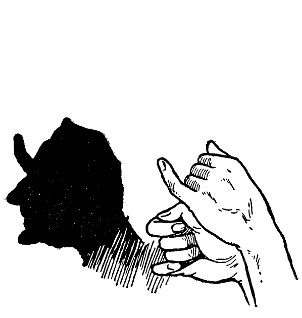
Fig. 6.—A countryman.
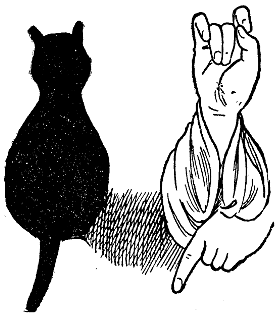
Fig. 7.—A fireside friend.
By stretching down the last three fingers of the right hand, as shown in Fig. 5, the greyhound will be seen panting as he races along, watched by the old countryman depicted in Fig. 6. The familiar household pet is shown in Fig. 7 as she sits warming herself by the fire.[253] Figs. 7A and 7B respectively suggest two other easily produced hand shadows, in the former, additional effect being lent by the pipe.
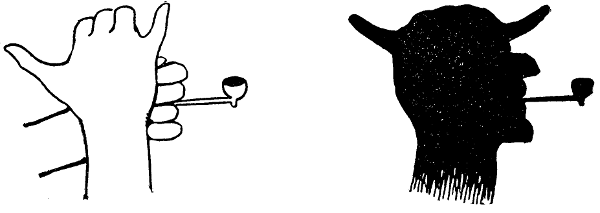
Fig. 7a.—The costermonger.
When you have accustomed yourself to forming these figures quickly and accurately, numberless other objects will present themselves to your mind, and as the fingers grow supple the characters in your repertoire will become more and more numerous and amusing.

Fig. 7b.—The parson.
A few racy remarks about each shadow lend an interest to the performance and serve to keep the spectators amused. Always be quite sure of what you are going to do and how you are going to do it; arrange your fingers quickly and correctly; do not keep the same figure upon the screen too long, and you are sure to succeed.
A mistake is fatal, as nothing is more dreary for the visitors than to watch you bungling with your fingers—uncertain how they should be placed.
These are, perhaps, more entertaining than hand shadows, but require much greater space, it being necessary to arrange them somewhat after the manner of tableaux.
[254]
A white sheet must be drawn completely over one end of the room, as S in Fig. 8, whilst near the opposite wall three boxes of varying height should be arranged as A B C in that figure, a candle being placed upon the middle one.
There should be no other light in the room, upon either side of the screen.
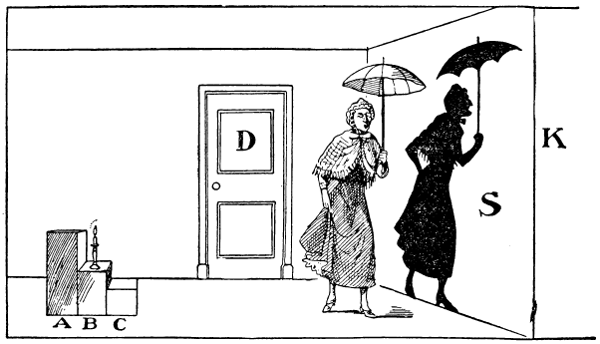
Fig. 8.—Arrangement of screen for figure shadows.
When the performer enters by the door D his shadow is thrown upon the screen in a natural size, but as he retires from the screen and approaches the candle, his shadow increases to enormous dimensions, and very funny effects will be produced.
A couple of performers may have a fight, the one near the candle apparently being of gigantic stature, whilst the other close to the screen is of ordinary build.
With a little practice it can be so managed that the two figures, although in reality at some distance from one another, appear to come to blows, and the incongruity of their respective statures makes the giant and dwarf fight of breathless excitement.
To add to the ridiculous situation, the giant can be given a knockout blow by the dwarf. A very small man can be made to make love to a huge woman, vainly endeavoring to reach her face in order to imprint a kiss upon her colossal lips.
Another amusing picture is to show a figure with a very swollen cheek. This illusion is best produced by tying a ball of worsted to the face. The dentist then approaches with a pair of large tongs in[255] one hand and a carving knife in the other, opening and closing the tongs with fierce relish. Grasping the patient firmly by the throat, he extracts a large molar, made of cardboard stuck between the worsted and the cheek. Then, brandishing aloft the cause of his client’s trouble, he slices off the swollen part of the sufferer’s features, detaching the worsted, and proudly exhibits patient and tooth to the audience.
A surprising effect to be obtained in these figure shadows is the total disappearance through the ceiling of one of the actors. This is very simply done by stepping upon the lowest box (C), striding over (B) which bears the candle, and on to (A) which makes the shadow appear to leap into the ceiling. Let a figure dressed as a policeman rush upon the scene, hotly pursued by a sailor brandishing a stout stick. The two chase each other about the stage for a time, and presently the sailor shouts very fiercely, “Get off the earth with you—get off!” and makes a savage rush at the policeman, who, casting one terrified glance over his shoulder, steps over the candle, and literally “gets off the earth.” The sailor then bursts into a roar of laughter, dances a hornpipe, and retires.
During all these tableaux a running patter should be kept up, which, combined with the fantastic doings upon the screen, cannot fail to keep the spectators in fits of laughter. Figure shadows are certainly the most amusing of any Shadow Shows, and are so easily done that fear of failure need deter no one from undertaking them.
Almost any play can be adapted to Shadow Shows; nursery rhymes, burlesques of well-known tragedies, purely farcical buffoonery—none will come amiss so long as there is plenty of action, whilst success is assured if all the actors concerned keep the ball rolling.
At the close of the entertainment, when the last piece has been finished, let one of the figures appear upon the screen and repeat—
This will please the grown-up members of your audience who have read Omar Khayyám, and will also serve as a suitable finale to the evening’s entertainment. Having said his little verse, the poet can then disappear into the ceiling.
[256]
To work a Puppet Shadow Show is more difficult than either of the preceding entertainments, and requires considerable skill and ingenuity to present satisfactorily. As the name implies, the shadows in this case are cast upon the screen by lay figures, and the performers, of whom two are requisite, do not appear at all.
The simplest way to make a “stage” upon which to exhibit your puppets is to stretch a strong piece of cord across the corner of a room, and hang therefrom a sheet which shall reach from one wall to the other. Some people prefer to stretch it across an open doorway, but this is largely a matter of convenience, and is not always possible.
Before fastening up the sheet mark upon it a rectangle, as shown in Fig. 9, the rectangle being five feet from the bottom, two feet high, and four feet wide.
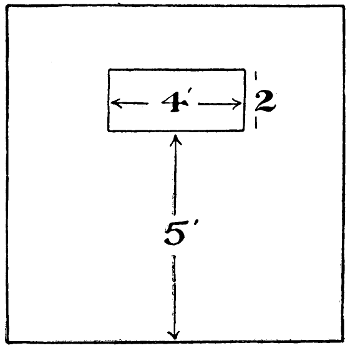
Fig. 9.—Diagram of screen for puppet show.
Now take pieces of thick brown paper and tack them over the remaining portions of the sheet, so that when completed it shall be entirely opaque, except for the rectangle or stage upon which your figures are to perform. The brown paper will, of course, be on the side hidden from the audience. The next thing to be considered is the lamp, which should have a tin reflector and a one-inch burner. Arrange it in such a manner that it shall hang in the center of the stage and some eighteen inches or two feet from the screen—indeed at just sufficient distance to allow you to manipulate your figures without coming into collision with the light.
If possible shut out all light except that which is thrown by the lamp upon the stage, as the darker the room the more effective will be the appearance of the shadows. Take great care the sheet is so firmly fixed that it neither flaps nor creases.
Having accomplished this, turn to the making of the puppets.
The best material from which to manufacture them is thin zinc or tin, waste scraps of which any tinsmith will gladly sell for a mere trifle. With a pair of shears the metal can be readily cut to any shape, whilst it will also be strong enough to bear the rivets for working the figures.
[257]
The puppets should be about six inches in height. This is the best way to make them. Draw the figure selected upon a piece of fairly thin white paper, taking care to accentuate all prominent points and features. Paste the figure—e.g. a crossing-sweeper—upon a piece of tin, and carefully cut the outline with the shears as in Fig. 10.

Fig. 10.—Partly finished figure of crossing-sweeper.
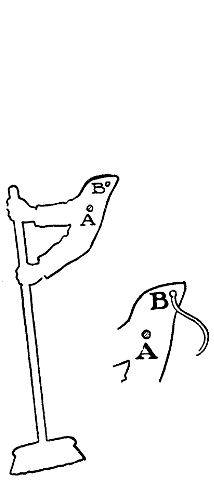
Fig. 11.—Constructing an arm and broom.

Fig. 12.—The figure complete.
Of course the puppets must be as comical as you can imagine, and should be neatly and accurately outlined. Notice that the figure has no arm, as this must be movable, and should be made separately, thus: draw the limb, holding a broom as in Fig. 11, cutting it out in the same way as you have done the body.
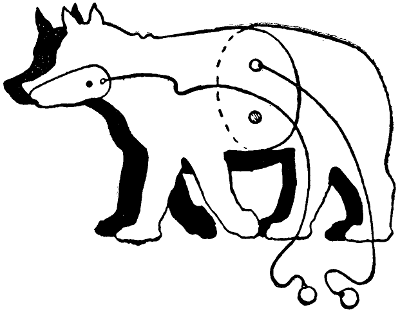
Fig. 13.—A bear.
Now take a punch and make a hole in the body at the shoulder, whilst two holes must also be made in the arm, as at A and B in Fig. 11. Get five cents’ worth of quarter-inch iron rivets, and place one in the hole B of the arm. Make a loop in a piece of No. 9 size[258] wire and place it over this rivet in the arm. Next bend the rivet with a pair of pliers, and fasten the wire as shown in Fig. 12. Put a rivet through A in the corresponding holes in body and arm, and bend the rivet head over as before. Your crossing-sweeper is now complete.
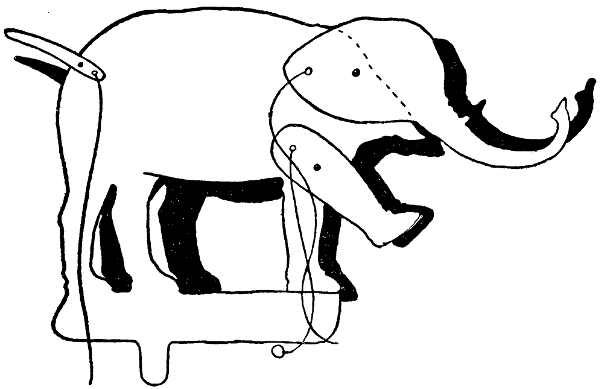
Fig. 14.—The elephant.
By pulling the wire, which should run down one leg, and thus be invisible to the spectators, the arm can be raised or lowered from below, and the figure will appear to be sweeping vigorously.
Upon this plan every other puppet may be constructed, making as many joints in a similar fashion as are required.

Fig. 15.—A crocodile.
Fig. 13 shows how to make a bear, which can rear upon his hind legs and also open his mouth. He will serve as an example for making all animals such as the elephant (Fig. 14), or the crocodile (Fig. 15).
Set pieces such as a church or a house can be easily constructed[259] from cardboard, as in Fig. 16, whilst a very good effect can be obtained from a windmill with movable sails (Fig. 17).
It is scarcely necessary to add that the puppets needed depend entirely upon the piece you desire to represent.
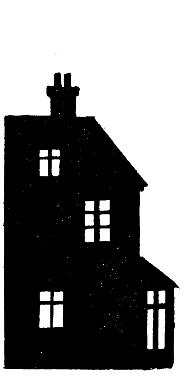
Fig. 16.—A house.
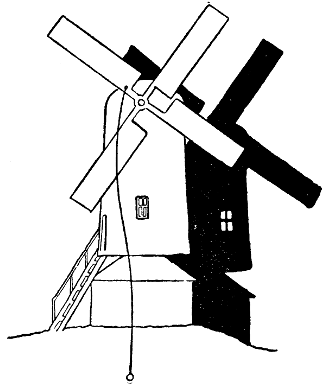
Fig. 17.—Windmill with movable sails.
Supposing it is your intention to exhibit three separate plays in the course of the entertainment, three different sets of figures will be required. The younger members of an audience are quick to observe any repetition.
The figures are made so easily and cheaply that it will be quite as well to have a complete set for each play.
The following hints should be borne in mind when manipulating the puppets. Keep all the figures ready for immediate use; lay them upon a table in the order in which they will be required, and remember where they are so that you can put your hand upon them the moment they are wanted. Keep your own head and fingers well out of sight—the whole effect will be spoiled if the spectators see a great black finger pulling some wire or adjusting a refractory limb. Keep as calm and collected as possible.
If some part of a figure sticks and refuses to move, tell the audience, in an amusing piece of patter, that Jim, or whatever his name may[260] be, has had a sudden stroke of paralysis, and must be carried away to the hospital.
When there is a hitch—and this will occur even with a professional—pass it off with a rattle of bantering fun, making the audience imagine it to be part of the show.
As the puppets are made from thin metal be careful never to turn them round upon the stage. March the figures off the scene with some quaint excuse, and introduce them again facing in the direction you desire.
It is impossible to lay too much stress upon the absolute necessity for the showman’s being ready with all kinds of patter. Funny as the scenes may be made with the figures alone, they are quite unentertaining unless all their doings can be explained with an unceasing tongue.
From the moment your first figure appears upon the scene, until the last one has made its exit, a continuous flow of amusing dialogue and comment should keep the audience on tenter-hooks of surprise and excitement—shrieking with laughter over absurd remarks or in an agony of wonder as to what will happen next. Dull and stupid as patter may appear upon paper, it should certainly be written down and well studied before beginning the show, for impromptu fun cannot be relied upon.
A lot of extempore humor can be introduced when you yourself have entered into the spirit of the show—but it is imperative that regular patter should be learned by heart. Nothing can be more tiresome than a halting conversation of which one party has forgotten the cues, whilst the other cannot remember the lines.
If you can sing, intersperse a song or two here and there when there seems a suitable occasion, but be rather sparing than otherwise with your music.
It may also be borne in mind that it is not necessary to have dialogue the whole time. A clever and amusing description of what is being done often proves better than a lengthy conversation in which the characters explain themselves. A few crisp remarks are worth a bookful of such speeches. However, when you are once fairly embarked on the play, let your puppets joke and abuse one another as much as they like.
To conclude with a few words as to what is suitable for the Puppet Shadow Theater.
The great object of every entertainment is to be funny without introducing vulgarity. The nature of the show necessitates fairly short pieces, and experience has proved that several short and amusing plays are more appreciated than one long piece, during the performance of which interest is sure to flag.
[261]
Choose commonplace incidents of everyday life. An inventive mind will soon adapt the ridiculous side of things to a screamingly funny show. Do not attempt too much. With a smart patter, full of current expressions and allusions to topics of the time, preferably local, which all your audience can appreciate, the most casual events become laughable.
Take, for instance, the well-known family trouble—
Figures.
Mrs. Hoggins.
Mr. Plapper.
Jim, the Plumber.
Robert, the Policeman.
Bridget, the Maid.
With these five characters and a suitable amount of talking an amusing sketch can be given. The following is a mild suggestion of what can be done, but you will find that it can be made very much funnier when actually performed.
Scene, a House (Fig. 16).
Mrs. Hoggins emerges, loudly complaining that a pipe has burst and spoiled her nice new carpet. She blames everybody in the neighborhood, not omitting Mr. Hoggins, who is in town. “Just like a man: never here when he is wanted.”
She calls Bridget, and tells her to run for the plumber. Bridget seems unable to understand. “Sure, Mum, and the grocer came this mornin’ and ye didn’t want any fruit!” Mrs. Hoggins then explains matters with considerable volubility, and Bridget departs.
Mr. Plapper rushes out, waving his arm, and complaining that his house will be ruined by the overflowing water. The drawing-room ceiling has already come down. He sees Mrs. Hoggins, and asks her heatedly what she means by it. That lady replies suitably, and they wrangle until the plumber comes, when Mr. Plapper retires with a few sarcastic remarks.
Jim, the plumber, listens to Mrs. Hoggins’ explanation, and disappears into the house to see what he can do, only to reappear in a moment, remarking that he must go home to fetch his hammer. He accordingly leaves the stage.
Mr. Plapper returns with a policeman, relating matters so excitedly that Robert is not quite sure whether it is a case of fire or merely a murder. He enters the house, and Plapper abuses the plumber, who, returning at this moment, thoroughly enters into the spirit of the fray.
[262]
He also goes into the house, but comes out immediately, having suddenly remembered that it is time to go to dinner.
Mrs. Hoggins appears upon the scene once more, and encounters Plapper, who asks: “Well, Ma’am, and what have you done about it?” “Done? If you would do something, instead of standing there talking like a monkey, perhaps we should know where we are.”
In an interval of the conversation a loud sound of kissing is heard, and Mrs. Hoggins demands what it is. “Water oozing through my ceiling,” says Plapper. Mrs. Hoggins laughs satirically and retires. She apparently finds Robert making love to Bridget, for he suddenly appears running out of the house very hurriedly, followed by the fiery remarks of Mrs. Hoggins. He is making a few rejoinders when Jim, the plumber, returns just in time to say that his wife is expecting him home to afternoon tea. A general chorus of excited abuse is then heard, in which Mr. Plapper joins from the background. So Jim walks away, saying that he will cut all the water off, leaving them nothing to drink, let alone wash in, until next day.
This may seem very poor fun, but when staged and supplemented with good strong patter it should be most amusing. Opportunities always arise for introducing smart remarks and witty rejoinders, which cannot fail to “bring the house down.”
Complete sets of figures, with the various plays for which they are intended, can be purchased from all good shops making a specialty of entertainment requisites, but it is more interesting to make everything for oneself; and the prospective shadow showman may feel assured that, with care and patience, he will be able to give a performance that, costing but a dollar or two, will prove quite as entertaining as one purchased at many times the sum.
[263]
An exhibition of skill which cannot fail to win appreciation from any audience, particularly one composed largely of grown-ups, is that of making lightning cartoons and sketches. It is, however, a form of entertainment which should be undertaken only by those possessing some artistic qualifications. Although lightning cartoons do not call for any great genius, yet those with an inherent taste for caricaturing will find themselves the best exponents of the work.
On the other hand, the task may be undertaken by any youth with even a moderate knowledge of drawing, because by the observation of the few rules hereafter indicated, quite passable and pleasing results may be obtained. The apparatus required is simple and easy to procure. The first essential is a cheap easel, which can be purchased for fifty cents from any art store. To give it a presentable appearance for a drawing-room entertainment, it should be stained with any oak or mahogany composition. Those who possess a bent for carpentering will perhaps prefer to make their own easel. It can be made from 2 inch battening. First cut two pieces to the required height, and glue or mortise together with two stays, A and B (Fig. 1). Drill holes for the reception of pegs at CC. A further length, D, will also be needed for the back stay, hinged at E. F shows a section of the hinging.

Fig. 1.—Easel for lightning cartoons.
The next requisite is a large drawing-board. Half-a-dozen large[264] sheets of cheap cartridge paper should also be procured. These latter may be fixed to the drawing-board by nails driven firmly into the top right- and left-hand corners in such a manner that each sheet can easily be removed after it has been drawn upon. The media employed for plain black-and-white drawings are thick sticks of charcoal or soft crayon.
It should be borne in mind that as lightning sketching permits of no erasures, each subject must be thoroughly committed to memory before a public demonstration on the paper is attempted.
The best subjects for a beginner to attempt in black chalk or crayon are caricatures of celebrities, those selected all possessing some particularly marked or prominent feature, e.g. the late Mr. Gladstone, with his remarkable forehead, striking nose, and the characteristic high collar.
Idiosyncrasies of well-known people should also be seized upon; for instance, the eyeglass and orchid so universally associated with Mr. Joseph Chamberlain. It will be found that if these peculiarities are properly portrayed and accentuated, but very few strokes of the crayon will suffice to produce an unmistakable likeness. The budding cartoonist should also bear in mind that boldness of execution is essential, the strokes being put to paper with free and large sweeps of the hand.
The subjects intended to be drawn must be selected beforehand, the order of their appearance also being prearranged.
To obtain the correct mental picture of each character or subject, it is at first recommended to attempt only heads. Let the young cartoonist first procure a pronouncedly good photograph, in profile preferably, and copy this in detail, gradually omitting half tones or shadings until the likeness is apparent when only the minimum of strokes is used. As soon as the ability to do this has been thoroughly acquired, the outlines should be drawn again and again until the hand has become so accustomed to the correct presentation of the portrait that it can draw it off in a second or two. The lightning cartoonist must live up to his reputation for speed.
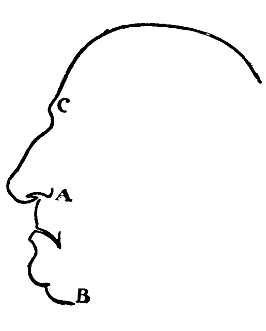
Fig. 2.—Method of drawing in leading characteristics.
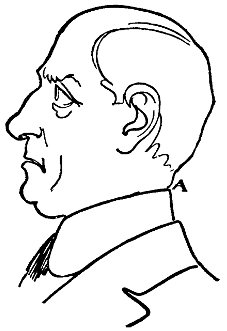
Fig. 3.—Complete cartoon.

Fig. 4.—Showing characteristic features drawn in first.
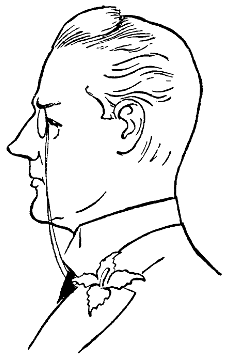
Fig. 5.—The final stage.
Now, to treat with the order in which the various features and leading characteristics are to be drawn in. A start is generally made with the curve above the nose, taking the stroke down and round to the nostril (A, in Fig. 2); then the upper lip, mouth, and chin (B), if possible, without breaking the line. Next take the chalk and draw the crown of head and curve of forehead, beginning at the right-hand top of head, presuming the face to be in profile to the left. With a sweeping stroke draw in either the outline of the hair or bald head, coming back to the forehead and finishing at the point from which the[265] start was made (C, Fig. 2). Now, leaving the outline of the face, return to the point at which the curve for the hair or head was started, and bring round another bold sweep down into the nape of[266] the neck (A, Fig. 3). Shading may be put in according to judgment. The eye must next receive attention, afterwards the ear, and, lastly, the collar or any other distinguishing mark.
A welcome variation to the above is produced by a brief exhibition of simultaneous drawing with both hands. The best method of procedure is to take a piece of chalk in each hand, and, bringing them together in the middle of the top of the drawing (A, in Fig. 6), take each hand round and down, the right hand drawing the profile, the left the back of the head, and so complete the picture by working off the lines respectively on the right side with collar and tie, and on the left with the neck and back of coat. In Fig. 6 the dots show the other lines necessary to complete the effect.
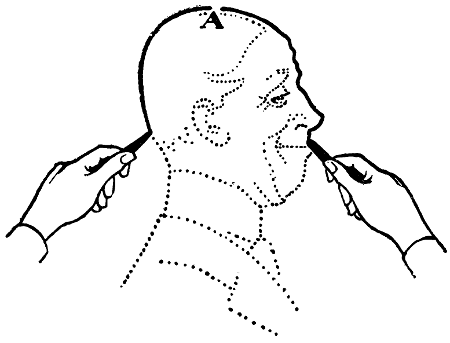
Fig. 6.—Simultaneous drawing with both hands.
Another diversion may be caused by drawing at lightning speed a figured face. How this is to be accomplished is not at first apparent when you sketch in to all intents and purposes at random a few detached numerals, such as appear in Fig. 7; but the addition of extra figures produces the very expressive countenance depicted in Fig. 8.
[267]
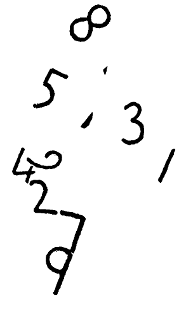
Fig. 7.—Figured face partly finished.
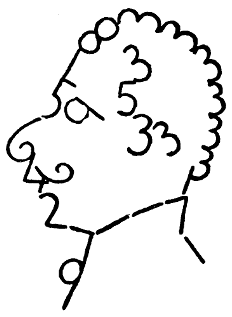
Fig. 8.—Figured face complete.
A deal of fun may also be extracted from outline representations of an egg. Commence by sketching in with quick strokes three or four of these. Fill in the individual expression of each by such series of lines as are suggested in Figs. 9 and 10, and as a climax pin to each a suitable paper costume or fancy collar, frill, or tie, as shown in Figs. 11 and 12. These latter aids to the equipment of the lightning cartoonist must be prepared beforehand from colored tissue paper, kept behind the easel, and instantaneously fixed on to the large sheet of cartridge paper by means of pins. The effect will be both novel and grotesque.
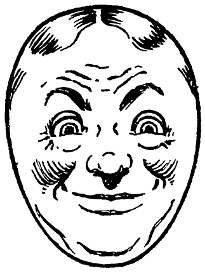
Fig. 9.—A cheerful “eggspression.”
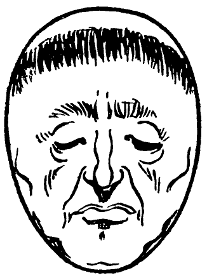
Fig. 10.—A mournful “eggspression.”
[268]

Fig. 11.—Egg drawing complete.
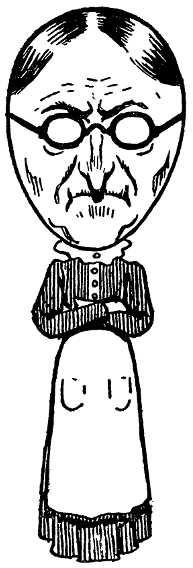
Fig. 12.—Egg drawing complete.
To produce wonderfully picturesque and striking examples of land and seascapes in the space of a few moments of time appears at first sight a task almost beyond the capabilities of the amateur draughtsman. Yet such effective additions may be made to the programme of the lightning cartoonist by his following out the subjoined simple instructions.
First procure a large sheet of iron or tin, enameled white. To purchase this in a prepared state is rather expensive, but a very fair substitute can be made by coating the tin or iron with ordinary white enamel.
Smoke the enamel surface to a uniform blackness by passing it backwards and forwards over an ordinary small hand-lamp, the glass chimney of which has been removed. Fix the black sheet to the easel, either resting it on a wooden rack or across the pegs.
[269]
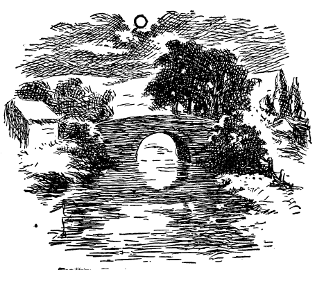
Fig. 13.—Sketch to memorize for smoke picture.
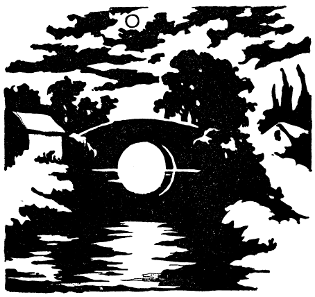
Fig. 14.—Completed smoke picture.
[270]
Before commencing on the actual drawing, memorize a suitable subject, such as a stretch of water gleaming under the moon, with light reflections, as in Fig. 13. The effect of the finished picture may now be obtained by wiping out the black so that the white enamel shows through and forms the lights. The removal of the black may be accomplished either with the fingers or by means of a soft piece of rag. In view of the fact that the fingers form a better medium for drawing than does the rag the use of the former is recommended, but as the cartoonist may have arranged to follow this part of his entertainment with other drawings on white paper, he would do well, while dealing with the smoked surface to cover his finger-tips with stalls cut from old kid gloves. These can be discarded without the necessity for a break in the performance, as would be the case were the fingers blackened in the process. Fig. 14 shows the finished smoke picture produced from the sketch in Fig. 13.
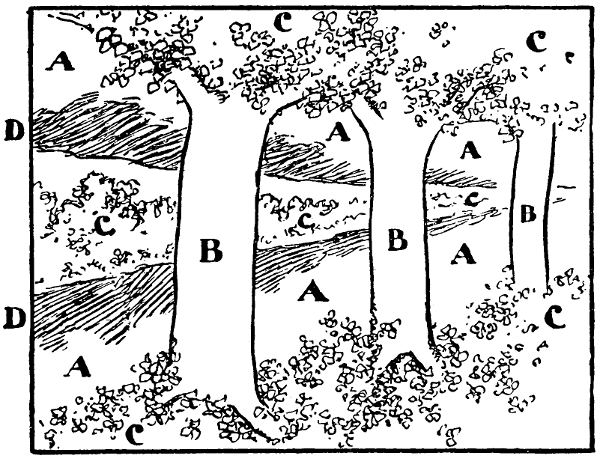
A. Blue. B. Brown. C. Green. D. Dark green.
Fig. 15.—A reversible scene.
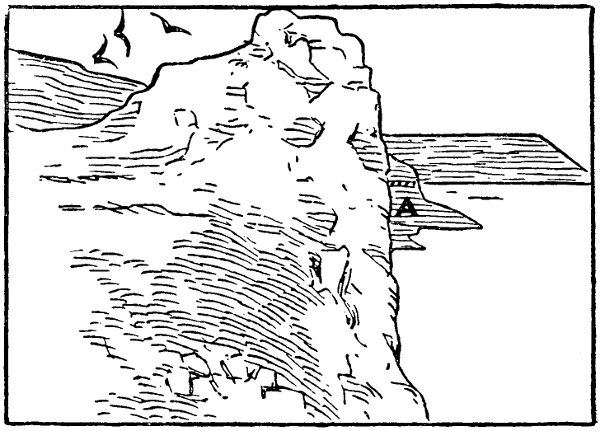
Fig. 16.—Initial sketch for “house on the cliff” drawing.
Yet another variation in lightning cartooning is provided by the ability of the artist to produce pictures which, when turned upside down, show exactly the same view. These are best done in colored chalk or pastel, which is a softer medium and more[271] workable. Landscapes are peculiarly adaptable to this purpose. Fig. 15 suggests a realistic example.
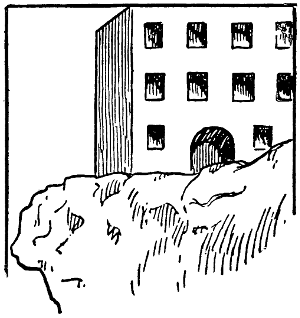
Fig. 17.—House on cliff drawing completed.
Yet a further pleasing addition to the entertainment may be made by sketching such a scene as Fig. 16 suggests, afterwards over-coloring with white the part representing the sea, and also the jutting rock marked A up to the dotted line; then turning the whole picture on end, blacking in on the whitened portion windows and doors, as shown in Fig. 17. The result will be “The House on the Cliff.”
A very interesting entertainment is to be brought to a close by a short exhibition of shadow drawing. The apparatus required is a magic lantern, before the lens of which is fixed a prepared plate consisting of glass previously covered with a coating of lamp-black and water. A sheet of calico should be attached, some distance away, to the wall. Between the plate and the lantern, and a little to one side, stands the operator, who with the aid of a stick or stump sketches the subject upon the plate, the light filtering through throwing an enlarged presentment of the picture upon the calico screen.
[272]
Electricity may be said to have a finger in most pies. From its manifestations it would appear to be an all-pervading force, and modern research tends always to substantiate this conclusion. Thus two coins—a cent and a quarter—cannot be brought into contact without producing their quotum of electrical force, and in like manner the principles of its working may often be demonstrated by the simplest apparatus.
There are two states which this subtle force assumes, called Static and Dynamic. The former word indicates a condition of rest, and is applied to electricity when stored in suitable magazines ready for discharge at a favorable opportunity, just as water may be held in lofty reservoirs, ready to pour down and perform work—whether useful or otherwise—if the pipes be opened. Dynamic, on the other hand, indicates a state of motion; so that Dynamic Electricity means that it is flowing along conductors from one place, where there is a large quantity of the force, to another less powerful, in the same way as—again using the comparison with water—the latter pours along connecting pipes from a high level to a lower. Phenomena of static electricity are invariably produced by friction, and some experiments of this class will be first described.
The chief element of success in friction electrical experiments is a warm and dry atmosphere. The operations should therefore be conducted in a well-ventilated room where the fire has been burning some time, whilst all apparatus may with advantage have stood warming for some time before.
1. Rub a 6-inch square of brown paper with a warm silk handkerchief, then place flat against the wall or marble fireplace. It should cleave tightly to either of the latter surfaces.
2. Again electrify the brown paper and hold it above any willing person’s head of hair. The locks will fly up towards the paper and appear like bristles. You may then make sure of a safe retreat, and utter side remarks about “wire.”
[273]
3. Sprint smartly after the cat, which, like the other apparatus, should have been warming itself on the hearthrug, and having effected a capture, stroke the fur backwards. If the hand be not moist, considerable sparking should occur and be easily visible in a darkened room.
4. By combing dry hair quickly with a warm ebonite comb, and then applying this to the knuckles, distinct sparks may often be obtained.
5. Cut a piece of paper into small confetti, and place near it a stick of sealing-wax or ebonite rod, which has been rubbed with flannel. The paper atoms are attracted to the rod through a distance of one inch or more, and then, contact having once occurred, they immediately drop off.
6. In the previous experiment it was found that the paper atoms having once touched the rod, dropped off directly. This behavior was caused by a sequence of happenings.
First the negatively excited sealing-wax caused positive charges to possess the upper surface of the paper—the equal negative charges being driven downwards—so that, the two kinds of electric energy having a mutual affinity, the paper sprang towards the wax. Immediately they touched, however, the positive charges of the paper were neutralized by the large excess of negative energy from the sealing-wax, and then, since electricities of like sign exercise mutual repulsion, the negative paper was driven from the negative wax.
Now this repulsion of similarly charged particles is demonstrable by a straightforward experiment, whose simplicity of description is in nowise proportionate to its entertainment. In truth, it consists merely of blowing a soap-bubble and catching it upon an excited stick of glass or wax. The bubble becomes electrified, its myriads of particles repel one another, and the beautiful globe expands in size, possibly to breaking point.
7. Scratch any design or word upon a small sheet of indiarubber—such as is used in the manufacture of mats—and then dust over the surface a thoroughly-shaken mixture of red-lead and sulphur. When all excess of the powder has been blown away, the design should appear in grains of red-lead, showing to excellent effect on the gray rubber ground.
8. By the following method a spark of sufficient intensity to light house gas may be obtained from brown paper. Support a salver on four well-dried inverted tumblers, placing a rubber ring between the tray and each glass, and twist a copper wire round a spoon which rests on the tray. The other end of this wire must be held—insulated from the fingers by a piece of indiarubber or by the ordinary covering[274] of the wire—just over the gas-jet, whilst about 1⁄8-inch away is held another piece in metallic connection with the hand; that is, in reality, via the operator’s body with the earth.
Now, if the gas be turned on slightly and a piece of warm brown paper, electrified by stroking vigorously with a dry brush, be placed on the salver, a spark should pass across the 1⁄8-inch gap and ignite the escaping gas. If the spark does not pass at once, approach the wire extremities slightly closer together.

Fig. 1.—Raising paper by touching wooden lath with electrified sealing-wax.
9. The following experiment owes its origin to Gray—an early worker in the field of static electricity: Erect two dry tumblers with a piece of waxed cardboard between, after the fashion shown in Fig. 1, and lay a lath on the top glass. Beneath one end of the lath spread small pieces of paper, over an ebonite or wood surface supported on another inverted glass. Then if a stick of sealing-wax, which has been vigorously rubbed with flannel, be approached to the other end of the lath, the particles of paper will fly backwards and forwards between the lath and the ebonite surface—on which they would normally rest.
10. A simple trick, but one nevertheless causing considerable amusement to spectators, may be arranged in the following manner: Bore a hole carefully at the middle of a wooden meat skewer (A, Fig. 2), of such size as to take a bone knitting-needle tightly (B, Fig. 2).
Sharpen the blunt end of the skewer and mount it so as to turn easily between bearings erected on inverted wine-glasses. These may consist of two wood blocks (C, Fig. 2), in each of which a[275] shallow conical hole is made to receive the points of the skewer. On these stand weights (E, Fig. 2) to keep wood-bearings firm. When this is in position and swings easily, adjust the needle until it balances exactly. It should be at right angles to the skewer, and may be fixed in position, if necessary, with glue or sealing-wax.
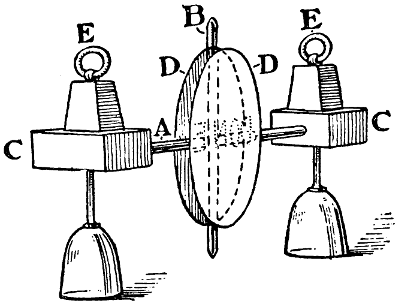
Fig. 2.—The balanced disc.
Now cut two discs of white paper (D, Fig. 2) of a diameter about 1 inch less than the knitting-needle’s length, and, having printed across one the word “DONE” in large type, glue them—centers at the point where the needle and skewer intersect—on either side of this cross. Erect the apparatus as shown, so that the needle stands vertical, with the blank paper disc facing the audience, and then invite the latter to see if they can effect a movement without either touching or blowing the disc or creating any disturbance whatever. The conditions should preclude any person, except the canny operator, from attaining success. He, however, innocently takes a postcard (previously warmed and dried), tears it sharply in half, and presents one ragged edge to the projecting bone needle. The cardboard became electrified by tearing, and should exercise quite enough attraction on the needle to upset its nice balance, whereupon the other disc becomes visible, together with its notice “DONE.” The audience may take the ambiguous meaning according to their pleasure.
Few further experiments can be performed without the use of special apparatus. So far, we have dealt only with the most minute quantities of electricity, and if more striking effects are to be produced, our stores of energy must be increased.
Fortunately instruments of a fairly wide application may be rudely constructed at home, although, naturally, results must not be looked for comparable to those obtained with perfected apparatus. However, brief directions now follow for the manufacture of such simple instruments, and so, as commencement, let us appropriate two 3-lb. jam pots from which Leyden jars are to be evolved.
[276]

Fig. 3.—Leyden jar.
Procure as much metal foil as possible, either by raiding the nursery or by purchasing some tinfoil-wrapped butter scotch at the confectioner’s, and gum it round the jam jars so as to extend about half-way up the outside (A, Fig. 3).
Next solder stiff brass wires (8 inches long) to two round pieces of metal, so cut as to pass the jar mouths readily. To the other end of one brass rod solder another disc of metal, tin—or, better, brass—nicely smoothed along its two edges by sandpaper. The other brass rod may be looped at its end and have tinfoil wrapped round until a respectable knob be formed, or else have a brass bedstead globe soldered on.
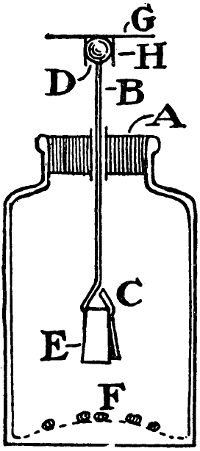
Fig. 4.—The electroscope.
These brass standards are then stood inside, with their metal bases resting on the bottom of the jars and surrounded by lead shot to the same height as that of the tinfoil, without. The finished article should appear something like the sketch shown as Fig. 3.
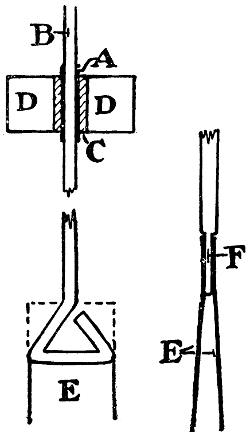
Fig. 5.—Electroscope parts.
Obtain a square glass pickle or preserve jar, to the mouth of which has been fitted a large cork bung (A, Fig. 4). Next take a 7-inch length of 1⁄8-inch brass wire (B, Fig. 4) (similar to that used for the Leyden jars above), and flatten one end by hammering (F, Fig. 5), after having bent it triangular-shape, as in (C, Fig. 4).
A 21⁄2 inch length of cycle valve-tubing (A, Fig. 5) is to be slipped over the brass rod B (Fig. 5), and then strips of gummed brown paper, 2 inches wide, lapped round and round the rubber-tubing until a paper cylinder some 1⁄4-inch across the outside is formed (C, Fig. 5). Anyway, this paper cylinder must be a good fit for a hole bored through the center of cork (D, Fig. 5), into which, moreover, it must be glued when dry. The stopper, paper, &c., must then be allowed to soak in hot candle wax for an hour or so, wiped clean and put aside to cool. Excess of grease must be particularly removed—with paraffin if necessary—from the plain end of the metal rod, to[277] which we must next solder a brass knob (D, Fig. 4) or, as an alternative, tinfoil may be twisted round a loop in the wire until a ball is formed, as in the case of the Leyden jar.
The next operation is to cut two strips of Dutch metal—or, better, gold leaf—size 3⁄4-inch by 2 inches, and gum them on either side of the flattened brass rod triangle (E, Figs. 4 and 5). This is best managed by laying the brass, after being lightly gummed, upon the Dutch metal strips in the correct position, and when fixed trimming off the corners of the leaves close to the sides of the triangle—not, of course, at the base, or no strips will remain to hang down. Dutch metal and beaten gold are both employed in gilding, and should be obtainable in small quantities at any picture-framer’s shop.
If the cork be now fixed in the mouth of the jar and the brass rod adjusted so that the gold leaves hang free of the interior, our electroscope is practically complete. However, a few pieces of calcium chloride, or pumice stone soaked in strong sulphuric acid, may be included at the bottom of the jar (F, Fig. 4), in order to absorb moisture; and lastly, as a brass ball is not always the most satisfactory terminal for this instrument, one other small accessory may be made. This consists of a 2-inch circle of tin, or, preferably, brass (G, Fig. 4), exactly like that fitted to one of the Leyden jars, and to the under side of which is soldered a ring of springy brass (H, Fig. 4) about 3⁄4-inch deep, so made as to fit securely on the brass ball terminal. Thus the metal table is adaptable to the brass knob, whenever such an arrangement is required.
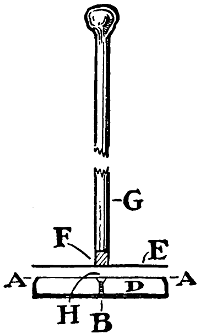
Fig. 6.—The electrophorus.
Our Leyden jars have been constructed to store electrical energy, and the gold leaf electroscope to indicate its presence. But we do not yet possess the means of producing this energy in any considerable quantity.
To make an instrument for this purpose proceed as follows: Clean the inner surface of a circular tin lid—diameter 6 inches or 7 inches, and about 5⁄8-inch deep—(A, Fig. 6), and in the center stand upright on its head a brass screw, whose point has been filed down until it[278] nearly reaches to the level of the upper edge of the lid (B, Fig. 6). Then carefully pour in melted lead or zinc to a depth of 1⁄8-inch. This process is not absolutely necessary, but is advisable if the metal be available and the extra trouble is not distasteful.
When this metal has thoroughly cooled, melt up sufficient rough resin to just overflow the tin, pour it in and allow to solidify properly without the least disturbance (D, Fig. 6).
For the upper part of the electrophorus, take a disc of tin or brass, absolutely flat, and of the same diameter as the resin surface (E, Fig. 6). In the center of its upper side solder a short piece of brass tube (F, Fig. 6), the correct internal width to fit tightly on a 12-inch length of polished wood rod, cut, say, from a walking-stick (G, Fig. 6).
The drawing shows the general arrangement of this electrophorus, wherewith, by the help of a piece of fur, electricity may be generated. A small cavity must be made in the resin, just above the screw (H, Fig. 6), so that the point of the latter may be clearly seen.
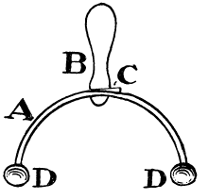
Fig. 7.—The discharger.
One last piece of apparatus—the simplest in construction—remains to be made. Bend a piece of stout brass wire into a semicircle (A, Fig. 7); then, having flattened it at the middle, pass through a hole at the end of a wooden handle (B, Fig. 7), and fix in position by means of a tiny glued wedge (C, Fig. 7). Next twist the rod at both ends into loops, and wrap tinfoil round so as to form metal knobs (D, Fig. 7). Brass balls may be used instead. This arrangement is now complete, and we may commence experimenting.
11. Twist a stout piece of copper wire surmounted by a brass or tinfoil ball round the outside coating of a Leyden jar (A, Fig. 8), so that the two knobs are about 3 inches apart. Suspend a pith ball (B, Fig. 8), made from dried wood pith, by silk thread (C, Fig. 8) from some support above, so that it hangs normally midway between the two knobs.
Next excite the resin surface of the electrophorus by rubbing with[279] a dry rabbit’s fur, muff, or flannel; and, holding the cover of this instrument by the handle’s extreme end, place it upon the resin. Remove immediately and bring near to the knob, which connects with the interior of the Leyden condenser, at the same time touching its outer tinfoil surface with the finger. A spark should pass between the electrophorus cover and the Leyden jar, whereupon, if the former and finger be removed, and the pith ball allowed to drop into position, this will oscillate violently to and fro between the knobs.
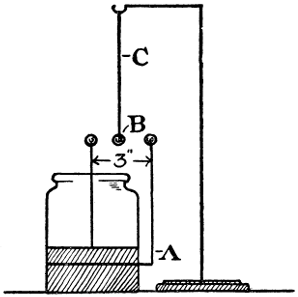
Fig. 8.—Oscillating pith ball.

Fig. 9.—Sparks from discharger and Leyden jar.
12. Construct a Leyden jar with knob terminal similar to that previously described, but cover part way up the outside with gold paint (A, Fig. 9), instead of tinfoil. Charge this condenser by means of the electrophorus cover, as described in experiment 11, and if sufficient induction does not take place with one contact, replace the metal disc on the resin and pass a spark to the Leyden condenser knob several times, taking care to touch the gold paint coating with the finger on each occasion. If now the semicircular discharger, held by the wood handle, be brought so that one knob touches that of the Leyden condenser whilst the other moves over the gold-paint surface, long series of sparks, differing greatly in appearance from any previously produced, will pass between the gilt and the discharger.
13. Excite a stick of sealing-wax by rubbing with flannel, and bring it against a pith ball suspended by silk. The sealing-wax was negatively charged, and the pith ball is now in a like condition. To prove this, approach the flannel which excited the wax, and had consequently acquired a positive[280] charge; inasmuch as the pith ball is immediately attracted and we know that positively excited bodies have an affinity for those negatively affected, the pith ball must be of the latter character.
If, further, a glass rod be excited by rubbing with silk and brought near to the negative pith ball, the latter will again be attracted, showing the glass to be positively charged.
On the other hand, the silk rubber repels a pith ball which has been in contact with excited sealing-wax, in the same way as it will repel the latter substance itself if suspended freely, thus indicating that the silk is similarly, i.e. negatively charged.
The phenomenon of positive and negative electricity may be somewhat differently demonstrated by means of the electroscope. Touch the terminal of this instrument with rubbed sealing-wax. The gold leaves diverge. Moreover, they may be thrown farther asunder by bringing the electrophorus resin near, so that evidently the charge of this instrument is also negative. Perhaps as a diversion it may be noted that resin is one of the chief ingredients of sealing-wax. The electroscope leaves remain apart even when the electrified body has been removed, but they may be made to collapse by touching the knob with the finger or bringing an excited glass rod near. The former action “earths” (i.e. connects, via the person’s body, with the house walls and the earth) the gold leaves and allows the electrical charge to escape, whilst the latter operation counteracts the negative charge by virtue of the positively excited glass.
14. If the electrophorus and electroscope be placed as shown in Fig. 10, the gold leaves being already held asunder by a negative charge from sealing-wax, and the cover of the first instrument be lifted, whilst a strip of cardboard bridges from its upper surface to the disc terminal of the electroscope (A, Fig. 10), the instrument’s leaves will fall together again. From this behavior it may be gathered that the charge on the upper surface of the electrophorus cover is positive, or opposite in character to that induced by rubbing on the resin cake.
[281]
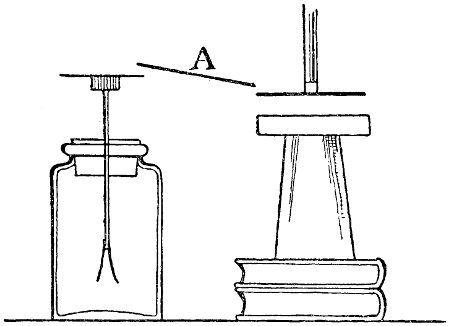
Fig. 10.—An experiment with the electrophorus and electroscope.
15. Stand a charged Leyden jar and the electroscope close together on the table. They must not be so near, however, that the gold leaves are affected by the condenser’s presence.
If, now, a few pieces of sulphur, spread upon the Leyden jar’s disc terminal, be ignited so as to burn freely, the gold leaves will immediately diverge slightly, indicating that part of the electric charge, which is being rapidly dissipated by way of the flame into the atmosphere, has traced a path to the electroscope.
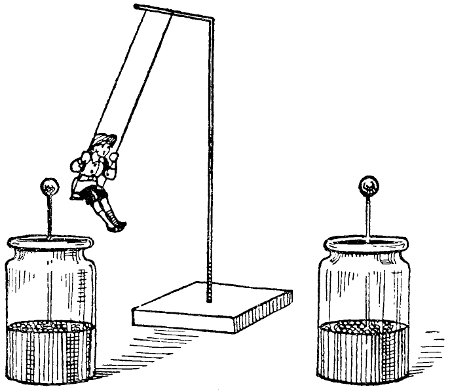
Fig. 11.—The swinging mannikin.
16. An amusing variation of experiment 11, wherein a pith ball was rendered restless between the two terminals of a Leyden condenser, is constituted by carefully modeling a little seated figure out of pith and sealing-wax. The mannikin is threaded on a silk strand, so that the legs hang down as though seated on a swing, and is then suspended by tying the two silk ends to a support above. Fig. 11 indicates the arrangements.
Two Leyden jars are next required, of opposite influences. To effect this, charge one by the ordinary method of touching its terminal several times with an electrophorus cover, being careful on each occasion to “earth” the outer surface, whilst the other condenser is charged by presenting its outer surface to the electrophorus cover, and each time touching the knob terminal with the finger, i.e. “earthing” it.
By this method, whilst the charge at the knob of one Leyden jar is positive, that at the terminal of the other is negative. Place these two instruments at equal distances on either side of the “swing” support, and at such an elevation that the pith figure may just touch the brass knobs.
Then, if the swing be started going, it should continue to oscillate for a considerable time. As the pith figure approaches, say, the positive knob, it acquires a negative charge and is thereby attracted. Directly it touches, however, this negative state is counteracted, a positive charge supersedes it, and repulsion between pith figure and positive knob ensues. The pith doll then swings over towards the[282] negative knob and—being positively influenced—is of course attracted until contact takes place. Then negative supersedes positive in the pith figure, repulsion again results, and a similar cycle of changes is repeated. Thus the figure continues to oscillate until the charges of the jars have been exhausted or have leaked away.
17. In the same manner as the alternate attraction and repulsion of a light body has been used to maintain oscillation, so similarly an electrostatic motor may be constructed embodying the same principles. Cut out a 16-pointed star of cardboard, 8-inch diameter, and, having glued a 1⁄4-inch slice of cork in the middle of each side (A, Fig. 12), pass a knitting-needle through the star’s center at right angles (B, Fig. 12). Both ends of this spindle rest in conical cavities (C, Fig. 12), which may be punched or drilled in small brass discs to act as bearings, and the apparatus is mounted as shown.
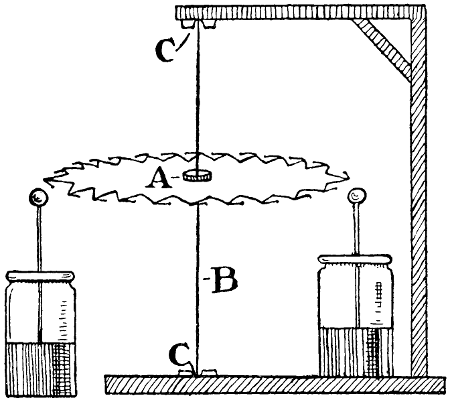
Fig. 12.—Electrostatic motor.
It is important that the cardboard should be perfectly dry, and with this end in view it may well have previously received a saturation in paraffin wax. When set hard, stick a brass pin bent at right angles into each point of the star, and set Leyden jars of different charges beneath any two diametrically opposite points. The motor, being given a start, should continue to revolve for some time owing to the succeeding attraction and repulsion of the metal pins.
The following description is of a small machine which may be fairly easily constructed, and when in good working order will give far better results than the electrophorus. Fig. 13 shows the reference letters and general arrangement. Two cork bungs (A, Fig. 13), previously saturated with paraffin wax or shellac varnish, are fixed into the ends of a cylindrical lamp chimney, and through a hole in the exact center of each passes a wooden rod (B, Fig. 13), which must be glued in place. Each end is supported in a wooden bearing (C, Fig. 13), black lead being used as a lubricant, and to the protruding one a small handle (D, Fig. 13) is fitted, wherewith the glass may be revolved. Next a long pad of wash leather (E, Fig. 13), stuffed with horse-hair, is fixed so as to press gently against the cylinder, whilst a silk flap[283] (F, Fig. 13) about 2 inches wide hangs over the top surface of the glass. A brass chain (G, Fig. 13) is also fixed to the wash-leather cushion and, in the ordinary way, connects to “earth” either direct or through the operator. The wash-leather cushion is well black-leaded where it touches the glass.

Fig. 13.—Frictional machine (more useful than the electrophorus for producing electric charges).
On the opposite side of the cylinder a metal comb (H, Fig. 13) is supported, the teeth being 1⁄16-inch away from the glass, whilst the back of the comb is soldered to a brass knob (I, Fig. 13) fixed on a wood pedestal. Any noticeable edges at the base of the brass globe should be filed off until only round surfaces are presented.
Care should be taken to dry the machine thoroughly, and if then the handle be turned regularly, as indicated by the arrow, the brass knob should rapidly become charged to such an extent that sparks may be drawn with the knuckles, possibly with discomforting results!
If the brass ball possess any sharp edges or, alternatively, if a length of wire girdle it so that one end projects radially about one inch, then the electricity will leak from these extremities in the form of a glow discharge as fast as it is developed. This frequently creates such a disturbance in the surrounding air as to distinctly blow a candle flame when held at the discharging point.
In 1752 Faraday invented an arrangement of attraction and repulsion by which three bells were kept ringing. To the electrical machine conductor was attached a metal support from the ends of which hung two bell domes on brass chains, whilst from the center another was supported by a silk strand and connected by a brass chain to earth. Between the bells small brass clappers were hung by silk threads, as shown in Fig. 14.
The action in working was for the machine to charge its conductor and hence the two outer bell domes, which then attracted their brass clappers until contact took place. This caused repulsion, so that the clappers swung over to the center dome, where discharge to earth ensued and a condition obtained when the cycle of events might be repeated.
[284]
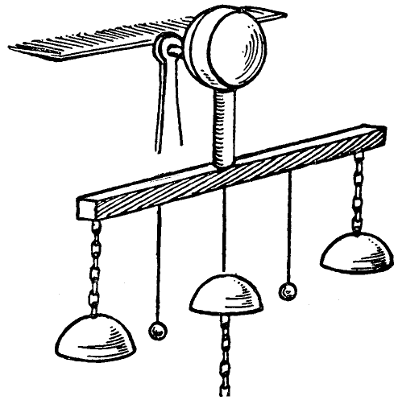
Fig. 14.—Faraday’s bell chimes.
Having thus arrived, via the simplest phenomena, at a piece of mechanism which will work, our experiments in the field of static electricity must conclude; but rather, let it be noted, on account of a dearth of apparatus than from any scarcity of phenomena to be studied. If therefore the reader foresees an opportunity of pursuing the subject further, such for example as the use of a well-equipped laboratory, let him not hesitate to snatch the advantage. To mention two facts demonstrable by further experiment: (1) Frictional electricity is produced in excessively small quantities at a very high pressure. For this reason sparks in air may be produced frictionally of such a length as cannot be obtained direct from batteries. (2) Friction itself is not a necessary element in the production of electrical energy, but is adopted in order to bring every portion of the rubbed surfaces into perfect contact. Thus far and no further. We must say “Au revoir,” and splash down a full stop.
[1] For the experiments in this and the following chapter I am indebted to the assistance rendered by Mr. Stanley S. Barnard.—C. H. B.
[285]
A phenomenon is always mysterious, so long as its origin remains hidden. That is to say that any event, the causes of whose manifestation are obscure, will be found to prompt some feeling of wonderment.
For this reason then—just as an automobile in motion will bewilder a savage, because he has at no time seen any but living creatures moving, and does not understand the new mechanism—so for us an electrical effect mostly presents something of a miraculous nature. To take a concrete example. Whereas the ringing of a church bell by the sexton engenders no feeling of wonderment in the average listener’s breast, the buzzing of an electric bell, which ensues upon connecting with a battery, does have this influence to a greater or less extent, because the electricity’s behavior is by no means so obvious as that of the sexton pulling the rope.
Let this character of the miraculous then, which pertains with scarcely an exception to every electrical phenomenon, stand as an excuse for the experiments to be detailed hereafter.
Electricity may be produced by a variety of methods. For commercial purposes, where unstinted supplies are necessary, mechanical energy is converted into the subtle force by means of dynamos. Exceptional sources of mechanical energy are now frequently used, as witness the Niagara Falls, where electric current is produced on the site, and whence it is conducted by cables to places of utility; and also the case of Nansen’s “Farthest North” Expedition (before Cook found the Pole!), which utilized a deck windmill for installation of electric light aboard.
Electricity is also produced when any two substances are brought into contact, and more especially if they are placed near one another, but not touching, in certain liquids, thereby forming “cells.” With these arrangements, electricity finds its source in chemical action; and, although not powerful, such cells are extensively employed, on account of reliability, in telephone and telegraph systems. No more convenient[286] source of galvanic energy has yet been devised than a battery of “cells”—i.e. a number of cells connected together—and the type which we intend to use, and of whose construction the following is a description, is among the cheapest possible to make and maintain.
The battery is to consist of eight cells, connected together, in a manner hereafter described. For each cell procure a 1 lb. stone jar (A), and line it inside with a sheet of tin (B), which may be cut from a condensed milk can, and should be curved so as to press outwards against the jar’s inner surface (Fig. 1). A 2-inch length of copper wire (C) is soldered to its upper edge.
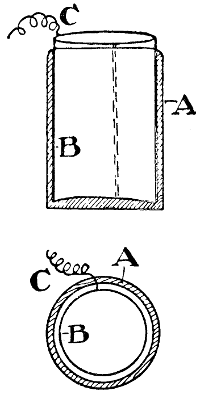
Fig. 1.—Making a cell.

Fig. 2.—Copper spiral surrounded by broken coke in rag or flannel bag.
The next operation is to twist an 8-inch piece of copper wire for about 6 inches of its length round a pencil, thus forming a spiral (X), round which a flannel bag (A) filled with small coke (B) is tied (Fig. 2). At least two thicknesses of flannel are advantageous, or if this be found rather expensive, flannel and rag combined, or odd pieces of rag alone may be utilized.
The chief considerations are to construct a porous wall of appreciable thickness round the coke, and to avoid colored rags if possible. The bag is to stand upright in the middle of the jar, leaving about 1⁄2-inch space all round to be packed with zinc scrap, which for convenience may well be “granulated.” To make this, melt up as much waste zinc as can be collected in a ladle and pour it in a thin stream into a large bowl of cold water, moving the ladle over the surface of the water meanwhile, in order to cool the zinc stream as suddenly as possible.[287] The zinc which forms in a heap at the bottom of the bowl should be breakable into very small pieces, and is termed “granulated” (Fig. 3).
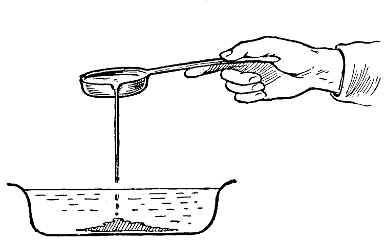
Fig. 3.—Granulating zinc.
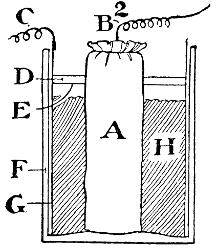
Fig. 4.—Section of the complete cell.
When the cell has thus been assembled with curved tin sheet, bag of coke and broken zinc in place, it is nearly filled with strong salt solution, and above this, in order to prevent evaporation, a thin layer of melted tallow may well be poured. Fig. 4 represents a section of the complete cell, A being the flannel bag containing coke; B², wire from coke; C, wire from tin; D, layer of tallow; E, level of solution; F, the jar; G, the tin; H, the zinc.
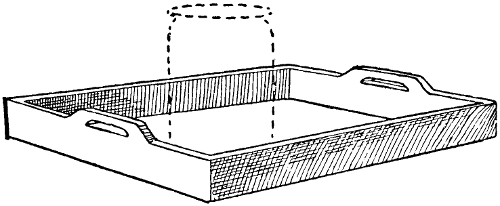
Fig. 5.—Tray to carry battery of cells.
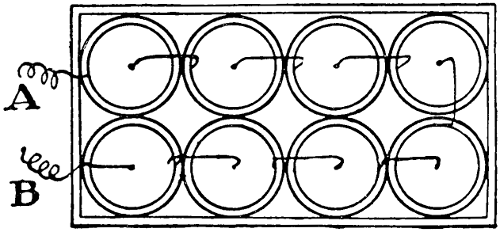
Fig. 6.—The complete battery.
The eight components of the battery being thus complete, nothing necessary remains but to connect them together. However, they will prove more portable and self contained if arranged in a shallow wood tray. This may be either a confectionery box—if one of suitable dimensions is obtainable—or can perhaps be constructed as indicated by the accompanying sketch, with handles at either end (Fig. 5). It should certainly be strong, as the set of jars is of considerable[288] weight, and would, if accidentally dropped, create a pretty printers’ pi. Lastly, when the cells have been arranged in two rows of four a side, the finishing touch is to join the copper wire ends by twisting, according to the plan shown in Fig. 6, and the battery is complete. The end wires A and B will be referred to hereafter as negative and positive terminals respectively.
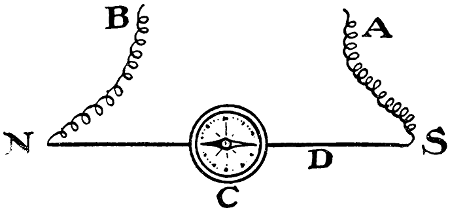
Fig. 7.—The compass test.
Experiment 1.—Connect one extremity of a straight wire with the battery’s positive terminal, and place it on the table so as to lie due north and south. Above it stand a compass, whose needle—also pointing due north and south—will be parallel to the wire (Fig. 7). Now, when the free end of the north-south conductor is connected to the battery’s other terminal so that a current may flow, the needle swings round at right angles and thus now lies east and west. Needless to add, electricity prompts the needle’s behavior, and unless such movement does take place, the cells are at fault somewhere.
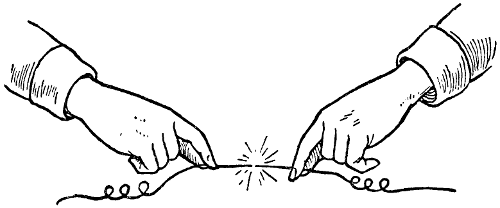
Fig. 8.—Spark-producing.
Experiment 2.—Having decided by the compass’s behavior that the battery is actually efficient, bring the terminal wires into contact in the dark, and notice the slight spark (Fig. 8). Next obtain a spare bobbin from an old electric bell (Fig. 9), and pass the current round the coils whilst making the spark. This should now be more distinct—thicker, and brighter, though not so frequent—owing to induction taking place between the wire coils.
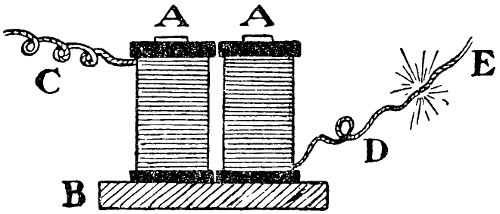
| AA. | Bell-bobbin coils. |
| B. | Iron base. |
| C. | Wire from battery terminal joined with one end of coil wire. |
| D. | Other end of coil wire. |
| E. | Wire from other battery terminal. |
Fig. 9.—Showing connections for passing current round bell-bobbin coils.
[289]
Experiment 3.—Repeat the previous experiment whilst using pieces of carbon, round which the free wire ends (D and E, Fig. 9) are twisted, to bring into contact with one another (Fig. 10). The spark obtained is very bright, and may possibly by careful handling be maintained for a moment or two; if the current is more powerful, the spark does keep constant, even though the carbons be drawn apart considerably, and thus forms in principle such an arc lamp as floods the streets of towns with their dazzling rays. The pieces of carbon may frequently be picked up beneath arc light standards, after the electrician has gone on his rounds “trimming” the lamps.

Fig. 10.—The principle of the arc lamp.
Experiment 4.—Again repeat the No. 2 experiment, but insert a rough file in the circuit and drag the free end of a wire from the battery up and down its surface (Fig. 11). Sparks in plenty, but apparently frail and resembling those thrown off by squib fireworks, are produced in this manner.
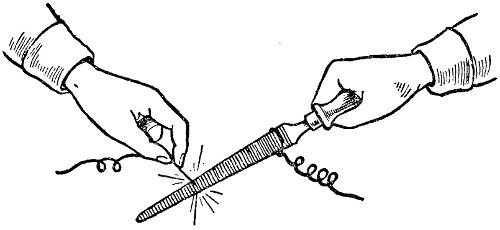
Fig. 11.—More spark production.

Fig. 12.—Magnetic lines of force.
Experiment 5.—If a few iron filings (A, Fig. 12) be scattered evenly on a sheet of paper (C, Fig. 12) and a horse-shoe magnet (B, Fig. 12) approached from beneath, the filings arrange themselves in a curious design, which really maps out the magnetic lines of force. Now, if this experiment is repeated whilst using the bell-bobbin in place of the permanent horse-shoe magnet, and a current passed round the coils, the same disposition of the filings ensues, showing that the bobbin’s iron cores have been magnetized. In Fig. 13, A is the filings; B, the wire from negative terminal battery; C, the sheet of paper; and D, the wire from positive terminal.
Experiment 6.—“Flax” wire, whose core consists of about forty[290] fine copper filaments stranded together, may often be had in scrap lengths at electricians’ shops, as it finds wide employment in lighting installations. The silk and rubber insulation should be ignited and allowed to burn, any residue being carefully wiped off with rag, after which two lengths of, say, three strands apiece are separated from the wire core. These are very flexible, so that when attached to the battery terminals and magnet wires the bobbin, being extended as shown by a silk strand, is able to revolve freely in any direction. As a matter of fact, whilst the current is flowing the bobbin sets itself north and south like any other magnet—a very ordinary performance, the reader may remark! But, on the other hand, if the flexible wires be changed over so that the one previously connected to the battery’s positive terminal is now connected to the negative and vice versa, with the result that the current travels round the bobbin coils in an opposite direction, the electro-magnet swings half a turn, and comes to rest with its pole that was towards the north now pointing south. So that the bobbin resembles a weathercock, except in so far as it changes with the current instead of the wind (Fig. 14).
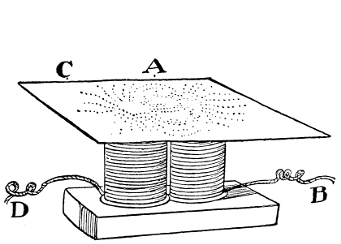
Fig. 13.—The filings arrange themselves in a curious design.
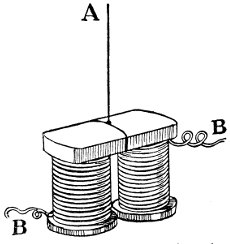
Fig. 14.—An electrical weathercock.
Experiment 7.—The number “7” has been regarded among races of men as peculiarly fortunate. Perhaps happily, therefore, it falls to this experiment, which, indeed, is rather the construction of new than the arrangement of old apparatus. The magnetic properties of a bell-bobbin may be utilized in constructing a primitive electro-motor. Decapitate four 11⁄2-inch nails, and, having bent 1⁄8-inch of both ends of each at right angles, mount them[291] equal distances apart round the circumference of a thread reel (Fig. 15).
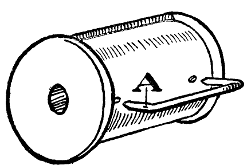
| A. | Nail ready to drive into reel. |
Fig. 15.—A primitive electro-motor.
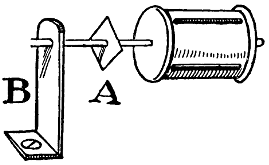
| A. | Square of copper or tin. |
| B. | Brass standard. |
Fig. 16.—Standard for electro-motor.
Next plug the center hole of this reel with hard wood, and bore another hole through of smaller diameter, so as to slide stiffly on a straight piece of 1⁄8-inch brass wire. About 1 inch from the cotton reel is to be soldered a 3⁄8-inch square of tin or copper sheet, having a hole at its center through which the brass spindle passes (Fig. 16). Two small brass standards, for which straightened curtain-rod clips may well be employed, are screwed about 31⁄2 inches apart to a wooden baseboard, and have a hole drilled near their top edges to accommodate the spindle (B, Figs. 16 and 17). This being placed in position, should be provided near the bearings with washers (E, Fig. 17) and beads (D, Fig. 17), the washers being soldered in order to prevent lateral movement of the shaft. Lastly, with a view to realistic appearance, solder a small tin fan (C, Fig. 17) to one projecting end of the spindle, and enamel or paint it gray. The arrangements of these fittings are made quite clear by the diagram.
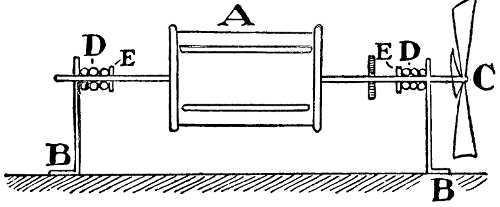
Fig. 17.—An electro-motor.
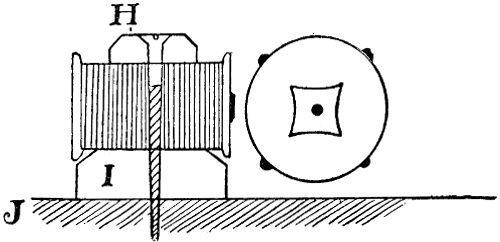
| H. | Wood strip across top of magnet. |
| I. | Block of wood supporting bobbin at correct height. |
| J. | Wood base board. |
Fig. 18.—Bell-bobbin mounted.
[292]
By now the most difficult part of our task has been attempted, so that if the reel and spindle revolve “sweetly” in the bearings, no doubt need be entertained as to whether the motor will ever reach completion.
The bell-bobbin must be mounted with its magnet faces as near the reel circumference as possible, and with their centers the same height above the baseboard as the spindle. A piece of wood beneath the bobbin, of such thickness as to keep it at the right height, and another strip across the top, through the ends of both of which screws are driven into the baseboard, will secure the magnet firmly in position (Fig. 18). The next operation is to bend a springy strip of brass to the shape shown in F, Fig. 19, and fix it immovably by the screw G—round which one free end of the bobbin wire (L) has been twisted several turns—to the baseboard, so that its top portion misses the metal square or contact-breaker (P) on the spindle by about 1⁄4 inch. Now drive a second screw (R) carefully into the wood through another hole in the strip, until this latter presses lightly against each point of the contact-breaker successively as the spindle revolves.

Fig. 19.—The contact-breaker.
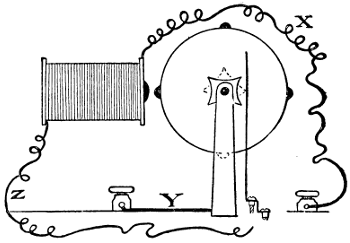
Fig. 20.—Showing wire connections (X, Y, Z) and motor.
The little motor is now complete, except, perhaps, for the addition of two terminal screws, one of which is joined with the remaining free bobbin wire, and the other by a short length of wire to either of the bearings. The entire connections are shown in the accompanying sketch (Fig. 20). Now for working! Connect the battery wires to the motor terminals, and adjust the spindle so that one corner of the contact-breaker is fairly touching the vertical brass strip. A current should now be flowing round the bobbins, which[293] consequently become magnetized and attract the nearest iron nail fastened to the thread reel. If the iron is not sufficiently near to be under the magnet’s influence, turn the reel on the shaft until it is in the proper position. The motor, with a little adjustment, ought to run merrily, as the bell-bobbin—alternately magnetized and demagnetized—attracts and releases the short iron bars.
Experiment 8.—Connect the battery terminals together by means of some thin iron wire such as is used for wiring flowers, and twist it into a spiral so that it may rest comfortably in a cup of cold water (A, Fig. 21). Stand also therein a thermometer (B, Fig. 21). The water’s temperature will be observed to rise steadily, showing that the passage of the electric current heats the iron wire (C, Fig. 21), which in turn imparts some warmth to the surrounding liquid.
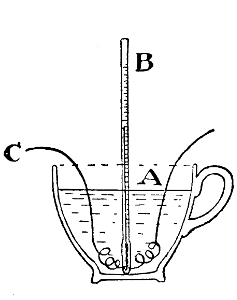
Fig. 21.—Warming water by electricity.

Fig. 22.—Decomposing water into its chemical constituents by means of an electric current.
Experiment 9.—The previous experiment showed that an electric current heats a material through which it passes. If the thin iron wire be shortened to a length of about 1⁄2-inch, our battery will probably bring it to red-heat, thus demonstrating the principle of electric incandescent lamps. The difference between theory and practice, however, in this case consists in the use of carbon, or, very rarely, platinum, in place of the iron filament, and of inclosing this in a glass bulb free of air, so that combustion cannot proceed rapidly.
Experiment 10.—Immerse two wires from the battery terminals at some little distance apart in a glass of water, which has been slightly soured with sulphuric acid or spirits of salt. The weak acid readily conducts the electric current, which decomposes the water into its[294] chemical constituents, hydrogen and oxygen, the former gas coming off in bubbles at the wire which leads from the battery tins, and the oxygen round the other conductor (Fig. 22). The hydrogen bubbles may perhaps be ignited as they are evolved by holding a lighted match just near the water’s surface; or another method is to seal the wires into separate glass tubes, so that both dip beneath the water, and light the hydrogen gas as it escapes from the tube’s upper end (Fig. 23). In this case great care must be taken to allow time for the expulsion of all air from the tube, because hydrogen and air in certain proportions form a very explosive mixture.

Fig. 23.—The hydrogen bubbles may be ignited by holding a match near the free end of the hydrogen tube.
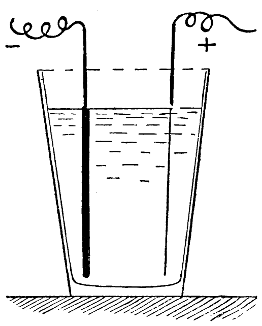
Fig. 24.—Electro-plating in its infancy.
Experiment 11.—Repeat the foregoing experiment, using copper sulphate solution in place of the acidified water. After the current has passed for some time, one of the wires will be noticed to have become thicker whilst the diameter of the other has decreased. This behavior is owing to deposit of copper from the solution on the one conductor and abstraction of metal from the other, whose bulk diminishes in automatically maintaining the solution’s strength (Fig. 24). In this reaction is seen the basis of commercial electroplating—silver and nickel solutions being mostly employed instead of the copper bath, since these are the metals with which those of a baser nature are more frequently plated.
Experiment 12.—Electrotyping is a modification of electro-plating, where a mold of wax coated with some conducting substance like graphite is used to deposit the metal upon. Melt some quantity of sealing-wax[295] on to a piece of cardboard, so that it spreads out slightly larger in diameter than a fifty-cent piece, and when just plastic press the “head” surface of the new coin into the wax, so that an exact replica is obtained. Fasten a copper wire by some extra wax to the cardboard disc (as in Fig. 25), and carefully cover the whole matrix with powdered blacklead, working it well into the crevices and up to the copper conductor, with a camel-hair brush. Hang this in a jar containing saturated copper sulphate solution—the copper wire being connected to the negative battery terminals (A, Fig. 26), whilst a sheet of copper or coil of wire is suspended in the solution some little distance from the sealing-wax mold, with a wire connecting to the other battery terminal (B, Fig. 26).
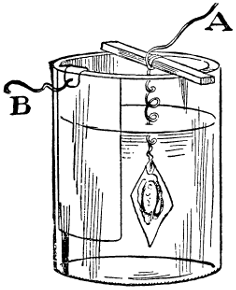
Fig. 25.—Preparation for experiment in electrotyping.
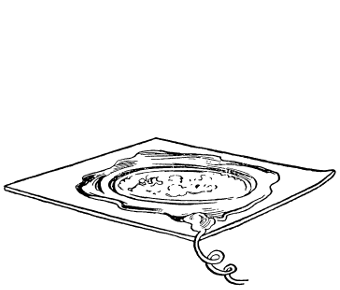
Fig. 26.—Sealing-wax mold suspended in solution of saturated copper sulphate, near to sheet of copper or coil of wire.
So long as the current continues flowing a reddish deposit will form on the blacklead surface, and if the action be allowed to continue until a fair thickness of metal is secured, the wax may be carefully melted off, leaving an exact relief of a fifty-cent piece’s reverse side in a copper. Any medal or seal may be used in place of the silver piece to obtain a first mold, but the coin has been mentioned as being probably the most suitable article near at hand.
With this example of electrotyping, our series of descriptions must terminate. But the embryo scientist, who has traveled thus far, need not cast his apparatus to the winds and henceforward forsake electrical matters. He may arrange various combinations of wines and liquids—such, for example, as passing the current through water to his motor, and noting the decrease in speed, or insert various lengths of iron wire in the circuit. Possibly the batteries will betray exhaustion, and they may then be reinstated by discarding the old salt solution, rinsing and replenishing[296] the granulated zinc, and washing the flannel bags in permanganate of potash solution. These batteries are, in fact, a real asset, as they can be used—three or four together—in setting up an electric-bell installation, and are easily replenishable, when at length their life begins to ebb.
An endless fund of amusement—less expensive and more instructive than many—awaits those who explore the realms of the pygmy lightning spark.
[297]
To many boys and girls who have acquired at school some knowledge of Science, the mere mention of the words “Scientific Experiments” recalls memories of experiments far from amusing, for the science of the laboratory is more often than not accompanied by some of the innumerable little worries of school life.
When, however, experiments are conducted at leisure in the home, the work assumes a totally different aspect, and much pleasure may be derived from it.
Not only may such experiments become a source of great amusement, but they are of considerable educational value, since it is from the study of the most elementary scientific laws that some of the greatest discoveries of modern science have been made.
The aim of this chapter is, then, to place before you a series of interesting and instructive experiments which may be performed for the amusement of yourselves and friends on occasions when outdoor recreation is impossible.
In selecting these experiments, endeavors have been made wherever possible to mention only home-made apparatus, or such requisites as are easily procurable at very slight cost.
Of what, then, do these amusing experiments consist?
The first is one which, at a casual glance, seems impossible to perform.
To pierce a copper coin with a needle, especially if the needle is thin, seems, indeed, a tremendous task. It is, however, very simple.
The apparatus necessary consists of a cork, a needle, and a hammer.
Stick the needle through the cork in such a manner that the point only just protrudes, and, with a pair of pincers, cut off the head of the needle remaining above the cork.
[298]
Then, having placed the coin and cork as shown in the diagram, hit the cork vigorously with the hammer (Fig. 1). The needle being unable to bend in any direction owing to the cork keeping it rigid, will pierce the coin quite easily, since we know that the steel of which the needle is composed is harder than the copper of the coin.
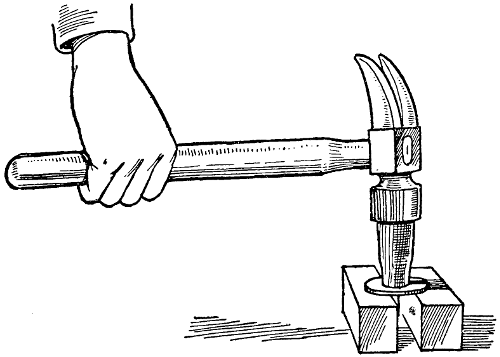
Fig. 1.—Coin piercing extraordinary.
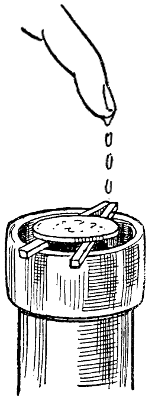
Fig. 2.—A match trick.
Another very interesting experiment is that performed with an ordinary match, a bottle, and a coin.
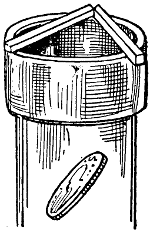
Fig. 3.—Coin leaving match and dropping into the bottle.
Bend in two an ordinary large match, thus partly breaking it, in such a manner that the two parts hold together by a few fibers of wood.
Place it, thus broken, on the neck of a bottle, and then on the match place a dime or any other small coin.
Having done this ask a friend if he can make the coin fall into the bottle without touching the coin, the bottle, or the match. You will find that he will search in vain for a solution to this seemingly impossible task, which however may be overcome in a very simple manner, as may now be seen.
Dip your finger in a glass of water, and placing it above the angle formed by the match, allow one or two drops of the liquid to fall on this angle (Fig. 2).
Immediately the fibers of wood, swollen by the moisture, try to straighten themselves, and you will see the angle of the match increase little by little until the match no longer supports the coin, which then drops into the bottle (Fig. 3).
[299]
Most of us, if not all, know that if wine is carefully poured on water, it floats on the surface, but not every one knows how to place the wine at the bottom of the glass with the water above it, and this without mixing the two liquids. For this experiment make use of the different densities of hot and cold water.
Take an ordinary glass (moistened first with hot water to prevent its cracking) and pour some boiling water into it.
Then by means of a funnel placed almost to the bottom of the glass, pour in some wine which has previously been cooled by ice. By working carefully you will see the wine form in a red layer at the bottom of the glass (Fig. 4).
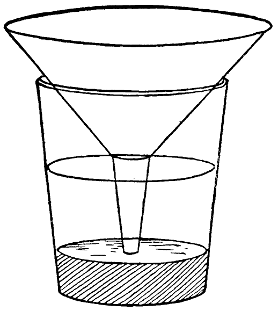
Fig. 4.—The wine at the bottom of the glass.

Fig. 5.—The tricolor glass.
Now gently remove the funnel, and pour on the surface a bluish liquid lighter than water (for instance, alcohol colored with ink) (Fig. 5).
You will now have a layer of blue on top, thus completing the tricolor glass, which will by the aid of a light project the three colors of the flag on the wall. The tricolor glass may also be used for illumination purposes.
To make it represent fireworks is even more entertaining.
If you allow the water in the glass to cool by placing it in a vessel containing cold water, the wine will rise from the bottom of the[300] glass in the form of thin threads, strongly resembling rockets (Fig. 6).
The different liquids mix, and the descending columns of blue, mixed with the ascending columns of red, produce a curious spectacle like that of fireworks in a glass of water.
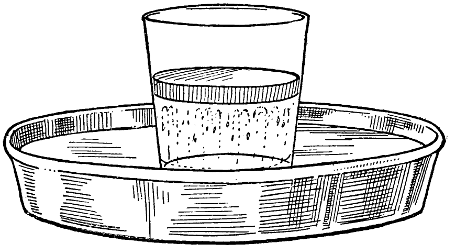
Fig. 6.—Water rockets.
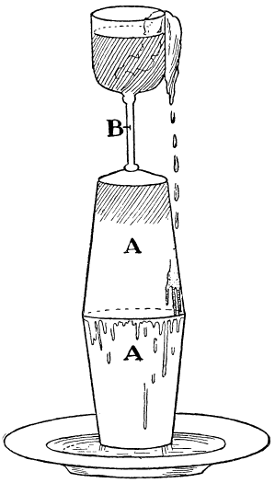
Fig. 7.—Changing water into wine.
This is not a reproduction of the miracle performed at the wedding feast of Cana, but it is, nevertheless, a most interesting experiment.
Fill two tumblers (A), or wine glasses, of equal diameter, with water, by completely immersing them in a basin of that liquid, standing one upright and the other upside down upon it. When they are both completely full, with not a bubble of air in either, join their rims and remove them from the basin. Now place them upright on a dish, and, if their rims fit accurately upon each other, the water will remain in them. It is now necessary to place on the top of the upper glass a third glass, (B), containing wine, or better still, spirits of wine in which is dissolved a little aniline dye.
Now announce to your friends that without touching any of the glasses, you will, before the eyes of the audience, cause the wine to pass from the glass (B) into the upper (A) glass without a drop entering the lower (A) glass.
In order to perform this amazing experiment take a strip of wool or cotton, moisten it with the liquid contained in the top glass (B), and hang it over the edge of this glass with one end completely immersed in the liquid.
This forms an excellent siphon, for it allows the liquid in the[301] top glass (B) to flow away in drops which fall on and run down the glass underneath until they reach the junction of the rims. Here they are drawn in by capillary attraction, and, the wine being lighter than the water, they rise to the top of the upturned glass (A), displacing the water contained therein by causing it to flow out between the rims, after which it collects in the dish below.
This action will go on until the top glass (B) is empty, when the whole of its contents will find their way into the upturned glass, whilst the lower one (A) remains perfectly clear (Fig. 7).
Many of us, no doubt, have often tried to picture to ourselves a volcano in eruption, but most will confess that unless we have seen some very good pictures of an actual eruption, we are not at all certain that our self-made picture is correct.
Now to detail an experiment which gives a vivid idea of a volcano in action.
At the bottom of a large glass bowl put a flask containing red wine, or spirits of wine, in which has been dissolved a little aniline (B, Fig. 8). This flask should be closed by a cork pierced with a very narrow hole. By the aid of plaster, or, simpler still, of earth or clay, fashion a mountain around the flask, leaving at the top a hole through which the cork can just be seen. This will form the crater.
Having made your volcano, fill the bowl with water (A, Fig. 8), and you will now witness the eruption.
We know that, owing to the difference in the density of the two liquids, the water will penetrate into the flask, thus displacing the wine, which escapes in a thin red column. As this column nears the surface, it will spread out, thus resembling a cloud of fiery smoke as seen issuing from a volcano.
[302]
Care must be taken to shake the water, in order that the streak of color may represent in as realistic a manner as possible the reddish smoke of a volcano disturbed by the wind.
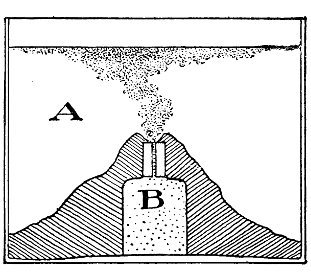
Fig. 8.—The eruption of Vesuvius.
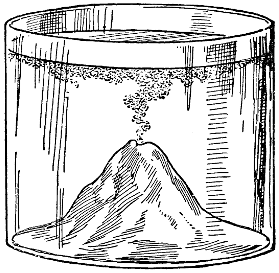
Fig. 9.—Vesuvius in eruption.
In this way you will provide your friends with an almost exact reproduction of Vesuvius in action (Fig. 9).
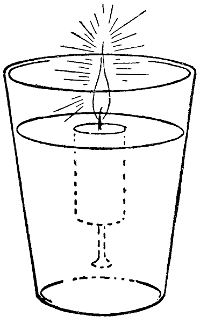
Fig. 10.—A peculiar candlestick.
Water supporting a lighted candle seems a very peculiar form of candlestick; and yet despite this it will be found quite as serviceable as any other.
To make the candlestick is quite easy. All you have to do is first to weight the end of a piece of candle (previously used) with a nail or piece of metal, in such a manner that, when placed in a vessel of water, the liquid will be flush with the edge of the candle without wetting the wick.
Next light the candle, and announce that, in spite of the unfavorable surroundings, your candle will burn to the end.
This may at first seem extraordinary, but a little reflection will show that your statement is correct, for this experiment is only a striking example of the Law of Archimedes, which states that “when a body is immersed in water, it loses in weight an amount equal to the weight of the water displaced.”
[303]
Now, whilst the candle is being consumed it is becoming shorter, but, on account of its diminution in weight, it rises in the water at the same rate at which it is consumed (Fig. 10).
The title of this experiment suggests something rather wonderful, indeed, for it seems impossible to impart motion to a paper fish.
It may be done, however, and quite easily, as will be seen from the following.
From a piece of ordinary paper cut out a fish like that shown in the diagram, and of the size of an ordinary fish. In the center make a circular hole (A), communicating with the tail by a narrow canal. (A B) (Fig. 11). Having done this, fill an elongated vessel with water, and place the fish on the surface of the liquid in such a manner that the underneath face is completely moistened, while the other remains quite dry.
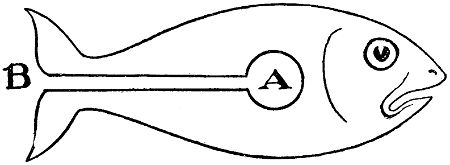
Fig. 11.—The swimming paper fish.
You are now ready to set the fish in motion; but to add to the interest of the experiment, challenge any of your friends to make the fish move without touching or even blowing upon it.
This may seem to them impossible. This is how it is performed.

Fig. 12.—The swimming fish.
With great care pour one large drop of oil into the opening (A); the oil at once tries to spread over the surface of the liquid, but that is only possible if it escapes by the narrow passage (A B).
This it does, and owing to the reaction the fish is thrust in[304] the direction opposite to the flowing of the oil—i.e. it will be thrust forward, the movement lasting long enough for the spectators to view with astonishment the unusual sight of a paper fish swimming (Fig. 12).
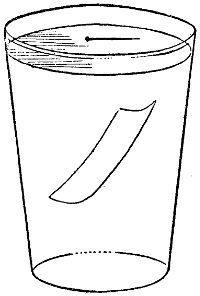
Fig. 13.—The floating pin.
If a drop of water is placed on glass it will at once spread, but if the same thing is done with a drop of mercury, the liquid will not spread, but remain in the form of a bead.
These two different results are due to the fact, that whilst the water wets the glass the mercury does not.
Now take a pin which has been well dried; it is a body which water will moisten, but owing to its very smooth surface, not so easily as in the case of glass.
Suppose, then, that by some means or other you can place the pin so gently on the surface of the liquid that the water does not make it wet, you will notice that the water takes on either side of the pin a convex shape, and in this way a sufficient volume of water is displaced to allow the pin to float as if it were a match.
The experiment may, of course, be as easily performed with a needle; nor must it be thought it is confined to pins and needles which are thin, for, with care, you may even succeed with big darning-needles.
It has not yet been shown, however, how to place the pin on the water in such a manner that it is not made even wet.
There are several ways of doing this, some requiring considerable practice.
The following is the simplest.
Float on the surface of the water a cigarette paper; place the pin upon it; leave the paper to sink to the bottom when it has become soaked, and the pin will float without any difficulty, for on either side of the pin the water takes the convex shape before mentioned, thus displacing sufficient water to allow the pin to float.
In order to hide from the spectators the stratagem you have employed, gently remove the paper before showing them the floating pin.
[305]
The picture below is not taken from a prospectus advertising cement for joining glass and porcelain, but is simply used to show how atmospheric pressure may be utilized for joining glasses and plates.
In order to accomplish this it is necessary to form a vacuum, but as an air-pump is not at the disposal of every boy a partial vacuum must suffice.
To obtain this partial vacuum suspend a glass from the ceiling, or any other suitable place, by means of a string, and under it burn a piece of paper. This will cause the air it contains to expand. Immediately afterwards place the plate over the mouth of the glass, and it will adhere quite firmly.
In order to prevent the entrance of any external air, and thus destroy the vacuum, the edges of the glass may be smeared with tallow.
Now, how is it that the glass and plate are so easily fixed? Well, directly the hot air contained in the glass comes in contact with the cold surface of the plate, the air contracts, and as the plate prevents the entrance of any more air, a partial vacuum is formed within the glass.

Fig. 14.—Joined by air.
As the atmospheric pressure is much greater than the pressure from within, the plate remains firmly fixed to the glass (Fig. 14).
This experiment, similar in principle to the last, is quite as striking in its effect.
It consists of raising in air a glass filled with water, by causing it to adhere to the hand when the latter is held quite open.
With the last experiment fresh in our minds, it is not difficult to guess that this phenomenon is due to the existence of a partial vacuum under the hand, but it is not so easy to know how to obtain this vacuum.
The means of carrying out the experiments are as follows:—
Put the glass filled with water on the table, and over the top place[306] the palm of the hand, taking care that the four fingers are bent almost at right angles, as shown in the first of the accompanying figures (Fig. 15).
If, continuing to press the palm of the hand on the edge of the glass, you raise the four fingers quickly, thus having the palm stretched out, you will force out most of the air which is between your palm and the surface of the water, and in this way you will produce under your hand a partial vacuum. This vacuum will be sufficient to allow the atmospheric pressure to overcome the weight of the glass and its contents; thus a sucker is formed which allows the glass to remain attached to the hand (Fig. 16).
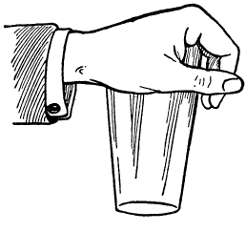
Fig. 15.—Glass raising extraordinary.
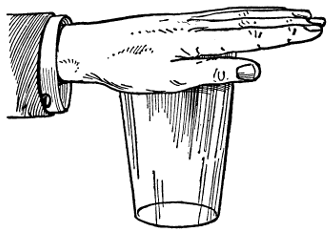
Fig. 16.—Glass raising extraordinary.
If you are given a glass filled with water, and a bottle equally full, and then asked to empty the glass by means of the bottle, and that without emptying the bottle itself, you will imagine you have been set a very difficult task indeed.

Fig. 17.—The glass-emptying bottle.
You will soon see, however, that the solution to this seemingly difficult experiment is quite simple.
[307]
First take a cork, and in it pierce two holes. Through these gently push two straws, one being as long as the glass, the other considerably longer (Fig. 17).
By means of a pellet of bread or wax close the opening of the shorter straw, and push the cork into the bottle until the water gushes out of the longer straw.
In order to empty the glass it is now only necessary to turn the bottle upside down, in such manner that the little straw touches the bottom of the glass.
Then, taking a pair of scissors, cut this straw very near the end which is sealed.
Immediately the water in the glass will flow out by the long straw until the glass is quite empty, despite the fact that the bottle has remained full all the time (Fig. 18).
Now for a few words of explanation, in order to make clear the reason for this unexpected action.
The two straws form the two arms of a siphon, and as they are full of water it is not necessary to remove any air from them.
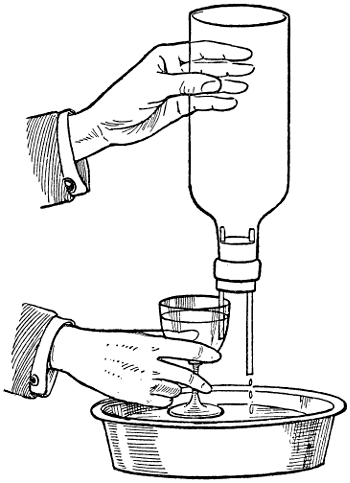
Fig. 18.—A novel glass-emptier.
As the liquid flows out of the long straw, it tends to produce in the bottle a vacuum. As a vacuum is contrary to nature, it is immediately destroyed by the entrance of an equal quantity of water from the little straw, for the atmospheric pressure exerted on the water in the glass keeps this little straw continually full. In this way all the water is drawn from the glass by the bottle filled with water.
[308]
A very pretty experiment with the siphon may be performed by making use of the following simple apparatus: An ordinary glass; a little water colored, say with aniline; a piece of rubber tubing about an inch long, one end of which is cut obliquely, as shown in the diagram; together with a piece of glass tubing from four to five feet long.
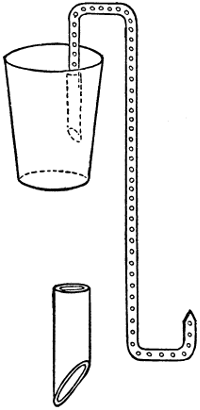
Fig. 19.—A siphon experiment.
This tubing may be obtained from almost any druggist.
Prepare for your experiment by taking the length of tubing and, with a gas flame, drawing one end out to a point.
Having done this, bend the tube twice, as shown in Fig. 19, particular care being taken to avoid any sharp angles. The bending of this tubing is easily done by holding it in a gas or spirit-lamp flame until the flame is colored yellow. The glass is then soft enough to be gently bent to the required angle.
Over the end which is not pointed slip the piece of india-rubber tubing, and then place this end in the colored water.
By applying suction to the pointed end of the tube with your mouth, the siphon may be set in motion.
If now you so arrange the tube that the oval opening is partly out of water, the flowing liquid will draw in bubbles of air which, passing alternately down the tube with the drops of colored water, produce a very pretty result.
The shape and size of the air bubbles may be altered at any time by raising or lowering the tube, and this will add to the effect of the experiment.
The experiment may be again varied by removing the tube from the liquid, and before lowering it again, allowing 10 or 12 inches of air to enter. This long bubble will be seen to pass slowly down the tube until it arrives at the small opening, when it will be expelled at a great rate. The liquid following this bubble acquires the same velocity, and, arriving at the point, is ejected with such force that it will rise to a height of 6 or 7 feet.
[309]
Most of you would like to make an electric fountain, especially when you learn how simple and easily arranged is this striking experiment. Your apparatus consists solely of a glass, a long india-rubber tube, with two small glass tubes and a piece of sealing-wax (a stick of sulphur or piece of vulcanite will do just as well).
Make a small nozzle by drawing out a length of bent glass tubing, and, by means of a long piece of india-rubber piping, fix it to another piece of bent glass tubing. Place the first piece of tubing bent at two right angles over the side of a glass filled with water, taking care that the reservoir thus formed is from 3 to 4 feet above the nozzle (Fig. 20).
When the fountain is playing the issuing jet of water will be inclined to one side.
Now to electrify the fountain. Take the piece of sealing-wax, vulcanite, or sulphur, and, after seeing that both your hand and the material you hold are perfectly dry, rub the sealing-wax on the sleeve of your coat.
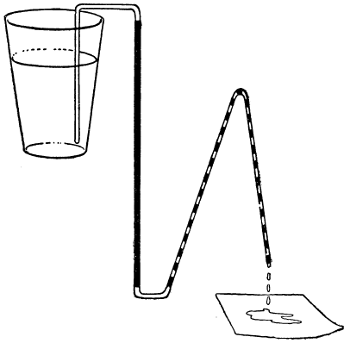
Fig. 20.—An electric fountain.
If now you hold the sealing-wax opposite the stream of water, at a distance of a few feet, a remarkable change will come over the cascades. Instead of the water falling in scattering drops, these latter will at once unite, and descend in a solid stream, whilst directly the sealing-wax is removed the jet of water returns to its original form. If the water be allowed to fall on a piece of stiff paper, a difference in sound will be noticed according as the water falls in a stream or in drops.
[310]
Doubtless you would like to have at home the experience of firing a cannon, of hearing a report loud enough to frighten nervous persons, to see the shell fly as quick as lightning, and then to witness the recoil of your home-made piece of artillery.
Your apparatus will be quite simple, for you must first take a strong bottle, such as a vinegar, or better still, a champagne bottle, and fill it a third full with water.
Next take a little carbonate of soda, and also some tartaric acid, both of which may be obtained at any druggist’s, taking care to wrap them in packets which will not be confused one with the other.
Dissolve the carbonate of soda in the water contained in the bottle, at the same time placing the tartaric acid in a playing card rolled in the form of a cylinder, one end of which should be filled with a plug of blotting-paper.

Fig. 21.—The bottle cannon.
Having accomplished this much to your satisfaction, suspend the cartridge just made from the cork of the bottle by sticking in it a pin to which is attached a thread, particular care being taken that the bottle is standing upright on the table, and that the open end of the tube is the upper one.
After having regulated the length of the thread so that the bottom of the tube does not touch the liquid in the bottle, tightly fit the cork in.
You now have your cannon charged, and all that remains to be done is to fire it.
[311]
This is done by laying the bottle horizontally on two pencils placed parallel to one another, thus forming a gun-carriage. Immediately the bottle is so placed, the water penetrates the tube, and dissolves the tartaric acid. The carbonic acid gas which is immediately produced blows out the cork with a violent explosion, whilst at the same time, owing to the reaction, the bottle rolls back on the two pencils, in exact imitation of the recoil of a piece of artillery (Fig. 21).
[312]
As we stand in the twentieth century and peer curiously down the corridors of Time, we find at all periods a deep interest in chemical phenomena.
From the age when wisdom devoted itself in vain to the discovery of an elixir of life and a method of transmuting the base metals into gold, to the present day, when scientists pursue their experiments with more reasonable and far worthier hopes, chemistry appears never to have suffered any dearth of devotees, despite the fact that in olden times one had either to occupy a high position or be a man greatly daring if the Black Art was to be followed without fear of molestation.
To-day matters are different, so that the junior chemist need only anticipate interference from materfamilias—a truly excellent person, who, however, invariably regards chemical concoctions with hostile contempt.
The obstacles instanced in the previous paragraph being foreseen, perhaps no better initiative can be taken than to conciliate the household deities by the performance of some particular experiment which has an obviously beneficial result. This might happily be the removal of ink stains from white linen; and naturally, if no cloth happen to be so disfigured, some arrangement must be made whereby the ink is accidentally spilt!
(1) Apparatus.—Erect a 4-oz. round-bottom flask about 8 inches above the table (A, Fig. 1), by clamping its neck in a wooden clip or twisted stiff iron wire, and fastening this to a firm standard. Introduce three or four tablespoonfuls of powdered manganese dioxide (obtainable cheaply in qr. lbs. at most druggists’), and pour over this spirits of salt until the flask is one-third full. Into the neck now fit a cork provided with two circular holes, through one of which a stem funnel passes, and into the other a glass tube fits tightly, being[313] bent at two right angles, as shown in Fig. 1. The glass tube may be readily bent by softening it first over a spirit lamp—the flame being colored distinct yellow when the glass reaches a pliable state. Slide a 41⁄2-inch disc of paper (B, Fig. 1) on the free limb of the tube, and also soak several 4-inch circles of cardboard in water. These will make satisfactory covers for the small glass preserve jars, in which the gas is to be collected.
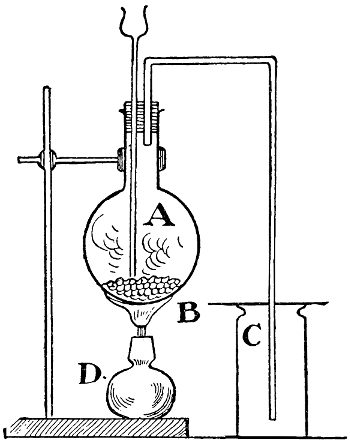
Fig. 1.—Apparatus for chlorine experiments.
(2) Preparation.—Place one jar beneath the glass tube so that the latter’s orifice reaches nearly to the bottom, and slide the paper disc down until it covers the mouth of the jar C. On warming the glass flask gently with a spirit lamp or, if available, Bunsen gas flame, a greenish-yellow gas is evolved, and gradually expels the air from flask, tube, and jar, until this latter is filled with heavy chlorine. The warming is then interrupted whilst the one jar is removed, covered with a moist cardboard disc, and replaced by another. The heating again proceeds, and so on until each remaining jar is successively filled.
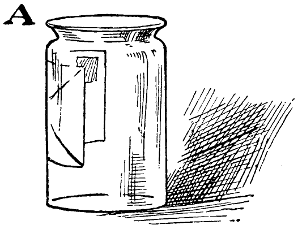
Fig. 2.—The unalterable postmark.
Chlorine Experiments (1).—Damp an addressed envelope, received through the post, by pressing between sheets of wet blotting-paper, and stand it in a jar of chlorine with the cover replaced (A, Fig. 2). The writing ink address will soon begin to fade and finally disappear, whilst the postmark, which has been impressed in indelible printing ink, remains unaltered. This reaction shows that chlorine possesses the valuable property of bleaching writing ink. It may be turned to account in removing stains from cloth by wetting the spoiled material first and then standing in a vessel containing the yellow gas (Fig. 3). The fabric must be quite damp, however, as bleaching only proceeds in the[314] presence of moisture. Coloring matters, other than black ink, are readily removed by chlorine, as may be strikingly shown by steeping a wet rose blossom or bunch of violets in a jar of the gas (Fig. 4); the flowers assume a transparent waxy appearance, that will puzzle any spectator as to their real identity.
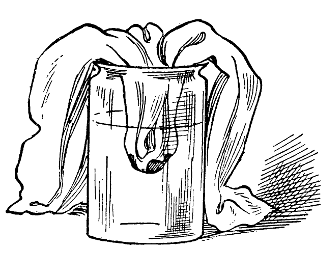
Fig. 3.—Removing stains from linen by means of chlorine.
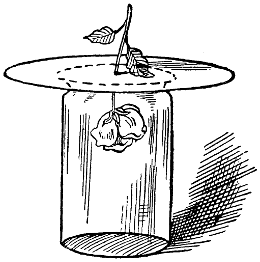
Fig. 4.—The transparent rose.
Chlorine Experiments (2).—The energetic gas attacks many substances spontaneously. If thin blotting-paper be soaked in turpentine, drained, and dropped into a jar of chlorine, the oil takes fire at once, burning rapidly amid smoky black fumes. Metals are attacked just as readily as the inflammable oil of turpentine. Powdered antimony metal or iron filings shaken into a jar of chlorine scintillate brilliantly with the evolution of thick white fumes. Similarly Dutch metal leaf, used for gilding cheap picture frames, ignites in the gas; a salt of copper being precipitated to the bottom of the jar when the action has ceased.
All dealings with chlorine should be conducted in a well ventilated—even draughty—room, and care must be taken not to inhale the gas. It corrodes animal tissues just as eagerly as it attacks turpentine and metals. The gas is very heavy, however, and is therefore the less difficult to keep under control.
Niter Paper.—Touch-paper burns quickly, surely, and without flame. It is prepared by soaking thin tissue paper with a saturated solution of saltpeter in weak vinegar, and when dry feels rough and crisp to the touch. Moreover, it burns with a rather pleasant smell. The advertisement scheme of bygone days, wherein a lighted match was placed on a particular spot of a paper sheet, and thence the name of the advertised commodity gradually burnt itself out over the[315] surface, was a modification of this preparation (Fig. 5). The name or design is simply drawn with a pointed stump of wood dipped repeatedly in the saltpeter solution, and the starting-point marked conspicuously by a cross or black spot. When dry a match is applied to this mark. If there is a tendency for other parts of the paper than the design itself to burn, a short immersion in dilute alum solution, when the saltpeter lines have dried, may be resorted to.
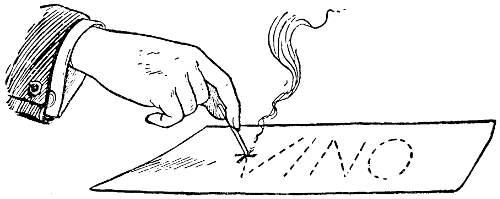
Fig. 5.—A niter paper experiment.
Electric Fire.—This compound is in no way of an electric nature, except that it burns rapidly with brilliant blue illumination. The constituents are flowers of sulphur, saltpeter, and antimony, four parts of the former being intermingled with ten parts of powdered saltpeter, and then one-seventh the total quantity of powdered antimony finally added. Thorough mixing by gentle stirring must be insured. A good method of firing the powder is to pack it round a twist of touch-paper in a small mustard tin, threading the fuse (A, Fig. 6) through a hole in the lid, so that it may be lighted easily. The mixture burns[316] not only brightly, but with intense heat—sufficient to melt the thin iron of the inclosing tin.
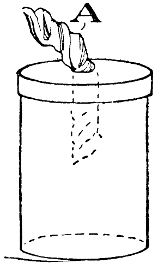
Fig. 6.—Lighting electric fire.
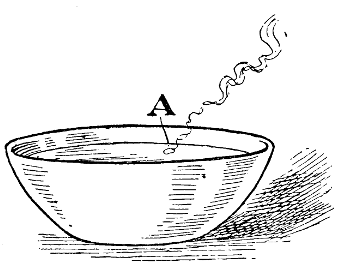
Fig. 7.—A sodium or potassium experiment.
The Lightest Element.—Hydrogen is a gas at ordinary temperature, and has the honor of being the lightest element, for all practical purposes, known. For this reason it finds wide employment in filling balloons and airships. The most common methods of preparation consist of decomposing water or an acid in their several constituents, either by the influence of electricity or the reaction of a metal. For instance, if a pea’s bulk of sodium or potassium metal be thrown into a basin of water, A, Fig. 7, (the experimenter should not bend directly over the vessel), a violent reaction ensues, the metal decomposes and hustles round the surface as though in feverish excitement, and in the case of potassium a purple flame springs up spontaneously. The sodium may also be ignited if it is thrown on to a floating piece of blotting-paper, or if the water be thickened with starch. This metal burns with a yellow flame, or rather colors the hydrogen flame yellow.
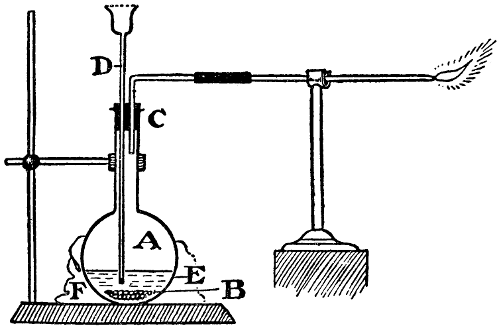
Fig. 8.—An interesting hydrogen experiment.
Preparing hydrogen by the foregoing method is inconvenient and expensive if any quantity is to be collected, and so in this case the following plan is usually adopted:—Support a flask (A, Fig. 8), and place zinc chips (B) in it to the depth of about 1⁄4 inch. Fit the mouth with a cork, through which passes a delivery tube (C) and a “thistle” funnel (D), dipping nearly to the level of the zinc. When the gas is required, dilute sulphuric acid—one part oil of vitriol to ten parts water—is poured down the funnel until the flask is about one-third filled (E).
Five or ten minutes should be allowed after bubbling has commenced before an attempt is made to light the gas at the delivery tube, as otherwise air from the flask may be intermingled in the exact proportion to cause a bad explosion. No danger need be feared if several minutes are allowed for the air to be thoroughly dispelled, or, as an additional measure of safety, a damp towel (F) is wrapped round the flask to prevent scattering of the glass in the event of a mishap. The glass delivery tube should have been softened in a spirit flame and[317] drawn to a fine point where the hydrogen issues. The gas will be found to burn with an almost colorless flame.
If a glass tube (A) of larger bore than the delivery pipe be slid over this latter while the gas burns, a peculiar musical note is produced—hollow-sounding and shrill (Fig. 9). It is caused by the rapid succession of slight explosions which constitute the combustion of hydrogen.

Fig. 9.—A musical flame.
The extreme lightness of hydrogen, as well as its combustibility, is well illustrated by blowing a soap bubble. Connect a clay pipe with the glass delivery tube by means of a length of india-rubber tubing, and provide this latter with a small clip—tie-clip, for example—so that the gas supply may be shut off at will (Fig. 10). Let the hydrogen pass for a minute or so, to clear air out of the clay pipe, and then, having shut off the gas, dip the pipe bowl into soap-suds. Next open the clip until the hydrogen has blown the bubble large enough, and then shut off, shaking the shimmering globe free. It will rise very quickly, just like an unballasted balloon, and if a lighted taper be applied to its surface it will explode to annihilation with a loud report.
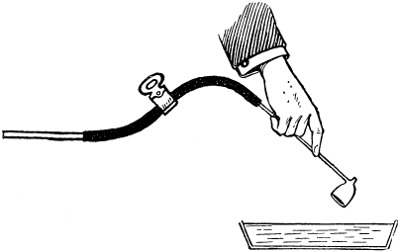
Fig. 10.—To explode a soap bubble.
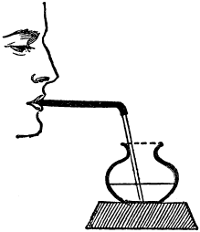
Fig. 11.—Freezing a flask of ammonia to a block of wood.
Spirits of Hartshorn.—Commercial ammonia is actually an aqueous solution of the gas, which dissolves to an abnormal extent in water. When it has been absorbed as much as possible the liquid weighs only 22.25 as much as an equal bulk of water, owing, of course, to the latter’s association with a compound far lighter than itself. So great is the energy of solution that heat is dissipated from the liquid as[318] absorption proceeds. Conversely, if the gas be dispelled by blowing air through strong liquor ammoniac, heat is rapidly absorbed at the expense of surrounding objects. To show this, stand a small flask in a pool of water on a wood block, and having about half filled the flask with fresh ammonia, blow into this through a glass tube connected with the mouth by a length of rubber tubing (Fig. 11). No long time should elapse before enough heat has been abstracted from the water to convert it into ice, so that the flask is frozen firmly to the wood.
Another demonstration of water’s avidity for ammonia gas is afforded by the following performance. Erect one large flask (A) in an inverted position, so that the distance between its neck and the table is several inches greater than its own height. Some distance away, as shown in Fig. 12, erect a small 4-oz. flask (B), and half fill it with a mixture of four parts sal-ammoniac to three parts slaked lime (C). Fit the neck with a cork and a delivery tube, which has been so bent as to pass through a stopper in the mouth and reach nearly to the bottom of a jar (D) packed with quicklime (E).
Another glass tube (F) issues from this chamber—but only from just below the cork’s under surface—and passes upwards into the orifice of the large flask. A square of paper (G, in Fig. 12) is pushed over the glass tube and presses against the mouth of the flask.
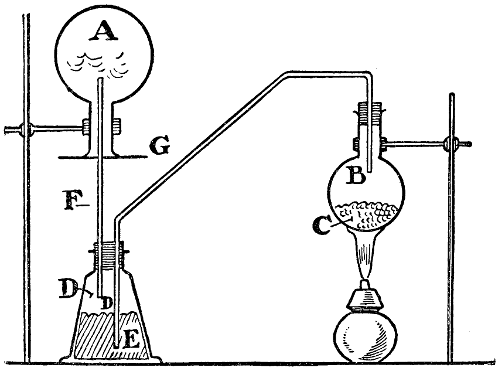
Fig. 12.—To prove water’s affection for ammonia.
If now the mixture in the 4-oz. flask be warmed, ammonia gas is produced, and having been robbed of moisture by the quicklime through which it passes, travels upwards, and collects in the large inverted[319] flask. When the action has continued for a little while, stop the heating and remove the delivery tube, and bring an open spirits of salt bottle near the inverted flask’s mouth. If dense white fumes are immediately formed, the flask is known to be filled with ammonia gas, and must be corked up.
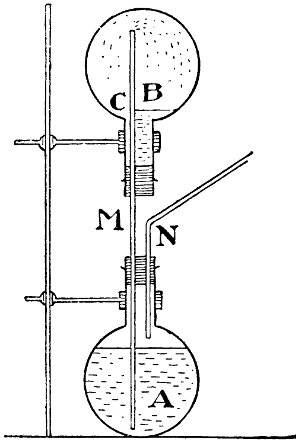
Fig. 13.—A novel fountain.
Beneath this container is next stood another large flask filled with red litmus solution (A) and fitted with a stopper, through which pass two glass tubes (M and N, in Fig. 13). One of these (N) is bent outwards, and extends only just inside the flask’s neck, whilst the other is long enough to reach from the bottom of the lower flask almost to the top of that holding the ammonia. Instead of red litmus solution, a liquid made by boiling red cabbage leaves in water, and adding just enough vinegar to dispel entirely the bluish coloration, may be used with equal success.
The position then is that two flasks—of which the upper (B) holds ammonia gas, whilst the lower retains a pink solution—are supported one above the other, their necks approaching and joined by a glass tube (M). A second glass tube (N) also emerges from just above the surface of the pink liquid, and is bent outwards from the flask, so that it may be held in the mouth. When this is blown through, the pink water is forced up the connecting tube (M) and sprays out, fountain-like, within the upper flask. Moreover, as the ammonia is so rapidly absorbed by the incoming water, this continually ascends to fill the vacuum, which tends to form as the gas is dissolved. The fountain continues to play when the blowing has ceased, and further, although the spray presents a reddish tinge on entering the flask, it immediately turns blue as the ammonia dissolves (C, Fig. 13). This reaction indicates the alkalinity of ammonia, such substances being capable of neutralizing acids, which redden solutions of vegetable blues.
[320]
The famous King Belshazzar was much dismayed to see the mysterious writing upon the wall of his palace. Without reducing your friends to a similar state of terror, a very easy experiment can be performed productive of the same effect, and if it does not exactly make their knees strike together, it will astonish them very much.
The appliances are such as can be found in any home, and the strange writing can be produced in the following way.
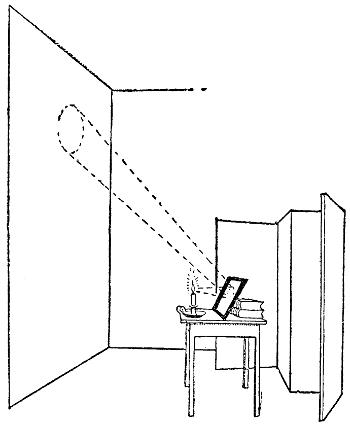
Fig. 1.—Showing relative positions of candle and mirror so that patch of light is thrown on the wall.
At one end of a dark room erect a screen that shall conceal you and your apparatus effectually from the spectators. Upon a table behind this screen place a large mirror, such as can be found upon any dressing-table. Put a lighted candle in front of this glass, placing the latter at such an angle that a large patch of light is thrown upon the wall before you, as in Fig. 1.
The screen must, of course, hide all this from the company, who will see nothing but the light on the wall.
To write your message is now a very simple matter. Dip a coarse brush into some lamp-black water color, and, writing backwards, inscribe what you wish upon the face of the mirror. The[321] message will then appear legibly upon the wall, seemingly written by a mysterious hand.
By dipping the brush into clean water and washing out what you have written upon the glass, the message on the wall will disappear as inexplicably as it appeared in the first place.
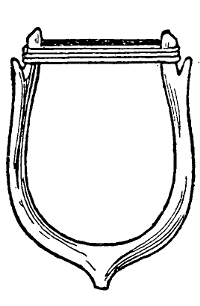
Fig. 2.—Thread passed round prongs of the bone.
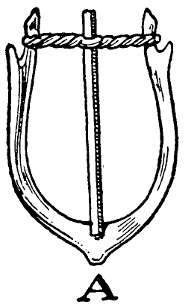
Fig. 3.—Match through twisted thread.
A peculiar optical illusion is accomplished as follows. The wishbone of a fowl or duck should be thoroughly cleaned, and a thread passed several times around the prongs of the fork, as shown in Fig. 2. Having secured the thread tightly, pass a strong wooden match between the strands, twisting it several times until the prongs of the bone have been drawn closer together (Fig. 3).
Now, pulling out the match sufficiently to allow of one end catching against the fork, hold the bone firmly. Releasing the match it immediately describes a circle, striking against the under part of the fork, but so rapidly has it completed this revolution that the eye has been quite unable to follow it. This causes an illusion that induces all who witness the experiment to imagine that the match passes through the fork of the bone at A.
But if the eye was too slow in the last experiment, it is so officious in what is next to be described that it sees something which really does not take place.

Fig. 4.—The lion and his cage.
[322]
Draw a lion and a cage, as in Fig. 4. If you place a visiting card upon the line A B, and put your face so near that the right eye looks upon the lion whilst the left can see only the cage, you will observe the lion walking into his cage as naturally as if he were at the Zoo!
A rather amusing experiment, and one which will afford immense pleasure to the juvenile members of your party, is as follows:—
Cut a circular disc of stout cardboard 12″ in diameter. In the center make a hole to allow the disc to revolve easily, but not loosely, upon a wooden penholder, which should be fixed at right angles to a wooden stick (Fig. 5).
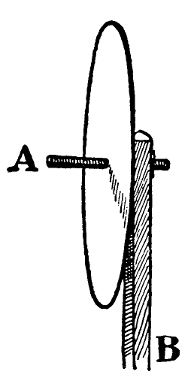
Fig. 5.—Disc of cardboard kept in place with penholder.
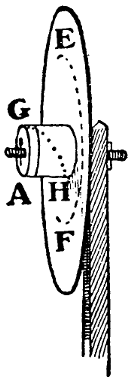
Fig. 6.—Showing box in correct position.
Upon the center of the disc fasten a cylindrical cardboard box (A, Fig. 6), with the penholder passing right through it. This box should be roughly 3″ high and 2″ in diameter.
At a radius of 41⁄2″ from the center describe a semicircle upon the disc at E F (Fig. 6), whilst upon the same half of the cylinder describe a line as G H in the same figure. Now pierce about twenty-five equidistant holes in E F and G H, joining them with thread, as in Fig. 7.
Cover these threads with little strips of paper in such a manner as to make a plane surface, as shown in Fig. 8. Then fasten a cork upon the end of a wire attached to the stick, and in a cleft in this cork put a little cardboard figure as in the illustration.
Make the disc revolve by a rapid turn of the hand, and if a candle be so placed as to cast the shadow of the little man upon the disc,[323] he will be seen engaged in making sundry passes and lunges in the manner of the perfect fencer.

Fig. 7.—Mode of joining thread.
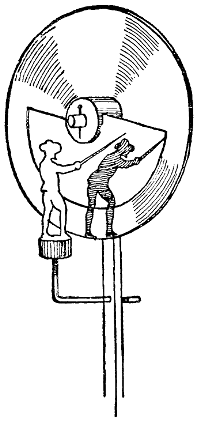
Fig. 8.—The toy complete.
Various other figures can be made in a similar way with great success, and when cleverly managed the toy will be found most amusing.
If at any time it should happen that an engaged couple are amongst the friends whom you wish to entertain, a very simple piece of apparatus can be made that will give these good people much pleasure.
In the four sides of a cube box, measuring 18″ each way, make an oval opening, 9″ by 7″, as A, B, C, D in Fig. 9. Inside the box place two mirrors, back to back, diagonally from G to E (Fig. 10), and contrive four curtains to draw up simultaneously over the holes.
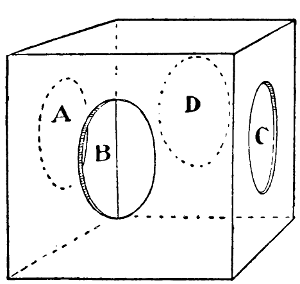
Fig. 9.—Showing box with oval openings.
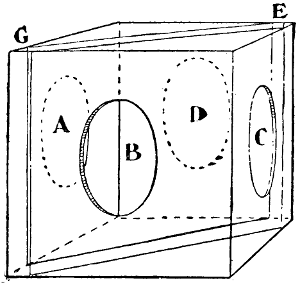
Fig. 10.—Showing box with oval openings and mirrors.
You must now get two couples to look through the holes, arranging the two men opposite each other, as at A and C, and the ladies at B and D, promising them that by looking into the simple but magical box they shall see the future partners of their lives and pleasures.
As soon as they are in position raise the curtains, when A will see B, and C will be gazing at D, so that if you have sorted the[324] parties aright, they will feel so pleased with themselves and with you that no inquiry will be made as to how the trick is done.
To turn from sight to hearing, the following is a simple experiment which can be exhibited without any special apparatus.
Cut a plain cross from a sheet of notepaper, as in Fig. 11, and place it over a wine-glass, bending the ends to prevent it slipping off. Almost fill the glass with water, taking great care to leave the sides and rim perfectly dry.
If you damp your finger and pass it over any part of the glass outside, a distinct humming will be heard, but the more remarkable thing to observe is that the cross will begin to revolve very slowly so long as your finger rubs a portion of the glass between the arms of the cross—as at A in Fig. 11. Yet when you begin to rub beneath one of the arms the paper will remain perfectly still. A complete revolution of the paper can be produced by rubbing round the glass in a circle.
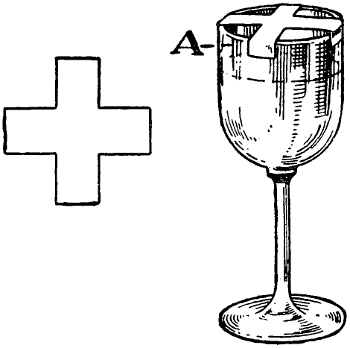
Fig. 11.—Showing paper cross and glass almost filled with water and cross placed over the top.
The vibration of the glass when emitting the notes explains this phenomenon, although the reason that the cross should remain still when you rub beneath one of its arms is too technical for explanation here.
[325]
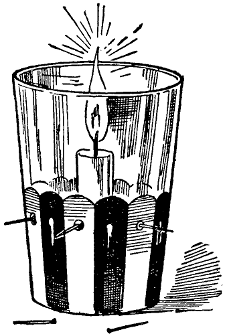
Fig. 12.—A “light” experiment.
Why do we wear white clothes in extreme heat and dark clothes in the winter? To this question every one will answer that white clothes absorb less heat than black, and that we therefore feel the rays of the sun less.
Quite true; and yet, how is it that Polar bears and other Arctic creatures exposed to such extreme cold are clothed in white?
The fact is that not only does white absorb less heat, but it serves to retain heat, and a white coat preserves the natural warmth in the animal’s body. This is exemplified by the following experiment, for which only a tumbler is required.
Choose a glass with the lower part faced, as in Fig. 12. Color these faces black and white alternately, a little India ink serving for the former and some crushed chalk and water for the latter.
With a very small knob of wax fasten a pin to each face, as shown in the figure. Having done this place a lighted candle within the glass.
The heat, striking the interior equally, is modified by the colors painted on the outside to such an extent that after some little while the wax supporting the pins of the BLACK faces is melted, whilst the pins on the white parts remain unaffected. This shows very clearly that the white prevents the escape of internal heat, as surely as it prevents the penetration of external warmth.
We all know that metals expand under heat. The amount of such expansion may be measured by a simple little apparatus called a pyrometer.
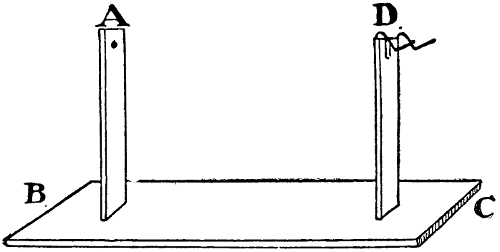
Fig. 13.—Showing how to make a pyrometer.
On a wooden base, B, C (Fig. 13), make two uprights, A and D, of which A must be a half inch higher than D. Bore a hole a quarter of an inch from the top of A, but not right through the wood.
A couple of pins must be bent into the shape of a Y and driven into[326] the top of D, as in Fig. 13. With a little sealing-wax fasten a paper pointer to the eye end of a needle and lay the needle across the pins, P, P (Fig. 14). Next place an ordinary knitting-needle in the hole at A, and rest it over the small needle with the pointer. The pyrometer is now complete.
Put a lighted candle under the knitting-needle between D and A, as in the figure, taking care that the flame plays freely upon the needle. As the latter grows hot you will notice that the pointer moves slowly from left to right, being acted upon by the hot knitting-needle passing over the axle at X.
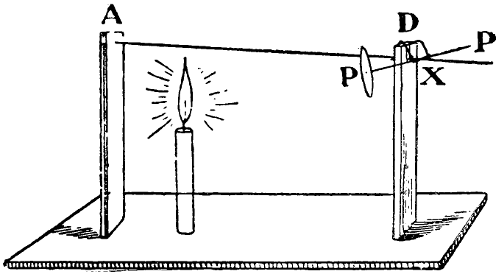
Fig. 14.—Showing needle laid in position across pins.
If a small paper dial be made against the pointer, the amount of the expansion can be even more clearly observed. Of course two or even more candles may be used, the result being that the needle shows more and more expansion as it becomes hotter.
An interesting and useful experiment with a broken bottle is depicted in Fig. 15.
Fill the broken piece with oil to whatever level you desire it to be cut, and stand it upon a perfectly level table. Now plunge a red-hot poker into the oil and hold it there for a few seconds, when there will be a loud crack, and the top of the broken part will come off, even and smooth, as in Fig. 16.
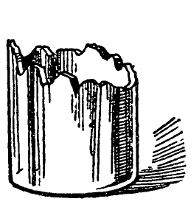
Fig. 15.—Portion of broken bottle for experiment.
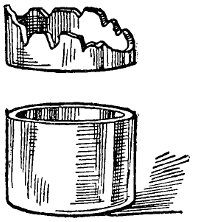
Fig. 16.—Showing smooth break after red-hot poker has been plunged into the oil.
[327]
It may not be generally known that a sheet of glass may be cut regularly and evenly with a pair of strong scissors.
A glance at Fig. 17 will give an idea of how this is done. The apparatus required is a large pail of cold water and a pair of strong scissors.
Plunge the glass, the scissors, and the hands, right into the water so that no part of either scissors or glass escapes immersion. You will now find that the scissors cut cleanly without the glass cracking or splintering.
The reason for this is that the water deadens the vibrations both of the scissors and the glass, thus insuring a neat and clean fracture.
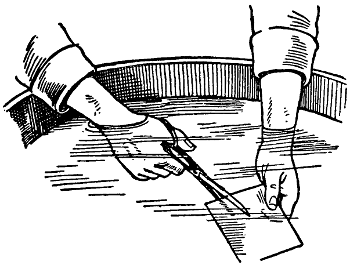
Fig. 17.—A glass-cutting experiment.
An interesting and effective experiment may be performed with compressed air. The arrangements are very simple and the requirements few.

Fig. 18.—Walnut shell with necessary holes bored.
Divide a walnut shell into two, and bore a hole in the bottom of each half. In one of the cups thus obtained make another hole half-way up the side, as in Fig. 18. Now, with a little sealing-wax fasten three straws into these holes.
In the cork of a fair-sized jar, which should be of some opaque glass, bore two holes, through which the straws must be placed at unequal heights, as shown in Fig. 19. Having almost filled the jar with clear water, place the cork with the straws so tightly that no air can possibly enter either at the sides or by any other means than through the straws.
The following strange effect will now be obtained. Pouring some colored liquid into the top shell A, plain clear water will come from the spout C of the lower shell B, and will continue as long as you pour from above (Fig. 20).
The reason of this is that the compressed air in the jar forces the clear water through the straw at B, which, being plunged deep into[328] the clear liquid, carries off none of the colored matter passed into the jar by means of A.
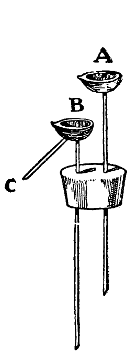
Fig. 19.—Showing positions of straws for experiment.
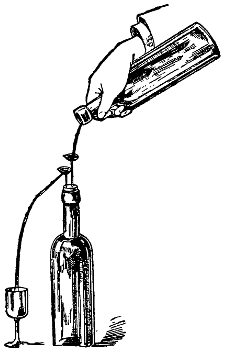
Fig. 20.—Pouring the colored liquid into the top shell.
This experiment may be performed with red wine and water, but the result is not quite so satisfactory on account of the ease with which wine and water mix.
[329]
A very interesting and amusing experiment may be performed with a bottle and a cork.
Take a cork of a diameter less than the internal diameter of the neck of the bottle you propose using, and ask a friend to make it enter the bottle by blowing upon it.
At first sight this seems a very easy task, and your friend at once proceeds to blow strongly upon the cork. This, however, instead of making the cork enter the bottle, causes it to fly out.
Again your friend tries to overcome the troublesome cork, on the next occasion by blowing very gently, but again it flies out (Fig. 1).
The explanation of this is as follows:—
In blowing upon the cork, a certain amount of air at the same time enters the bottle, the air in which becomes so compressed that it rapidly ejects the cork. There are, however, three ways in which the refractory cork may be overcome.
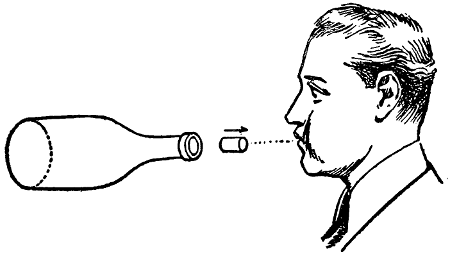
Fig. 1.—The refractory cork.
Since you know that by blowing on the cork it is at once ejected, try to achieve success by performing the contrary action—that is, by withdrawing some of the air from the bottle.
Indeed, the experiment will prove to you that, by so doing, you create in the bottle a partial vacuum, and as soon as your mouth leaves the neck of the bottle air enters it owing to atmospheric pressure. This incoming current of air pulls with it the cork, which at once slides into the aperture.
The same result may also be achieved by first warming the bottle,[330] when, owing to the expansion of the air, a part of it is expelled. Directly the air inside the bottle cools, a vacuum is created, and a current of air from without enters. If you add to this current of air by blowing air from your mouth, you will find this quite sufficient to cause the cork to enter the bottle. Then, again, having a straw or a pipe-stem handy, all you have to do is to blow through the tube, directing the air exactly on the base of the cork, which will once again enter the aperture.
Whichever of these means is adopted, you must always take the precaution of seeing that the bottle is perfectly dry. It should be wiped every time. The moisture formed in the neck is sufficient to prevent the cork from gliding along the glass.
You may be inclined to think that special apparatus is necessary to make a coin fly from the bottom of a glass, but here is shown a very simple method by which the trick may be performed at any moment in your home.
First procure a liqueur glass of conical shape, having in its largest part a diameter not much greater than that of a silver dollar. At the bottom of this glass place a quarter, and above it, near the top of the glass, a silver dollar, the latter forming a kind of cover (A, Fig. 2). Now declare to your friends that, without touching the dollar, you will make the quarter jump from the glass.
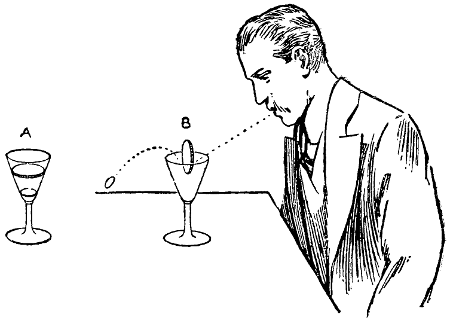
Fig. 2.—The flying coin.
This at first seems to them an impossibility, but all you have to do is to blow very strongly on the edge of the dollar. This will make the larger coin turn about on its own diameter into a vertical position, whilst the compressed air under the quarter causes the latter to fly out of the glass, after which the dollar returns to its original horizontal position.
[331]
This is a very striking experiment, and is quite easy to perform. The apparatus is also quite simple, and may be easily obtained. It consists of a lamp-chimney, a cork, a cigarette, together with two little valves.
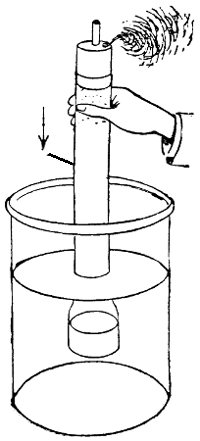
Fig. 3.—The self-smoking cigarette.
Tightly cork up one end of the lamp-chimney with a large cork, thus hermetically sealing it. In this cork bore two holes, one following the line of the cork’s axis and having exactly the same diameter as the cigarette: the other being oblique with respect to this axis, and having a much smaller diameter (Fig. 3).
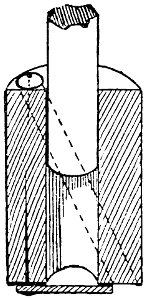
Fig. 4.—The self-smoking cigarette.
It is now necessary to make the valves. This is done by cutting from a glove two round pieces of the skin or leather, which, by means of pins, may be fixed over the holes, one being above the little hole on the top of the cork, the other over the large hole on the under side of the cork.
The first valve allows the smoke to escape, at the same time preventing the entrance of any external air, whilst the lower valve allows the smoke from the cigarette to enter the glass tube, but will not allow it to escape by the same hole.
Having thus made the valves, next plunge the tube in the water as far as the cork, and place the cigarette in the hole made for it. After having lit it, proceed to make the lamp-chimney smoke it.
In order that it may inhale the smoke, slowly raise the glass. By so doing a vacuum is produced between the surface of the water and the bottom of the cork. To destroy this vacuum, air must enter from without, and the only means of its entrance is through the cigarette, as the valve on the top of the cork remains tightly closed. In passing through the cigarette this current of air greatly assists combustion, and the smoke formed will pass with the air into the lamp-chimney.
If now the glass be lowered again, the air which is compressed by so doing closes the central valve, whilst that above the oblique tube is opened. From this valve the smoke will ascend in clouds (Fig. 4).
In this way the glass may be made to smoke the whole cigarette.
[332]
Nearly every one has seen, at the circus or elsewhere, an acrobat executing giddy circular movements with a glass of water, and doubtless has wondered how it is that none of the liquid is spilt. This is due to the action of centrifugal force.
Having placed the glass full of water on the table, it is only a matter of taking it properly with the hand, holding it at arm’s length, and, with the arm thus extended, describing a complete circle, after which it may be placed upon the table without the loss of a single drop.
To insure the success of the experiment, particular attention must be paid to the manner in which the glass is held. Instead of taking it as you would when drinking, hold it with the hand reversed, the palm being turned upwards, as shown in Fig. 5.
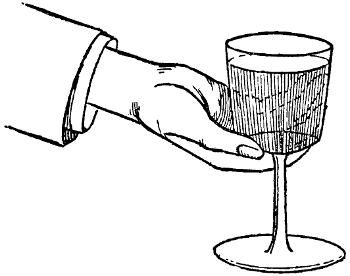
Fig. 5.—Centrifugal force experiment. First position.
Without hesitation throw the arm in the air, and swing it, not too quickly, but without shaking it, in the direction of the arrows in the diagram (Fig. 6).
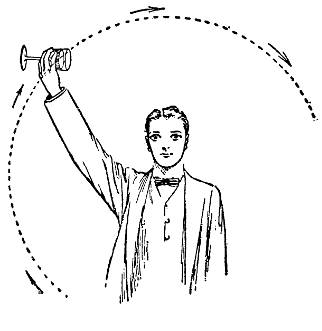
Fig. 6.—Swinging the glass.

Fig. 7.—The action completed.
After one complete revolution the glass should be as shown by Fig. 7; whilst in this position it may be placed on the table. At[333] first it is advisable to practice this experiment with water, but, as more skill is acquired, other liquids, such as milk or wine, may be used as occasion permits.
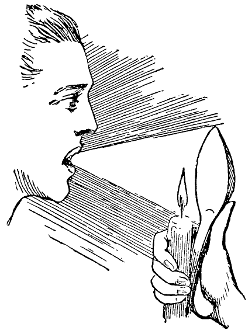
Fig. 8.—The spoon mirror.
A simple method of illuminating the back of the mouth and throat, especially when throat trouble is suspected, may often be found extremely useful. Here is a means of supplying, at a moment’s notice, an extemporized illuminant of this kind.
Take a well-cleaned spoon, and hold it against a candle flame, when you form an excellent mirror, which will permit you to concentrate the rays of light and produce at the back of the throat enough illumination for the making of a careful examination (Fig. 8).
A silver spoon, moreover, allows you to study the curious properties of curved mirrors. Holding the hollow part of the spoon before your face, notice that the head is at the bottom; turn the spoon round, and you have the bulging part a convex mirror, which will show an image, very long and narrow. If you approach this face in the spoon little by little, you will see the nose attain the most amusing proportions.
If you look at an object which has been placed in water, owing to the phenomenon of refraction, the article appears in a different position from that in which it really is.
It is due to this phenomenon, therefore, that a stick, when half plunged into water, seems to be bent or broken.
A very interesting experiment based on this principle is the following:—
Take a bowl full of water, and at the bottom place a coin. Next request one of your friends to lower his head until his eye, the edge of the bowl, and the near edge of the cent, appear to be in the same line.
As a matter of fact, it is not the coin itself that your friend can see, but only the image created by refraction.
[334]
Now, keeping your friend in the same position, inform him that you intend to make the coin disappear from his view.
To do this, remove some of the water from the bowl, which may be accomplished by means of a small syringe (Fig. 9).
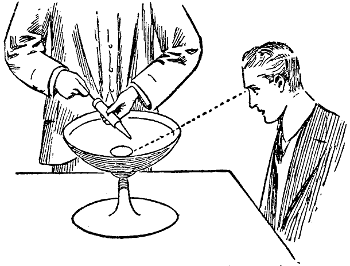
Fig. 9.—The disappearing coin.
Directly you lower the level of the water, your friend will no longer be able to see the image of the coin, which will be hidden by the side of the bowl. If, however, the extracted water be replaced, the image of the coin immediately reappears.
Very few people realize that paper can be electrified at a moment’s notice, no special apparatus for the purpose being required.
Take a piece of light paper, which should have been well dried, and rub it briskly with a clothes brush, silk handkerchief, or even the open hand.
After a little time the paper, becoming electrified, will adhere to your face, your hands, or your clothes, as easily as if it were attached by means of gum.
Nor is this property confined to thin paper. Thick paper, when dried, will act in the same manner. For instance, take a postcard, dry it, and rub it, and you will notice that, as is the case with sealing-wax, glass, sulphur, &c., the card has the power of attracting light bodies, such as small pieces of cork.
The following interesting experiment may be carried out with an electrified postcard and a walking-stick.
Balance the walking-stick over the back of a chair, and announce that you can make the stick fall without touching it, without blowing it, or without interfering with the chair. This is easily possible by utilizing the electrified postcard.
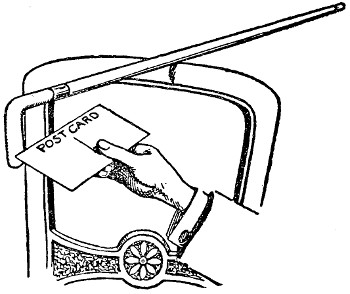
Fig. 10.—The electrified postcard.
[335]
First rub it on the sleeve of your coat. Now hold it near one end of the stick, and you will notice that the latter follows it as iron follows a magnet (Fig. 10), until the moment when the equilibrium being destroyed, the stick falls to the ground.
Of course the experiment may be varied by using any other suitable article in place of the stick, as for instance a fishing-rod.
From the last experiment it may have been gathered that if a piece of paper is dried and rubbed with a silk handkerchief or the dry hand it will adhere to the face, arms, or clothing.
It may not be so widely known, however, that if toy balloons be filled with air, and then stroked for a short time with a piece of fur, they will act in the same way as the electrified paper.
It is rather amusing to see these balloons, after being treated thus, placed against the wall or ceiling, where they will stick as if they were glued there.
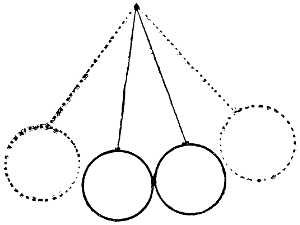
Fig. 11.—The electrified balloons.
Having entertained your friends in this manner, you may, by way of a little change, take two of these toy balloons, and, after having electrified them, suspend them from the same point by means of two silken threads.
You will be surprised to find that the balloons now repel each other in the same manner as pith balls do (Fig. 11).
Flour will create an explosion!
Take a large handful of flour, and leave it for some time near the fire, in order that every trace of dampness may be expelled.
Whilst the flour is drying take a large tin box (a cracker tin will do admirably), and near the bottom make a small hole.
Through this hole pass the end of a piece of india-rubber tubing, and place the handful of dry flour in front of it.
At the other end of the box place a short piece of candle, and after lighting it, cover the box with the lid, taking care that it is not too firmly fixed.
[336]
If you now blow down the tube with your mouth, or better still, with a pair of bellows an explosion at once takes place, as a result of which the lid will be blown off (Fig. 12).
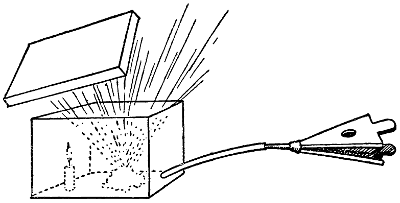
Fig. 12.—Exploding flour.
If flour be not available the experiment may be performed with equal success by using fine dust, such as may be found on the backs of pictures, or collected from any elevated parts of the room.
Have you ever had tea on the top of a mountain? If so, you will agree that your cup of tea could by no means be termed excellent.
Now, why is it that a cup of tea made on a mountain-top is much inferior to one made at a lower level? If the fault lay in the tea, the defect could be easily remedied, but such is not the case, for it depends upon the fact that water on the top of a mountain boils at a lower temperature than water at the sea-level.
In order to make a good cup of tea, the water must boil at a temperature very near 100° C., and it is at this temperature that the water is generally boiled in your homes.
Why is it, then, that water boils at different temperatures at different altitudes? It is because, as the altitude is increased, so the atmospheric pressure becomes less.
At sea-level, atmospheric pressure is equal to about 15 lbs. to the square inch, but at the top of a mountain it is much less. The greater the atmospheric pressure the more heat is required before the bubbles of vapor formed within the water can break at the surface.
After this explanation, perhaps the subjoined experiment will be attempted with additional interest.
Take a flask, to which should be fitted a good cork or india-rubber stopper, and in it boil some water, taking care of course to remove the stopper beforehand.
After some minutes the steam from the boiling water will have expelled all the air from the flask. Now remove the source of heat, at the same time quickly inserting the stopper.
[337]
If the flask is allowed to stand for a minute or two, the temperature of the water will fall considerably below 100° C.
Next inform your friends that, without applying any extra heat, you will cause the water in the flask to boil vigorously again. This seems to them impossible, especially when you tell them that you are going to do it by means of cold water. Quickly turn the glass upside down, and squeeze a sponge soaked in cold water on its upturned under-surface. Immediately the liquid inside will begin to boil, as if extra heat had been applied (Fig. 13).
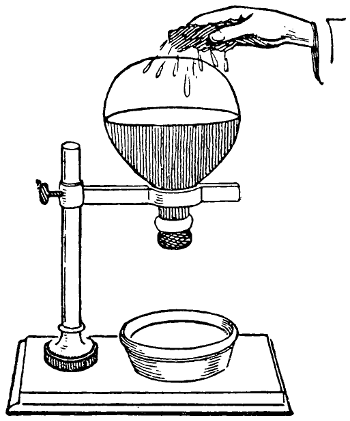
Fig. 13.—A curious boiling experiment.
But how are you to explain this apparently extraordinary phenomenon?
Well, directly the cold water comes in contact with the flask it causes the steam contained therein to condense, and, as no air can enter, thanks to the well-fitting cork, the pressure on the surface of the warm water is now considerably less than it was before.
Directly the pressure is lessened the vapor bubbles contained within the warm water are able to rise to the surface, and the water is seen to boil merrily.
Here is a very simple way of obtaining coal gas.
Procure an ordinary long clay tobacco pipe, the bowl of which should be filled with very small pieces of coal. Carefully cover the top with soft clay, and put the bowl in the fire, with the long stem protruding through the bars. Now watch this end of the pipe very closely and see what happens.
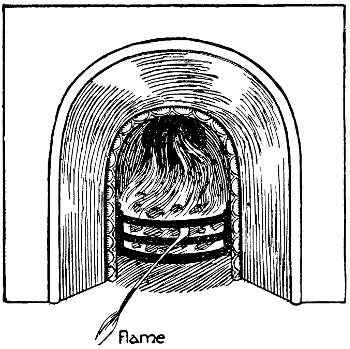
Fig. 14.—Simple gas-making.
[338]
Very soon you will notice a light-colored smoke issuing from the mouthpiece, but after a time this smoke disappears. But what happens if you hold a lighted match to the mouthpiece of the pipe? Immediately a bright yellow flame appears (Fig. 14).
The gas now burning is the same gas as is burnt in your house, although this latter, of course, is much purer.
If now you take the pipe from the fire, allow it to cool and then break it, you will be surprised to find that its contents have changed in appearance, for, in place of the coal, you will see what looks like a cinder. This is the coke. Thus you have manufactured gas from coal, at the same time producing coke.
In a previous chapter, when describing how to make a miniature cannon, it was explained that the “gunpowder” with which the “shell” was fired is in reality carbonic acid gas.
It may not be amiss to show how to generate it, in order that you may discover for yourselves some of its properties.
There are several ways of obtaining carbonic acid gas, but most of these are of a complicated nature. The following, however, is an extremely simple method.
Take a 6-oz. or 8-oz. flask, and fit it with a cork with a hole, in which may be fitted a piece of glass tubing.
This tubing should be bent twice at right angles, as shown in Fig. 15, and the longer end should be allowed to dip into a large glass.
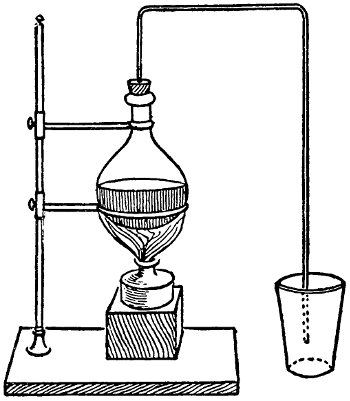
Fig. 15.—A carbonic acid gas experiment.
Into the flask pour a little lemonade, soda water or ginger ale, and after replacing the cork or tube, heat the flask by means of a gas-burner or spirit lamp.
You will notice that bubbles of gas are given off, and, as this gas is considerably heavier than air, it will, after being forced up the tube, displace the air in the glass, and gradually fill it. To test whether the glass is full, hold a match in the top. If the match is extinguished, the glass which is full may be removed. In this way several glasses can be filled, care being taken to cover each with a glass plate or cardboard disc to prevent diffusion.
[339]
From this experiment you will have discovered the three main properties of this gas (commonly known as carbon dioxide)—that it is colorless, is considerably heavier than air, and will not support combustion. Its high density affords another interesting experiment, which consists of pouring the gas from one glass to another (Fig. 16).
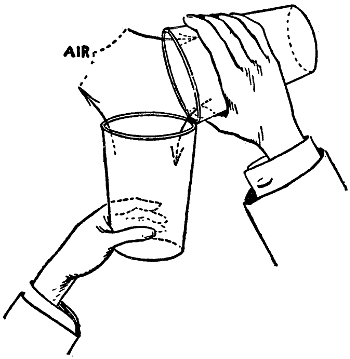
Fig. 16.—Pouring carbon dioxide from one glass to another.
Take two glasses, one full of air and the other containing the carbonic acid gas, and into each plunge a lighted match. The match of course will burn in the glass containing air, whilst it will be immediately extinguished when it comes in contact with the carbon dioxide. You have thus clearly shown which glass contains air and which contains the gas. Now take the glass containing the gas and pour its contents into the other glass, in exactly the same way as you would pour in water. Again test with a lighted match and you will find that the gas has passed from one glass to another, thus proving that it is much heavier than air.
Next take two glasses, one containing air and the other carbonic acid gas, and, by means of a clay pipe, blow a soap bubble into each, carefully watching the different manners in which they behave. That dropped into the glass containing air will sink to the bottom, where, coming in contact with the glass, it will burst. The other bubble, however, as soon as it reaches the gas in the glass, rebounds owing to the high density of the carbon dioxide, but after a time, when it has settled down, it will float motionless on the surface (Fig. 17).
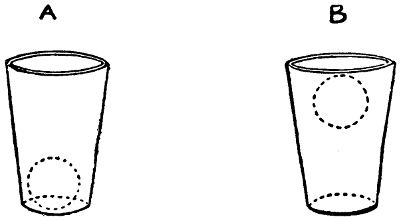
Fig. 17.—Soap bubbles in A (air), and B, carbon dioxide.
Before you finish experimenting you should know how to detect the presence of carbon dioxide. Take a little lime water, which may[340] be obtained from any druggist, and pour it into a glass containing carbon dioxide. Shake the glass, and carefully observe the change which takes place. The lime water, which was previously colorless, has assumed a certain milkiness, and if allowed to stand the white powder causing this milkiness will settle at the bottom of the glass. This powder proves to be calcium carbonate, or chalk, which is always formed when lime water comes in contact with carbon dioxide, so that you have here a means of detecting the presence of carbon dioxide. Breathe into a little lime water and you will learn, from the milky appearance it at once assumes, that the air we exhale contains a certain quantity of this interesting gas.
[341]
It has been presumed in commencing these notes that most would-be experimenters already possess a camera, or will at least shortly do so. Thus the greater number of experiments are such as would interest a camera fiend more deeply than the ordinary reader, although the latter might still derive much enjoyment from conducting them so far as the lack of a “dark box” will allow him.
It will perhaps be as well to spend a paragraph at the outset in describing simply and noting a few peculiarities about the commonplace camera. Photography means drawing by the agency of light. Now light is reflected from an illuminated object in straight lines or rays, of which a proportion may be collected by a lens and thrown in points upon a surface behind. (See Fig. 1, A, illuminated object; B, lens; C, surface behind lens; D, rays of light thrown upon surface C.)

Fig. 1.—Rays of light collected by lens and thrown upon surface behind.
The front of a camera contains the lens, and is provided with a movable shutter, so that light may be only allowed to enter the dark box when a picture is to be taken on one of the sensitive plates inside. According to Fig. 2—which represents a camera in position[342] to photograph the object A—the light is reflected in rays, which are collected in myriads of groups and cast pointed upon the surface of the sensitized plate B. Such ray groups—being parallel when they leave the object and pointed after passing the lens—are termed pencils of light, a most applicable name when they are employed in “sketching” a portrait on the photographic plate.

Fig. 2.—Camera in position to photograph object A.
It will be seen that the action of the lens causes the base of the object to be registered upon the top of the plate, and vice versa—i.e. the picture is taken upside down. Another noticeable feature about the magazine box camera, which does not, however, apply to the focussing camera with bellows, is that it may not be placed nearer than a certain distance (usually 10 feet or thereabouts) to the object photographed, or else the picture obtained will be blurred. The remembrance of this simple fact will save the loss of many plates to the tyro.
Finally a last note remains to be taken of the “stops.” These are really various sized holes in a metal screen, any one of which may be placed at will before the lens, and by the use of which the sharpness or distinctness of the photograph may be improved. Thus a lens at full aperture will not give such a sharp picture as would be obtained if a small hole were used, but, as the amount of light permitted to pass in the latter case is much diminished, a longer exposure must be given. Consequently when a short-timed snapshot is being secured, the largest practicable aperture or stop should be employed, even though the sharpness of the picture be thereby to some extent sacrificed.
Having thus briefly reviewed the essential features of a camera, arrangements may be made for conducting our first experiment.
[343]
Probably no souvenir can give greater pleasure to the amateur photographer, or prove more acceptable to his bosom chums, than their portrait, as a fireside group, lighted by the glow from a genial fire. Nor is this difficult of attainment.
First the figures should be grouped seated on chairs—and perhaps some standing behind, if many faces are to be included—in a quarter circle from one chimney-corner, whilst the camera may be securely placed some 9 or 10 feet away, about the position shown at X in Fig. 3.
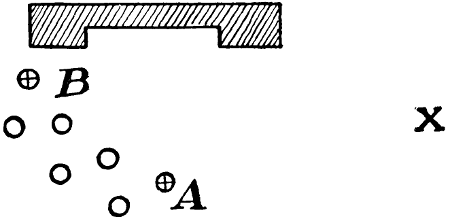
Fig. 3.—Relative positions of camera and sitters for a fireside photo.
Next some shade like a small fire-screen must be placed between the blaze and the camera, in order to protect the sensitized plate from the full glare of the firelight. Now of course the photograph is not actually secured by the coal flame illumination, which would not be bright enough to give proper exposure, so recourse is had to dropping some material into the fire which will burn rapidly with a bright white flame. Magnesium powder is generally used for this purpose.
Supposing the group to have been arranged and the camera firmly in position, the person (B, in Fig. 3) seated next the grate should hold a tablespoonful of saltpeter and also a square inch or so of sheet zinc. Then, all being so far ready, let the outside member of the group (marked A in Fig. 3) open the camera shutter and slip back to his seat, whilst the flashlight operator drops the saltpeter and zinc successively among the glowing coals. The flame of dazzling brilliancy which results records the sitters’ figures on the plate, so that directly it is over, the person (A) may again visit the camera and close the shutter. His movements will not be noticeable, since they are made before and after the flashlight.
The operation of development may be proceeded with at once and should go fairly easily, but flashlight exposures are difficult to estimate accurately, and therefore, although a square inch of zinc has sufficed for a small group with stop and an extra rapid plate, this amount may have to be increased if the group be large or if other conditions be changed.
[344]
One last hint as to behavior of the sitters. Let them sit as naturally and quietly as possible, but be advised to blink their eyes as much as the bright light prompts them rather than keep them staring wide open, when their faces must wear a most inane expression in the finished photo.
Salts of silver form the basis of most modern photographic processes. Thus in order to perform chemical experiments of a photographic nature, some solution of silver must be available, the nitrate salt being usually employed.
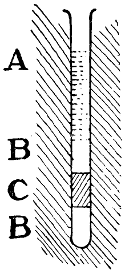
Fig. 4.—Silver solution and precipitate.
It is best procured at the druggist’s in solution or as crystals, in which latter case it must be dissolved for use in clean rain or distilled water. The solution need be only weak, but must be kept in a dark bottle screened from daylight. Chemical test-tubes, if they can be obtained, will be found best for the experiments.
(1) Prepare a weak solution of table salt, and add it drop by drop to a little of the silver nitrate in a test tube (or wine-glass as a makeshift). A white sediment is precipitated, which, by shading part of the tube with a band of paper and exposing to daylight, may be shown to be sensitive to light, inasmuch as the unscreened part will rapidly turn purple. This precipitate consists of silver chloride, which, in combination with unaltered nitrate, forms the essential ingredient of printing paper. In Fig. 4, A is Solution; B, Precipitate; C, Band of Paper.
(2) Photographic plates are coated with bromide of silver, a yellow substance, which may be prepared similarly to the previous precipitate by adding potassium bromide solution (instead of table salt) to the nitrate of silver. Its appearance does not change rapidly under the influence of light, but if first exposed and then treated with a developing solution the yellow color very soon changes to black—finely divided metallic silver being, in fact, produced. Actually, light more readily alters the constitution of the bromide than that of the white chloride, but the former knows better how to preserve an outward appearance of composure.
(3) Suppose, now, another solution be made, this time of the fixing salt known familiarly to every camera knight as “Hypo.” When this is added to either the white chloride or yellow bromide[345] precipitates above noticed, they gradually dissolve away, except such portions as have changed color under the influence of light.
Such action constitutes the process of fixing a photograph, whereby the sensitive silver compound is removed from those parts of the paper or plate which have more or less escaped the influence of light.
(4) This experiment is an aquatic performance in which one actor only—our old acquaintance Hypo—takes part. Provided proper care be taken in the preparatory stages, it will afford at the climax as excellent a spectacle as many another more complex.
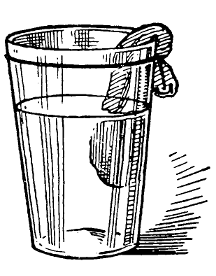
Fig. 5.—Preparing saturated solution.
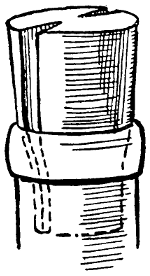
Fig. 6.—Grooved cork for “dripping” solutions.
A tumbler glass full of saturated solution has first to be prepared, and this is best done by tying about 1⁄2 lb. of Hypo in a piece of muslin, so that it may be held against the rim of the glass and allowed to hang in hot water after the manner of Fig. 5. When an appreciable quantity of the salt has dissolved, the liquid being but lukewarm, the muslin bag may be removed and the solution stirred gently. Then it must be stood somewhere firm, and allowed to remain absolutely undisturbed until cold. There should then be a glass full of clear liquid, and the phenomenon is at hand.
Let the smallest crystal of solid Hypo be dropped in this liquid, or let it but be disturbed, and behold! a wonderful transformation proceeds, until the glass interior becomes a shimmering mass of sparkling crystals. The reason of this curious behavior is not far to seek. Hypo, in common with most chemicals, dissolves to a greater extent in hot water than in cold, but is different, inasmuch as the excess of salt does not settle out as the solution becomes cold.[346] Cold solution is therefore really over-saturated, and to such an extent that only an extra crystal or the least disturbance is sufficient to upset the delicate balance, upon which climax the great excess of Hypo soon settles out.
(5) This is another reaction in which Hypo takes part, but one other substance is required as well, viz. permanganate of potash. Condy’s fluid is equally suitable, and in either case the solution need only be weak—just a transparent deep pink color. The vessel containing this permanganate may be about half full. When Hypo solution is gradually dripped into this and the mixture stirred, the color is immediately dispelled, leaving the liquid clear as water.
Inasmuch as every photographer knows the necessity for washing his prints until all fixing salt is removed, this decoloring action may be fully employed in testing the washing water occasionally. When it no longer affects the tint of a pink permanganate solution he may rest assured that the deleterious Hypo—like some friends in being welcome so they stop not too long—has really departed. For the ready performance of this experiment it may be noted that any solution can most easily be “dropped in drips” from a bottle whose cork is cut grooved at both sides (Fig. 6).

Fig. 7.—Sensitizing blue-print paper.
Engineers’ drawings have for many years past been copied upon ferro-prussiate, or “blue print” paper. The original design being made in opaque ink upon tracing linen, a sheet of the sensitive paper is held against this in strong daylight until blue coloration has advanced everywhere except beneath the ink lines of the drawing. These remain yellow, or rather white, when finished, as the excess of sensitive salt is removed by washing.
Since this last operation is in itself all-sufficient to insure permanency, the simplicity is unique. In fact, the impossibilty of securing other colors than blue has been the only factor to exclude this process from far wider use.
The preparation of the sensitive surface presents no great difficulties, provided a drawing-paper of good quality be used. It should be cut into strips about 6 inches wide, which are passed one by one up and down (see Fig. 7) through a dish containing the following solution: 1 oz. ferri-cyanide of potash + 4 oz. water, added to 1 oz. ammonio-citrate of iron + 4 oz. water. (Note—4 oz. water = nearly 1⁄4 pint.) This must be done in very dull light—candle or paraffin[347] oil by preference—and the wet paper pinned up to dry in a dark cupboard, hanging from the edge of a shelf or other projecting support. Then it may be cut into pieces of the required size and stored with a wrapping of tissue and brown paper in a handy box.
All manner of designs may be produced on this paper, such for example as fern leaves, lace, and embroidery. Actual sea-view photos or imitation moonlight views also look very well indeed. Another notion is to secure the copy of some picture printed in black on thin paper, which has been oiled and dried in order to render it translucent for quicker printing. The final washings should be thorough, and then the blue print will last its maker as long as the latter cares to keep it.
Few physicists to-day doubt that light consists of waves set up in an all-pervading medium called ether; that, moreover, white light is composed of different tinted rays—to be seen reflected from the bevel edge of a looking-glass, or indeed from the more natural rainbow—which further are caused by the different lengths of waves whereby the colored lights are propagated.
Now we may produce these phenomena for ourselves by cutting a slit 11⁄2 inches long in a temporary window-shutter, or, more conveniently, in the end of a large wooden box (A, Fig. 8). Near this a glass prism, such as once adorned gas-pendants so profusely, must be supported (B, Fig. 8) on a block of wood, and at the opposite end of the box a sheet of paper pinned to the inside (C, Fig. 8). The arrangement is shown in the diagram.
Now notice, if you regard this screen from the open top—a large cloth covering head and box in order to keep out superfluous light—a band of color is depicted thereon, gradating gently like a rainbow from violet through blue and yellow to red. Thus the white light[348] which entered through the slit has been separated into its component parts. So far, gorgeous enough! But for the photographer much greater interest is at hand, will he proceed as follows. Place the box so that bright sunshine enters through the slit, and after fastening a piece of blue print paper instead of the white on the box interior, allow this to print, at the same time excluding extraneous light by a dark cloth overspread. When this piece of paper has been washed and fixed, the colored band should have registered itself in various shades of blue, from which it will be noticeable that the purple and blue lights have darkened the paper most, whilst red and yellow hardly affect it at all. If ordinary printing paper, or still better, a photographic plate (in which latter case a considerably shorter exposure will suffice, and outside light must be rigorously excluded) be used, instead of the blue print paper, the result is still more striking.
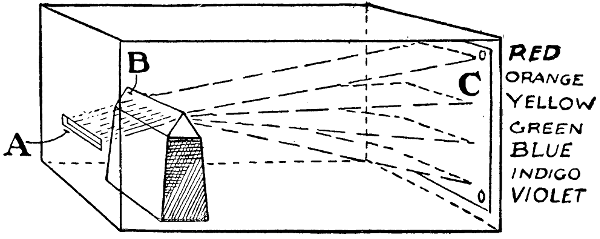
Fig. 8.—The refraction of white light into its constituent colors.
From this experiment further is to be gathered the reason for developing plates by red light, which evidently does not affect the sensitive surface in any appreciable degree. But, on the other hand, special orthochromatic plates are made which, by dyeing, have been rendered sensitive to the yellow rays as well as to the blue, and if one of these be employed to “take” the colored band, technically called “spectrum,” a totally different gradation is obtained compared with that on an ordinary plate or on “blue print” paper.
Then again, suppose instead of sunlight, ordinary lamplight or incandescent gas be used as an illuminant, the gradation varies, whilst still another modification is to photograph the spectrum of a methylated spirit-flame in which common salt is being burnt. In this case the light is so yellow that an orthochromatic plate must be used. Another illuminant worth testing is magnesium ribbon, which also may be ignited in the spirit-flame.
Before saying a final adieu to these spectrum results, one last item[349] remains for remark—last but not least. We say that the series of visible colors extended from violet through blue and yellow to red, and that darkness obtained at each end. Well! Mount a plate or piece of printing paper inside the box, so that half of it is well in the darkness beyond the bluish-violet bands, and expose long enough to secure a slight opacity in these parts (i.e. where the blue bands fell) when the plate is developed and fixed. The half of the plate which was in darkness and therefore apparently received no exposure, nevertheless develops darker than the remainder, seeming to indicate that some light, although invisible to the human eye, had affected the sensitive silver compounds in the plate. This is actually the case. The rays of light which exert this wonderful influence are called “ultra-violet,” meaning beyond the violet, and their existence explains, amongst other matters, why photography of the heavens has revealed the presence of many thousands more stars than can ever be seen by man. Such stars emit only “ultra violet” light.
Pictures of a man decapitating himself, or of the reader’s sister turning the skipping-rope for another girl, who is herself, may justly be called mystifying. Not only may they almost deceive the operator himself, but will quite nonplus the uninitiated, to whom proofs may thus be presented of the most impossible happenings. Two methods are applicable to the production of such freak portraits, viz:—
(1) To photograph the entire picture in two separate halves on the plate, moving the sitter from one position to another for each exposure.
(2) To employ a background as dark and dim as practicable, whilst well-lighting the sitter and furniture, and giving a separate exposure for each position of the model. The latter procedure is by far the simpler, and provided reasonably correct exposures are given, success should not be very elusive.
To take for a concrete example the portrait of a boy playing checkers with himself. Hang up a curtain of black or deep-red material in some dark recess of a room, and a few feet before it stand a small bamboo table with checker-board, &c., complete, at which the person to be photographed may be posed sitting. As mentioned above, all available light must be concentrated on the group, whilst if the model be wearing light clothes, the effect will be enhanced accordingly.
As to the camera, this may with greatest advantage be of the focussing type, or at any rate a box instrument fitted with magnifiers,[350] so that by being placed near to the sitter the latter may be rendered large and sharp in the portrait whilst the background remains indistinct. This should be of such a size that its somber image well covers the whole plate. A suggested arrangement for the tableau is sketched in Fig. 9.
The first exposure may be made with the person seated at 1—the left-hand side of the table—he either resting one finger on a checker as if about to make his move, or adopting such other pose as his acting capabilities may suggest.
Primarily the time of exposure should be just sufficient for the light-clothed sitter, and therefore not enough for the table and background, which receive a second exposure. This should be made when the model has taken his chair to the opposite side of the table, and again assumed a position natural to the player, who anxiously watches his opponent’s play.
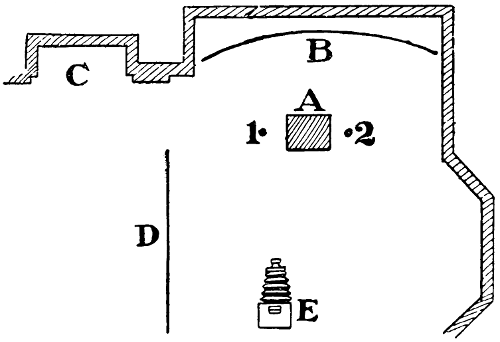
Fig. 9.—One person in two places.
| A. | Table. |
| B. | Black or red curtain as background. |
| C. | Fireplace. |
| D. | White sheet as reflector. |
| E. | Camera. |
| 1 and 2. | Positions of sitter in first and second exposures. |
All possible care must, of course, be taken to keep the table undisturbed during the model’s movements, and also to insure that no lighter object than the sitter himself has a place in either exposure just where he appears in the other. For example, a pile of books must not be photographed during the first exposure just behind or in front of the position which the model is to occupy during the second exposure; otherwise the vision of books through the person’s transparent chest, or a similar incongruous phenomenon, will result.
Spirit or ghost photography is but a modification of these methods. The chief element of success is to ignore the caution of the preceding paragraph, and render the ghost figure as transparent as possible. The first exposure should be an adequate one of the human model, who has twisted himself into an attitude of groveling terror compatible with the fright from which he is supposed to be suffering, whilst the background behind him must be dark and indistinct, if he[351] is next to impersonate the spook. The latter’s surroundings, on the contrary, may be as detailed and well-lighted as convenient, because the white-robed figure is to appear transparent.
A sheet will be fit apparel for the “spirit,” and must be large enough to drape entirely the gliding form with outspread arms.
The second exposure must be abnormally short, so as just to obtain a faint impression of the sheet and its folds. Finally, if the terror-stricken person can maintain his attitude of fear during the first exposure, and also for the photograph of the ghost, whose rôle may be taken by some one else beneath a sheet, there is no necessity to have any part of the background unusually dark. Still, darkness is said to favor spooks, so the background is perhaps entirely a matter of choice.
With such dash toward the borders of the spiritual realm, this series of photo experiments must conclude. The most ardent camera fiend can scarcely denounce them as embracing too narrow a field when he considers that ghosts as well as mundane matters—psychical and physical alike—have been approached. Even if his finger-tips do not resemble ebony with silver nitrate, he may still rightly term his hobby the “Black Art.” And his friends! Well, if present at the researches, may their remarks be unheard. Doubtless they will ponder deeply, and conclude that the camera does sometimes lie.
·········
Sun pictures of the earliest types had been no long time in existence before a rumor spread that photography could not lie. Critics and admirers of the new process rightly enough concluded that a knight of the camera must be constrained to narrow interpretations by his instruments as no artist is by his brushes. But this conclusion, held widely now as then, is only in part correct. The camera records the relative position of objects absolutely, but may on the other hand ruthlessly destroy all sense of perspective, or render globular images of rectilinear buildings. Nor are these the only peculiarities which, in themselves disadvantageous, may frequently be turned to account by the photographer.
Sensitive plates are seldom correctly exposed. They either suffer under- or over-exposure, and when there is a gross error the resulting picture either lacks detail and is blotchy, or else presents the light gradation of a London fog. But, as a set-off to these failings, it might be noted that moonlight pictures are obtainable by excessively short daylight exposures, which give only the outline of the objects, and a contrast between light and shade appropriate to night scenes, whilst photographs of flowers, portraits, and cloud studies may mostly receive full exposure with advantage, the softness of lighting engendered lending additional charm to such subjects.
[352]
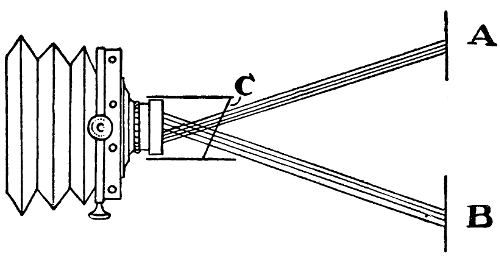
Fig. 10.—Slanting screen (C) with circular aperture to equalize exposures of sky (A) and foreground (B) in landscapes.
Landscapes commonly reveal over-exposure of the sky or inadequate exposure of the ground and objects, because the amounts of light emitted by these respective portions differ so much. To obviate this difficulty an early photograph worker devised, and indeed used, the arrangement of a circular aperture before the lens, slanting so that it might not admit such large parallels of light from the sky as from the ground portion. The device is more easily understood from the accompanying sketch (Fig. 10).
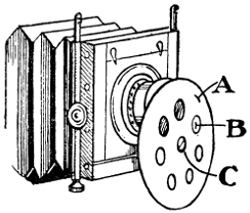
Fig. 11.—A method of securing “modeling” in portraiture.
The portrait hunter should rejoice to realize that, by judicious procedure, persons of the coarsest complexion may be flattered in their likenesses. Not the least valuable dodge is to render freckles and red blotches invisible by the use of orthochromatic plates, and, if necessary, a yellow screen, which articles prevent the pink skin from securing any advantage over the insular blotches in point of actinic light value.
A supplementary method of securing pleasant portrait effects is to mount a disc of cardboard (A, Fig. 11), round whose edge holes of various sizes from 1⁄4 to 5⁄8-inch diameter and about 1⁄2-inch apart are cut (B, Fig. 11), in front of the camera on a spindle (C, Fig. 11) as shown. Any one of the holes should be adjustable exactly in front of the lens, and the mode of usage is to spin the card disc rapidly whilst the exposure is being given. This should, of course, be proportionately longer than usual.
Excellent imitations of crayon pictures are to be produced by taking the required photograph through a negative screen, which has been made by copying to equal size or slight reduction, a piece of[353] rough drawing-paper rubbed evenly with charcoal. It is employable in two ways, either by keeping it in contact with the sensitive plate in the dark slide whilst the photograph is being taken—a slightly longer exposure being given—or else holding it in the frame on the opposite side of the negative to the sensitive paper during printing, which is conducted in the sunshine.
By systems of double or triple printing, all manner of novel results are obtainable. The only difficulty presented in this work is that of correct registration, but if printing paper—the most usual medium—be employed, this should not be insurmountable even at the first trial. As a first instance of these compositions, suppose out of black paper 4 inches by 6 inches, a piece be removed the shape of the negative portion required, and this mask be used to print through on to a sensitized postcard. The black shape removed should have been gummed on to tissue paper and this used, after the picture portion has been secured, to print a border—showing the grain of the translucent paper—around the photograph.
For a second, and last, example of triple printing, proceed by first preparing the negative of a picture frame, in which, however, an ordinary plain canvas surface has superseded the work of art. The idea is then, by multiple printing, to introduce a camera view into this frame image, and so make the result resemble the copy of another painting.
Cut a black paper mask with an aperture the exact size of the canvas image in the frame negative, and through this mask print the photograph required a shade lighter than usual. Then substitute the frame negative, and, with the same mask in place, secure a slight record of the inner canvas image over the photograph already printed. This gives the requisite oil painting effect. Lastly the piece of black paper, originally removed to form the mask, is fixed over the canvas image of the frame negative and the sensitive paper replaced in position, so that registration and printing of the frame periphery is secured. Then toning and fixing ensue, and the “fraud” is complete.
[354]
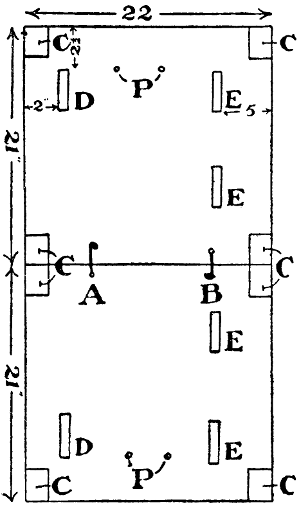
Fig. 1.—Plan of Marionette stage.
Marionettes, though claiming no rivalry to the time-honored institution of Punch and Judy, have a great charm of their own, and, with no traditional story of Punch, Judy, and Dog Toby, are at liberty to perform whatever play their manager may desire.
Although it is possible, of course, to purchase ready-made Marionette theaters and puppets, the purpose of this chapter is to describe a method by which the whole apparatus can be constructed at home at the cost of very little money and time.
Naturally, the first thing to be made is the stage. This must depend very much upon the Marionettes you intend to work. As a convenient size, suppose you decide upon figures 8 inches in height. This means that the frontage of the stage must be about 28 inches wide by 16 inches high, whilst it will run back to a depth of some 14 inches.
Make a base of plain wood, 42 inches by 22 inches. If more convenient this can be made in two pieces, each 21 inches by 22 inches. These fit together flush and are held by a couple of hooks and nails fastening beneath. Glue a block of wood at each corner to form a support, as shown in Fig. 1, which depicts the under side of the base. A, B are the two hooks and nails; C, C, C, C are the above-mentioned blocks. At a distance of 2 inches from what will be the front, and 21⁄2 inches from either end, cut a mortice in each piece of the base (D, D in the figure), through which the tenons of the stage front will project. They must, therefore, be made to suit the thickness of the wood employed. At a distance of 5 inches from the back make[355] four mortices, a couple in each part of the base as E, E, E, E in the figure. These will serve to hold the rear of the stage.
The front of the stage is now constructed as indicated by Fig. 2. Two pieces must be made exactly similar to one another, each to form one-half of the front. The tenon, D, should be long enough to pass through the mortice made for it in the base, and project from the other side sufficiently to allow of a peg being pushed through a hole bored in it. This peg will serve to maintain the upright front in place. Furthermore, two hooks must be placed upon one of the halves, to fasten to corresponding nails in the other half, thus holding the pieces of the stage front firmly together.
The back of the stage consists of two pieces of wood each 18 inches by 18 inches, having tenons to fit into the mortices below the pegs, and fastened together by hooks and nails. Before proceeding further with the work, bore two holes, of sufficient size to hold a piece of stout copper wire firmly in each piece of the base (P, P, P, P, Fig. 1). The use of these will be explained shortly.
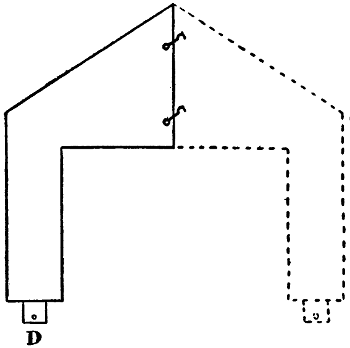
Fig. 2.—Construction of front of stage.
The actual fabric of the stage is now complete. Bear in mind no string or wire should extend from the front to the back of the stage, for the simple reason that these spaces must be left perfectly clear to allow of the exit and entrance of the puppets.
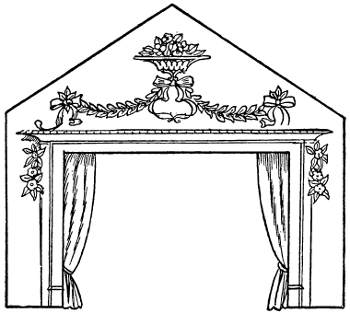
Fig. 3.—Stage front completed.
Next fix the drapery in the form of curtains to each side of the stage front. These must be chosen according to your own taste, and[356] should harmonize with the exterior decoration of the theater. The curtains should be gathered up and tacked to the stage front from the inside, as in Fig. 3, from which an idea of the general adornment of the whole theater can be gleaned.
The following plan will be found very suitable for the arrangement of the movable curtain. Take a piece of strong copper wire and bend it, as shown in Fig. 4. The length of the unbent portion should be about 30 inches. Fit the two ends, A and B, into holes bored in the stage front, inside and above the opening. The wire rod will thus run the whole length of the actual stage, whilst the ends A and B suffice to clear the fixed curtains already tacked up. Hang the movable curtains by a number of little rings upon this rod. When drawn, the two curtains, which should be of some stout material, will completely cover the stage.

Fig. 4.—Wire rod for movable curtain.
The method of drawing the curtains is arranged thus: A string (L, Fig. 5) is passed through the loop C in the rod, through all the rings from G4 to G, where it is fastened, and then passed on through H and all those rings up to the loop D. The string L then returns through the H rings 4 to 1 to H itself, where it is fastened and ends. By pulling the string L when the curtain is drawn, the ring H is therefore drawn towards D and the ring G towards C, thus opening the curtains simultaneously by means of only one string.

Fig. 5.—Arrangement for drawing curtains.
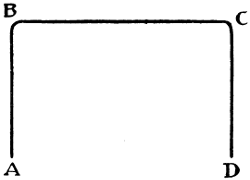
Fig. 6.—Frame for wings.
Supposing the curtains to be now pulled right back, thread another string, M, through the loop E, pass it through all the G rings and across to H, where it must be fixed. Then pass this string through all the H rings, through the loop F, and back by way of H to the ring[357] G, where it must be tied and end. It will now be found that by pulling the string M, the rings G and H are drawn together. To avoid any confusion, a distinctive mark should be placed upon the ends L and M of each string.
You must next bend a couple of pieces of strong copper wire into the shape depicted in Fig. 6. The sides A B and C D should measure 20 inches, whilst B C must be of such a length that the ends A and D can fit into the holes P P already bored in the base. These pieces of wire serve to support the wings, trees, or other stage arrangements as occasion requires.
The stage is now complete, and will take to pieces and pack up flat with no trouble or inconvenience of any kind.
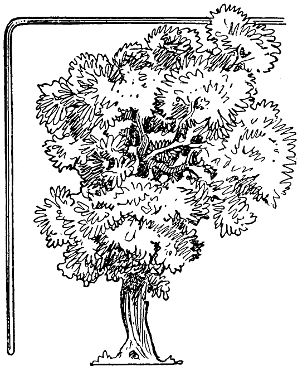
Fig. 7.—A stage tree.
The next questions that arise concern scenery. This depends entirely upon the play to be performed. The floor of the stage must be covered with suitable paper, or better still with a carpet. In the arrangement of the wings and the scenery connected therewith, do not forget that the spaces on each side must be left clear. Marionettes cannot enter by doors, and a descent from the ceiling is not only undignified but impracticable. The side scenery must therefore be as simple as possible.
Unless your performance is to be upon a very extensive scale, the actual amount of scenery required is not great. An interior can easily be painted. Pieces representing the walls of the room can be hung upon what may be called the wing wires, whilst the rest of the interior can be painted upon the stage back.
In all probability a rural scene will also be required. A stage tree or two (Fig. 7) should be fastened to the wing wires, and the background of sky and landscape need present no difficulty to a handy amateur. Street scenes can be arranged by hanging the ends and fronts of houses from the wing wires, whilst the background may either depict the street fading into the distance, or have another house at the corner, after the fashion of stageland. A great variety of scenery may be made with the help of an artistic friend; and when at the theater, inspect the effects closely. By doing this many invaluable hints as to setting and scenic inventions can be acquired.
[358]
But what is a theater without the actors? Who are to perform upon the boards you have so carefully constructed?
It has already been mentioned that the Marionettes are to be about 8 inches high. This will be found a convenient size for the beginner, since very small figures are apt to be troublesome, and large ones are sure to prove unwieldly. It is important to have the Marionettes so articulated that they will readily answer every motion of the operator’s strings, and be neither too stiff nor too limp.
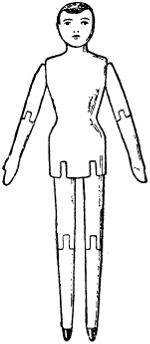
Fig. 8.—Dutch doll for puppet.

Fig. 9.—Universal arm-joint.
The following hints will show how the figures are to be made at home at slight cost. Get an ordinary Dutch doll (similar to that shown in Fig. 8) of the proper size and neatly made. Notice that the hip-joints allow the legs to move upwards freely, a convenience that the ordinary doll lacks. The knee-joints are after the same pattern, and allow the lower part of the leg to double up for sitting and kneeling. These joints should be made to work easily and evenly.
The arms should be attached to the body by what is known as a universal joint (seen in Fig. 9). Make the surface A B (Fig. 10) perfectly even, and then scoop a slight hollow in the wood. In this hollow drive a staple almost up to the head, leaving only enough room to insert a piece of string in the loop, whilst the head of the staple is level with the surface A B. Round off the end of the arm (Fig. 11), and pierce a hole about half-an-inch from the end. Thread a piece of string through the staple and through the hole in the arm, tying the ends together fairly tightly, so that the arm is perfectly free at the joint but does not hang loosely.
[359]
For the head, either touch up the original Peggy’s head to make it respectable, or remove it altogether, replacing it by that of a china doll. In the former case, a flaxen wig must be glued over the black painted hair, and a human complexion given to the crimson cheeks. Undoubtedly a better effect is produced by exchanging heads with a china sister.
The dressing of the Marionettes need be a matter of no difficulty. The costumes must depend entirely upon the nature of the play, although certain stock characters may be made once and for all, and kept in readiness. A sailor, a soldier in resplendent uniform, a policeman, and an ordinary man or two can be kept prepared; whilst for the fair sex, an old lady, a young one, a maid-servant, and a little girl are likely to be of service. The remainder of your cast must be regulated by circumstances. The clothing may be fastened to the above-mentioned characters; but in special cases the costumes should be made to take off as occasion may require.
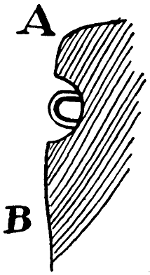
Fig. 10.—Socket for arm.
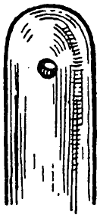
Fig. 11.—Rounded end of arm.

Fig. 12.—Showing how and where threads should be attached.
Having prepared the figures, they must now be made to act and move in a rational manner.
Five black threads are attached to each figure and ascend to the flies, where they are manipulated by the performer. A glance at Fig. 12 shows how and where these threads are to be attached. Fix A and B to the right and left hand respectively, C and D to the knees, whilst E must fasten to the back, where it serves to support the figure. These threads should be very fine, for the whole success of your undertaking depends upon their concealment.

Fig. 13.—Finger loops for manipulating puppet.
There are two methods of holding the threads and working the puppets, the first of which is also shown in Fig. 12. The arm threads, A and B, are attached to the end of a stick, F; the leg threads are similarly attached to[360] another stick, G, to the center of which the body thread, E, is fastened.
The sticks are then held, one in each hand, or both in the same. Although more convenient for manipulation, this method possesses the disadvantage of limiting each operator to the management of one puppet, and where there are several characters upon the stage, much confusion may result. If the two sticks be held in one hand free play, so far as pulling the strings is concerned, is allowed to the fingers, and there should be no difficulty in working two Marionettes at the same time, one with each hand.
An easier method of manipulating the figures is shown in Fig. 13. The thread attachments are the same, but instead of being fastened to sticks, each string terminates in a brass ring placed upon the finger. The threads should be of such a length that, when the hand is held as in Fig. 13, the body of the puppet will be upright, the legs stretched, and the arms dropped by the sides.
Place the rings upon the fingers in the following order: The body string, E, to the third finger; the leg strings, C and D, to the thumb and little finger; and the arm threads to the first and second fingers, as shown in Fig. 13.
With very little practice the figures can be made to walk, the progressive motion of the legs being manipulated by alternately moving the thumb and little finger. A similar movement of the first and second fingers will put the arms into action.
When sitting upon a chair, the lower parts of the legs bend by their own weight, and you will need only to pull the body string to make the figure rise quite naturally.
The theater, scenery and actors being ready, it remains to decide what they shall play.
Your programme must necessarily be chosen according to the audience. Presuming there is somebody to assist you in working the figures, thereby making it possible to have three or four characters upon the stage at once, the variety of plays is very great, and the choice of one or two short pieces should be easy. Several publishers issue large assortments of Marionette plays, and catalogues can be obtained giving full particulars as to the number of characters required, scenery necessary, and so forth.
The Marionette stage is not adapted to heavy drama. Tragedies[361] would be ridiculous on the “two foot boards.” The rôles, therefore, assumed by each character should be amusing and topical, containing allusions likely to be understood by the spectators, and interspersed with such local “gags” as opportunity may suggest.
The two operators should divide their labors, as far as possible, in such a way that the lady does the female characters, whilst her partner works the men. The reason for this division is clear, for it will come more natural for a lady to caricature the female voice, whilst her accomplice will be better suited to the stern accents of the menacing policeman, or the passionate entreaties of the ardent lover.
Practice the parts carefully and thoroughly. Be ready with some joke or patter to cover any mishap that may occur. Accidents are unfortunate, but in Marionette-land quite probable, so if Aladdin’s left arm fails to work at the critical moment, there is nothing to do but make the audience think it all part of the fun.
Supposing the evening for your entertainment to have arrived, and that all is in readiness, place the theater upon a table at such a height that the spectators will get a clear view of the stage, but will not be able to see the flies. The table should be against a wall, and arranged in such a manner that you and your partner have sufficient room to move behind it. In the space between the table and wall a couple of boards must be placed on trestles, so that the operators may stand above the stage.
A curtain must hang from the ceiling to meet the top of the theater. On no account should the audience be able to watch the heads of the manipulators moving the puppets. There are few better plans than to have the stage arranged in the embrasure of a window, for the curtain can then be easily contrived, whilst the “show” does not take any of the space required for the spectators. But this, of course, must depend upon the nature of the room at your disposal.
The guests having been marshaled into their places, the entertainment should open with an overture. If there be intervals in the course of the play, the pianist will find fresh employment, whilst at times a running accompaniment is very suitable.
Start with a one act farce, to be followed by a fairy tale or pantomime. Conclude with another short farce, into which may be introduced all kinds of whimsicalities, jokes, local patter, and topical allusions.
[362]
The puppets will do exactly as you direct them. Make them work their best; let the show be worth seeing and hearing, for the possibilities of the Marionette stage are very great, and with ordinary care a most enjoyable entertainment can be produced.
[363]
A living Marionette entertainment is well adapted for a “One Man Show,” and sure to prove a success. The very appearance of the weird creature, half human and half doll, makes the spectators laugh, and this laugh will scarcely subside until the curtain has been finally rung down on the entertainment.
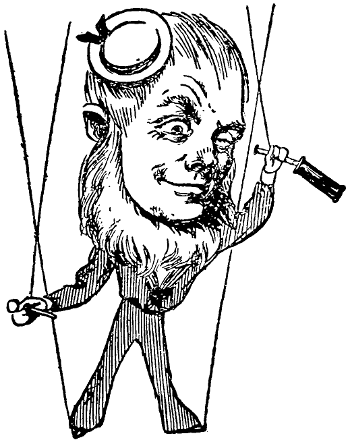
Fig. 1.—The dummy body with the human head.
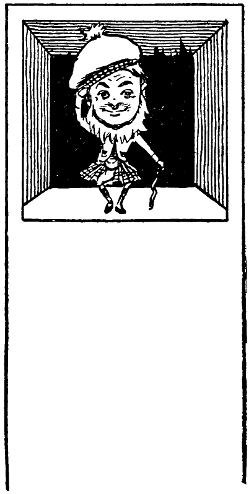
Fig. 2.—Front view of living Marionette stage.
The mysterious combination shown in Fig. 1 needs but little explanation, since it is very clear that the head is human whilst the body is wooden. This makes so comical a figure that anything but pure humor would seem singularly out of place issuing from those lips; it must, therefore, be clearly understood that the living Marionette is comic from beginning to end.
The stage must be about 3 feet wide, and of the same height, thus allowing room for the head and false body. The stage front may be made in the same manner adopted for the Marionettes proper, though so much space will not be required at the top, as can be seen from Fig. 2. The stage itself should be about 12 inches deep, and arranged at such[364] a height that when standing behind, your chin will be about 11 inches above the stage. The whole construction will then be somewhat like the box and stage of an old-fashioned Punch and Judy Show.
A strip of perfectly black cloth is next stretched from side to side along the inner edge of the stage, i.e. the part farthest removed from the audience. This cloth should be 11 inches wide, and when in place will occupy the position shown in Fig. 3. Between this edge of the stage and the actual back of the box should be a space of 15 inches. The actual back must also be covered with black cloth. The sectional appearance of the stage will therefore be as in Fig. 4. An arrangement of curtains, as described in connection with the Marionette stage, must be fitted with the strings below the stage, in order that you may pull them unseen by the audience.
The wooden bodies should be 10 inches high, and headless. A collar must be sewn to the costume where the neck should be, in order to conceal the spot where the living head is thrust over the false body.
The most satisfactory way of working the limbs of the puppet is as follows: Above the stage, in the flies, a rod, upon which are strung several brass rings, extends from side to side (A, Fig. 4). Now the strings attached to the arms and legs pass up and through these rings, whence they descend behind the cloth screen and are moved[365] invisibly by the operator. As there is only one figure to work, you can hold the arm threads in one hand, the leg threads in the other, whilst the supporting body thread passes in a loop around your neck. In this way the body is forced to move with the living head, as though really a part of it (Fig. 5).
You should now make up your face to suit the character. Suppose the body represents an ordinary Jack Tar, with bell-bottomed trousers, blue collar, and so forth. The comic sailor’s beard must be so adjusted that its bushiness will conceal what may be called the junction between your head and his false body. The hat or round cap can be put on at a nautical tilt.
Having fixed the body-thread around your throat and fastened the beard, crane your own neck forward, and place the Marionette body upon the stage, having the strip of black cloth between it and your shoulders. Arrange the arm and leg strings through the rings, and keep the ends in your hands ready for action. When everything is completed, draw the curtain and commence.
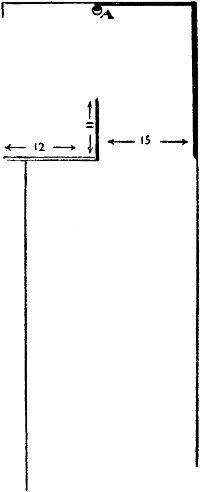
Fig. 4.—Sectional view of Marionette stage.
Songs and monologues are naturally the best turns for the Living Marionette. Choose a rollicking, nautical song, suitable to Jack Tar. All the gestures and motions can be given to the limbs by means of the threads, whilst every now and again Jack can enliven himself and the audience by executing a hornpipe. A little practice with the leg-strings will enable you to perform this with great effect.

Fig. 3.—Black cloth arrangement to conceal top of performer’s body.
Always strive to obtain comical effects. If the gallant mariner has a telescope in his hand, this should be raised to the eye, where the extraordinary contrast between the tiny hand holding a midget telescope, and the enormous face emerging from its forest of beard, is ludicrous in the extreme.
Or if the other branch of the Service be on the boards, the cavalryman may flourish a saber, which, at full arm’s length, will scarcely reach the tip of his ear. A tiny rifle raised to the shoulder makes another laughable effect.
The Man about Town is a humorous figure. Dressed in an exaggeration of the latest style, with a dapper strut, flourishing a modish cane, he is a person to be admired—and laughed at. Over the pigmy body looms an enormous face, smoking a huge cigar, big even for an ordinary individual. Naturally it would be impossible to sing or speak with the cigar in his mouth, and it cannot be gracefully removed with dummy hands that will scarcely reach it. The simplest method of getting the cigar out of the way is to make[366] “Bertie” stumble over his own cane, for instance, and in the agitation of the moment drop his “smoke.” He will then be able to air his peculiarities in comfort, and will prove a most amusing personage.
Two figures may be introduced upon the stage, although they are likely to prove a tight fit. Some laughable dialogues and duets are the result. Quarrels or love scenes must be intensely funny. A young gentleman and a younger lady can be introduced with much formality, and, advancing to shake hands, meet with an embarrassing adventure, pleasant enough in its way. Owing to the smallness of their arms and the largeness of their faces, before their hands have met, their lips have perforce sealed the contract of friendship.
A general idea of Living Marionettes and their working may be gained from the foregoing suggestions. Sentimental songs, sung with a whimsical air of grotesque pathos, will probably “bring the house down,” whilst the applause attending a good comic song in character will encourage all parties concerned.
Living Marionettes are sometimes introduced in conjunction with an ordinary Marionette show, and should be given after the latter has concluded. The contrast between the symmetrical little mannikins and the distorted living doll will be remarkable, whilst the exuberant humor of the latter is sure to provide a pleasant finale to what all will judge a delightful evening.
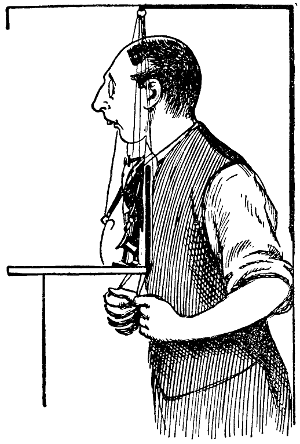
Fig. 5.—Living Marionette operator at work.
[367]
A home circus has so far been beyond the wildest dreams of the amateur showman. Yet when one considers the wide scope a circus presents to performers of every type, it is curious that “amateur circuses” are not almost as popular as “amateur theatricals.” At first sight such a show seems impracticable, on account of the large floor area required for the ring. This need occupy but little more space than a stage, however; and, taking into consideration the fact that the audience almost completely surrounds the performers, it will ultimately be found that a circus does not necessitate so large a room as might be anticipated.
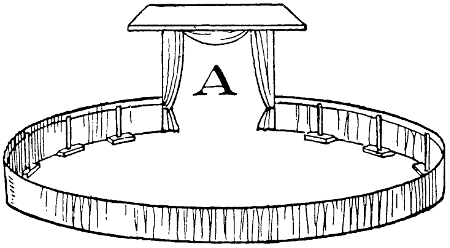
Fig. 1.—Showing barricade and ring entrance.
Of premier importance, of course, is the ring itself. It need not be more than fifteen feet in diameter; but if additional space can be spared, so much the better.
Fig. 1 gives a plan of a ring. It principally consists of a circular barricade about 30 inches high. In one portion there is a gap of four or five feet, which acts as an entrance (A, Fig. 1). If the ring can be so arranged that a door of the room in which the circus is being constructed, coincides with this entrance, much trouble will be saved. Should this be impossible, however, two or three screens can be arranged to form a passage from the ring entrance to the nearest door.
The method of constructing the barricade is explained in Fig. 2. A number of broomsticks are sawn into 30 inch lengths and fixed to heavy wooden bases in order that they may stand firmly upon the[368] floor. A hole is then bored in the other extremity; this may be done by means of a red-hot meat skewer.
The position selected for the ring must next be marked out in chalk, and the wooden stands placed round it at intervals of about a yard. Then thread a piece of stout cord through the holes in the extremities of the uprights.
Having determined the exact circumference of the ring, purchase a sufficient length of cheap red flannelette to go completely round it. The cost of this material should be about 10 cents per yard, and its width exactly equal to the height of the stands. A number of large hooks must be obtained from the same shop, and sewn along one edge of the flannelette. It remains only to hook the material to the cord, as shown in Fig. 2, in order to complete the barricade.

Fig. 2.—Construction of barricade.
The entrance must now be artistically draped with curtains, after the style of A, Fig. 1. It will then serve the additional purpose of a “stage,” upon which conjurers, jugglers, and other artists who do not wish the audience to see the back of their apparatus can perform.
The vexed question of “lights”—always a difficult problem in amateur theatricals—need not here be considered, the gas or electric fixtures already installed being sufficient.
A circus is never complete without its horses, so attention must now be paid to this department. It is hardly practicable to turn several full-grown animals loose in a circus constructed in an ordinary room nor is it probable that the reader’s purse will run to the importation of one or two Shetland ponies. But a whole stud of “circus horses” may be obtained at small expense by carrying out the following directions.

Fig. 3.—Showing outline of horse and part to be stitched.
Purchase three yards of cotton cloth, at 6 cents per yard. Fold the material in the center, thus making a double piece 11⁄2 yards long. With[369] a pencil or piece of chalk sketch the outlines of the head and back of a horse upon it, as shown in Fig. 3. Then take a pair of scissors and carefully cut out the stuff. The result will be two horse-shaped pieces of calico of exactly similar proportions.
At this stage, if the young showman is wise, he will place the operations in the hands of his mother or sister, for the two patterns must be stitched together along the edges, to the points marked A and B, Fig. 3. This done, the whole affair should be turned inside out.
Next obtain a quantity of rags or shavings, or purchase some excelsior from an upholsterer’s, and stuff first the head and then the haunches of the “horse.” The two unsewn pieces of cloth in the center remain empty. One of them must be cut in half, and the two sections thus obtained folded and stitched into the form of two small bolsters and stuffed with flock (A, B, Fig. 4).
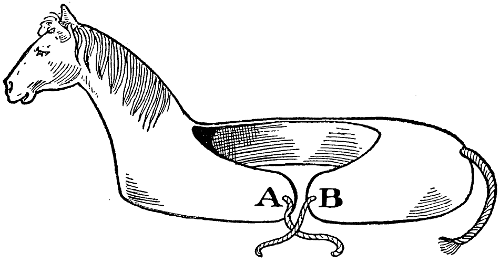
Fig. 4.—Opening in horse for rider; tapes at A and B to be tied.
The remaining side should be similarly treated, only in this case it must not be cut in half, but remain intact. The result will be the head and haunches of a horse, with two “sausage-shaped” flanks in the center (Fig. 4).
The “noble thorough-bred” is now ready for its final decorations.
Unravel some coarse rope and sew it along the neck of the horse to represent the mane. Another piece, unraveled at one end only, does duty for a tail. The ears are constructed by cutting a piece of calico, folded in the form of a sugar bag, perpendicularly down the center, and stitching the two halves into position on the head.
The color of the horse must next be determined. If dapple-gray, a few ink blobs upon the white background will suffice; but if chestnut,[370] brown, or black, a distemper must be applied with a thick brush. This distemper can be made by mixing ordinary water color, of the shade required, with size water, and thickening with whiting.
When the distemper is dry, the “rider” of the horse must get into the hollow in the center, and secure it to his hips by tying the tapes together at A, B, Fig. 4. A “valance” of cretonne should then be sewn completely round the horse to hide the “rider’s” legs (Fig. 5). A pair of reins, and two dummy legs stitched on the flanks complete the “mount.”
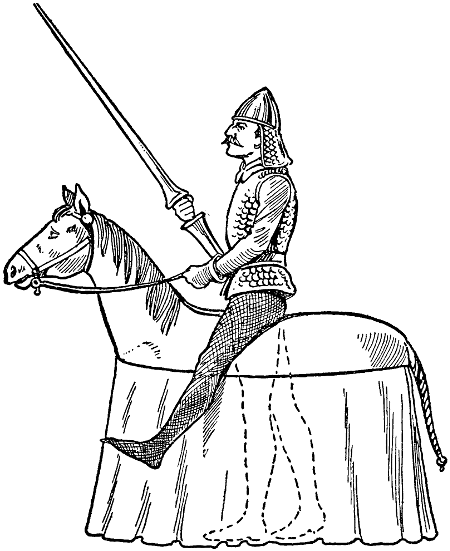
Fig. 5.—Ready for the tournament.
It will be noticed that in Fig. 5 the “rider” has a short skirt at the waist of his coat or armor. This is to hide the manner in which the horse is attached to the “rider’s” hips, and the junction of the dummy legs.
These horses can be used in numerous ways. A very effective item in which they might be employed is a “tilting scene.” Two knights attired in armor—this latter commodity can be easily constructed,[371] as it consists simply of back- and breast-plates made from painted cardboard, with a helmet of the same material—“canter” into the ring. A clown follows them, also mounted, and carrying two long poles upon the ends of which are pads of rag, one covered with soot and the other with flour.
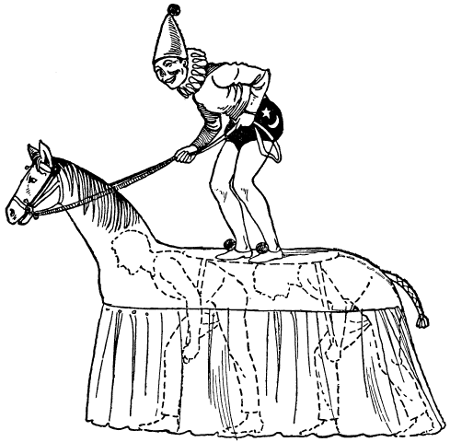
Fig. 6.—Dummy horse for bareback rider.
The clown then proposes that they shall have a tournament, and offers to act as referee. He thereupon hands them the poles, and, holding them as they would lances, the knights retire to opposite sides of the ring. At a signal from the clown, the combatants dash towards each other, to commence the attack. The self-constituted referee gets in the way, however, and comes in for a lot of hustling. The knights again retire, and once more advance to the attack. But, as before, the clown becomes mixed up in the affray. This occurs again and again. Finally the two principals lose their temper and make a joint attack upon the referee. Pursued by the irate knights, the clown dashes round and round the ring, making his horse gallop first backwards, then sideways, and perform other ludicrous capers. At length,[372] daubed with soot and flour from the knights’ “lances,” he darts precipitately from the ring.
There is another style of “horse” shown in Fig. 6. The carcase is made in a manner similar to that already described, but in this case the stuffing must be replaced by two men or boys, who crouch in the position illustrated in the diagram. It will be necessary, however, slightly to stuff the “horse” in such places as the head and haunches, in order to make it of correct shape.
The two men or boys must carry upon their backs an oval-shaped piece of board, having four “legs” nailed to its side, by means of which the carriers hold it firmly in position during the performance. This is clearly shown in Fig. 6. The purpose of the board is to make a flat and solid surface upon which the “daring bareback rider” can perform.
The performance consists of jumping over garlands and through hoops; leaping on to the back of the “horse” whilst it is at full gallop, and other of the more simple feats seen at circuses.
It is preferable, however, that the “bareback rider” should be a clown, who, instead of jumping the garlands, trips over them, and falls headlong to the ground, completely misses the horse when attempting to leap upon its back, and lands on the ringmaster instead, thus making a travesty of the whole affair.
The next performance should be of a more serious nature.
Among the reader’s acquaintances is sure to be one who goes in for gymnastics, and he should be prevailed upon to give an exhibition of his prowess upon the parallel bars, these being preferable to any other apparatus on account of the small space they occupy. To increase the interest of the display, a clown should attempt to emulate each movement as it is performed, but must fail miserably and come a “cropper” every time. It is advisable to have a set of mattresses to soften any unpremeditated falls.
Another item suitable for the programme of the home circus is a “mock” conjuring entertainment. The ring-master announces that Herr Bluffemstein, the famous illusionist, will present his marvelous performance. Thereupon one of the boys or young men taking part in the circus must stalk majestically into the ring, and bow stiffly to the audience. If possible he should be attired in evening dress. He should also wear a fierce, upturned mustache, and carry an air-gun under his arm. A large target is then placed in the curtained entrance to the ring. This target consists merely of a wooden board[373] containing several bent nails, upon which lighted candles are stuck. Below each candle a large number is painted (Fig. 7).
“Herr Bluffemstein” then requests the audience to call out one of these numbers. Upon their complying, he loads the air-gun, raises it to his shoulder, takes aim, fires—and the lighted candle over the chosen number goes out! He repeats this marvelous feat of marksmanship several times. Then, without warning, the remaining candles are suddenly extinguished one by one, and a voice exclaims: “I say, mister, how much longer are you going to keep me blowing out these lights?”
The next moment a boy, wearing a glaring red wig, steps from behind the target, where he has been engaged in blowing out the candles through small holes bored exactly level with the wicks.
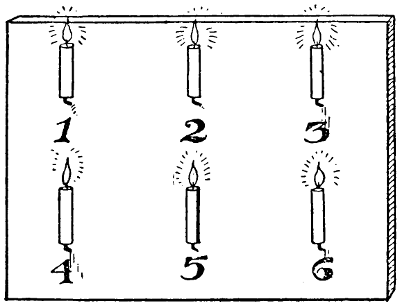
Fig. 7.—Target for trick shooting.
After admonishing his assistant for having “given the game away,” the conjurer tells him to fetch the apparatus for the next trick. The boy retires, but shortly reappears with a tin kettle and a jug of water. “Herr Bluffemstein” then proceeds to fill the kettle with water. Having done so, he holds it over his assistant’s head. A few seconds pass, then steam is seen to be issuing from the spout!
The illusionist hands the kettle to his assistant, with instructions to take it away and fetch something else. The boy, however, lifts off the lid, and placing his hand into the interior, draws out a piece of wire to which is attached a smoldering ball of brown paper.
The conjurer, enraged at thus having his second trick spoilt, chases his assistant round the ring. He at length gives up the chase as hopeless, and entices him to proceed with the next trick. The boy again leaves the ring; but soon returns with a slate, a slip of ordinary writing-paper, a wet sponge, and a piece of brown paper.
The latter requires a little preparation before being used. The conjurer and his assistant must fix upon a certain number—say 21—and write it reversely on the brown paper with a thick piece of chalk. This, of course, must be done “behind the scenes,” and the assistant should be careful that the audience do not catch sight of the figures when he enters the ring.
“Herr Bluffemstein” takes the slip of white paper, and hands it in turn to three people sitting in different parts of the room, with the request that each shall write a certain number upon it without letting[374] him know what has been written. Whilst they are thus engaged he wipes the slate with the wet sponge, and proceeds to wrap it in the brown paper, taking care that the chalked figures come in contact with the middle of the slate. Placing the parcel on the ground, he orders his assistant to stand upon it. The pressure thus applied will, of course, print the chalked figures on to the slate.
The conjurer then takes the paper from the member of the audience who last wrote upon it. Handing it to the boy, he instructs him to add up the figures, and read out the result. The boy pretends to make the addition, but in reality calls out the number previously decided upon.
When the slate is unwrapped the audience are amazed to perceive the apparently correct figures chalked upon it. But before their astonishment has had time to abate, the assistant whips up the brown paper, and displaying the chalked figures to the audience, exclaims: “Why, sir, there’s still a lot more chalk to come off! And do you know I nearly forgot the number I was told to call out?”
There are numerous other tricks than can be adapted in the above manner, but space will not permit further examples to be given. It is a good plan to finish up with a really first-class illusion, such as
In this illusion the assistant brings forward a sack and proceeds to get into it. The conjurer then seizes the top of the sack, and pulls it right over the boy’s head. Producing a piece of rope, he requests some one in the audience so to tie the mouth of the sack that it will be impossible for the assistant to get out.
When this is done, the conjurer places a screen round the boy, and slowly counts “One, two, three!” As he utters the last word, he pulls away the screen. The assistant is then seen to be perfectly free, with the sack slung carelessly across his shoulder. When the sack is examined it is found to be still securely tied with the identical knot made by the member of the audience.
The explanation lies in the fact that two sacks are employed. The assistant has one secreted up his coat, and as the conjurer pulls the first sack over his head, the boy carefully pushes the top of the other through its mouth. The conjurer hides the junction between the two by gathering the material together in his hand—apparently with the intention of making it more easy to tie. Consequently the member from the audience unconsciously ties the mouth of the second sack instead of the first. All that is necessary for the assistant to do, therefore, when the screen is placed round him is to scramble out of the[375] first sack, stuff it up his coat out of sight, then sling the other carelessly over his shoulder.
Juggling is another performance eminently suitable for a show such as the home circus. The only juggling the average person is capable of, however, consists in balancing a stick upon his finger, or keeping a couple of balls in motion. But the few hints given below will make it possible for any one to give a trick juggling performance after a few hours’ practice.
Fig. 8 shows the first feat—that of balancing a stick, card, and wooden ball upon the hand. The whole secret lies in the card. It really consists of two cards pasted together, with a piece of wire passing diagonally between them and protruding about half an inch at each end. In both the ball and stick are small holes into which this wire fits. The audience, of course, must be kept in ignorance of this—not a difficult thing to do when several feet separate them from the performer.
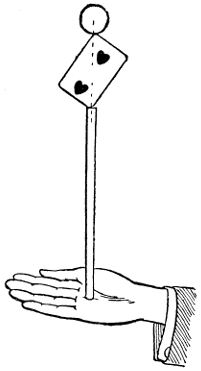
Fig. 8.—Balancing stick, card, and wooden ball.

Fig. 9.—Two balls balanced upon stick.
The feat depicted in Fig. 9 consists in balancing two balls upon a stick. This is done by means of a wire constructed to slide up and down in the center of the stick. At first this wire is completely hidden, but by pushing up the small handle the performer can make it protrude from the extremity of the stick, and pass through small[376] holes in the balls. Of course, other objects may be made to balance by this device.
The juggler should also number amongst his apparatus several cardboard plates of the pattern shown by the three diagrams comprising Fig. 10. A segment must first be cut from a circular piece of cardboard, as shown by A. The edges of this segment should then be gummed together, the result being the conical contrivance seen in B. Lastly, a circular cardboard ring must be fixed to the edge of this cone, C, and the plate is complete. It is quite an easy matter to impart a spin to these plates as they are thrown into the air, and then catch them on the end of a stick, where they will rapidly revolve without the possibility of falling.

Fig. 10.—Cardboard plate for spinning.
Fig. 11 shows a method whereby a billiard ball can be made to roll along the edge of a fan. A piece of wire is hinged to the bottom of the fan, the other end protruding about one-eighth of an inch beyond the edge. The billiard ball, which is partly pierced by a small hole, fixes upon this wire. If the performer then places his forefinger in the small ring made in the wire, and works it slowly backward and forwards, the billiard ball will appear to be rolling along the edge of the fan.
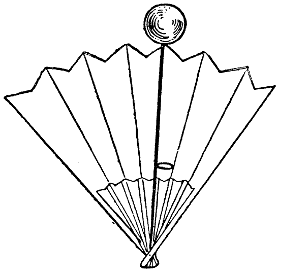
Fig. 11.—Balancing ball on fan.
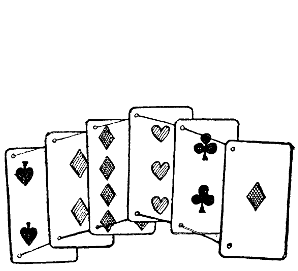
Fig. 12.—Trick cards.
An excellent series of tricks may also be performed by means of a pack of cards, having each card joined together by a thin piece of twine in the manner shown by Fig. 12.
[377]
Numerous other devices can be adopted by the juggler, and the suggestions offered above may be enlarged upon considerably. The merest tyro in the “art of balancing” should thus be able to contribute an excellent item to the home circus.
Every owner of a dog has taught his pet at some time or another several little tricks. The manager of the circus should therefore get those of his acquaintances who possess dogs to combine in contributing to the programme.
Then, again, a big dog might be clothed in a “bull’s skin” made from calico, and a farcical bull-fight arranged. Here the circus “horses” could be once more employed to good purpose.
The “strong man” is a character always associated with circuses, and there is no reason why the home circus should not possess one. The weights must be made from wood, painted black to represent the genuine article. After the “strong man”—who should be selected from the most powerfully-built of the reader’s acquaintances—has lifted the different “weights,” apparently with a great deal of exertion, he makes his exit, leaving them upon the ground. A little boy then enters, and picking up all the “weights,” walks unconcernedly from the ring.
As has been before mentioned, the home circus presents scope for almost every kind of amateur performance, but it must be left to the ingenuity of the reader to give further variety and make the programme as attractive as possible.
As a grand finale, a stirring, spectacular sketch should be given—such as an attack upon a settler’s hut by redskins, or a raid on the shanty of a miner. The main idea in this sketch must be to make a lot of noise, blaze away with toy pistols at frequent intervals, and burn as much “colored fire” as possible. The soldiers or mounted police should arrive in the nick of time, of course, and drive the marauders completely from the field. Thus everything ends quite happily.
[378]
A peep-show makes an excellent and quite novel form of home entertainment, and a boy would be well repaid for any trouble to which the construction of one might put him.
The first consideration is the dimensions of the show. One can be large enough to occupy the whole of a table, or so small that it can be made from a soap or cigar box. The best course, therefore, will be to leave the question of size to the reader.
Fig. 1 is an illustration of the peep-show when finished.
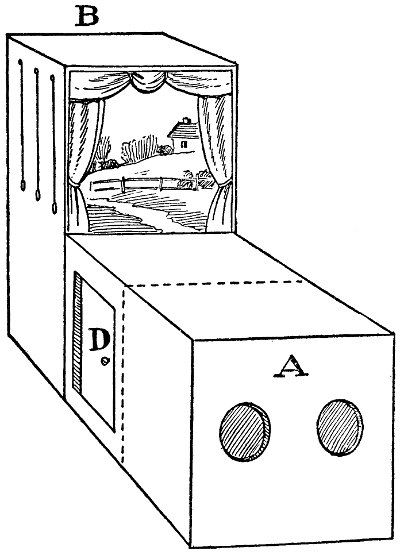
Fig. 1.—The finished show.
The first requisite is a wooden box of the shape shown in Fig. 2. As previously mentioned, for a small show a cigar box does admirably. If you visit a friend who has just commenced smoking, and ask him for a box, he will most likely bless you for the opportunity you have given him of throwing away his horribly strong cigars. Should no such friend be numbered amongst your acquaintances, however, a tobacconist will be pleased to let you have one for a cent or so.
Having obtained the box, commence operations upon it. First[379] of all one end must be entirely removed, not a very difficult task to accomplish. The next thing to do is to make the peep-holes. There is no fixed size for these. They may be large enough for both eyes to be applied, or to permit only one to gaze through. But provided they are of sufficient dimensions to allow the “audience” to obtain a comprehensive view of the interior that is all that is required.
The number of peep-holes must, of course, be regulated by the size of the show.
If the reader possesses a fretsaw the making of the holes will present no difficulty. The best method to be adopted by those who have not one of these useful instruments, is to make small holes in the necessary places with a red-hot poker. They can then be easily whittled to the desired size with a penknife, the edges being finished off with a piece of emery paper. Should the reader wish to make his show “extra smart,” he can putty a piece of glass inside the box over the holes. But this is not essential.
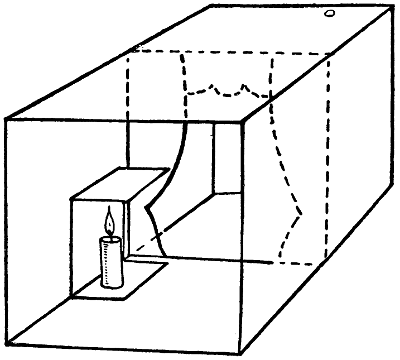
Fig. 2.—Showing back view of stage front and lighting.
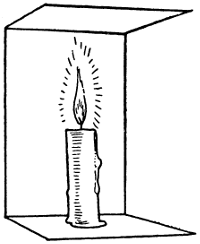
Fig. 3.—Candle stand and roof protector.
Next obtain a piece of cardboard, and from it cut out a stage front to fit the interior of the box, as shown in Fig. 2. This front must be painted in bright colors and glued inside the box about 31⁄2 inches from the end opposite to that at which the peep-holes have been made.
The dotted lines in the illustration of the finished show (Fig. 1) indicate the position of this stage front. A reference to the same diagram will also show a small door at the side of the show (D, Fig. 1). This must next claim our attention.
Simply cut a small aperture about 3 inches wide by 4 inches deep, and hinge the oblong of wood thus obtained back into its position by means of a piece of linen and glue. The object of this door is to enable the showman to attend to the lighting of his show, done by means of a candle, or, if necessary, two or three candles. The lights are placed behind the stage front in such a position that they are invisible to those gazing through the peep-holes. In order that the[380] candles shall not scorch the roof, they should be placed upon pieces of tin, bent to the shape shown in Fig. 3.
The first portion of the show is now complete, and we will turn our attention to the second, and more important section.
Another raid must be made upon the tobacconist’s or grocer’s and a second box procured similar to the first. It is necessary that this box should be of the same width, and at least twice as high as the first is deep.
This box is represented by B, Fig. 1. Stand it on end and place the other against it in the manner shown by the diagram. Now take a pencil and mark a line across the second box at its junction with the first. With a fretsaw or penknife make a cut along this line, and then completely remove the square of wood below this cut. A glance at Fig. 4 will make this clear.

Fig. 4.—Scene-raising apparatus.
The back of the box must be taken off and hinged on again in the form of a door. This is to enable the youthful showman easily to execute repairs if anything “goes wrong with the works.”
It is now time to turn attention to the most important portion of the show—the scenes.
If the reader possesses any artistic ability, he cannot do better than paint them himself. A few hints upon this subject will perhaps be useful.
He must pay a visit to a stationer’s, and purchase a supply of white drawing-card, such as is used by artists. A fair-sized sheet costs only two cents. Having procured this he must lightly sketch, in pencil, the first scene upon it. If he be at all doubtful as[381] to his artistic abilities, however, the following is an excellent plan to adopt.
Armed with a pencil and piece of tracing-paper cut to the size of the scenes, he should carefully examine the various illustrations appearing in magazines. A short search should reveal a mountain, a mass of foliage, a waste of sea, or some other subject suitable for the background of the first scene. He must then get to work with the pencil and trace this upon the tracing-paper. Another search will bring to light something adaptable for the middle-distance. Lastly, a group of objects for the foreground must be selected, and the whole transferred first to the tracing-paper and thence to the drawing-card. Thus by taking a background from one illustration and a foreground from another, almost any scene may be built up.
After being sketched-in in pencil the scenes must be colored. This should be done with a view to general effect rather than perfect detail. First the predominant colors should be laid on in a bold wash, then the objects in the background painted in. The coloring must be as vivid as possible, in fact, almost gaudy.
Instead of each scene representing a single incident, it is preferable to weave the whole series into some sort of a narrative, such as “A Voyage round the World,” “With Shackleton to the South Pole,” or, if the reader is very imaginative, “Round the United States in an Aeroplane.”
Having procured the scenes—they can number from half-a-dozen to a score—proceed to fix them in the show. Fig. 5 gives an interior view of scene-raising apparatus.
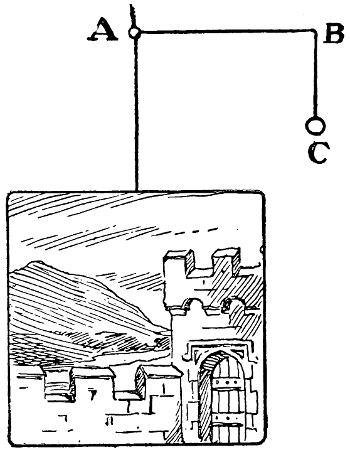
Fig. 5.—Interior view of scene-raising apparatus.
A hole must first be bored in the center of each scene and pieces of stout thread knotted in them. A series of diminutive wire-rings, corresponding numerically to the number of scenes, must be fixed into the roof of the box in the position indicated by the dots at A, Fig. 4. Fig. 5 shows position of wire-rings at A, B thread, and C loop for scene-raising. The pieces of thread must be carried through the rings at A, bent at right angles at B, and brought to the outside of the box through a number of small holes (B, Fig. 4).
[382]
It will now be observed that when one of these threads is pulled, the scene to which it is attached is lifted swiftly out of view of the audience and behind the top portion of the box.
In order to prevent the scenes and threads becoming entangled when raised and lowered, thin strips of wood should be glued up either side of the box, thus making a series of grooves in which each scene can work. In Fig. 4 the first scene has been raised, leaving one of these grooves displayed to view.
Another reference to this diagram (C, Fig. 4) will show a number of small nails corresponding to the holes at B. When a scene is pulled up, the wire-ring at the end of the thread can be slipped over this nail, thus preventing its dropping down again.
It now remains only to put the two sections of the peep-show together. This is easily done. Simply push one box firmly against the other in the manner shown in Fig. 1, and secure them either by means of small brads or strong glue.
The whole contrivance can then be painted and decorated to suit the taste of the young showman, and everything is ready for the first “performance.”
The showman lights his candles, places the show upon the table in a convenient position, and gets his “audience” to look through the peep-holes. Then he starts upon his description of the first scene, making it as entertaining as possible by well padding with jokes. When he has finished with the first scene—Zr-r-rip!—he pulls the thread, the picture is whisked out of the audience’s view before they quite realize what has happened, and the next scene is displayed.
Thus he will go through the whole series of pictures, and then—well, after that, I trust he will be listening to the congratulations of the audience upon his success as a peep-show man.
[383]
There is another variety of peep-show well worthy of attention. It is known as the “mechanical” peep-show. A short account of the finished show will not be out of place before proceeding with a more detailed description.
Upon looking through the peep-holes the interior of a cottage is perceived, including side wings. The next moment, however, a faint click is heard—and the interior of the cottage miraculously vanishes, giving place to a scene in a forest glade!
The simplest and most satisfactory manner of explaining this marvelous transformation is to describe how one of these “mechanical” shows may be made.
Procure a wooden box similar to the first of those employed in the manufacture of the previous show. Having decided upon the number of peep-holes, cut them out in the manner already described. Another “stage front” must then be fixed in position about 3 inches from the peep-holes (Fig. 1). For the sake of convenience it is advisable to turn the box upside down, with the lid at the bottom instead of the top. This will permit the interior of the show being attended to without unnecessarily disturbing the mechanism.
Having, for the time being, finished with the body of the peep-show, turn your attention to the internal parts. These are by no means complicated.
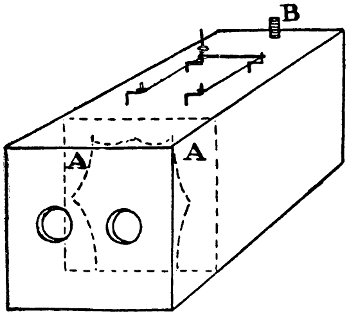
Fig. 1.—Handles and tin clip for holding scenes.
First obtain a piece of white drawing-card, and cut it to fit exactly the back of the box. Then take another piece, half the size of the[384] first, and hinge it by means of a strip of linen and gum to the center as shown in A A, Fig. 2.
With the flap thus formed hanging downwards, place the card upon the table, and proceed to paint thereon a forest scene (C, Fig. 2). If a suitable illustration can be procured from a magazine it will only be necessary to paste it on the card and carefully trim the edges.
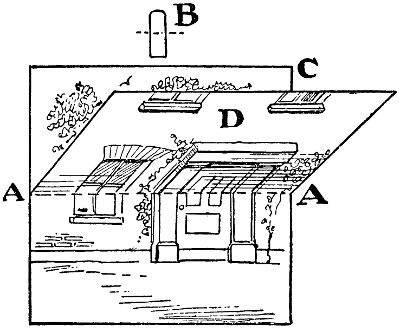
Fig. 2.—A double-barreled scene.
Having satisfactorily completed the forest scene, bend the flap upwards, thus hiding the picture, leaving in its place a blank piece of card. Brushes and paints must again be employed, and the blank card transformed to the interior of a cottage. The result is the “double-barreled” scene represented by Fig. 2. A glance at this diagram makes it apparent that by simply dropping down, or lifting up, the hinged flap D, the scene can be changed at the will of the operator.
Fig. 3 is an example of one of the wings employed in the show. Like the scene, it is “double-barreled.” A strip of white cardboard is the first requisite. Its size will be dependent upon the dimensions of the show.
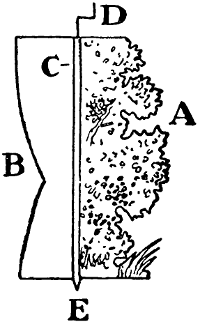
Fig. 3.—Part of double-barreled wing.
Draw a line down the center of the card (Fig. 3). Then proceed to paint upon one side of this line a section of a tree, or some other piece of forest foliage (A, Fig. 3). Having done this, turn the card over and paint upon the reverse side a curtain, window, or anything else suggesting a cottage interior at B, Fig. 3. This double wing must then be carefully cut out in the manner shown.
Next take a piece of wood slightly longer than the wing, and about 1⁄4-inch wide by 1⁄8-inch thick. Glue this to the center of the wing as shown at C, Fig. 3. A closer reference to this diagram reveals that the strip of wood is whittled to a point at E; also that a wire “handle” is fixed to the other extremity, D. At present, however, this “handle” should be held in reserve.
[385]
Three other wings have also to be made. Fig. 4 suggests the various forms they may take.
The segments of the show are now complete, and all that remains is to put them together.
First take the hinged scene and fix it in the end of the box opposite the peep-holes. To prevent the flap falling down at an inopportune moment and displaying the wrong scene, a slit must be made at the top of the box and a small strip of tin inserted (B, Fig. 1). This strip of tin is also shown at B, Fig. 2. It will be found that when this is pushed down, it clips on the flap D, holding it against C.
On being pulled up, however, the flap is released, and, falling down, changes the picture. To lift the flap again, attach a piece of thread to one corner, carrying the loose end out through a small hole in the back of the box.
The wings should be placed in the interior of the show, in the position illustrated by Fig. 4. The wooden point at the base of each wing acts as a pivot in a small hole made in the bottom of the box. Four corresponding holes must also be bored at the top.
The wire “handles” next claim attention. They should be pushed through the small hole, as shown in Fig. 1, and fixed firmly in each wing. The holes must, in every case, be large enough to permit the wings to revolve easily and with the least possible resistance.
Each “handle” is connected by a straight piece of wire having both ends bent in the form of a small ring (G, Fig. 4). It will also be noticed in this diagram that one of these “handles” has a considerably longer shank than the others (H, Fig. 4). This is to enable the showman to bring about the transformation previously explained.
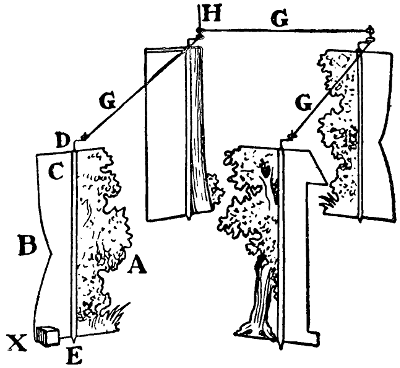
Fig. 4.—Simultaneous revolving wings.
A glance at Fig. 4 will make it apparent that when H is turned, the four wings revolve also. Thus the wings for the forest scene may be suddenly switched out of sight, and those for the interior of the cottage displayed, or vice versa, at the will of the operator. To prevent the wings revolving too far, a small block of wood should be[386] nailed to the bottom of the box at the base of the first wing, in the position shown by X, Fig. 4.
The mechanical peep-show is now finished. After the showman has grouped his audience at the peep-holes, and all is ready for the transformation, he simply turns the wire handle with one hand, and with the other simultaneously raises the clip securing the back scene. All that is heard by those at the peep-holes is a faint click as the wings revolve. Then they perceive, with no little bewilderment, that in some inexplicable manner the interior of the show has been completely changed. The showman will be wise to refrain from permitting them further to examine the apparatus, however, for when they realize the absurdly simple mechanism by which the transformation is wrought, their bewilderment will vanish even more rapidly than do the scenes themselves.
[387]
Mr. Punch and Mrs. Judy at one time held quite an exalted position among forms of entertainment dear to the heart of the British boy. As far back as the reign of Queen Anne, a well-known periodical devoted quite a considerable space to a criticism of a Punch and Judy performance!
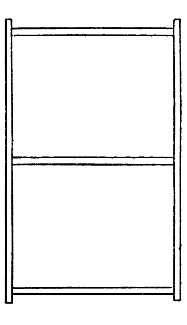
Fig. 1.—The framework.
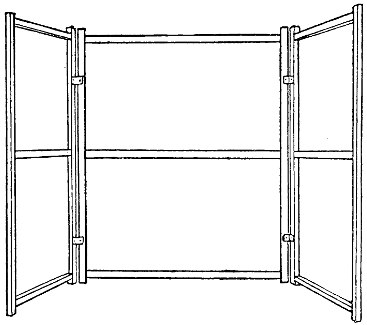
Fig. 2.—Frames hinged together.
Moreover, in England, less than fifty years ago it was no unusual occurrence for a traveling showman to hire a barn or large room and give a whole evening’s performance with his Punch and Judy.
Punch is just as amusing indoors as out, and the boy who is interested in giving different forms of home entertainment will find a Punch and Judy an excellent addition to his other shows.
The stage upon which Mr. Punch performs his amusing antics is simple of construction.
[388]
It will first be necessary to procure six uprights, each 7 feet long and 1 inch thick; and nine crosspieces each 21⁄2 feet long and 1 inch thick.
Take a pair of uprights and join them together with three crosspieces—one at each end and the other in the center. The result will be a framework such as is shown in Fig. 1. The four remaining uprights must be similarly treated.
Altogether three frames will have been constructed, and they must be hinged together, as shown in Fig. 2.

Fig. 3.—The platform.
This may be done with either strips of cloth or small metal hinges. The latter may be purchased from any hardware store for a few cents.
It will be noticed that the framework has only three sides. The fourth side is to be occupied by Punch’s platform, which merely consists of a small board about 6 inches wide and 2 feet 6 inches long. An oblong nick 1 inch by 1⁄2 inch should be cut in each side of this platform, as shown both in Fig. 3 and A, Fig. 4. A cut of similar dimensions must also be made 5 feet 6 inches from the ground in both the front uprights of the framework (B, Fig. 4). The incisions in the platform dovetail into those in the uprights. To make all quite secure two small catches (A, Fig. 4) are fitted to the ends of the platform, and these clamp round the uprights, holding everything firmly in position.
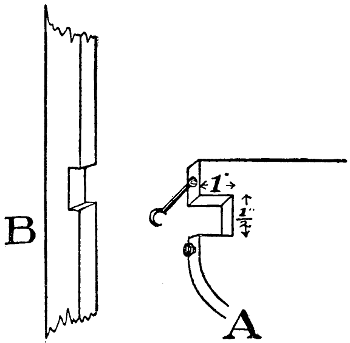
Fig. 4.—Arrangement for supporting platform on frame.
The framework is now complete, and with the exception of the small space above Punch’s platform, should be covered with dark red or green paper cambric, which may be purchased at five or six cents a yard. The width of the cloth will be found just over 2 feet 6 inches, i.e. the same width as a single frame. The best course, therefore, will be to cut the cloth into seven-foot lengths and nail it with small tacks or brads over each frame separately.
[389]
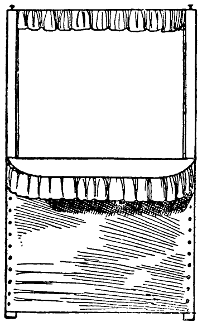
Fig. 5.—Front of show complete.
The space below Punch’s platform, however, is covered in a different manner.
A row of tacks or brads is driven into the front of the two uprights to about three-quarters of their length. A corresponding number of small curtain rings—to be obtained at any hardware store for 5 cents a dozen—are then sewn down the sides of a piece of the cambric 5 feet 6 inches long. By this means the cloth may be hooked to the front of the show, as illustrated in Fig. 5.
When the Punch and Judy Show has to be packed away, it is merely necessary to unhook the front cloth, take out the platform, and fold the framework up as though it were a screen or a clothes’ horse.
But before this trial “pack up” is attempted, there are one or two small but important additions to be made.
First of all, the top of the opening at which Punch presents his cheery countenance must be decorated. This is easily done. Two small nails are driven perpendicularly into the top of the front uprights, and a stout piece of wire stretched between them. A frieze of cambric is then hemmed round the wire (Fig. 5). The wire should be simply hooked on the nails, so that it can easily be detached when the show is folded up.
A similar frieze must also be tacked along the edge of the platform.
With regard to the scenery! Mr. Punch is very modest in this direction, for he requires only two wings with which to garnish his abode. These generally take the form of a scene of the top window of a house, and the front of a shop or a portico.
The front and back of one of these wings are shown in Figs. 6 and 6a respectively.
It consists merely of a framework of wood, 11⁄2 feet long by 9 inches wide, over which a piece of white cardboard is nailed or glued. The desired scene is then executed on the cardboard in either oil paint, water color, or crayon.
The window itself should be cut completely out and hinged back again with a strip of linen, so that Punch and the other characters may poke their heads through (Fig. 6a).
[390]
The complete wings must then be hinged one on each side of the show, as seen in Fig. 7. In this diagram the wings are illustrated as seen from the inside.
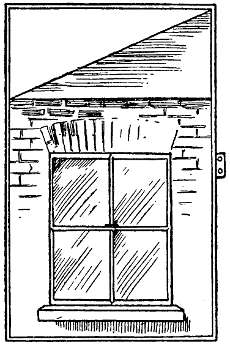
Fig. 6.—Exterior view of window.
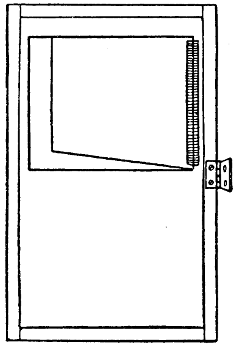
Fig. 6a.—Back of wing.
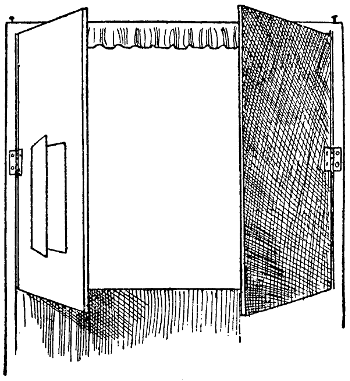
Fig. 7.—Swing-doors opening inwards.
The “stage” is now complete, and it remains but to make the grotesque little puppets that perform upon it.
Pride of place must be given, of course, to the redoubtable Punch himself.
The most difficult part of this puppet to construct is the head. There are very few boys skillful enough to carve out the correct features from an ordinary block of wood; therefore they must find some other foundation upon which to work. A Dutch doll, to be purchased at any toyshop for a few cents, serves splendidly. Whilst the reader is in the toyshop buying the one doll, he may as well extend his order to about a dozen more; not only are they useful for making Punch, but their stony countenances can be transformed into those of Judy or any of the other characters.
[391]
The dolls should all be decapitated, and have their hands and feet removed as well. One of the heads must then be selected, and the little snub nose taken off with a sharp knife. A semicircular line should next be penciled right across the lower part of the face, and all the wood below this line cut away to the depth of 1⁄8 inch or so (Fig. 8). A “false” chin is to go here, whilst a “false” nose must adorn the spot whence the original member was removed.
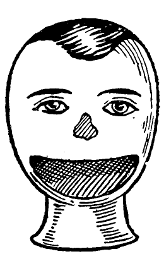
Fig. 8.—Preparing Punch’s face.

Fig. 9.—Punch’s nose and chin.
Both nose and chin can be whittled from separate pieces of wood—the doll’s discarded body will do. Fig. 9 shows the shape they should assume. When both have been carved to the reader’s satisfaction, they must be glued firmly in their respective positions, and the joints hidden by a few judicious touches of the paint-brush.
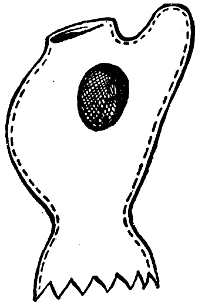
Fig. 10.—Pattern for Punch’s coat.

Fig. 11.—Mr. Punch.
In the case of the nose, a small tag of wood must be left, as in Fig. 9, and a hole bored in the head to receive it. This will make the joint more secure than if it were simply glued, and as Punch’s nose receives more than its fair share of knocks, the precaution of having it firmly fixed is not altogether an unwarrantable one.
The adjusting of the “false” nose and chin is by no means a simple task, requiring, as it does, considerable ingenuity. But on the whole it will be found much easier than having to carve the entire face.
The clothing of Punch is best left in the hands of the reader’s mother or sister. Although it is astonishing what a boy can do with needle and thread when necessity puts him to the trial, making the tiny suit of scarlet calls for an amount of patience and a carefulness over detail that only a lady can be relied upon to exercise.
Fig. 10 shows the pattern for Punch’s coat. The cloth selected for the garment must be folded double, cut to the pattern given,[392] then hemmed round the edges as indicated by the dotted lines. The sleeves are made separately, being afterwards sewn into position on the jacket.
When the reader’s mother or sister has finished the little scarlet coat, Punch’s head must be glued by its neck into the collar, a lace frill being afterwards attached to finish off the joint neatly. The hands from the Dutch doll should next be glued into the sleeves, and smaller frills similarly attached.
Before the head is stuck in position, however, a hole must be bored in the base of the neck just large enough to admit the tip of the forefinger.
For Punch’s nether garments two cylinders of cloth only are necessary. The feet from the Dutch doll must be glued into one end of each cylinder, whilst the other ends should be sewn individually inside the front of the coat.
A conical hat must next be made, and either glued or tacked to the head. After the hump has been well stuffed with wadding, Punch should have assumed an appearance similar to that of the gentleman depicted in Fig. 11.
To “work” the figures the performer first puts his hand up the back of the coat, and sticks the tip of his forefinger in the hole in the head. He then places his thumb and second finger in the diminutive sleeves. By this means the puppet can be made to fling his arms about, and move his head in a most grotesque fashion.
The other puppets are constructed on practically the same lines; but in the majority of cases it will be unnecessary to provide them with knickerbockers and legs, as the audience see only the upper part of the bodies above the platform. In these circumstances the attire can take the form of a simple, long, loose gown, such as that worn by the Clown in Fig. 12.
[393]
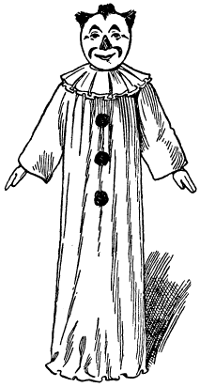
Fig. 12.—The Clown.

Fig. 13.—Skull head for the Ghost.
Judy’s prepossessing features may be made from another of the dolls’ heads by substituting a beaked nose for the original organ. The lady’s dress consists of a gown made from some red spotted material.
By a judicious application of paint, and by gluing on colored tufts of wood for hair, the remaining heads can be transformed into craniums suitable for the other puppets.
The Ghost, however, may receive a little special treatment. One of the heads should be vividly painted in black and white to represent a skull. Then attach it to a wooden stick, decorated with a series of black rings, as shown in Fig. 13.
The body consists of a long white gown similar to the other dresses, the only difference being that the head is left quite free in the collar. When the mysterious visitor makes his first appearance his head is right down upon his shoulders, as in Fig. 14.
Directly Punch becomes too familiar, however, the showman can make the Ghost suddenly shoot out his long neck, thereby giving the old gentleman a bad attack of the “nerves.”
There remains one other piece of “stage furniture” to be constructed. This is the gallows—which plays such an important part in the exciting scene where Punch turns the tables on Jack Ketch.
Take a piece of wood six inches long, half an inch wide, and an eighth of an inch thick, and nail it at right angles to the extremity of another piece the same width and thickness, only eight inches long. A third strip of wood must then be nailed diagonally between the other two. The completed article will have the appearance of Fig. 15.
The end of the longer arm must be whittled to a blunt point, and a hole bored in Punch’s platform to receive it. Two small holes should[394] also be bored in the short arm. They must be about two and a half inches apart, and a piece of string knotted in the first, then looped down and threaded through the second, as shown in the diagram. It is into this loop that the wily Punch persuades Jack Ketch to place his head, when the old fellow gleefully gives a sharp pull to the other end and hangs him.
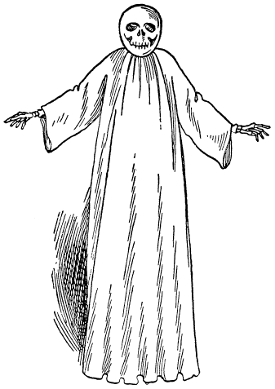
Fig. 14.—Ghost as seen at first appearance.
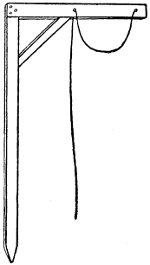
Fig. 15.—The gallows.
To those readers who do not possess a dog, at first sight Toby presents a difficulty which it seems impossible to overcome. But all that is necessary is to cut the head from a wooden toy dog and attach it to a stiff muslin gown, over which some black paint has been spotted to represent the tight skin of a mongrel terrier. By placing the hand up the gown, this “Toby” can be worked similarly to the puppets.

Fig. 16.—The squeaker.
Many professional showmen use what is known as a “Punch squeaker” for imitating Mr. Punch’s voice. Most boys, with their well-known genius for mimicry, will find it much easier to assume the high-pitched tenor of Punch without any artificial aid. However, for the benefit of those who are anxious to cheer the neighbors with the dulcet notes of the squeaker, instructions are given for making one.
First obtain a piece of tape six or seven inches long and half an inch wide; also two pieces of tin about two inches long and half an inch wide. Both pieces of metal must then be bent slightly in the center, and a single layer of tape placed between them. The remaining tape is next bound firmly round the outside, all being held fast with thread. The finished squeaker is illustrated in Fig. 16. Before being used it should be well soaked in water.
[395]
To produce the required sound place the squeaker between the teeth, half speaking and half blowing the words through it.
The story of Punch is so well known that most boys will be able to work out a performance of their own. But those who wish to give the correct version of the adventures encountered by our Hero of the Hump will find at any theatrical publishers’ a little book giving the complete dialogue.
[396]
Previous to the introduction of the cinematograph, dissolving views ranked amongst the most popular of entertainments. By means of a specially-constructed magic lantern, a painted picture from a glass slide is thrown upon a screen. Then, at the will of the operator, the picture apparently dissolves into a haze, through which a second picture gradually makes its appearance.
Subjects are usually chosen which specially adapt themselves to such an optical illusion. For instance, a picture might be shown of a small country village, which slowly dissolves into a view of the same place several years after, when it has developed into a thriving and populous town.
But the specially constructed magic lantern necessary for these dissolving views is a very costly piece of apparatus, the purchase of which would entail the careful saving of two or three years’ pocket money. However keen a boy may be to provide some form of home entertainment for the amusement of his friends, such an alarming prospect would make his keenness dissolve as completely as the pictures he hoped to display.
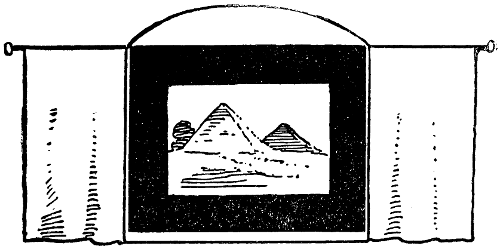
Fig. 1.—Show as seen by audience.
It is the purpose of this chapter, however, to explain how an apparatus may be constructed for a small sum that will bring about effects similar to those of the special magic lantern costing many dollars.
Fig. 1 depicts the show as seen by the audience. It consists principally of a framework not unlike that of a model stage, the dimensions[397] of which must be left to the decision of the reader. For the sake of convenience, however, it will be advisable to explain the method of constructing apparatus capable of displaying views about the size of a picture postcard.
A stage front similar to that in Figs. 1 and 2 should first be cut from either thin wood or stout cardboard. The size of a picture postcard is usually 31⁄2 inches by 51⁄2 inches. Consequently the opening in the stage front must be about 61⁄2 inches by 81⁄2 inches. This allows for a nice margin around each dissolving view.
It will be noticed from the diagrams that both sides of the show are fitted with two small rods, bearing miniature curtains. These are to prevent the audience seeing what the showman is doing “behind the scenes.” Their mode of fixture is explained in Fig. 3. Four pins, with their heads nipped off, are bent in the shape of a horseshoe, and a pair driven into each side of the stage front (A, Fig. 3).
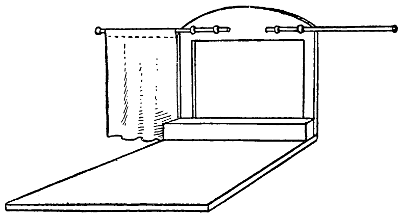
Fig. 2.—Show from back view.
The two rods, which can consist of thin pieces of cane, are then pushed into the sockets thus formed, and the curtains threaded upon them by means of a wide hem sewn along the top. The advantage of this method of fixture is that when the show is packed up, the curtains can be easily removed by merely pulling the rods from their horseshoe-shaped sockets.
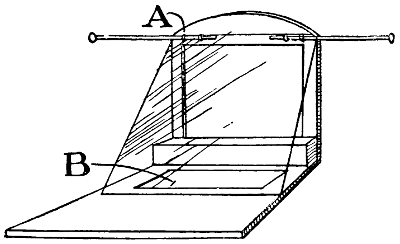
Fig. 3.—Back view of partially constructed apparatus.
The floor or base of the show must next be provided. Procure a piece of wood about 10 inches long, 1⁄8-inch thick, and of the same width as the stage front. A block of wood is then nailed or glued along one end of this, and the stage front fixed firmly to it (Fig. 2).
Having done this, make a journey to the nearest glazier’s, and[398] purchase a piece of glass of about the same dimensions as the wooden base. This should not cost more than ten cents. Clean the glass thoroughly, and rest it against the top of the stage-front at an angle of about 60° (Fig. 3). Next take a picture postcard, and lay it on the wooden base between the end of the glass and the stage front. (See B, Fig. 3.)
If the room now be darkened, and a bright light thrown upon the postcard, its reflection will be clearly visible on the glass, and to those looking through the stage front it will appear exactly similar to the view projected upon a screen by a small magic lantern.
Should the reflection be at all lopsided, the angle of the glass must be altered until this defect is remedied. A block of wood, or an ordinary cigar-box, must then be placed upon the wooden base with its edge along the glass, and nailed securely in position. (See A, Fig. 4.)
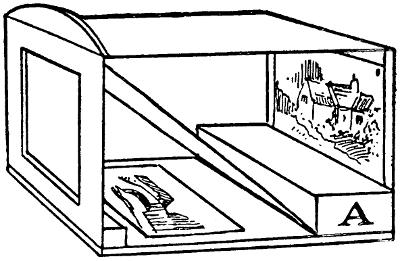
Fig. 4.—Showing position of picture postcard and glass screen.
Three pieces of cardboard are the next requisites. One piece is to be glued to the block of wood or cigar box at the back of the show; the other along one side, and the last over the top, as depicted in Fig. 4. It is now necessary to slide out the glass and paint the whole of the interior dead black.
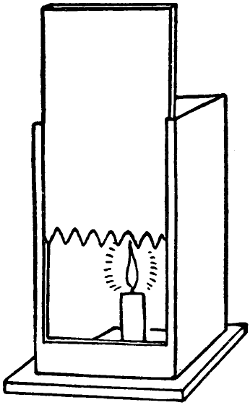
Fig. 5.—Lighting apparatus with serrated shutter.
Whilst the paint is drying the young showman can turn his attention to the lights. These merely consist of two lamps—photographic dark-room lamps are most suitable, or a wax candle will serve quite well. Each lamp is provided with a cardboard shutter serrated at the bottom, as shown in Fig. 5. It is this serration that imparts the dissolving effects to the various views.
When the paint is dry the first exhibition may be given.
The room in which the entertainment is to take place must be darkened; the glass placed in position between the cigar-box and the stage front, and the lamps lit. Two picture postcards must also be obtained; the first being placed upright upon the cigar-box at the[399] back of the show, and the other on the wooden base between the glass and the stage front. A glance at Fig. 4 explains this.
The two lamps must now be so arranged that the light from one, whilst brightly illuminating the first postcard, leaves the portion of the show behind the glass in complete darkness; and the light from the other falls solely upon the card on the cigar box.
If the shutter of the first lamp is now closed, and that of the second opened, the audience will see only the postcard at the back, set in a frame of dead black.
The exhibitor should then slowly press down the shutter of the second lamp, and simultaneously raise that of the first. The serrations—in one case gently cutting off the light, and in the other permitting it to stream forth gradually—will have the effect of making one postcard slowly dissolve from view, and give place to the reflection of the other.
The back of the show being in complete darkness, the glass acts as a perfect mirror, and whilst the audience are gazing at the reflection of the first card, a fresh view may be substituted for that at the back, without their being aware of the change.
Having accomplished this, the showman must uncover the second lamp and push down the shutter of the first. The result will be that the reflected view fades from sight, and the fresh picture postcard is displayed.
It is then a simple matter to slip the card already used from its position between the glass and stage front, and insert another in its place.
In this manner a succession of views may be made to dissolve into one another.
As has already been mentioned, there is no limit to the dimensions of such a show—the showman being guided by the size of the pictures he is able to obtain. Picture postcards are always procurable, and no difficulty should be experienced in obtaining slightly larger views from magazines, art catalogues, &c.
Of course, in the very large shows a much brighter light is required, and four lamps must be used instead of two.
[400]
A firework display without the employment of brimstone and saltpeter is somewhat unusual. But it is quite possible to give such a display, and to do so without the heavy expense usually attending Fourth of July pyrotechnics.
It is first necessary to make a frame or “stage,” upon which to present the firework display. In appearance this frame greatly resembles a three-winged clothes-horse; in fact, one of these humble home “thoroughbreds” may, after slight alteration, be easily pressed into service.
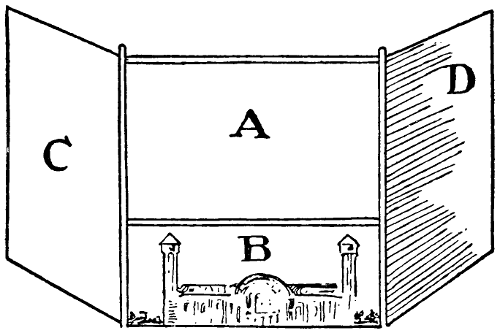
Fig. 1.—Showing frame and side wings.
The question of dimensions rests entirely with the exhibitor. Fig. 1 shows a diagram of the frame. As will be seen, its front is divided into two compartments, A and B. The lower compartment, B, is occupied by a scene of some Exposition Building. This must be made of cardboard, and can either be permanently nailed to the frame, or so constructed as to slide in and out between two grooves. The advantage of the latter mode of fixture is that when the owner of the firework show tires of one scene he can readily substitute another.
To represent the windows and glass domes of the Exposition Building, small squares should be cut from the cardboard scene and tissue paper pasted over them. When a light is placed behind, the effect will be very pleasing, and will considerably enhance the reality of the firework display.
After draping the two side wings (C and D, Fig. 1) with red or green cloth, the framework or “stage” may be set aside, and attention[401] paid to the fireworks themselves. They are by no means of a character calculated to send cold shivers down the backs of timid parents. Fig. 2 shows a portion of one. It simply consists of a piece of cardboard, slightly larger than the top frame (A, Fig. 1).
A design similar to that in the diagram must be lightly penciled upon it. Then, with a rather coarse needle, prick out this design with a series of small holes, through which the light can easily penetrate. It is also necessary to make four larger holes at each corner of the card, and to drive four wooden pegs or nails into the corresponding corners of the frame. By means of these the cardboard design can be quickly removed from or fixed to the “stage.” (See D, Fig. 4.)
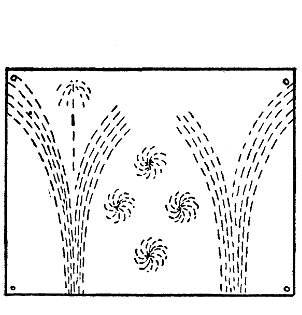
Fig. 2.—Showing firework design formed by series of small holes.
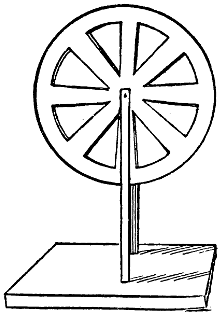
Fig. 3.—Revolving wheel, spaces fitted with colored tissue paper.
From another piece of cardboard cut out a wheel about 6 inches in diameter, and of the shape shown in Fig. 3. The numerous spaces between the spokes should be filled with pieces of transparent tissue paper of various colors.
A small stand upon which this wheel can revolve is the next requisite. This simply consists of a flat wooden base, with two wooden uprights glued firmly upon it. These uprights are connected at one extremity by a short piece of wire—an ordinary pin will serve the purpose excellently—forming an axle for the cardboard to revolve upon. Fig. 3 makes this quite clear.
Now to test the effect of the first firework.
Fix the cardboard design in the upper portion of the frame, and stand the whole upon a table. Then take a magic lantern (B, Fig. 4),[402] or, failing this, a bull’s-eye lantern or cycle lamp, and focus its rays upon the cardboard design. Next place the “wheel” (C, Fig. 4) in such a position that the beam of light shines through one of the tissue paper films, and then continues its original course to the screen.
When everything is in position, the room in which the display is to take place must be darkened. Having done this, grip the edge of the “wheel” by the thumb and forefinger, and spin it sharply round.
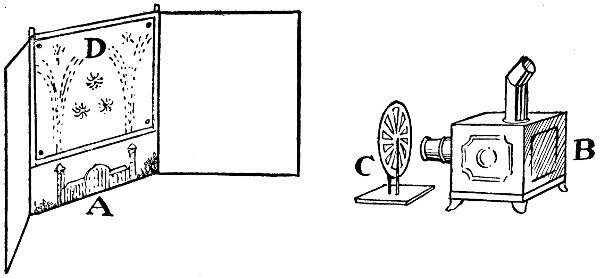
Fig. 4.—Firework apparatus complete.
As it swiftly revolves various colored beams of light will be thrown in rapid succession on the cardboard screen, and, penetrating the minute holes, will present the appearance of a fountain of brilliant, life-endowed sparks.
But our firework show gives scope for far better effects even than this. Some time ago great surprise was caused at an exhibition by the production of a firework boxer. With a little care and ingenuity, the same surprising result may be produced in the following manner:—
By means of a needle prick out two boxers in a defensive position (C and D, Fig. 5). The others must then be designed; only in this case, one boxer is administering the coup de grace to his unfortunate opponent.
Two grooved strips of wood are next glued to the top and bottom, as shown at A, Fig. 5, and two pieces of cardboard slid between them (B, B). These two cards should then be connected by three pieces of wire, as shown in the diagram, and have their corners rounded off in order to insure free movement in the grooves.
[403]
By pulling the left wire one pair of figures is hidden and the other revealed. Thus we have two firework boxers, who will fight a short but decisive contest.

Fig. 5.—The firework boxers.
There is another type of “indoor firework” working on the same principle as the above. A reference to Fig. 6 will put the exhibitor in possession of all its details.
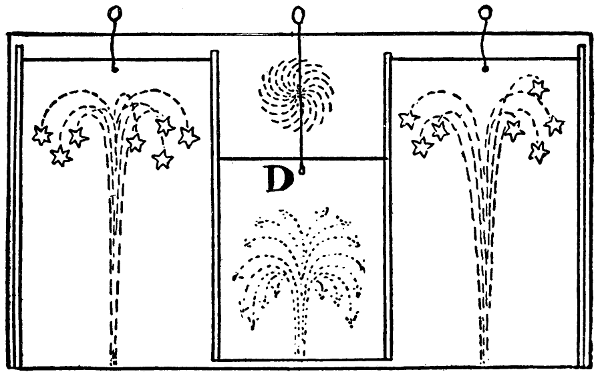
Fig. 6.—Another type of indoor fireworks with changing views.
At first only the central “Catherine wheel” is seen by the audience. Then, on the wire to the left being pulled, and the cardboard to which it is attached raised, a fountain of fire shoots into the air and bursts into a number of stars. A similar occurrence takes place on the right, and by pulling the central wire the “Catherine[404] wheel” is made suddenly to vanish and give place to the spectacle depicted at D.
Care should be taken when manipulating these “mechanical” fireworks that the hand does not come between the light and the framework.
Of course, on the above principles, numerous other designs may be made for the show, and a stock of “fireworks” manufactured that will dwarf any supply.
[405]
It is quite easy to make a telephone, which besides affording amusement, will, at times, be found extremely useful. Fitted from the ground floor to the rooms above, or from your friend’s house to your own, it is impossible to overestimate its convenience.
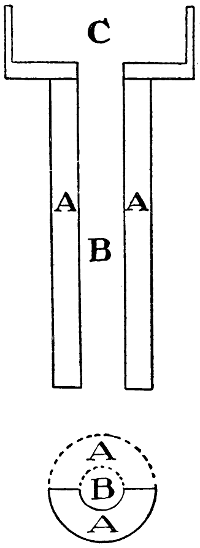
Fig. 1a.—Section of case.
Of course it is quite possible to buy the parts of a telephone ready made and fitted together, but it is much more interesting to construct the apparatus yourself.
The whole affair is so easily and cheaply made that no difficulty can possibly be experienced, and you have only to exercise care in order to succeed in constructing a very handy and interesting machine.
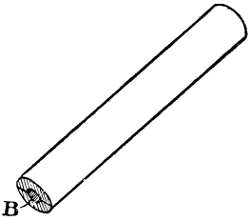
Fig. 1b.—Magnet case.
For the apparatus to be of any practical use, a pair of receivers are required—one for the person speaking, and the other for the person listening.
[406]
First of all purchase two bar-magnets, i.e. straight and magnetized at one end only—not the ordinary horse-shoe magnets. These bar-magnets should be about four inches long, and can be bought from any electrician; at the same time obtain from him an ounce of silk-covered wire, No. 36.
Before taking the magnets from the shop it would be as well to test them. This can be done by placing the marked end of one to the unmarked end of the other, and unless the former is able to support the weight of the latter, do not take either, but insist upon the electrician giving you stronger ones.
Having made your purchase, set to work upon the actual apparatus. The first things to be made are the wooden cases for the magnets, and these require care in construction.
From a straight broom-handle cut off two lengths, each a little longer than the magnets, i.e. about 41⁄2 inches long, and split them carefully down the middle with a chisel. Along the center of each of these halves cut a groove (B, Fig. 1a), in such a manner that when the two halves are put together they fit properly, and there is room for the magnet to slip backwards and forwards in the hole running through them. Now glue the parts together and you will have two short wooden tubes, or magnet cases, as shown in Fig. 1b.
Having made the cases for the magnets, now make the mouthpieces. Procure two wooden boxes such as boot-buttons are sold in, and glue one to the end of each of the wooden tubes you have just made, cutting a hole in the bottom of the box to correspond with the bore of the case. In Fig. 1a you will see the work, so far as you have completed it, shown in section. In the lid of the box cut a clean hole the size of a dime right in the center, but this lid must not be fastened to the box just yet.
The next things to be made are two bobbins upon which to wind the wire—one for each instrument. Cut a piece of fairly strong cardboard about 1⁄4-inch wide and just large enough in circumference to fit the marked end of the magnets tightly. Divide your No. 36 wire into two equal lengths, and wind each piece around the bobbins, leaving the two ends free to the length of about two inches.
Next slip the magnet, M, into the groove, and push it through so that the bobbin, L, is contained in the box C, Fig. 2. Make two holes in the bottom of this box, pass the ends of the wires through them and fasten them with binding screws, as in the illustration H, Fig. 2.
[407]
The thin plate which vibrates with the voice must next be made. Obtain a smooth piece of very thin sheet-iron—of just such a texture as is used by photographers for ferrotypes. Take the greatest care to keep this perfectly flat. Cut two round pieces large enough to cover the mouthpieces as you will see in P, Fig. 3, where it is shown in section. Take the lid in which you have already cut the circular hole and fasten it to the box in such a way that it keeps the iron plate in position (Q, Fig. 3).

Fig. 2.—Arrangement of magnet.
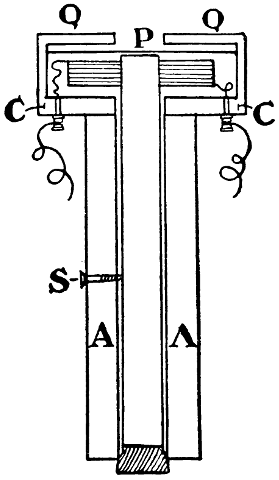
Fig. 3.—Section of completed instrument.
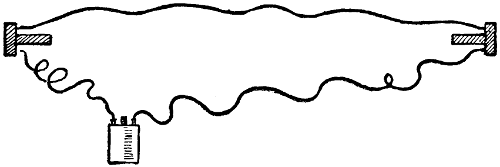
Fig. 4.—Connection with battery.
Push the magnet very close to, but not quite touching, the disc of[408] iron—say 1⁄16th of an inch away, and fasten it in that position, either by means of a wooden plug at the other end, or by driving a screw into the case in such a way that it grips the magnet and holds it firm (S, Fig. 3). Fill up the hole at the other end of the case with a piece of cork, glue or screw on the lid, keeping the opening so that it almost touches the iron disc, and your telephone is complete. Fig. 3 shows in section how it should now appear.
It remains only to make the connections with the batteries in the manner shown in Fig. 4, and you will be able to speak with your telephone. It is very possible, however, that the voice will carry faintly, but do not be disappointed, as this can be very easily remedied by making an apparatus which is usually attached to the telephone, and is known as
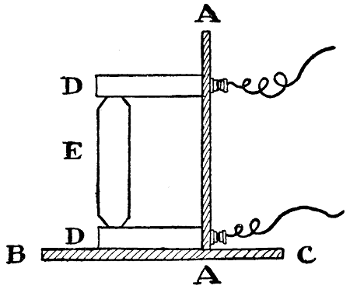
Fig. 5.—Sectional view of microphone.
This instrument, as its name implies, serves to make small sounds greater. Besides being useful in conjunction with a telephone, it is also of interest in itself.
Make a base, BC, and an upright, A, from a piece of thin pine wood, as shown in Fig. 5. Buy from the electrician two blocks of carbon such as are used in batteries (these will cost but a few cents), each measuring about a cubic inch. In one side of each of these blocks fasten a long binding screw, whilst in an adjacent side make a hollow with a rat-tailed file or a penknife. Then get a small pencil of charcoal such as is used in the large arc lamp, and cut off a piece 4 inches long; file both ends to a point in the way that you sharpen a pencil (E, Fig. 5).
Having made these various parts, fit them together. Screw the two pieces of carbon to the upright in such a way that one rests[409] upon the base whilst the other is at such a height that the charcoal pencil rests lightly in the hollows, between the two carbons, as in DD, Fig. 5.
The microphone is now complete, and can be attached to the telephone as shown in Fig. 6. It will be found to increase the sound to such an extent that your voice will be distinctly audible, and conversation perfectly clear.
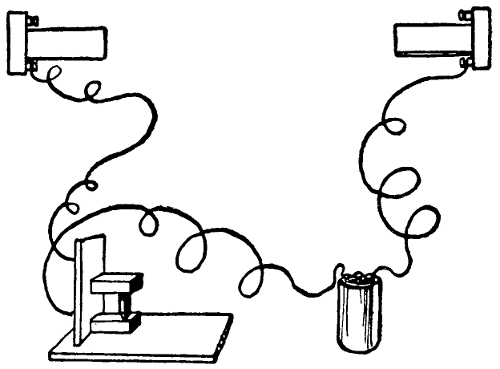
Fig. 6.—Connection of microphone and telephone.
By attaching one receiver and the battery to the microphone as shown in Fig. 7, very slight sounds will be increased to an extraordinary degree. The ticking of a watch seems like so many heavy footfalls, and if you can succeed in getting a fly to walk across the sounding-board, as the base is called, the footsteps will be plainly heard. Many interesting experiments can be performed in this manner, and as the microphone is so easily made, it is well worth constructing one for the sake of such experiments alone.

Fig. 7.—Experiment with microphone.
[410]
Like most of the inventions that have revolutionized the world, the electric telegraph is constructed upon the simplest principles.
As will be shown, an instrument for transmitting and receiving messages can easily be made at a very small cost by any one prepared to devote a little care to its construction; and when completed it will be found of considerable use and convenience.
To make a model of the elaborate machines now employed, which not only receive but print messages in legible Roman characters, would be far beyond the scope of any amateur, necessitating the purchase of many costly parts and requiring a considerable knowledge of engineering to fit them satisfactorily together. But the instrument that can be made according to the following instructions, is exactly similar to those in use throughout many smaller offices the world over.
The telegraph is based upon the following principle. A current of electricity, passed through a hoop of wire within which a needle is suspended, will move that needle from left to right, or from right to left, according as the wires are attached to one or other of the poles of a battery. This simple apparatus is called a galvanometer. A telegraph instrument is nothing but a galvanometer adapted to convenient usage.
Before entering upon the method of construction, it would be as well to inform whoever undertakes this work that the utmost care is necessary in adjusting the various parts. The slightest fault will certainly spoil the whole instrument, and the least carelessness render all the labor expended utterly useless.
Now to describe the simplest way to make a receiver and transmitter.
Three pieces of wood will be required, a cigar-box furnishing the best material for the purpose; if you have not one at home, any tobacconist will let you have one for a few cents.
To commence with the base. Cut a piece of wood measuring 6[411] inches by 5 inches. In this two grooves must be made (D D and E) according to the measurements shown in A, Fig. 1. The width of these grooves must, of course, depend upon the thickness of the wood, for the dial and the upright will have to be fitted into them.
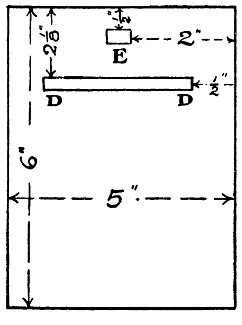
A.—Base of instrument.
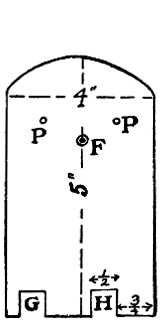
B.

C.—Upright.
Fig. 1.
For the dial you will require a piece of wood similar to the base, but measuring 5 inches by 4 inches. One end of this should be rounded as shown in B, Fig. 1. Drill a hole (F) right through this dial, 3 inches from the bottom and 21⁄2 inches from either side. As a piece of wire will have to revolve easily in this hole, take great care to cut it cleanly. In the lower end of the dial cut out two notches (G H), each according to the measurements in B, Fig. 1, i.e. 3⁄4-inch deep and 1⁄2-inch wide. Each notch must be 3⁄4-inch from its side of the dial.
The upright is very easily made, being simply a strip of wood 31⁄2 inches by 1 inch (C, Fig. 1). In this drill a hole (K) 3 inches from the end and 1⁄2-inch from either side, taking the same care as with the hole in the dial.
Having thus prepared the several pieces of the framework, the dial should be glued into its groove. A small square block of wood glued into the angle formed by the base and the dial will insure the latter’s being perfectly perpendicular. The upright will be fixed in its place later.
To proceed with the more delicate part of the work. Cut a piece of cardboard, fairly thin in texture, 5 inches long and 1 inch wide, and[412] bend it into the shape of an oblong hoop. Upon the hoop or bobbin wind about half an ounce of fine cotton-covered copper wire, size No. 36, which can be obtained from any electrician. Wind this wire very carefully and evenly, but not tightly, leaving about 4 inches free at either end (A, Fig. 2).
The next thing to be made is a magnetized needle, which can be easily done as follows. Take a piece of ordinary watch spring, an inch long, and make it red hot. When in this condition drill a hole through the center, and when it is cooler round the ends, as in B, Fig. 2. Heat it once more to a red heat and then plunge into cold water to harden. The needle must now be magnetized by being drawn several times firmly across the pole of a strong magnet, care being taken that it is always drawn in the same direction.
The pointer (C, Fig. 2) should be made in a similar manner, except that it must not be magnetized, and should be at least twice as large as the needle. Through the hole in the magnetized needle pass a couple of inches of straight stout wire, and with a little solder, or even sealing-wax, fasten the needle as shown in B, Fig. 2.
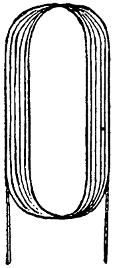
A.—Coil of wire.
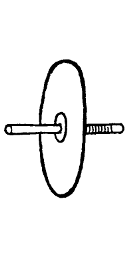
B.—Magnetized needle.

C. Pointer.
Fig. 2.
All these parts can now be fixed together. In the middle of the broad side of the coil of wire you must push aside the strands in such a manner that holes can be made through the cardboard hoop. Pass the two ends of the thick wire, to which the needle is attached through these holes, so that the needle is then suspended within the coil. Take care to make these holes large enough to allow the axles of the needle to revolve freely, as the whole success of your apparatus depends upon the needle turning easily within the coil, which should now appear as in Fig. 3.
Fasten the coil upon the back of the dial, one end of the protruding axle passing through the hole you have already made in the[413] wood. Then glue the upright firmly in its groove, with the other end of the axle through its corresponding hole. Take great care that the needle can revolve freely within the coil. Fasten the pointer to the end of the axle passing through the dial, and in this latter drive two pins or wooden pegs (P P) on either side of the pointer, in order that it may only move within a limited arc (B, Fig. 1).
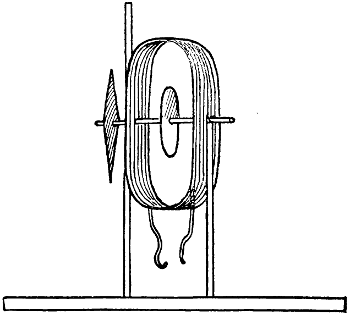
Fig. 3.—Revolving needle in coil.
It would now be as well to test what you have already done. Connect the loose ends of the coil to the poles of a battery, reverse them, and repeat this two or three times. If the instrument has been properly made, the needle should swing to the left when the wires are connected in one way; to the right when they are reversed.
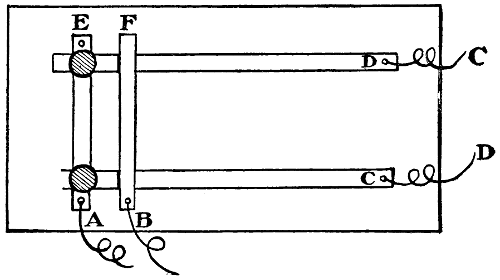
Fig. 4.—The keyboard.
Nothing more remains to be done but to make the keyboard, which is really the base of the instrument you have just been constructing. A glance at Fig. 4 shows how this is to be done. C and D are two thin brass springs, 5 inches long, and, as they have to pass through the notches in the dial, less than half an inch in width, they must be bent upwards, so that when fastened to the board at C and D[414] the opposite ends will spring up and press against the under side of the metal bridge BF. They are then in what is called “metallic contact.”
The bridge should be made from a piece similar to the springs and bent as shown in Fig. 5. Another strip of brass must be screwed flat to the board at AE, parallel to BF, and over this a couple of wooden or ivory knobs should be fastened to the springs, as they are used to press down CD in contact with AE (Fig. 4). When released they should fly back to BF. Be very careful to see that all these details are thoroughly in order, as they form the most vital part of the keyboard.
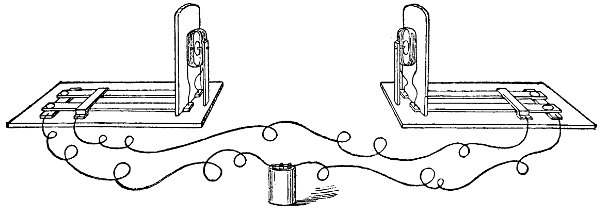
Fig. 5.—The instruments ready for use.
At the ends CD of the springs fasten two binding screws, and do the same at A and B. Fasten the two loose ends from the coil to C and D, and attach the wires from the battery to A and B. Now is the time to see whether your machine has been properly made. By pressing down one key you will find that the current of electricity deflects the needle and the pointer to one side, and by releasing this key and pressing the other one, the pointer will swing down to the other side. If this is done satisfactorily your telegraph instrument is complete, and with a couple of them you will be able to send messages from one room, or one house, to another.
The complete apparatus should appear as in Fig. 5, which also shows the connections with the battery.
A couple of Daniels’ cells, or two ordinary dry batteries are sufficient to work both instruments.
Two copies of the Morse alphabet should also be made, one to[415] be kept by the side of each machine. When the needle deflects to the left it designates a dot. When it turns to the right it is a dash. A short space separates the letters, and a longer one the words.
When the alphabet has been mastered both for transmitting and receiving, the use of your telegraph will be a matter of the greatest simplicity, and you will be able to send messages with considerable speed to your friend at the other end of the line. Below, the Morse alphabet is given, as well as a message, which it is hoped you will be able to send.
| A | · — |
| B | — · · · |
| C | — · — · |
| D | — · · |
| E | · |
| F | · · — — |
| G | — — · |
| H | · · · · |
| I | · · |
| J | · — — — |
| K | — · — |
| L | · — · · |
| M | — — |
| N | — · |
| O | — — — |
| P | · — — · |
| Q | — — · — |
| R | · — · |
| S | · · · |
| T | — |
| U | · · — |
| V | · · · — |
| W | · — — |
| X | — · · — |
| Y | — · — — |
| Z | — — · · |
[416]
The term “Hypnotism” is defined in Nuttall as “an artificially induced state of sleep,” and is of Greek origin, the prefix “hypo” signifying “under” or “beneath,” and the Greek root “hypnos,” sleep.
Hypnotic, or “under-sleep” conditions, may be induced in several ways, and are not limited to the best-known method, that of absorbing the attention of the subject by means of an object; for oblivion may be caused quite as successfully by means of the sense of touch as in gentle continuous stroking, pressure of the skin, by the motion of the hands over the body without touch, or by soothing words, which, accompanied by the penetrating magnetism of the eye, convey hints or suggestions to the intelligence.
Methods of hypnotism may be divided into two classes:—
1. The Mental Method—which directs the subject’s imagination and senses to co-operation, creates an image in his mind, thrusts the dormant brain into a totally different environment from that to which it is accustomed, renders it extraordinarily hypersensitive to suggestion, and unfolds experiences probably hitherto unique, at the will of the exponent.
2. The Physiological Method—that steeps the faculties in oblivion as completely as when chloroform is administered.
This latter form is often used as a therapeutic means of securing rest and relief from pain. It has been proved that individual character takes a far greater part in the mental method than the physiological.
When an object is used to induce hypnosis, it is held at a distance of about eight inches from the eyes, and removed gradually to a foot above the forehead (Fig. 1).
During this process the gaze should follow the slowly moving object until the lids are strained to their widest extent (Fig. 1a). This position naturally fatigues the eyeballs and causes the lids to close swiftly.
[417]
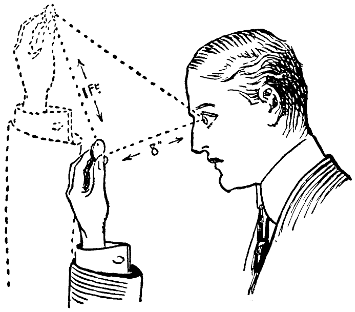
Fig. 1.—Range of object to induce hypnotic sleep.
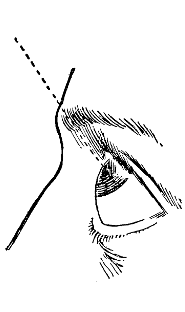
Fig. 1a.—Gazing with eyelids open to widest extent.
It is not essential that a glittering object be used. It has been found that the finger of the operator, moved gradually, is as successful a means as any object. Should the hypnotizer desire to enforce slumber, he may accompany his action with suggestions that the subject is extremely tired and longing for sleep.
“You are worn-out. Your head is heavy. Your limbs are fatigued. You need rest. Sleep is essential. You are gradually falling asleep.”
Before hypnotism can take place, the patient makes his mind a perfect blank, and concentrates his whole being and vision on the button, coin, glass, or crystal held before him. It will now be seen that his eyes begin to water, the pupils undergoing a series of changes, contracting, dilating, and recontracting, as if he were succumbing to natural slumber. His sight becomes gradually insensible to the light, and in a few moments he is unconscious.
The state of hypnotism begins with the second narrowing of the pupil, and is accompanied by a quickening or retarding of the pulse, rigidity of body and heaviness of brain, which becomes chaotic and wildly confused before the final stage is reached. The will is entirely surrendered to the hypnotizer, and the subject is powerless to move, speak, or feel, except at his suggestion.
A sure test that the individual experimented upon is really oblivious to everything about him is shown when the operator gently moves his arms from his side in a horizontal position and lifts his eyelid. When the arms remain rigidly outstretched and the eyeball is fixed and glassy, the exponent is assured that his subject is completely at his mercy (Fig. 2).
[418]
In order to bring about this condition successfully, the hypnotizer must possess no small amount of cultured will-power and concentration. His mind must be absorbed in the experiment as wholly as the subject’s faculties are concentrated upon him. He is now forcing his brain to act at his dictation, not only upon his own movements, but upon those of the individual chained to him by his exertion of hypnotic influence. One mind operates them both, and, during his subject’s trance, he has as complete a sway over his nervous system as if he possessed two bodies and a double supply of arms and legs.
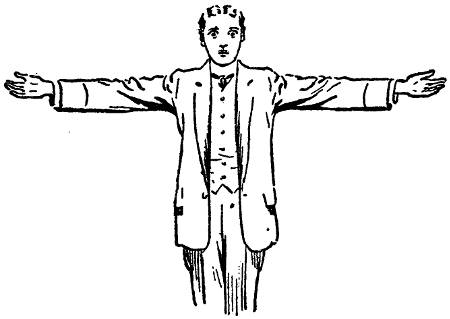
Fig. 2.—The subject, when hypnosis is complete.
The eyes, whether closed or widely open, are focused on his brain, insensate of everything beyond the compelling force creating his thoughts. He can hear sounds, smell, taste, see, talk, or remain silent—only in obedience to that petrifying will.
Of every movement of our bodies, the brain is supreme operator. The code of suggestion is flashed through telegraph wires composed of nerves and muscles. No turn of the head, twitch of the finger, beat of the heart, can take place without the coalition of those wonderful brain-cells. When an individual is stricken with paralysis, and has lost all power over his limbs, it is not because his bodily organs are injured. Impotence is caused by the fact that his brain has lost its ability to exert its power over his organs.
The wheels of a brain, however carefully oiled and cleaned, remain motionless unless the engine fires are lit; and, in hypnotism, helplessness is not brought about by the mastery of the exponent over every separate joint and muscle (for it would be absolutely useless, even were it possible, for him to concentrate his attention on every minute movement of the body), but simply because he is robbing the brain of its individual control, and is exerting his own will to dominate the purpose and identity of his subject as relentlessly as the magnet dominates the needle.
Some subjects are less amenable to hypnotic influence than others. The belief that those of weak will are the easiest prey is a fallacy.
The real reason lies in the fact that the individual is incapable of[419] concentrating his will in obedience to the dominating mind. This is generally the case with persons inclined to hysteria or of neurotic temperament, and for such, a revolving glass is the best object to be gazed upon, as it wearies the eye and induces slumber without the need of concentration or surrender of will.
There are others who cannot easily be hypnotized because they determinedly set themselves to oppose the purpose of the operator to such an extent that his brain becomes exhausted in the process and loses its potency. In such cases the best plan is for the hypnotizer to inspire faith by means of experiments performed over other individuals in the presence of the resisting or cynical, until the incredulous are convinced that the hypnotic influence is not induced by trickery or confederacy. The influence of imitation is an important factor in hypnotism, and faith once founded does a great deal to overcome defiant wills.
It has been found that some of the best results have been those when the subject is taken completely by surprise.
The motion of the hands often brings about unconsciousness as swiftly as when an object is used. The hypnotizer should stand a few paces from the subject, gaze into his eyes, and with hands raised sweep them gently in continual passes over the body, reaching from above the head to below the hips. This action should be continued without a pause for some minutes, the hands sweeping across the face, as near as possible without touching it (Fig. 3). The motion may also be performed at the back of the subject (Fig. 3a).
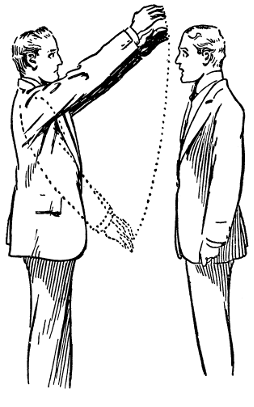
Fig. 3.—Motion of hands “before” subject.
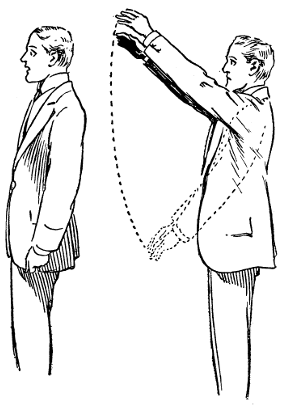
Fig. 3a.—Motion of hands “behind” subject.
The body will gradually sway backwards or forwards, the gaze become fixed and lifeless until the subject’s will is surrendered, when, by withdrawing a few paces and raising a finger, the exponent will be able to draw him in any direction he wishes.
The power of hand motion has been explained as due to stimulation[420] over those zones of the body most susceptible to hypnotic influence, or the slight motion of the air, or mental influence. It is probable that all these influences combine, the most important being the mental influence.
The idea that the hypnotizer possesses some magnetic fluid which passes from him to the subject in the process of hypnotism has been proved to be without any foundation, and is merely a foolish superstition. There is nothing mysterious or supernatural in the influence of this power. It is due entirely to the exertion of mental force and the involuntary co-operation of the individual hypnotized.
Performance of hypnotism in a drawing-room is not difficult, although, like everything else, it needs practice and perseverance before it can be successfully accomplished; and, unless the mind of the hypnotizer is disciplined to determination and control, it naturally fails to act upon other minds.
Now, provided that the student has some knowledge of the subject, and has trained himself to keep his attention fixed, to the exclusion of everything else, upon the matter in hand, a few experiments may be undertaken. Elementary ones should be essayed at first.
Fix upon an individual among your onlookers. Ask him to withdraw for a moment or two, while you and your friends decide what he shall accomplish. However simple the action, every mind must be concentrated upon it, and there must be no laughing or talking.
If you know something of the character and temperament of the subject chosen, this will aid you considerably. He should have faith in your power, and willingly surrender his will to your control. As an aid to concentration, request him to close his eyes; or, better still,[421] blindfold them. Next turn him round several times, taking care not to induce giddiness. Your only reason for doing this is to shut out all objects that may draw his thoughts from your purpose.
Place the tips of your fingers lightly on his shoulders, but do not push him forward (Fig. 4). He must move only when he feels the impulse of your will impelling him with sufficient force to render resistance difficult or impossible. He will probably stand motionless for a few moments, and this is when spectators are inclined to giggle a little, just as when, for no particular reason, one’s risibilities are stirred while being posed before a camera.
If, however, the slightest sound intrudes upon the silence, the growing spell will be broken, for it at once disturbs the train of thought surrounding the subject, and draws his attention from your will. Silence is absolutely essential, for it has almost as powerful an influence as the strongest will.
This gained, you will feel your subject sway a little under your fingers before he goes slowly and unhesitatingly forward, feeling his way with outstretched hands, and walking with the peculiar tread of a somnambulist, until he unerringly picks up the photograph, takes a pin from the curtain, removes a flower from a vase and places it in his button-hole, or any other trivial act you have fixed upon. Then he will pause, as if in relief that the deed is accomplished.

Fig. 4.—Inducing hypnotic sleep.
Only one action should be decided upon at a time—the simpler the better to begin with.
As you excel in this form of hypnotism, you may try more complicated experiments, but not until you have overcome the rudimentary difficulties and have developed your powers to such an extent that you have absolute faith in your ability, for self-reliance and self-confidence are the corner-stones of hypnotism.
[422]
In order to cultivate these, experiment upon yourself by the means of auto-suggestion or self-hypnosis, which is a splendid means of training those faculties necessary to the mastery of other minds.
Change your state by means of words which imply a condition either mental or physical not personally experienced by you, and believe implicitly in your own ideas. Treat yourself exactly as if you were experimenting on another individual, surrendering your subjective and objective mind wholly to absorb the idea conveyed, and gradually its meaning will influence and take possession of your brain to the exclusion of everything else.
The change suggested should be exactly opposite to your natural state—for instance, if you are warm, tell yourself determinedly that you are cold until you credit the fact, when your body, which blindly follows mind and will, experiences the sensation of cold.
If you have a headache, suggest that the pain has gone, &c. Auto-suggestion may be perfected to such an extent, that, under its hypnotic trance, a needle may be plunged into the skin without the action’s causing the slightest degree of pain.
In suggestion, it is always the subjective mind that is swayed by hypnotic influence. This is always keenly alive, and it is through its medium that the subject is induced to an extraordinary power of imagining and experiencing the processes suggested by the hypnotizer.
Elementary exhibitions are very entertaining, and are quite sufficient to illustrate the motive power which achieves your purpose. Some individuals are better hypnotists than others, because they have a natural supply of animal magnetism at their disposal, but it is extraordinary what results can be brought about by study and patience, so that students less gifted need not despair of success.
For the sake of those who have succeeded in such simple experiments as the foregoing, the following may be undertaken. In these, intuition, sympathy, and imagination play almost as important a part as thoughtful concentration, which is ever the most powerful possession in the outfit of the hypnotizer.
Here, one word as to the difference between the terms hypnotist and hypnotizer. The former is a scientist, who employs his art solely for therapeutic or medicinal purposes. The latter is the entertainer, and care should be taken to distinguish between the two words.
Experiment.—Place the subject in a chair, with palms on knees. Pass your hands over him for a space of several minutes, the while his eyes are fastened on your own. Watch his expression carefully.[423] It undergoes several changes, the individual character dominating (Fig. 5), gradually disappears, and finally gives place to vacancy (Fig. 5a). The firm lines of the mouth fade, and the lips become slightly parted. The face grows blank and purposeless, the eyes staring and void.
You have some plan in your mind which you are straining to impress on his brain. Supposing it is that he shall not remove his hands from his knees. Say to him, in a low soothing voice, which penetrates his hearing perfectly (to shout, breaks the spell in a moment), “Your hands are stuck to your knees; you cannot remove them. They’re glued; they’re tight fast. Do what you will, you can’t lift them. Now try——”
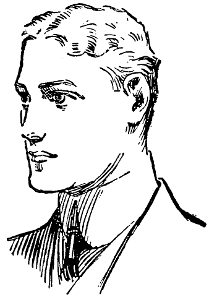
Fig. 5.—Face showing character before hypnotic sleep.
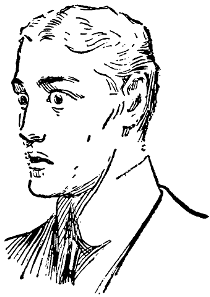
Fig. 5a.—Face showing vacancy under hypnotic sleep.
At your dictation he endeavors to do so. He lifts his knees. He ducks his head, trying to push his hands away by means of his chin, but every effort is futile until you say, “You can now remove your hands. See, it is quite easy, they are free!” At once he lifts them easily.
Now ask him his name. He tells you in a dazed, obedient voice that it is “John Jones.” You determine he shall forget his name. You say to him again and again, “You have forgotten your name. You cannot tell me what it is. You don’t know your own name; you can’t remember.”
The subject’s face at once indicates that he is absolutely nonplused. He struggles to remember, but in vain. Should you suggest that his name is Mary Smith, he will believe you implicitly, and, with a relieved expression, declare this name to be his own.
Bid him open his mouth as wide as he can. Then say to him,[424] “You can’t shut your mouth. It is fixed, rigid. Try to shut it.” He vainly endeavors to do so. He places one hand on his head, the other on his lower jaw, and tries to force his lips together, but he is powerless so long as your will opposes him. When you command him to shut his mouth, he does so without effort.
A subject should not be kept longer than a few moments in this subservience to your will. He can be released by a snap of your fingers at his ears or before his eyes. Address him softly by his name, and he will return to consciousness in an instant. When he looks dazedly round, reassure him, kindly, that he is quite well, and will suffer no harmful results from your experiments.
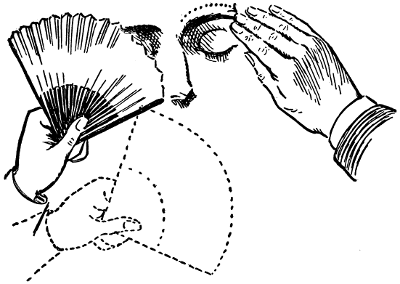
Fig. 6.—Awakening the subject.
The hypnotizer should never abuse his power over an individual. He must possess sufficient humanity to prevent him from keeping his subject too long under control.
When he finds a subject who answers readily and quickly to the hypnotic influence, he may be tempted to continue an exhibition of his powers in order not to lose time on less amenable individuals, but he should determinedly resist this temptation.
A valuable aid for him will be to time his experiments by a watch, limiting each individual’s trance to a space of, at most, four minutes’ duration.
The hypnotizer must be in perfect health, for, unless his body,[425] nerves, and mind are in proper condition, the supply of animal magnetism fails. He must study hygiene, take sufficient exercise, and be most particular to keep his body, linen, hair, and finger-nails scrupulously clean.
A dirty finger, held up before a subject undergoing the hypnotic trance, inspires the latter with a revolting sense of disgust, and clouds the vision conjured by the brain.
The hypnotic entertainer should abstain from any indulgences, and eat only plain, wholesome food. During the process of hypnotism, the exponent should never lose his head or self-reliance. Any dread experienced by him is at once conveyed to the subject. Should the latter be unable to awake from the trance at command, the operator must wave his handkerchief before his eyes. If these are closed and refuse to open, he must at once rub the eyebrows with the tips of his fingers, beginning at the root of the nose, and ending at the temples, terminating this action by gentle fanning or blowing until such efforts meet with success (Fig. 6).
It should always be remembered by the student that the power of hypnotism—like fire—is a good servant, but a bad, tyrannical, and lawless master, unless properly controlled.
[426]
Clairvoyance, originally a French word, means the ability to see clearly. The reason so few people possess this extraordinary psychic faculty, is because most human beings are three-quarter parts blind, deaf, and insensate to anything beyond the ordinary emotions.
The power of prophecy and acute intuition is a sixth sense which most of us have in a slight degree dormant and uncultivated.
Clairvoyance has often been mistaken for superstition or wilfully imposed and cunning deceptions, and it is difficult for ignorant and cynical people to believe that it is founded on science and truth.
It has stood firm through the ages in spite of the quackery of wizards, paraphernalia of sorcerers (used to inspire fear and awe in the uninitiated), the sneers of those of material minds. All of us at some time or other have felt the control of that still small voice, potent and penetrating as conscience, which comes, unaccompanied by earthquake or fire, to instill us with awe, joy, extreme sadness, or warning at some critical juncture of our lives; often anticipating, with power greater than speech can convey, some event that concerns our well-being.
Why this power should be deemed more extraordinary or mysterious than the senses of sight, hearing, smell, and touch which, even to those thoroughly conversant with the anatomy of the human body, remain steeped in mystery, it is difficult to say.
Science teaches that a million delicate sounds escape the ear and brain, and as many minute exquisitely fashioned atoms escape the eye.
A magnifying glass reveals the marvelous structure of insects and microbes invisible to naked sight, and it is only by means of a telescope that the beauty of the stars is discerned; thus the developed power of clairvoyance may be called the magnifying lens of the soul.
It is because this lens is dull and misty that we fail to see.
The history of ages and a great deal of our most cherished literature prove its existence.
Many of the stories and prophecies of the Bible are founded on[427] clairvoyance. People were simpler and more trusting then; for this reason visions and clear sight were granted them.
Pilate’s disregard of the warning conveyed in his wife’s dream, affected the whole course of Christianity, and the Bible abounds with examples of the disasters that befell those who disobeyed the spiritual promptings sent them.
This wonderful faculty of inner sight is the possession of the individual born blind. He demonstrates its existence when by merely passing his fingers over an object he can describe exactly a color he has never seen. In him it is nature’s recompense, and no one who watches his movements can doubt that he is guided by this psychic organism, yet when we note the same power granted to a man or woman blessed with eyesight, we at once decide that happy coincidence, trickery, or charlatanism is the origin of the manifestation.
Clairvoyance teaches that everybody has a distinctive color, which conveys more of character and personality than any word or action. The shades of these colors vary according to temperament, and are as much concealed from untrained vision as the million tints composing the gold, purple, and green bands of the rainbow.
These colors, however, although providing the key to the character, are subject to constant changes. Our moods sway and change our thoughts according to the happenings that affect us.
For example, bereavement or anxiety has power to transform the blue aura of the optimistic temperament to gray, and this temporary change of color studied alone may perplex the clairvoyant, and mislead him to a false diagnosis of character.
In order to prevent this, the seer will do well to request some article constantly worn by the inquirer to be handed him; the older and shabbier it is the better. A dilapidated glove, an everyday tie or a[428] ring constantly worn are equally valuable by which to discriminate between the temporary and habitual aura peculiar to temperament. When a man’s glove emits a pale blue aura, in contradiction to the gray of his own personality, the deduction is that he is naturally of a hopeful and cheerful tendency, but that some mental anxiety or bereavement causes the gray, deep or pale, according to the depth of emotion dominating him.
The reason of this difference of colors is that the glove is, as it were, saturated with the essence of his normal disposition, while the color of his character has been changed by circumstances or environment.
In the brain there exists a small and delicate organ known as the pineal gland, and it is thought by some scientists that this is responsible for, and sensitive to, the subtle vibrations of ether which are too minute to stir the tympanum of the ear. Its cultivation produces the power that beholds and distinguishes the difference in shades of mental color in which the mind is absorbed.
People of erratic temperament possess an aura of many and constantly changing colors, but those whose calm never varies maintain but one.
Some few persons are aware of the tones of their aura, and are therefore keenly sensitive to the influence of their surroundings.
They will be perfectly miserable if the paper on their walls, or the material of their clothes, clashes in color with that of their character; while they are at their best and happiest surrounded by the tints that blend or contrast harmoniously.
The clairvoyant’s outfit consists of six qualities:—
In advanced clairvoyance the use of the crystal for vision is designated by many seers as “clap-trap” and vulgar “playing to the gallery.” It is found to be injurious to eyesight and brain centers to gaze at any shining article for too long a period, yet in parlor clairvoyance there is no doubt that it has great power of inducing concentration of sight and thought.
[429]
By means of crystal scrying the gazer creates and becomes subject to the influence of auto-hypnosis—that is, he is able to throw himself into a trance which veils his own personality and links him to that of his client.
The surface of the crystal gradually reflects images, and subconscious impressions conveyed by and vital to the individual whose past, present, and future are being revealed.
Sympathy and intuition merge the soothsayer’s aura with the temperamental coloring of his client. His magnetic force creates further powers, while his psychic discernment or sixth sense is the nucleus about which these are bound.
No student of clairvoyance can be successful in discerning character and personal emanations of color unless he is disciplined by simple rules which should govern his life.
Excessive eating, drinking, intemperance in any form, self-indulgence, bad habits, and drugs destroy this delicate sixth sense past redemption.
Want of sincerity and integrity results in the rapid decline of its power.
The body and mind must be pure and of perfect mental and physical balance. No nervous fretting or pettiness of outlook should be permitted to intrude.
In clairvoyance the brain is ruled by large and lofty aims, and it must be kept as unspotted and clean as a white garment; so only is it capable of performing its proper functions.
Likewise it is essential to remember the important, nay, vital dominion it exerts over the body, which cannot rise to perfect beauty and health unless its mental orbit is lofty and serene.
In consulting a clairvoyant the client should be serious, earnest, and trustful that he will hear the truth. Frivolity, incredulity, or idle curiosity forms as it were a thick crust between the mind of exponent and inquirer, which prevents the penetrating of thoughts and vision, strains the powers, and results in disappointment.
In the same spirit in which one visits a doctor or solicitor should the clairvoyant be approached, and there must be no determined reserve to conceal thoughts and character in the mind.
Clairvoyance in a drawing-room full of people is extremely difficult—indeed impossible, unless the onlookers can be induced to keep perfect silence during the operation.
It is always better to be closeted alone with the inquirer in a small[430] room to which street noises do not penetrate, provided only with the necessary furniture, kept clean and fresh, airy, and well lighted.
The crystal should never be touched by any one save the clairvoyant, and must be kept free from spots and smudges. A black silk handkerchief round its globe will be a help to divination by preventing the reflection of lights.
There may be, especially to beginners, temptations to pose as the possessor of supernatural powers—to make passes over the crystal, light wax tapers, burn perfumes, and murmur incantations—but these methods, although employed by the ancient prophets, are of no aid to the modern sage. Indeed, they do harm by appealing to the senses and superstitions, and, being a mere affectation, are unworthy of that sixth sense and harmful to it.
The simpler the manifestation, the more assured the clairvoyant may be of arriving at the truth.
Self-confidence, an absolute belief in his gift, and faith in his methods dominate him.
He does not endeavor to avoid exertion of his nervous forces by discreetly “pumping” the inquirer as to ways and means, but takes a delight in silent investigation.
The clairvoyant should come to his task fresh and buoyant, bubbling with enthusiasm, and yet without frivolity or thoughtless mind. At the slightest sense of fatigue he should desist from his efforts, for it is extremely harmful to apply any force or strain to this abstract power.
Physical fatigue and excitement must be avoided, for these engender jangled nerves, sleeplessness, and finally inability to isolate the mind from the orbit of our own concerns to the sphere of others.
The processes that occur in crystal-gazing are thought transference and telepathy. A communication of ideas is set up between the prophet and client, and the mirror-like surface of the crystal is the medium by means of which innate thoughts are reflected.
As far as possible, the clairvoyant submerges his own personality in that of the inquirer, putting himself in his or her place. The best means of creating these links is to place an article constantly worn by the inquirer to the head. Profound silence brings about the sense of atmosphere and aura usual to the latter, and by these means, and an intent gazing into the crystal, visions originate.
The crystal is supposed to be the magic bridge which spans the[431] chasm fixed between itself and the spiritual world. In the iron it contains are situated the collective and culminating forces.
Mists of white, green, blue, and violet tints are symbols of good fortune and happiness; black, yellow, and red are warnings of disaster.
When the mists disperse and gradually ascend to the surface, the clairvoyant may reply to any question in the affirmative; mists that descend to the bottom are signs of negation.
Images that develop to the left of the clairvoyant are real; those on the right are purely symbolical.
It will be seen from the above that in order to apply oneself to the achievement of reading the secret depths of mind, character, talent, and circumstances, it is necessary to possess the power of separating oneself from material surroundings and allowing the spirit to dominate the body.
This can only be executed by the process of hypnotizing oneself. Clairvoyance is based on certain forms of this semi-somnolent state, for, just as in hypnotism, the mind reigns supreme over matter and becomes isolated by means of an object, so, in clairvoyance, a waking trance is brought about by fixed gazing into the crystal.
However, there are other methods of inducing this state, more or less difficult of manipulation, until constant practice and experience have made them a habit.
For the reason, formerly mentioned, that long gazing at a bright surface is injurious to eyesight, many clairvoyants prefer to create visions without the use of a crystal.
Words repeated over and over again have a mysterious power of isolating the sixth sense from the rest.
For example, the word AUM is extraordinarily symbolical. It stands for three influences—
A = the objective.
U = the subjective.
M = the Eternal.
These are the three kingdoms in the heart of man.
The objective, being the natural surroundings of objects and events which we all can feel and see.
The subjective, being the realm of influences the degree of which is felt according to the perception and training of our spiritual forces; too often vague and illusive, because most of us ignore its existence.
The Eternal World, being that state to which the subjective world, in its highest state of development, leads. This word repeated, slowly[432] and steadily at first, and then at great speed, has a marvelous power to create as it were a vacuum between the spirit and body of the prophet.
His mind dwells on its meaning; the vibration of the different letters acts on his mind, and he is carried by gentle stages to the very seat of his spiritual being.
It is when he attains this full development that he is granted large, clear, and deep perceptions of his client’s character, and is able to reveal facts concerning him which in his normal state would be absolutely impossible.
The sensation experienced is that of being plunged into space in which the senses of sight, hearing, and touch are transmuted to the brain and spirit.
The student will doubtless be discouraged at first at his inability to produce this state, but he should remember that hard work and perseverance are the attributes which all must give to be perfect in any learning, art, or science.
One destined to become a great mathematician stumbles in childhood with despair over the first addition sum, and the most distinguished musician has to do battle with the rudiments of music.
Thus it is in clairvoyance. Seemingly insuperable difficulties surround the novice who has never learnt to recognize the value and power of the sixth sense. Patience, a tranquil, determined mind, and not a little courage, are necessary in this branch of science. Time and growth work wonders in the persistent mind, and it will be seen that the obstacles gradually move aside, the curtain is lifted, and the strenuous seeker reaches that mature vision which he has formerly imagined dimly, if at all.
It is a good plan for the novice to ponder on his own name, and, shut away from all distractions, repeat it again and again to himself. He will gradually feel a sense of deepest mystery surrounding him, for in that name is concentrated the riddle of existence. The blending of spiritual and material kingdoms lies behind it, and the material slips rapidly into obscurity.
The eternal question based on introspection faces him. “What am I? Whither am I going? What is the meaning of this thoughtful brain, this palpitating heart, these stirring pulses through which the mysteries of the soul flash in a thousand directions?”
These and many other questions will move into being until the eternal atmosphere of spirituality is reached, and the wings of the soul[433] become unfurled and increase in strength and power to lift him to the realms of his desire.
Only when the heart is pure and worthy will the vision be granted—the dross of bitterness, envy, hatred, and malice, which generally hide the precious jewel from the light, and render scintillating brilliance impossible, all discarded.
Every one knows how difficult it is to control the mind, and keep it from mean and uncharitable thoughts. It is more rebellious even than the body, and influences it for good or evil.
Temptations small and great are created and emerge from the mind. No one thieves with his fingers until the thought of theft is born. His mental faculties plan the ways and means and cunningly devise protections against the punishment in which the act when culminated results, unless artful deceptions render discovery impossible. No treason or wrong-doing was ever committed before the deed was hatched in the brain.
The mental sphere may be a hotbed of falsehoods and treachery, or it may be a world of purest truth and virtue.
Therefore, before all else, the clairvoyant must learn to discipline and constrain his thoughts, and this is extremely difficult, and seems at first almost impossible; yet, if the lamp is to burn brightly, it must be kept clean, and daily fed with all thoughts that are benevolent, gentle, and good.
A humble demeanor, a longing for purity and singleness of purpose are needed to bring about these noble qualities, and here it is that proper treatment of the body is invaluable.
Simple diet, early rising, daily exercise, constant isolation, and cultivation of good habits create the orbit for the higher faculties. These are the elementary rudiments of clairvoyance, and, unless they are mastered, the clairvoyant, no matter how diligent and persevering he may be in his studies and labor, is doomed to failure.
A quiet state of mind helps in all the storms and stress of life. It is a harbor of quiet blue waters, in which the seafaring vessel may shelter beneath peaceful starlit skies, securing power and refreshment and shafts of clearest light by which other human ships may be led towards his haven.
[434]
There is something sufficiently fascinating about table-turning to fix the attention and interest of guests gathered for an evening’s recreation, and as it needs no previous arranging, it is an excellent device at an impromptu party.
The table must be round, light, and of wood. As many of the company as can be squeezed in its circle may take part, but the excitement will be shared by the onlookers. Each places both hands lightly on the surface with the thumbs touching, and the little finger joined to that of his neighbor. It is important that there should be no break in the chain of hands, as this prevents the flow of the electric current, which is alone responsible for the vibration and movement of the table.
The time of waiting for its first motion must be spent in silence, and may last from five to twenty minutes. Any “wag” who takes it into his head to jerk the table with his knees, or push it with his hands during this period, should at once be called upon to forfeit his place.
Those experienced in table-turning know perfectly well how different the movement caused by such a proceeding is from the real tilt the table gives when moved by the electric current, and will soon discover the impostor, for no trick can bring about the same curious vibration.
The table should be treated with the greatest respect, otherwise its “spirit” becomes taciturn and silent, and, even after the tilting backwards and forwards has gone on for some time, it has been known to retire at the slightest sign of levity and incredulity. Not until the manipulators are assured of its movement should any question be asked, and, before this is done, they must agree upon some plan by which they may comprehend the answers given.
Two taps or bows may stand for “Yes,” one for “No,” or vice versa; but, when once decided upon, should remain fixed.
The question must not be asked until the preliminary vibrations have[435] ceased; then one of the party—the medium, so-called because he or she possesses more magnetic power than the rest, addresses the spirit, and those anxious to hear anything affecting themselves must use him or her as mouthpiece. The table is questioned in some such way as this:—
Medium—“Are you going to be kind to us to-night, O Spirit? Please answer two taps for ‘Yes,’ and one for ‘No.’”
At this polite request the spirit doubtless replies in the affirmative. When ages and dates are required, the medium counts the number of taps, and gleans the result when the taps cease.
Names are discovered by carefully going through the alphabet. Each tap stands for a letter, and, when the table pauses, the initial and other letters of the name are provided, until the whole is spelt out. Thus, supposing the medium inquires the name of his left-hand neighbor, which it may be presumed is Alice, the spirit, having apparently heard the question, gives one decided jerk, and then is perfectly motionless. The medium says “A—next letter, please.” The table obediently bobs twelve times; that is, until L is reached. The medium continues, “Next letter, please,” and the table obligingly bobs nine times. “I,” says the medium—“next letter, please.” Three bobs give C. Five bobs give E. The table is then motionless, and another question may be asked.
Queries should never be clamored at once by the impatient guests, nor should one monopolize the spirit’s attention with his own affairs. A good plan to follow is for each in turn to supply the medium with an inquiry. The initials, Christian or surname, of the man or maid one is destined to marry may be revealed by the spirit. Initial letters are better, because when there are many eager to know their fate, the full names take too long.
Sometimes it will be noticed that the spirit gives very decided answers, jerking to one side so abruptly that the players are obliged to push back their chairs and have some difficulty in keeping their hands on its surface. At other times it seems undecided, and if the question is an unwelcome one, the spirit will race through the alphabet again and again at a great speed and without a moment’s pause. When this is the case, another question should be asked.
Should the spirit refuse to communicate at the end of twenty minutes, the manipulators may be sure that an “unbeliever” is in their midst, or that the whole assembly has too small magnetic power. When this happens, other persons should try their skill.
[436]
As mediums are not uncommon, there will probably be one among them, and a brief waiting at the table will prove that this is the case.
A good experiment to spare further waste of time is for the circle of attendants to decrease until only sufficient are left to maintain the chain. In this way the medium is discovered. A good medium creates movement in five minutes or less, and, with a tiny tea-table, it has often been shown that, when once set in full motion, all may withdraw except the medium under whose magnetic touch the table will continue to gyrate for several minutes.
The spirit has many characteristics, and sometimes tires of the part expected of it, and, yielding to a frivolous mood, will dance or jump all over the floor, sometimes carrying its ministers out of the room to the passage. At others it remains true to the rôle of dignified sage, philosopher, and seer; but its moods are complicated, and these depend a great deal upon the amount of concentration and will that dominate it.
Constant peals of laughter provoke it to giddiness or abrupt, curt “answers,” while not infrequently, after several hours in which inquiries have been constantly fired at it, it shows a most discourteous inclination to remain stolidly non-committal and motionless. Then the medium with gentle coaxings may restore its good temper and patience, but only for a short period.
Perhaps the real reason for this reserve is to be found in the players themselves, whose magnetic power becomes exhausted, and fails to act as spontaneously as during the early hours of the evening. At any rate, when the medium asks courteously, “Are you very weary, O Spirit?” the table will frequently reply with two most emphatic bobs.
Another means of discovering a medium and an “unbeliever” (the latter term does not imply a cynic, but simply an individual with an insufficient supply of magnetism) is to ask the spirit to spell out the name of the person it loves best. In nine cases out of ten, it will spell out the name of the medium, and it will be found that it is as quick to reveal the person it hates, viz., the “unbeliever”—no matter if he is far removed from its vicinity.
[437]
At social functions, such as garden and evening parties, fairs, &c., there are few people whose notice and attentions are so solicited as the palmist’s. He speedily finds himself the central figure of a knot of people of both sexes, all eager to thrust their hands under his discerning eye, and compare their own estimation of their character—which, alas! is often subject to a severe shock—with that revealed by the sage’s comparison of lines, mounts, and stars engraved upon the palm.
The true palmist is no flatterer, nor is he over-hasty in judgment.
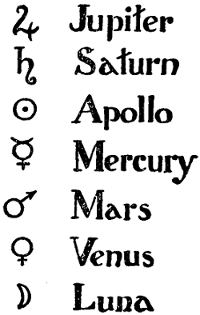
Fig. 1.—Names of the “mounts” and their signs.
Most hands index as many contradictions and complexities of disposition as the human face, and the experienced reader of these hieroglyphics finds that, to secure a just diagnosis of the subject’s character, comparison of the many signs and minute calculations are necessary. The art of addition, subtraction, and multiplication is the fundamental principle of his profession.
Shape, quality, proportion, and texture are of paramount importance, and these should be examined before the lines are studied. The size of the fingers, and the manner in which they are set on the hand, furnish the key to the character of the hand examined. Each finger has its name and sign, and each has its distinguishing characteristics. For just as every leaf and petal possesses some minute difference that distinguishes it from its neighbor, so no hands in the world are exactly alike in form and structure.
The name given to the first finger is Jupiter; to the second, Saturn; to the third, Apollo; to the fourth, Mercury; and to the thumb, Pollux. Fig. 1 shows some signs with their respective names.
The natural bend of the fingers is important, and the palmist should be quick to notice its natural attitude before examining the interior of the hand.
Some fingers are distinguished by their independent, prominent position over the rest. When the tips are inclined to curl to the palm, a[438] plodding, determined nature is indicated, one that does not easily relinquish a set aim or purpose because of obstacles.
A wide space between Jupiter and Saturn shows unconventionality, and originality of thought and outlook.
When the Jupiter finger is upright and straight, and of normal length, a just, candid nature is revealed. Should its position be in advance of the other fingers, the love of dominion. Falling slightly behind: dependency on others, a shirking of taking the initiative and responsibilities. Short: ingratitude, no enthusiasm. Pointed: tact, comprehension, and sympathy. (Fig. 2.) Square: integrity, unkindly frank in expressing opinions.
The generous and broad phalanges of Saturn show gravity, depth of character, and sense of proportion. A short Saturn: imprudence, inclination to act on impulse, somewhat foolhardy. Spatulate: energy. Square: cool, clear-headed, thought before action, absence of hasty judgments. (Fig. 3.)

Fig. 2.—The Jupiter pointed finger.

Fig. 3.—The Saturn square finger.

Fig. 4.—The Apollo spatulate finger.
Apollo: well-developed, artistic tendencies. Forward: painting, drawing, or sculpture. Pointed: the artistic ability is greater than the practical. Spatulate: a sense of the beautiful in form and color, dramatic powers. (Fig. 4.)
Mercury, set lower than the other fingers, reveals the fact that many adverse circumstances have been battled with. Pointed: tact, discrimination, intuition. Square: love of scientific pursuits, good reasoning powers.
Beneath each finger rest their respective mounts. There are two mounts of Mars—that immediately at the base of the Jupiter mount, and that situated beneath Mercury mount. The mount of Luna is directly opposite to that of Venus, which is found where the thumb joins the wrist. (Fig. 5.)
[439]
In many hands it will be observed that the position of the mounts varies. Jupiter may swell over the boundary line, and squeeze Saturn into close proximity with Apollo, which, in its turn, may take the place allotted to Mercury. These signs are important.
Jupiter’s approach to Saturn shows timidity and self-consciousness.
Saturn’s approach to Apollo shows that the creation of art and literature is tinged with melancholy.
Apollo’s approach to Mercury shows humanity, charity, and a peaceable disposition.
Mercury’s approach to Mars: self-reliance and resource in danger.
Mars’ approach to Mercury: originality, defiance, and ability to hold one’s own against opposition.
Luna inclining towards the wrist: reveries, some frivolity and love of pleasure.
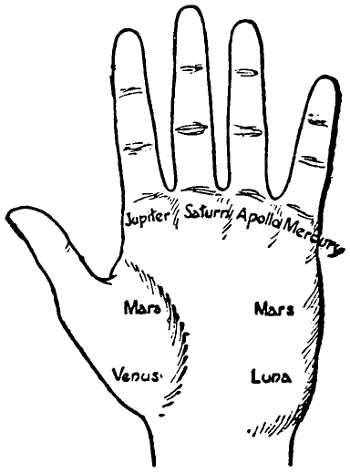
Fig. 5.—Showing the position of the various mounts.
A glance will reveal which bumps are most developed in the hand, and these, taken together, are valuable keys to character.
Jupiter and Mercury are worldly, versatile traits.
Jupiter and Apollo are honest, noble traits.
Jupiter and Venus are somewhat selfish, vain traits.
Saturn and Mercury are signs that, unless among gay companions, the individual has no power of resource.
These mounts are generally prominent in the hands of those who depend entirely upon others for their amusement, and have developed no powers by which to create a world of their own. They are shallow, discontented persons as a rule, unable to concentrate their minds on books or music.
Saturn and Mars: a thrifty temperament, verging on the avaricious.
Saturn and Luna: hypersensitiveness, distrust of self. A nature which is distressed, and rendered almost morbid by the sadder side of life, art, and literature.
Apollo and Luna: extreme imaginative force.
Apollo and Mars: in a creative hand show an inclination to depict the strong things of life, a certain amount of realism in portrayals. A love of danger and adventure.
Mercury and Mars: a superabundant amount of fun and good spirits.
[440]
Mercury and Venus: a gay, somewhat heartless, temperament.
Mercury and Luna make a humorist.
Venus and Apollo: a charitable, generous individual.
Each finger has three divisions, known as the phalanges, and these are supposed to represent three worlds.
The first, which includes the nail, stands for the spiritual.
The second stands for the intellectual.
The third stands for the material.
Correct comparison of these phalanges provides the orbit of thoughts and ambitions in which the mind of the individual revolves, and when one of these predominates in length over the others, that quality for which it stands is the principal quality possessed, although a further study of the hand may contradict these attributes, or render them more excessive.
For this reason the student is warned not to form his judgment by one indication only. He can arrive at no reliable solution to the riddle of character until he has studied every portion of the hand and linked together the various peculiarities it expresses.
The thumb is, as it were, the figurehead of the hand. There is more character to be discerned in its form, habitual attitude, phalanges, and the space between it and the first finger, than in any other signs conveyed by the physical formation of the rest. The first phalange indexes strength or weakness of will power, constancy or fickleness, affection or coldness of disposition. The second phalange shows by what degree of reason the will is guided. Should it be much thinner towards the base than at the apex, a certain degree of narrow-minded, one-sided views is indicated.
The third phalange represents emotions. The two angles stand for music, and are strongly marked upon the thumb of the musician and composer. The first indicates time, the second harmony.
When the length of the third phalange preponderates over the first and second, a passionate character, uncurbed by the power of will, discipline of reason, and self-control is shown.
In a well-balanced, warm-hearted nature, these phalanges are in proportion. Extreme length in the first phalange shows a tyrannical and dogmatic will, which will surely prove a stumbling-block through life, unless the thumb of the right hand modifies this natural obstinacy.
The palmist should beware of, as it were, labeling the hand. He cannot be too cautious in reaching an ultimate conclusion. The hand[441] possesses a range of complexities. Strength and weakness are mingled. Great talents may be mitigated by signs of almost equal inefficiency. Therefore all the links of circumstances and character depicted should be consolidated into a chain before the exponent ventures to voice his convictions.
The left hand indicates natural tendencies; the right shows how far the good and bad propensities of the individual have been developed. It is possible that the former may represent an intellectual type which the latter does not verify. For instance, a clear and unbroken head line in the left hand may be marred and broken in the right, thus showing that ability in this direction has been neglected; or it may be that an inefficient head line in the left palm continues clear and deep on the right; and the conclusion arrived at is, of course, that, by dogged will and perseverance, inherent incompetency has gradually been remedied.
Upon the palm six important lines are inscribed, as shown in Fig. 6:—
The life line, which forms a semicircle at the base of the thumb.
The head line, which traverses the palm, and forms an angle with the life line.
The heart line, which runs above and parallel with the head line.
The fate line, which runs horizontally from Mount Saturn to the wrist.
The Apollo or fortune line, which runs parallel with the fate line from Mount Apollo to Mount Luna.
The line of health, which forms an angle with the base of the life line, and reaches almost to Mount Mercury.
The ring of Saturn, reaching from Mount Apollo to Mount Jupiter.
The line of intuition, curving from Mount Mercury to Mount Luna.
Upon the depth, direction, and length of these lines the vitality, health, affections, future, finances, general tendencies of disposition and circumstances of the subject may be arrived at.
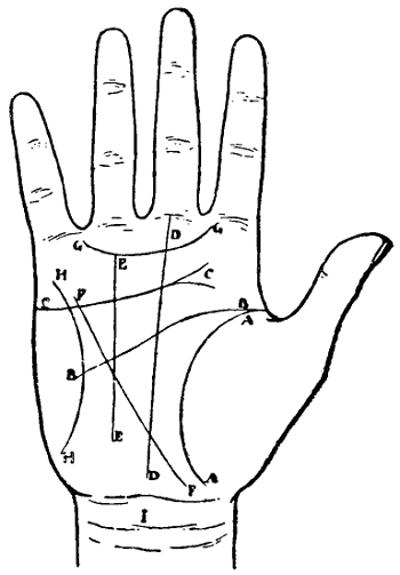
| A - A. | The Line of Life. | E - E. | The Line of Fortune. |
| B - B. | The Head Line. | F - F. | The Line of Health. |
| C - C. | The Heart Line. | G - G. | The Ring of Saturn. |
| D - D. | The Line of Fate. | H - H. | The Line of Intuition. |
| I. Bracelets. | |||
Fig. 6.—The principal lines of the palm.
The manifestation of stars and islands, dots, grilles, and chains are indications of misfortune, obstacles, ill-health, and domestic unhappiness. Triangles, squares, clear-cut crosses, when not formed on or by the lines of the hands, and circles on the mounts, are fortunate.
[442]
The age of the subject is arrived at in the following manner. Divide the fate line, call the point of division 30. The age of 10 is slightly above the base of Luna. From 10 to 50 the line should be partitioned into equal parts; after that, however, the distances lessen.
The life line may also be used to calculate age, but here the method of calculation is reversed, for childhood is above the thumb, and old age is indicated by the length of the curve to the wrist.
Doubtless the most interesting marks to be found among the minor lines of the hand, such as indicate voyages, change of environment, talents and ambitions, are those which concern the attachments, love affairs, and future marriage of the subject.
These are the influence lines, which may be discerned running from Mount Luna to the line of Fate, from Mount Venus to the line of Life, and on the Mount of Mercury. Their depth, length, and clearness depend upon the enduring nature of the sentiment involved. When crossed, barred, or cut, they demonstrate the fact that difficulties and opposition from parents, friends, or relatives are to be encountered, or it may be that the influence was merely a fleeting infatuation, what is commonly known as “calf-love,” which time and deeper development of the character have annihilated.
These signs should be compared with the age calculated upon the fate line—it will then be discovered whether the influence lines are of the past, present, or future; only constant practice and experience can aid the exponent to a correct estimate of the period of these happenings.
It may happen that the hand of a man or woman under thirty years of age shows no indication of any of these influences, but this does not mean that love and matrimony will never happen to them, for these lines are sometimes late in appearance and may be found years after.
An island situated on an influence line is extremely unfortunate, for it means either that marriage will be rendered impossible by the ill-health of the subject, or that the man to whom she is engaged is fickle or worthless in character. Likewise, it is unfortunate for Mercury’s influence lines to terminate on the heart line, for this foretells bereavement and widowhood. Should it cross the heart line and run towards Venus, a separation is almost certain to culminate the alliance.
Nearly all the lines traversing Mount Luna are attachments or influences connected with the opposite sex. When they rise from the life line, they may stand for close friends or relatives of the same sex.
[443]
Another important group of lines may be discerned at the base of the palm. The subject should rest the elbow on the table, with the hand bent over the wrist, which is marked with “rascettes” or bracelets. When these lines curve up towards the palm, they signify that the ideals, thoughts, and impulses governing the character are noble and uplifting; when they droop to the wrist, mercenary ambitions and self-interest are dominant. When the rascettes are creased by other lines, a life of strenuous work is shown. When deep, smooth, and continuous—health, wealth, and happiness.
In drawing-room palmistry, the palmist is often embarrassed and kept from concentration of thought by the buzzing chatter and laughter of friends and acquaintances, all of whom are eager to have their hands read, and the majority of whom expect that a lightning glance is sufficient to reveal every detail of their character and future.
Palms are thrust under his notice by smiling, optimistic young people, each of whom believes implicitly that for her or him the future is a land of honey and roses—a straight sunny path, wherein there are no piercing thorns and sole-bruising flints.
We all hold ourselves very dear; flaws in our natures, however serious and detrimental to character, seem trifles light as air. We appear to ourselves—especially when we are young—to be very good and guileless. We are assured that all follies will be conquered, repented of, left far behind us in the land of oblivion, long before old age catches us in the hip and thigh. And the palmist will often find that those who clamor most loudly for frank and impartial revelations are just those who are wounded by a single word that jars their self-esteem or questions the high price set upon their individual qualities.
For this reason he must go gently, speaking without flattery or undue censure, and upon such occasions he would do well to keep his mind from diving beneath the surface of the trivial pleasant prophecies expected of him. He should never wound the susceptibilities of some nervous, high-strung soul by prophesying ill-health, bereavement, or death.
The more serious side of the science can be dealt with only when the exponent and subject are secure from prying eyes and listening ears, and even then the palmist should be the very embodiment of tact, sympathy, and discretion.
Should the subject really desire the probings of some past secret misfortune, the palmist may voice his interpretation of the history written in his hand, but, in a manner of humane and tender kindness, making[444] much of the lighter side, and endeavoring to encourage and help by faith in a happier future.
To blurt out some past tragedy or foretell one before others is a wanton cruelty of which the palmist should never be guilty. He should always endeavor to put himself in the place of the subject, and even when the latter is, as often happens to be the case, incredulous of his powers and eager to show his ignorance, the palmist should not allow himself to be stung to retort by revealing a jealously-guarded secret.
The physician, the clergyman, the lawyer are the recipients of pathetic and strange confidences; the palmist will also discover many, and must ever hold them as inviolably.
He must be a gentleman in the highest sense of the word—honorable, chivalrous, humane; and, whenever the opportunity occurs, strong to encourage the weak and console and comfort the men and women, both young and old, whose hands reveal their heart-break, weariness, and sense of failure.
[445]
Phrenology is that science which may be said to provide a chart or map for the discovery of the treasures existing in the “estate under the hat.” It is of Greek origin (phren, the mind; and logos, science), and is closely allied to craniology (Gr.: kranion-logos, skull-science).
The difference between these terms is as follows:—Craniology is a mere acquaintance with the skull. Phrenology is a full and detailed knowledge of its contents.
This study is not founded on superstition, and the phrenologist is neither charlatan nor magician, for, just as a man’s mind may be revealed by the contour of his features, the twitching or tightening of his lips, a frowning or smoothing of the brows, so the physical formation of his skull reveals the propensities, talents, virtues, and weaknesses peculiar to his nature. The thin leather of a bulging purse indicates an amount of coin; a closer observation demonstrates of what this coin is composed—cents, dimes, or dollars—and in the same way the skin of the skull bulges, and close study and knowledge of the locality of its developments show the various qualities endowed.
The student must possess a chart (Fig. 1), and memorize it before he essays to indicate character by means of phrenology, for its kingdoms are as well defined as the counties on a map.
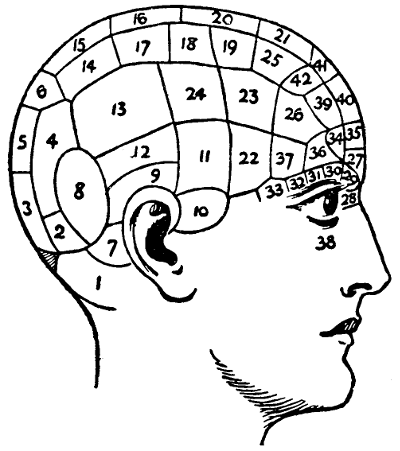
Fig. 1.—Phrenology chart.
There are forty-two faculties or organs in all—some more prominent than others, according to the disposition, temperament, education, profession, and personal inclination of the individual.
[446]
| 1. | Amativeness | 15. | Self-esteem | 29. | Size |
| 2. | Conjugal love | 16. | Firmness | 30. | Weight |
| 3. | Parental love | 17. | Conscientiousness | 31. | Color |
| 4. | Friendship | 18. | Hope | 32. | Order |
| 5. | Inhabitiveness | 19. | Spirituality | 33. | Calculation |
| 6. | Continuity | 20. | Veneration | 34. | Locality |
| 7. | Vitativeness | 21. | Benevolence | 35. | Eventuality |
| 8. | Combativeness | 22. | Constructiveness | 36. | Time |
| 9. | Destructiveness | 23. | Ideality | 37. | Tune |
| 10. | Alimentiveness | 24. | Sublimity | 38. | Language |
| 11. | Acquisitiveness | 25. | Imitation | 39. | Causality |
| 12. | Secretiveness | 26. | Mirth | 40. | Comparison |
| 13. | Cautiousness | 27. | Individuality | 41. | Human nature |
| 14. | Approbativeness | 28. | Form | 42. | Suavity |
These may be divided into six important classes:—
1. The social region, which includes—
A. Amativeness.—Normal—interest in and love for the opposite sex. Too prominent—material. Too small—coldness and indifference.
B. Conjugal affection.—Normal—constant and faithful love. Too prominent—jealous and selfish. Too small—fickle and inconstant fancy.
C. Parental love.—Normal—self-abnegating love for children. Too prominent—indiscreet monopolizing. Too small—absence of tenderness.
D. Friendship.—Normal—sociability, warm attachments. Too prominent—too exacting, infatuations. Too small—inability to make friends.
E. Inhabitiveness.—Normal—love of home and native land. Too prominent—intense dislike to travel. Too small—a desire for constant change of scenery.
F. Continuity.—Normal—the power of concentration. Too prominent—the prevalence of one idea, self-centered. Too small—lack of concentration.
2. The selfish propensities—
A. Vitativeness.—Normal—vitality, joy of living. Too prominent—extreme dread of illness and death. Too small—callous of calamity.
B. Combativeness.—Normal—courageous, antagonistic instincts. Too prominent—quarrelsome. Too small—want of mettle, cowardly.
C. Destructiveness.—Normal—hardness and durability. Too prominent—vindictive. Too small—lack of interest, inability to endure pain or misfortune.
D. Alimentiveness.—Normal—good and healthy appetite. Too prominent—gluttony, fastidiousness. Too small—want of appetite.
E. Acquisitiveness.—Normal—thrift and economy. Too prominent—avarice. Too small—extravagant, a spendthrift.
[447]
F. Secretiveness.—Normal—reserve, tact, discretion. Too prominent—deceit, intrigue, falsehood. Too small—indiscreet revelations, thoughtlessness.
G. Cautiousness.—Normal—apprehension, prudent care. Too prominent—timid, over-anxious. Too small—reckless, foolhardy.
3. Self-controlling faculties—
A. Approbativeness.—Normal—appreciation of public opinion, courtesy, manners, good breeding. Too prominent—ostentatious, “playing to the gallery,” undue love of adulation. Too small—ignoring of general opinions, unconventional.
B. Self-esteem.—Normal—individuality, personality, a proper sense of personal importance and ability. Too prominent—conceit, egoism, tyranny. Too small—sense of inability and incompetency.
C. Firmness.—Normal—will-power, assertion of self, determination, fortitude. Too prominent—overbearing, perverse, illogical. Too small—inability to concentrate or overcome.
4. Moral sentiments—
A. Conscientiousness.—Normal—high regard for honor and duty. Too prominent—morbid hypersensitiveness. Too small—want of principle.
B. Hope.—Normal—optimistic trust and buoyancy. Too prominent—foolish disregard of experience. Too small—an inclination to despair, sad and melancholy.
C. Spirituality.—Normal—trust, faith, religious, devout, reverential. Too prominent—fanaticism. Too small—cynicism.
D. Veneration.—Normal—chivalry towards the old, admiration for the great, modest, quiet demeanor. Too prominent—obsession. Too small—disrespectful, irreverent.
E. Benevolence.—Normal—philanthropic inclinations, humane, charitable, generous. Too prominent—imprudent giving, waste of sympathy. Too small—selfish blindness and indifference.
5. Intellectual faculties—
A. Individuality.—Normal—a desire for knowledge, respect and regard for the feelings of others. Too prominent—over-curious, spying. Too small—lack of humor.
B. Form.—Normal—ability to remember faces, shapes, and general appearance of buildings, &c. Too prominent—sensitiveness to want of beauty and contour. Too small—inability to observe shapes carefully.
C. Size.—Normal—the power of judging proportions at a glance. Too prominent—too much sense of comparison. Too small—incapable of judging length and breadth.
[448]
D. Weight.—Normal—mechanical and mathematical inclinations. Too prominent—great regard for the laws of balance and gravity. Too small—awkward movements, want of harmony.
E. Color.—Normal—the art of blending colors, delight in nature. Too prominent—hypersensitive of uncongenial environment; the clashing of colors is torture. Too small—a want of artistic sensibility, taste, and appreciation; perhaps color-blind.
F. Order.—Normal—ability to plan, to arrange, to discover the best method for doing business, &c. Too prominent—prim, fussy, fastidious, the mind obsessed by little things; extremely fretted by want of method in others. Too small—slovenly, chaotic, Bohemian; duties performed or left according to mood and inclination.
G. Calculation.—Normal—the power of mental arithmetic, the summing up of events. Too prominent—self-interest, any kind action done for the sake of some return, cold, distrustful. Too small—financial imprudence, inability to make accounts balance.
H. Locality.—Normal—swift sense of strange surroundings, an observation of streets and buildings. Too prominent—a passion for explorations. Too small—want of observation of new things.
I. Eventuality.—Normal—interest in present events. Too prominent—undue regard for trivial incidents. Too small—inability to remember recent events.
J. Time.—Normal—memory of periods and length of time, love of punctuality. Too prominent—inordinate importance attached to dates, &c. Too small—slackness in punctuality.
K. Tune.—Normal—sense of euphony in speech, harmony in music. Too prominent—passionate love of music. Too small—want of appreciation.
L. Language.—Normal—fluent and attractive speech. Too prominent—prosy, garrulous. Too small—inability to express thoughts clearly and concisely.
6. Reasoning faculties—
A. Causality.—Normal—power of fathoming and understanding what is read or heard. Too prominent—theoretical knowledge rather than practical. Too small—deficiency in arriving at independent conclusions.
B. Comparison.—Normal—acquiring of sound knowledge and discarding what is worthless; discriminating between what is true in art and literature and what is false. Too prominent—undue importance attached to words, carping criticism, invidious, harsh. Too small—credulous, easily imposed upon.
The student will at first find considerable difficulty in determining the exact position of the different faculties. It is only by close study of his chart, practice on human heads, and experience, that he will at length achieve unerring ability to distinguish, blend, and separate[449] the different characters, inclinations, intellects, and emotions with which the human mind is gifted.
In case the would-be phrenologist is not possessed of an amiable, bald-headed relation, he should endeavor to ingratiate himself in the favors of a hairless friend, for there is nothing so excellent for practice as a thatchless skull. Indeed, he is fortunate who has a large circle of bald-pated friends and acquaintances, for, even if he dare not attempt to find out their qualities by the sense of touch, he may achieve much by observation.
Women’s heads are the most difficult to examine, and never should the student exhibit his art on the well-coiffured damsel. There deception lies, for what seems to him an abnormal development of “bumps” will in all probability be artificial pads used by the fair one to discipline her tresses into fashion’s latest erection, to say nothing of hairpins and many other mysteries which the mind of a man, be he ever so learned in phrenology, can never hope to fathom.
The woman who is really curious to have her faculties read must consent to unpin her locks, so that the hand of the phrenologist may come in contact with her head; and he must possess a sensitive touch, which quickly discerns the different developments of the skull.
Students of phrenology will be astonished to find what a great deal of information may be gained by means of careful observation, when actual investigation is impossible. No opportunity should be lost of studying shape, poise, and balance of the human head. From the temples and brows of the man occupying the same seat on an omnibus a great deal is to be learnt, in spite of his headgear; the faculties 1, 2, 3, 5, 7, 9, 24, 25, 26, 27, 28, 29, 30, 32, 33, and 35 will probably protrude, and demonstrate what degree of love of form, size, individuality, eventuality, alimentiveness, destructiveness, vitativeness, conjugality, and amativeness exist in his nature.
Churches, concert rooms, and theaters abound with opportunities for the scrutiny of masculine heads, and upon each is engraved those abstract qualities furnished by the memorized chart.
The phrenologist should take pains to keep his hands and nails perfectly clean. He should bathe them between each experiment, as the natural grease of the hair soils them, and no one likes to have his skull touched by unclean fingers. It is essential for him to possess[450] and cultivate a buoyant disposition, which will tend to help and encourage him, and not to condemn a subject for the weaknesses of character he discovers.
Few ills have no cure. This is as true of mental inefficiency as of physical ailments, and the prophecies of the humane phrenologist are set in the major and not the minor key. Every individual, however seemingly worthless or uninteresting, possesses some divine gift, which perhaps lies dormant and neglected through his ignorance of its existence. Here it is that the phrenologist is able to let a chink of light penetrate the darkness, and a few kind, judicious words will do much to bring back the latent self-respect to him who has despaired of being released from the fetters of evil habits, intemperance, sloth, or indifference to the liberty of wholesome well-being.
The motto of the student should be never to condemn. When he has once reached the secret of identity, he should set himself to appeal and rouse the dying spirit of manhood to a new resurrection of power and achievement, for probably adverse and bitter circumstances, heredity, and poverty have done much to batter down the higher nature and develop the baser qualities of the man whose faculties he examines; and he can only dimly imagine, but never fathom, the strength of the temptations that warp the various molds in which the human mind is set.
In drawing-room exhibitions, only the lighter side of phrenology should be dealt with. A fund of humor and wit can be demonstrated here, so that instruction is blended with amusement, and it is not unfitting to use animals as illustrations of different qualities. For instance, the refrain in the once-popular lyric, “But the cat came back,” clearly testifies that this animal possessed the nodosity of inhabitiveness to a marked degree. Not so the man of music-hall fame whose pathetic pleading, “Please don’t take me home,” stirs our heartstrings most potently, or “Bill Bailey,” the wanderer. The small dog that ogles a larger comrade engaged with a bone, but who fears his mightier powers too greatly to venture open attack, possesses “cupboard” affection rather than amativeness.
The blinkered horse, were it granted speech, would doubtless demonstrate the fact that it has cultivated the faculty of spirituality in no small degree, for its sense of the unseen is remarkable.
The bull has only to kick up his heels and lower his horns at a red parasol to vindicate his apt discernment of color. The manner in which the watch-dog registers the shape of his enemy’s calves in his[451] memory is a truly astonishing sign of his sense of form and locality. The serpent’s feline smile at the bird is eloquent of its sociability and expectation; its glistening coils are the personification of blandness and invitation to embrace. Stay-at-home oysters are famous for domesticity. The fish swallowing the hooked worm illustrates a beautiful trust and faith in the providential plans man culminates for his welfare. In the hobbled ass, wandering over and over his patch of grass, economy, adhesiveness, and a very praiseworthy amount of application are shown.
It might be well for the ambitious phrenologist to study the skulls of these and other animals, birds, and fishes, for in these the unadulterated essences of virtues and vices and instinctive propensities are discovered. The human head may be likened to a very rich pudding composed of very different ingredients, flavorings, and strata of coloring, and sugared with conventionalities and hypocrisies. The animal, on the contrary, exhibits its true qualities as frankly as a sirloin of raw beef suspended in a butcher’s window.
[452]
There is no more amusing diversion for a frivolous half-hour’s entertainment than that of fortune-telling by cards. Young or old enjoy it, and with a ready tongue the combinations presented may be so varied that quite surprisingly good predictions can be made.
Surround the whole business with as much mystery as possible. Insist that all shuffling be done by the subject himself, and that cutting is always carried out with the left hand.
Learn the meanings of the cards by heart. This is not difficult, and by doing so one is enabled to tell a fortune quickly: always a more impressive proceeding than telling it card by card.
These are the generally accepted meanings of the cards:—
Ace of Clubs, wealth and prosperity. King of Clubs, upright, affectionate. Queen of Clubs, deeply in love. Knave of Clubs, generous and sincere. Ten of Clubs, a fortune from an unexpected quarter. Nine of Clubs, obstinacy; disputes with friends. Eight of Clubs, a love of money. Seven of Clubs, fortune and great happiness. Six of Clubs, a lucrative partnership. Five of Clubs, marriage with a wealthy person. Four of Clubs, inconstancy. Three of Clubs, a second or third marriage. Two of Clubs, opposition.
Ace of Spades, a love affair; if reversed, a death. King of Spades, an ambitious person. Queen of Spades, a treacherous friend. Knave of Spades, indolent, but well-meaning. Ten of Spades, an unlucky card. Nine of Spades, the worst card in the pack; sickness, or loss of fortune. Eight of Spades, opposition from friends. Seven of Spades, sorrow. Six of Spades, great fortune. Five of Spades, success; a happy marriage. Four of Spades, illness; small loss of money. Three of Spades, an unfortunate marriage. Two of Spades, a death.
[453]
Ace of Hearts, pleasure; if with Spades, quarreling; if with Diamonds, news of an absent friend; if with Clubs, merry-making. King of Hearts, nice, but hasty and passionate. Queen of Hearts, fair, affectionate. Knave of Hearts, the subject’s dearest friend. Ten of Hearts, the antidote of bad cards that lie near it, but confirming the good. Nine of Hearts, wealth; this is also the wish card. Eight of Hearts, feasting and merry-making. Seven of Hearts, fickle. Six of Hearts, generous, easily imposed upon. Five of Hearts, waverer, changeable. Four of Hearts, marriage late in life. Three of Hearts, imprudent; hot-headed action, which has disastrous consequences. Two of Hearts, extraordinary success and good fortune.
Ace of Diamonds, a letter; the card next to it will indicate its nature. King of Diamonds, hot tempered. Queen of Diamonds, a coquette. Knave of Diamonds, a selfish person. Ten of Diamonds, money. Nine of Diamonds, a roving person. Eight of Diamonds, marriage late in life. Seven of Diamonds, a gambler. Six of Diamonds, early marriage. Five of Diamonds, friendship. Four of Diamonds, unhappy marriage. Three of Diamonds, quarrels, lawsuits, and disagreements. Two of Diamonds, a serious love affair.
There are two effective ways of fortune-telling.
For the first, ask your subject to shuffle the cards very thoroughly and to wish all the time. Then cut them into three piles with the left hand. Should the wish card (the Nine of Hearts) be one of those cut, it is a lucky omen.
Notice two other cards and their possible bearing on the wish. Now, after lifting the cards and putting them together with the left hand, proceed to divide them into piles in this fashion.
The first pile is to yourself. The second, to the house. The third, to your wish. The fourth, what you do expect. The fifth, what you don’t expect. The sixth, sure to come true. The seventh foretells the happenings of to-night.
Arrange these piles, as you deal out the cards one by one, in a semicircle. Then proceed to read them off by their meanings.
Another and rather more complicated method is to ask the person whose fortune is being told which King he will be (if it is a woman, one would naturally ask which Queen).
After the wishing has been done as before, the fortune-teller lays out the cards in rows—seven in a row.
[454]
To read the fortune the teller must start from the King or Queen chosen, counting seven from him or her in every case.
The King or Queen of the same suit will always be the lover or sweetheart of the one whose fortune is being told, and the Knave being their thoughts, it is, of course, quite easy to discover their feelings.
It is rather a good plan to write the meanings of the cards on an old pack. By using this a few times a rapid flow of ideas will much more readily be induced. It might be mentioned that a too strict adherence to rule is by no means either necessary or desirable in fortune-telling. Tell what the combination of cards suggests to you—quite irrespective of the exact meaning of each—and you will be infinitely more amusing and obtain much greater fame as a wizard.

Fig. 1.—Cards dealt for fortune-telling: 1. to yourself; 2. to the house; 3. to your wish; 4. what you do expect; 5. what you don’t expect; 6. sure to come true; 7. to-night.
A few predictions are shown by the accompanying diagrams. Fig. 1 depicts the manner of dealing out the cards in sets of seven, and in what respect each is to be read.
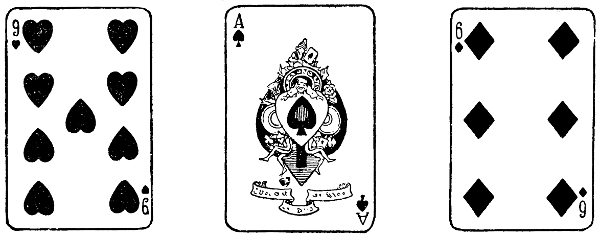
Fig. 2.—Cards foretelling a wish about a love affair—leading to an early marriage.
Fig. 2 shows three cards which might conceivably come together in any one set. They would be read as foretelling the following:—You will get a wish (Nine of Hearts), which is about a love affair (Ace of Spades), and it will lead to an early marriage (Six of Diamonds).
[455]
Fig. 3 conveys the following:—You will get a letter (Ace of Diamonds) about money (Ten of Diamonds). Your good fortune, however, will not permit you to marry until late in life (Eight of Diamonds). The five cards representing Fig. 4 tell that the subject’s dearest friend (Knave of Hearts) will make the acquaintance of a flirt (Queen of Diamonds), and will shortly after suffer illness or slight loss of money (Four of Spades), but afterwards he will fall in love with a fair affectionate woman (Queen of Hearts) and enjoy extraordinary success (Two of Hearts).

Fig. 3.—Foretelling the receipt of a letter about money, but the good fortune will not permit the recipient to marry until late in life.

Fig. 4.—Reveals that the subject’s dearest friend will make the acquaintance of a flirt, and will shortly suffer illness or slight loss of money, but afterwards will fall in love with a fair affectionate woman and enjoy extraordinary success.
Although forecasting of the future from dice is one of the most ancient methods of prediction, it is curiously enough almost unknown in modern days. For this reason it is of special value to the home entertainer, and will prove infinitely simpler than the cards, the meanings being easier to learn as well as fewer in number.
First chalk a magic circle on the table, then obtain a small cup or box to shake the dice in.
Three dice only should be used.
The person whose future is at stake must shake and cast the dice in the circle. This, as in card fortune-telling, should be done with the left hand.
Three tells you of an approaching accident; four, a rise in your position; five, that you will make the acquaintance of one who will be a friend; six, predicts loss; seven, a scandal; eight, a reproach—that[456] is not undeserved; nine, a wedding; ten, a christening; eleven, trouble for one you love; twelve, an important letter; thirteen, tears; fourteen, beware of an enemy; fifteen, good luck and happiness; sixteen, a journey; seventeen, a water journey; three sixes, or eighteen points, is a very good sign. It means great profit in business, or something the person wishes for very much.
A fairly unique accomplishment is to reveal the future by the aid of dominoes, and there is something sufficiently fascinating and mysterious about this mode of revelation to fill the uninitiated with awe at the powers of the exponent.
Each small oblong has its secret meaning by which some happening[457] vital to the subject is illustrated. It is a matter of little difficulty to commit these to memory; and in this, as in other methods of divination, the fundamental principle is that of comparison and calculation.
The dominoes used range from double-six to double-blank, and by these are symbolized the various vicissitudes of fate likely to befall mankind. The exponent places his paraphernalia upon the table, and, having turned them with their black spots facing the surface, proceeds to shuffle them. When this is done, the subject is requested to draw three pieces, one at a time. Between the choice of each the dominoes are shuffled.
The first supplies an impression; should it be drawn a second time, the impression becomes a conviction. The third, however, may lessen or wholly contradict its degree of importance, and this is where calculation and comparison in blending the signs are essential to a successful justification and interpretation of these symbols.
Double-six is an emblem of matrimonial happiness and financial prosperity.
Six-five is almost equally fortunate. Perseverance and concentration are rewarded by ultimate success.
Six-four implies a comfortable income, and secures happiness in marriage.
Six-three demonstrates that fate smiles upon the love and marriage of the subject.
Six-two.—Prudence, hard work, and a certain amount of good luck, or exposure and shame for any wrong-doing.
Six-one promises two marriages to the young subject, the first of which will not be as happy as the second. Should the subject be of middle age, this domino foretells the speedy arrival of good things and the fact that he or she will never be left lonely and uncared for.
Six-blank is, alas, a sign of great trouble—sickness, death, or heavy money losses.
Double-five presages that all achievements will be rewarded with a large amount of success, but inordinate wealth is not prophesied.
Five-four is almost as unfortunate a draw as six-blank. Should a young girl lift it, it means that her future husband will be poor and leave her a widow. Further, he may be of extravagant disposition, in spite of his poverty.
Five-three indicates a tranquil and contented existence. Sufficient money and matrimonial affection of moderate strength, the couple being incapable of passionate devotion.
Five-two conveys a warning that love and marriage are destined to an unhappy termination.
[458]
Five-one portends social popularity, but financial worries and losses.
Five-blank is supposed to demonstrate egotistical and avaricious characteristics, tendencies to swindling and intrigues, also a warning to remain unmarried.
Double-four.—The man who earns his livelihood by manual labor may regard this domino as a sign of future security and prosperity, but to him whose profession needs mental achievement it is rather disastrous. Troubles and disappointments await him.
Four-three.—Matrimony and moderate income.
Four-two proclaims an early marriage and moderate income.
Four-one.—Wealth or many friends.
Four-blank.—A sure warning that single life will be the best and happiest. It counsels that any secrets imparted to another will be indiscreetly revealed.
Double-three.—Enormous riches.
Three-two foretells prosperity in matrimony, travels, and speculations.
Three-one.—Some danger and unhappiness. The necessity for acting with extreme caution in all matters.
Three-blank.—Domestic unhappiness—such as a quarrel or incompatibility of temperament of husband and wife. The absence of harmony in the home.
Double-two promises average happiness and income.
Two-one.—Two marriages, if the individual be a woman; financial failures to a commercial man.
Two-blank.—The intrigues of unscrupulous persons will meet with temporary success. It also denotes poverty, and an indolent husband. The individual will return safely from all journeys undertaken.
Double-one.—An existence free from money worries; peace and constancy in love and marriage.
Double-blank seems to favor the deeds of unprincipled persons, and foretells want of integrity in lover and husband.
That a certain amount of character and future may be revealed by means of figures is a fact that may be tested for itself. The results achieved by this method of divination are truly astonishing, and an ample reward to the mathematician for his attempt to solve the riddle of human nature.
Certain groups of figures stand for different qualities. Those given in the table which follows are only a small portion of the whole, but[459] they are sufficient for the beginner. Each letter of the alphabet has its accompanying digit, and each digit has its abstract conditions, thus:—
| A. | 1. | Passion, ambition, design. |
| B. | 2. | Destruction, death. |
| C. | 3. | Religion, destiny, the soul. |
| D. | 4. | Solidity, sagacity, power. |
| E. | 5. | The stars, happiness, graces, marriage. |
| F. | 6. | Perfect labor. |
| G. | 7. | Course of life, repose, liberty, success. |
| H. | 8. | Justice, preservation. |
| I. | 9. | Imperfection, grief, pain, expectation. |
| J. | 600. | Perfection. |
| K. | 10. | Success, reason, future happiness. |
| L. | 20. | Austerity, sadness. |
| M. | 30. | Fame, a wedding. |
| N. | 40. | Fêtes, a wedding. |
| O. | 50. | Pardon, liberty. |
| P. | 60. | Widowhood. |
| Q. | 70. | Science, the graces. |
| R. | 80. | A cure. |
| S. | 90. | Blindness, error, affliction. |
| T. | 100. | Divine favor. |
| U. | 200. | Irresolution. |
| V. | 700. | Strength. |
| W. | (double V.), 1400. Perfection of strength. | |
| X. | 300. | Safety, belief, philosophy. |
| Y. | 400. | Long and wearisome journey. |
| Z. | 500. | Holiness. |
| 800. | Empire. | |
| 900. | War, combats, struggles. | |
The first thing the exponent asks is the name of the subject. He writes it on a slip of paper, and next to each letter its accompanying figure. Supposing the name to be Dick James Smith, it should appear thus:—
| D | 4 | J | 600 | S | 90 |
| I | 9 | A | 1 | M | 30 |
| C | 3 | M | 30 | I | 9 |
| K | 10 | E | 5 | T | 100 |
| S | 90 | H | 8 | ||
Now they are added separately thus:—
Dick 26James 726Smith 237
[460]
Add the three totals together:—
| Dick | 26 | |
| James | 726 | |
| Smith | 237 | |
| Which | makes | 989 |
900. War, combats, struggles.
80. A cure.
9. Imperfection, grief, pain, expectation.
The deduction being that Dick James Smith is endowed with a quarrelsome, headstrong nature, optimism, and inefficient will-power, which are destined to cause him great trouble, loss, and misery before they are conquered.
Should the total of the names reach beyond 1390, the first digit must be subtracted, as in the name:—
| Johannah | Christine | Whiting | |||
|---|---|---|---|---|---|
| J | 600 | C | 3 | W | 1,400 |
| O | 50 | H | 8 | H | 8 |
| H | 8 | R | 80 | I | 9 |
| A | 1 | I | 9 | T | 100 |
| N | 40 | S | 90 | I | 9 |
| N | 40 | T | 100 | N | 40 |
| A | 1 | I | 9 | G | 7 |
| H | 8 | N | 40 | ||
| E | 5 | ||||
| 748 | 344 | 1,573 | |||
Total 2,665. Take away the first figure, leaves 665.
600. Perfection.
60. Widowhood.
5. The stars, happiness, graces, marriage, showing that Johannah
Christine Whiting’s life will be a mixture of joy and sorrow, the latter
borne by a courageous and tranquil spirit. Her integrity and attractiveness
of character will, no doubt, bring her much love and many friends.
The fortune-teller who uses the cabalistic method of revealing Destiny’s secrets should be extremely careful to attach the correct figures to the letters contained in the names of the subject, otherwise it is quite obvious that his delineation will be at fault. He should add the numbers several times to make sure they are exact. If he has a good memory, he will memorize the table of qualities, and a great aid to this is to[461] practice with it before him, manufacturing names, or taking those of some well-known poet, author, statesman, or ecclesiastic.
His own name will doubtless reveal the fundamental truths of this method, and the cognomens of well-known personages will show him the distinguishing traits that have made them famous. For instance, take Florence Nightingale:—
| F | 6 | N | 40 |
| L | 20 | I | 9 |
| O | 50 | G | 7 |
| R | 80 | H | 8 |
| E | 5 | T | 100 |
| N | 40 | I | 9 |
| C | 3 | N | 40 |
| E | 5 | G | 7 |
| A | 1 | ||
| L | 20 | ||
| E | 5 | ||
| 209 | 246 | ||
| Florence | 209 |
| Nightingale | 246 |
| 455 |
400. Long and wearisome voyage.
50. Pardon and liberty.
5. The stars, happiness, graces.
Tarocs differ from the numeral cards used for bridge, whist, &c., in several ways. A pack consists of seventy-eight cards, made up of twenty-two emblematic pictures and fifty-six ordinary.
These latter are grouped into four suits of fourteen cards each:—four coat cards—king, queen, chevalier, and valet; and ten pip cards, numbering from 1 to 10.
The twenty-two emblematic cards are known as the Major Arcana, and are divided into three groups of seven, which equal twenty-one cards. The twenty-second stands for the highest point successful achievement may reach. The Major Arcana contains:—
| 1st Division. | ||||
| 1. | The Juggler | emblematic | of the | male inquirer. |
| 2. | The High Priestess | „ | „ | woman inquirer. |
| 3. | The Empress | „ | „ | action, initiative. |
| 4. | The Emperor | „ | „ | will. |
| 5. | The Pope | „ | „ | inspiration. |
| 6. | Lovers | „ | „ | love. |
| 7. | The Chariot | „ | „ | triumph, providential protection. |
| 2nd Division.[462] | ||||
| 1. | Justice | emblematic | of | justice. |
| 2. | The Hermit | „ | „ | prudence. |
| 3. | The Wheel of Fortune | „ | „ | destiny. |
| 4. | Strength | „ | „ | fortitude, courage. |
| 5. | The Hanged Man | „ | „ | trial and sacrifice. |
| 6. | Death | „ | „ | bereavement. |
| 7. | Temperance | „ | „ | temperance. |
| 3rd Division. | ||||
| 1. | The Devil | emblematic | of | immense force or illness. |
| 2. | The Struck Tower | „ | „ | ruin and deception. |
| 3. | The Stars | „ | „ | hope. |
| 4. | The Moon | „ | „ | hidden dangers, enemies. |
| 5. | The Sun | „ | „ | material happiness, marriage. |
| 6. | Judgment | „ | „ | change of circumstances. |
| 7. | The Foolish Man | „ | „ | inconsiderate actions. |
The remaining card, No. 22, which belongs to this division, is
The Universe, emblematic of success.
The Minor Arcana, divided into two groups of four, corresponding to the suits of ordinary playing cards:—
| Scepters | relate to | diamonds, | interpreted | as | enterprise. |
| Cups | „ | hearts, | „ | „ | love. |
| Swords | „ | spades, | „ | „ | misfortune. |
| Pentacles | „ | clubs, | „ | „ | interest. |
The four coat cards stand for different conditions of existence:—
| King, | emblematic | of | man. | Divine world (spirituality). |
| Queen, | „ | „ | woman. | Human world (vitality). |
| Chevalier, | „ | „ | youth. | Material world (materiality). |
| Valet, | „ | „ | childhood. | Transition stage (life in growth). |
The remaining cards of these suits (1 to 10) are important according to their relation to the coat cards and their numerical value. These are divided into four groups:—
[463]
(1) 1, 2, 3 of each suit appertain to man—abstract qualities, creation, and enterprise.
(2) 4, 5, 6 of each suit represent woman—opposition, reflection, and negation.
(3) 7, 8, 9 of each suit represent youth and materialism.
(4) The four tens of each suit represent the stage of transition.
In order to tell fortunes by means of tarocs, the manipulator must be perfectly conversant with the design, class, and interpretation of each card.
The complete pack is used. Shuffle and cut into three parts, each composed of twenty-six cards, thus:—
26 26 26
Take the central pack, and place on the right.
The inquirer shuffles the two remaining packs, which equal fifty-two. These are dealt out in a similar fashion—three groups of seventeen cards, thus:—
17 17 17
Again remove central pack to the right.
Deal out the remaining packs, which equal thirty-four, in three groups of eleven, thus:—
11 11 11
It will be seen that seventy-eight cards divide equally in the first deal.
In the second deal, however, only fifty-one cards are used, so that there is one over. This card is shuffled with the third deal.
Two cards are now over, and these are placed as discards, until the central pack of the last deal of eleven is put on the right, when they are shuffled with the remaining twenty-two discards. The cards will now be as follows:—
26 17 11
[464]
Discards = twenty-four, making in all seventy-eight. They are next placed beneath each other in sequence, thus:—
| A. | 26, | emblematic | of the | supernatural, spiritual. |
| B. | 17, | „ | „ | thoughts and calling of the individual. |
| C. | 11, | „ | „ | physical and material. |
The tarocs of pack A, B, and C are now lifted separately, and placed on the table from left to right in rows. Each taroc has its meaning, and from its relation to its fellows the manipulator is able to present a brief sketch of character, inclination, and futurity.
Another simple method is to shuffle all the cards and request the inquirer to cut. The manipulator then proceeds to draw the first seventeen tarocs, uncovering only the eighteenth and last card of the pack. These two cards create what degree of sympathy is shared between himself and his client, the keynote being given by the symbolic meaning attached to the card. The seventeen cards are now revealed from left to right, their interpretation being given separately. In order to reach a proper signification, they are then compared as follows:—
The first with the seventeenth.
The second with the sixteenth.
The third with the fifteenth,
and so on, each process increasing or taking from the first manifestation.
[465]
More or less consciously, every one is a reader of handwriting! If we have not devoted thought and study to the subject, we merely gather a vaguely favorable, or unfavorable, impression from the first letter written to us by a new acquaintance, and store it up with the other impressions we have already gleaned from their personality.
When, however, time and thought are given to the fascinating cult of Graphology, it will be found to reward its students, by letting a thousand little sidelights on to character—and if the most “proper study of mankind is man,” then assuredly is Graphology a most helpful adjunct to that end.
One must crawl before one can walk, and learn the alphabet before one can master a language, therefore an impulsive learner must not grow disgusted because his laborious reading of a handwriting is disjointed, and may be obviously unlike the writer. By the time he can read a character from a letter, without gathering a word of that letter’s sense—which is what every graphologist worthy the name can, and does do—he will have come to see how one sign outweighs or counterbalances another, and so learn to read a human character from a sheet of paper and the more or less erratic tracings of a pen.
As a home entertainment, any amount of fun is to be got out of it. One unfailing source of amusement is to notice how all are willing vaguely to accept the ownership of every failing save the one you ascribe to them.
The jealous girl is “perfectly horrid,” she knows. But she certainly “isn’t jealous.” The lazy man is “bad tempered, perhaps,” but “no one could call him indolent.”
Friends and relations will, however, be ready to assure you of the correctness of your delineation.
The first thing to notice when studying character from handwriting, is the direction of a hand. Is it even, upward, or tending to[466] meander down the page? The even hand suggests honesty, conscientiousness, and a calm, well-balanced nature. The upward hand tells of will power and ambition, cheerfulness and energy. The hand that slopes downward tells of a timid and weak nature, depression and melancholy. It must always be remembered, however, that temporary ill-health, and even a temporary wave of depression, will frequently alter the direction of a hand.
Sometimes a beginner is puzzled by the varying direction—now upward, now downward—of a hand; generally this betokens a mind struggling at the time with adverse circumstances or ill-health.
Capital letters and terminals are both important. The more clearly formed and beautiful the letter, the more refined and artistic the nature.
The graphologist picks out certain letters as being especially important—M, A, L, and D in the capital letters. The small d and e in terminal letters are certainly the most important.
Taken in alphabetical order, the following are the principal letters to study:—
A. Well made, and simple in outline, indicates refinement, gentleness, intelligence, perhaps poetic feelings. Flourishes are always bad, and tell of pretension and egotism. If a small a is unjoined—open-mouthed as it were—the subject is something of a gossip. This also applies to the small o.
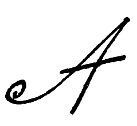
Artistic—refined—loves poetry.
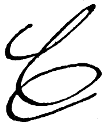
Selfish and egotistical.
B. This is a letter that frequently tells of ostentation and kindred failings. If the small b is well looped, look for an affectionate nature.
C. A well-rounded C shows a kindly, perhaps indolent nature. A curly tail suggests selfishness and egotism.
D. The small d is very truth-telling. A small d united to the letter following shows a good sequence of ideas. Too much flourish tells of an ill-balanced imagination.
[467]
E. The capital letter shows egotism, even as the letter C does, in the curled back tail. A long tail to the small e tells of imagination, good-nature, ardor; if exaggerated, carelessness.
M is the next really important letter—in some respects the most important. The first high loop means ambition, pride, discontent. A big flourish to the termination shows egotism; a moderate one force of character.
T, or rather the particular method of crossing the T, is always of immense interest to the graphologist. Energy, strength of will, temper, perseverance, obstinacy, may all be shown or found to be lacking. The thickly crossed T indicates energy; the little hook back at the end, perseverance; a thick abrupt ending, temper. Impulsive people cross their T’s high. Those who make long bars are energetic and quick in thinking.
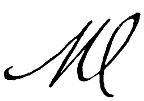
Egotist.
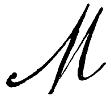
Force of character.

Quick-tempered, willful and persevering.
Wide spacing between lines suggests extravagant tastes; accompanied by rounded terminals to the letters, good-nature and generosity.
Short tails and a tendency to make as much as possible out of a sheet of paper, show the opposite characteristic.
It cannot be too emphatically impressed on the beginner, that it is fatal to judge from one sign alone. Study them all ere you commit yourself to an opinion; above all, study the signature.
A specimen for delineation should always consist of about six lines, not of copied matter. It must be written on unlined paper, and have the writer’s usual signature attached.
Never attempt to gather anything from an envelope, as one is so often asked to do. Like copied matter, or indeed anything written specially to order, it is hopelessly misleading.
Flourishes always show a certain vulgarity of mind. A small and graceful one after the signature—particularly in the case of a woman—is, however, quite pardonable, and is indicative merely of love of praise and appreciation. Thick and heavy marks of punctuation are[468] one of the signs of a passionate nature. Caution and careful attention to detail are shown by stops between initials and after the signature, the careful crossing of T’s and dotting of I’s. Frank, impulsive natures seldom, if ever, close their A’s and O’s.
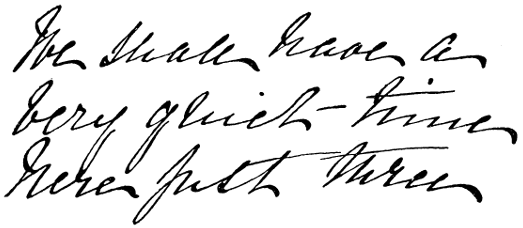
Benevolent—kind-hearted, very refined, a poor one at keeping a secret, devoted to those she loves.
Tender-hearted people invariably slope their writing, and make long tails and loops. The critic divides his letters. The orator and writer invariably join theirs, and carry them on from word to word, even as the sequence of their thoughts follows on.
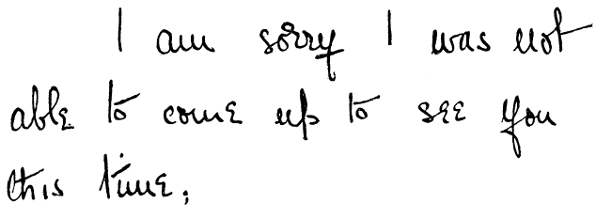
Suggests an affectionate nature—one who would be greatly influenced by his friends! Critical—rather impulsive; a good worker at things he likes. Loves beauty and can keep his own counsel.
As a general rule, the more charmingly clear the handwriting, the more straightforward and cultivated the person. Eccentricity, however, naturally mars many of the cleverest hands.
It will perhaps simplify matters for the student, if a list is compiled[469] of the principal human virtues and failings, and the means of discovering them by the handwriting, described:—
Ambition.—This is shown in the upward tendency of the hand. Should will power be lacking, expect discontent.
Business.—A businesslike person is always to be recognized by the care of such details as stops, spacing, crossing of T’s, the general air of law and order in the hand. Look for perseverance and will power to insure success.
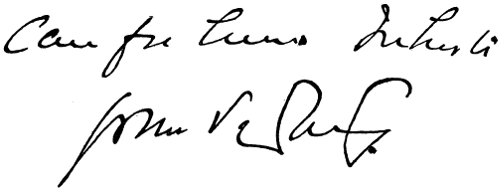
Diplomatic, lacking in will power, possessing extravagant tastes, greatly influenced by the opposite sex.
Brutality.—Thick, heavy, ungraceful handwriting, impulsive and lacking in intelligence.
Candor.—Clear, well-spaced lines and open rounded letters. Well and firmly crossed T’s.
Caution.—See Business.
Coldness.—Upright hand, closed up letters, no graceful “loop.”
Criticism.—This is often found allied to a good sequence of ideas. The separated letters of criticism and the carried on T crosses, &c., betray the quick thinker.
Deceit.—This is always indicated by the screwed-up, badly-formed letters, that run into one another; lines uneven, and words that trail off into a mere scrawl.
Determination is shown by the firmly crossed T, and the general firmness of the whole handwriting.
Eccentricity.—Always betrays itself in a weird signature. Economy, short tails; careful hand, short terminals.
Egotism.—Look for a flourish—for the curl back in capital C’s and E’s; for the curled back small d.
Extravagance.—Wide margins and spacing, a rounded, rather flourishing hand; few stops; generally somewhat thick. Compare other signs.
[470]
Fun.—The love of fun is usually indicated by quaintly-rounded terminals and oddly shaped, and often rather illegible capitals.
Generosity.—Curled up terminals, bounded hand, M’s and N’s written like U’s.
Honor.—Even handwriting; might almost have been written over lines. See Candor; and for honesty also.
Imagination.—Good capitals; small d’s joined to following letter bear a hurried look; flying crosses to T’s.
Indolence.—Bounded hand; short terminals.
Intelligence.—Shown by the small attractive hand; clear and firm good capitals.
Jealousy.—A weak hand; sloping, long-looped, flyaway T’s; egotistic C’s.
Loyalty.—Of course you cannot expect to find much character in handwriting until the age of seventeen or so, but the lad who is loyal to his friends and his sense of duty—the typical Boy Scout’s hand, for example—will ever be found firm and boldly ascending the sheet.
Melancholy.—Downward tendency, not only to lines but even words.
Music.—Look for imagination, tenderness, and refinement.
Neatness.—Easily to be seen.
Obstinacy.—Heavy; crushed down as it were on an imaginary line; thick.
Originality.—Imagination marked; unique capitals and flourishes.
Pride.—The exaggerated first loop to the M.

Possesses good sequence of ideas; clever, vivacious, good-natured and devoted.
Perseverance.—Clear running hand; well crossed T’s, with little hook to end their crossing.
Selfishness.—Upright hand, generally heavy.
Sensitiveness.—A very sloped, rather weak, and long-looped hand.
Temper.—Thickly crossed, flying T’s; uneven and rather angular handwriting.
Truth.—See Candor.
[471]
Vanity.—Look for flourish beneath signature.
Will Power.—Straight thick little bar under signature; thickly crossed T’s; purposeful-looking hand; no return to tails of G’s and Y’s.
In conclusion, one might truthfully say that the more closely one studies the handwriting of one’s friends, the more converted must one become to the belief in Graphology. Go slowly. Compare carefully. Remember always that human beings inevitably suffer from the faults of their qualities, therefore search and you will be rewarded by the enthusiasm of those to whom you give your delineations.

Very intelligent, quick-tempered, imaginative, impulsive, very refined, generous, yet knows the value of money.
[472]
It is undoubtedly one of the hardest tasks imaginable to give a successful children’s party, and the reasons that militate against success are legion.
In the first place children are the keenest of critics; secondly, that which interests a mite of three will bring boredom unmitigated to the “fellow of ten,” while the maiden of twelve and the “man” of fifteen have very strong views of their own on the subject of amusements.
A children’s party, then, is not an undertaking to be approached lightly. It is of course an easy matter to hire the services of a ventriloquist or a conjurer or some public entertainer for the afternoon, and leave the rest to luck, yet how many hostesses have come to grief on the rocks of such an enterprise.
And let it be remembered that it is an absolute impossibility to provide an entertainment that will appeal equally to children ranging from three to fifteen. Only a section will appreciate the show. Far better to let the youngsters be their own entertainers.
It may of course be presumed that no one will dream of giving a children’s party who is the occupant of a very small house. Twenty children want more room than fifty adults. This is a truism that cannot be too strongly emphasized.
Having fixed upon the date for your party and having sent out the invitations, you will, wise general that you are, take complete stock of your field of campaign, and make up your mind that at least four rooms will have to be more or less gutted to receive the host of youthful invaders you are about to summon forth.
Let it be supposed that you have in your house three sitting-rooms. The dining-room will be the refreshment room, the parlor, stripped of all breakables and needless accessories, for the older children to play in, the morning room to be converted into a dressing-room. Upstairs it will be as well to transform a bedroom into a play-room for the tiny tots and their nurses.
[473]
There is one fatal mistake that hostesses are sometimes guilty of in giving a children’s party,—they ask their guests to come too early and send them away too late. The secret of success with children lies in the one hackneyed sentence: “Enough is as good as a feast.” Children are easily tired, and they can crowd into three hours as much healthy enjoyment as would certainly not be the case were another hour to be given them. If your young guests leave you with regret you do not want any more thanks; if they fly to get their coats and hats, all your labors, no matter how sincere and arduous they may have been, will have been spent in vain.
From four till seven P.M. will be found quite long enough, with tea at half-past four. Here again lies another fatal pitfall. Avoid kickshaws!—digestion-ruining cream cakes and jam puffs particularly. Bread and butter, chocolate biscuits, plain cakes, and sponge cakes produce no ill effects. Such advice as this may provoke a scornful laugh from the would-be hostess who reads these lines. “Teach me how to feed children!” I hear her say. “What presumption!” Yet it is homely advice that is the most useful, the most disregarded when all is said and done.
Half-past four will be found a good time for tea. Soon after five the healthiest hunger will have been appeased, and then, having “let digestion wait on appetite,” marshal your guests into the drawing-room and allow them to “fall to” to amuse themselves.
Let the revels be of the simplest. If there is one game children love more than another it is Musical Chairs, and as there cannot be a person living, who does not know that historic pastime, there will be no need to describe it in detail.
However, among your young guests you will be sure to find one or two boys who do not care to play the game, yet who can be made exceedingly useful in another way as “umpires.” Most boys of fourteen or fifteen have a great sense of honor when games are under consideration; let two boys, then, be the arbiters of the sport—let them decide whether, when the music stopped, Tommy found a seat before Johnny, or whether Billy was too rough when he pushed Mary aside and took the seat that should have been hers. You will have no need to grumble at the impartiality or the reverse of the young umpires.
After Musical Chairs, what better than Blind Man’s Buff, a game that never stales, made more exciting if “Buff,” after having caught a victim, fails to identify his prey, and must therefore pay a forfeit to be chosen by his captive? Children love forfeits.
[474]
Hissing and Clapping, Dumb Crambo, Acting Proverbs—there is no end to the games that children love. And let them choose their own. You will add a thousandfold to the success of your party if you allow your guests to please themselves, and by so doing you will give yourself far more pleasure than would be the case if you “fussed about” arranging, directing, ordering. Children love responsibility as much as “grown-ups.”
Above all, remember that “Boys will be boys.” It is only with the greatest tact that you will be able to eliminate the boisterous element, which will crop up now and again in the best regulated parties. If you can enlist in your services some jolly bachelor who loves children, and who can romp with them as a child, you will have solved the problem of keeping down the rowdy element. A man of this stamp can work wonders with an obstreperous youngster, can smooth out the creases in your handiwork, can keep things at concert pitch, and if at the end of the party he is a worn-out and exhausted wreck—being who he is, he won’t mind.
So seven o’clock comes. The time for farewells has arrived. Wraps and coats must be put on, and the little ones, flushed, excited, happy, are dispatched to their various homes.
“Thank you so much, it has been fun.” “We’ve had a ripping time, thank you.” “It’s been splendid.” Such thanks as these will repay you for three hours of babel and pandemonium, for all the forethought and tact you have brought to bear on a by no means too easy task.
[475]
At Christmas parties, at which guests of all ages are found, it is sometimes a perplexing riddle to the hostess to know how to entertain them all. Musical items which may delight the older members of the company may only serve to render younger folk restless and dull, and dancing is not always possible in rooms of limited size. Moreover, there are still many young folk who are unable to set their feet nimbly to waltz and two-step, and would much prefer a romp to whirling round in time to a measure.
Self-consciousness and shyness are usually very evident when the party enters the drawing-room, and this coating of ice, if not thawed quickly, will rapidly freeze into impenetrable restraint and gloom. At such times a good game, quickly organized, is invaluable. The rules should be explained by the hostess in so simple a manner that the youngest person present can follow them, and everything necessary should be arranged beforehand to avoid awkward delays and pauses.
The players are formed into two lines a few feet apart; at the top and bottom of the lines are two tables upon which as many pins as there are players are placed, and exactly divided into two heaps. The hands of all are crossed at the wrists. The first players of each line use the second player’s right hand to pick up a pin. The latter in the same way passes it to the next player, and in this manner it goes through the lines to the table at the end, upon which the last players place it. Meanwhile, of course, the first players are sending other pins down the rows.
The line that succeeds in removing all the pins in the heap from one table to the other in the shortest time wins the game. The fun lies in the awkward manipulation of one’s neighbor’s hand. Should a pin be dropped in the process, it must be picked up by the umpire and[476] returned to the top table, and throughout the game the wrists must be kept crossed.
One of the party retires while the rest decide upon a well-known proverb. When he returns, he stands in the center of a semicircle. Some one taps three times with a stick, and at the third tap each player shouts one word of the proverb loudly and simultaneously. This is repeated three times, and it is amazing how difficult it is to distinguish even the most well-known proverb in the uproar.
Should one word give the key to the player not in the secret, the individual who speaks it takes his place. For instance, in the proverb, “All is not gold that glitters,” it may happen that the word “glitters” provides the keynote. Therefore, he or she who speaks it takes the place of the one who guesses.
The proverb must contain as many words as there are players, and each shouts only the one word allotted to him.
A white sheet is stretched against the wall, with a lamp immediately before it. All other lights are extinguished. One of the company sits on a chair or stool with eyes fixed on the sheet. Behind him the company files noiselessly, the while he endeavors to identify them by means of the shadows silhouetted on the screen.
Simple disguises are allowable and increase the fun. For example, a boy may don a girl’s hat, a girl a boy’s; or a skirt or shawl may be draped over a boy’s suit, thus concealing the wearer’s identity. The one whose shadow betrays her takes the place of the player who identifies her.
Two rows, headed by a chosen captain, face each other. In turn they fire at each other the names of vegetable, flowers, or fruit, beginning with the letter A, and using in turn the other letters of the alphabet—asparagus, artichokes, apples, &c.
The players on each side set their wits to work to aid their captain when he shows signs of faltering. They are not allowed to speak aloud, their promptings being given in whispers, and this is where the fun comes in, for, when one is excited and eager to give a word, it is very difficult to remember to whisper, especially when placed at the tail of the line.
When a gardener and his side pause to remember a word the[477] opposite side counts twenty slowly; if at the end of that time their opponents still fail they forfeit a man. The game goes on until one captain has secured all his adversaries’ followers. Should any one except the leaders speak aloud, he or she is obliged to cross to the other party.
When a captain surrenders he is obliged to go to the end of the line, and the next man takes his place and responsibilities. Wild flowers or plants are not allowed.
Each player adopts some trade or profession. One member reads out the social gossip from a daily paper. When he pauses and points at one of the rest, that one must reply quickly some sentence regarding his calling or the stock he sells, for instance—
Reader.—The ball that took place at the residence of the Hon. Mrs. Mortimer last evening was distinguished by the presence of the President.
A number of débutantes were present, the majority of whom were dressed in—Here the reader glances at the carpenter, who answers, “Shavings.”
Reader—“Their headgear consisted of (glances at the fruiterer)—
Fruiterer—“Pine-apples.”
Reader—“Their jewels were necklaces (glances at the ironmonger)—
Ironmonger—“Of nails.”
Reader—“The dancing took place in—
Tobacconist—“A cigar box.”
Reader—“The walls of which were richly decorated with—
Lawyer—“Red tape.”
Reader—“The band was composed of forty instruments all—
Doctor—“Medicine bottles.”
Reader—“The President’s first partner was—
Fishmonger—“A codfish.”
Reader—“Who was most becomingly clad in—
Druggist—“Silver scales.”
Reader—“Her bouquet was composed of—
Dry Goods Merchant—“Spools of cotton.”
Reader—“And her tiny feet were cased in—
Mason—“Bricks.”
Reader—“Her dancing was as light as—
Plumber—“A gas escape.”
Reader—“And her charming smiles showed to view a perfect set of—
[478]
Bootmaker—“Black heels.”
It can be imagined from this example the merriment and laughter similar answers evoke.
The party is divided into two rows, through which walks the lawyer. He asks a number of questions, and the answers may contain any words except “yes,” “no,” “white,” “black.”
The person to whom he puts his query does not reply, but the one immediately opposite does.
The lawyer exchanges places with the one who makes the first mistake.
Lawyer (pointing to Mary)—“Your hair is very long; is it your own?”
Tom opposite bawls “false.”
To Jessie—“Do these pretty boots pinch your feet?”
Jack—“Of course, they are two sizes too small.”
To John—“Did you use your razor this morning?”
Jane—“He hasn’t any hair to cut.”
To Timothy—“Is your nurse waiting to put you to bed?”
Elsie—“Naturally—he goes to bed at seven.”
To Dick—“What would you like on your next birthday?”
Ethel—“A rattle.”
To James—“What is your favorite pastime?”
Alice—“Putting dolly to bed.”
To Freda—“What is the color of your face?”
Andrew (afraid to say “white” for fear of forfeit)—“Green.”
Any number of players can take part in this game. They kneel in a circle on the floor with fingers stretched out before them and thumbs tucked in.
The game is started by the leader’s query to her neighbor: “Can you play cabbages?”
As the latter has not been initiated into the mysteries of the game, she at once replies—
“No.”
The question is asked by each player, and is always answered in the negative until the circle is completed, when the leader again queries:
[479]
“Can you play cabbages?”
Neighbor—“No.”
Leader (suddenly)—“Then why on earth are we sitting here?”
The blank expressions which result in this query are ludicrous in the extreme, and are followed by bursts of merriment.
All the members of the party save one are massed together at the end of the room. The leader walks close to them, and throws a light rubber ball towards any person she likes.
The person must be prepared to catch the ball. As the leader throws it, she accompanies the action with these words, “My lover comes thus”—the ball is tossed in a way to illustrate the manner of the supposed lover. The thrower terminates her sentence by a letter of the alphabet. The one to whom the ball is thrown has to provide an adjective beginning with the given letter as she catches the ball—thus:
Leader—“My lover comes g”—(throws ball).
Catcher—“Gayly”—(tosses ball back).
Leader—“My lover comes h.”
Catcher—“Hopping.”
Leader—“My lover comes o.”
Catcher—“One-eyed.”
Leader—“My lover comes s.”
Catcher—“Smirking.”
Excitement is caused by the difficulty in producing a word at a moment’s notice, and being ready to catch the ball at the same time.
Each player is provided with paper and pencil, upon which any twelve letters are written, with sufficient space left between for words.
The leader gives a topic, such as a wedding, accident, invitation, &c. A watch is placed on the table, and from ten to fifteen minutes given, during which each player concocts a telegram from the letters supplied by his left-hand neighbor.
At a signal, the telegrams are thrust under a hat, and read out in turn by the leader.
Example 1.—Topic: a sensational robbery.
| S. | B. | O. | B. |
| H. | M. | J. | P. |
| K. | I. | P. | H. |
[480]
From these letters may be devised the following telegram:— “Serious burglary; one box hairpins missing. Jane prostrate; kindly inform police—Henry.”
Example 2.—Topic: a catastrophe.
| C. | A. | S. | D. |
| P. | B. | C. | A. |
| B. | Q. | D. | W. |
“Cat ate Sunday dinner. Please bring cheese and bread; quite distracted—Wifie.”
The funnier the telegram, the greater the laughter when it is read out.
The players divide into two lines. A piece of tape is stretched across the room, and before every two players a feather is placed. Each player possesses a Japanese fan, and the object is to lift the feather and waft it on to a stretch of newspaper, which marks the opponents’ den.
The dens are guarded by goal-keepers, also armed with fans, and their business is a lively one.
Feathers must not be blown, or pushed with the hand, as happens sometimes when the excitement of the game makes one forgetful of all else but the threatening direction the feather is taking. Only the fan is to be used.
The feathers should be of different colors. When one of a side succeeds in driving a feather into the opposite den, he and his adversary retire from the game, but naturally they share the prevailing excitement and watch every movement of their respective sides, cheering and encouraging them to win.
When the feathers belonging to one side are all captured in a den, the other side is conqueror.
One of the company is chosen as director, and addresses the company in some such way as this:—
“Ladies and Gentlemen,—It having been discovered by the director of the Panama Canal Company that the water of the canal is often disturbed to a dangerous degree by means of the passionate sighs and turbulent emotions of the passengers cruising upon it, they have decided[481] that a penitentiary tax shall be levied upon all ships containing lovers, and that, for every kiss given, toll shall be exacted.”
The company now pass slowly before the director, who asks each questions as to the name, destination, cargo, number and description of passengers, and any other questions relating to vessels which may occur to him.
No answer must contain the letter K, for this being the initial letter of “kiss” is forbidden, and the person who uses it is obliged to pay any forfeit demanded by the captain.
A few questions and answers might run like this:—
Captain to passing figure—
“What have you in your ship?”
“Tomatoes.”
“Where do you hail from?”
“Liverpool.”
“To which port are you sailing?”
“Boston.”
“Have you any girls on board,” &c. &c.
Of course, the captain’s aim is to force “the ships” to introduce the letter K in their answers.
This is a good competitive game. Men and boys should stand with their feet on a chalked line. Each must stoop down to a half-sitting position, and with the left hand resting on the knee and the right hand inserted beneath the right leg, draw a line as long as possible without rising or using the left hand.
Station a person in each corner of the apartment. Then blindfold one of the party, and lead him to the center.
The master of the ceremonies points to each of the four in succession, and each says in a clear separate tone the word “Come.”
When the word has been said by each in turn, the blind man endeavors to find his way towards the person who spoke first.
For this seemingly mysterious achievement a confederate is required. He must know that—
[482]
| A | is shown by | one tap, | because | it is the | first vowel. |
| E | „ | two taps, | „ | „ | second vowel. |
| I | „ | three taps, | „ | „ | third vowel. |
| O | „ | four taps, | „ | „ | fourth vowel. |
| U | „ | five taps, | „ | „ | fifth vowel. |
Consonants are revealed by means of sentences, which the wizard speaks in a natural and unostentatious manner.
The confederate is banished from the room while the party decide upon the word he shall be called upon to guess. Monosyllables are preferable.
When he returns the wizard is armed with a wand, by means of which he proceeds to make imaginary pictures on the carpet.
Supposing the word to be orange. He begins with four taps, and the confederate, who is all attention, knows that the word begins with the fourth vowel, O.
The wizard, flourishing his wand, remarks with extreme innocence:
“Rather fatiguing work, as you perceive.”
The confederate says to himself R.
One tap is the next sound for A.
And some sentence such as—
“No one can imagine the mental strain,” supplies the letter N to his alert companion.
The wizard’s query, voiced in a mocking tone,
“Getting near it?” supplies the letter G.
A few more imaginary pictures, and two taps, which represent letter E, and the confederate with an air of profound relief wipes his brow and declares confidently that the word is orange.
Result.—The company applaud loudly, and is thoroughly mystified.
This is a most fascinating resource for a wet wintry afternoon, and its preparations are interesting enough to keep a whole houseful of young folk occupied and amused. A large piece of cardboard is cut into twenty-five squares, and on each is pasted a picture of some article taken from advertisements in old newspapers, magazines, or catalogues. The pictures are numbered, and on the back a price in keeping with the article is written.
The more variety there is among the stock for sale the better. It may contain anything from a thoroughbred Persian to a set of ninepins, and the prices may be copied from the catalogues, &c.
When this is done, a mint of paper or cardboard money is manufactured.[483] The range of coin corresponds to the prices of the articles. Should the most expensive of these be marked $500, the paper money must include that amount. Upon each disc of cardboard is written its value.
The guests having arrived, the capital is divided among them in equal portions. If there has been no time to manufacture the coin, imitation money can be purchased quite cheaply, and this lends a greater reality to the game.
The first thing is to secure an auctioneer amongst the party, who possesses a ready flow of language, and is not troubled by shyness. An amiable uncle, or other grown-up relative, will do capitally.
The auctioneer stands on a chair or stool, and cries out the article before him, treating it as if it were real.
He is provided with a hammer, and the company begin an eager bidding for the thing that takes their fancy.
The players, as may be expected, are as anxious as people in a real auction to obtain what they covet at the lowest price possible.
Should a member offer more than he is able to pay, and succeed in being the last to name the highest price, he pays a forfeit of ten cents to each of the other buyers, and the article is again placed on the auctioneer’s table.
The winner is the individual who has got the best value for his money, and has the most capital in hand by the time the twenty-five articles are sold.
It is a good plan to offer prizes—a good one for the discreet and careful buyer, and a “booby” for the poor foolish spendthrift, who has nothing to show at the end of the game.
Excitement and eagerness are increased by the cry of the auctioneer, “Going, going, gone!” and the beat of his hammer.
If he is able to introduce funny narratives concerning the articles into his harangue, so much the better.
For instance, a pair of boots, fashioned from the corpse of the King of Prussia’s pet calf, and the black kid gloves which King Charles II. wore at the funeral of his great-aunt; the mouse-trap that once held prisoner a rodent of aristocratic lineage and purple blood; the ash-tray, into which the burnt cigar of Peter the Great is supposed to have fallen—all should go at a high price.
Another excellent game is played in the following manner.
One of the company is blindfolded, and a long ribbon, through[484] which is threaded a whistle, is pinned to his back, and he is told that he must catch the blower and discover the whistle.
Of course, he has no idea that it is on his own person.
He is swung into the center of the room, and his playmates make surreptitious dives at the whistle and raise it to their lips, taking care not to stretch the ribbon so that he will feel the tug.
Perfect silence should be maintained by those eddying round him; they move on tip-toe, with bated breath, but now and then sounds of stifled laughter are heard.
The “blind” man seeks high and low for the possessor of the whistle, his ears strained to catch the direction of the sound. He may succeed in embracing a youth or damsel, but his search round her neck, waist, or in her fingers for the missing whistle is futile.
It will be long ere he guesses the secret, if he ever does, and the delight of young and old at his expense is hilarious.
All who are unfamiliar with this mysterious game are banished from the room and brought in separately.
The master of ceremonies blandly invites each to be seated on one of two chairs placed back to back and touching each other; the other chair is occupied by one of the initiated in the performance. A sheet is thrown over the couple, and round them circle those of the guests who are aware of what is to happen.
One of the two blind men, the confederate, is secretly armed with a light roll of paper.
To the strains of the pianoforte, the other players march round. Suddenly the individual who has been brought in feels a light tap on his head; he should at once cry out to his companion—
“Brother, I’m balked.”
The confederate immediately replies, “Who balked you?”
The other tries vainly to guess.
Presently his companion bangs his own head, and wails in distress—
“Brother, I’m balked,” and the other replies—
“Who balked you?”
It is long before the guileless brother guesses that the assault comes from the arm of his relative lifted out of the sheet.
Should he fail to do so in a given time, another victim is called in to take his place; he joins the circle moving round the chairs, and sees for himself the manner in which the poor unsuspecting “brother” is deceived.
[485]
This is an excellent and ingenious pastime for young men and women who have outgrown the old-world games of “Hunt the Slipper” and “Hide and Seek.”
The “poets” are each given a slip of paper and pencil, at the head of which they write any question they like. When this is written, the papers are folded, so that the sentence is concealed, and passed on to the left-hand neighbor, who, without looking at the question, writes any word she likes beneath so long as it is a noun. This is again concealed, and passed to a third party, who must compose a rhythm or stanza, which includes both question and noun. As these have no relation to each other, some ingenuity is needed to link the two in a verse.
For example, suppose the question given is as follows:—
Question—What is the time?
Noun—Chair.
Verse.
Or—
Question—What is your age?
Noun—Cigar.
Verse.
“Jack” is a piece of firewood, held in the flames until its tip glows. It is then passed from hand to hand among the players. Each says, as he receives the smoldering torch, “Jack’s going strong.” The aim is to get rid of “Jack” before the spark dies. The player, who is obliged to own that “Jack is dead,” is compelled to pay a forfeit.
“Jack” should be a long stick, held out at arm’s length, so that, if he falls by accident, he will not burn holes in party dresses. The floor should be without a carpet. There is much fun and excitement to be gleaned from this simple game, as no one wishes to have “Jack’s” corpse on their hands.
This is a clever puzzle game, which seems to the beholder to be steeped in magic and mystery. In order to discover the name or birthplace of a person, the following table of five columns is necessary:—
| (1) | (2) | (3) | (4) | (5) |
|---|---|---|---|---|
| A | B | D | H | P |
| C | C | E | I | Q |
| E | F | F | J | R |
| G | G | G | K | S |
| I | J | L | L | T |
| K | K | M | M | U |
| M | N | N | N | V |
| O | O | O | O | W |
| Q | R | T | X | X |
| S | S | U | Z | Y |
| U | V | V | Y | Z |
| W | W | W | ||
| Y | Z |
[487]
The manipulator shows the table to the individual whose name he wishes to discover, asking him to point out the column or columns that contain the initial letter. A glance at the table will show that if it is in only one column it must be the top letter. Should it be found to be in more than one, it is discovered by adding the first letters of the columns in which it is stated to be, the sum supplying the alphabetical position of the letter. For example, take the name Elizabeth.
Elizabeth glances at the table and looks for the columns in which her initial letter occurs. It is obvious that she must be careful not to overlook its repetition. She informs you that it is to be found in columns 1 and 3. Now, the columns mentioned are topped by the letters A and D, which are the first and fourth letters of the alphabet. Add these together and you get 5. E is the fifth letter. In case you forget it, write it on a slip of paper. The next letter, Elizabeth informs you, occurs in columns 3 and 4. These are headed by D and H = 4 + 8 = 12. The twelfth letter is L. Columns 1 and 4 contain I, headed by A and H = 1 + 8 = 9. The ninth letter is I. Z is found in columns 2 and 4 and 5, headed by B, H and P = 2 + 8 + 16 = 26. The twenty-sixth letter is Z. The next letter exists only in column No. 1, therefore it is A. The next letter exists only in column No. 2, therefore it is B. The next letter exists only in columns 1 and 3. The top letters of these, A and D = 1 + 4 = 5. The fifth letter is E.
T is found in columns 3 and 5. Top letters D and P = 4 + 16 = 20. The twentieth letter is T.
H occurs in column 4, therefore it is the top letter, H.
Result—Elizabeth.
The wizard, who possesses a confederate, is banished from the room. During his absence the latter produces a piece of paper, and declares his intention of taking a photograph of any individual among the company upon it, in such a manner that it shall be visible to the wizard alone, who, upon examining it closely, will call out the name of the original.
Naturally every one considers that this must be quite an impossible proceeding, and for that reason every one becomes very curious and watchful, making up his mind to discover the trick.
The confederate fixes upon one of the company, poses her to his satisfaction, tells her not to look grave, &c., just as professional photographers do, and when she is quite ready and gazing at the sheet of paper, which is held out in the manipulator’s left hand, he passes his[488] right over it, snaps his fingers, and tells her that the wonder is accomplished.
He hastens to wrap the “plate” in his handkerchief, and, calling in the wizard, hands it to him, retiring to a seat where the latter can observe him without appearing to do so. The wizard, looking very mysterious and wise, bids the company maintain an unbroken silence, while he unwraps and examines the “plate.”
His confederate, meanwhile, imitates as nearly as possible the position of the original of the photograph.
Should she cross her feet, toss back her hair, rest her chin on her hand, or perform any other trivial action, the confederate does the same, quite naturally so as not to rouse any suspicion or notice. All attention being concentrated on the wizard, his actions will not be observed by any one save the manipulator, who is led by the position he assumes to guess the individual whose likeness on the “plate” is supposed to be visible to him alone.
Few would realize, until they try the game, the wonder and admiration of the guests, for the wizard who successfully achieves his purpose, and the means employed, are seldom, if ever, discovered.
A plain curtain ring is threaded through a piece of tape or ribbon, knotted at the ends. The guests form a circle round a central figure. The ring is passed swiftly along through hands gripping the tape, while the master of ceremonies counts one, two.
At three, all fists must be threaded by the tape and perfectly motionless, and the man in the center, who is permitted to observe the circuit of the ring, is called upon to say which person has possession of it. Should he guess rightly, he changes places with the individual.
Mix a number of hazel nuts and apples together on a table removed from the wall; hand a teaspoon and table knife to each of the guests. Bid them, at a given signal, move to the table, with the knife in the right hand, the spoon in the left, and scoop up one apple and one nut. This is no easy matter on a smooth surface, for the probability is that the fruit and nuts will roll to the floor.
When they are secured they must be conveyed to a dish at the other end of the room. He who performs this feat successfully the most times wins, and the apples and nuts are awarded him as a prize.
[489]
The party is divided into two lines. The first player begins by saying, “Our little dog is amiable.” The first player on the opposite side must answer quickly with another adjective beginning with the same letter thus, “Our little dog is artful.” Meanwhile, the first player counts ten. If in that time his opponent fails to respond he is obliged to go over to the opposite rank. Other letters of the alphabet may be used. The side that gains all the “men” wins.
[490]
One of the oldest and most fascinating puzzles comes, like so many quaint things, from the Far East where, over four thousand years ago, a learned Chinaman named Tan made the invention which forty centuries have been unable to improve or alter. Worthy of a civilization that invented Chess, Tan’s puzzle has lived on unchanged through the ages, affording amusement and thought to men of such ability as Napoleon, who, during his exile on St. Helena, used to spend hour after hour with the little black geometric figures.
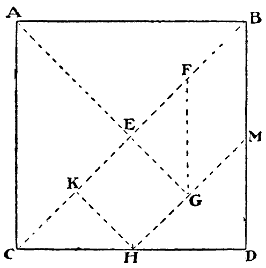
Fig. 1.—Showing dotted lines marked off for black pieces in tangram puzzle.
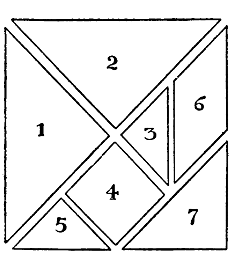
Fig. 2.—Showing square dissected and numbered for tangrams.
Take a perfect square of stiff cardboard of any size, say five inches, and see that the angles and sides are true. Now, very carefully mark it off according to the dotted lines in Fig. 1, which may be explained thus. ABCD is the square. Rule a line from B to C, and mark off M and H halfway between B and D and C and D respectively, and join M and H. Find G the midpoint of MH and join AG. Mark K and F, midpoints of CE and EB respectively, and join KH and FG. Having thus marked out the card, take a very sharp knife and cut the cardboard along the dotted line. You will then have the seven pieces as shown in Fig. 2, which are numbered for convenience sake. Having[491] colored these pieces dead black with India ink on both sides, you are ready to start the great Tangram Puzzle.
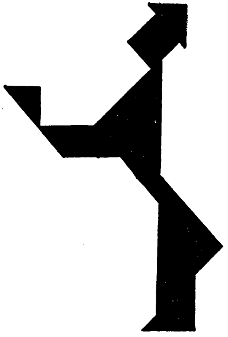
Fig. 3.—Showing original Tan presenting puzzle to his wife.
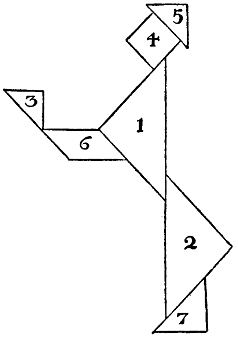
Fig. 3a.—Showing how Tan can be fitted together.
All these seven pieces must be fitted against each other, never overlapping, in order to make the figures of men, beasts, houses, or the like.
Take for example Fig. 3, which shows the original Tan presenting the puzzle. Fig. 3a shows how the good gentleman can be fitted together, as the numbers designate which pieces are to be placed against each other.
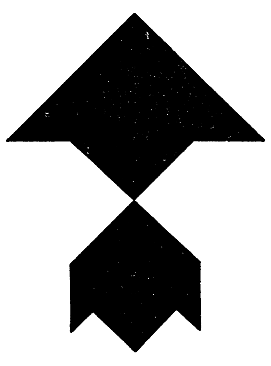
Fig. 4.—Showing pieces fitted together to represent figure in cocked hat.
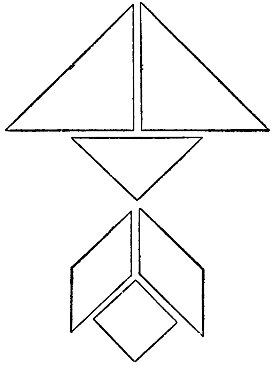
Fig. 4a.—Showing how pieces are placed for figure in cocked hat.

Fig. 5.—Representation of depressed cat.
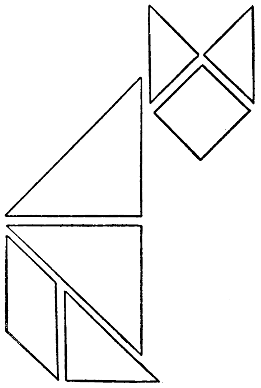
Fig. 5a.—Showing construction of pieces for representation of depressed cat.
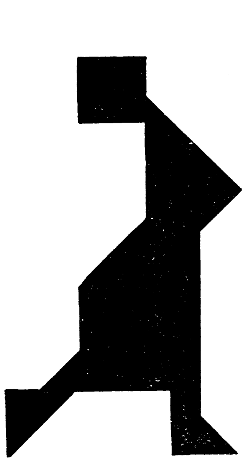
Fig. 6.—Lady holding her skirts high.
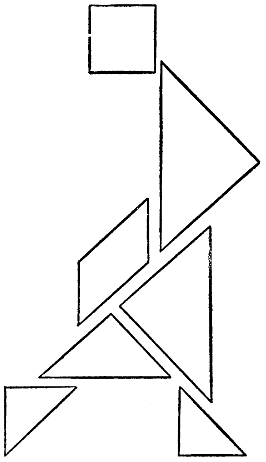
Fig. 6a.—Showing pieces fitted for representation of lady holding up her skirts.
The individual in the cocked hat who appears in Figs. 4 and 4a, is[492] another example of how the pieces are to be put together; similarly the depressed cat in Figs. 5 and 5a, or the lady in Figs. 6 and 6a,[493] who is holding her skirts up so high as she crosses the street. Figs. 6b and 6c show a gentleman apparently tired of life.
These seven pieces can be so disposed as to make hundreds of figures, giving scope for boundless ingenuity and skill.
A good winter evening competition can be arranged by making several sets of Tangram pieces, and distributing one set to each member of the party. The name of some familiar object should then be announced (for example—horse—cat—washerwoman), two minutes being allowed for construction, and points given to the best Tangram.
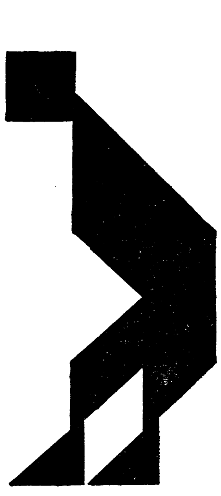
Fig. 6b.—The gentleman tired of life.
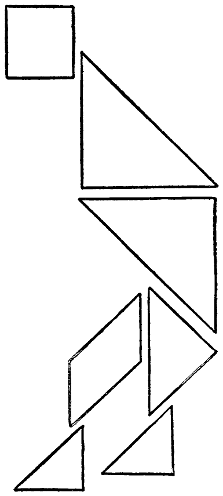
Fig. 6c.—Showing means whereby depressed gentleman is represented.
A variation can be introduced by taking a well-known nursery rhyme or fairy tale, and asking each person to make a Tangram to represent a different subject in the tale. Supposing “The Farmer’s Boy” to be the rhyme, one person would make the figure of that youth, to another would fall the horse, to a third the dog, and so on. As in the former case a prize might be awarded to the most successful manipulator of the little black pieces.
[494]
Ask one of the ladies, who naturally knows all about scissors, to do the following trick. Holding the hands with palms upward, hang a pair of scissors on the little fingers, as shown in Fig. 7. The fingers should then be slightly bent so that the scissors stick upright as in Fig. 8; next ask her to turn the hands round rapidly back to back when the scissors will make a complete revolution, and should finally point upward again. But it is just at this point that the trick comes in, for the fair lady will find that instead of the scissors pointing up to the ceiling, they are directed down to the floor! (Fig. 9.)
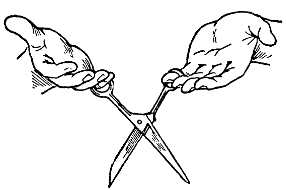
Fig. 7.—How to hold the scissors.
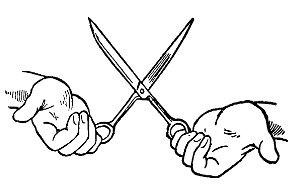
Fig. 8.—Showing fingers slightly bent and scissors sticking upright.
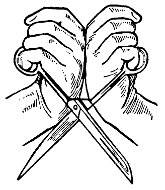
Fig. 9.—Position of scissors after complete revolution.
This is the occasion for you to show how really clever you are, and by bearing the following hints in mind it will prove a very easy matter.
When the hands are in the position of Fig. 8, take care that the rings of the scissors are passed over the last joints of the little fingers only, so that a complete revolution can take place between the palms of the hands and the fingers themselves. To bring the scissors upright will then follow in the natural course of events.
Can you blow hard enough to make your breath pass right through a thick glass bottle? The majority of people will say “No,” and dare you to perform the task. It is really very easy.
Take a large round bottle or jam jar, and place a lighted candle[495] behind it, as in Fig. 10. Now stand so that the bottle or jar is interposed between yourself and the light, and blow. The flame will be extinguished at once!
There is scarcely need to tell your surprised friends that the shape of the bottle has really caused your breath to follow the curve of the two sides, unite at the back, and blow out the light.

Fig. 10.—How the candle flame is extinguished.
Lay a dime, or a dollar if you feel so inclined, upon the palm of your hand, and promise to give it to whoever can brush it off with an ordinary clothes brush, as shown in Fig. 11. The only condition you need make is that they shall brush towards the tips of the fingers and not to one side.
You need have no fear of the result, and can feel quite assured that your money is as safe as if it were in your own pocket. Whatever the explanation may be, the fact remains that no amount of brushing will move the coin the hundredth part of an inch on your open palm.
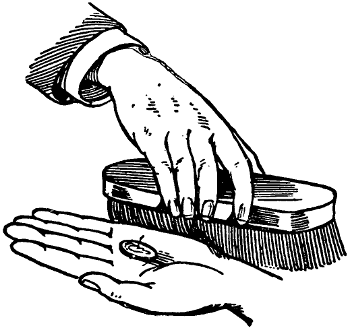
Fig. 11.—The position of coin in palm.
Place a dime upon a polished table and ask one of your friends to pick it up without touching either the coin or the table.
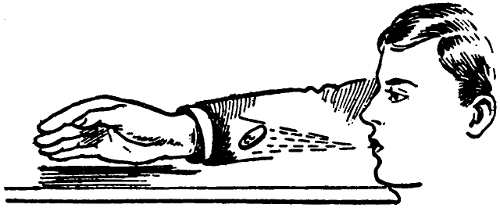
Fig. 12.—Showing how coin is removed from table.
A glance at Fig. 12 shows how the trick is done. Slightly curve your hand so that it almost touches the table, and blow steadily upon the table at a distance of about five or six inches.[496] The force of your breath passing beneath the coin will carry it into your hand.
If there happen to be a newly-married couple amongst your friends, the following little trick may cause them a blush of happiness.
Get them to fold their hands, as shown in Fig. 13, in such a way that the wedding-ring finger of the left hand, and the corresponding finger of the right hand, are doubled inwards as far as the second joint, and the knuckles of those joints press firmly against each other.
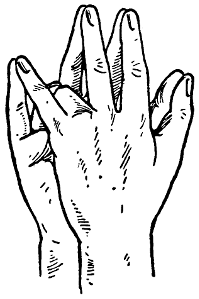
Fig. 13.—Hands folded.
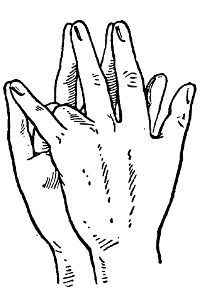
Fig. 14.—Thumbs separated.
Now, tell them to separate their two thumbs, as in Fig. 14, while you say, “Parents and children may be separated!” Then let them do the same with the two forefingers, remarking, “Brothers and sisters may be separated!” The same performance may be repeated with the two little fingers, and you remark, “Even lovers may be separated!” Finally, let them try to separate the two middle fingers, when they will find they cannot get them apart. Whereupon you state emphatically, “But husband and wife can never be divided!”
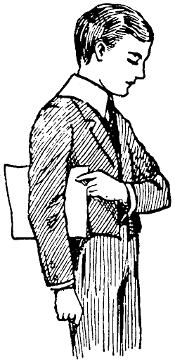
Fig. 15.—Paper being drawn through arm to electrify it.
Take a piece of coarse brown paper, the coarser the better, and warm it steadily before the fire. Now draw it rapidly a dozen times between your arm and your body, as in Fig. 15, so that it receives a good friction upon each side. Now press the paper against the wall, and you will find that it remains as firmly stuck as though a whole pot of the best paste had been used for the purpose.
[497]
A prophet is never without honor but in his own country, and few of your acquaintances will believe you to be such a wonderful person that with a single shout you can break a glass. Yet it is very easy to convince them.
Take an ordinary wine-glass, and hold it by its foot firmly to the table. Make the glass ring with a touch of the finger (it will probably sound a rather low note). While the glass is yet tingling, raise it rapidly to your mouth, and shout the same note that it rang full into the bowl with all your force. The chances are ten to one that the glass will shiver to pieces.
The reason of this phenomenon is the vibrations caused by the tingling are so suddenly increased by the strength of your voice that the glass is unable to bear the strain, and therefore breaks.
It is surprising how universal is the law of love! Even two plain pieces of wood are unable to resist the impulses of the great passion.
Take out the bottom of a match-box, and split it into two pieces. Double over the ends at about a quarter of the way up, as in Fig. 16. On one piece make the rough sketch of a girl, and upon the other a similar drawing of a man, and then place the pieces together, as shown in the illustration.

Fig. 16.—Drawings in position.
If you pour a few drops of water over the joints of the two pieces of wood, you will find that the two figures slowly and surely rise up to meet each other, and will eventually press their two faces closely in a long kiss. They may be some time about it, but then pleasures delayed are always doubly enjoyable!
[498]
Cut a piece of deal into a prism about four inches long, and color two of the sides black or dark blue, painting the remaining side white. Sharpen one end into a small triangular point, and paint two eyes and a mouth thereon, so that the completed figure appears as in Fig. 17.
Now, if you put this in a basin of water very heavily salted, you will find that the fish floats quite naturally, as in Fig. 18, whilst if you place him in a basin of plain fresh water, he will immediately turn on his back and float dead, with the white side uppermost, as in Fig. 18a.

Fig. 17.—Completed figure of fish.
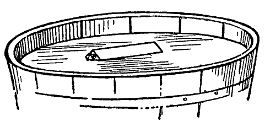
Fig. 18.—“Dead” fish floating.
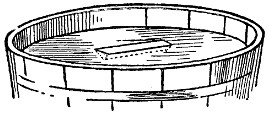
Fig. 18a.—Fish on his back.
This is caused by the greater density of the salt water acting upon the prism.
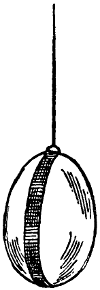
Fig. 19.—Showing egg hanging on wire.
Here is a very handy method of discovering whether an egg is fresh or not.
Pass an elastic band around the egg, and hang it upon a wire, as shown in Fig. 19. Twist the egg and band round several times, and then release it, when the band will rapidly untwist with the egg. If the latter be quite fresh, it will stop almost immediately, but if it happens to be rather older than is desirable, it will twist and untwist, reversing several times before it finally comes to rest. This applies to eggs which have been boiled—indeed to any egg that is “set.”
[499]
This is scarcely a trick, as it really serves to prove which of two persons has the stronger will-power.
Place a door-key between the pages in the middle of a book in such a way that the handle projects an inch or two, as in Fig. 20. Pass a piece of string round the book, and draw into a tight knot, so that the key is held firmly in its place.
Now, let the persons who desire to test the strength of their wills support the book by the ring of the key resting on their extended forefingers, as in the illustration. If one person wills the book to turn from right to left, and the other wills it to turn in the opposite direction, it will be found that the book obeys whichever party is possessed of the stronger will.
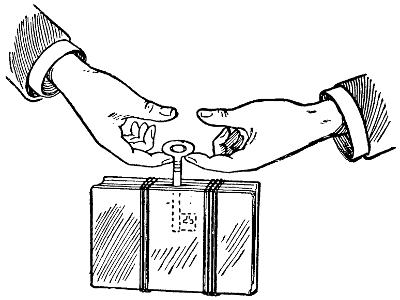
Fig. 20.—A will-power trick.
There is yet another way of testing this strange example of personal magnetism.
Let one of the parties (preferably he of the stronger will) think of some name, Mary, for instance. Informing nobody else of the name he has chosen, let him repeat the alphabet very slowly, when it will be found that, as he arrives at the first letter, M, the book will give a slight turn, and will behave in a similar way for all the other letters of the name. If both parties know the name, the book will turn much more readily, as a result of the united forces of their wills.
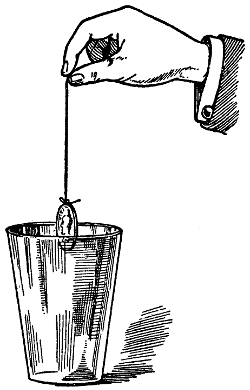
Fig. 21.—The magic repeater.
This is an interesting example of some strange agency at work amongst us.
Make a running noose at the end of a piece of fine thread, and pass it securely round a quarter, as shown in Fig. 21. Taking care that the thread passes over the tip of the thumb, support the thread from your hand, in the manner shown in the illustration, in such a[500] way that the quarter is hanging within a wine-glass or tumbler. Take care also to keep the hand perfectly steady, and await results.
For a few seconds the quarter will oscillate, but it will soon become quite still. Then, actuated by no motion of your hand, it will begin to swing to and fro like a pendulum, and will finally strike one of the sides of the glass.
Counting the number of times it thus makes the glass ring, you will find that the number corresponds exactly with the nearest hour to the time of day. For instance, at 11:20 there would be eleven rings, whilst at a quarter to twelve there would be twelve.
The cause of this phenomenon can be left to scientists to decide.

Fig. 22.—The obliging banana.
It is rare that one can get a fruit so obliging as to peel itself, but upon certain occasions a banana will put itself out of the way to render this favor.
Cut off one end of a banana, and with a knife just start ripping up the skin on the four sides in the usual manner.
Now take an empty bottle, put some methylated spirit inside, and drop a lighted match to ignite the spirits. As soon as the flame has died out, place the prepared end of the banana in the mouth of the bottle, and you will find that the banana is slowly drawn inside, peeling off its skin as the fruit disappears (Fig. 22).
The reason for this condescension on the part of the banana is simple. As soon as the bottle begins to cool from the heat of the flames, the air is contracted inside, a vacuum is caused, and the fruit is sucked into the bottle.
The same trick can be performed with a water bottle and a shelled hard-boiled egg.
[501]
Although most ardent smokers will admit there is little pleasure in smoking in the dark, there are few who will not be surprised at the following trick.
Induce a cigarette devotee to have his eyes bandaged, and make him moisten the ends of two cigarettes. Having lighted one of them, allow the victim to have a few whiffs and then take it out of his mouth and replace it by the unlighted cigarette. Continue changing the cigarettes in this manner for a few minutes, and you will presently find that he is quite unable to tell which he has in his mouth, and is quite at a loss to know whether he is puffing away at the lighted “cig.” or not.
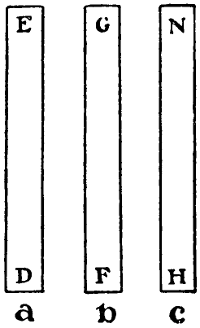
Fig. 23.—The mysterious bands—first stage.
Take a full sheet of a large newspaper, e.g. the first and last pages (which make one sheet) of a paper like the New York Times, and cut three straight strips (a, b, c) about three inches wide, as shown in Fig. 23. Now join the ends of these strips in the following manner in order to make three loops.
In the strip a bend round D, and paste it on to the under side of E.
Make a loop of b in a similar manner, but giving the strip a half turn, and pasting the under side of F to the under side of G.
In the third strip this twist is replaced by a full turn of the paper, so that H is pasted on the under side of N, as in the first instance.
When making these bands it will be quite easy to conceal from the spectators the twists you have given to the paper; and, indeed, the success of the trick depends upon this part of your preparation not being observed.
Now comes the exhibition of the trick. Cut each of the loops into[502] two, in the direction of the dotted lines in Fig. 24, when the following astonishing result will be obtained.
The band a will be cut into two equal loops, as in Fig. 24a, the loop b will turn into one large loop twice the size of the original as in Fig. 24b, whilst the loop C will be transformed into two links of a chain, as in Fig. 24c.
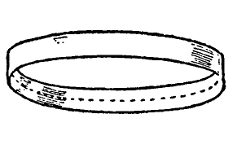
Fig. 24.—Showing where to cut loops of paper.
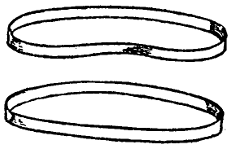
Fig. 24a.—Band cut into equal loops.

Fig. 24b.—Showing large loop twice the size of original.

Fig. 24c.—Showing loop C transformed into two links of a chain.
It need hardly be remarked that the twists given to the original bands are responsible for this strange result.
Get some one to take a nickel out of his pocket, and, without showing it to you, ascertain the date of the coin, and then turn it face upwards on the palm of his hand. You will now remark that “you can tell the date.”
Appear to scrutinize the coin very attentively, and then, with the utmost importance, tell the owner of the penny the actual day of the month, and smile complacently at his indignation.
If you have fifteen matches and remove six, how can you obtain a remainder of ten?

Fig. 25.—Showing first arrangement of matches.
Arrange the matches as in Figs. 25 a, b, and c, and ask a friend the above-mentioned question.
[503]
When he gives it up, remove the six matches marked A, B, C, D, E, and F, and you will have the result shown in Fig. 26.

Fig. 26.—Showing result when six matches have been removed.
Take a piece of string about a yard long and tie the ends together, making a loop. Passing this loop through the ring of a key, hang it upon the extended thumbs of a friend, as in Fig. 27. The strings are crossed. The trick is to remove the key without taking the string from the other person’s thumbs.
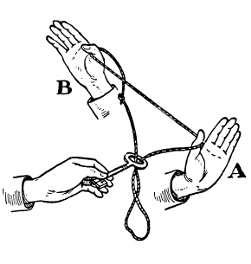
Fig. 27.—Showing string upon extended thumbs.
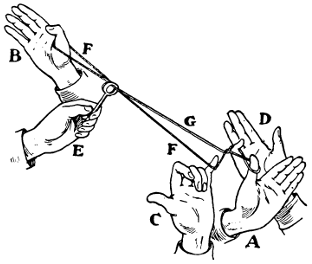
Fig. 28.—Second stage of string trick.
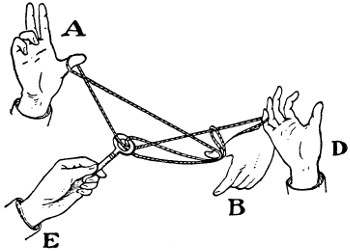
Fig. 29.—Showing mode of freeing key from string.
To understand the diagrams it will be necessary to remember the following explanations of the letters used in Fig. 28.
A and B are the hands of the person just described whose thumbs bear the string.
C and D are your own hands, left and right respectively.
E is the hand of a third person who holds the key.
F and G are the two sides of the loop.
Begin by catching the string F on your little finger of C and G on the little finger of D, as in Fig. 28. Now transfer the string from the little finger of C to the thumb of B, and thus free your hand C.
Between the forefinger and thumb of B you must take the string G between the key and A.
Now catch this part you have taken round the thumb of B, slip[504] the string from the little finger of D, and when E pulls the key, it will come quite free from the string (Fig. 29).
Stick a sharply-pointed knife, preferably with a heavy handle, into the lintel of the door, or into a wooden beam upon the ceiling. Then ask for some one with a sure eye to mark the exact spot on the floor by putting a cent upon it, where the knife will drop when displaced.
This is easily done in the following manner. Take care that the knife is very lightly stuck into the wood, so that it will fall at the slightest touch.
Fill a glass with water, and raising it to the knife immerse the handle to the height of an inch or so. Then watch where the drop of water, which will fall when you remove the glass, strikes the ground, place the cent upon the spot, and you will find that the knife will fall upon that identical place.
Fold a piece of paper into four, and cut a pointer out of it, as shown in Fig. 30. Now run a needle through a cork and balance the pointer on its tip, as shown. Place an inverted tumbler over the whole contrivance (Fig. 30a).
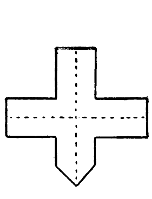
Fig. 30.—The paper pointer.
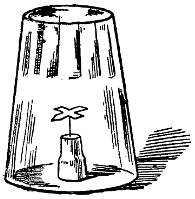
Fig. 30a.—Pointer mounted on cork.
[505]
By rubbing the outside of the tumbler with a piece of rag, or even a handkerchief, you can make the pointer turn in whatever direction you desire, as it will swing round to whatever portion of the glass you happen to rub.
Announce that you will make it point to Mr. Jones. If you then rub the glass on the side nearest to that gentleman, the paper needle will swing round and point directly to him.
By rubbing the handkerchief rapidly round and round the glass the needle will be made to revolve with considerable speed, to the great delight of the younger members of the party.
Thread a No. 6 needle with a couple of yards of fairly coarse cotton or thread, and draw them through until the two ends are of equal length.
Now pass the point of the needle right through the two strands, as in Fig. 31, and continue pulling the needle as in Fig. 31a until the threads have passed through each other and appear a continuous piece, as in Fig. 31b. This should have been done before showing the trick to the company. As there will be no knot, it is highly improbable that any one will notice a peculiarity in the thread.

Fig. 31.—Needle-threading—first stage.
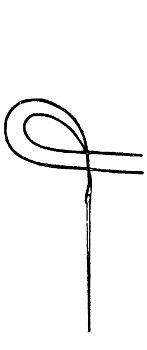
Fig. 31a.—Thread passing through itself.
Fig. 31b.—Showing thread as a continuous piece.
You then state that, without looking at the needle, you will thread it with as many strands of cotton as it will hold. Proceed in the following way.
[506]
Holding the needle with the point upwards beneath the table, out of sight of yourself and the others, catch one of the threads at a point between the eye of the needle and the point where they pass through each other, as in Fig. 32, and pull that steadily downwards.

Fig. 32.—Showing point where thread is pulled steadily downwards.

Fig. 33.—Result of thread passed through eye of needle.

Fig. 33a.—Threaded needle complete.
By doing this the invisible knot is passed through the eye, carrying with it two strands, and by continuing this action the knot is passed several times, until eventually a result similar to that shown in Fig. 33 appears.
Drawing the knot to the bottom of this series of loops, you can then cut off all the ends as well as the knot, and present the threaded needle to your friends as it appears in Fig. 33a.
Take an ordinary piece of string or thread, and offer to cut it in two if somebody present will guarantee to join it into one piece again without any knot. You may announce at the same time that by wizardry you are able yourself to do this by a simple bite of the teeth.

Fig. 34.—Showing string passed round hands.

Fig. 34a.—Showing ends of string looped together.
The trick is done in this way. Appear to pass the string round the hands twice, as in Fig. 34, whereas by a deft movement, which can be acquired with a little practice, you really[507] loop the two ends round each other, as in Fig. 34a. Holding the point where they cross each other between the finger and thumb (see H, Fig. 35), you request some person to cut the two ends at G, promising to join these ends with your mysterious bite.
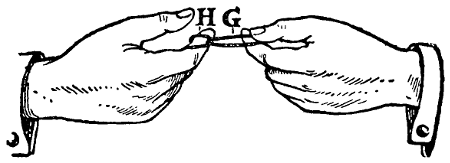
Fig. 35.—Showing point where to cut string.
Place the string in both hands into your mouth, and whilst making a mumbling movement, contrive to catch the short doubled piece, G, H, in your teeth and retain it there, whilst extending your hands to the company you show a whole piece of thread, as in Fig. 36. The little piece which you have kept between your teeth can be easily removed without exciting suspicion, and there are few people critical enough to measure the string and find there is a piece missing.
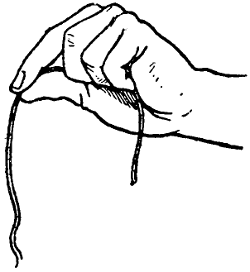
Fig. 36.—Showing whole piece of thread.
This trick can only be done on a sunny day, for a reason which will be very evident to those who try it.
Obtain a clear glass bottle, in the cork of which stick a hooked pin. By means of a piece of thread hang a small weight from this pin within the bottle, as in Fig. 37, and then request some one to cut the cord without drawing the cork.
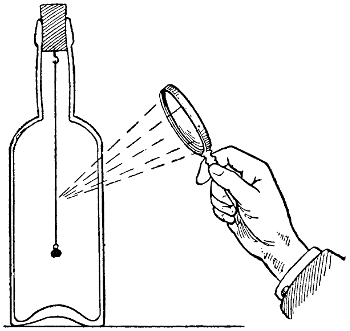
Fig. 37.—Sun’s rays focused on weighted thread.
All that is necessary to do this is a magnifying glass which is placed between the bottle and the sun at the right distance to focus the rays of the latter upon the[508] cord. In a few seconds the heat of the converging rays will burn through the thread, and the weight will fall to the bottom of the bottle. In the same way you can
Concentrate the rays of the sun upon the end of the cigarette, and draw in the ordinary way (if you are old enough to smoke), when the cigarette will rapidly be ignited.
Stick a penknife into a post or tree, or other strong upright of wood, and pass a piece of string behind the post and above the knife, as in Fig. 38. Bring the end C round the post and pass B over it. Bring C round again and cross it over the knife, and B round the knife over C, as in Fig. 38a. Pass the ends round the post again, always remembering that B must be over C, and then tie the two ends in a knot, as in Fig. 39.
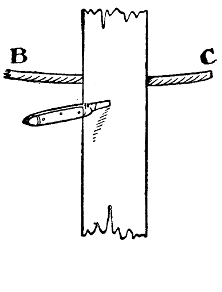
Fig. 38.—Knife and string trick—first stage.
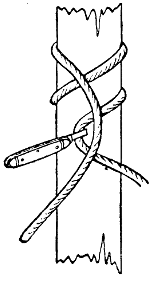
Fig. 38a.—Knife and string trick—second stage.
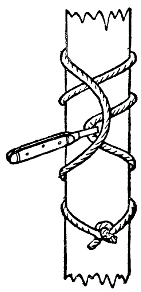
Fig. 39.—Knife and string trick—third stage.
By removing the knife from the post, you will now find that the whole loop comes away intact, having never really been passed round the post at all.
A candle can be lighted without approaching the match to the wick in this way.
Light a candle in the ordinary manner, and take care that the wick[509] is fairly long and burns brightly. Blow it out suddenly, and by applying a lighted match to the smoke at the height of an inch or two, the candle will instantly relight without your having to put the match to the wick.
If any of your friends boast of a steady hand, you can easily give their pride a fall by wagering that not one of them can move a glass of water from one table to another without spilling every drop it contains.
Fill a tumbler with water to the very brim. Place a piece of perfectly flat, stout paper on the top of it, as shown in Fig. 40, and the palm of the hand on the top of that. Now turn the glass upside down very quickly and carefully, and place it upon a flat part of the table, having done which slide the piece of paper from beneath it. As the air cannot enter none of the water escapes, but it will be absolutely impossible to move the glass without spilling the water.

Fig. 40.—A water trick.
[510]
History records that the blind poet Homer lost his reason in a vain endeavor to solve a riddle, and from his days until these present times much care and thought have been expended in the invention of puzzles both difficult and simple. It is the object of this chapter to present the reader with a few simple ones.
Two easy and yet fascinating puzzles can be worked with an ordinary checker-board.
Place a checker upon a square near the center of the board, as in Fig. 1. In how few moves can you make it traverse every square in the board and return to its starting-point?
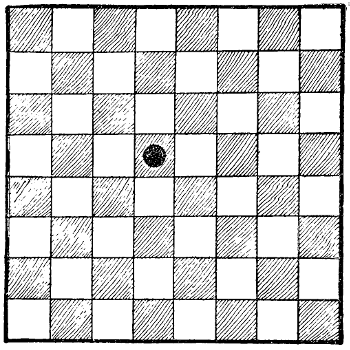
Fig. 1.—The traveling checker.
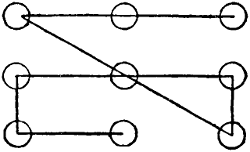
Fig. 2.—Joining the rings.
Place sixteen men on a checker-board in such a manner that no three men shall be in a line, either horizontally or perpendicularly.
Nine rings are connected by six straight lines, as shown in Fig. 2. Connect these same nine rings by four straight lines.
[511]
This is a puzzle with nine checkers or counters. Dispose these counters in such a manner that ten rows are formed with three men in each row.
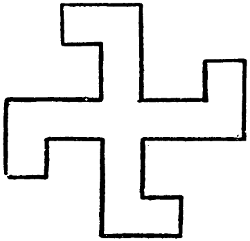
Fig. 3.—The cabalistic sign.
Fig. 3 shows a piece of paper cut into a famous cabalistic sign. How can you divide it into four pieces which, placed together, shall form a square?
Once upon a time there were eight anarchists confined in separate cells connected by the system of passages shown in Fig. 4. The prisoners, each of whom had his own number, occupied cells in the order shown.
One day the governor of the jail decided that his prisoners should be transferred from one cell to another in order that their numbers should run consecutively from left to right. Accordingly he gave orders for this to be done, but at the same time directed his warders that on no account were any two prisoners to meet, either in the passages or cells. As there was only one vacant cell at their disposal, how did the warders work this maneuver successfully?

Fig. 4.—The dangerous anarchists.
You will find the best way to solve this problem is to draw a plan similar to that shown in Fig. 4, and place eight numbered counters in the respective cells.
[512]
A man once wanted to saddle a donkey, and proceeded, bridle in hand, to the field where Ned was feeding.
Let Fig. 5 represent the field, which the man entered by the gate at 63, whilst the ass was standing in the opposite corner at 2.
Now you can move either the man or the donkey to any number in the straight line, but neither must cross or rest upon a line covered by the other. For instance, if the donkey be at 2, the man can move to 62, 61, 59, 36, or 13; but he cannot go to either 60 or to 5, for then the donkey would gallop up and let fly with his heels. Ned, on the other hand, can go to 6, 28, 51, 3, or 4, but if he were to go to 60 or 5 the man at 63 would catch him at once.
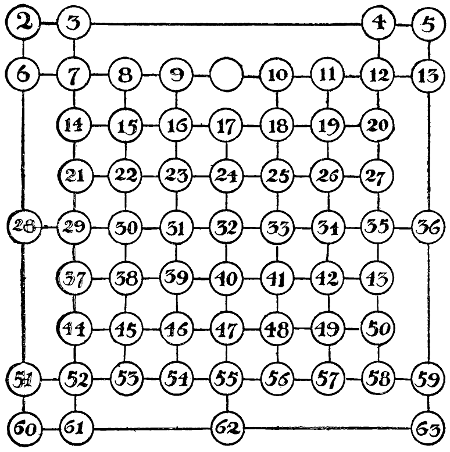
Fig. 5.—Catching the donkey.
Giving the donkey the first move, how soon can you place the man in such a position that the ass is cornered and cannot escape being bridled?

Fig. 6.—“Like to like.”
Four black and four white counters are placed alternately in a row of ten divisions, shown in Fig. 6. By moving two at a time, how can you arrange all the blacks and all the whites together in four moves?
[513]
A lady once took to a jeweler a gold chain, broken into five pieces of three links each (Fig. 7). She asked him to repair the chain, agreeing to pay 25 cents for each link that he had to break and weld in order to restore the chain to its original length.
The following day she sent her maid for the chain with 75 cents. If you had been the jeweler, how would you have mended this chain of five pieces by breaking only three links?
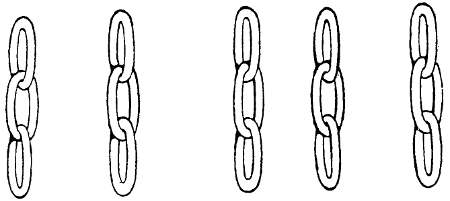
Fig. 7.—The broken chain.
The same lady wished to have a diamond cross reset, and pleased with the intelligence shown by the jeweler, she decided to give him the work.
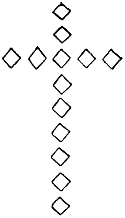
Fig. 8.—The diamond cross.
But she was determined to give him no opportunity of cheating her, so she counted the stones from top to bottom (Fig. 8), and found there were nine. She then counted them from the bottom to the extremity of each arm of the cross, and found that they also numbered nine. Having noted these figures, she sent the cross to be reset.
But the jeweler was a crafty man, and knowing how she had reckoned the diamonds, he stole two, and having reset the remainder, he returned the finished piece of work.
When she received her cross, the lady thought it looked rather different, and counted the stones according to her former plan. The numbers were exact! So she paid the jeweler, who went off smiling.
How had he managed the theft?
Five competing railway companies decided to place termini in a certain small town. But land was dear; and after much negotiation they were able to secure sites only as shown in Fig. 9.
[514]
But none of the companies would grant any of its competitors running powers over its lines, and as the municipal authorities decided that all five lines should enter the city side by side, the engineers found themselves confronted with the following problem:—How is each line to reach its destination, without crossing any of its competitor’s tracks?
How would you extricate them from this dilemma?
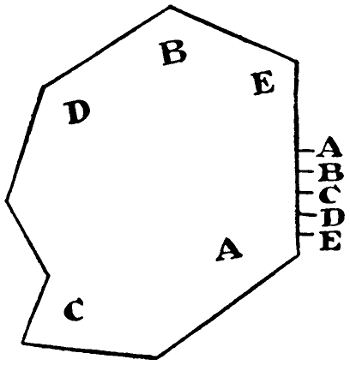
Fig. 9.—The quarrelsome railways.
This problem is shown in Fig. 10. In the railway A, B, C there are two sidings, A, D and C, E; which meet at F. At this latter place there is only sufficient space to contain one car of the size of G or H, and there is no room for the engine, I. Consequently, if this engine is sent up either of the sidings it must return by the same tracks.
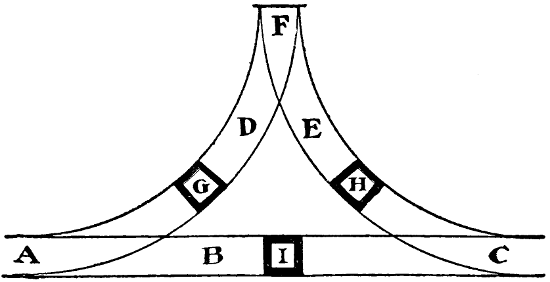
Fig. 10.—The second railway problem.
The point to be discovered is: How can the engine, I, transpose the two cars G and H, by simply using the rails shown in the illustration?
Study Fig. 11 closely, and think how you can divide a piece of paper thus shaped into four similar parts.
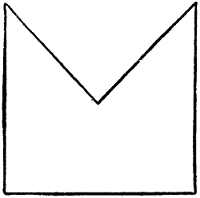
Fig. 11.—The miter.
[515]
You cannot make the checker traverse all the squares in less than sixteen moves, as shown in Fig. 12.
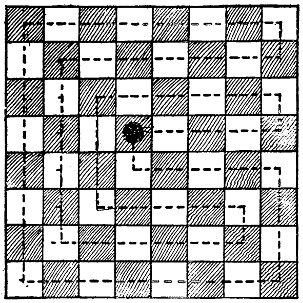
Fig. 12.—Solution to traveling checker.
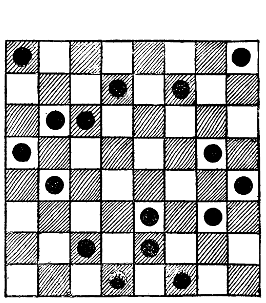
Fig. 13.—Solution to second checker puzzle.
The way to place the sixteen pieces so that no three are in a line in any direction, can be seen from Fig. 13.
The nine rings can be joined by four lines, as shown in Fig. 14.
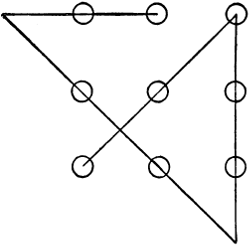
Fig. 14.—The joined rings.
The complicated geometrical figure shown in Fig. 15 shows the ten rows formed with nine counters.
By making the two cuts shown in Fig. 16, the piece of paper will be divided into four parts that will fit together into a square.
[516]
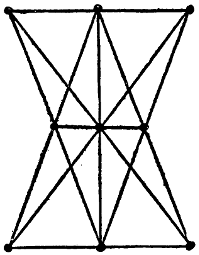
Fig. 15.—The ten rows.
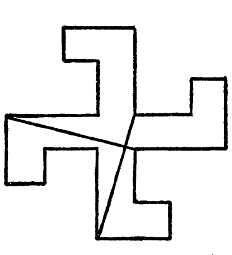
Fig. 16.—Solution to cabalistic sign puzzle.
The simplest method of rearranging the prisoners was as follows (as there was only one vacant cell at any time the numbers designate which prisoner was moved therein)—1, 2, 3, 1, 2, 6, 5, 3, 1, 2, 6, 5, 3, 1, 2, 4, 8, 7, 1, 2, 4, 8, 7, 4, 5, 6.
According to the rules of the game, the donkey moves first, and the following is one of the shortest methods by which the man can catch him. It will doubtless amuse you to find other, and probably quicker ways of cornering Ned.
| Donkey | to | 3 |
| Man | „ | 36 |
| Don. | „ | 21 |
| Man | „ | 30 |
| Don. | „ | 3 |
| Man | „ | 8 |
| Don. | „ | 4 |
| Man | „ | 7 |
| Don. | „ | 5 |
| Man | „ | 12 |
When the man has driven the ass into the corner at 5, of course there is no more chance of escape, and Ned has to submit to the bridle with resignation.
Moving two men at a time, the four moves are:—
| 2 | and | 3 | moved to | spaces | 9 | and | 10 |
| 5 | „ | 6 | „ | „ | 2 | „ | 3 |
| 8 | „ | 9 | „ | „ | 5 | „ | 6 |
| 1 | „ | 2 | „ | „ | 8 | „ | 9 |
The counters will then appear as in Fig. 17.

Fig. 17.—Solution to “Like to like” puzzle.
[517]
To repair the chain the jeweler had recourse to a very simple device. Breaking the three links of one of the pieces he used them to join the remaining four pieces, thus restoring it to the original length.
The owner of the diamond cross thought she had been very clever in counting the stones as she did, but her cunning overreached itself, for the jeweler had only to remove the diamonds of the extremities of the cross-piece, and shift this latter up one point, as in Fig. 18, to make his theft almost unnoticeable. You will find the diamonds count nine, even though two stones have been removed.

Fig. 18.—Solution to diamond cross puzzle.

Fig. 19.—Solution to the quarrelsome railways puzzle.
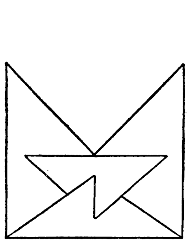
Fig. 20.—Solution to miter puzzle.
After much surveying and discussion, the railways laid their lines as shown in Fig. 19.
The following is the simplest method by which the engine could transpose the cars G, H.
I pushes G into F, and returns and pushes H up to G. The two[518] cars are then coupled together, drawn down to C and pushed over to A. G is then uncoupled, and I takes H back to F and leaves it there. I then returns to G, pulls it back to E and leaves it there. I then returns to H by way of C, and draws it down to D, thus completing the task.
A glance at Fig. 20 will show how the miter can be divided into four similar parts.
[519]
“But, I tell you, I saw it; surely I can trust my own eyes!”
How often have we heard this uttered as a conclusive proof of some friend’s statement!
And really at first it would seem to be an assertion admitting of no further question, were it not for the fact that we know our eyes are no more infallible than anything else in this world, and are quite as liable to make mistakes as are our memories.
It is true that eyes are good and faithful servants, fit to be trusted in ninety-nine cases out of a hundred, but like all good and faithful servants there is that hundredth case when their judgment goes wandering, and when they leap to rash conclusions, carried away by deceptive appearances.
Strange as it may seem, upon certain occasions, the best eyes are actually blind! If you shut one eye and hold the page with Fig. 1 at arm’s length, you will be able to see both the spots A and B. Now look steadily at A, and you will still see B quite plainly, but if you gradually draw the book nearer to your eye, a certain point will be reached when B becomes invisible, although if you continue to make the book approach your face B will spring into view once more. In other words, at the moment when you could no longer see B your blind spot had been directed towards it, and of course saw nothing.

Fig. 1.—When two are one.
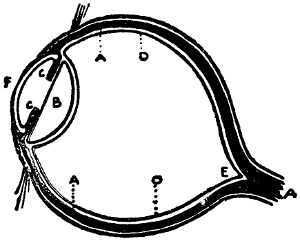
Fig. 2.—Section of the eye.
No doubt you would like to know where this blind spot is, and why our eyes should possess such a thing. Fig. 2 shows the section of an eye which can be explained in very simple terms. The thick black line A is a sheet of nerves which entirely envelops three-quarters of the eye, and meeting in a point at E passes upwards into the brain, where it records what the eye has seen. The light enters[520] between the points C C, the iris, and striking through the lens B throws all objects within the scope of vision upon what is called the retina or screen, D. Now this screen is furnished with millions of little nerves, each one of which records on the large nerve A whatever is thrown upon it, and all these records are gathered together by A and passed up to the brain.
But at the spot E, where these big nerves are collected together, the retina, as you notice, is pointed, and gives no record of what is thrown upon it. So, you see, when any object happens to come into such a position with the eye that its image is cast upon the point E of the retina, we have no record sent to the brain—in other words, we cannot see it.
But the eye is not only blind in one point; it is very apt to be deceived by appearances, and to make all kinds of mistakes in consequence. Take Fig. 3 for instance. Would you not say that B D is shorter than A C? Yet if you measure them you will find they are the same length. Or in Fig. 4, A B is surely longer than C D. They are identical. Or take Fig. 5, A is clearly farther from B than C is from B, and yet A B and B C are of the same length.
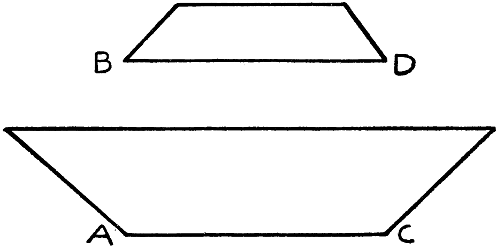
Fig. 3.—Is A C longer than B D?
The truth is that your eye is so confused by these different lines that it is wholly unable to form any clear estimate of how great the distances really are. This is shown even more clearly in Fig. 6 (technically known as Zollner’s lines), where you see A B and C D, which have every appearance of being about to meet shortly in[521] the direction of A C. Now if you will measure the distances between B D and A C you will find that the lines are exactly parallel, but the eye has been so deceived by the little cross lines running in different directions, that it seems incredible the two thick lines are not inclined towards one another at quite a considerable angle.
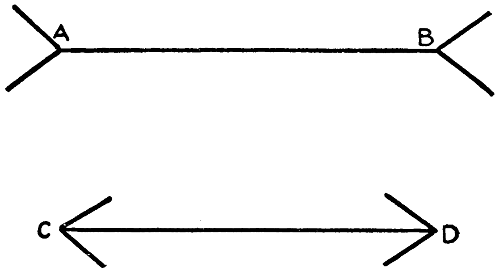
Fig. 4.—Which is longer—A B or C D?

Fig. 5.—The distance from A to B is the same as B to C.
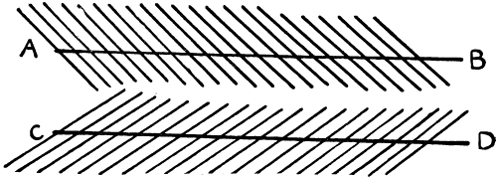
Fig. 6.—Zollner’s lines.
[522]
Should it ever happen that you go cycling in France, you will find this deception practiced upon your eyes all day long. The roads in that country are very straight, and are bordered upon either side by tall trees, so that from wherever you stand a long avenue stretches before you to a point where the trees seem to merge into one another, as parallel lines invariably appear to do. But flat as the country may be, you will always find yourself confronted with a gentle incline, as it seems, very slight but none the less perceptible. You brace for a long and steady climb, yet somehow, as you cover the ground, the hill seems always before you and yet there is no noticeable ascent. The reason is simple. There is no ascent. The borders of trees, like the little lines in Fig. 6, deceive the eyes in a similar way until it is almost impossible to believe that the hill is merely an optical illusion, and that the road is flat as the proverbial pancake.
There is another trick the eye is very fond of playing us. A straight line, held on a level with the eye appears very much shorter than it really is. Look at Fig. 7, which appears to represent a number of pins lying with their points towards you. Now lift the book to the level of the eyes, close the right one, and they will appear to be sticking upright in the page.
What a jumble of lines there is in Fig. 8, something like a spider’s web, and one can make nothing out of it. But lift the book up, as in the last example, and close one eye—the letters are plain enough, are[523] they not? You have played a trick on your own eye, and made its habit of shortening lines serve to interpret a message that would otherwise be unintelligible.
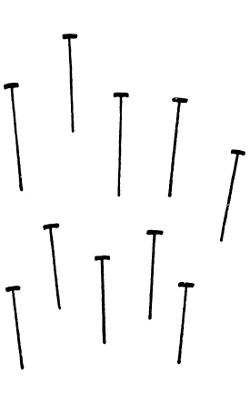
Fig. 7.—The standing pins.

Fig. 8.—“Yes or no?”
Every cloudless night the eyes make a mistake that we can easily discover, but which we are totally unable to remedy.
Of course you have looked up to the sky thousands of times and seen the stars twinkling. Not only that, but if the night is clear you can see they are stellate, or star-shaped, like the starfish which is named after them. You can see both of these things, and yet the strange fact is that neither of them is true!
The stars do not twinkle at all, and they are not stellate. The twinkling is the result of the intervening atmosphere, and not the fault of our eyes; but the second error can be easily brought home to our untrustworthy organs of vision by the following experiment.

Fig. 9.—The illusion of the stars.
Take a piece of tinfoil and prick a small hole with the point of a pin. Now when it is dark put a candle behind the tinfoil in such a way that the light comes through the tiny hole. Hold the tinfoil about ten inches from your face, and the hole will appear irregular. If you bring it nearer, it will lose even the least resemblance to a hole and appear as a star! Of course you know perfectly well that it is round, but your eyes have deceived you once more in the same way that they deceive you every starlight night, and the little hole looks something like Fig. 9—varying slightly with each individual observer. This deception, or to put it charitably, this mistake of the eyes, is given the very high-sounding name of “irregular astigmatism,” but for all that it is an illusion pure and simple.
Like many well-trained servants, the eyes are quite at a loss if anything contrary to the usual routine is presented to them. They know perfectly well the laws of perspective,—how in the ordinary course of nature these laws are never broken by a hairbreadth. They are therefore accustomed to judge in the fraction of an instant the size of an object by its apparent distance away. That this is the result of practice can be easily seen from the fact that very young creatures—human and otherwise—have no idea of the relative distances of objects, and strain to touch a distant gas-light, or, like a young calf, rush headlong into a neighboring wall which their green young[524] fancy deludes them into thinking is really some distance away. But as we grow older we learn many things, and perspective amongst others.
Now if we make a drawing such as Fig. 10, which represents three men walking down a passage, our eyes know quite well that if all these men were of the same size, Mr. Jones in front would appear smaller than Mr. Smith behind him. And Mr. Smith in his turn would appear smaller than Brown who closes the procession.
Yet in our illustration Jones appears a veritable giant, towering above Smith and making Brown appear a mere pigmy. If you measure them, you will find they are all three the same size.
The reason of the deception is this. The lines showing the passage disappearing into the far distance immediately suggest to the eye the correct perspective, and, knowing the laws of that perspective, the eye is perfectly convinced that if all three were the same size, Brown in the rear would appear proportionately bigger than Jones. As he does not do so, the eye immediately leaps to the conclusion that he must be very much smaller. It therefore telegraphs to the brain that Brown is a dwarf, following in the tracks of an ordinary man and a giant!

Fig. 10.—The dwarf, the man, and the giant.
[525]
Most of us know the result of turning a series of circles (as in Fig. 11) horizontally with the eye. The circles appear to revolve rapidly round their center, and in different directions. This is solely because the eyes become confused, giving one more proof, were it needed, that they are no more infallible than anything else on this wide earth.
Some very interesting experiments in color illusions can be made. So cunning is the deception played upon us by our eyes, it is extremely difficult to believe that some of the tints we see in the experiments are but imaginary.
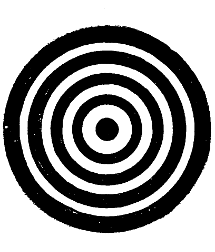
Fig. 11.—Revolving circles.
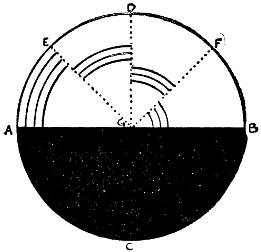
Fig. 12.—The color top.
In Fig. 12 you see a top which can be constructed of cardboard in this way. Take a postcard and cut a circle, upon which you draw a diameter as A B. Black the part A C B with India ink, and divide the other half into four equal portions by lightly penciling the radii G E, G D, and G F. Now, still using your India ink, make arcs in these four divisions in the same way as is shown in the figure.
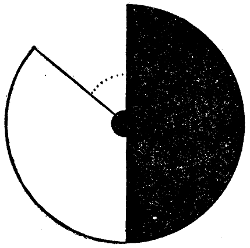
Fig. 13.—To make black print red.
Having done this carefully and rubbed out the pencil radii when the ink has dried, put a pin through the center G from the back, so that the card can easily revolve whilst the pin-head prevents it from falling off. Your color top is now ready. Make it turn rapidly upon the pin; look closely at the card and what do you see? The inner circles become red and the outer ones blue! And yet you know perfectly well that the only colors really upon the card are black and white!
You can make another top, after a similar fashion. Cut your[526] postcard as before, making one half of it black. Now, out of the white side, cut a segment with an angle of 45 degrees, leaving a little piece near the center as shown in Fig. 13. This piece you have left has nothing to do with the effect, but is simply to make the top revolve better.
Take an ordinary book, of which the printing is presumably black, and revolve the top upon the pin at the rate of about five turns a second (a sharp twitch with the finger will do this perfectly well). If you look at the printing now you will find the letters are colored red, as though the book had been printed in red ink!
In both these experiments the alternation of black and white has not only confused the eye, but has deceived it into seeing colors which do not really exist.
So we have shown very conclusively that the old proverb, “all is not gold that glitters,” can be applied to even the plainest of black and white; and, as the poet remarks, “things are not what they seem.”
Therefore, when people wish to impress you with the evidence of their own eyes and clinch an argument by stating that they saw such and such a thing and cannot be wrong, show some of these optical illusions and demand a better proof of what they affirm, very courteously assuring the dogmatist that the best of eyes are liable to make mistakes.
[527]
From the earliest times secret writing has been considered no less an art than a necessity. Innumerable have been the systems invented and the means employed to insure the secrecy of messages and instructions. Yet in the passage of time by far the greater number of these methods of cipher has become obsolete and practically useless, failing in most cases to comply with the three great necessities which Bacon declared to be indispensable to all ciphers and cryptograms: (1) Easy of reading and writing; (2) difficult of solution; and (3) void of suspicion.
Ciphers may be generally divided into two branches—code ciphers and letter ciphers. The first of these terms refers to systems so arranged that one group of characters represents several words or sentences, whilst the other term designates those cryptograms where each letter in every word has its corresponding symbol.
As letter ciphers are the more usual, and certainly the handier of the two classes, examples are given of some systems which have been successfully used at different times and for different purposes.
The simplest of all methods, and, for that matter, the easiest to be detected, consists in having an arbitrary list of numbers, one of which shall represent each letter in the alphabet—e.g., A appears as 4, B as 8, C as 12, &c.
This plan can be varied by substituting letters for the numbers, and having each letter of the alphabet represented by another letter—e.g., A being substituted by G, B by L, C by Q, and so on; but the disadvantages attending these very simple ciphers are so great that for a message of any real importance the system is useless.
In the same way the expedient of reversing the alphabet and making A represented by Z, B by Y, C by X, is too simple and generally known to require further description.
One of the easiest and earliest ciphers is shown in Fig. 1. This
is written in the following manner: The “bounding” lines in which
the desired letters are contained are drawn and the position of the[528]
letter in them indicated by a dot. Taking, for example, Fig. 1, A
would be one dot, B two, and C three dots inscribed inside the
two lines forming the angle. Thus the word CIPHER would be
written ![]()
![]()
![]()
![]()
![]()
![]() .
.
At this point it might be remarked that in all the examples
here given the letters are arranged in their simplest order—that of
alphabetical sequence; whereas, for practical purposes, they can be
arranged in any form desired, the more complicated the better. To
illustrate this Fig. 2 shows another arrangement of the letters, by
using which the same word would appear
![]()
![]()
![]()
![]()
![]()
![]() .
.
| A B C | J K L | S T U |
| D E F | M N O | V W X |
| G H I | P Q R | Y Z |
Fig. 1.—One of the earliest ciphers.
| d j v | a o w | e p u |
| h l s | b m r | i y |
| g k t | c q x | f n z |
Fig. 2.—Another arrangement of
cipher shown in Fig. 1.
An example of another simple cipher created merely by the transposition of letters is shown in Fig. 3, which can be read by taking the first letter of the first line, the last letter of the last line, the last letter of the first line, and the first letter of the last, then the last letter of the first line, the penultimate letter of the last, and so on. When the letters in Fig. 3 are properly transposed they will be found to read “A very simple cipher.”
| a y p e i e |
| c e p |
| h r i |
| r m l s v |
Fig. 3.—Transposition
of
letters
cipher.
Lord Bacon invented a cipher composed of two letters only, which, although confusing to the uninitiated, is somewhat too cumbersome for any general use. Supposing the two letters decided upon to be A and B, they are grouped into series of five and employed in the following manner: The first letter in the alphabet, A, is represented by AAAAA, B becomes AAAAB, C appears as AAABA, D as AABAA. Using this combination, the same word “cipher” would be written AAABA, BBAAA, BBBBB, AABBA, ABAAA, BBBAB.
Amongst the easy ciphers must be mentioned that shown in Fig. 4, which is used thus: In the center block of small type you find the[529] letters of the word you wish to write in cipher. Suppose it to be TO-MORROW. Now in the vertical column at the side you find that the letter on a line with “t” is A, whilst the letter at the top of the vertical column is G. Therefore the cipher letters for “t” are AG. The next letter, “o,” is on a line with B and under E, so the cipher letters are BE. In a similar way “m” becomes CD, and, proceeding with the remaining letters in the same fashion, we obtain the whole word written in cipher thus: AG, BE, CD, BE, BF, BF, BE, CG.
| A | B | C | D | E | F | G | H | |
|---|---|---|---|---|---|---|---|---|
| A | a | d | g | k | n | q | t | x |
| B | b | e | h | l | o | r | uv | y |
| C | c | f | ij | m | p | s | w | z |
Fig. 4.—The “two-letter” cipher.
| 1 | 2 | 3 | 4 | 5 | |
|---|---|---|---|---|---|
| 1 | a | b | c | d | e |
| 2 | f | g | h | i | j |
| 3 | k | l | m | n | o |
| 4 | p | q | r | s | t |
| 5 | uv | w | x | y | z |
Fig. 5.—The Nihilist code.
An adaptation of the last-mentioned system is shown in Fig. 5, where the letters at the side and top are replaced by numerals. This method is very much in use amongst the Russian Nihilists, who would therefore write the sentence “Plot discovered” as follows: 41, 32, 35, 45; 14, 24, 44, 13, 35, 51, 15, 43, 15, 14.
This, again, can be very much complicated by multiplying each number by the position held by the letter in the word. Thus in the sentence just put into cipher, P is the first letter in the word “plot,” L is the second, O the third, T the fourth, whilst in the next word D is the first, I the second, &c. You therefore multiply the ciphers in the first word by 1, 2, 3, 4 respectively, and deal similarly with those of the second word. The sentence thus treated would appear—41, 64, 105, 180; 14, 48, 132, 52, 175, 306, 105, 344, 135, 140.
To read this the system must be reversed, and each number divided by its position in the word.
A useful form of musical cipher is shown in Fig. 6, which explains[530] itself. In using this system it is usual to separate the different words by dividing the notes into bars, as can be seen from a glance at Fig. 7. Here it will be noticed that only crotchets and minims are used for ciphers, whilst the other notes introduced have no significance, only serving the purpose of confusing whoever has sufficient curiosity to pry into the message. Therefore, discordant as the passage may sound to the wrong person, it probably makes very sweet music to whoever has ears and eyes to understand its meaning.
Before proceeding to more complicated ciphers, that known as the fractional may be mentioned. This is a very simple method, and easily learned. The letters of the alphabet are divided into groups of five as shown in Fig. 8, each group being marked successively up to five, and each letter in the group treated in the same way. The numerator is used to designate the group to which the letter belongs, whilst the denominator shows the individual letter in that group.
| 1 | ||||
|---|---|---|---|---|
| a | b | c | d | e |
| 1 | 2 | 3 | 4 | 5 |
| 2 | ||||
|---|---|---|---|---|
| f | g | h | i | j |
| 1 | 2 | 3 | 4 | 5 |
| 3 | ||||
|---|---|---|---|---|
| k | l | m | n | o |
| 1 | 2 | 3 | 4 | 5 |
| 4 | ||||
|---|---|---|---|---|
| p | q | r | s | t |
| 1 | 2 | 3 | 4 | 5 |
| 5 | |||||
|---|---|---|---|---|---|
| u | v | w | x | y | z |
| 1 | 2 | 3 | 4 | 5 | |
Fig. 8.—The fractional cipher.
Adopting this method the word CIPHER therefore appears as in Fig. 9. As numerals above 5 do not appear in this cipher any more than does the figure 0, they can be added at will to complicate the appearance of the cryptogram, as shown in Fig. 10, where the same word is shown with the addition of meaningless numerals.
| 1 | 2 | 4 | 2 | 1 | 4 |
| 3 | 4 | 1 | 3 | 5 | 3 |
Fig. 9.—The word
“cipher.”
| 10 | 29 | 43 | 28 | 10 | 47 |
| 38 | 40 | 16 | 39 | 56 | 39 |
Fig. 10.—Complicated
fractional cipher.
[531]
Now to turn to more scientifically constructed ciphers, such as have been employed by various Governments in correspondence with their ambassadors and secret servants.
The Sphinx Cipher, shown in Fig. 11, is based upon a key-word of six or seven letters, previously arranged by the parties concerned A key-alphabet is written in full at the top of the plan, and against each letter of the key-word a complete alphabet is written as shown in the figure.
| A | B | C | D | E | F | G | H | I | J | K | L | M | N | O | P | Q | R | S | T | U | V | W | X | Y | Z | |
| B | b | c | d | e | f | g | h | i | j | k | l | m | n | o | p | q | r | s | t | u | v | w | x | y | z | a |
| A | c | d | e | f | g | h | i | j | k | l | m | n | o | p | q | r | s | t | u | v | w | x | y | z | a | b |
| L | d | e | f | g | h | i | j | k | l | m | n | o | p | q | r | s | t | u | v | w | x | y | z | a | b | c |
| F | e | f | g | h | i | j | k | l | m | n | o | p | q | r | s | t | u | v | w | x | y | z | a | b | c | d |
| O | f | g | h | i | j | k | l | m | n | o | p | q | r | s | t | u | v | w | x | y | z | a | b | c | d | e |
| U | g | h | i | j | k | l | m | n | o | p | q | r | s | t | u | v | w | x | y | z | a | b | c | d | e | f |
| R | h | i | j | k | l | m | n | o | p | q | r | s | t | u | v | w | x | y | z | a | b | c | d | e | f | g |
Fig. 11.—A Government cipher, called the “Sphinx.”
Suppose that the key-word chosen is BALFOUR, and that the message to be sent is WAR DECLARED LEAVE NOW, the key-word is then applied to the message thus:—
| W | A | R | D | E | C | L | A | R | E | D | L | E | A | V | E | N | O | W | . | |||
| B | A | L | F | O | U | R | B | A | L | F | O | U | R | B | A | L | F | O | . |
You then find in the top row the first letter of your message, which is W, and you see that the letter on a line with B and under W is X, which will be the first letter of your cipher. You then find A above and A by the side, which will give you C. You then find R above, and in the L horizontal column is its equivalent U. Proceeding thus with your message you arrive at the cipher, which reads: XCU HJISBTHH QKHWG QSB.
To read this it is only necessary to write the key-word under the cipher and reverse the proceeding.
An ingenious cipher, used by the War Office of a well-known Continental Power, is partially shown in Fig. 12.
On two adjacent sides of a square entire alphabets are written, commencing at any letter (in the figure they begin at K in one and S in the other). Against each letter of the perpendicular alphabet the[532] entire twenty-six letters are written horizontally, beginning with A and continuing in order. Leaving the first of these horizontal alphabets simple, against the remaining twenty-five, small alphabets are written as you will see in the figure, which shows the plain alphabets and five letters so treated.
| K | L | M | N | O | P | Q | R | S | T | U | V | W | X | Y | Z | A | B | C | D | E | F | G | H | I | J | |
| S | A | B | C | D | E | F | G | H | I | J | K | L | M | N | O | P | Q | R | S | T | U | V | W | X | Y | Z |
| T | Aa | Ba | Ca | Da | Ea | Fa | Ga | Ha | Ia | Ja | Ka | La | Ma | Na | Oa | Pa | Qa | Ra | Sa | Ta | Ua | Va | Wa | Xa | Ya | Za |
| U | Ab | Bb | Cb | Db | Eb | Fb | Gb | Hb | Ib | Jb | Kb | Lb | Mb | Nb | Ob | Pb | Qb | Rb | Sb | Tb | Ub | Vb | Wb | Xb | Yb | Zb |
| V | Ac | Bc | Cc | Dc | Ec | Fc | Gc | Hc | Ic | Jc | Kc | Lc | Mc | Nc | Oc | Pc | Qc | Rc | Sc | Tc | Uc | Vc | Wc | Xc | Yc | Zc |
| W | Ad | Bd | Cd | Dd | Ed | Fd | Gd | Hd | Id | Jd | Kd | Ld | Md | Nd | Od | Pd | Qd | Rd | Sd | Td | Ud | Vd | Wd | Xd | Yd | Zd |
| X | Ae | Be | Ce | De | Ee | Fe | Ge | He | Ie | Je | Ke | Le | Me | Ne | Oe | Pe | Qe | Re | Se | Te | Ue | Ve | We | Xe | Ye | Ze |
Fig. 12.—Another Government cipher—still in use.
The cipher is used in this way. The letters in each word of the message are divided into couples. These couples are found in the doubled alphabets in the center of the cipher scheme, and the key letters at the side and top show the actual cipher equivalent.
Suppose it is desired to put into this cipher the words CABLE CODE. Dividing the letters into couples CA, BL, E. CO, DE are obtained. Finding the combination CA it is simple to ascertain that the index letters are TM, which is therefore the cipher. BL is EL, whilst the remaining letter E from the top alphabet is found to be SO. Treating the word CODE in the same way the ciphers prove to be HM, XN, and therefore the message is transmitted thus: TMELSO HMXN.
So far an idea has been given of the systems of cipher from the simplest methods to the most complicated of political cryptograms. Although the actual details are necessarily hidden, it may be assumed as a positive fact that the most secret political ciphers now in use by civilized Governments are but adaptations of one or other of the methods described.
[533]
In a condition of affairs where every man’s hand was against his neighbor’s, the necessity of being able to tell friend from foe was more urgent than in these peaceable times.
When plotting was rife upon every hand, and one man possibly held the lives of many confederates in his power, knowing that an incautious word of his might doom them all to punishment and probably death, it became of paramount importance to have some means of discerning allies from enemies.
Obviously the means of finding out such important information must be such as to awaken no suspicion in the event of a mistake, whilst on the other hand there should be no possibility of a stranger inadvertently obtaining possession of the secret.
From earliest times the formation of Secret Societies has necessitated the invention of Secret Signs, and in nine cases out of ten, it may be said, the extinction of the societies from one cause or another has resulted in the loss of their secret signs of recognition.
There are, however, even now, several Societies or Fraternities whose members are possessed of certain signs whereby they can know each other, and in several cases they claim lineal descent from some of the old fraternities whose origins are lost in antiquity.
However, now that universal liberty, especially in this country, has abolished the necessity for concealment, secret political societies have disappeared, and with them their complicated systems of signs, tokens, and pass-words.
In certain colleges and schools societies still exist, and as a secret bond is held by many to be a very effective link in the dearest of friendships, below are given a few suggestions to enable you to invent some secret signs which shall be a tie between yourself and such friends as you may consider worthy of initiation into their meanings.
Like verbs, secret signs may be roughly classed into active and passive. Active signs are those which are given by movements of the limbs or contortions of the face, whilst passive signs are connected[534] entirely with the disposal of parts of the clothing or the wearing of various objects attached to the person.
Amongst active signs, the readiest in execution are those performed by the hands in view of the person, whose attention it is desired to attract, e.g., the signs can be given at the moment of shaking hands, where such a ceremony is observed.
In this latter case a very good “shake” can be obtained by pressing the thumb firmly against the back of the hand, as shown in Fig. 1. This will arouse no suspicion in anybody ignorant of the meaning, though, if reciprocated, it forms an excellent sign of recognition.
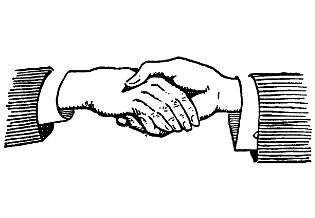
Fig. 1.—A handshake sign.

Fig. 2.—An eyebrow sign.
The variety of passes that can be executed with different meanings is astonishing. Yet it should be remembered that, although outsiders may not know what you are saying, it will always be apparent that “something is up,” and a very undesirable curiosity will be awakened.
On the other hand, there are many little actions, unnoticeable in themselves, which may have a great meaning to those “in the know.”
A simple stroking of the eyebrows (Fig. 2) is to all appearances a harmless movement, but in the secret signs of a well-known society it meant that treachery was in the air, and every person in the room would have to be watched.
In a certain Italian Society, clasping the forehead with the left hand as though in extreme weariness (Fig. 3) implied: “Be cautious, you are being watched.” A similar action with the right hand meant: “We are known, make your escape as best you can; leave me alone.”
In the same society, when a member found himself in a mixed assembly, and desired to ascertain who amongst the guests belonged to his fraternity, he would stroke his left cheek thoughtfully with extended first and second fingers, as in Fig. 4.
[535]
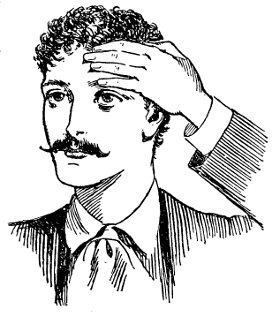
Fig. 3.—The sign of an Italian secret society.

Fig. 4.—The “cheek” sign of an Italian secret society.
The brethren of a very respectable society, which still flourishes, are generally credited with knowing each other by a peculiar flourish of the hand when removing the hat, in a somewhat similar manner to that shown in Fig. 5. Others make the ceremony of blowing the nose of like importance.
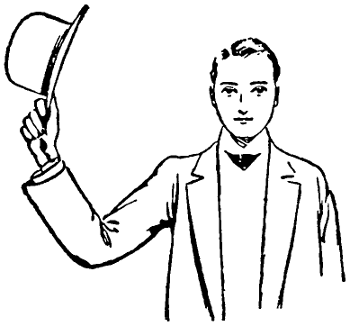
Fig. 5.—The hat flourish.
There used to be a famous Italian Secret Society divided into several classes or degrees, each of which had its own especial sign. For the first three degrees these signs were as follows:—
1st. The right hand is raised to the shoulder, and then passed slowly down across the body to the left knee.
2nd. The right hand is placed upon the left shoulder, then drawn slowly down the left arm until it reaches the hand. Thus clasped they are raised to the breast.
3rd. The right hand is clasped, the thumb and little finger extended. The former is placed against the lips, whilst the latter touches the breast.
Those who desire to invent secret signs should avoid all those dependent upon an unnecessary action, like the hat-flourish. It is[536] more satisfactory to apply the secret to some everyday action which, from its very unobtrusiveness, will attract the attention of no stranger.
Members of certain religious secret societies to this day distinguish one another by a peculiar style of cross, worn as a pendant from the watch-chain, whilst a pass-word is current amongst them to enable them to test those whom they meet wearing the symbol.
The use of flowers in the button-hole is a very common method of attracting recognition, whilst a development of the same idea is seen in the wearing of different colored neckties or ribbons, which in a crowd will pass unnoticed save by those whose attention is desired. Yet to both of these systems a certain danger is attached, for there is always the chance of some unsuspecting person quite inadvertently wearing the same flowers or colors.
Every one has heard of the language of flowers, but it is surprising to what an extent this can be carried by enterprising young ladies with a good collection in the garden or green house.
It has been frequently proved that some safeguard is a necessary addition to the sign, and this safeguard usually takes the form of a pass-word. Repeated after the sign has been given, this word serves to show that the secret sign was neither given by accident nor picked up through curiosity.
Pass-words, and the methods of giving them, vary considerably. The word, which must of course be known to all duly intrusted with the secret, should be of two syllables.
One party called A says the first syllable, and the other person B repeats the second, then saying the whole word. Supposing the pass-word chosen be Oxford, A would make some remark introducing the word Ox, whilst B, replying in a similar vein, would mention the last syllable “ford” and conclude by repeating the whole word. With this system it is almost impossible for an outsider to palm himself off as one of the elect, even if he has become acquainted with all the signs of the society.
It is a well-known fact that gypsies have a concerted plan of signals which are employed to show members of the party the direction taken by their leaders.
The “patteran,” as it is called, is made in various ways. A piece of rag fluttering from some bush near a cross-road, is a favorite[537] signal, whilst small twigs or leaves strewn in a particular direction, have a somewhat similar meaning.
Tramps and vagrants of all kinds have a series of signs, which they chalk upon the walls of the various houses at which they call, serving to inform their brethren of the treatment received at the hands of the occupiers.
By this method a rude cross will usually describe the rather chilling welcome offered them by an irate householder, whilst a rough sketch of a loaf of bread shows that the inmates are sufficiently sympathetic to dispense with a portion of “the staff of life.” On the other hand, an upraised leg with a boot upon its foot tells a tale which need not be further enlarged upon.
As to the various modes of recognition that can be produced by whistles and cries of all kinds, they are too familiar to require description in these pages.
[538]
It cannot fail to strike those of us who are blessed with the use of our eyes how extremely fortunate it is that our blind friends need not be debarred from many of our games. Being deprived of their sight, their sense of touch is developed to such an incredible extent that in the playing of many games their fingers prove of the same use to them as our eyes do to us.
Practically all games for the blind can be purchased at very moderate cost, yet as they can be quite easily made at home the following hints are offered in the hope that they will prove of use, and help some of our readers to entertain a friend less fortunate than themselves.
An ordinary pack of cards can be very simply adapted to the use of the blind.
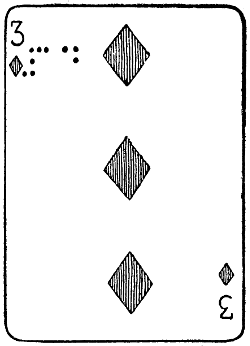
Fig. 1.—Pin pricks showing value and suit of card.

Fig. 2.—Distinguishing marks for suits and color respectively.
By means of a large pin, the designation and value of a card can be pricked on the back, so that the upraised holes are perceptible to touch. These values and denominations should be pricked in the[539] corner where the small designation of the value of a card is always to be found, as in Fig. 1.
In Figs. 2 and 3 are shown the marks which should be pricked. These are in the Braille alphabet, now universally understood by the blind, and read by them with the same ease as we read printing.

Fig. 3.—Values to precede the signs for suits.

Fig. 4.—Cards prepared for Patience.
[540]
In Whist or Bridge, each person, as he plays his card, states what it is, King of Hearts, and so on, as this saves feeling the cards after they have been laid on the table.
A very suitable game, calculated to amuse the player for hours, is Patience, under all its forms. For this the cards must be prepared somewhat differently, as in many games the first thing to be distinguished is the color.
The handiest plan is to mark a B or an R for Black or Red, in Braille characters immediately before, or underneath the denomination. A glance at Fig. 4 will serve to show what is meant.
With the cards thus marked, any game of Patience can be played as easily by a blind person as by an ordinary player.
An ordinary Checker Board can be adapted for the use of the blind with very little trouble and no expense.
Cut thirty-two squares of thick cardboard, each square identical in size with the black squares on the Checker Board. Upon each of the black spaces one of these pieces of card should be glued, so that when complete the board is composed of sunk and raised instead of colored squares.
For the convenience of any ordinary person who may be playing with a blind opponent, the cardboard squares should be colored black with India ink.
The checkers usually purchased have a molding on both top and bottom. It will simplify matters considerably if you can buy a set with one side only molded. By using the white men with the molding uppermost and the black men reversed, as in Fig. 5, the difference will be sufficient to enable the blind person to distinguish by touch.

Fig. 5.—Molded (white) and plain (black) draughts for the blind.
The same result can be obtained by glueing discs of cardboard or stiff paper, upon one side of each man, of one of the sets.
The preparation of a Halma board is very similar to that of a checker board. Having raised the alternate squares with cardboard,[541] the “Homes” at each corner should be further raised by glueing a piece of cardboard over all the spaces, and then raising the alternate squares upon this base, as in Figs. 6 and 6a.

Fig. 6.—Section of Halma board showing “Home.”
In the center of each square a nail should be driven from the back of the board, with the end cut off and point filed to smoothness. These nails should project from the face of the board about half an inch. The ordinary Halma men have a hole on the under side, which enables you to place them upon the upraised points, where they will be held firmly.
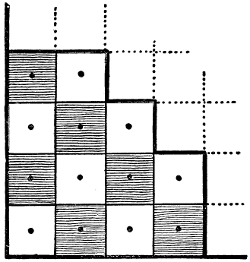
Fig. 6a.—Plan of raised corner.
It will now be necessary to make some alteration in the men, to distinguish the colors. In Fig. 7 an idea of how this may be done is given. The Yellow men are left untouched, Black have their heads cut right off, Red have one half of the head cut away, while the Green have the head sharpened to a point.

Fig. 7.—Color distinctions for Halma men.
Owing to their construction, Dominoes really need no alteration to make them suitable for the blind, but care should be taken when[542] purchasing to see that the pips are cut deep into the ivory, so that the player can tell at a touch how many there are in the piece before him.
This is one of the games in which the blind frequently excel, and in consequence it is a general favorite. The undivided attention they are able to give, and the natural acuteness which their affliction usually brings to such a pitch of excellence, serves them in good stead when playing “the king of games.”
The board should be prepared as in the case of checkers, with the exception that points should be made from the back, in the manner described in connection with the Halma board.
The different men are, of course, by their construction, easily distinguishable from one another, but it will assist matters very materially if a set is used in which the men differ considerably in shape and size.
In the center of each piece a hole must be bored in the base, large enough to allow the man to be placed, and removed from one pin to another with ease. For this reason wooden chess men are preferable.
The question of distinguishing the colors has been solved in various ways. In some cases the tops of the men of one color have been halved, as shown in Fig. 8, and this has proved a very satisfactory arrangement.
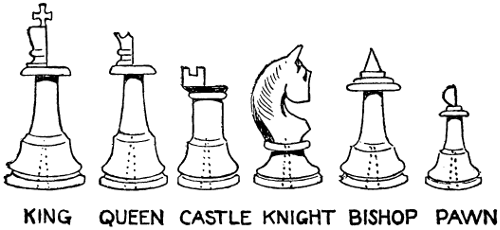
Fig. 8.—Color distinctions for Chess men.
Others have used the black men of one set and the white men of another, but this plan is hardly to be recommended, owing to the similarity prevailing between all chess men.
The following method seems to be as good as any, and has the advantage of being easily contrived. Drive a pin firmly into the heads[543] of one set of men (say the black), and either leave plain, or make a little knob of sealing-wax around the pinhead. This will render the different colors perfectly distinguishable to the blind player.
In the majority of round games the blind are able to take an active part, but this depends very much upon the individual concerned. As a general rule rough games should be avoided, especially if the space for playing be limited.
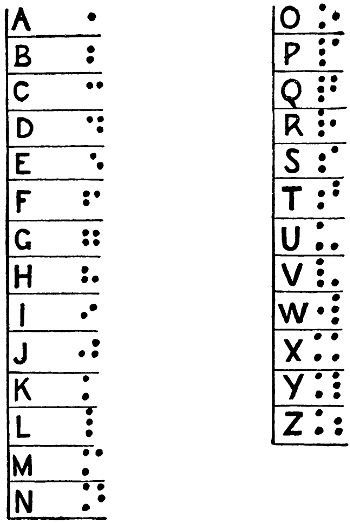
Fig. 9.—The Braille Alphabet.
Games in which a certain amount of writing is requisite are rarely suitable, although here again it must be a matter solely dependent upon the person concerned.
At spelling and guessing games the cleverest seeing player must look to his or her laurels, for the blind are very quick-witted in such[544] contests, and frequently have the answer ready while others are still repeating the question.
As a matter of interest as well as of use, the blind alphabet of the Braille system is shown in Fig. 9, and by this means letters and notes can be written, which will be perfectly intelligible to a blind person. In pricking the characters through a paper, it should be remembered that the points must be reversed, and the letters begun from right to left, as the blind person will read from the other side, where the pin-pricked holes will have raised little points of paper.
[545]
THE END
The language used in the source document has been retained (including inconsistent, archaic and unusual spelling, hyphenation and capitalisation), except as mentioned below. In particular, non-English words and phrases have not been corrected unless mentioned under “Changes made”.
The (minor) deviations in spelling in the Index compared to the text have not been standardised.
Depending on the hard- and software used and their settings, not all elements may display as intended.
Discrepancies between illustrations and their descriptions (e.g., Fig. 1B in Chapter L) have not been rectified unless listed below. Items that cannot work as described (e.g. the rotating target in Chapter XX) have not been corrected or explicitly noted. Possibly offensive language (e.g. in the minstrel entertainment) and dangerous activities (as the experiments with hydrogen and chlorine gas) have been included in this transcription without further explicit warning.
Page 119, the David: as printed in the source document.
Page 184, The space, D, G, is also invisible: possibly an error for The space, D, C, is also invisible.
Page 216, The code for playing cards ...: the intended meaning of the suits (clubs and spades) given and the explanation (well and very well) in the text contradict each other.
Page 238. Fig. 9: the illustration may have been printed upside-down (cf. Fig. 10 and the text).
Page 295, various combinations of wines and liquids: as printed in the source document. Possibly an error for wires and liquids.
Page 458: It is not clear why One-blank is not listed.
Page 522, Figs. 7 and 8: The illusion “the standing pins” may not work in all formats; the bottom part of Fig. 8 has been added because it may be impossible to see the solution according to the directions given when reading this e-text.
Changes made
The (single) footnote has been moved to the end of the chapter.
Some minor obvious typographical and punctuation errors and misprints have been corrected silently.
Page 65: emotional parts of thumping changed to emotional parts or thumping.
Page 214: closing bracket added after the last two responses by the professor.
Page 257: The complete illustration consisting of Figs. 10-12 has been flipped horizontally, as have the individual figures.
Page 295: ‘the coil has been mentioned’ changed to ‘the coin has been mentioned’.
Page 438: reference to Fig. 2 changed to reference to Fig. 3.
Page 475: CHAPTER LVIX changed to CHAPTER LIX.